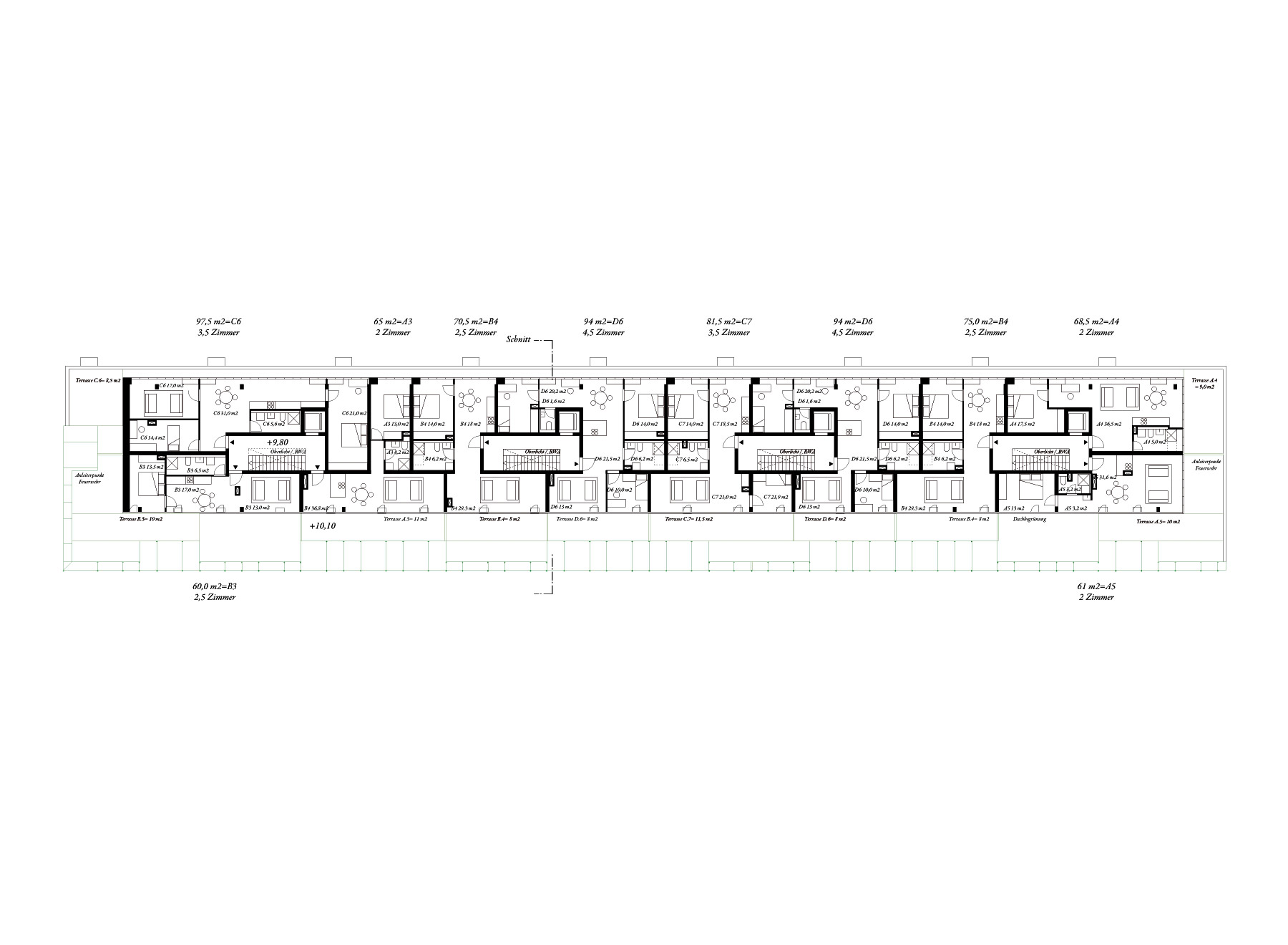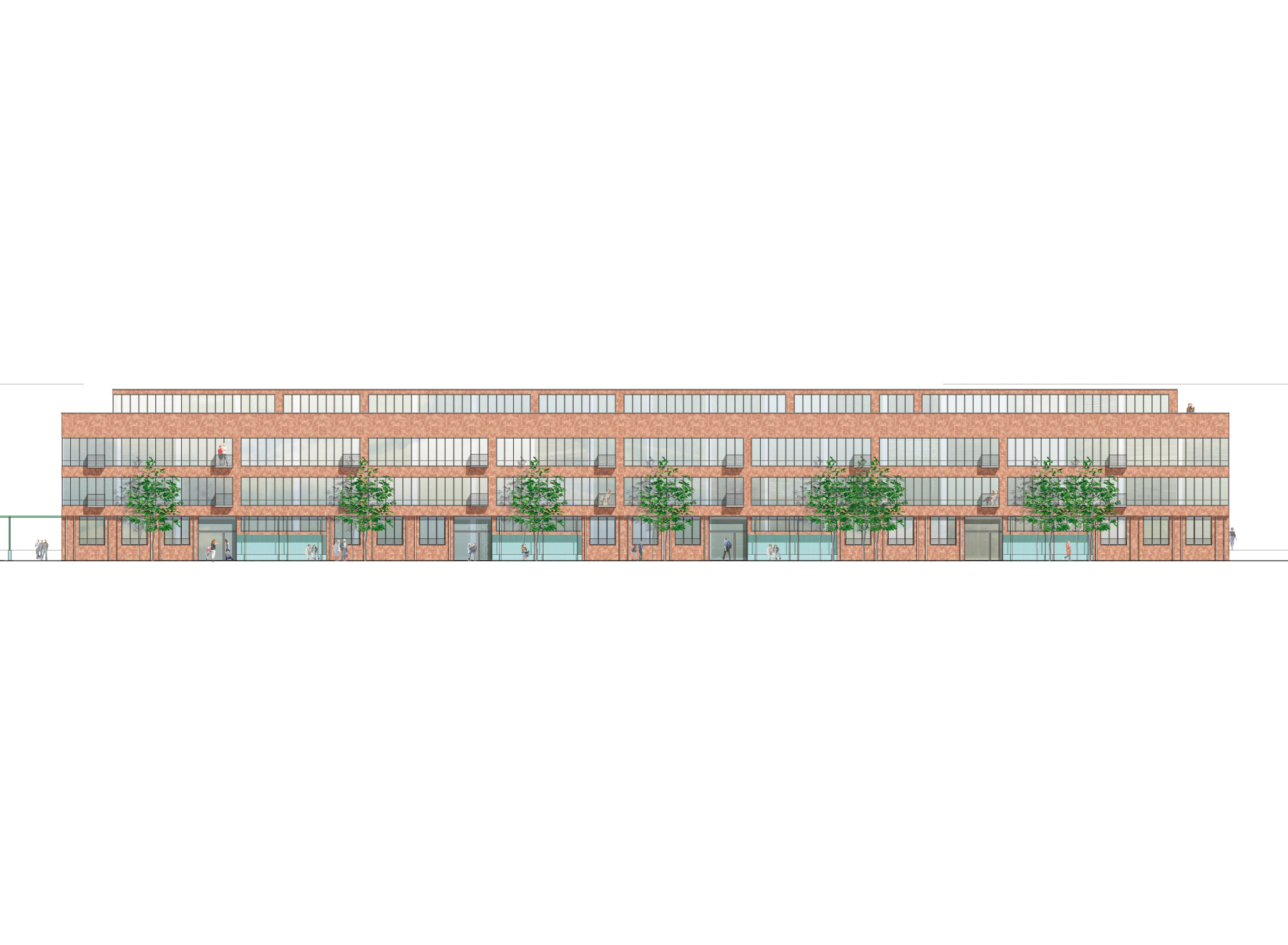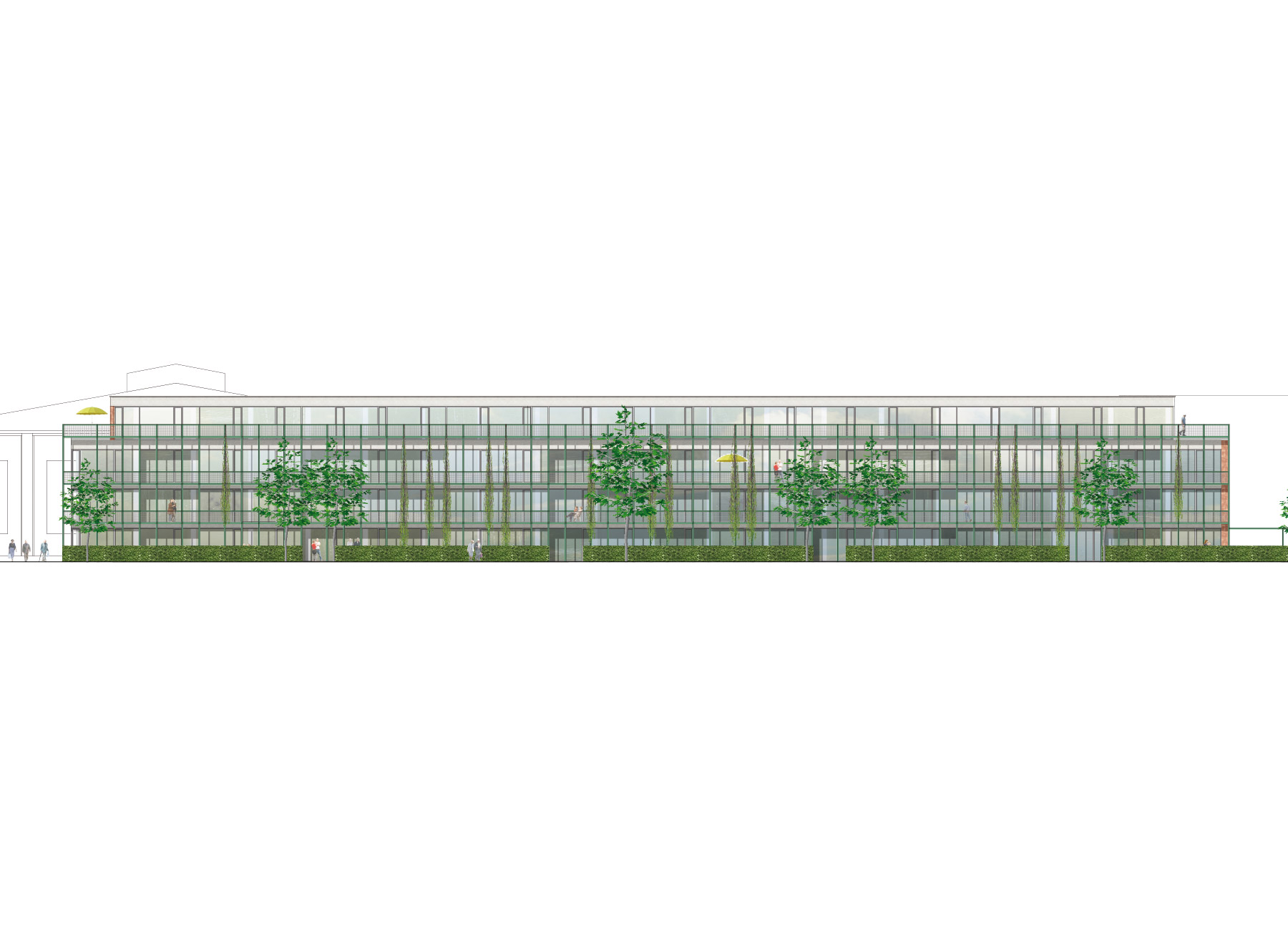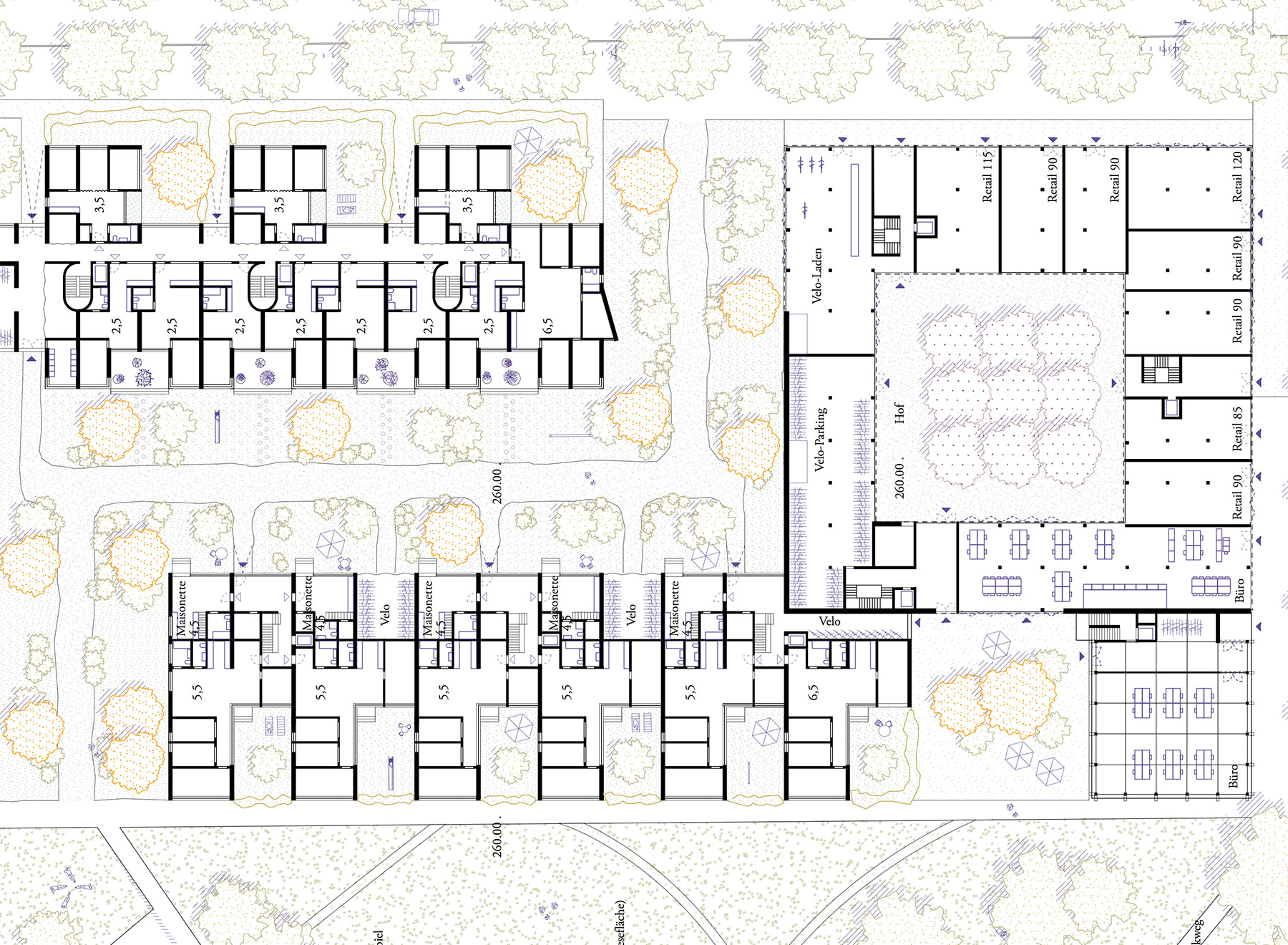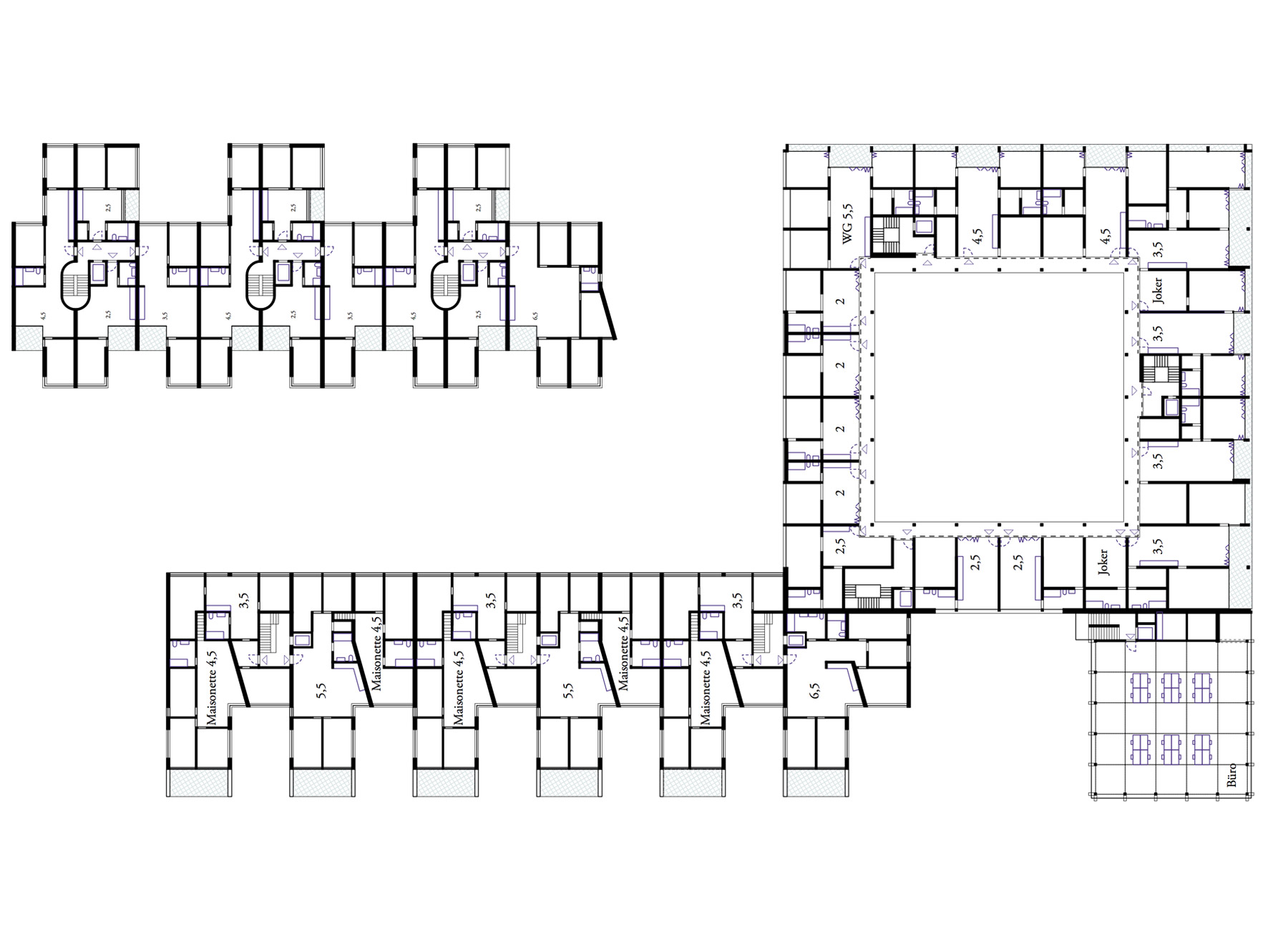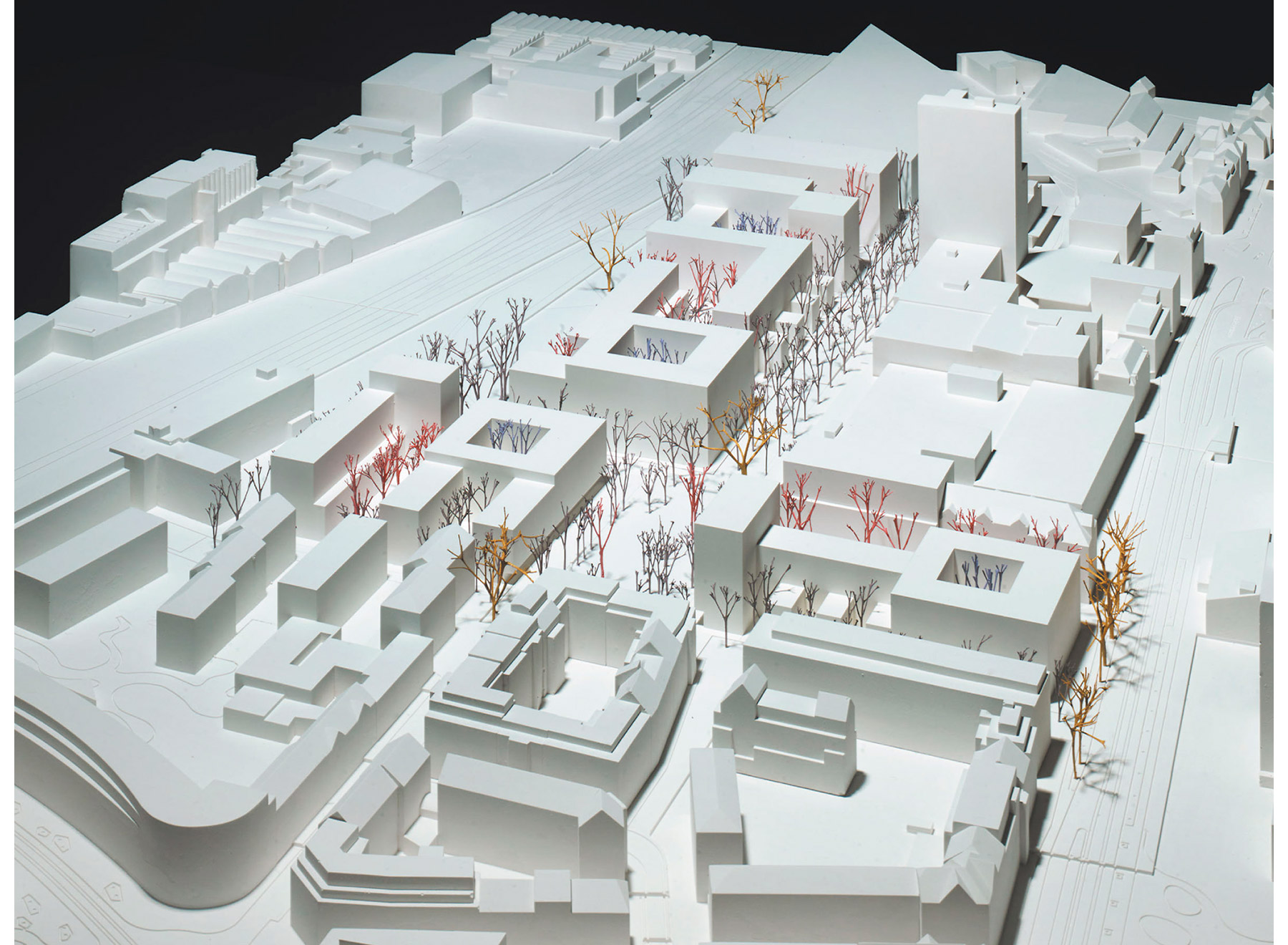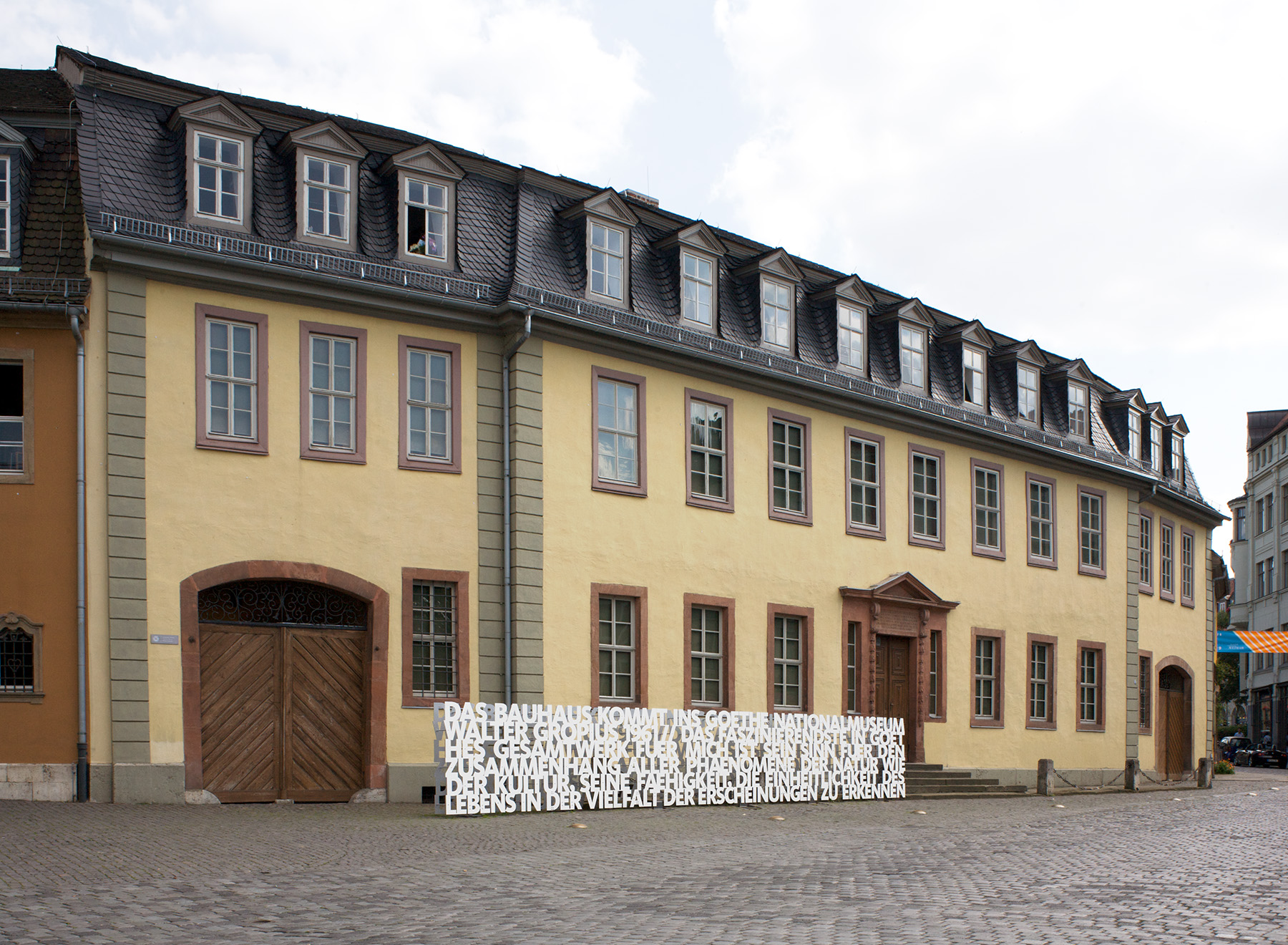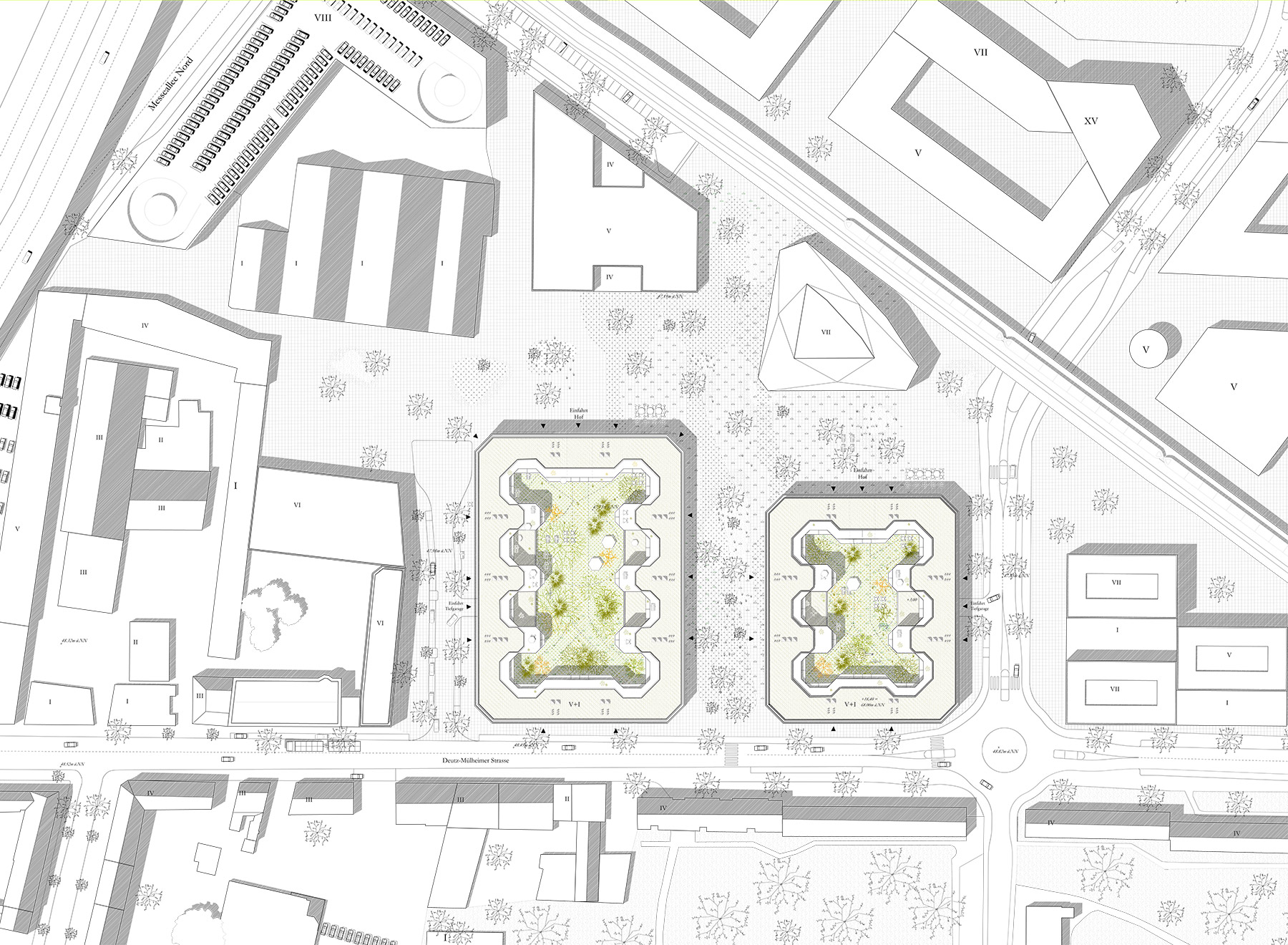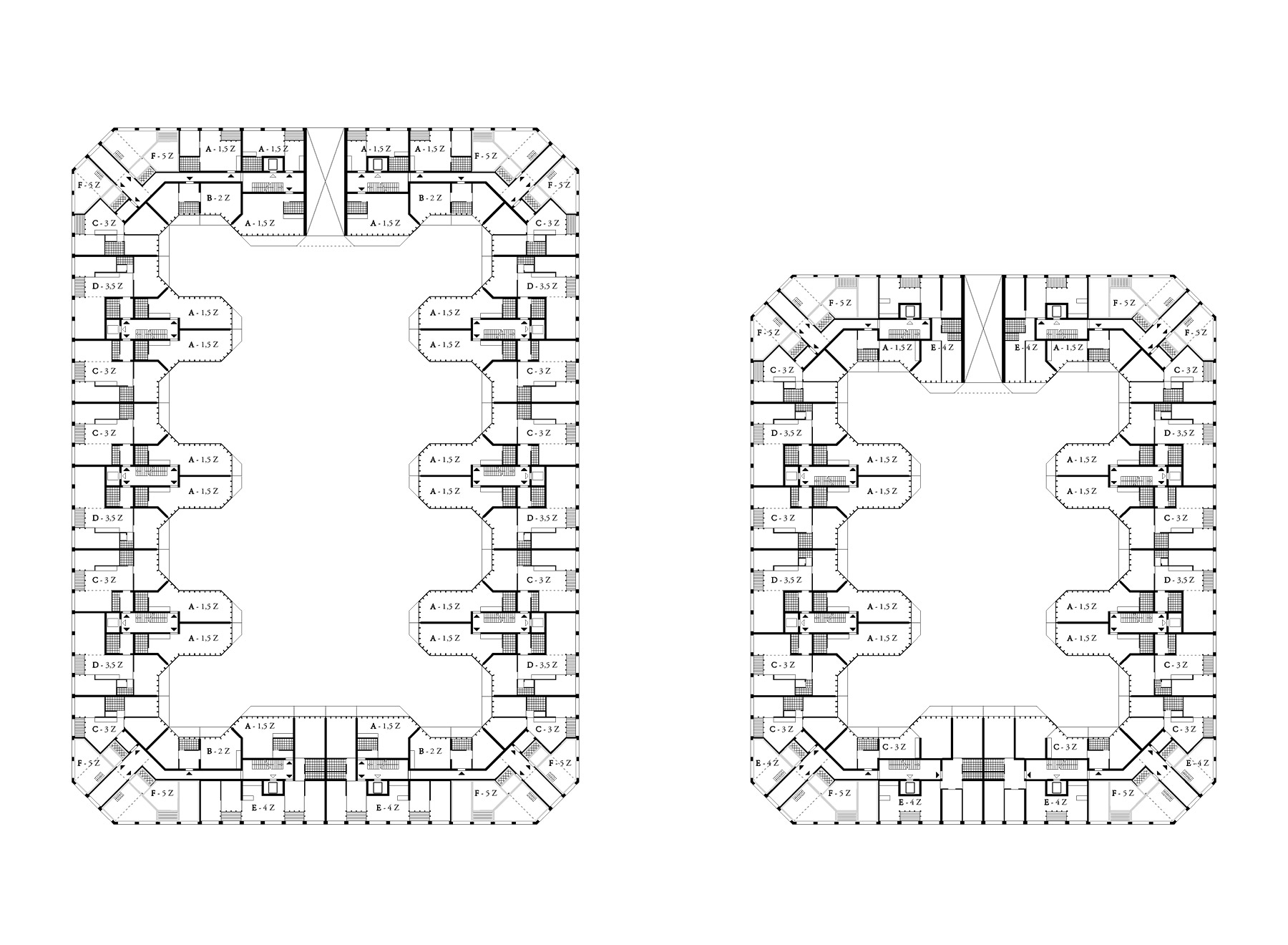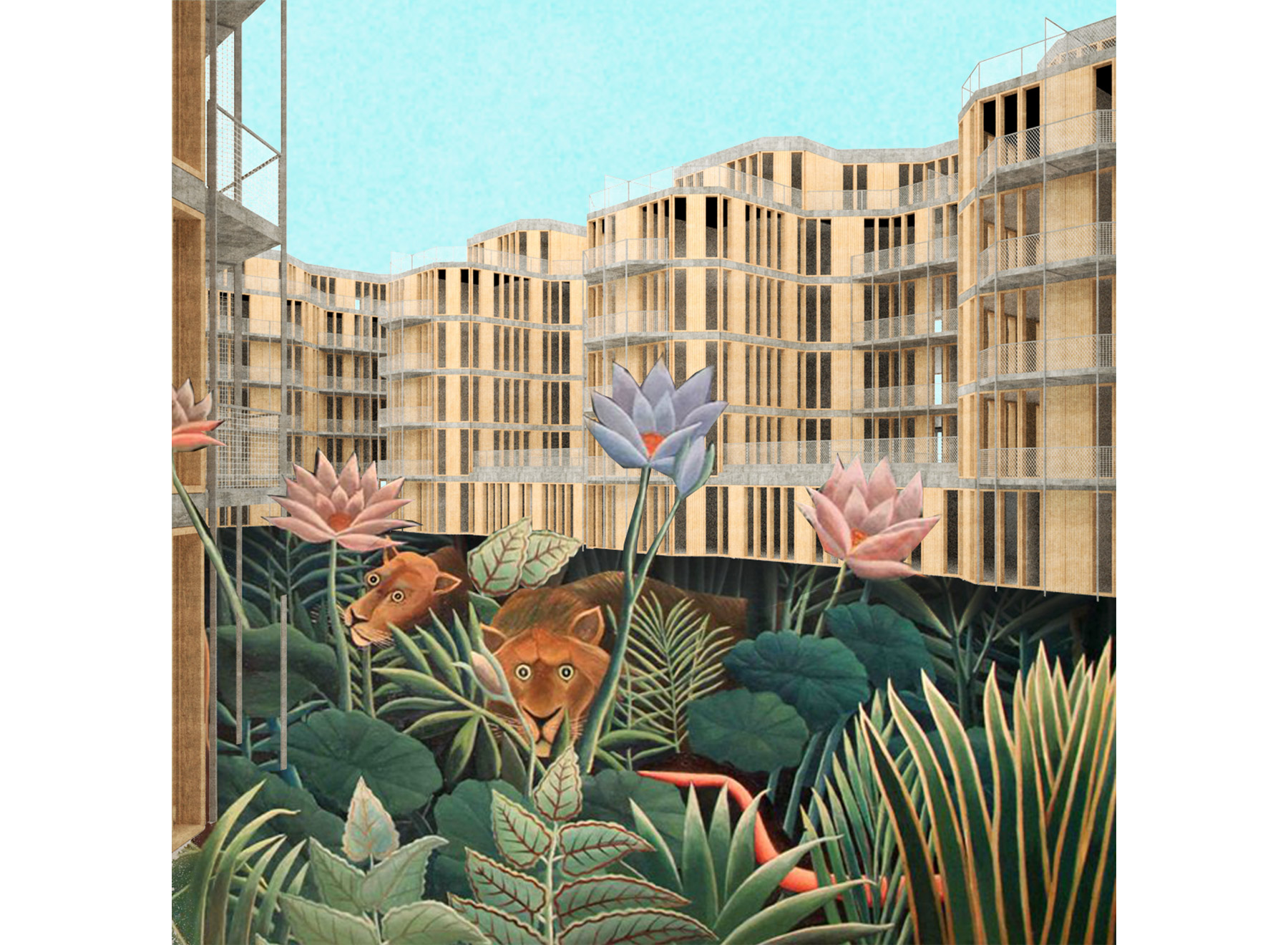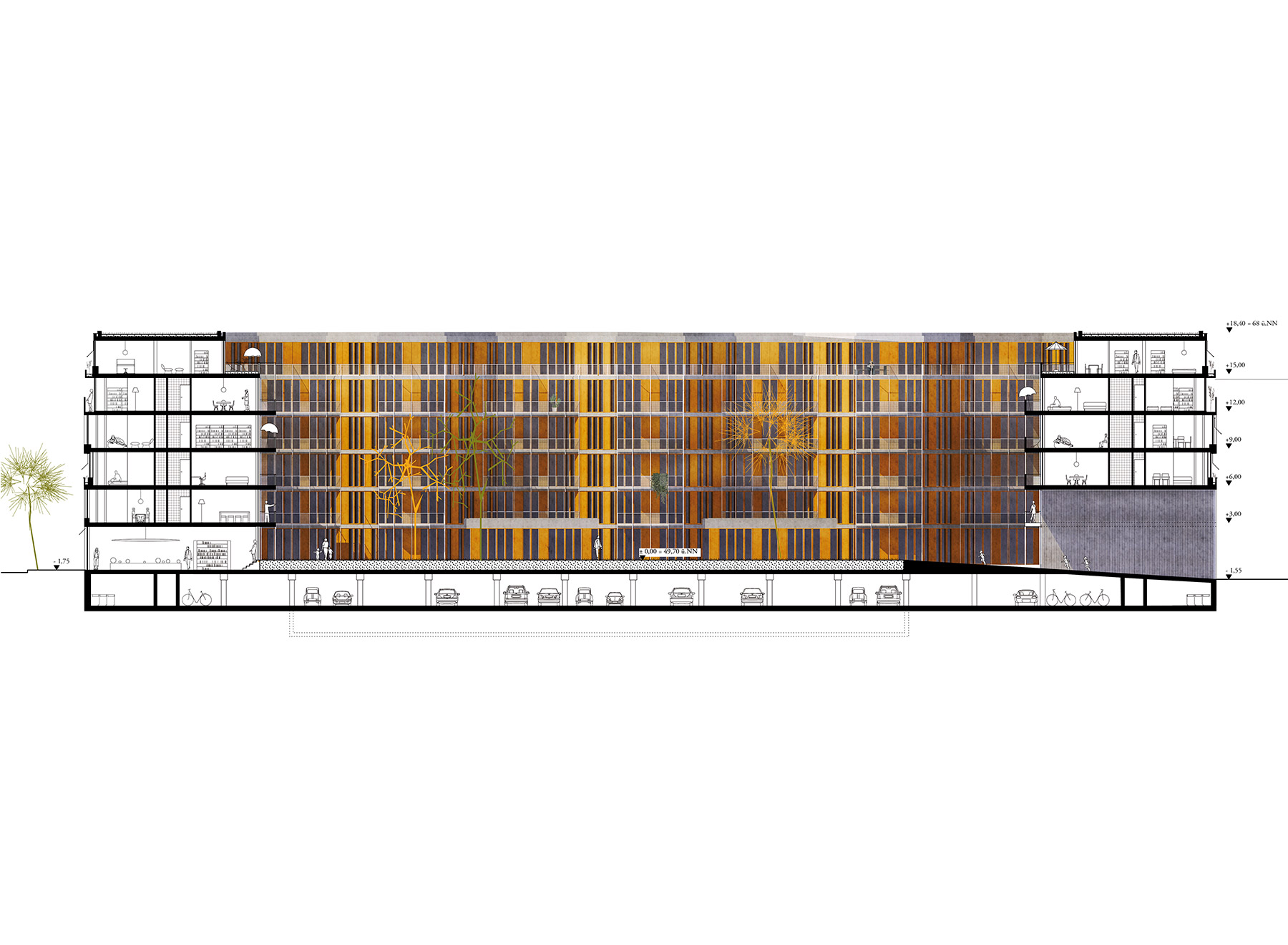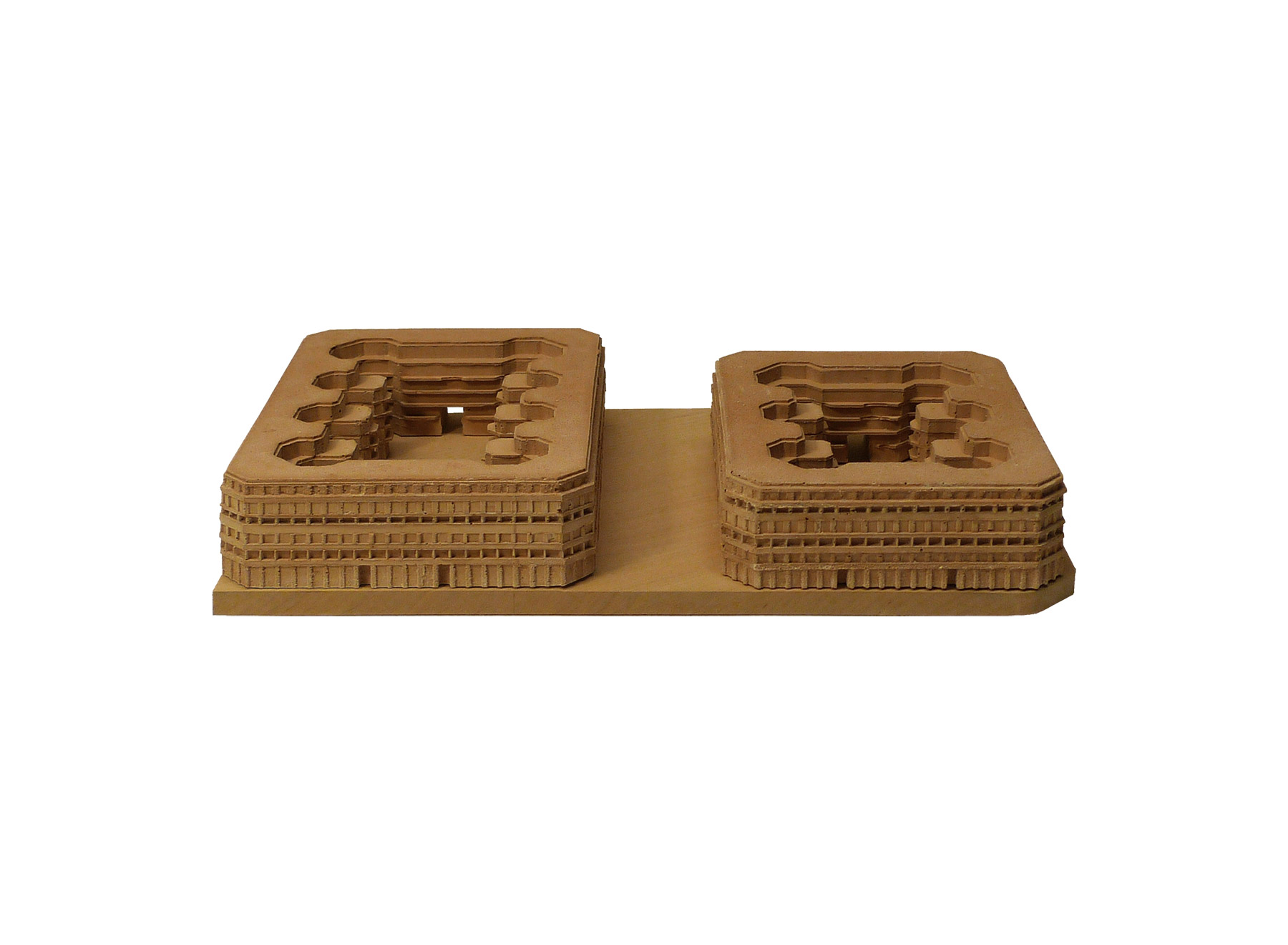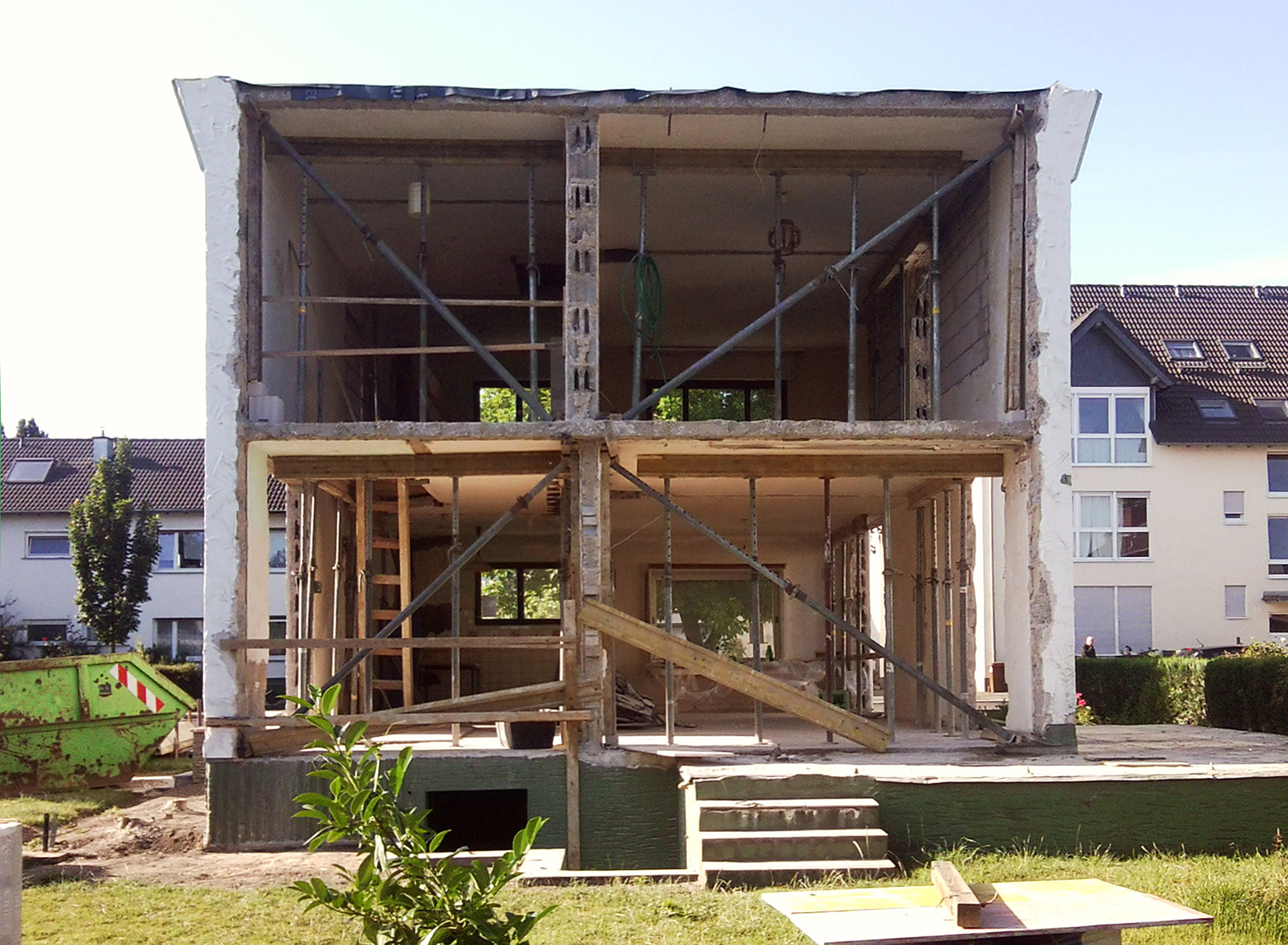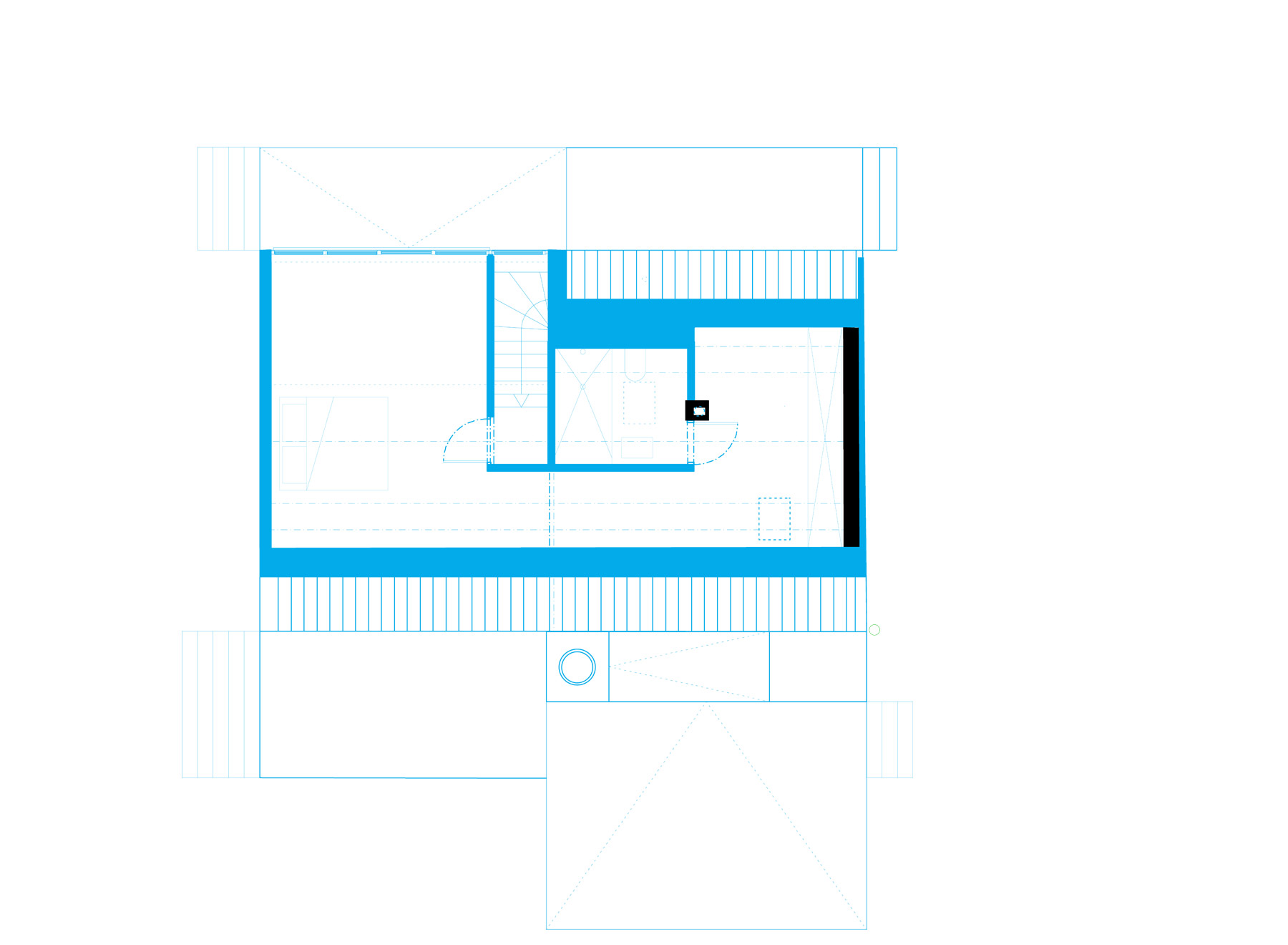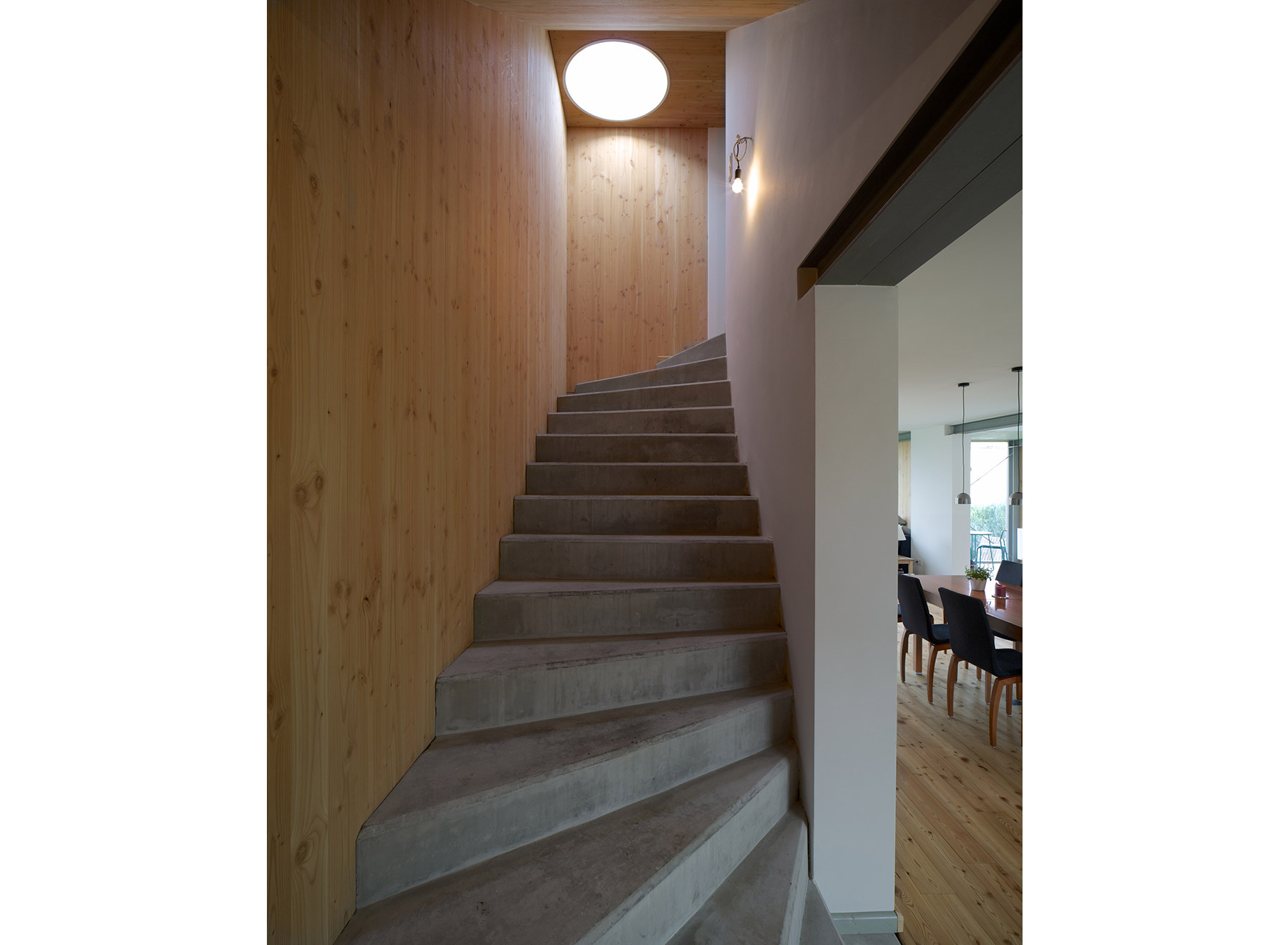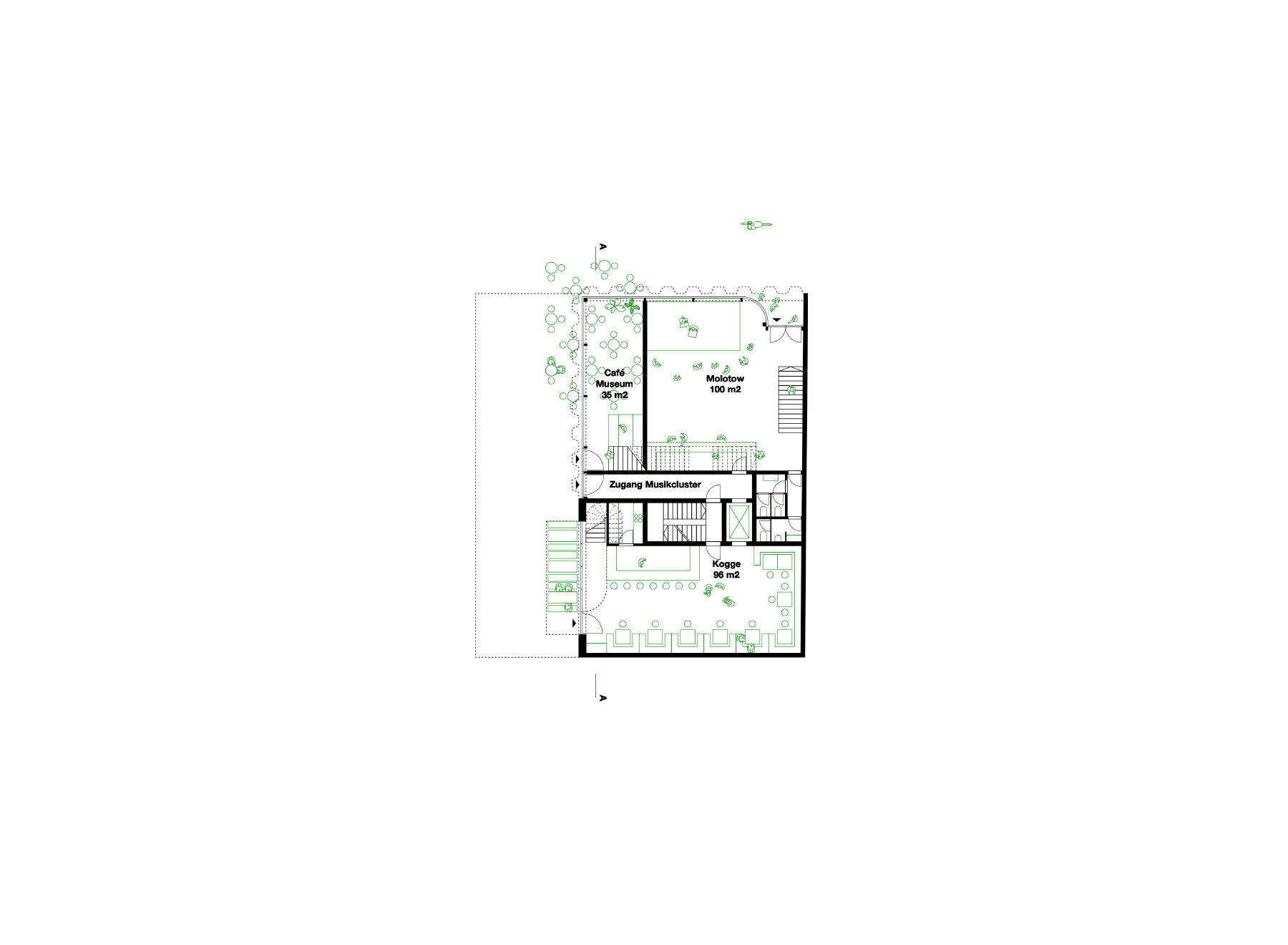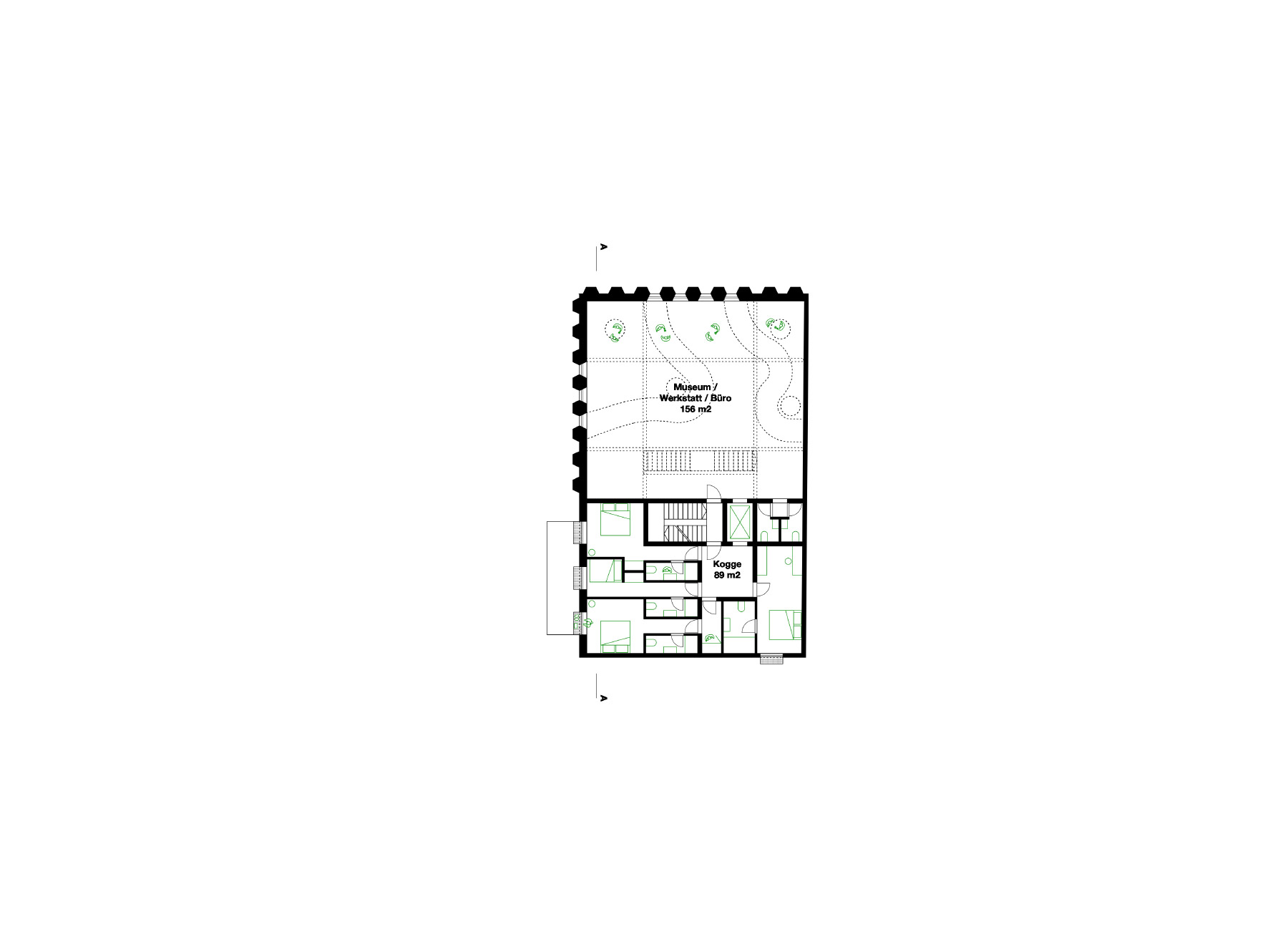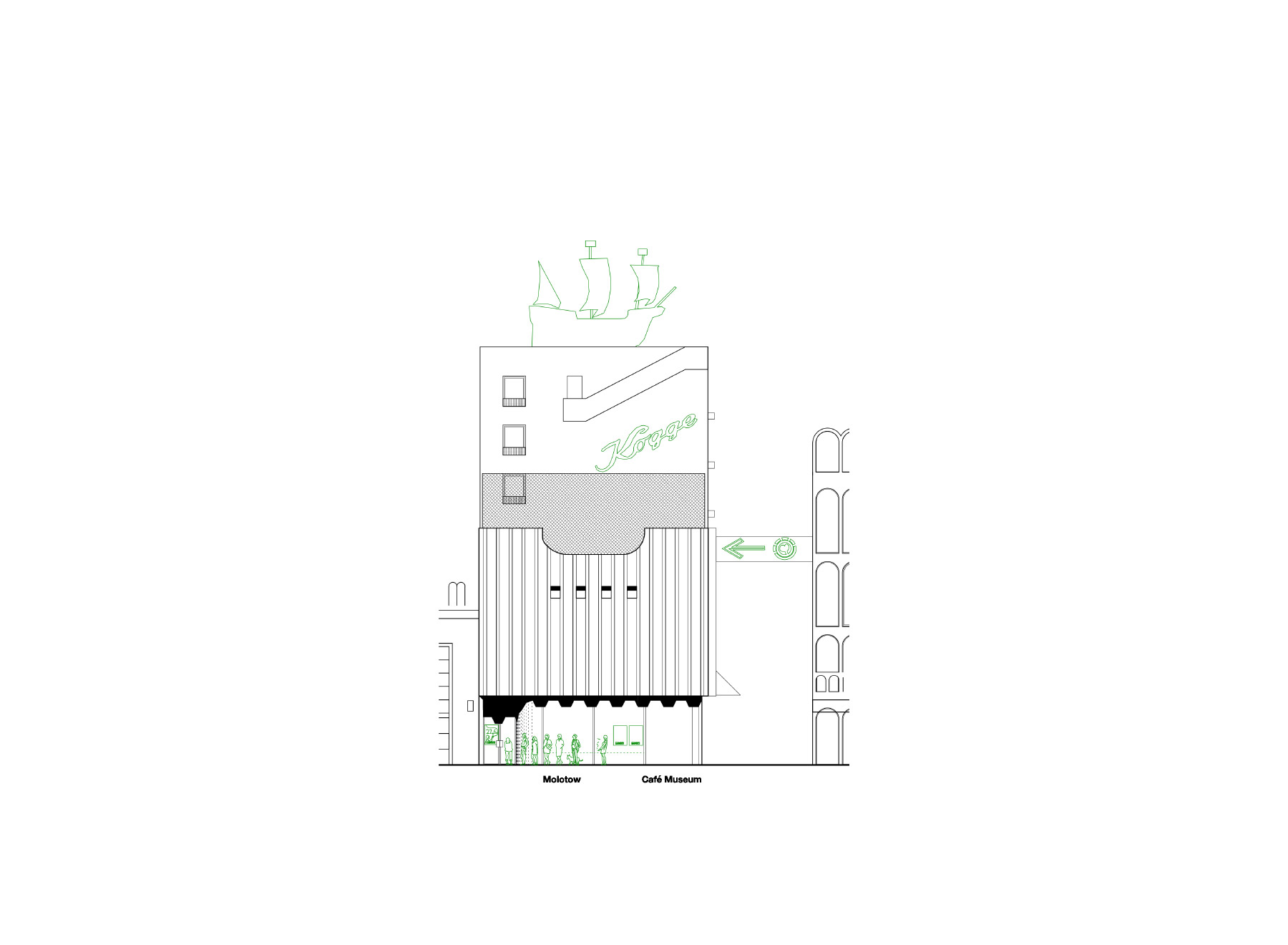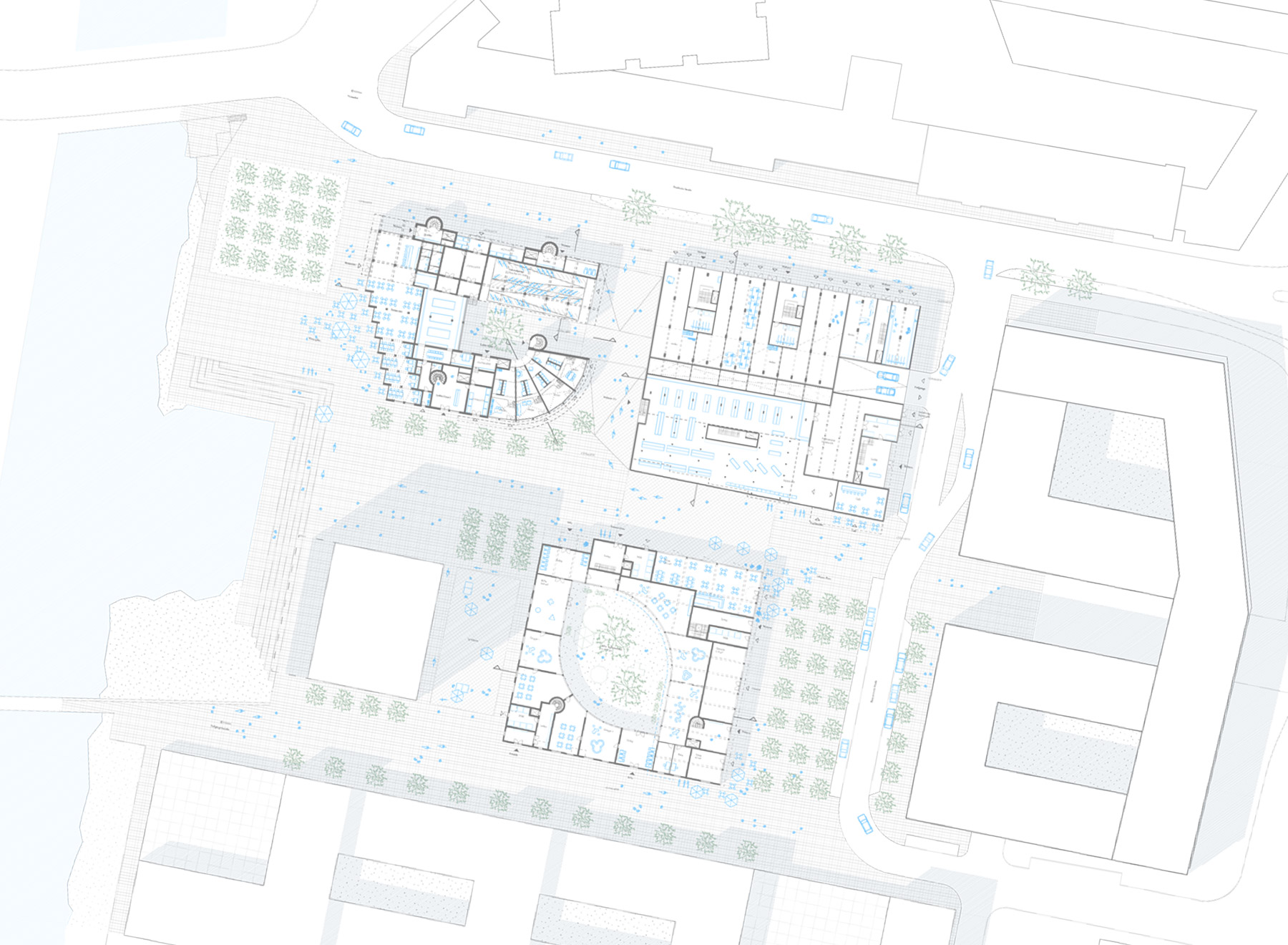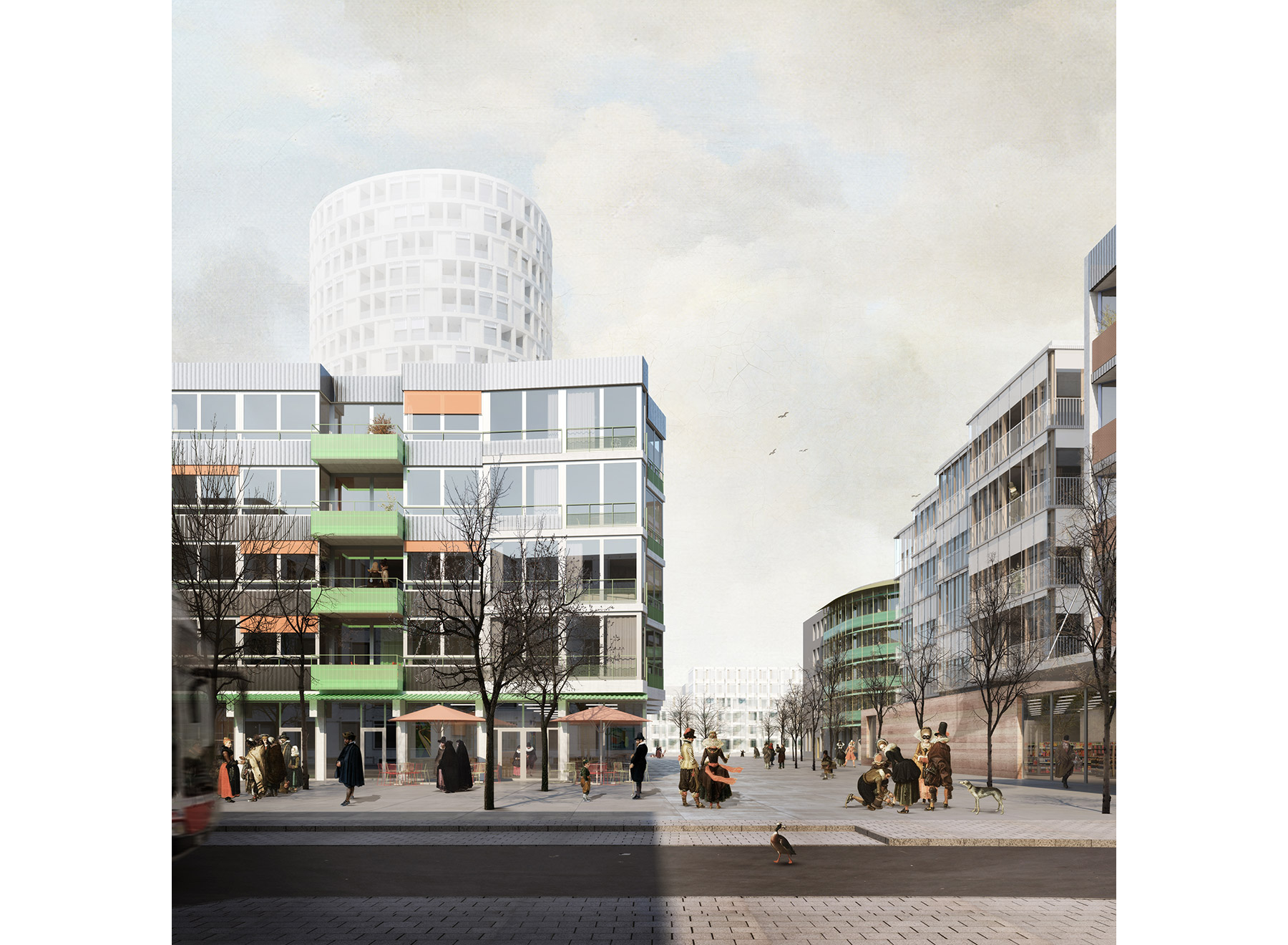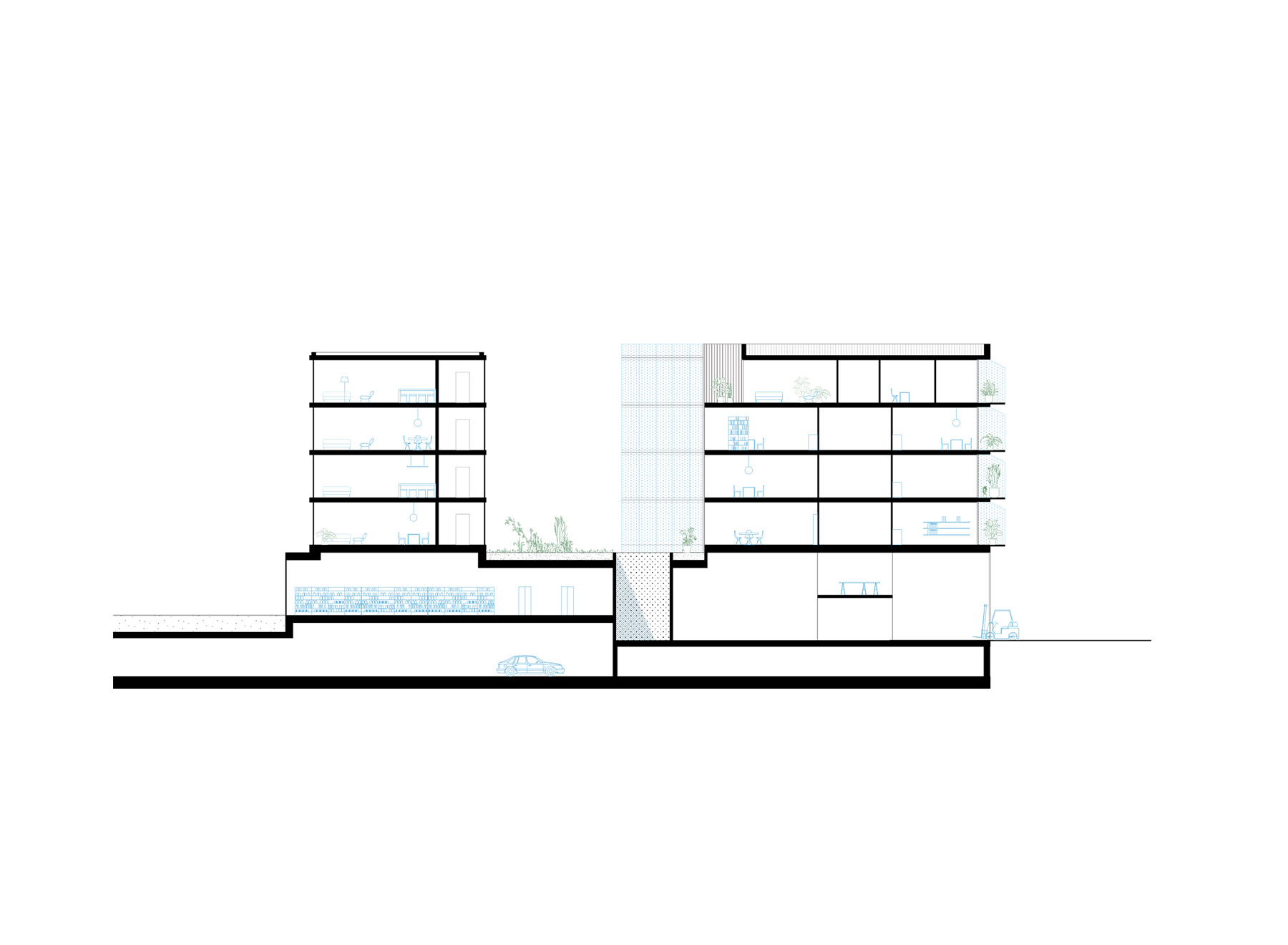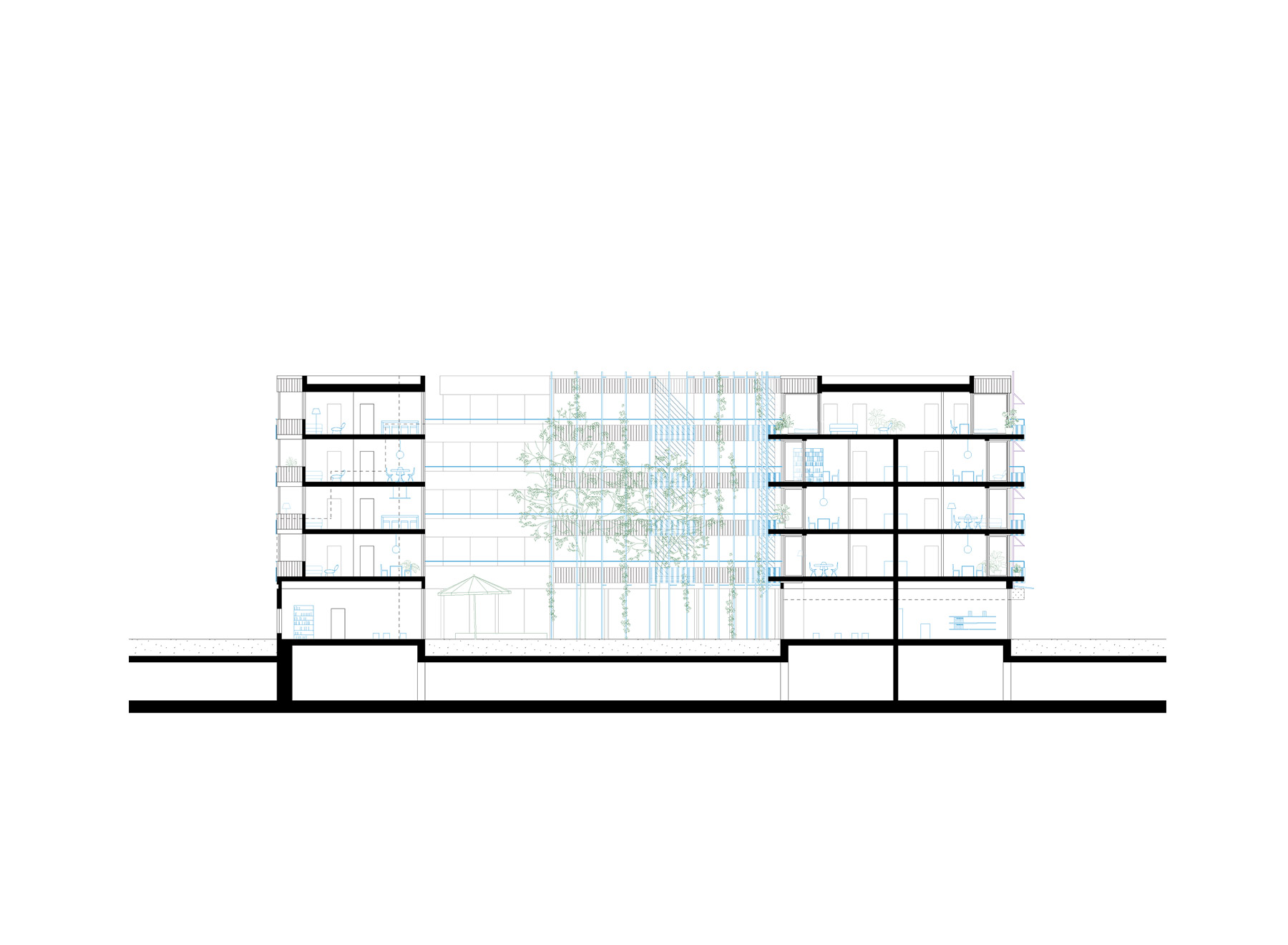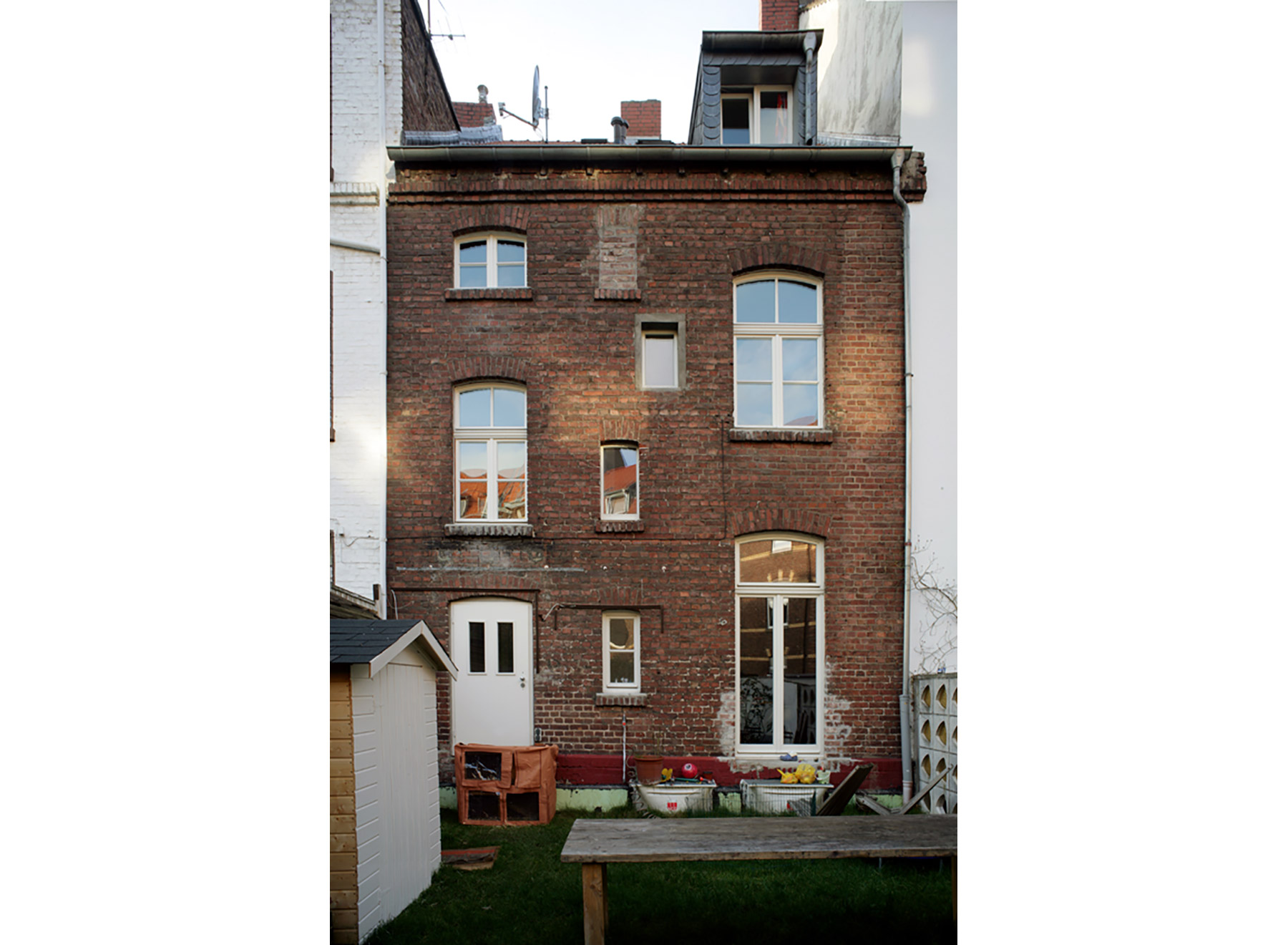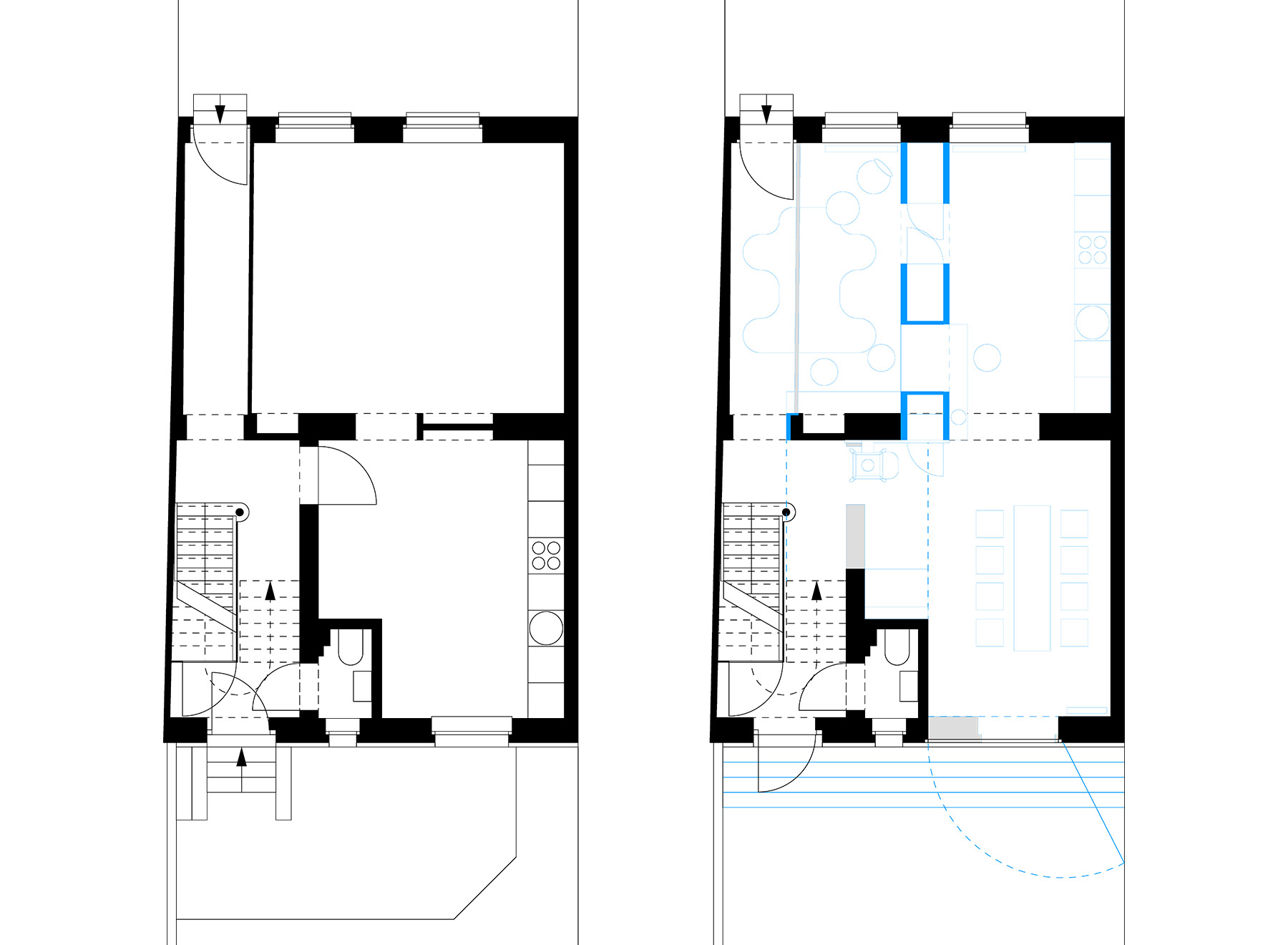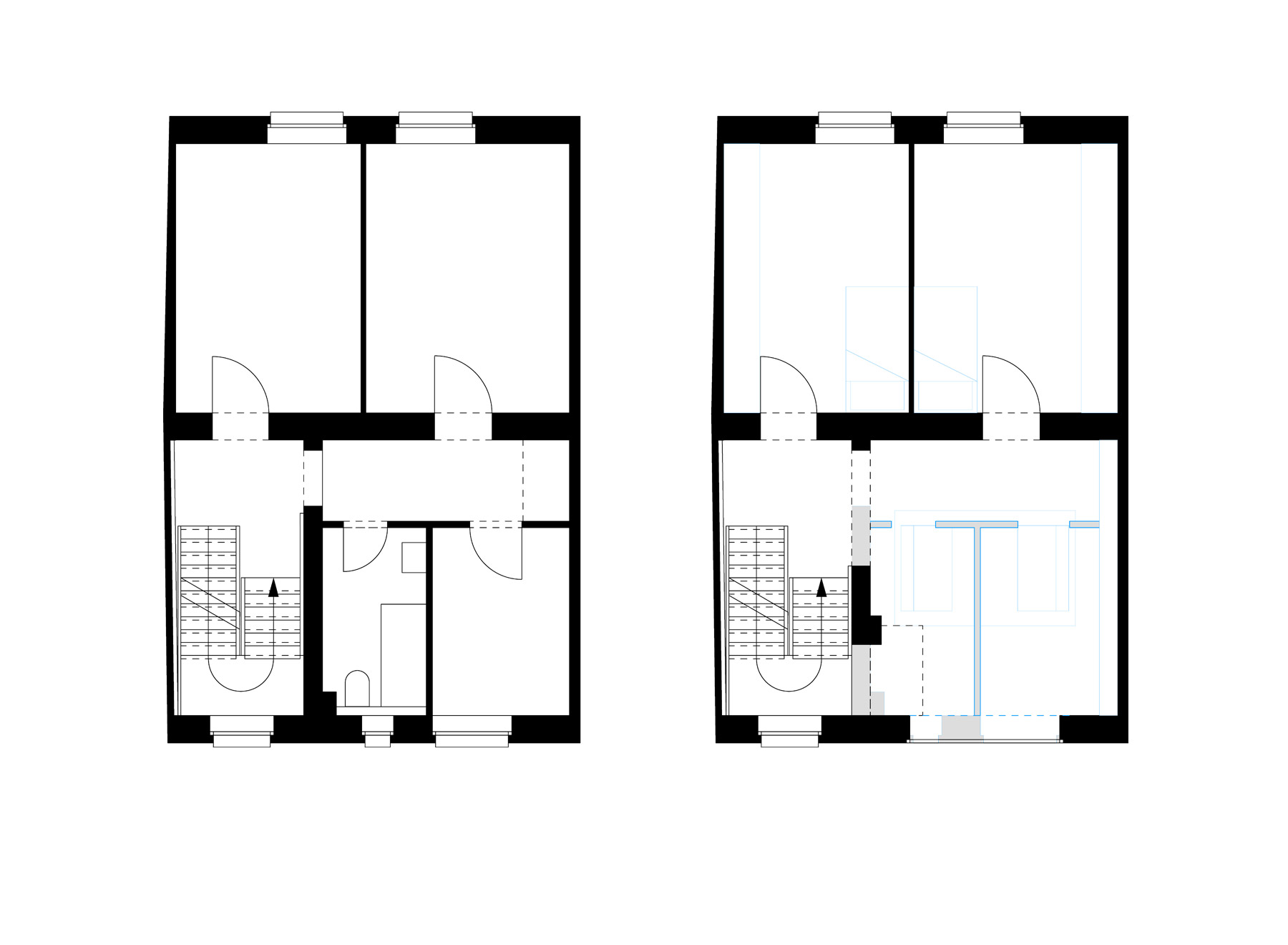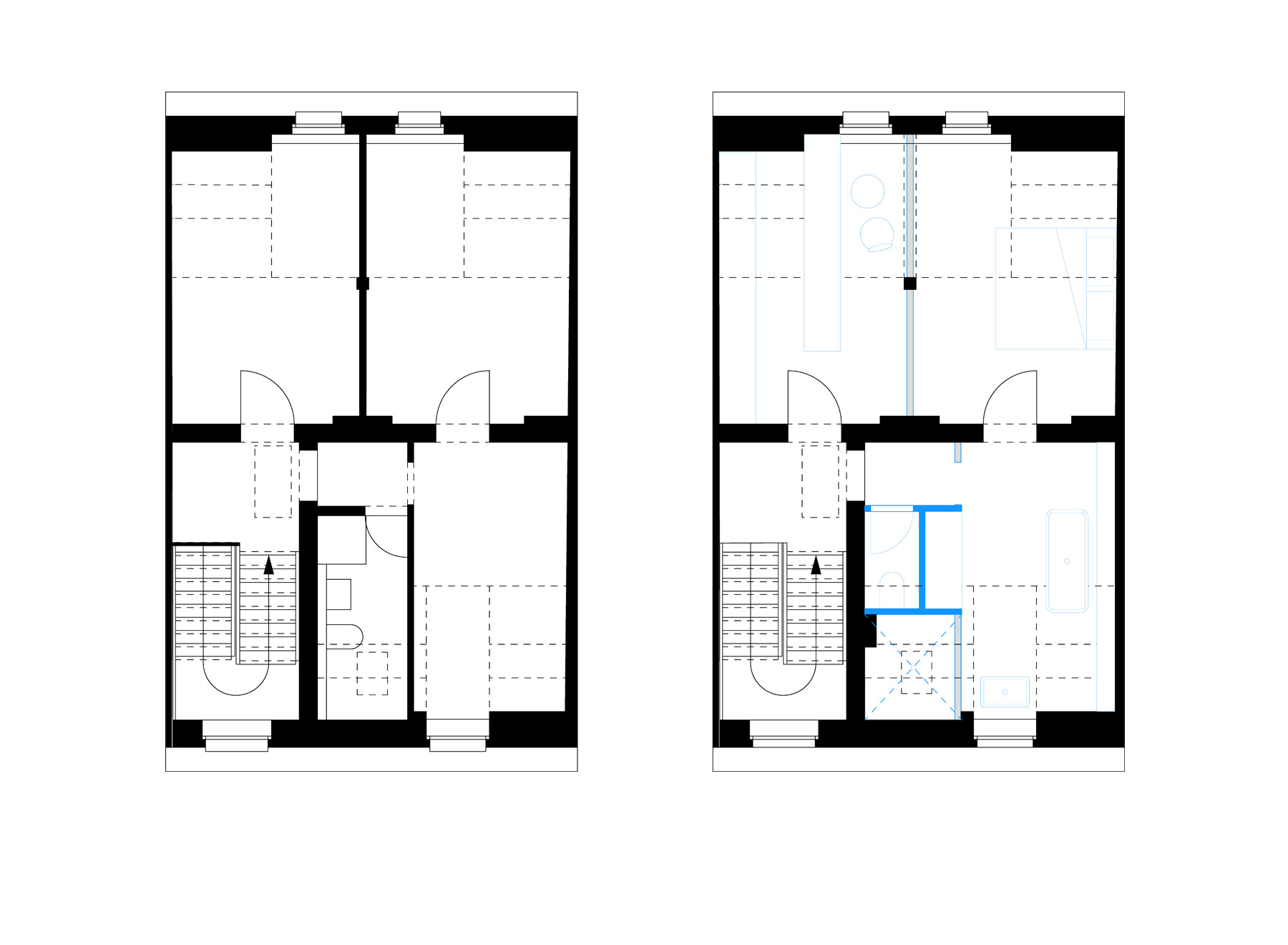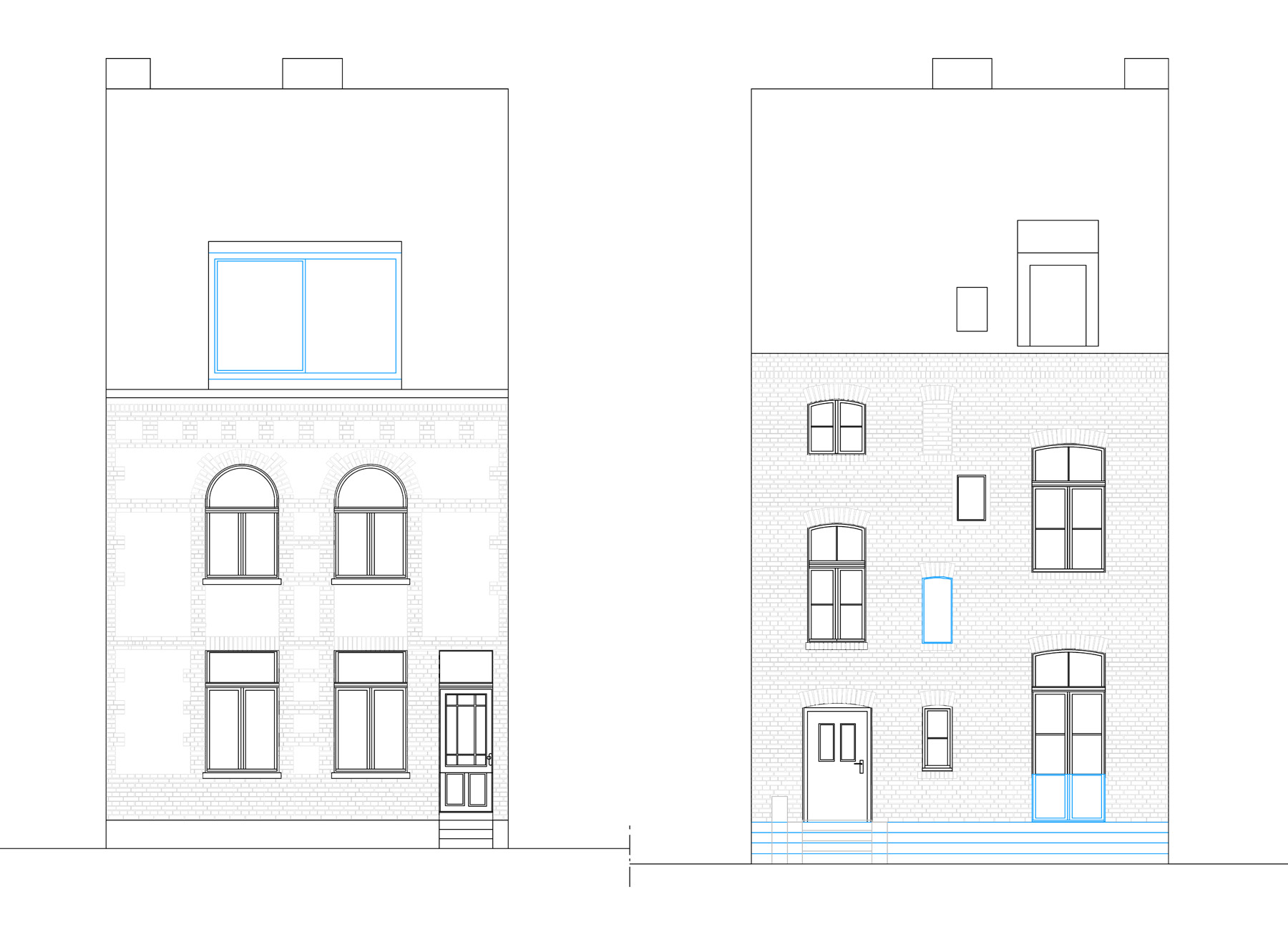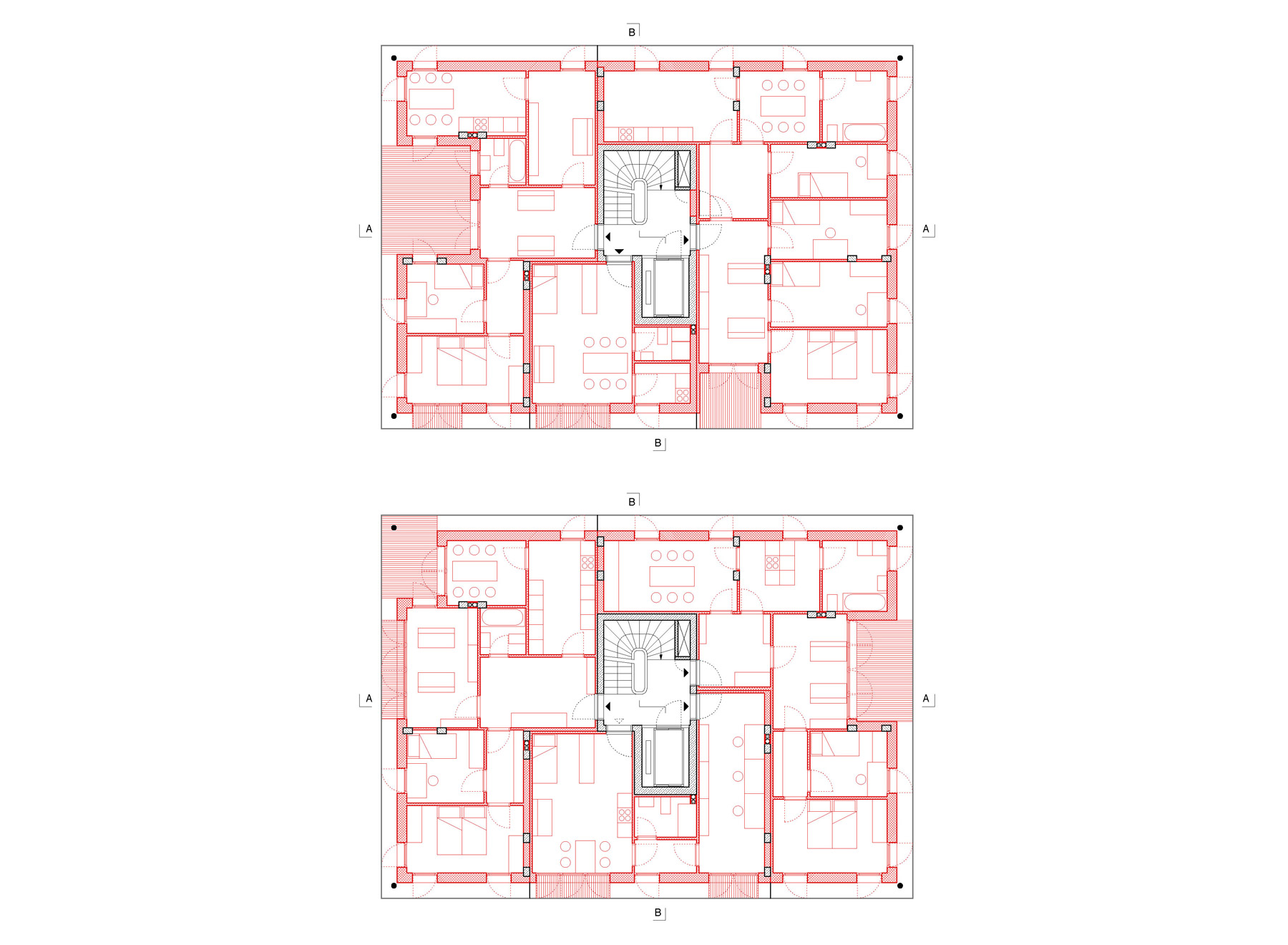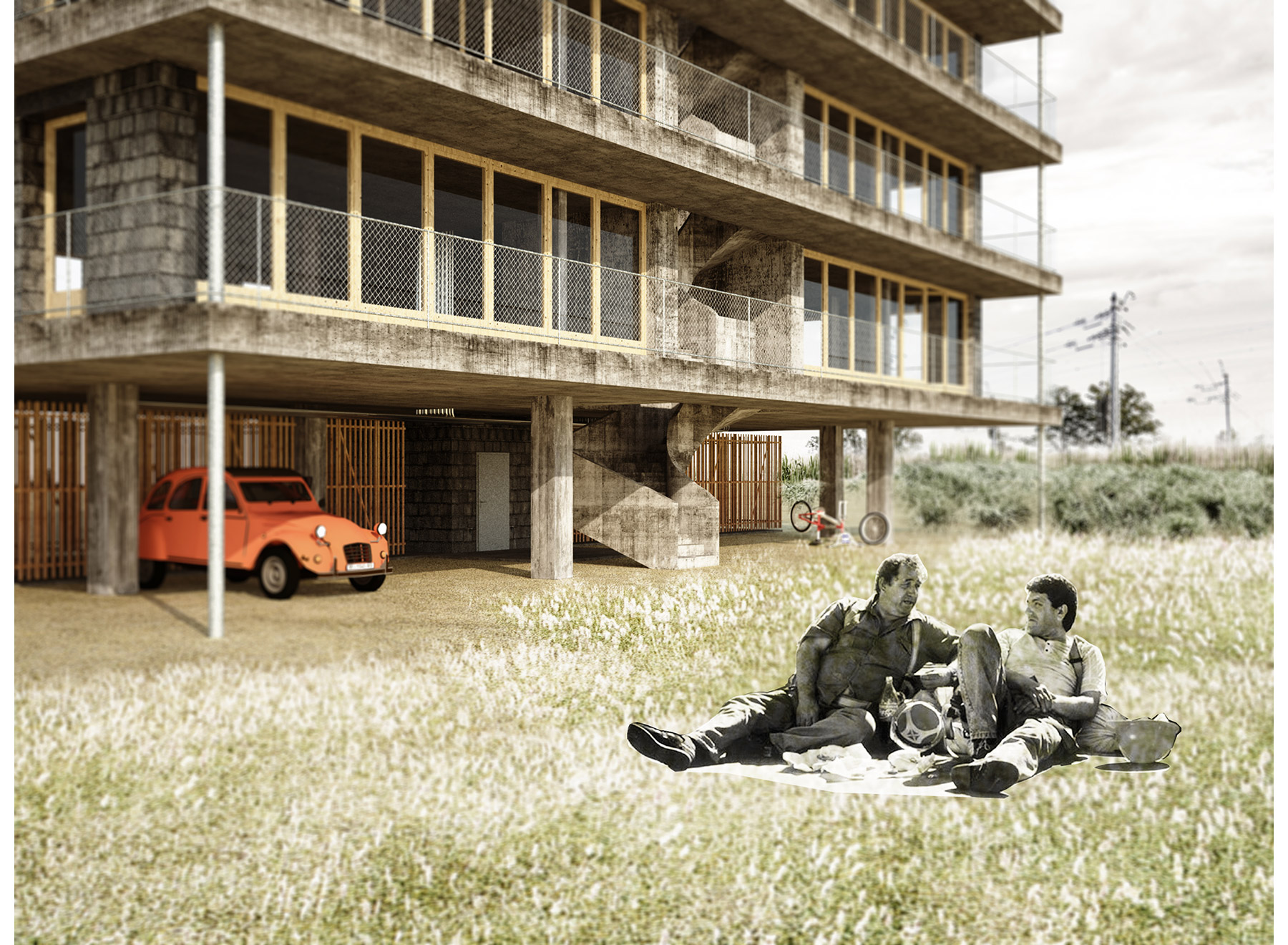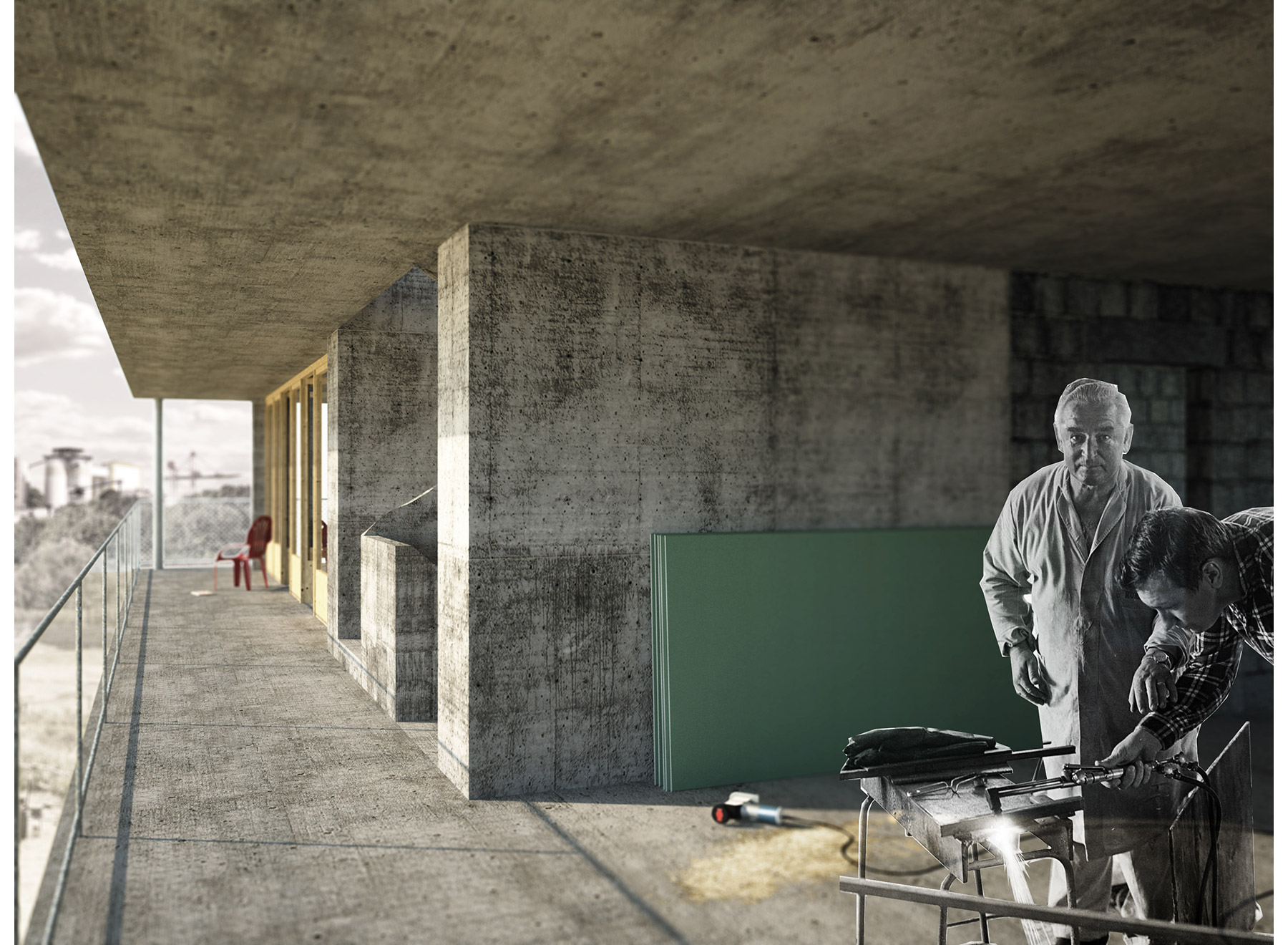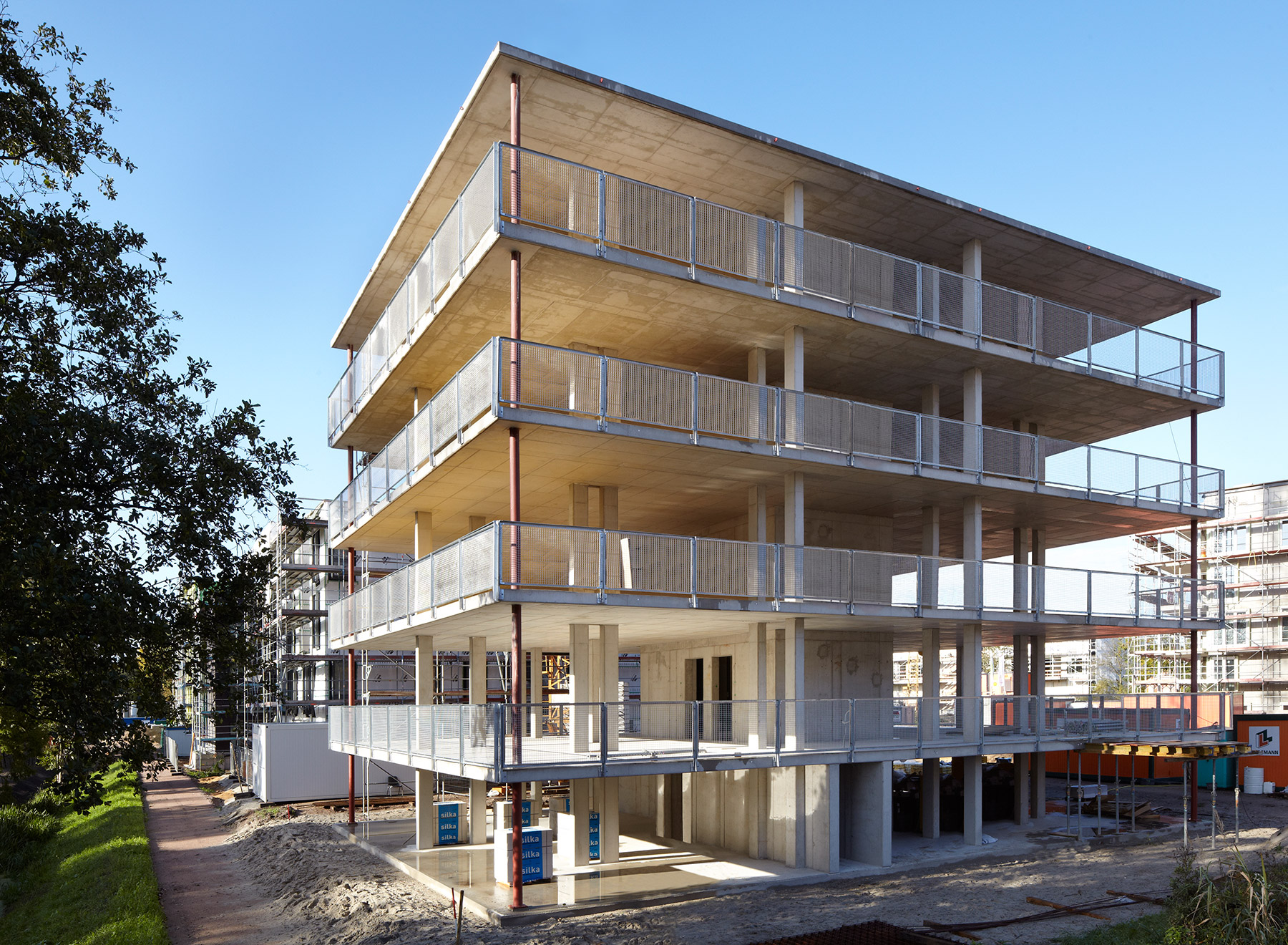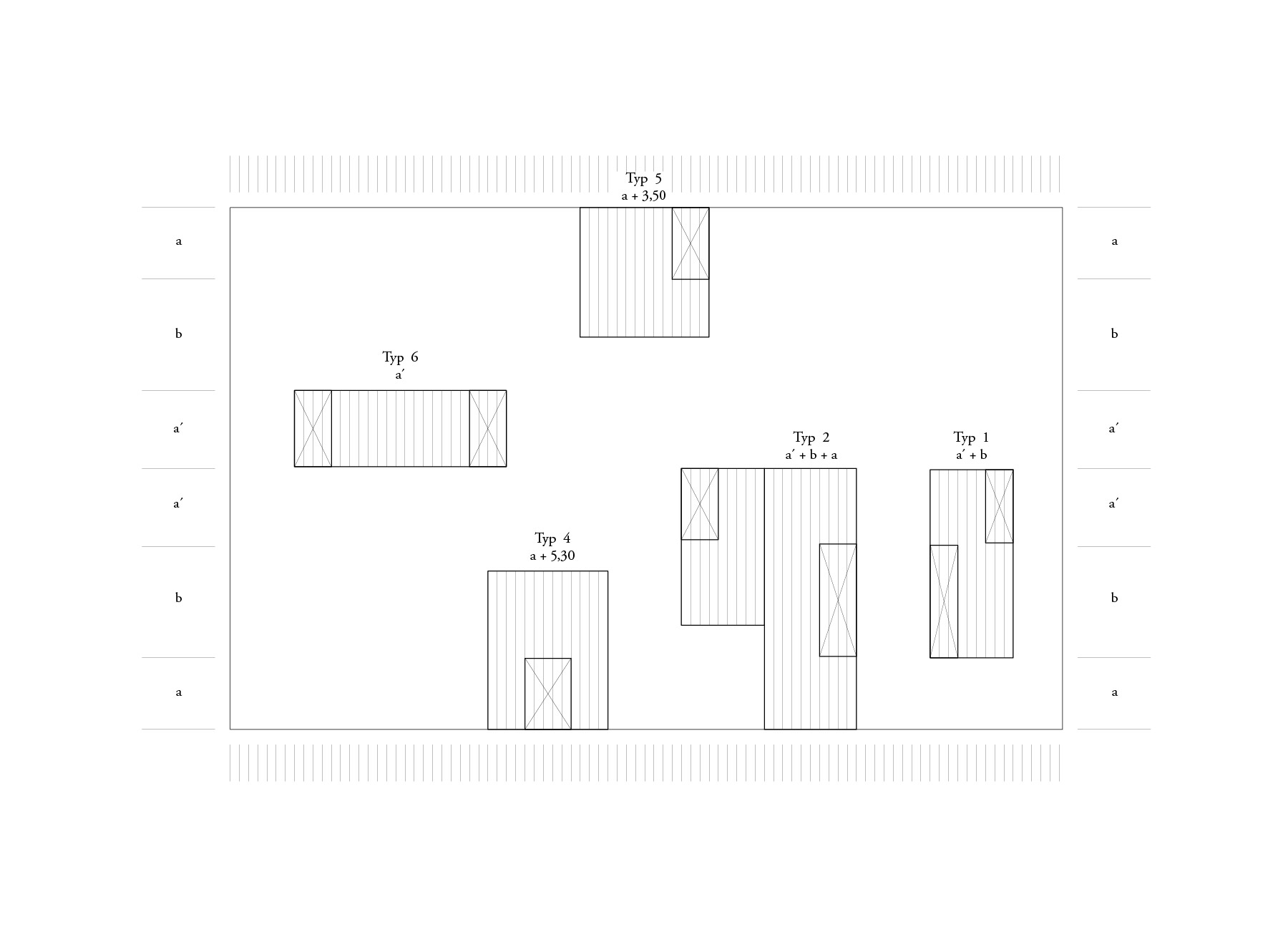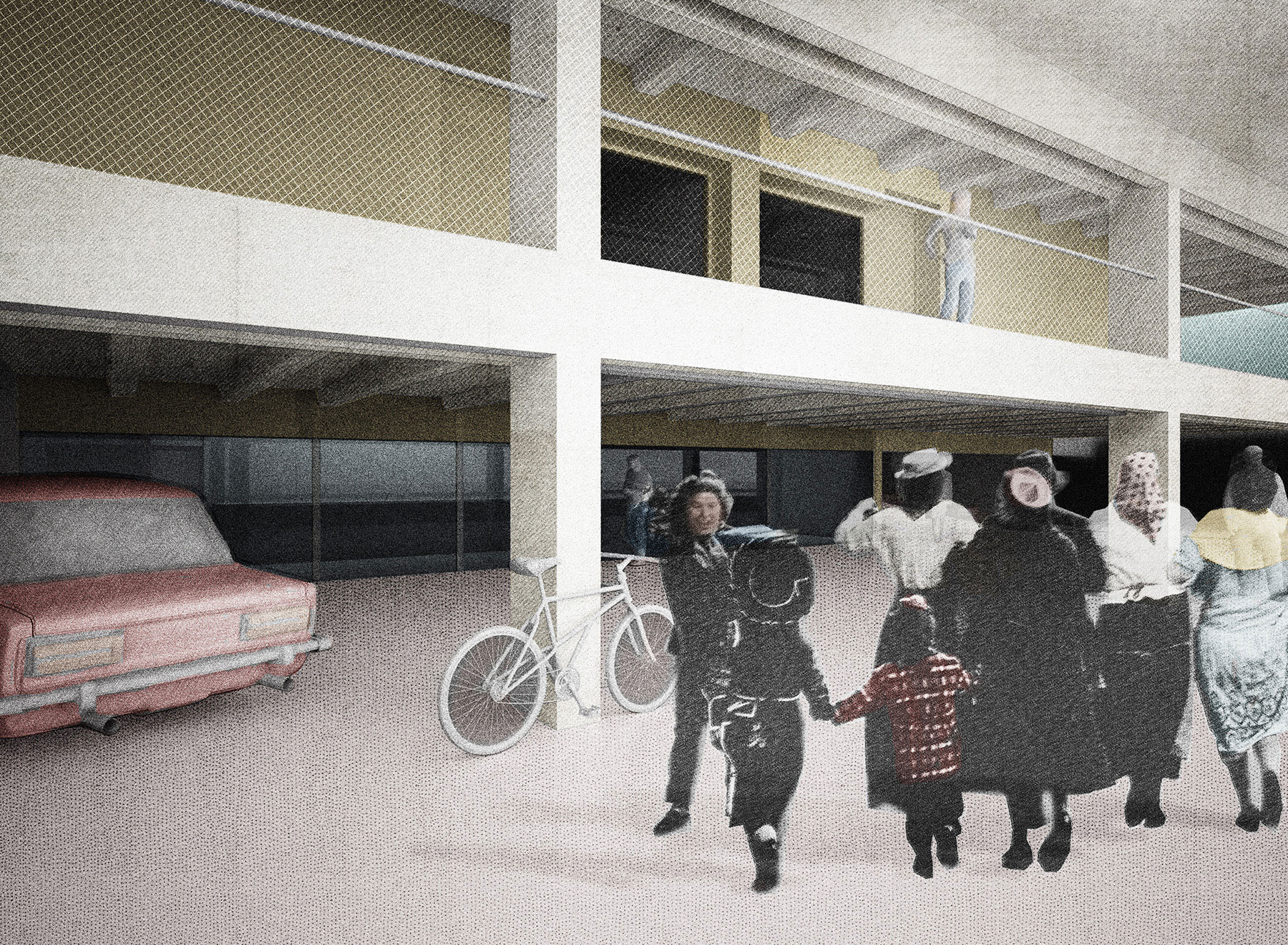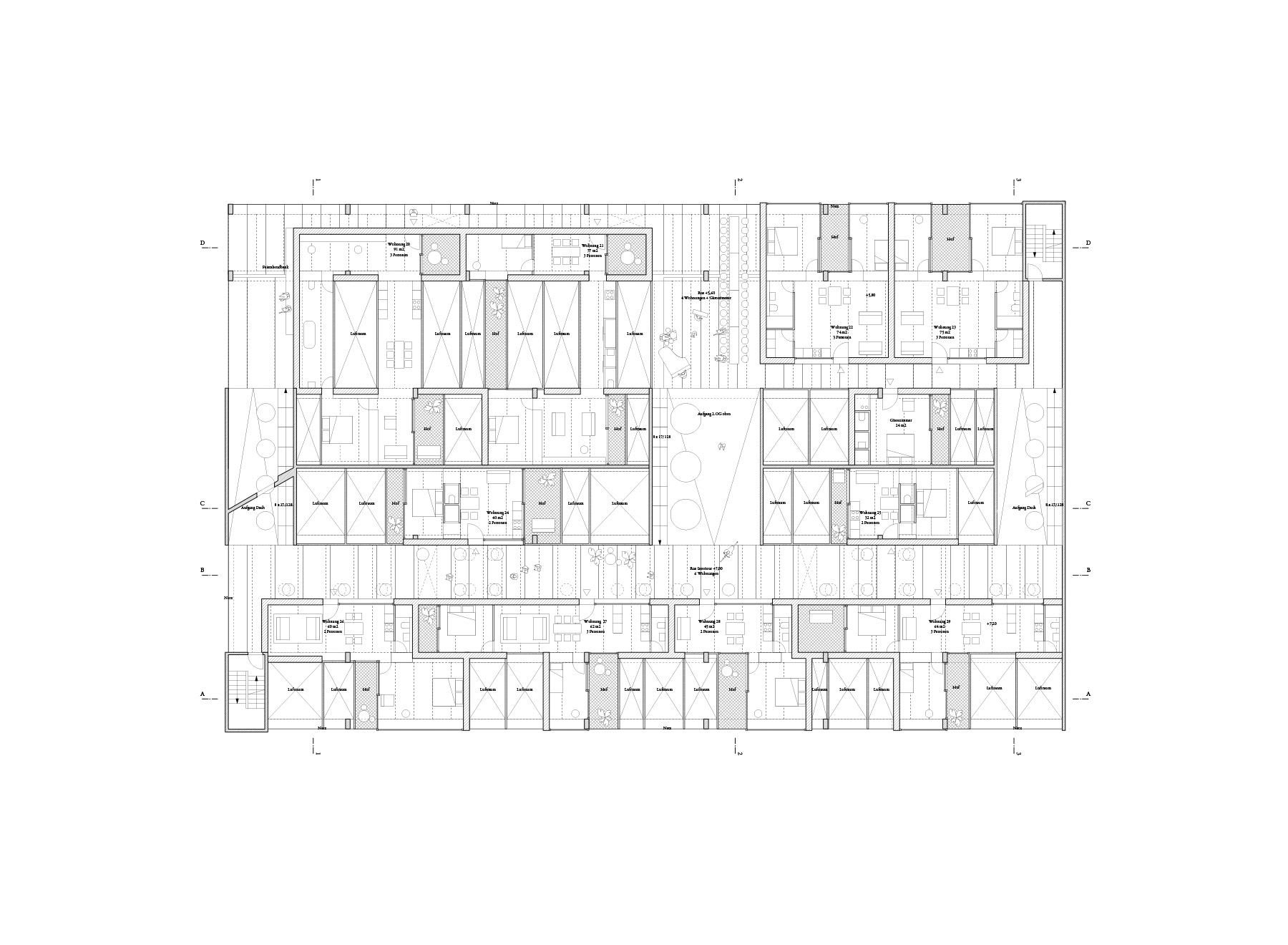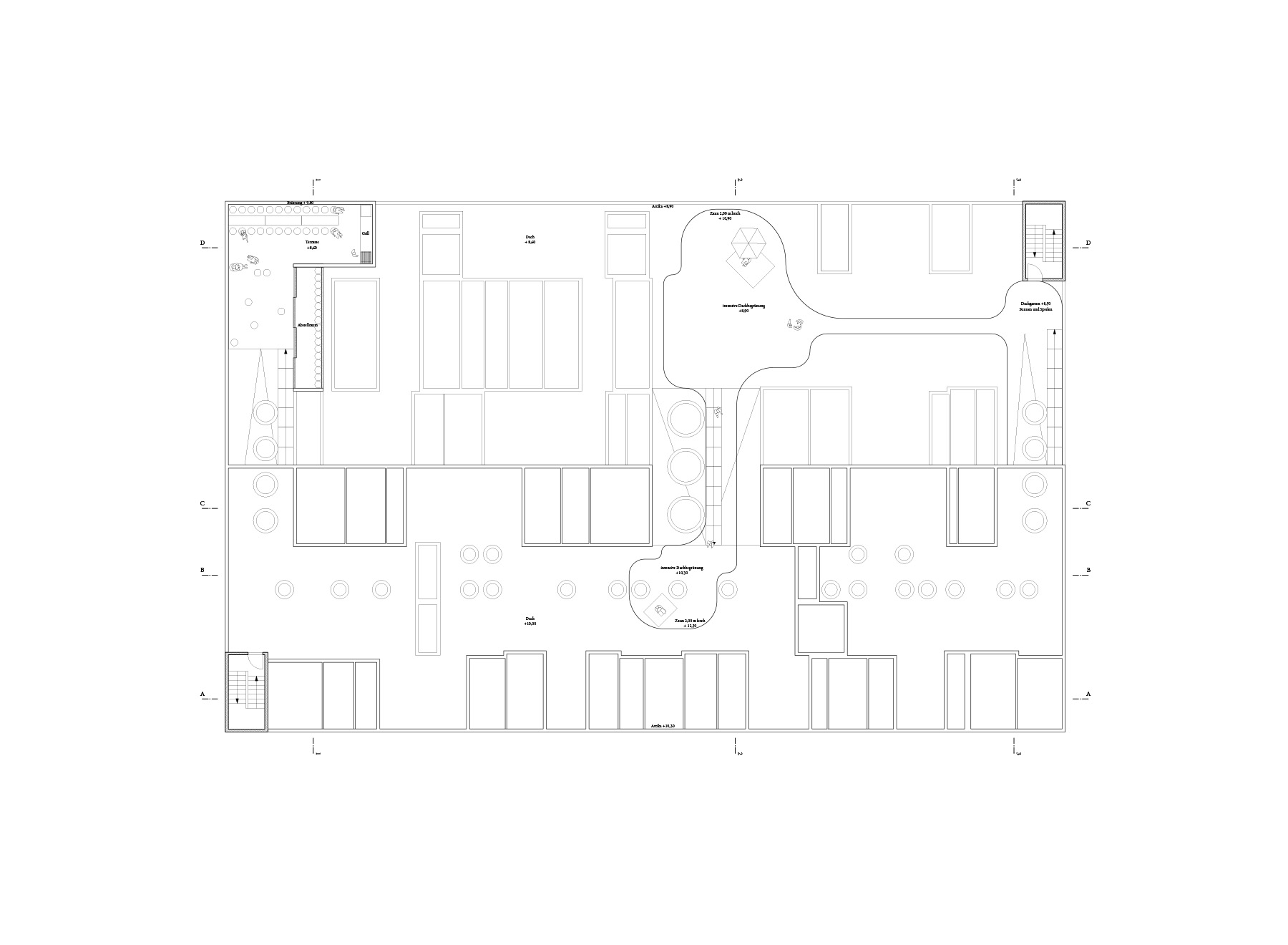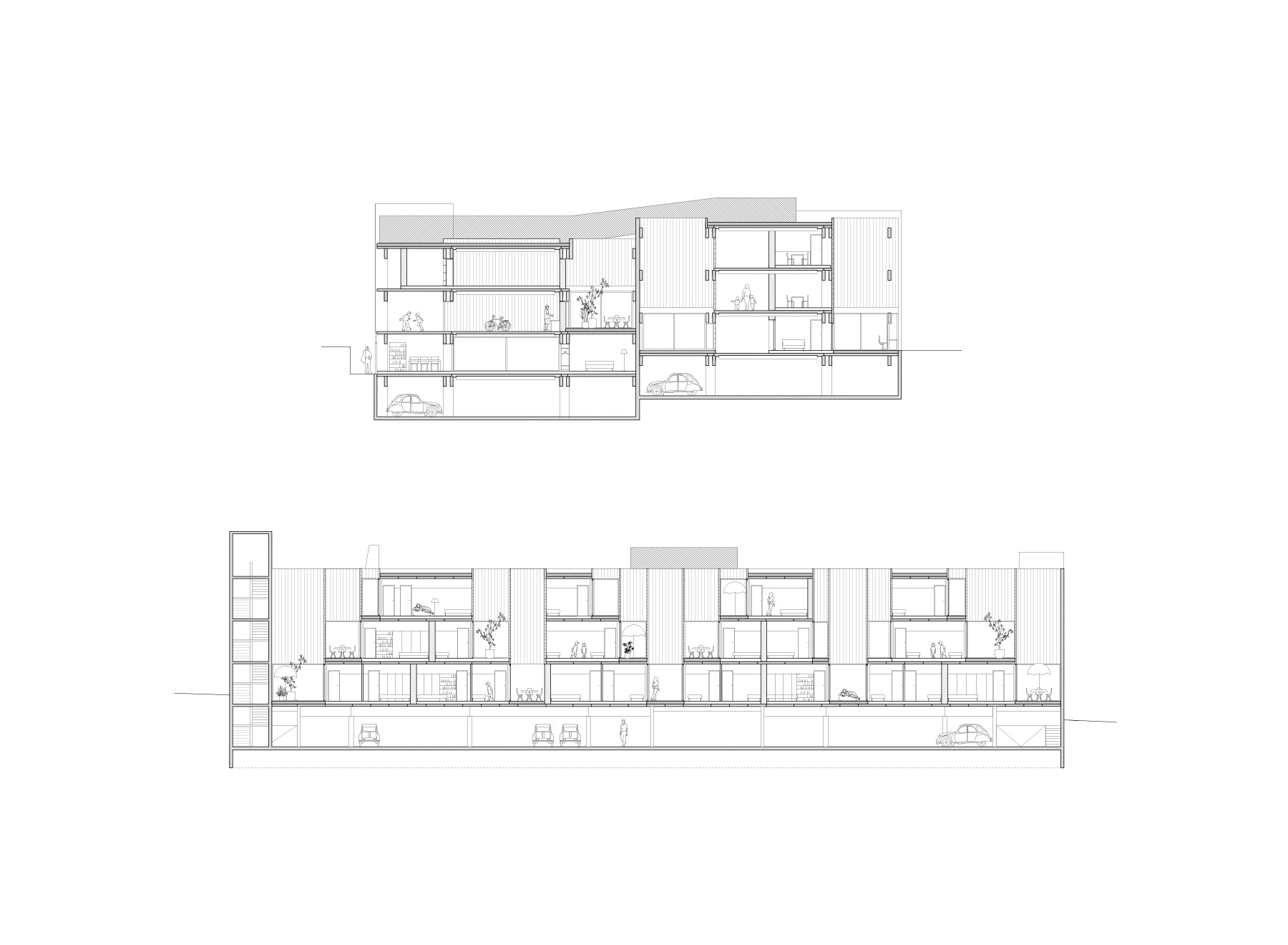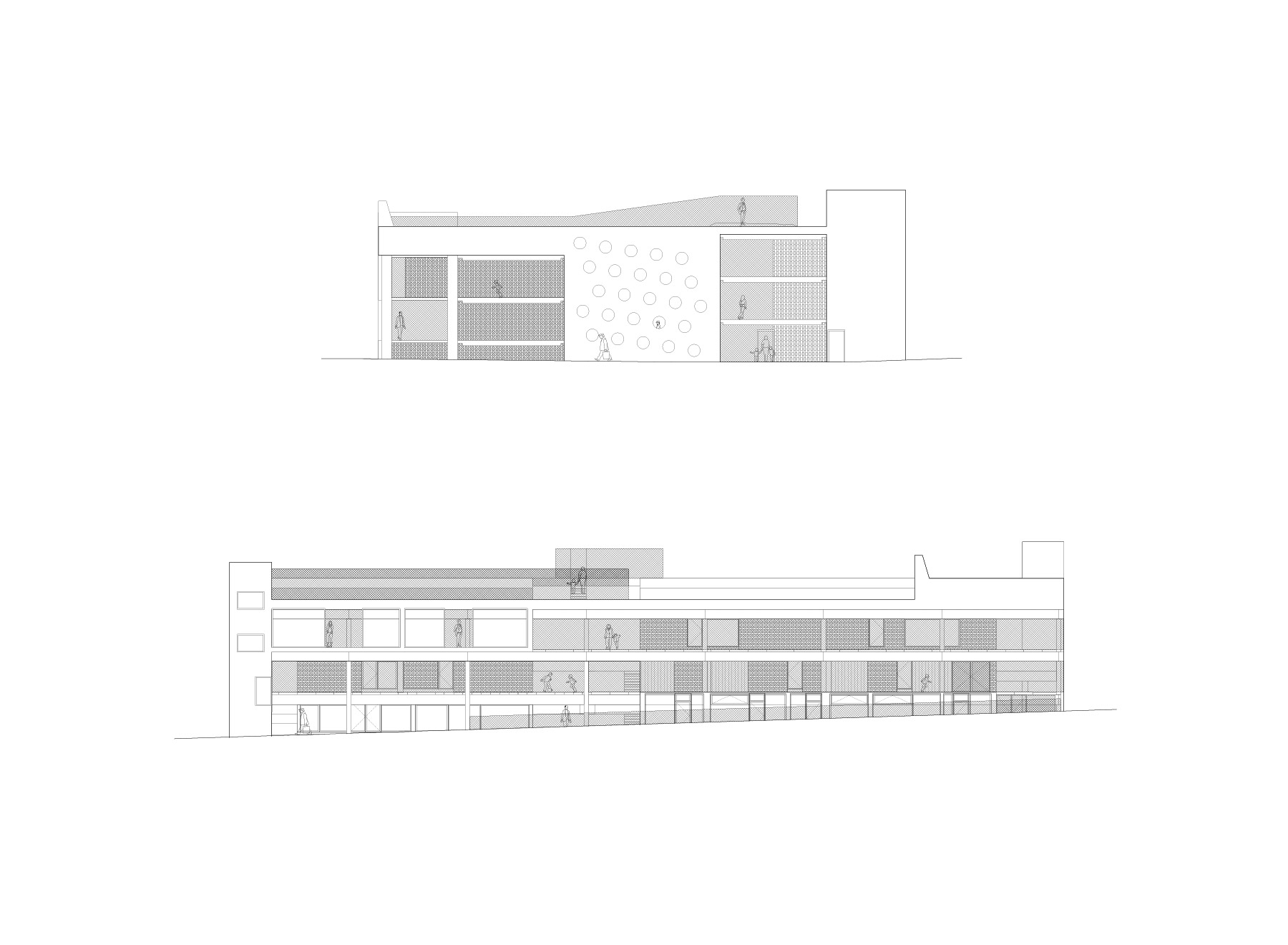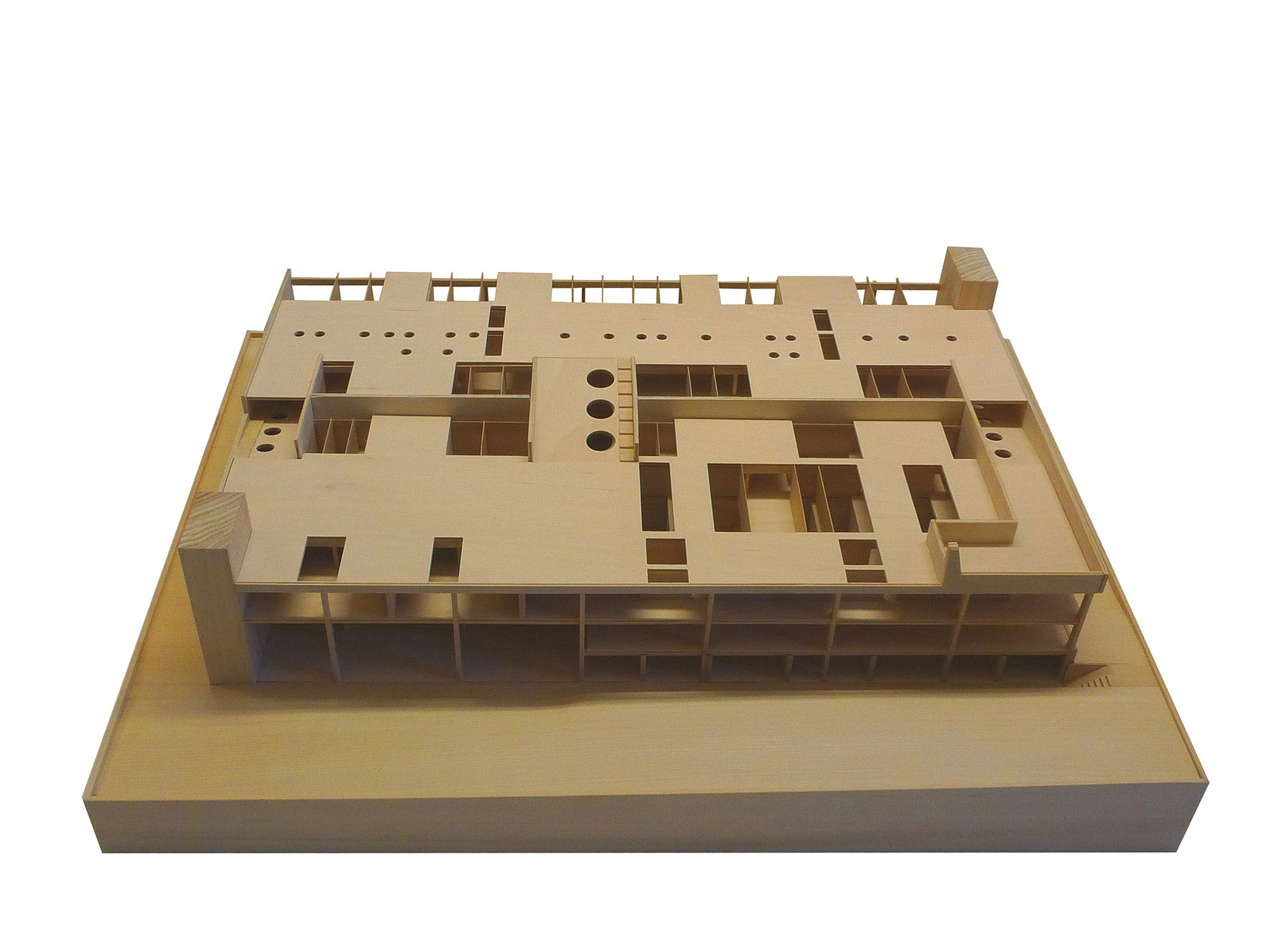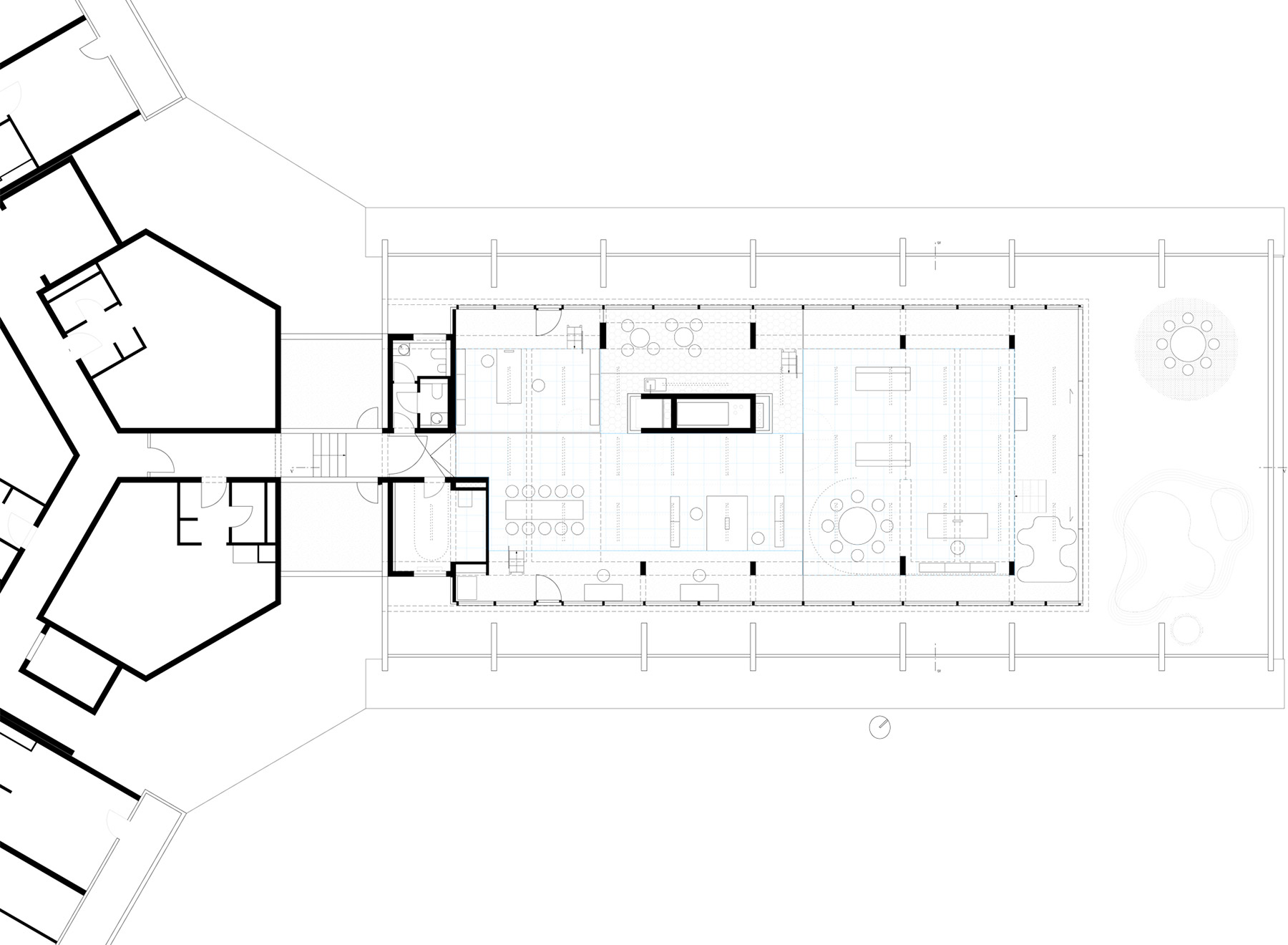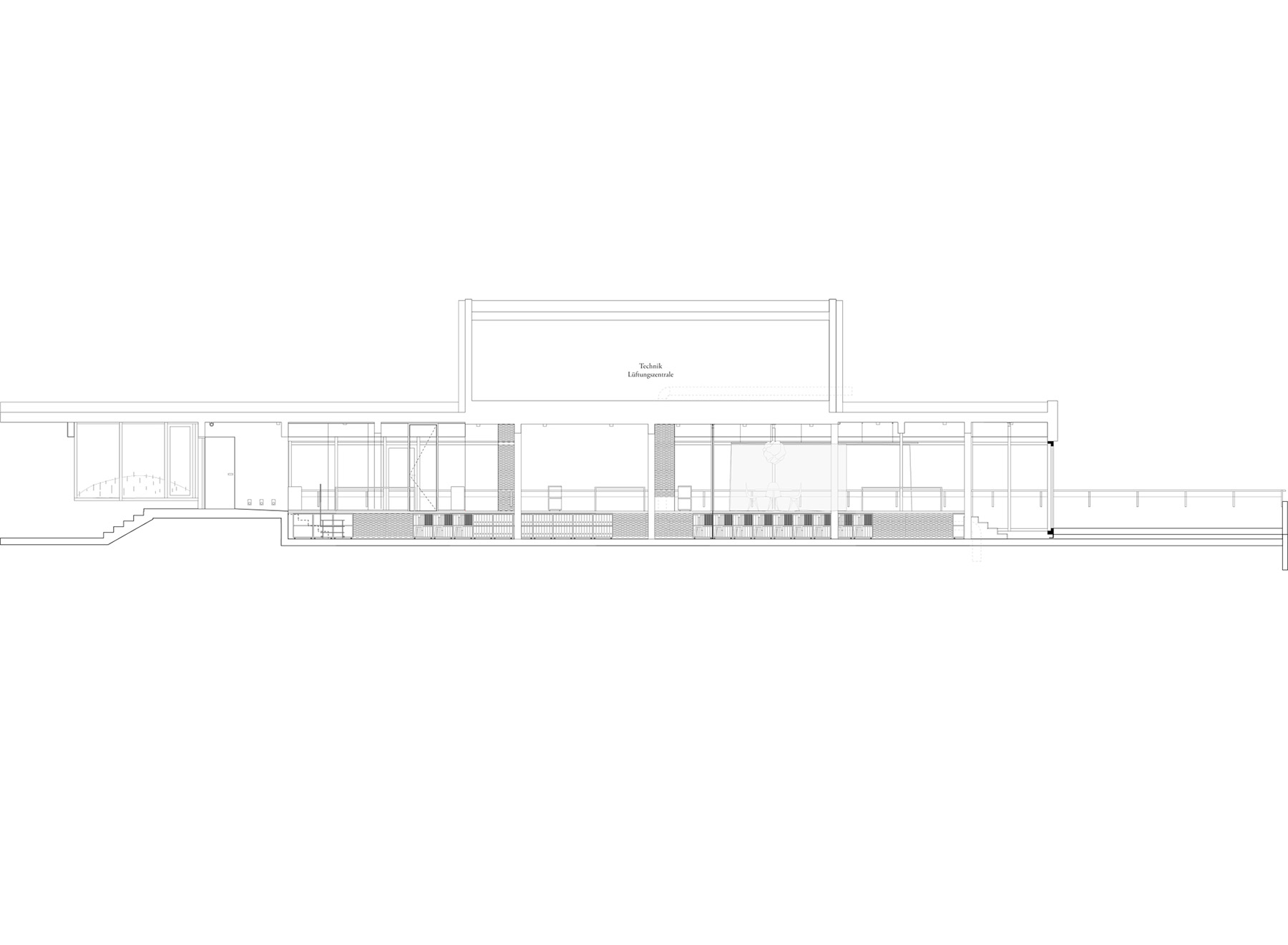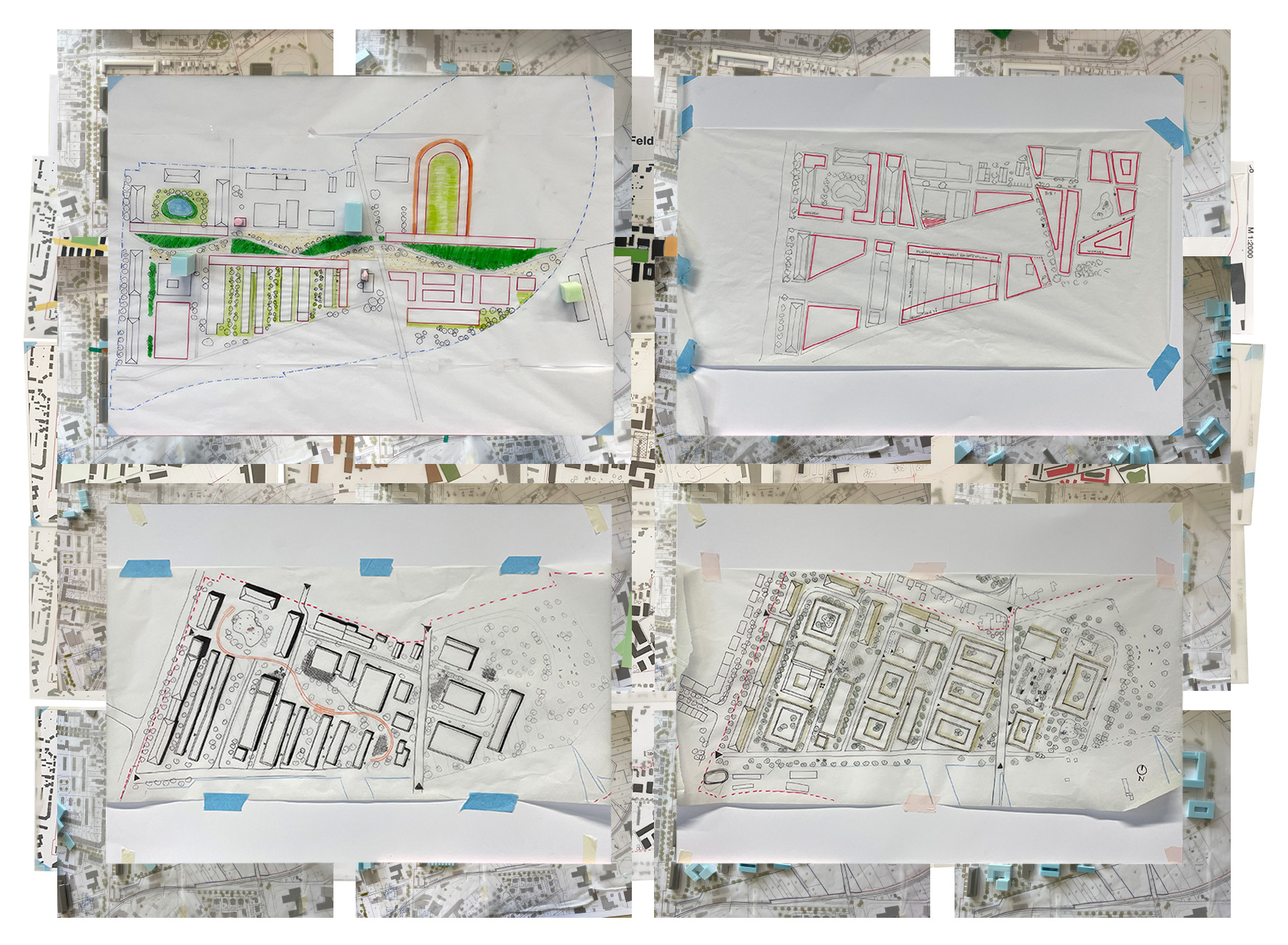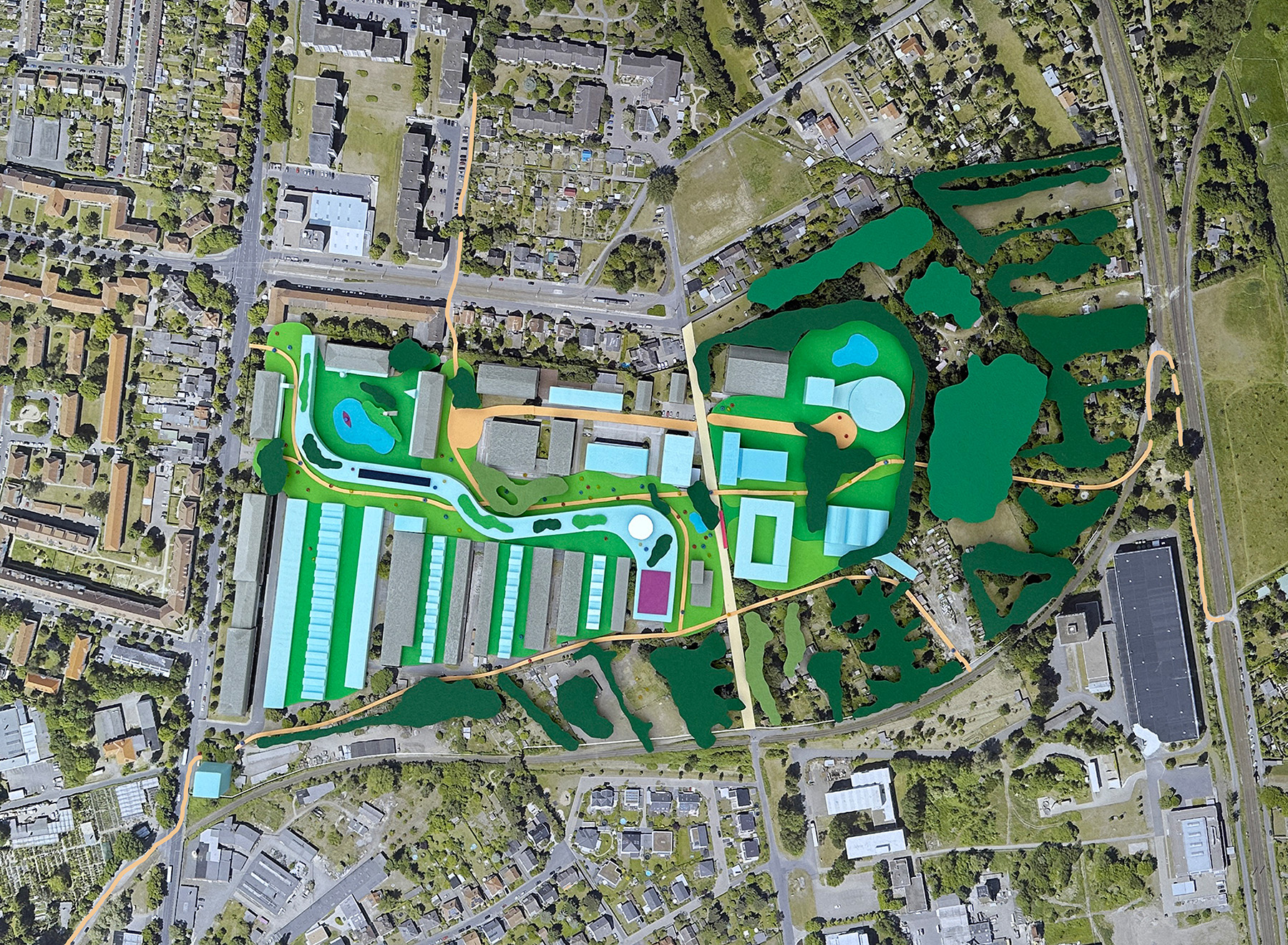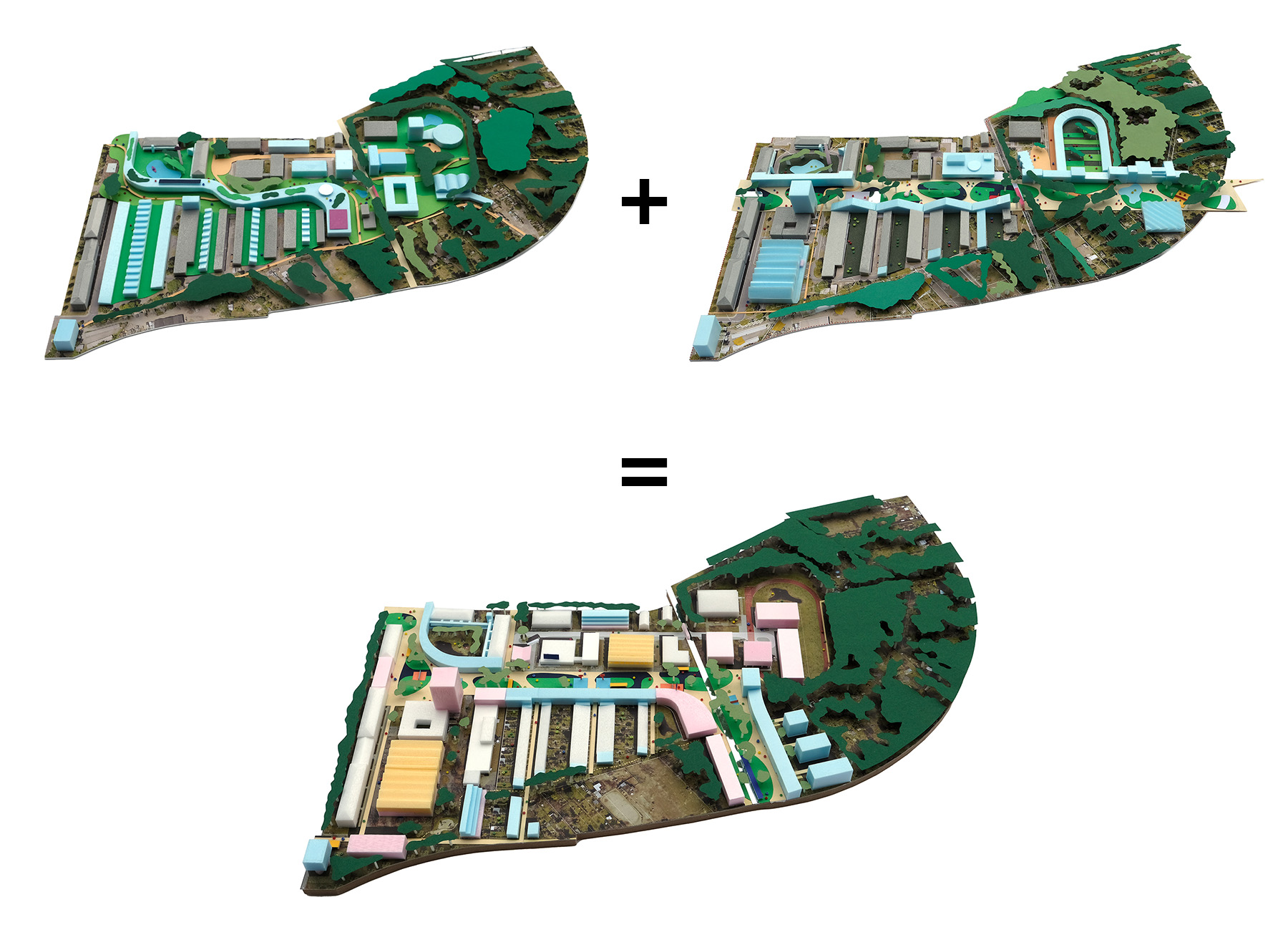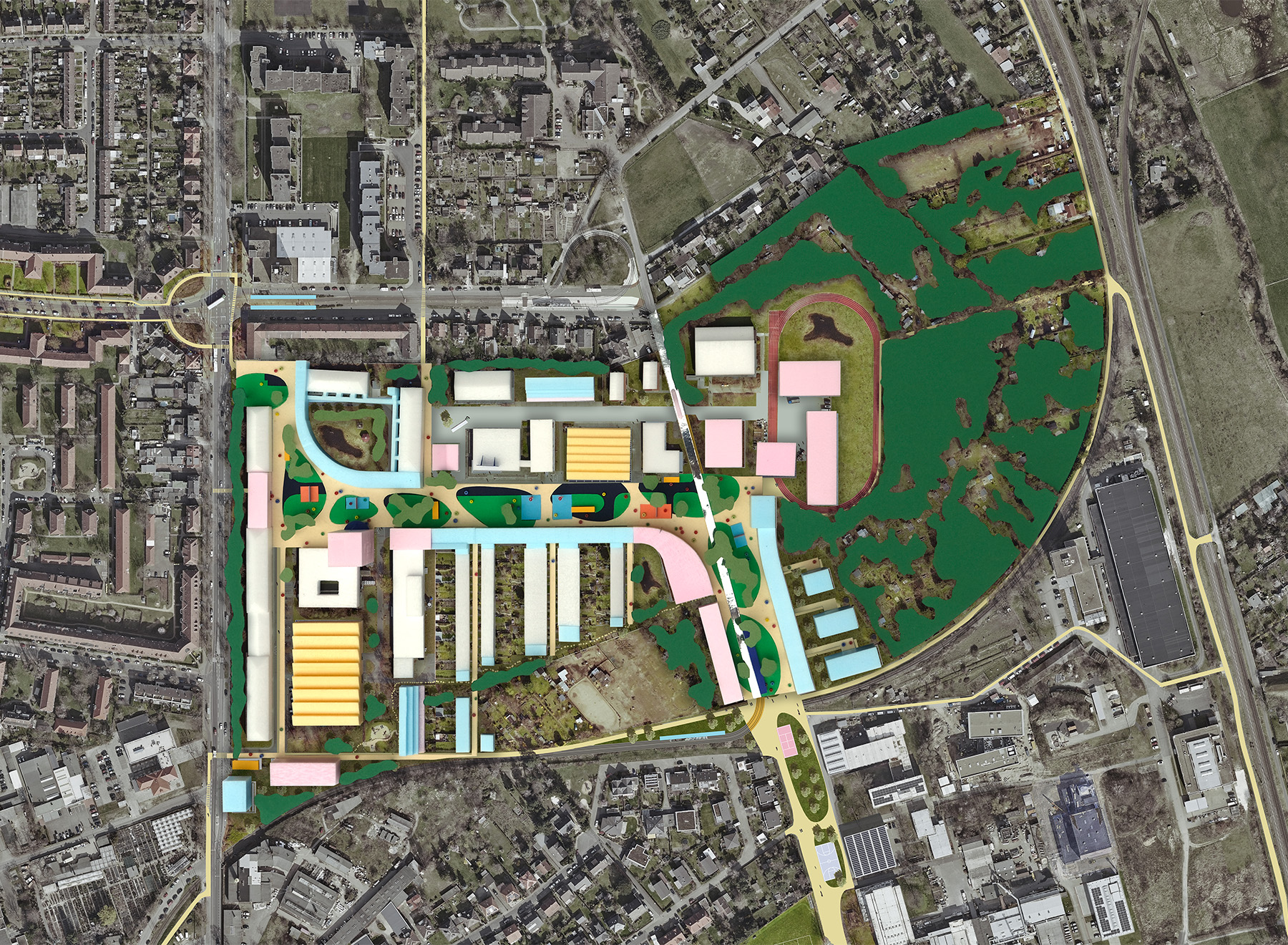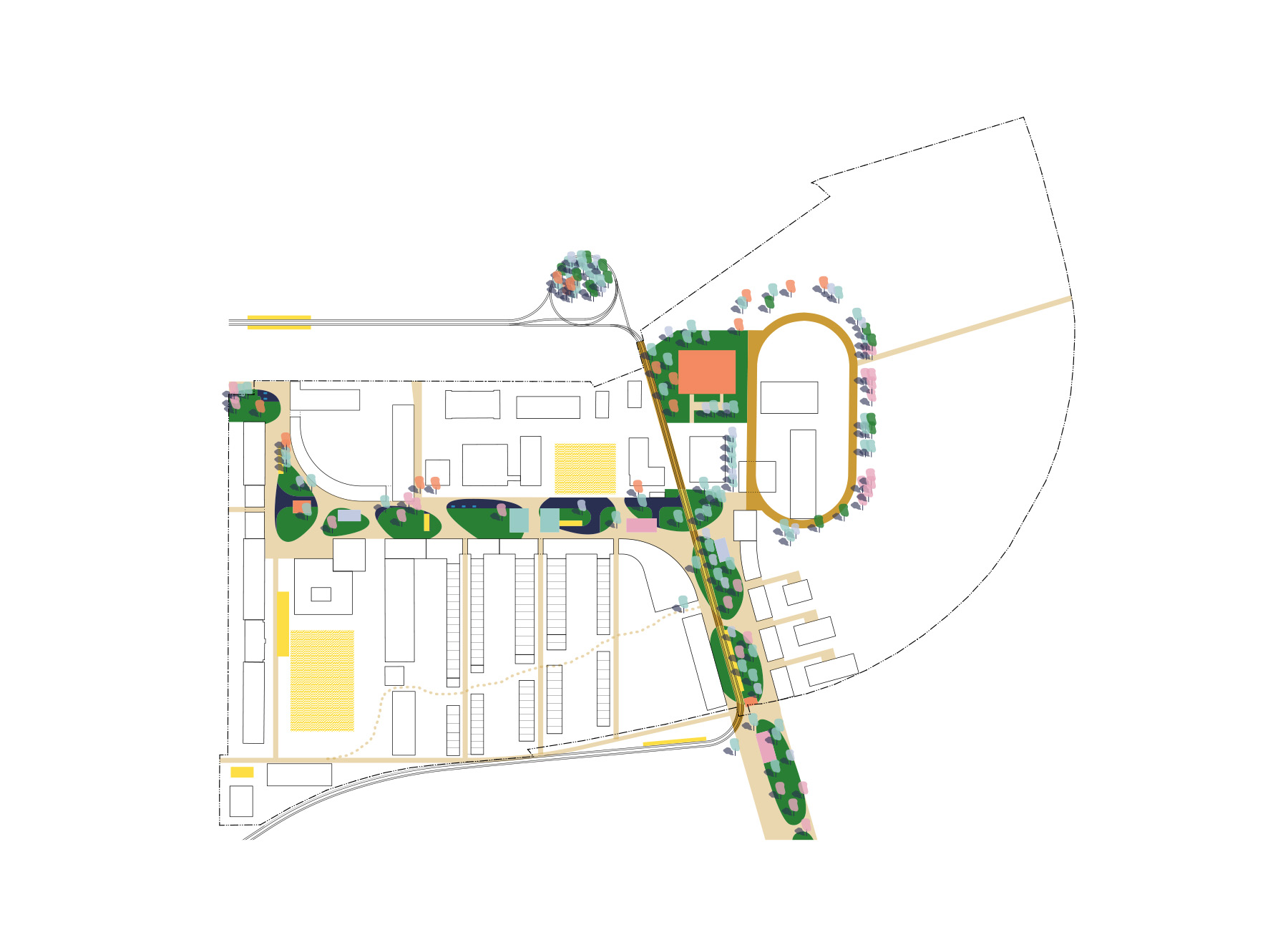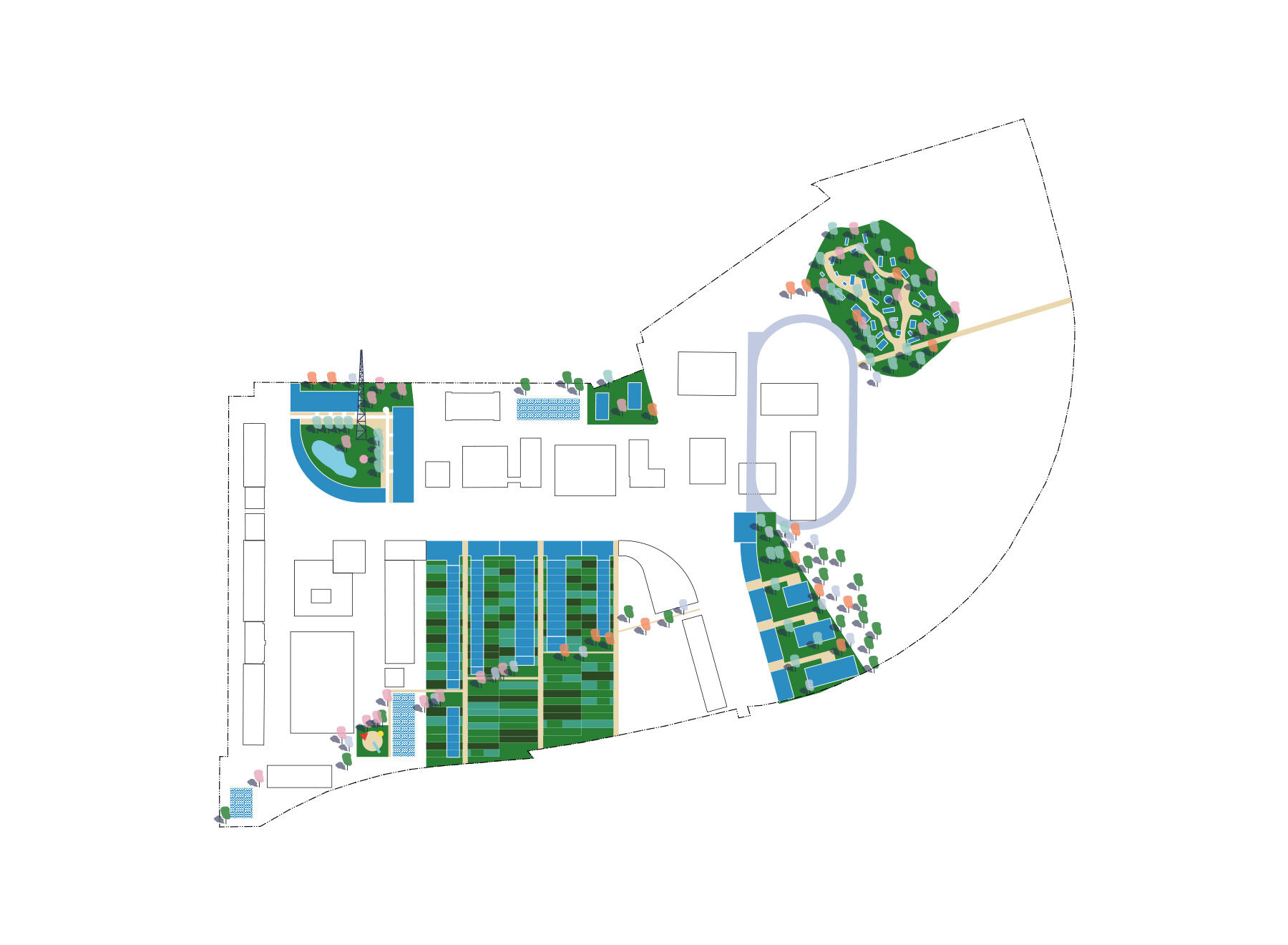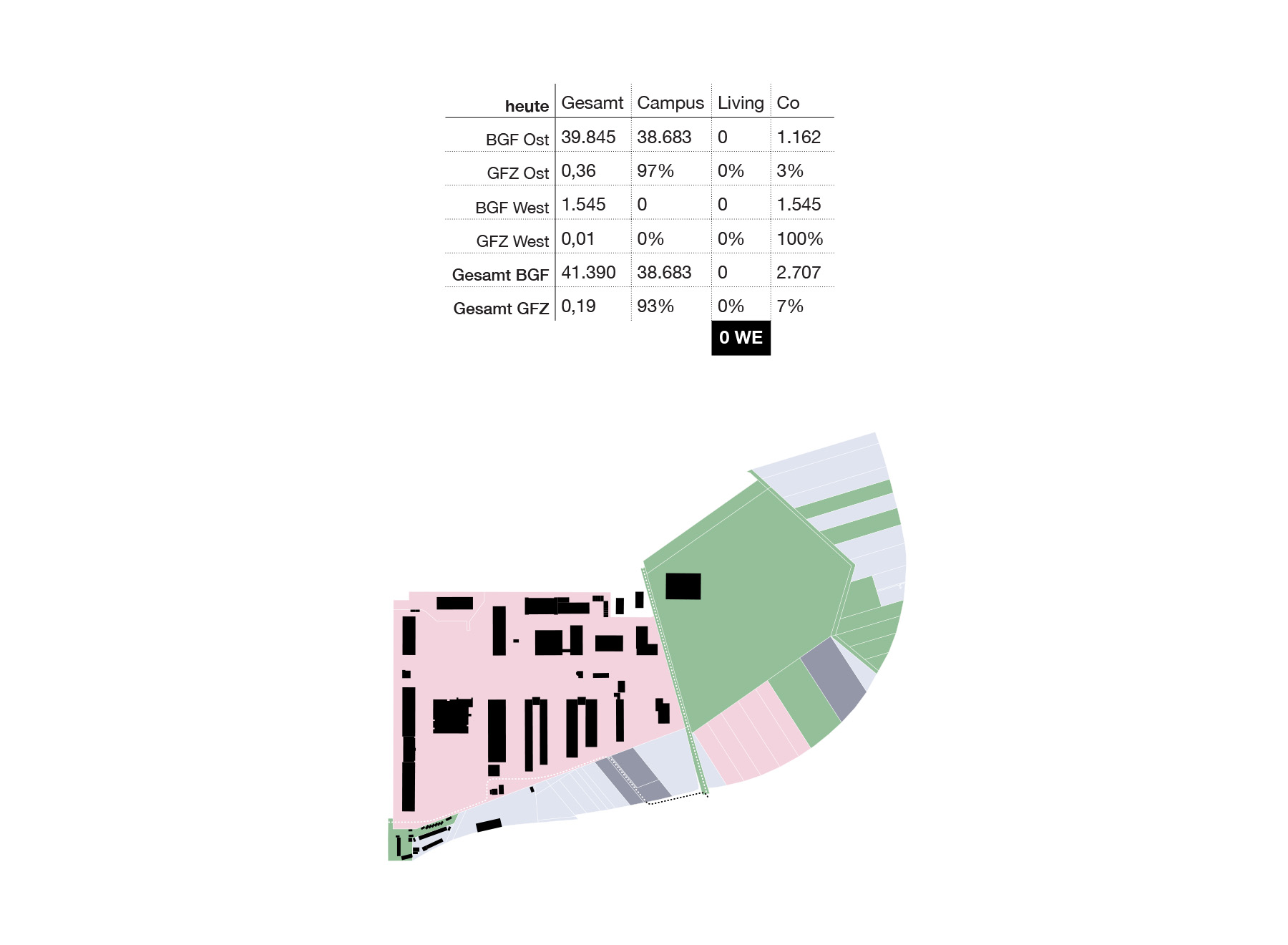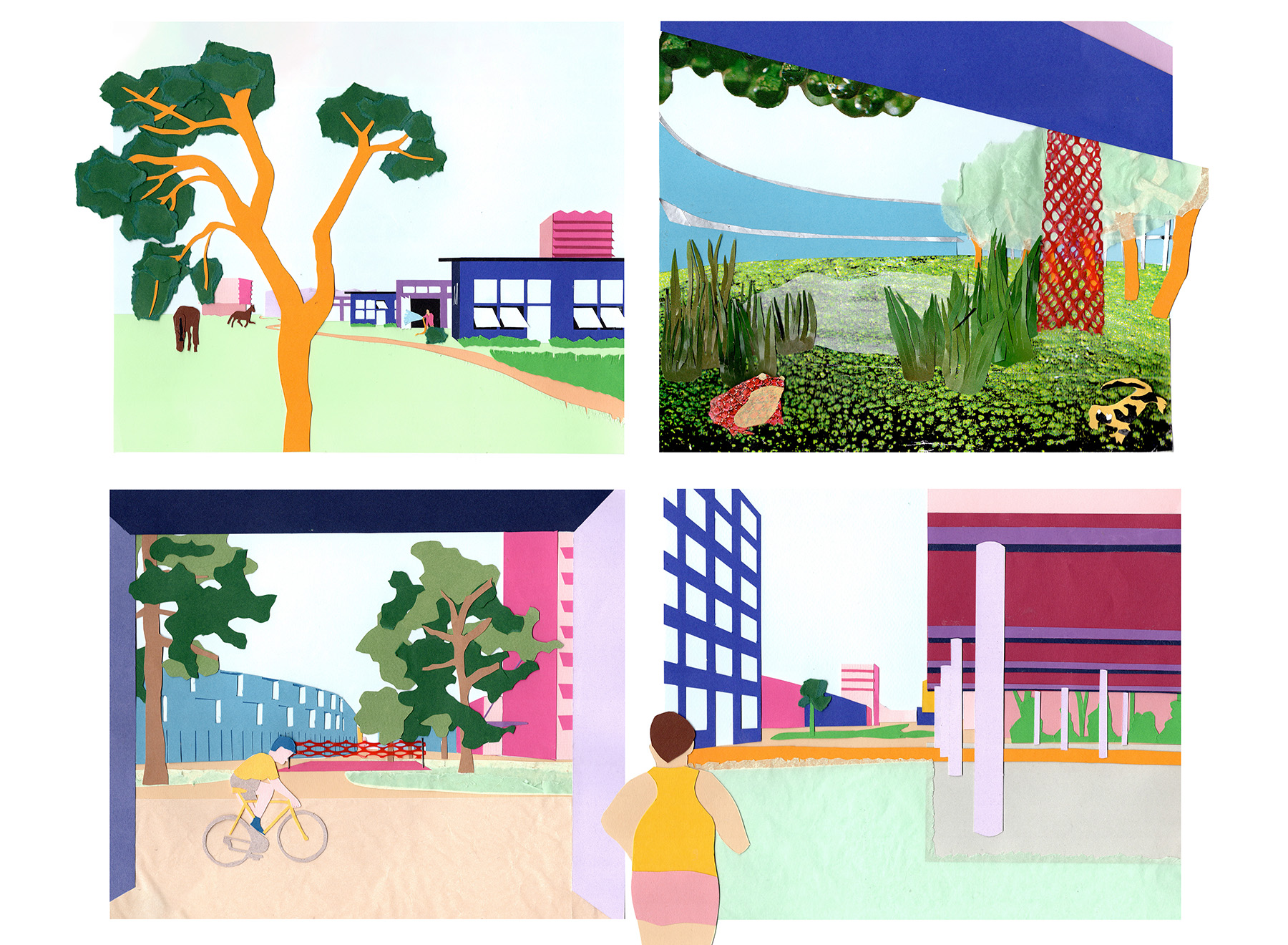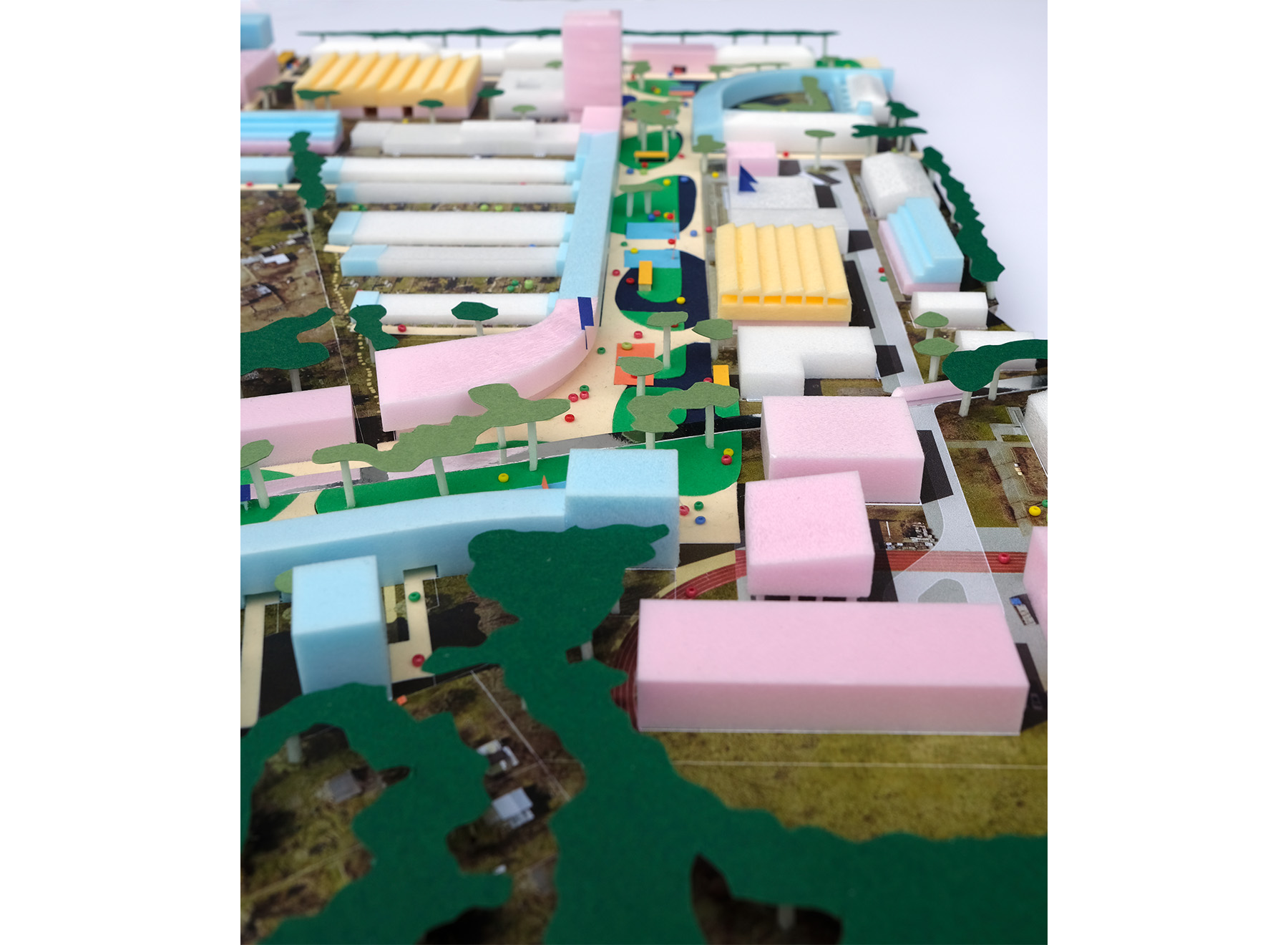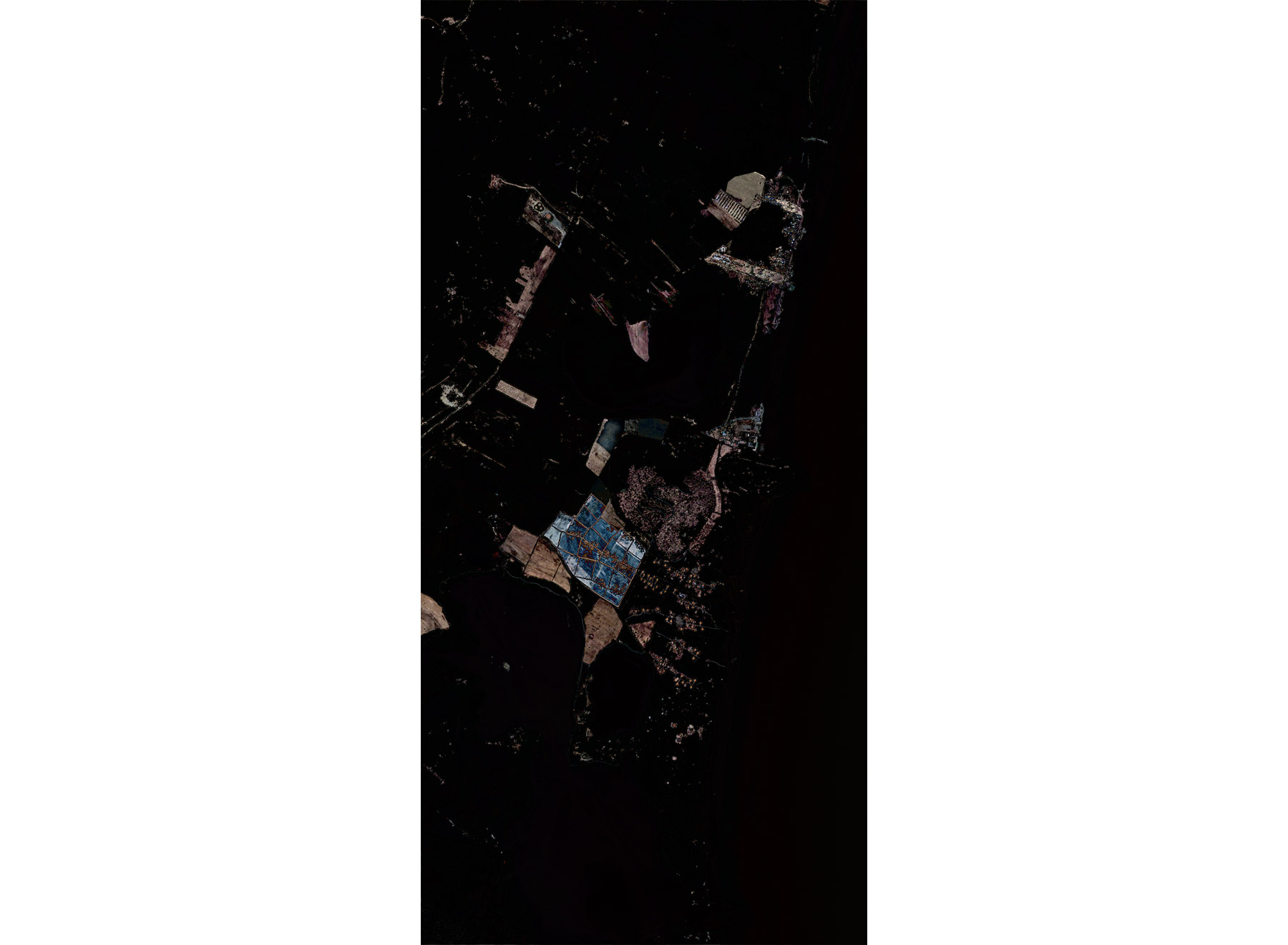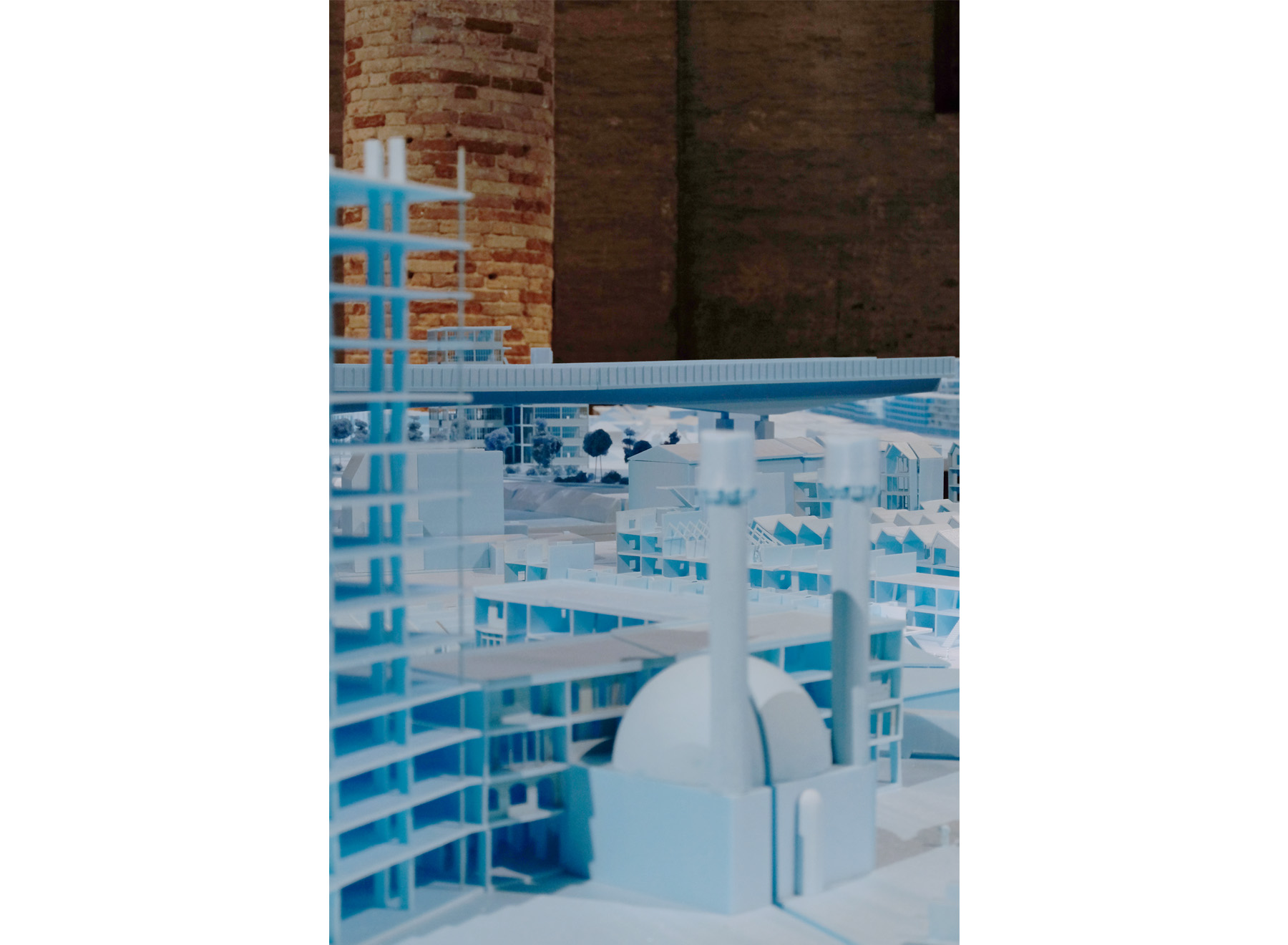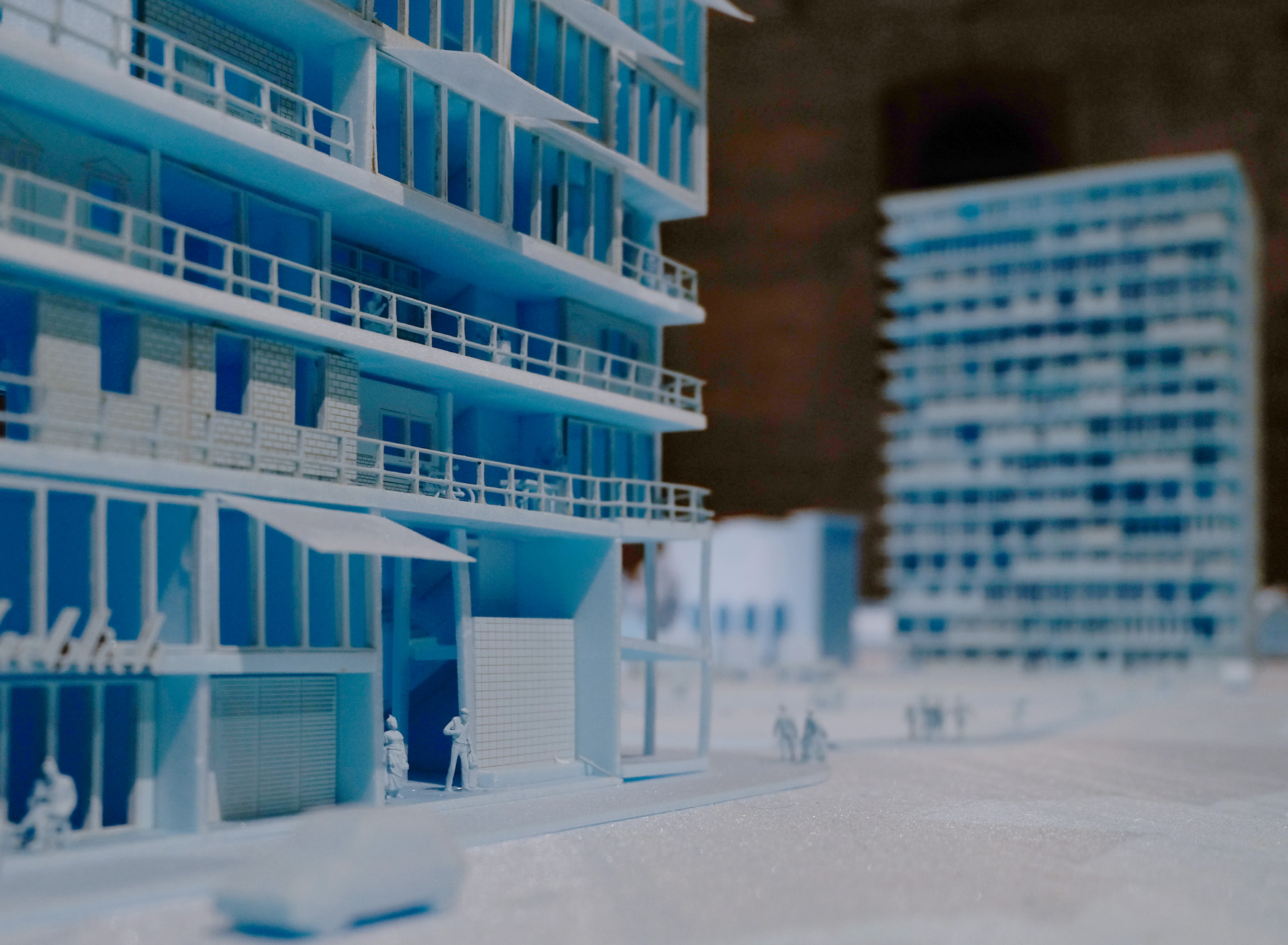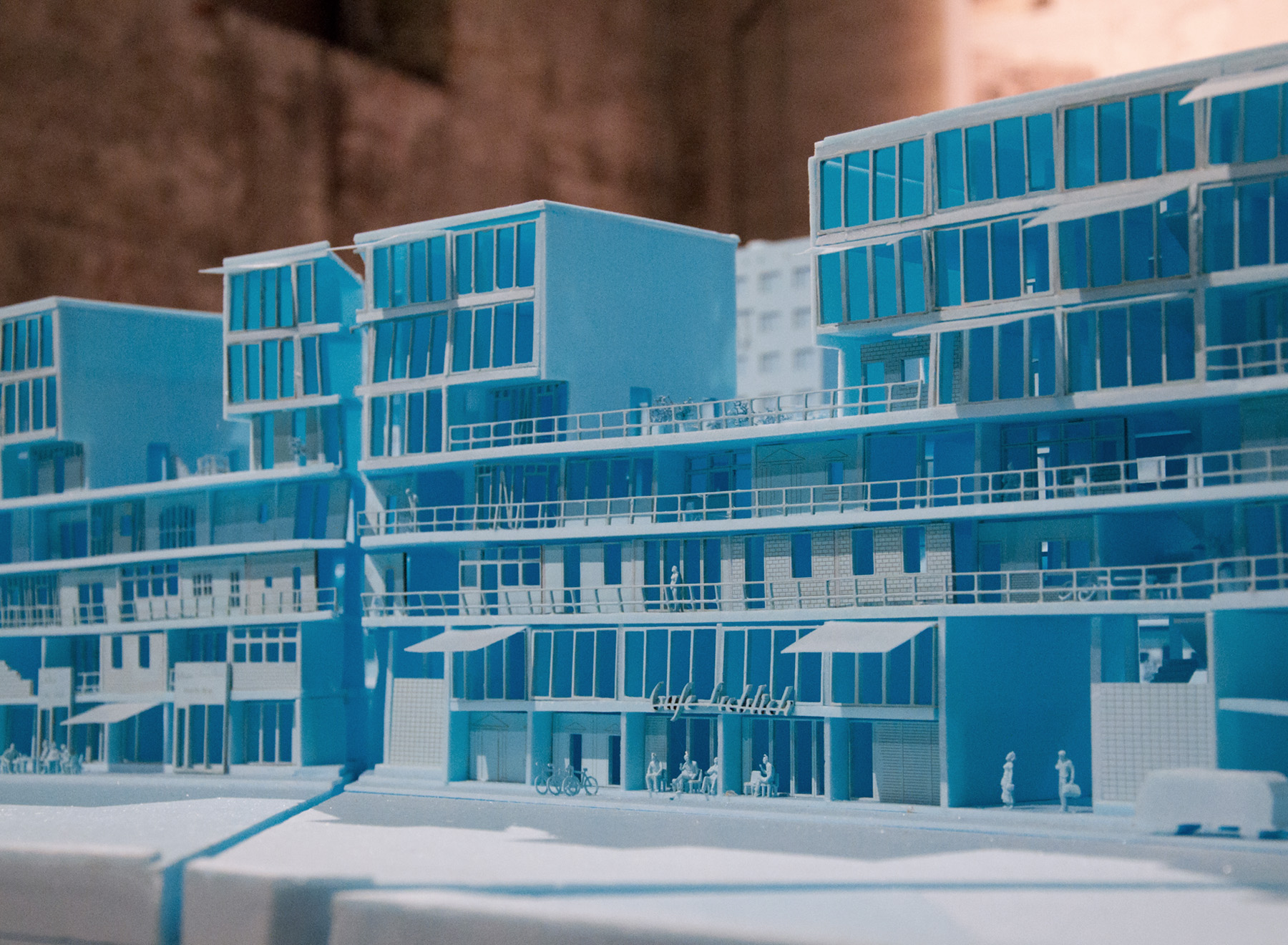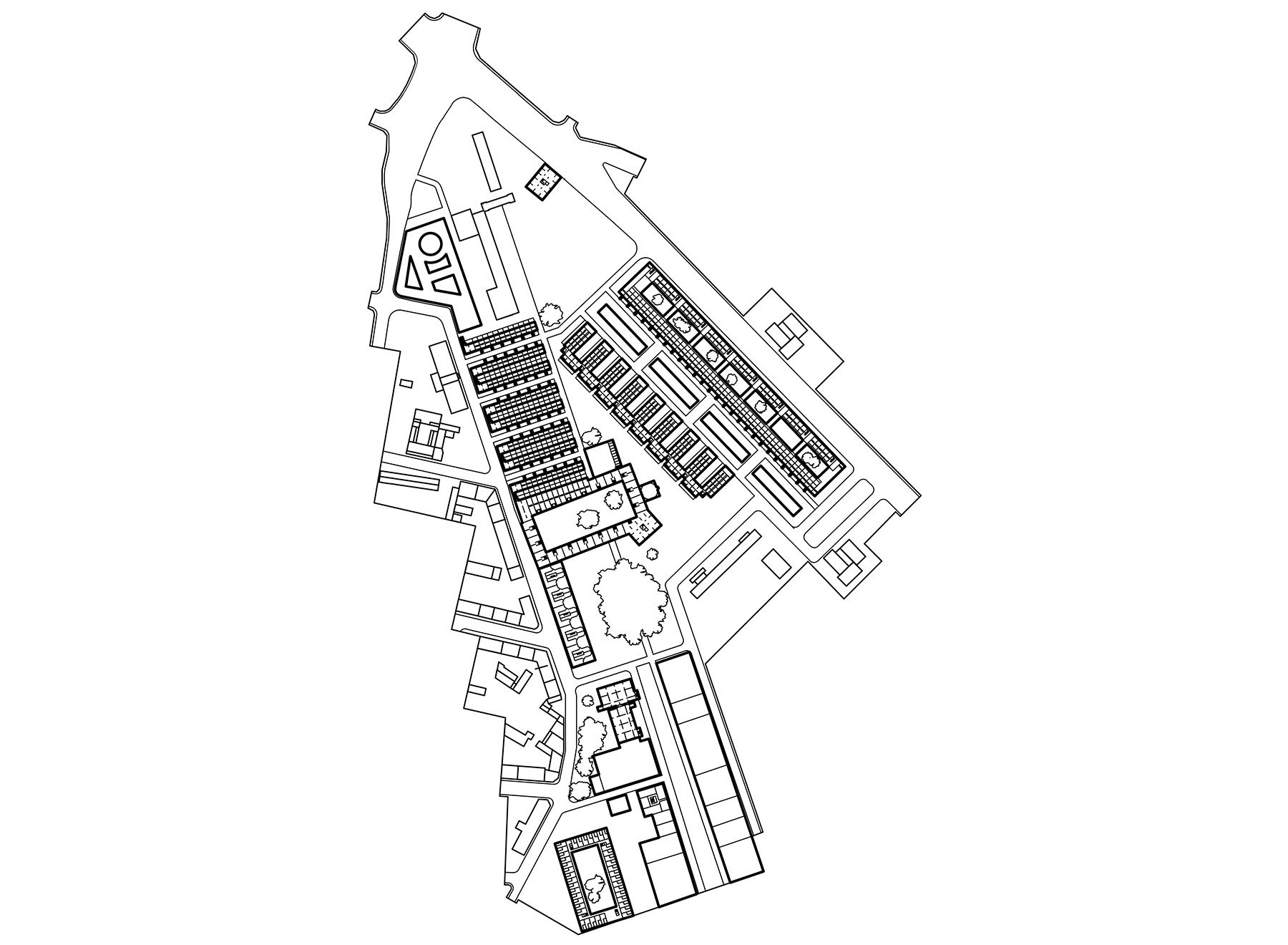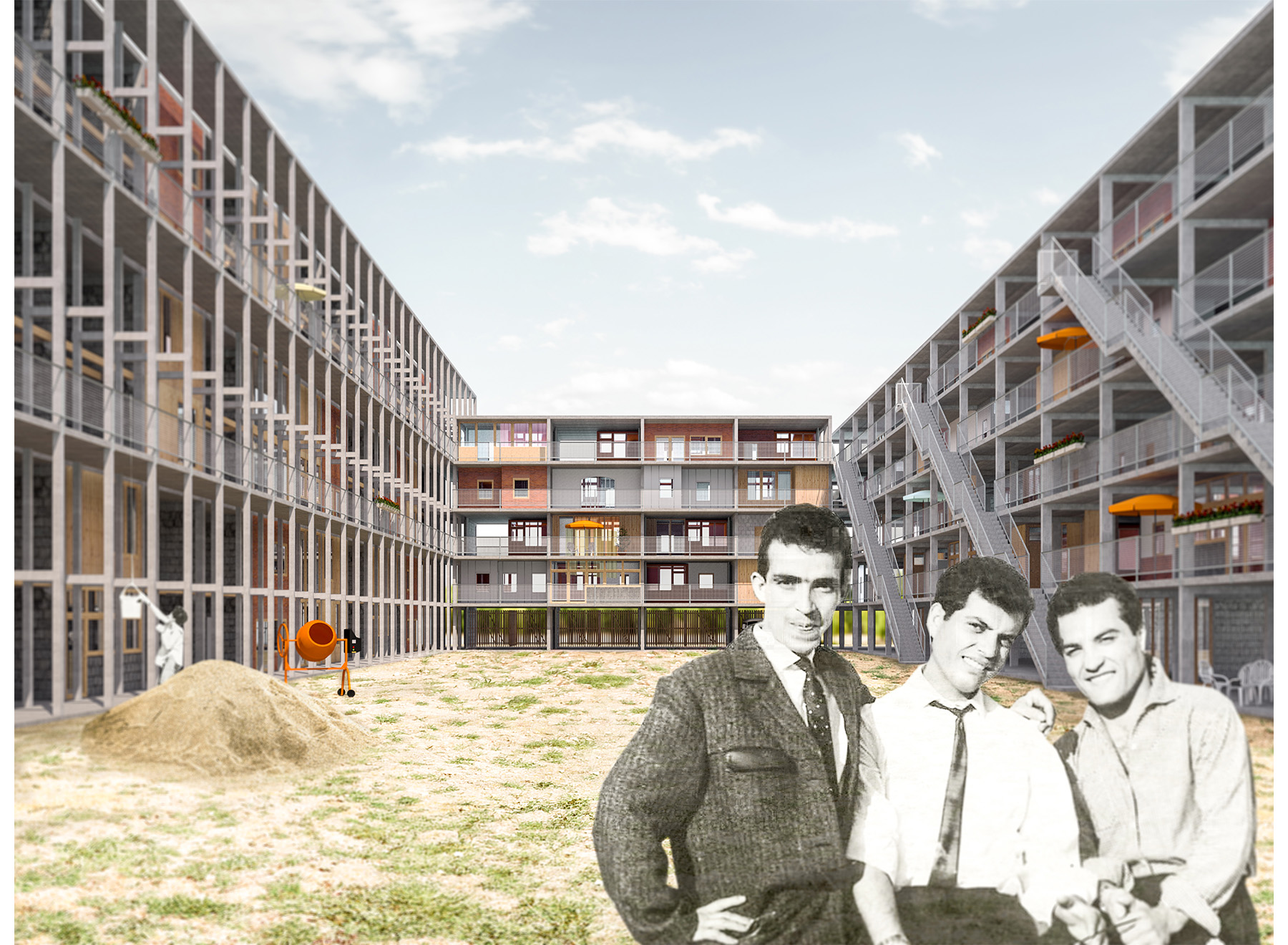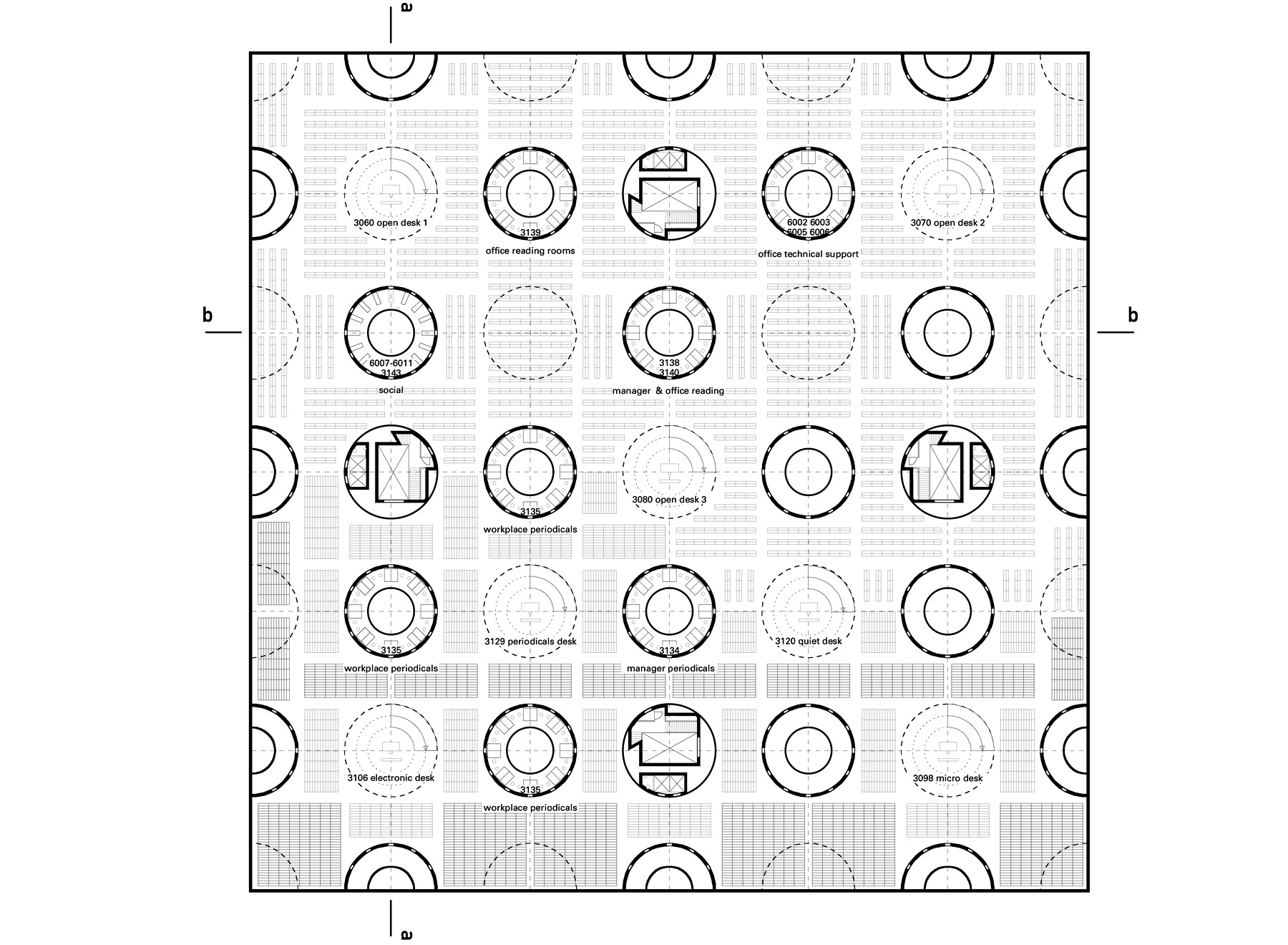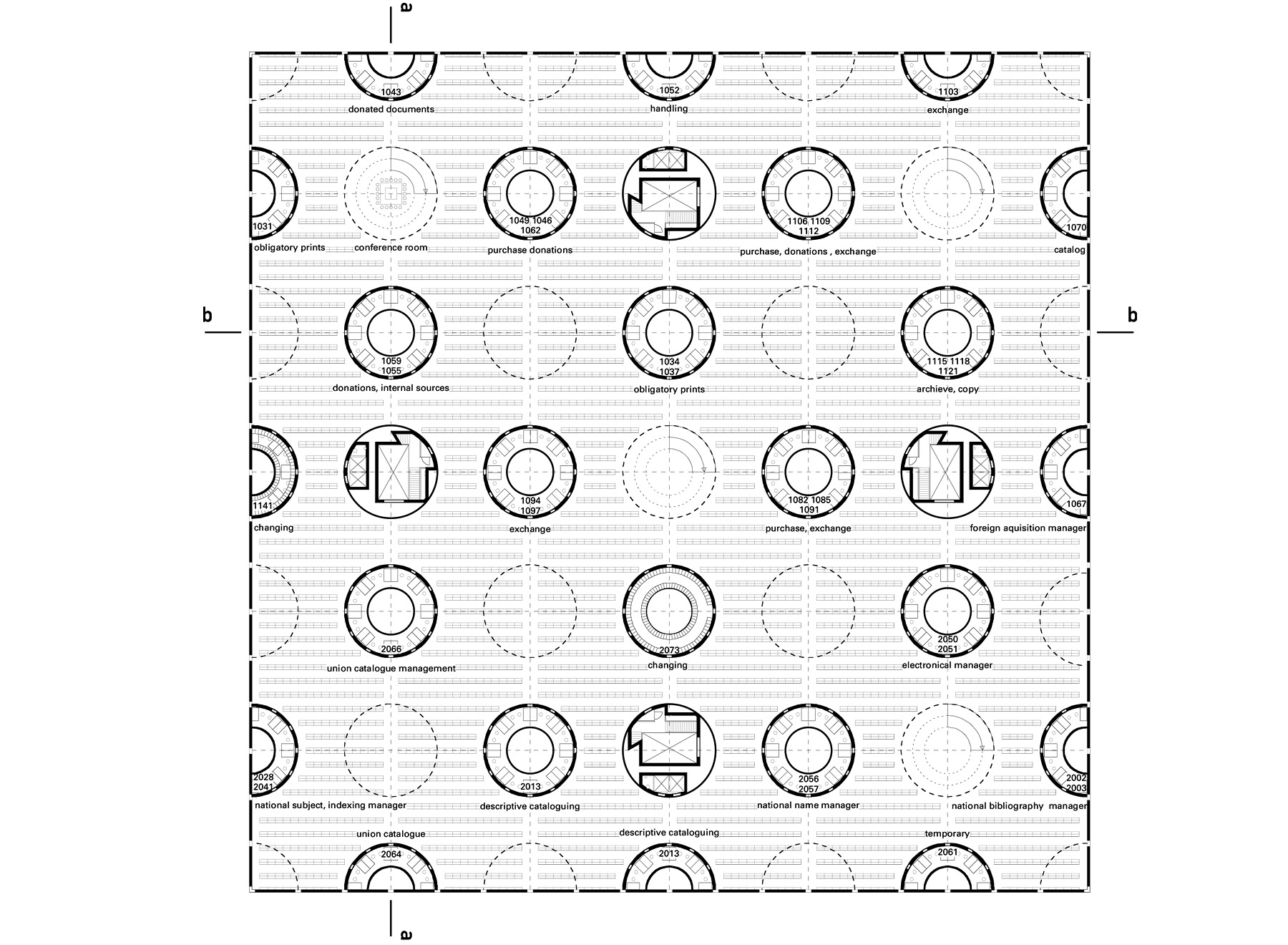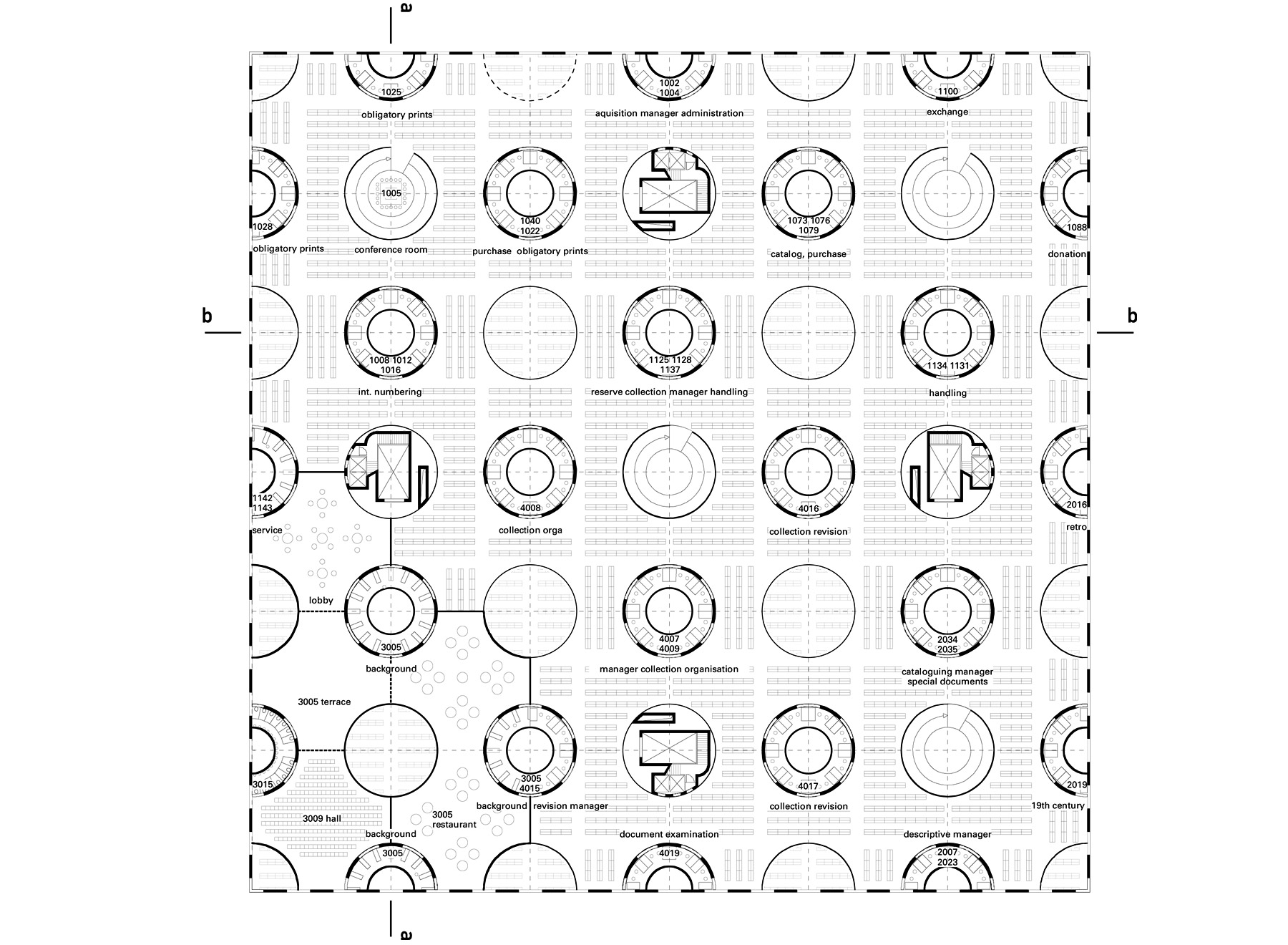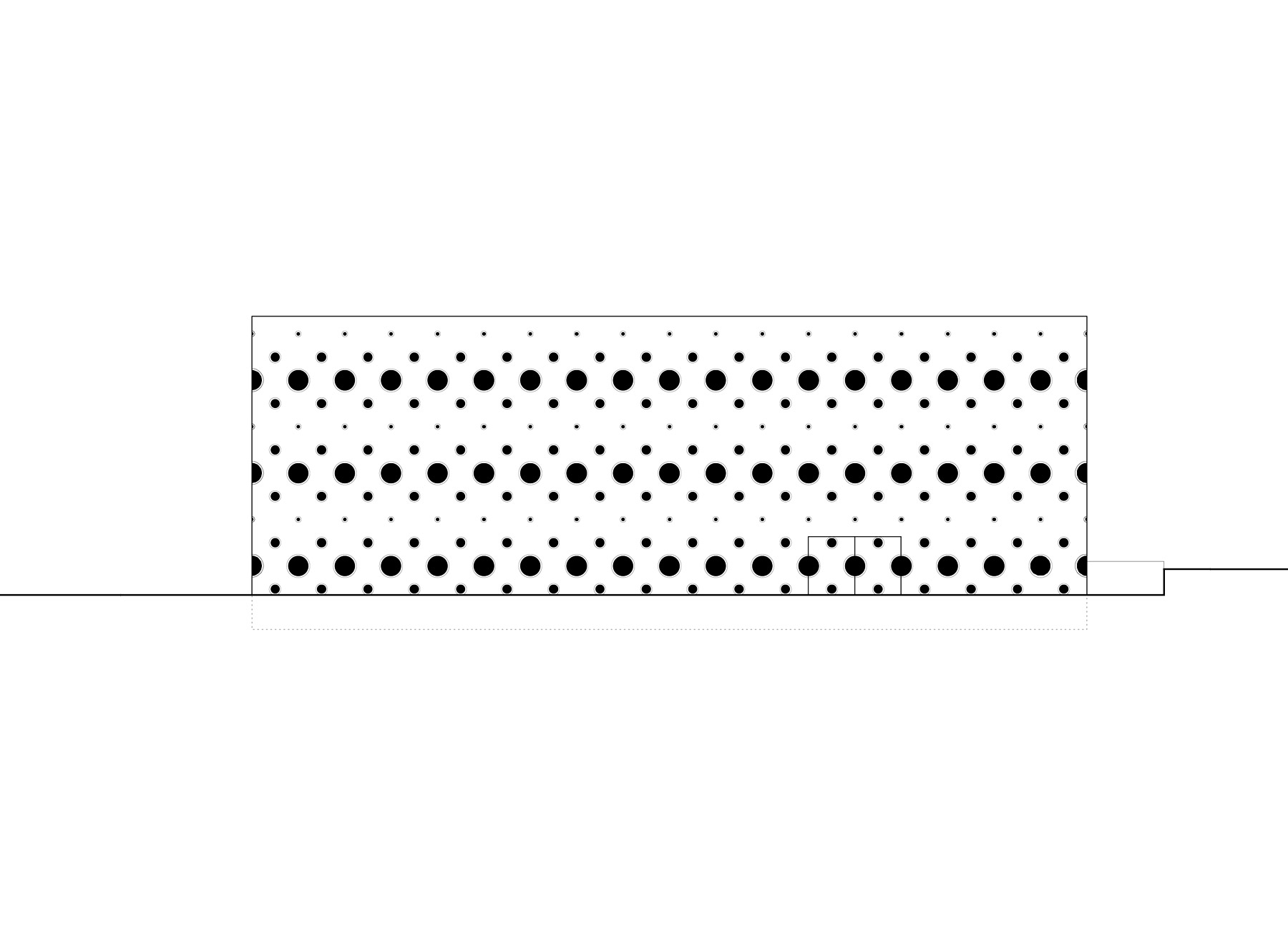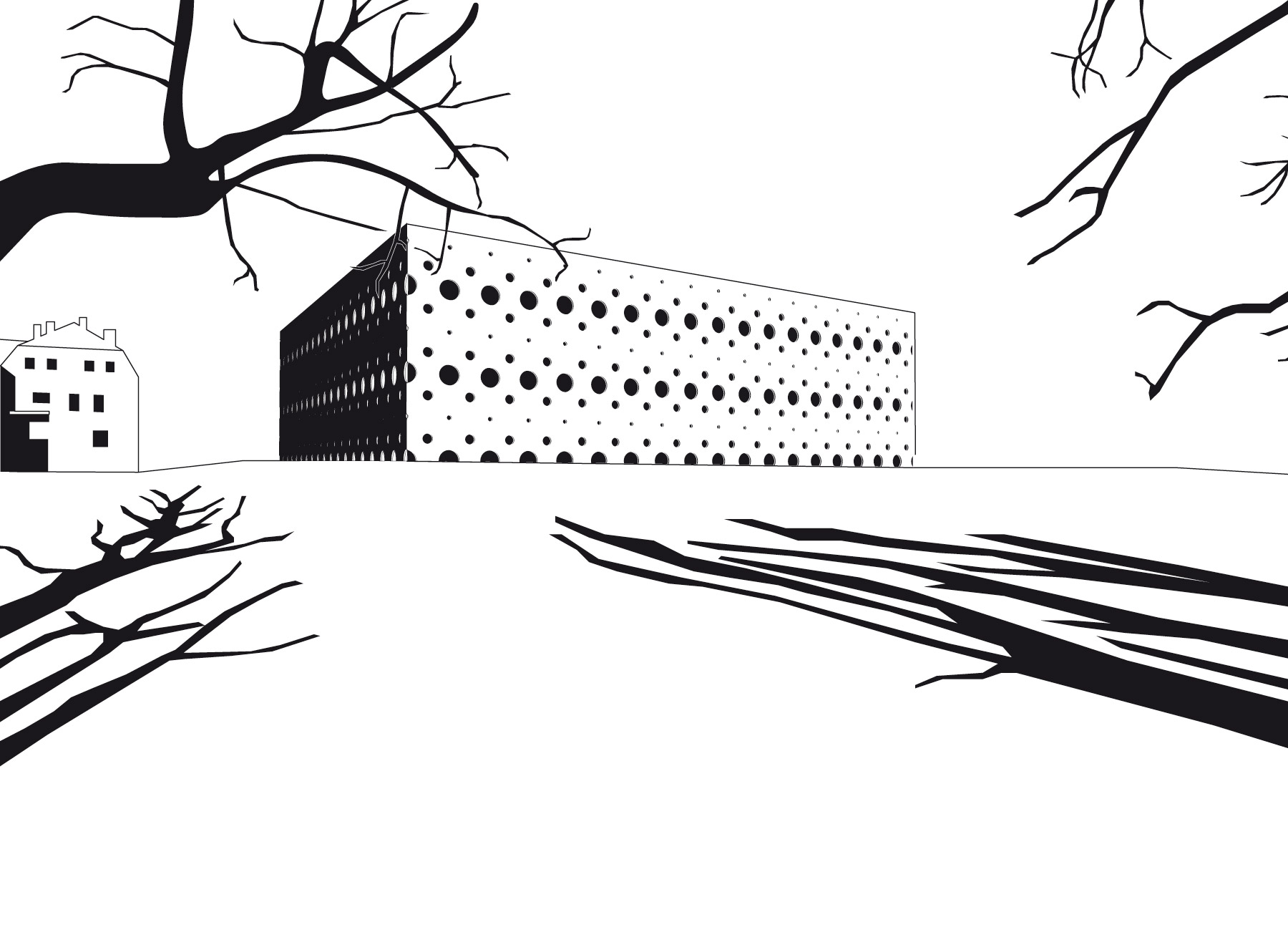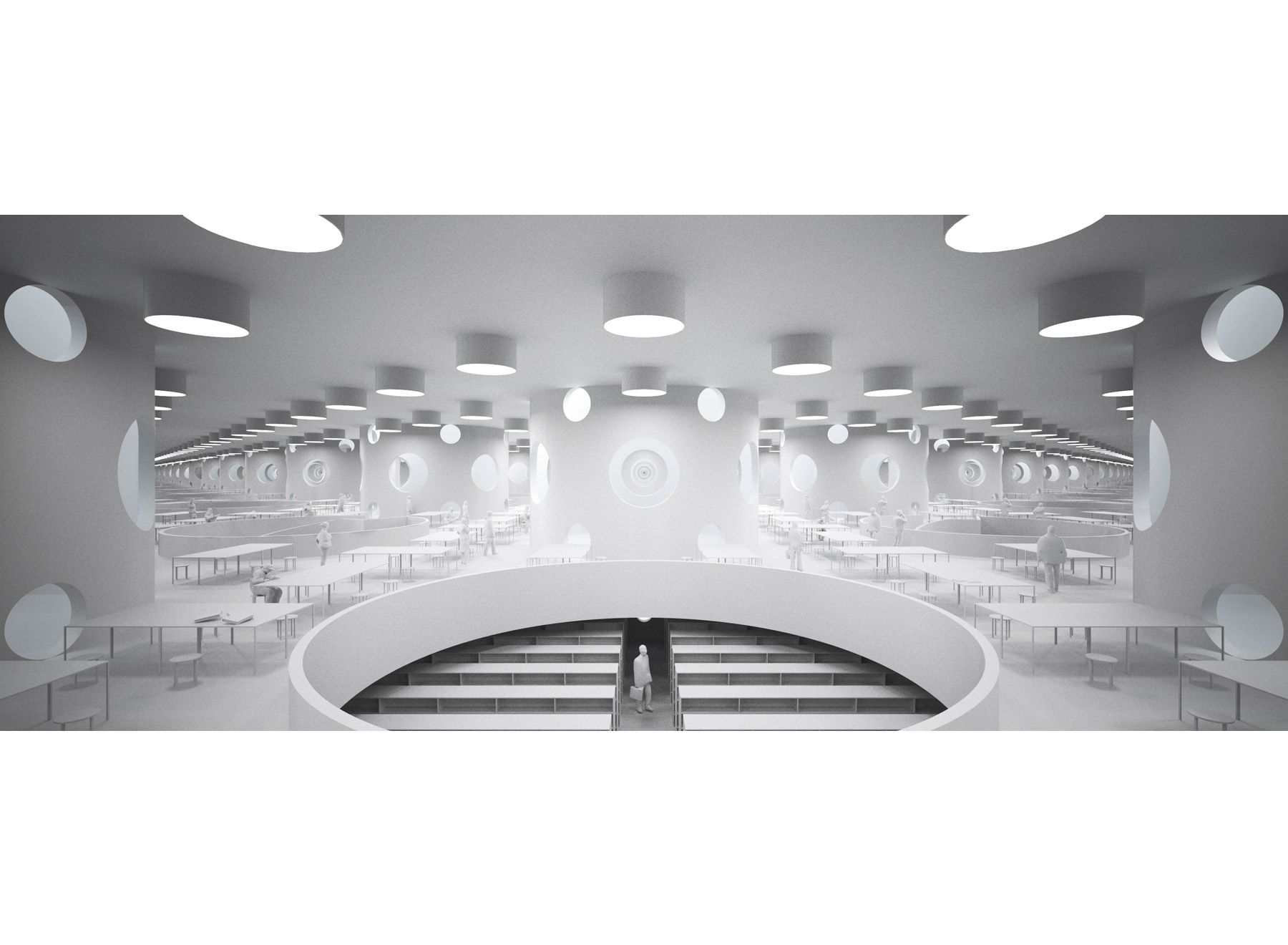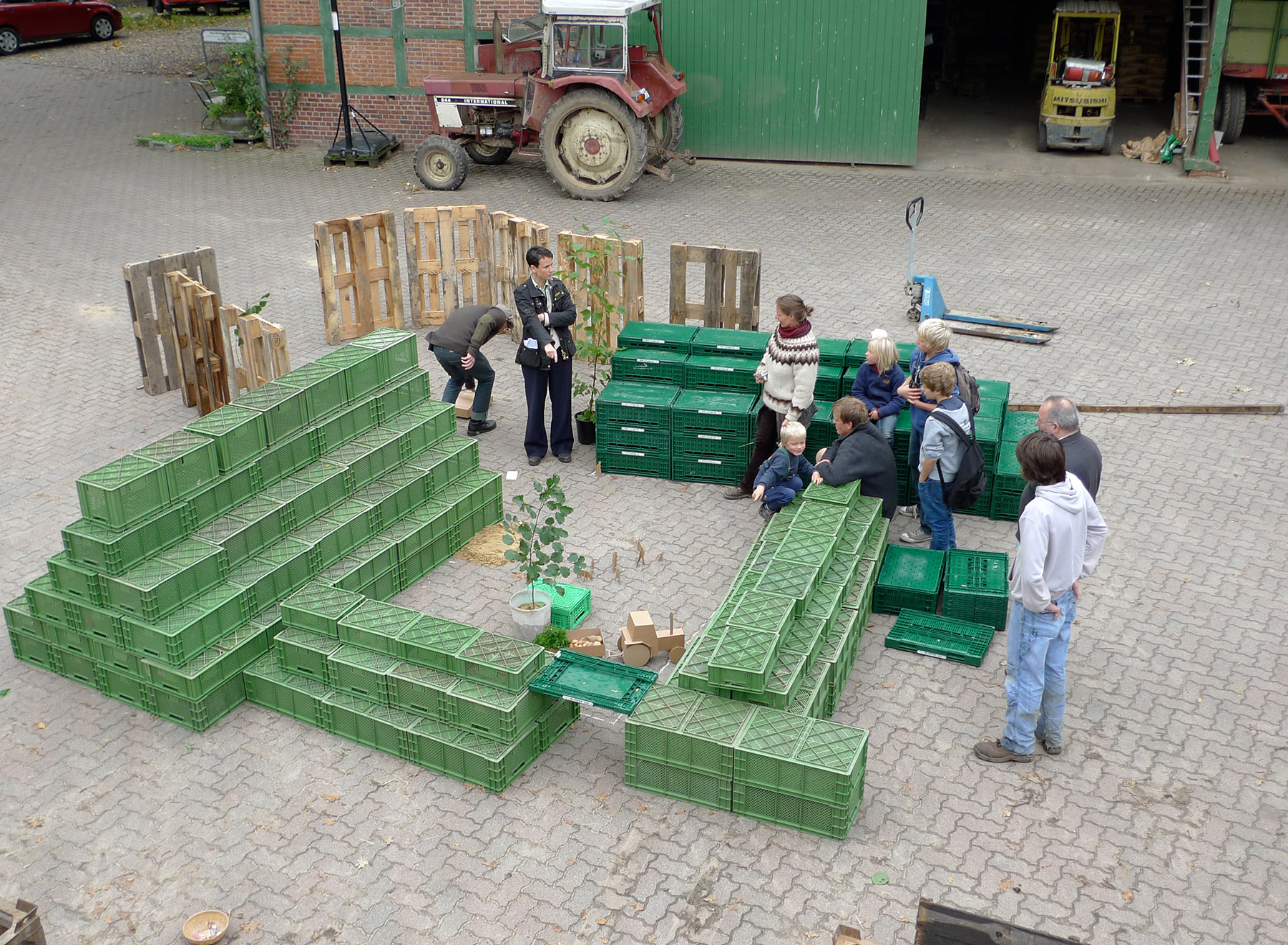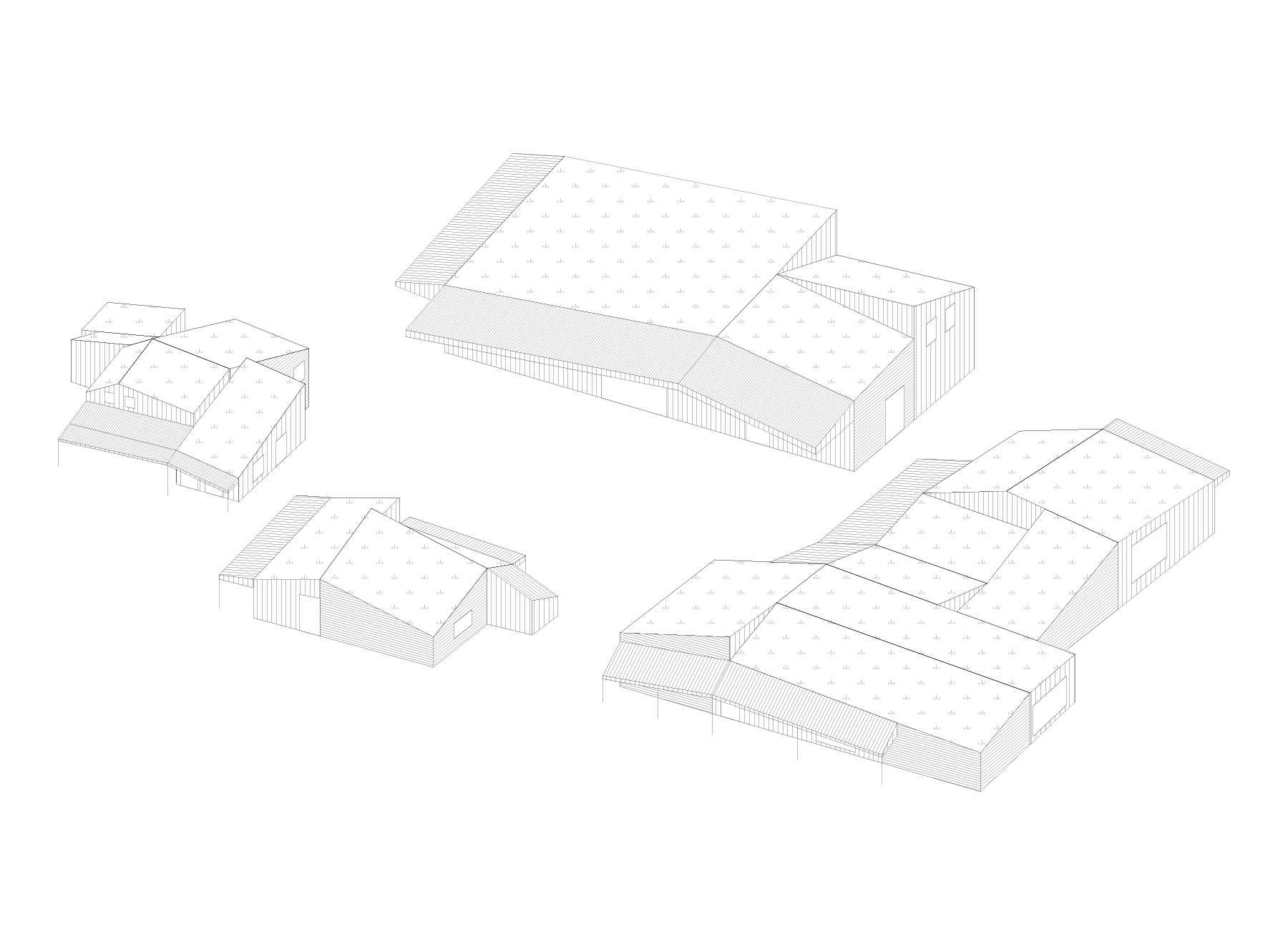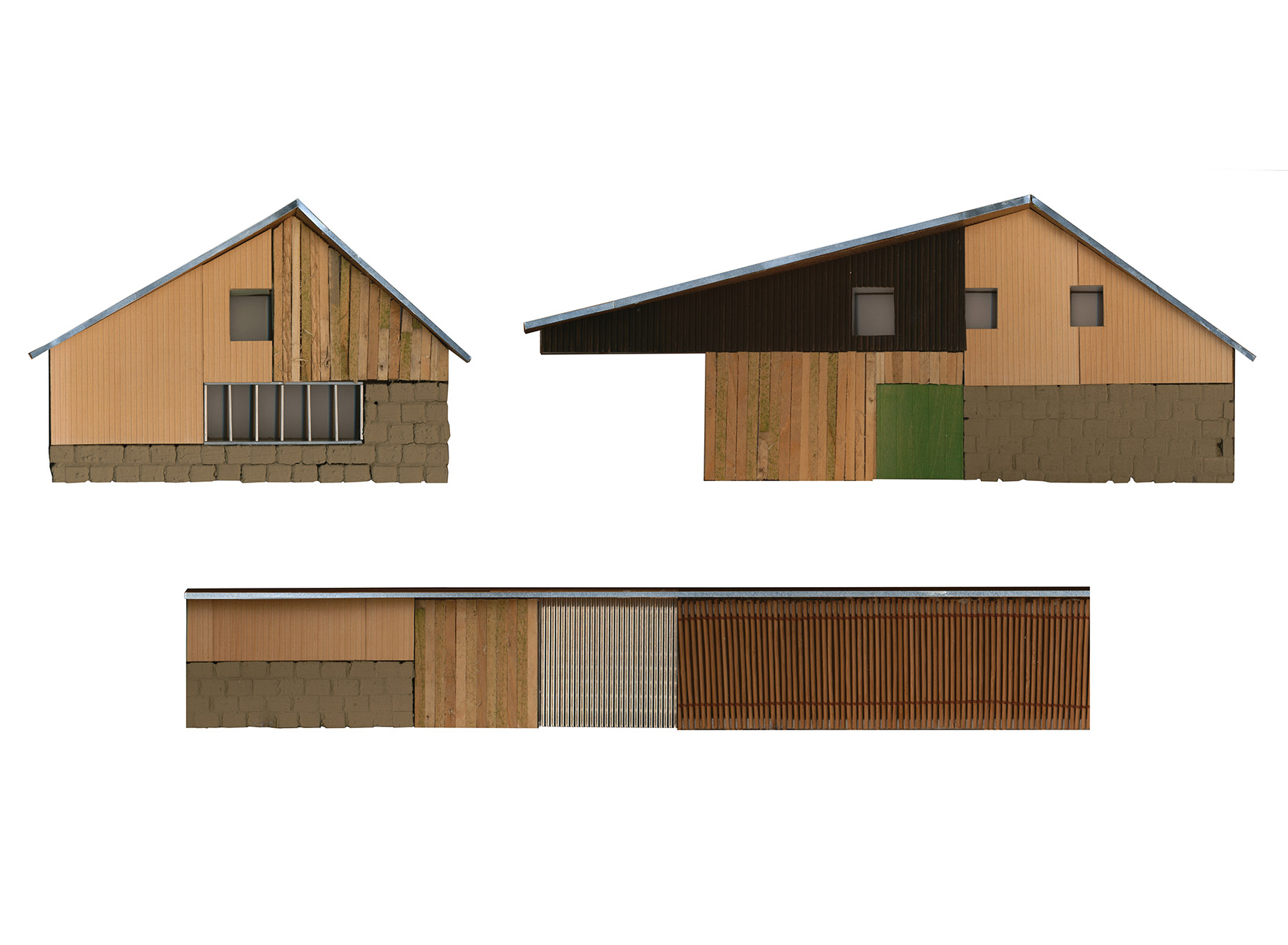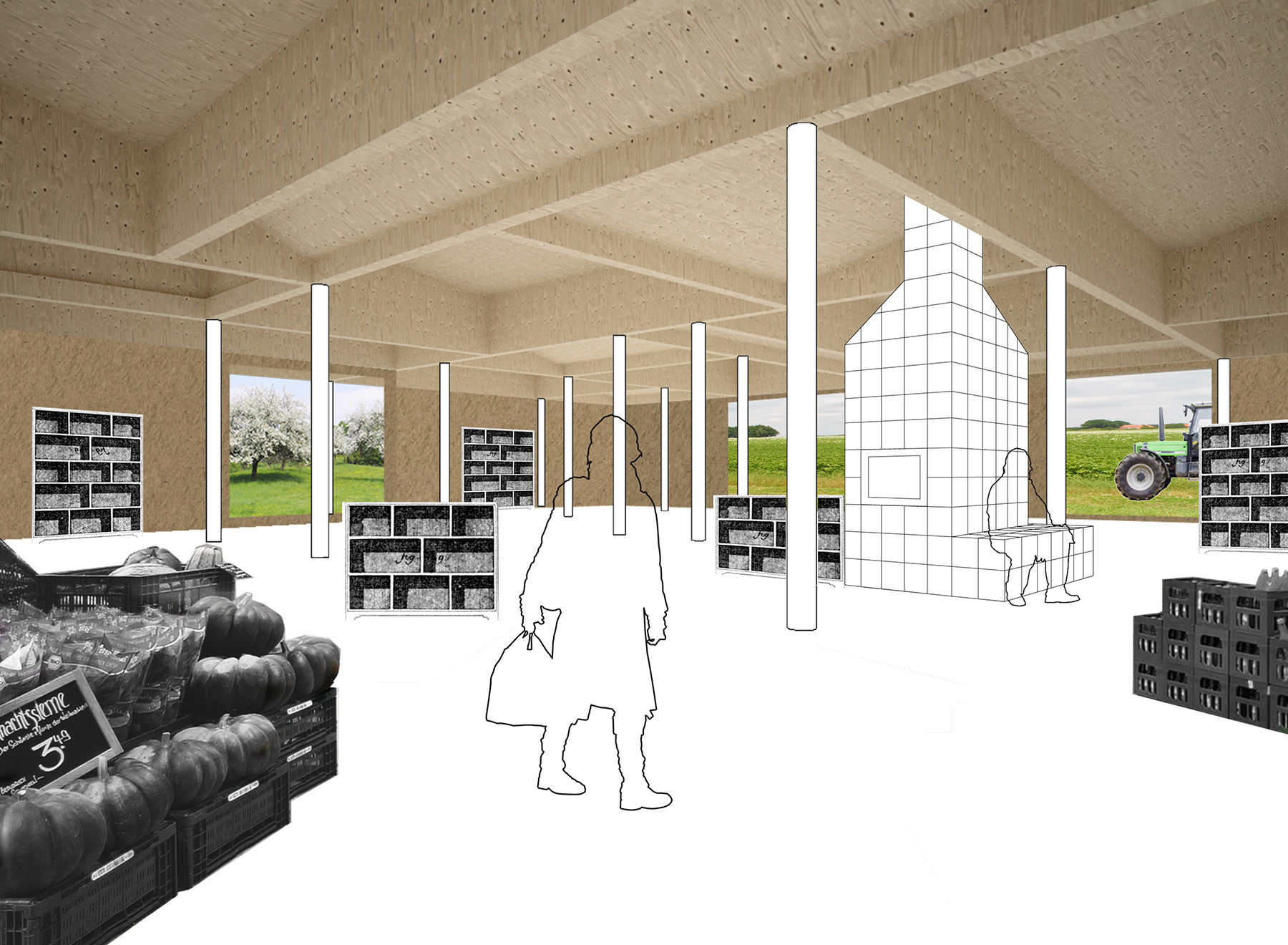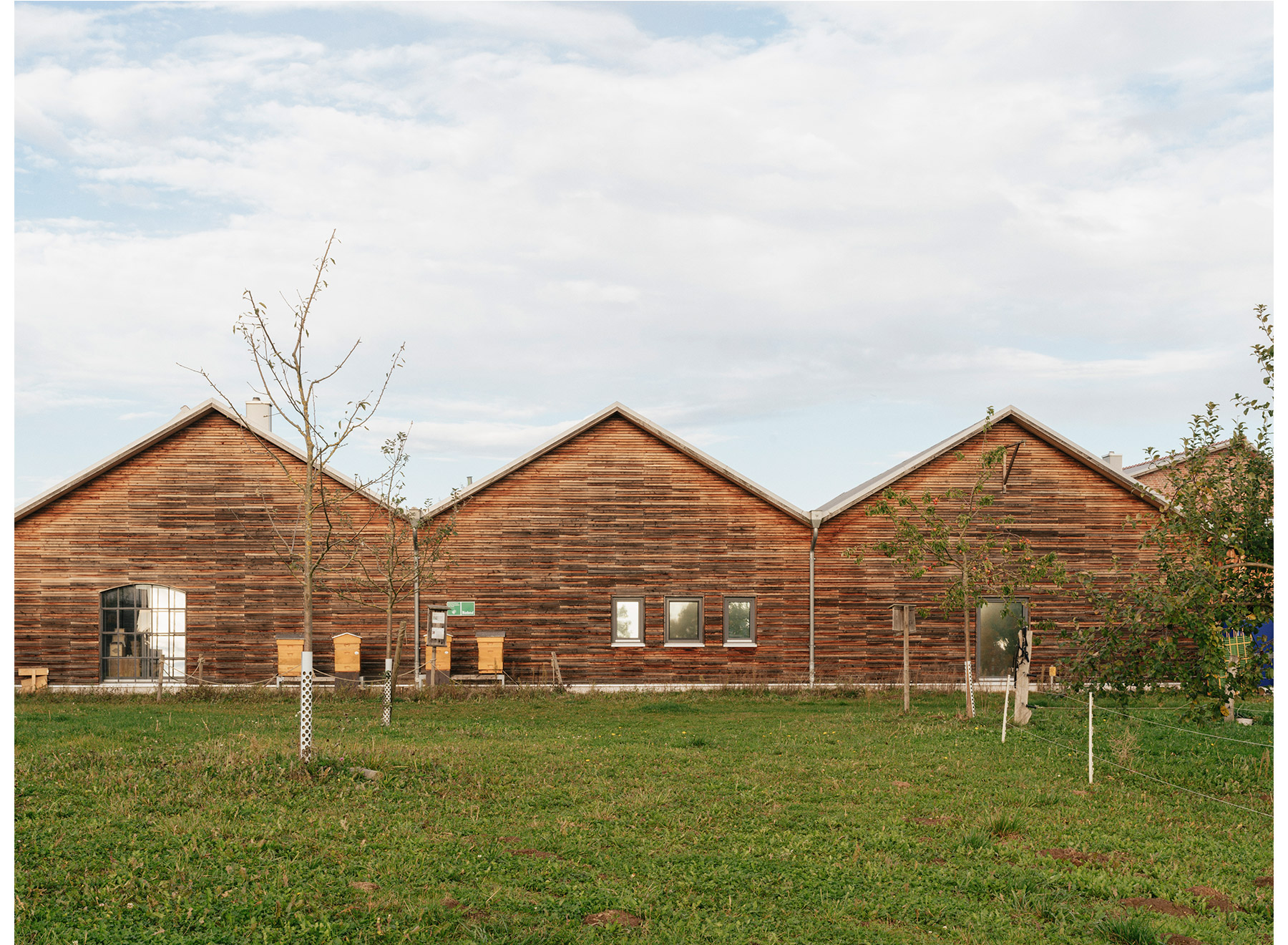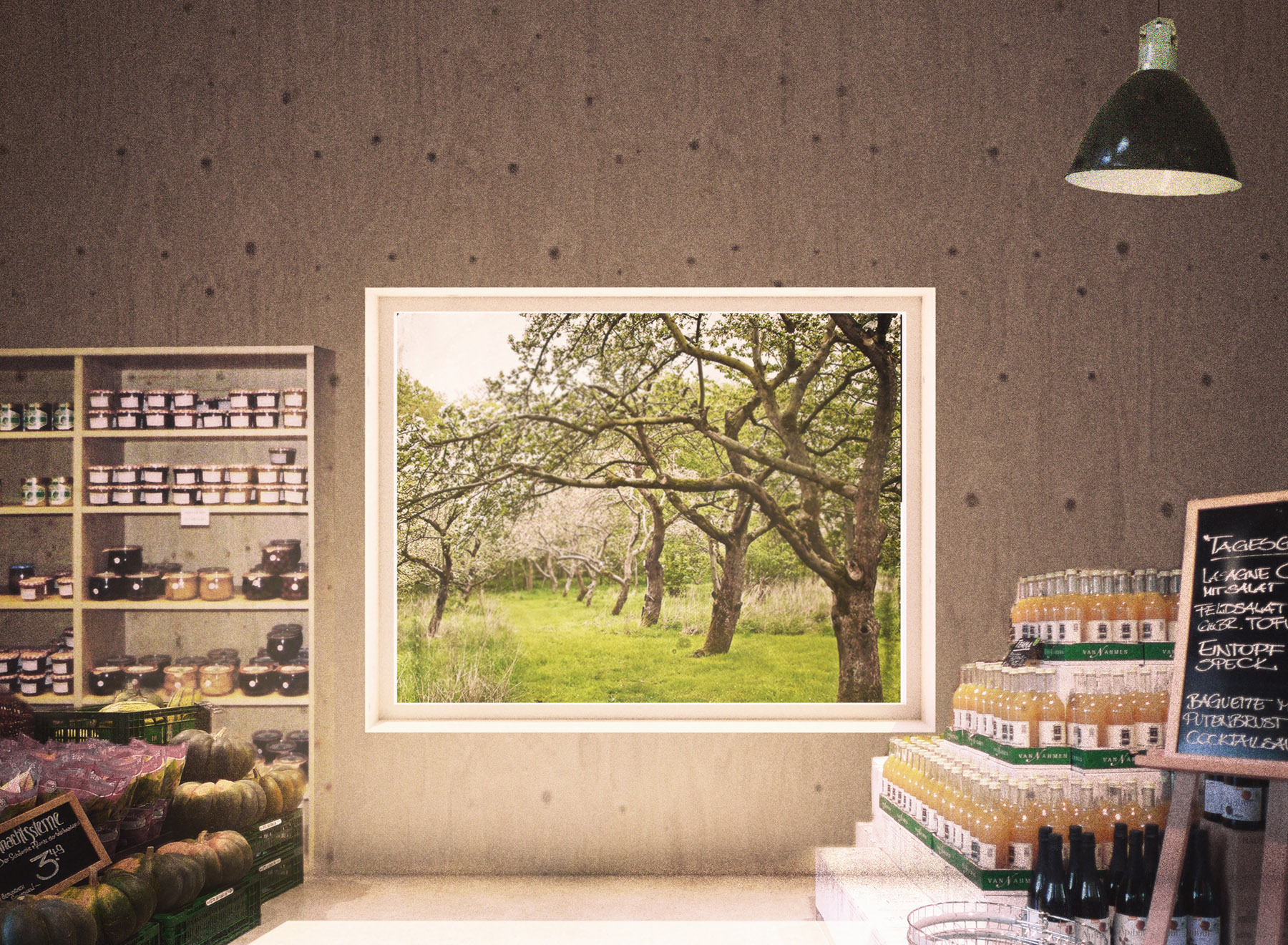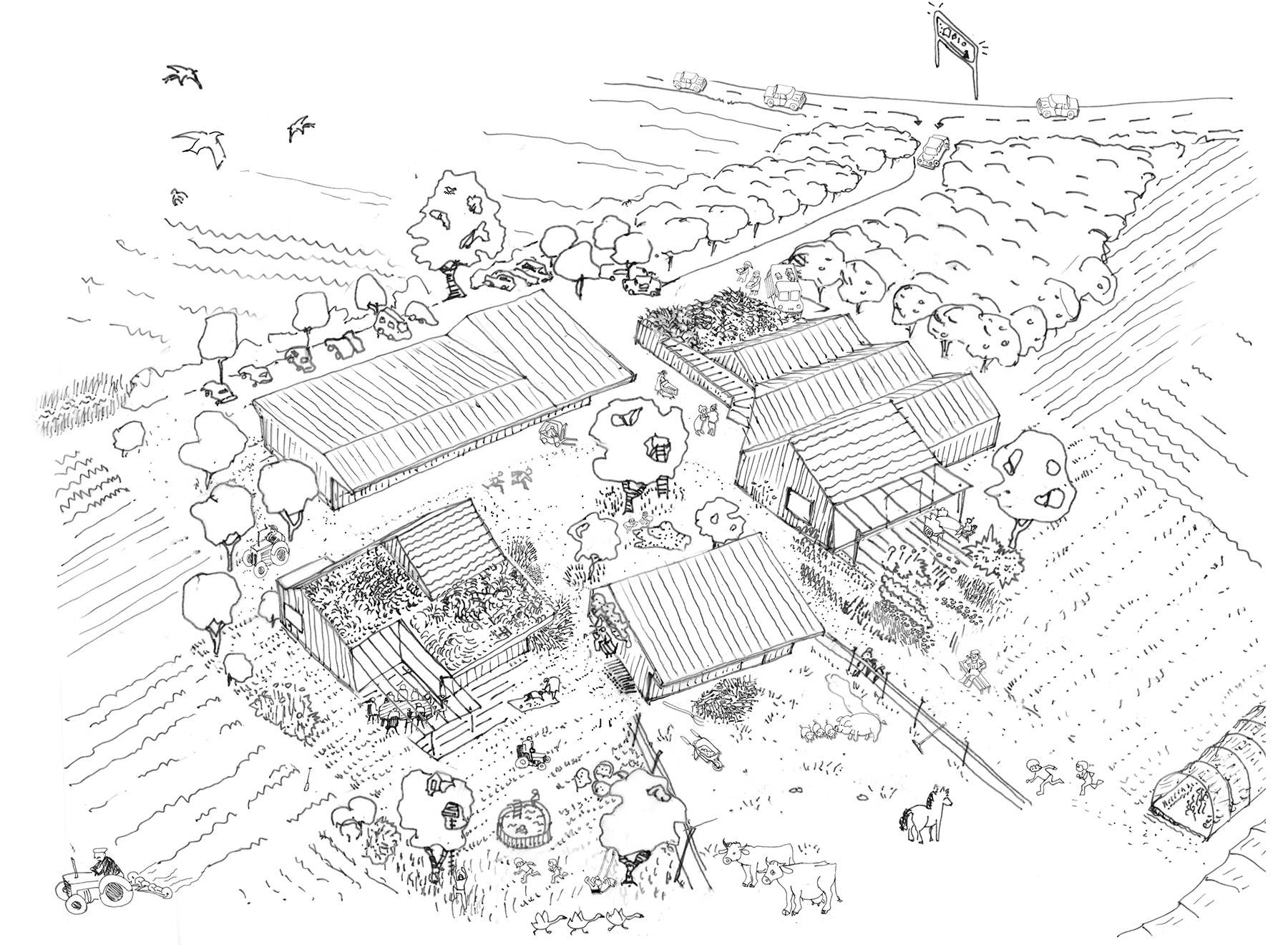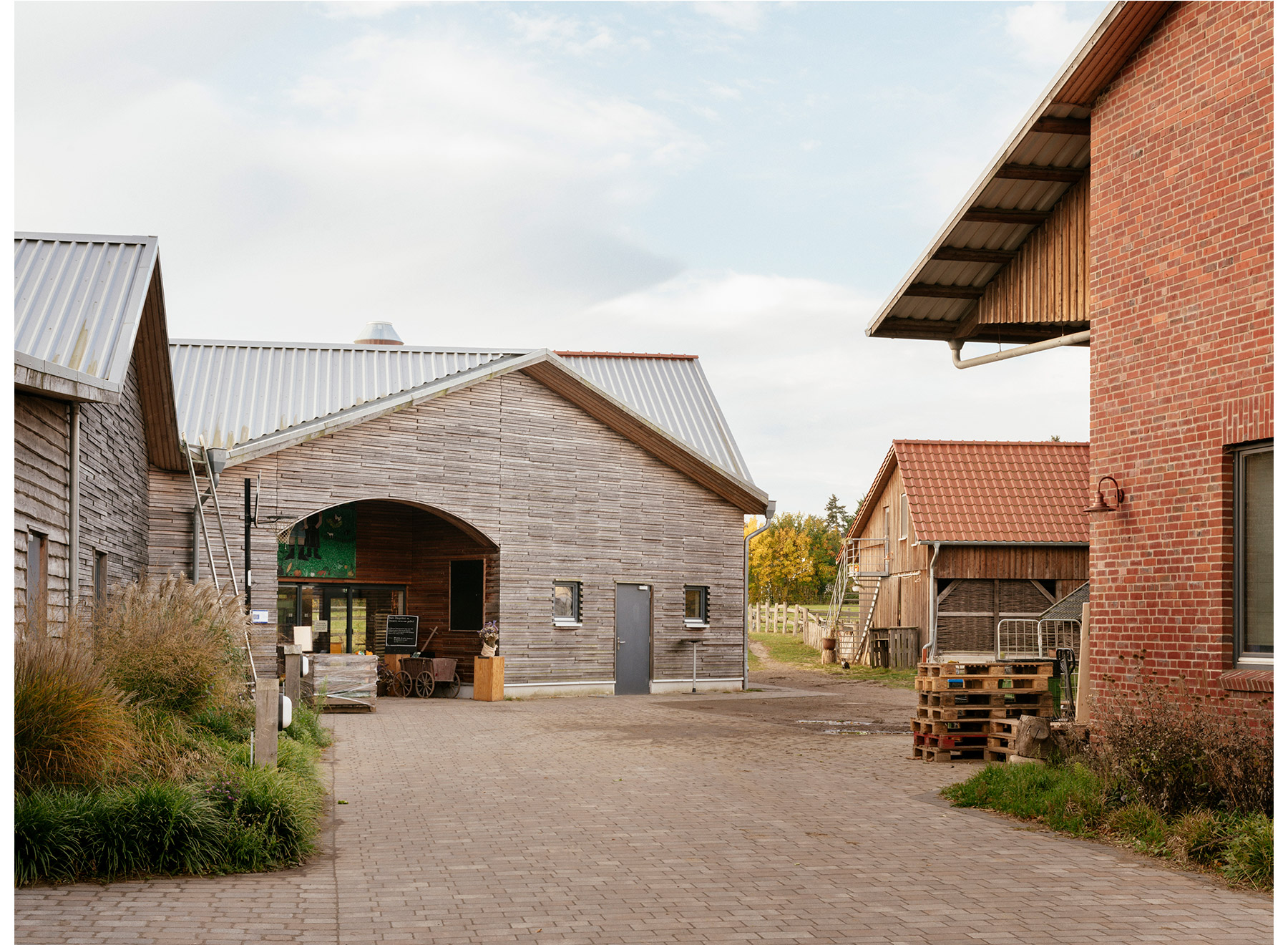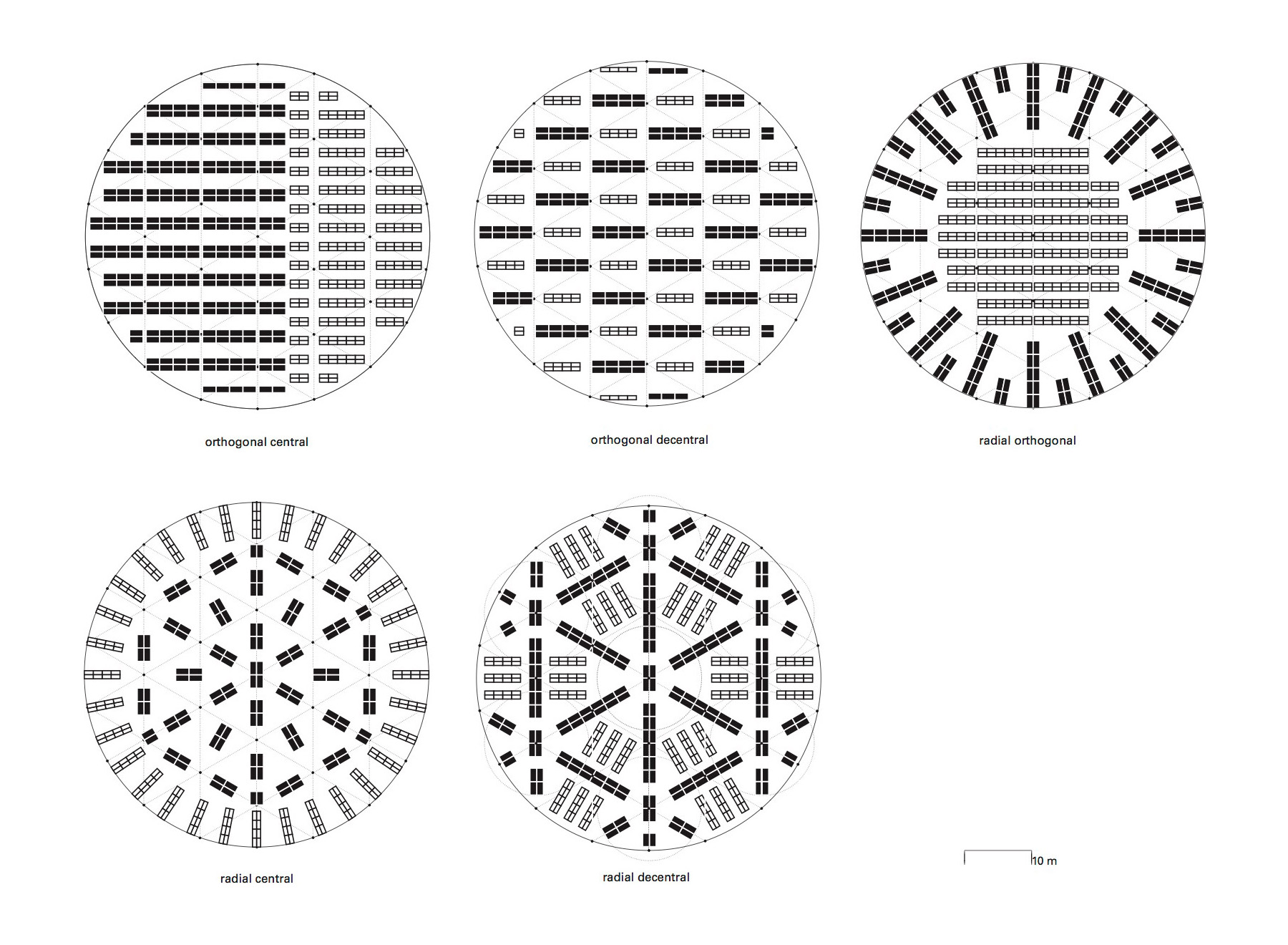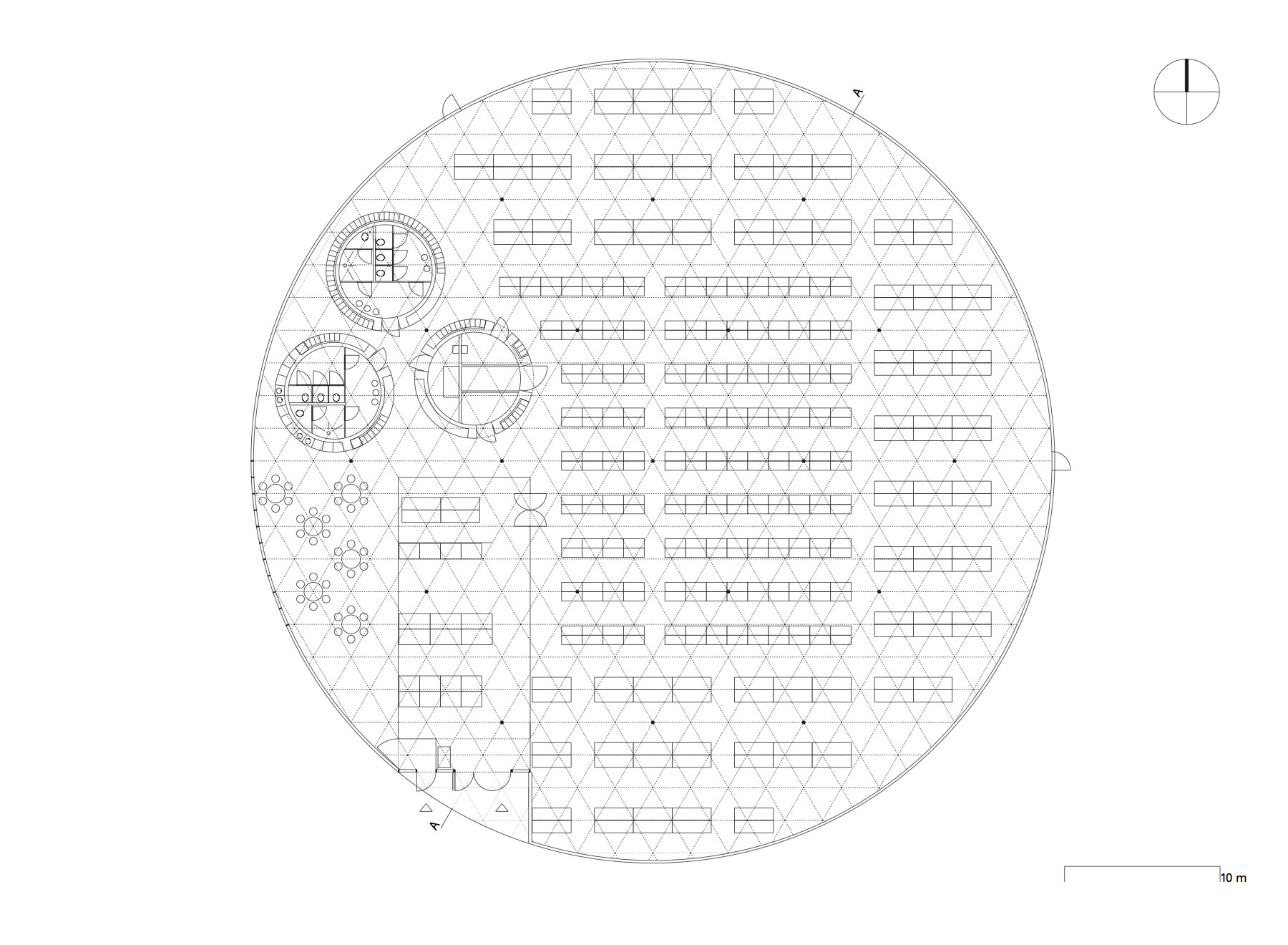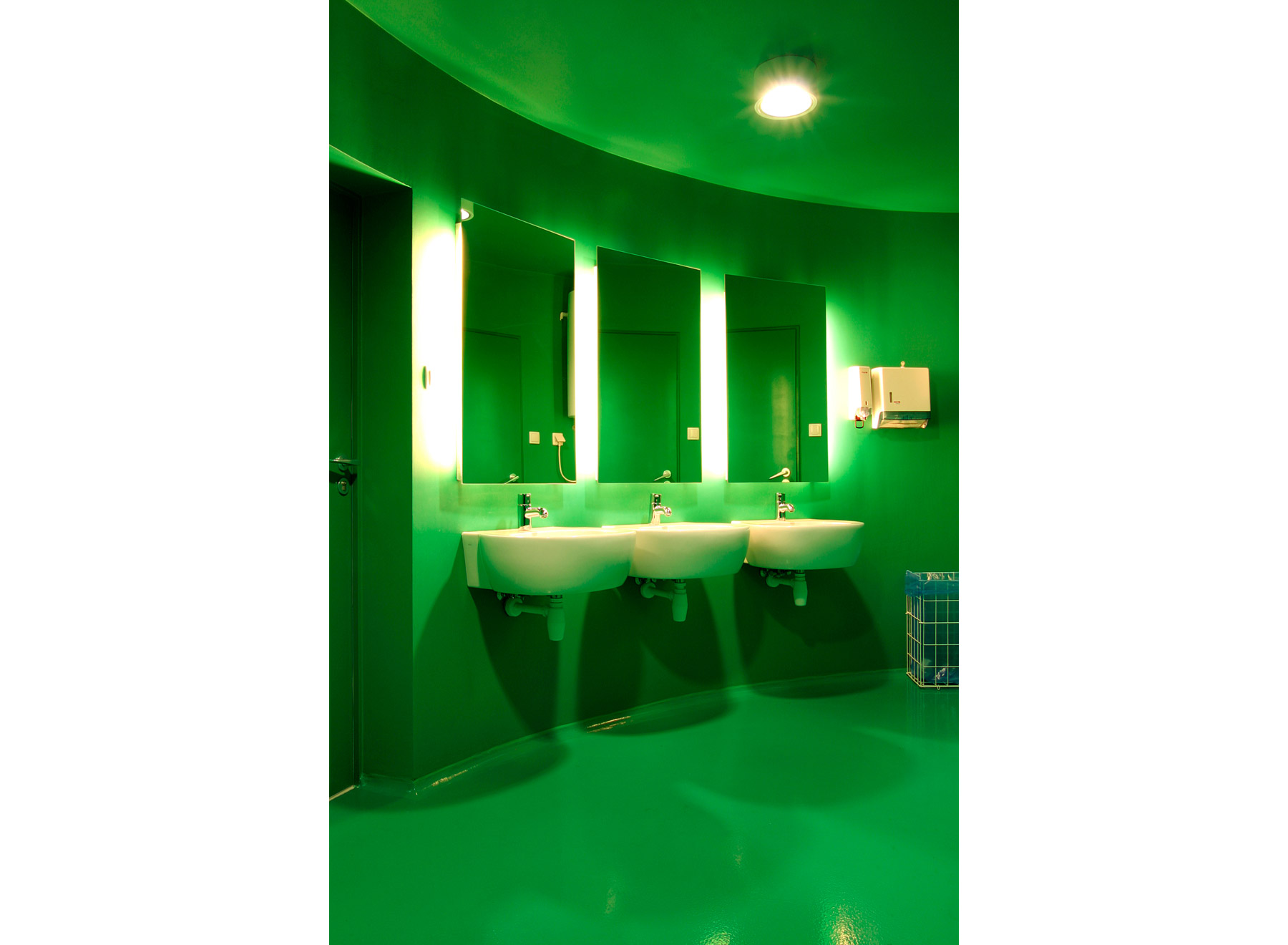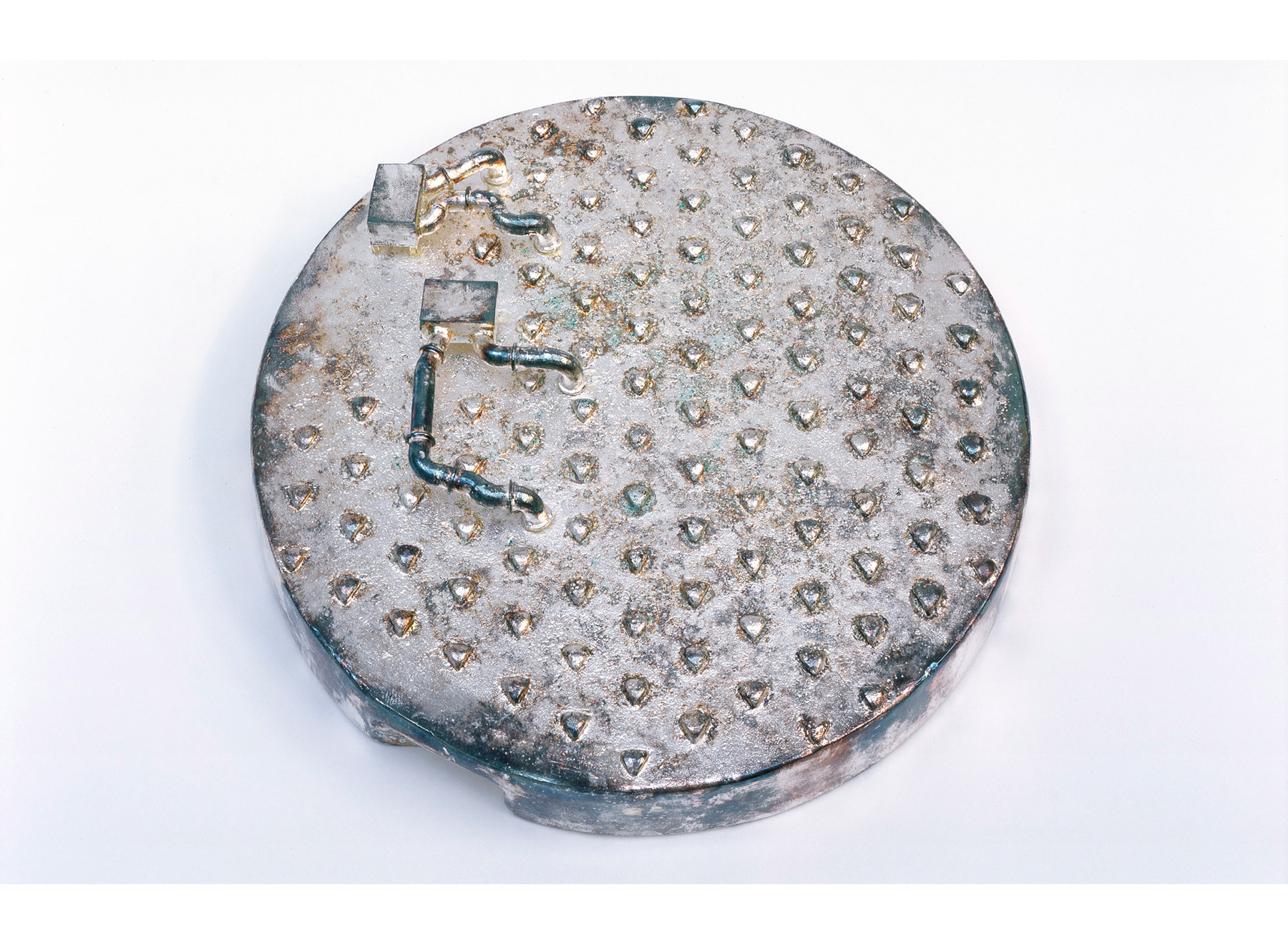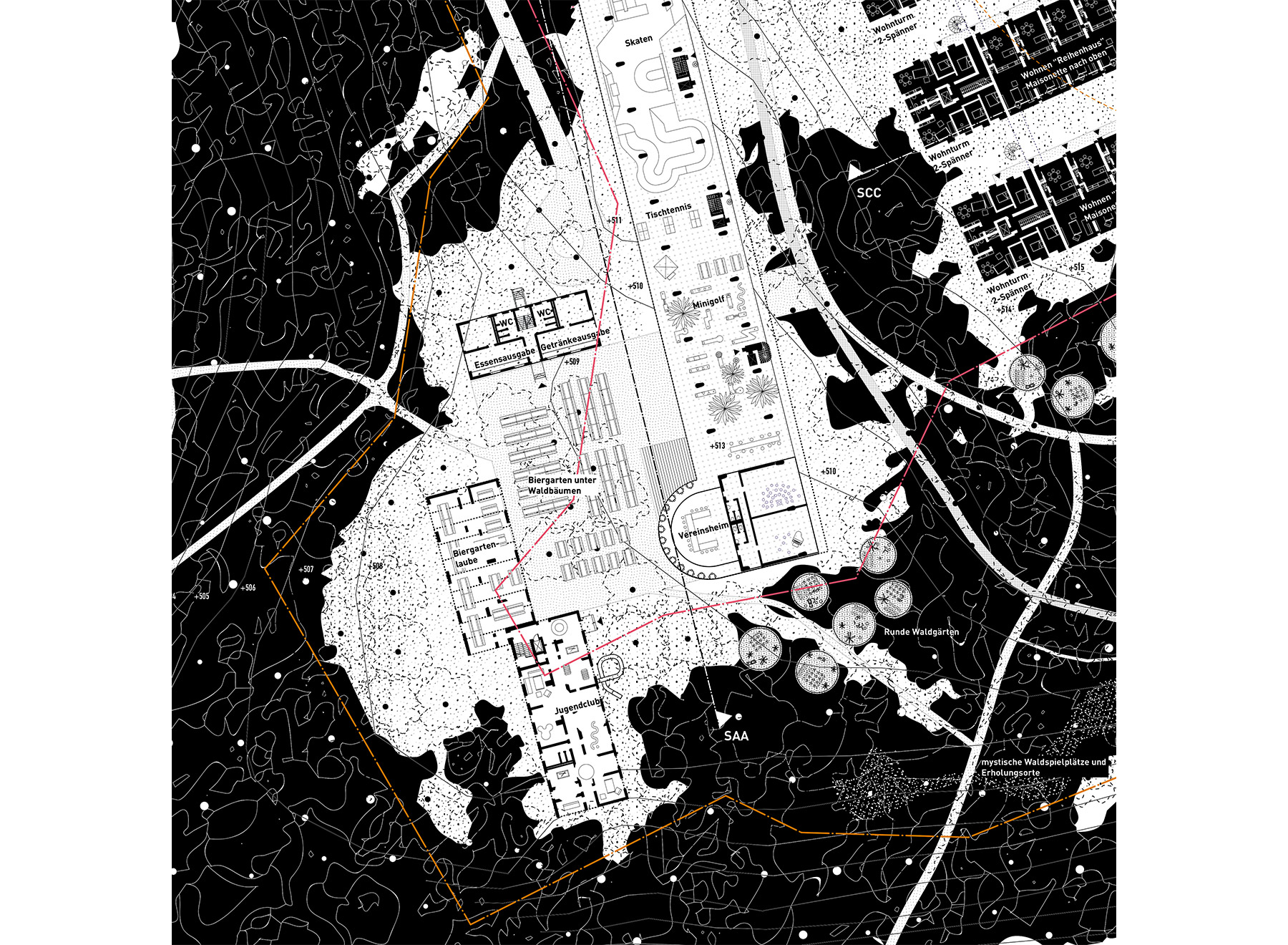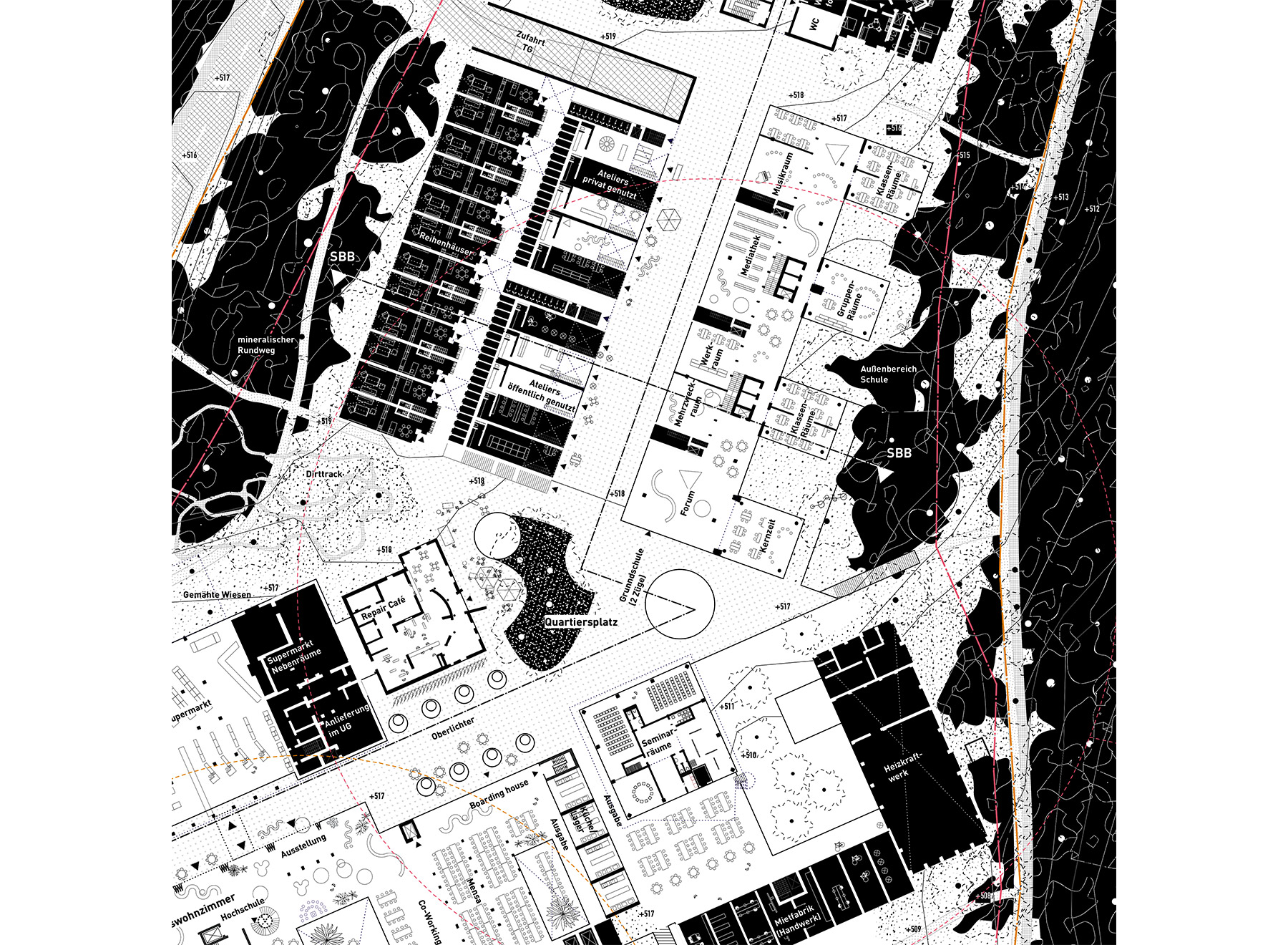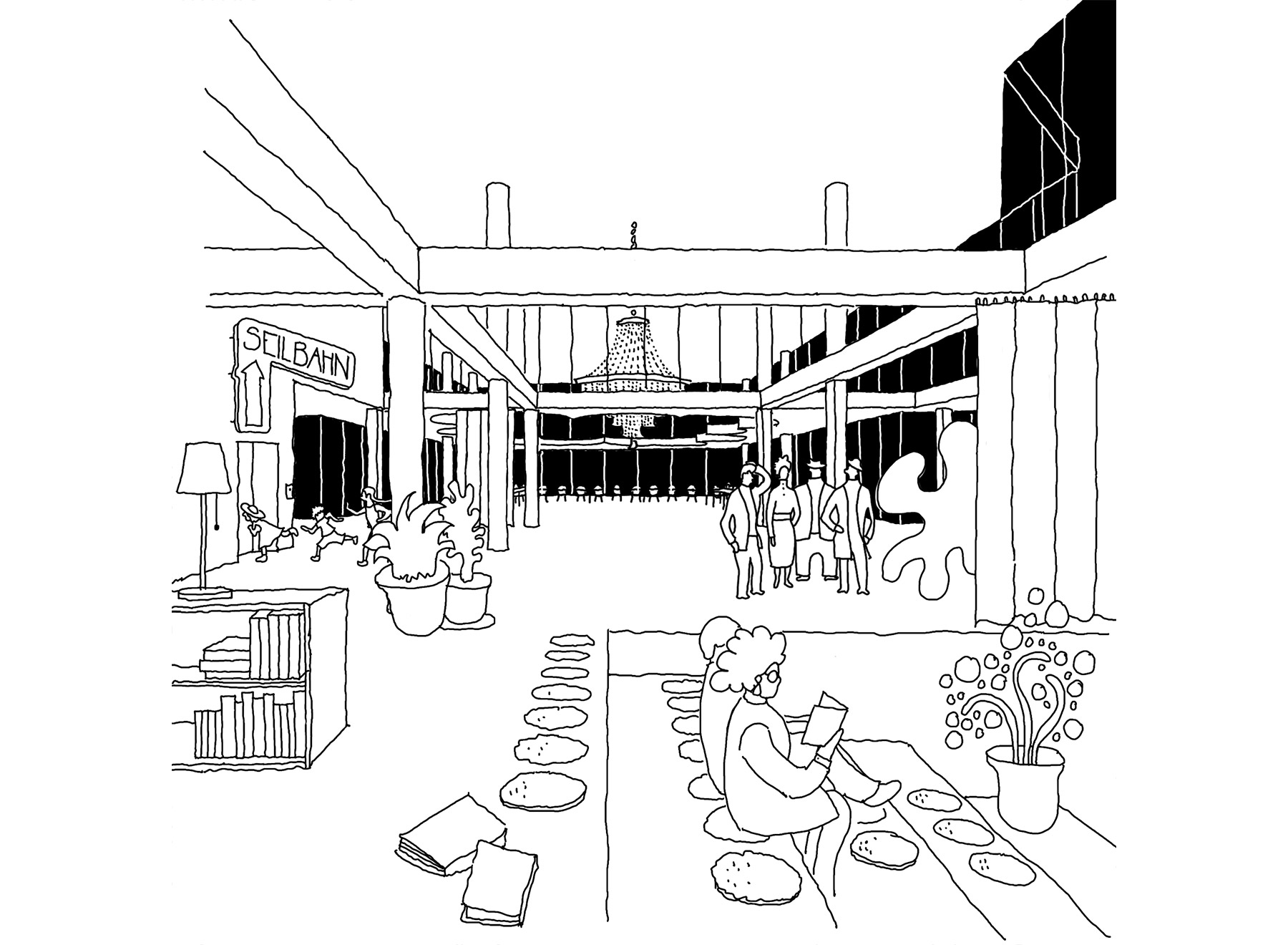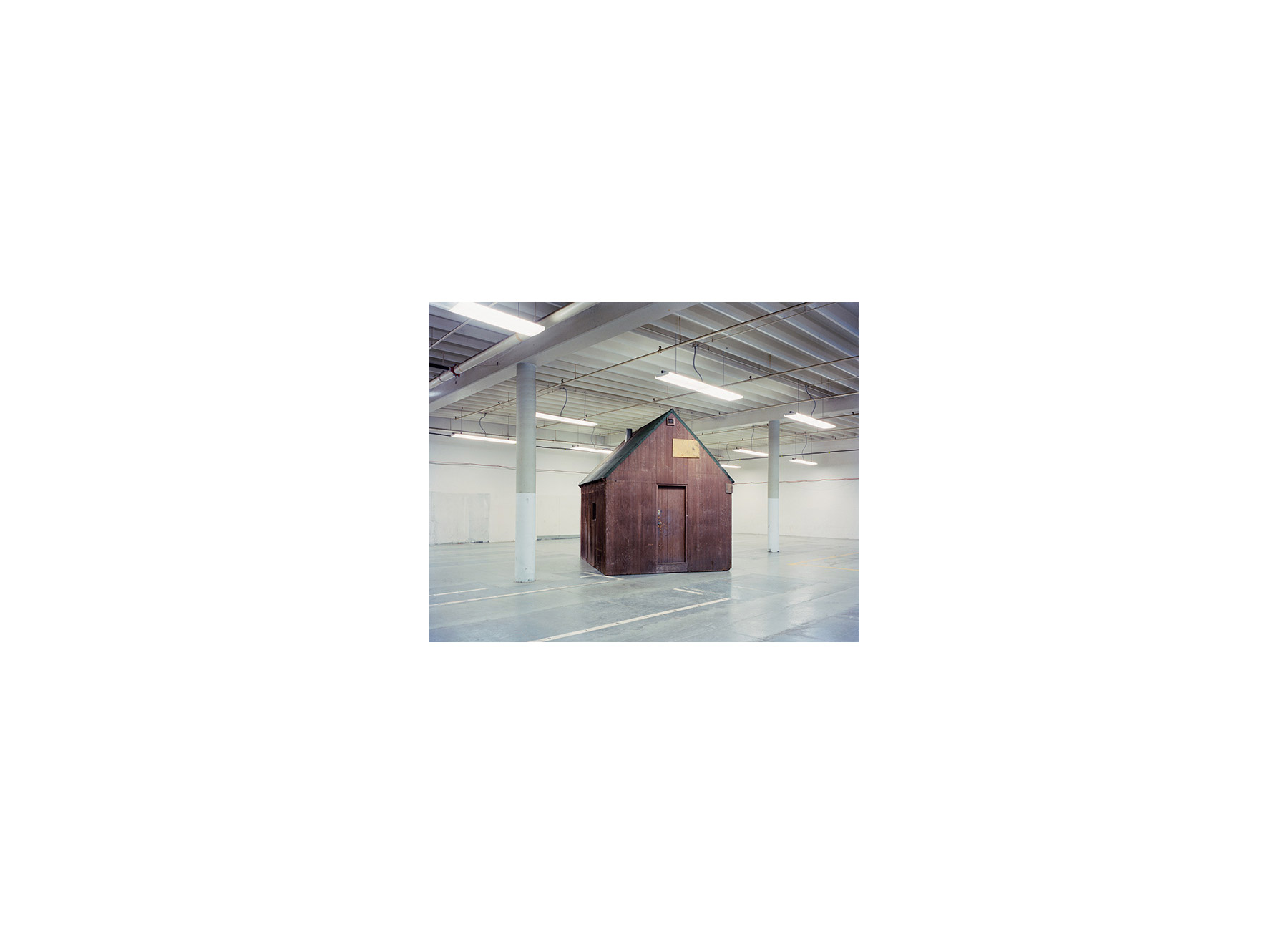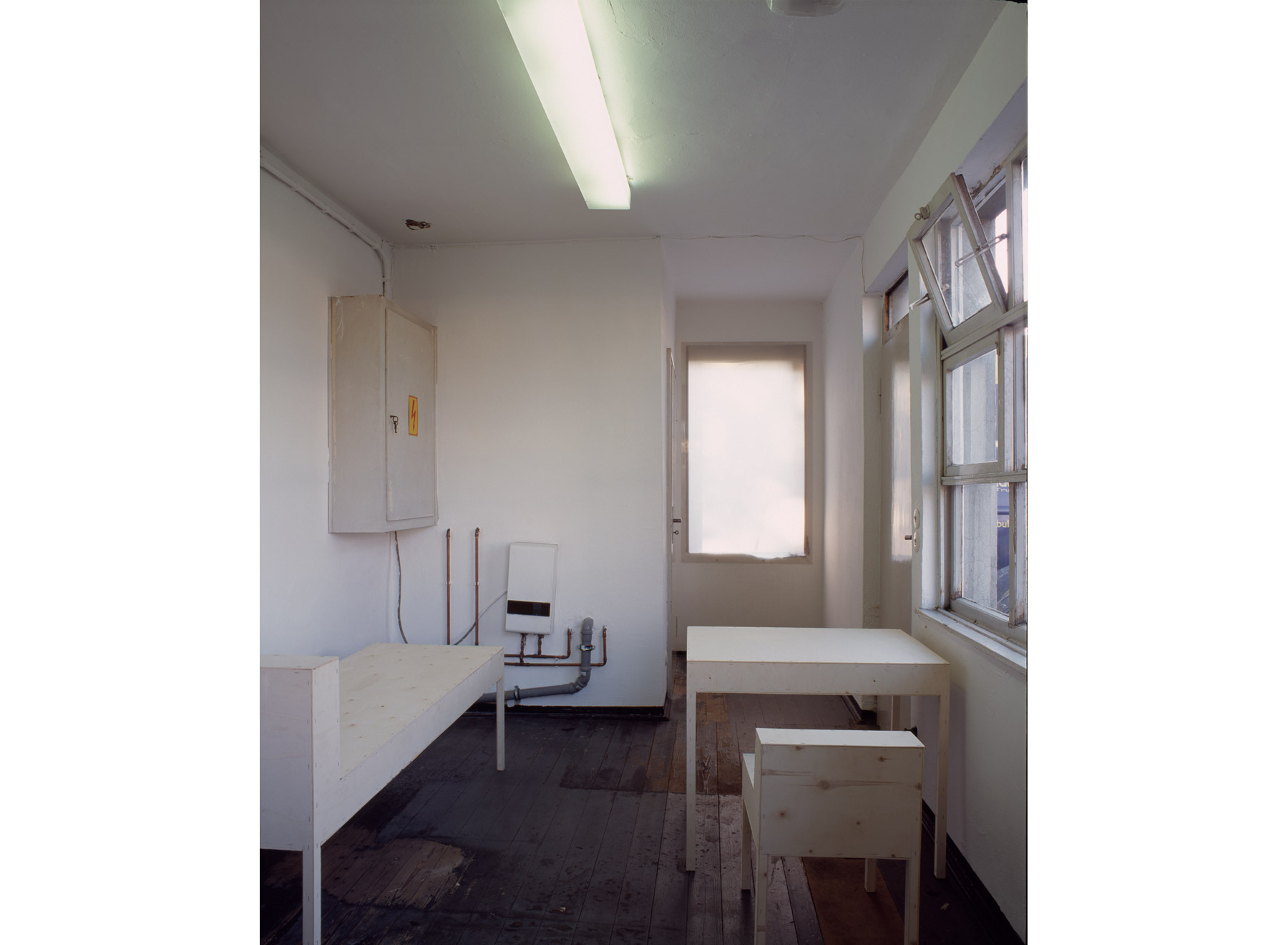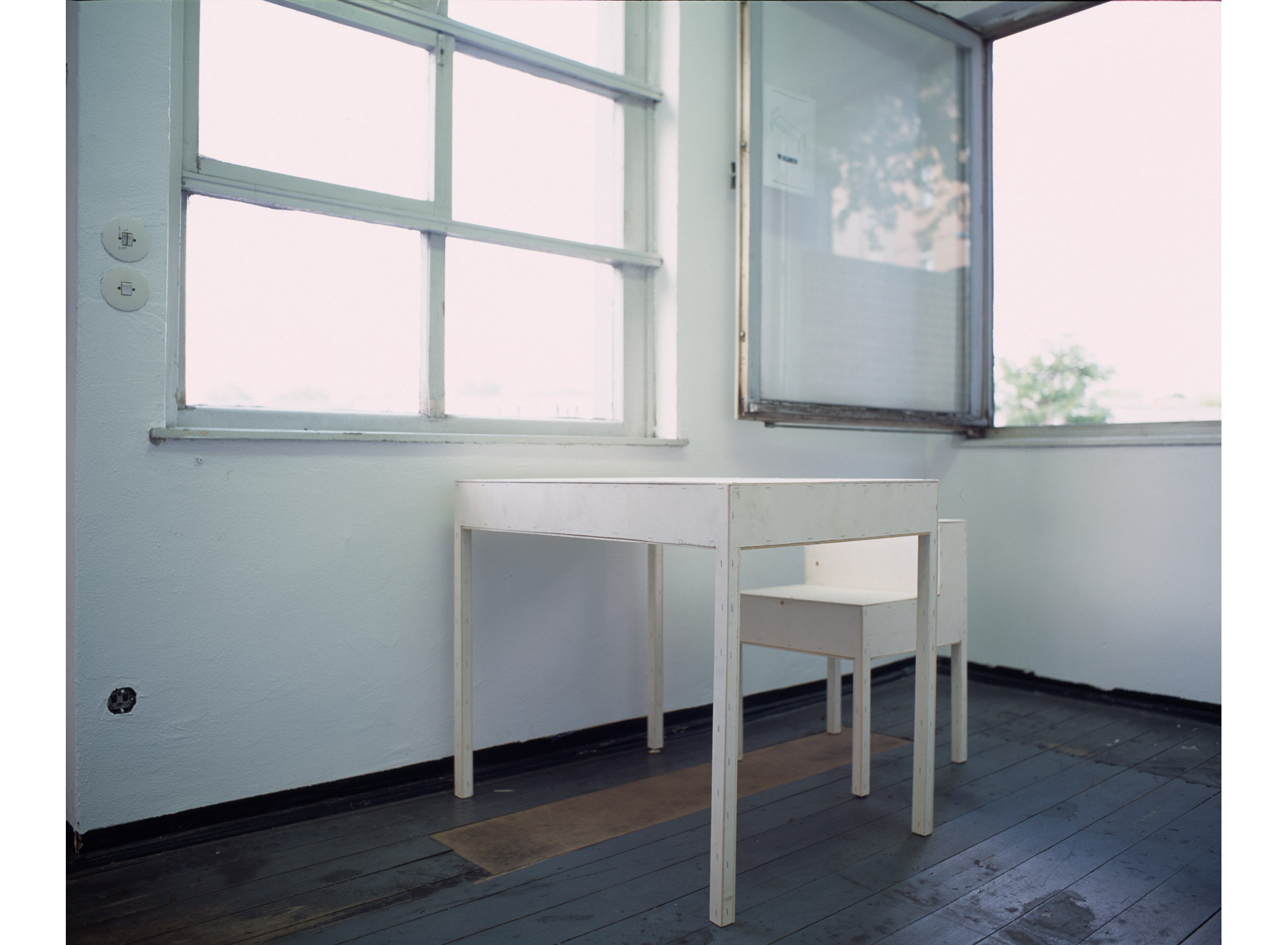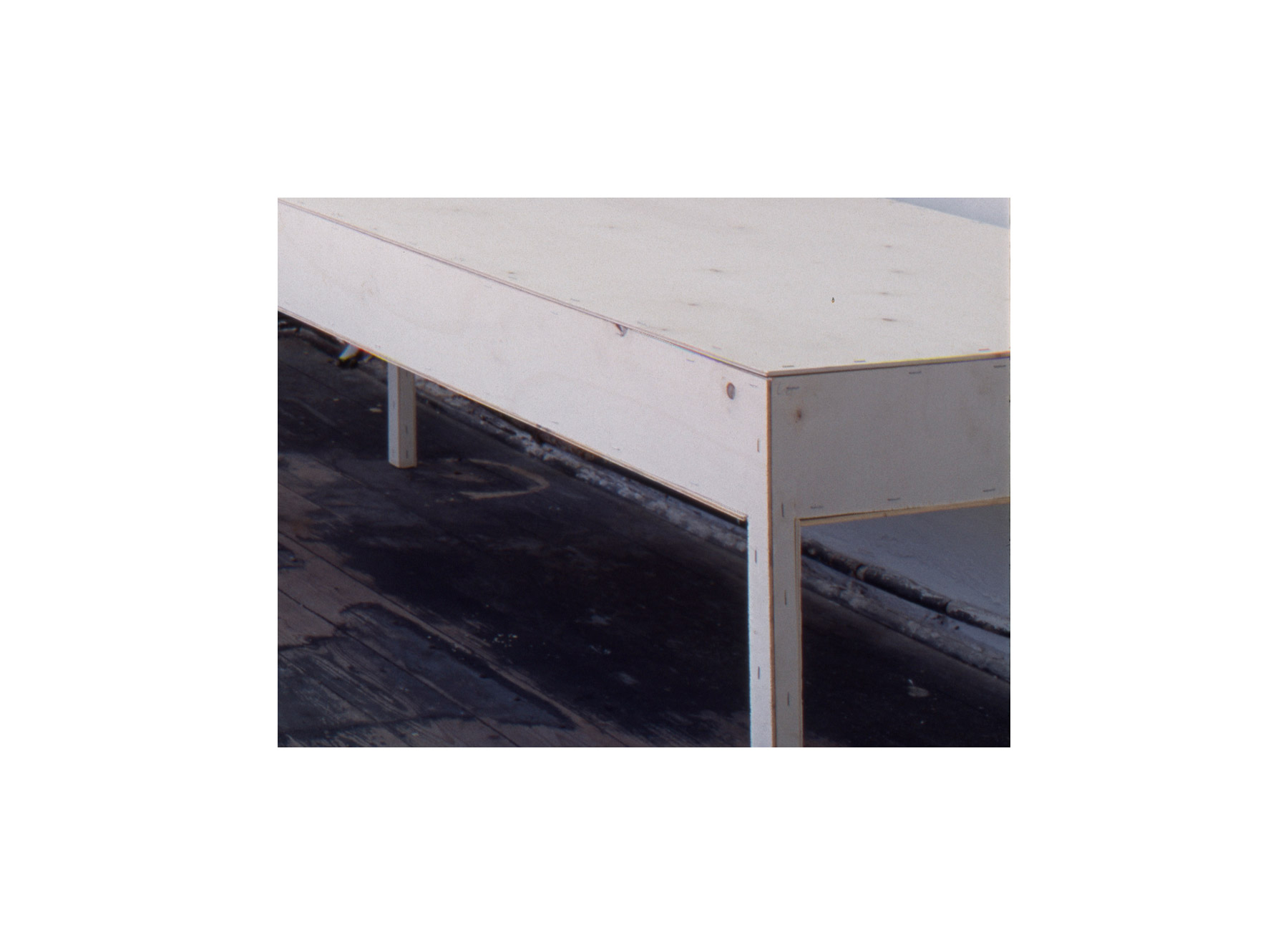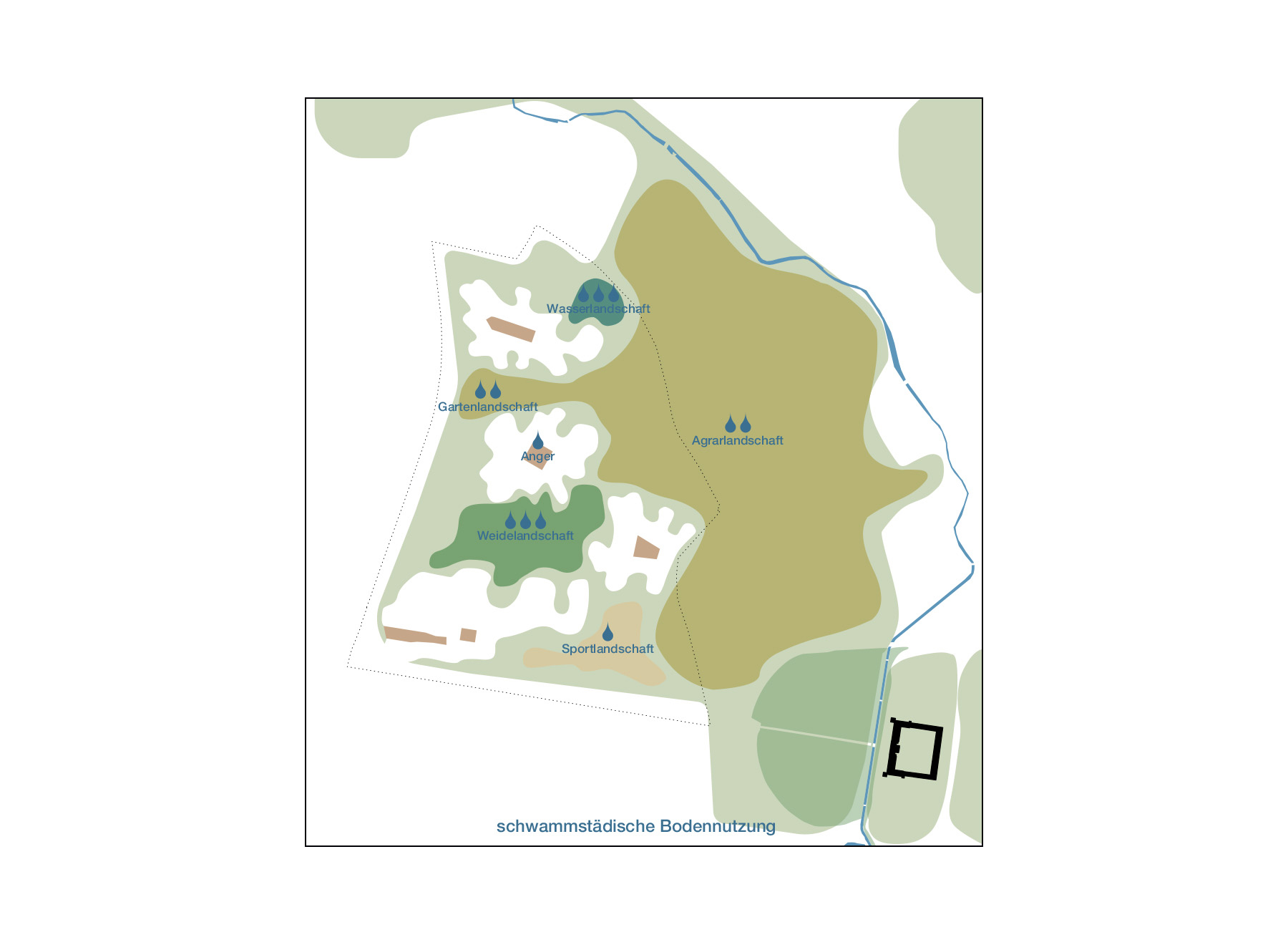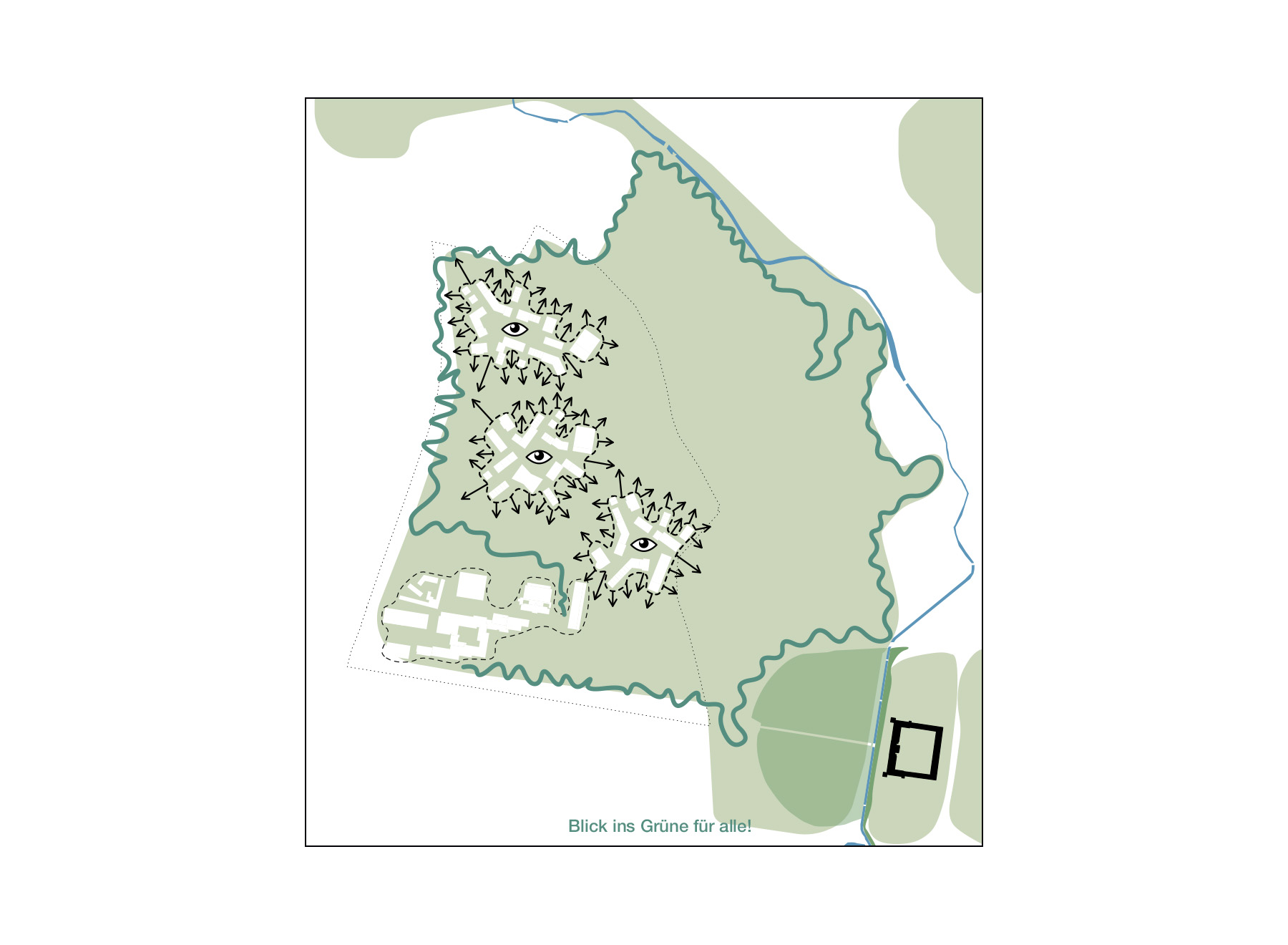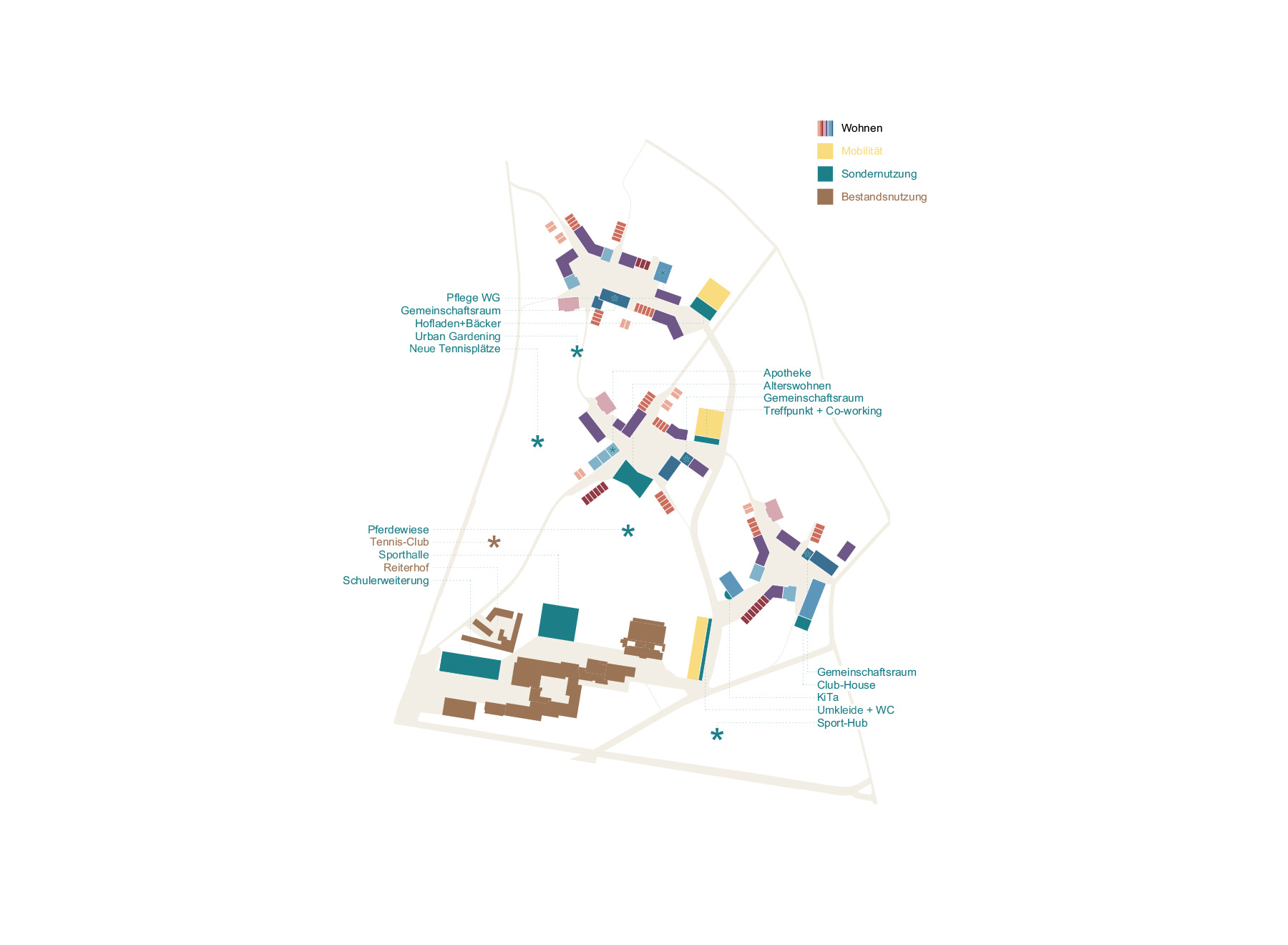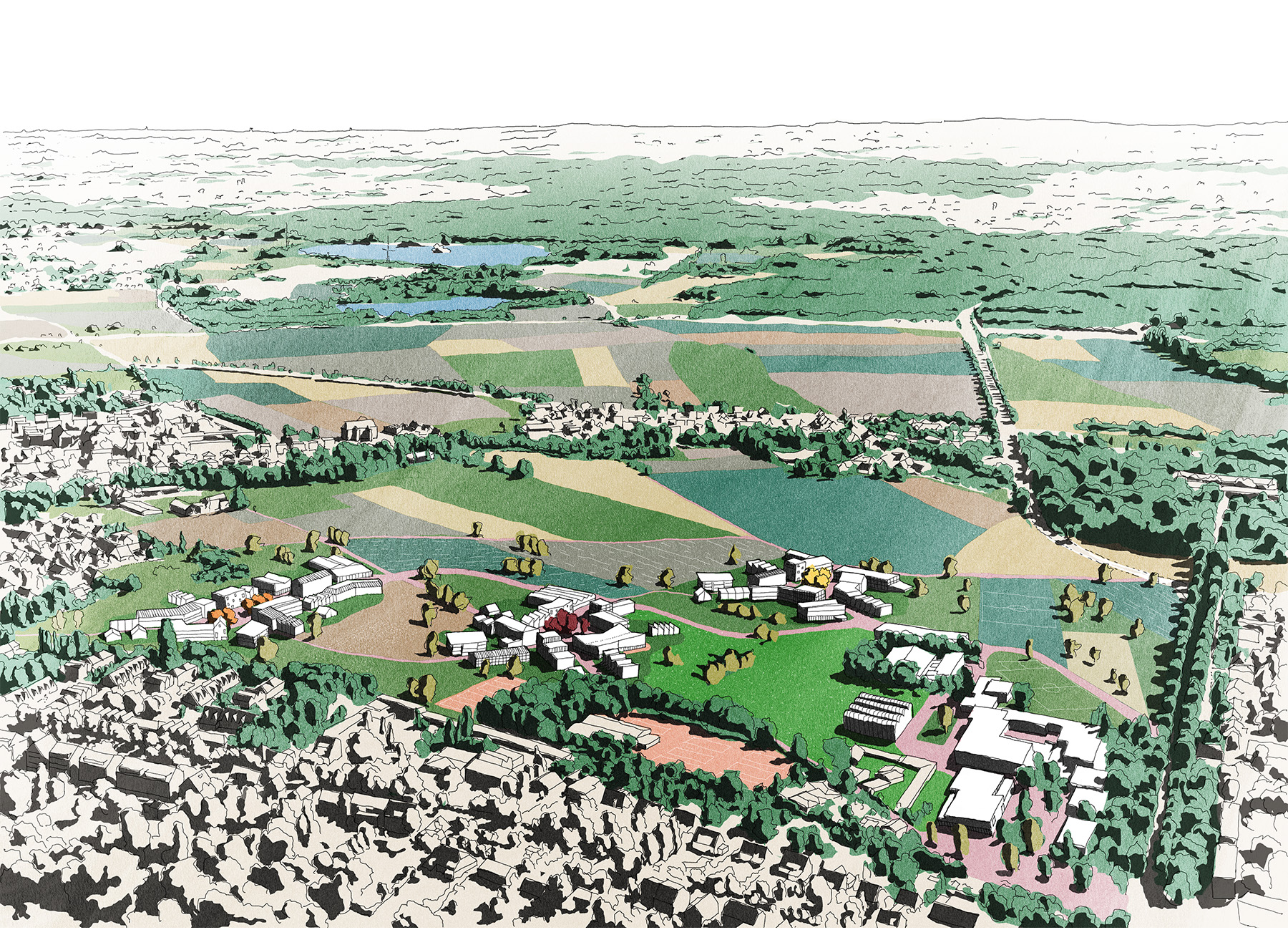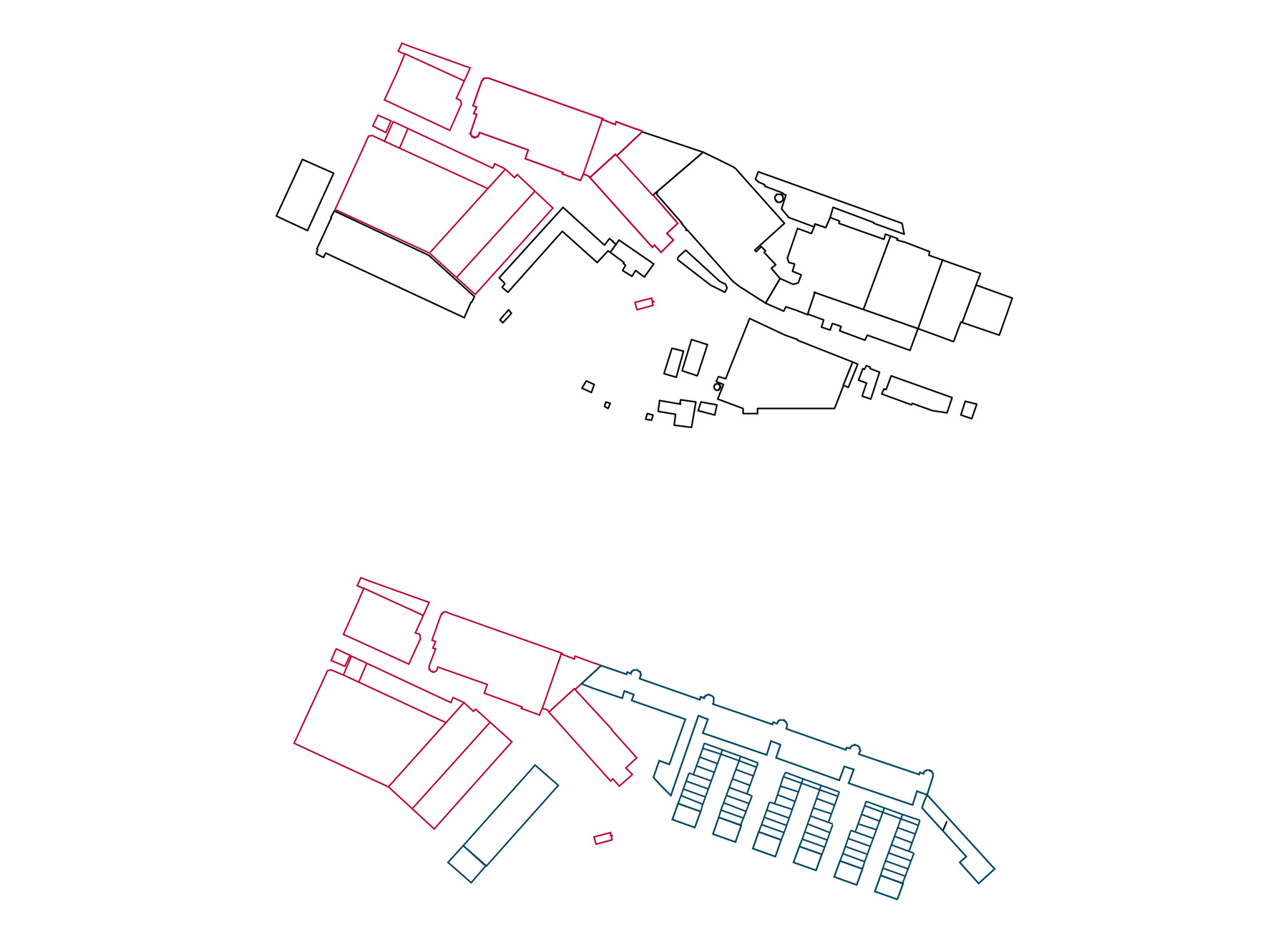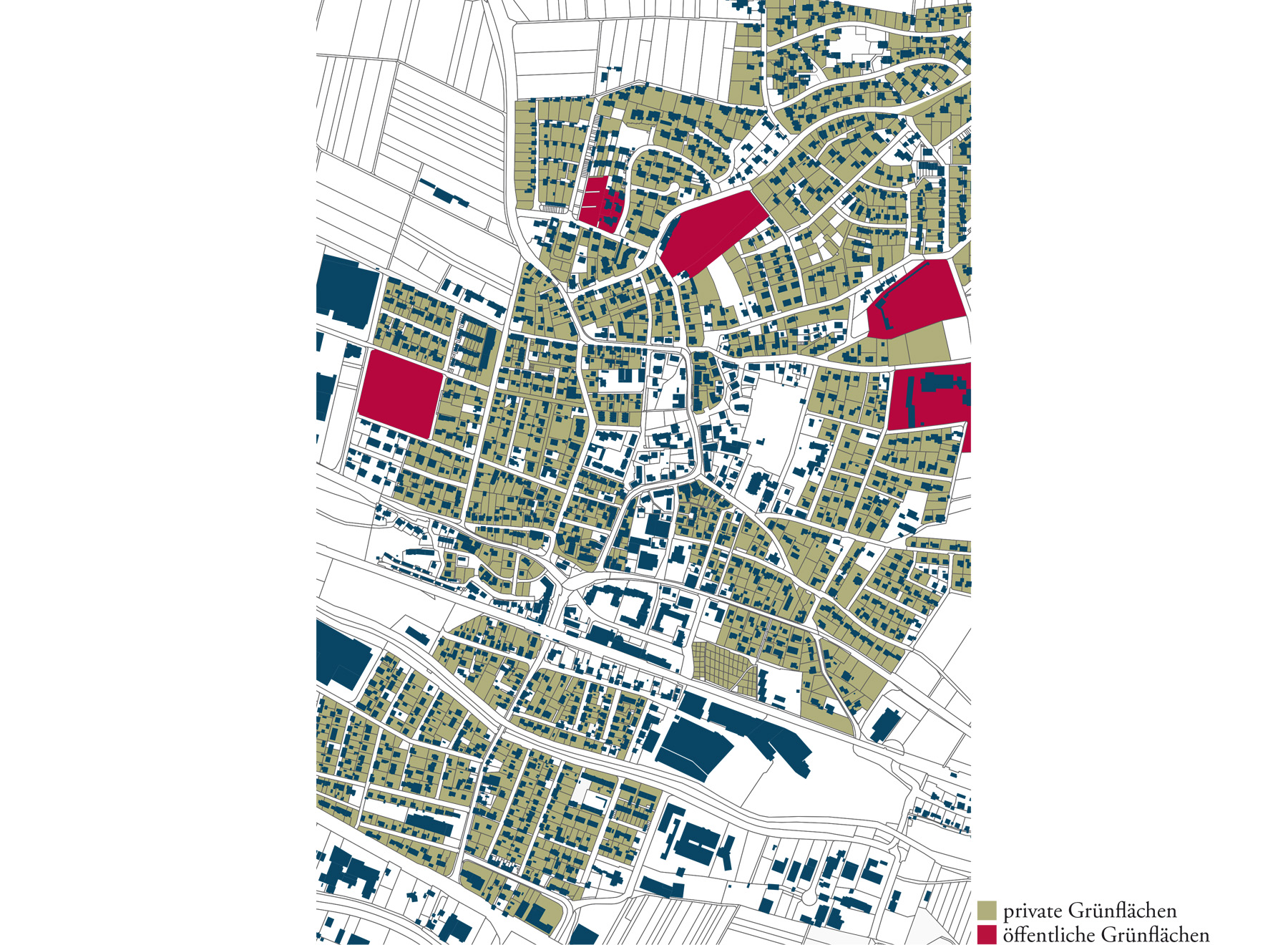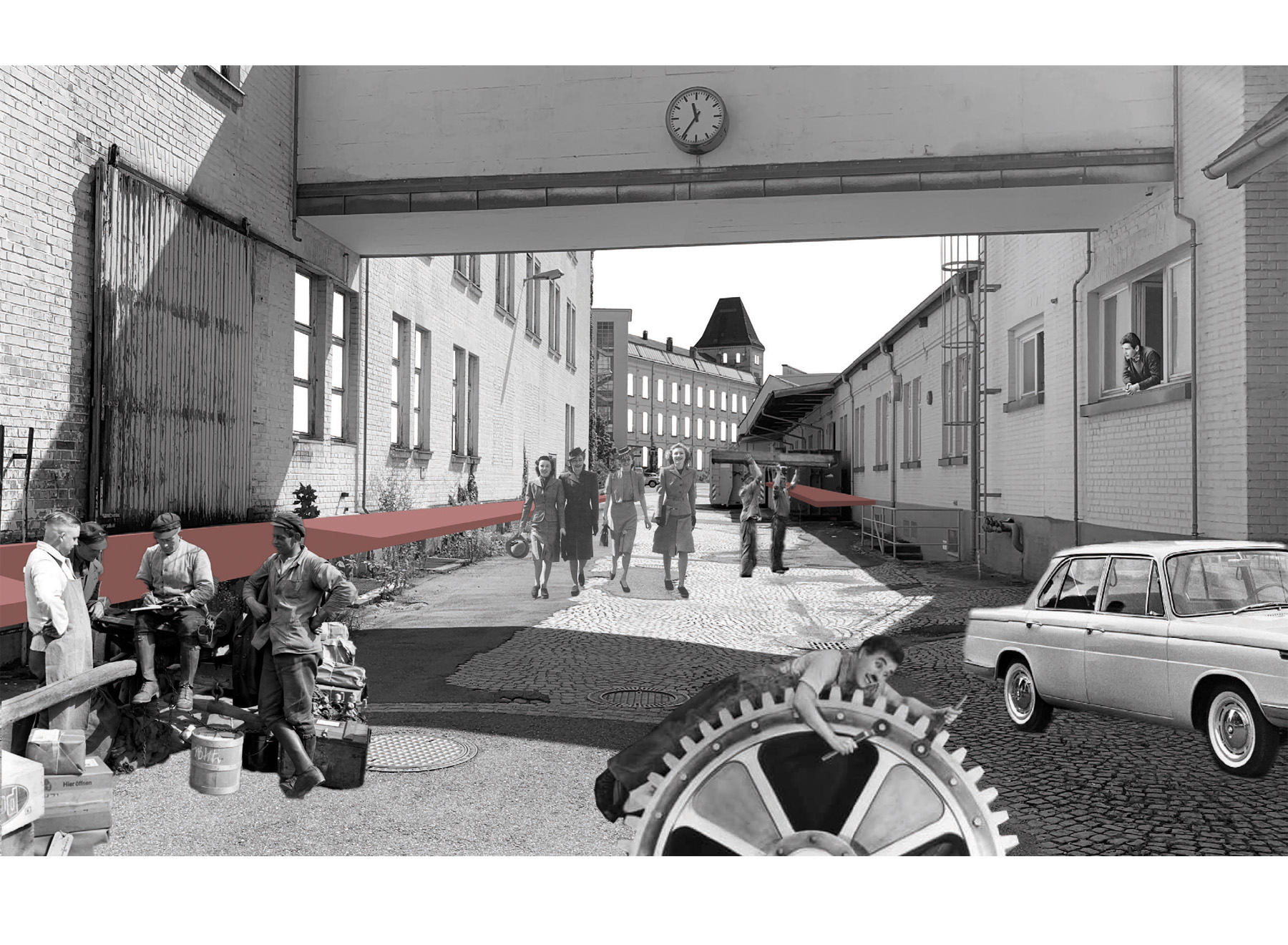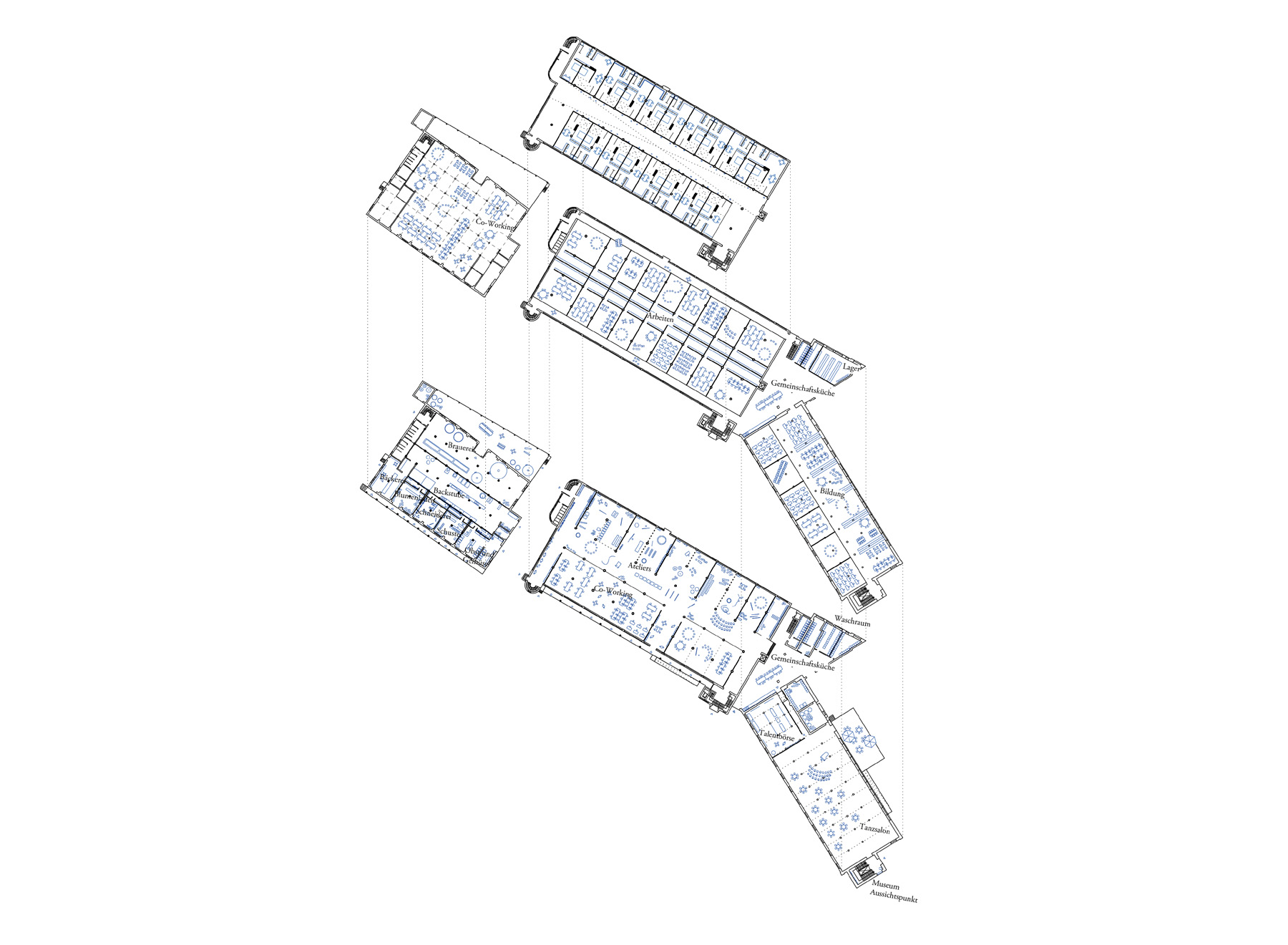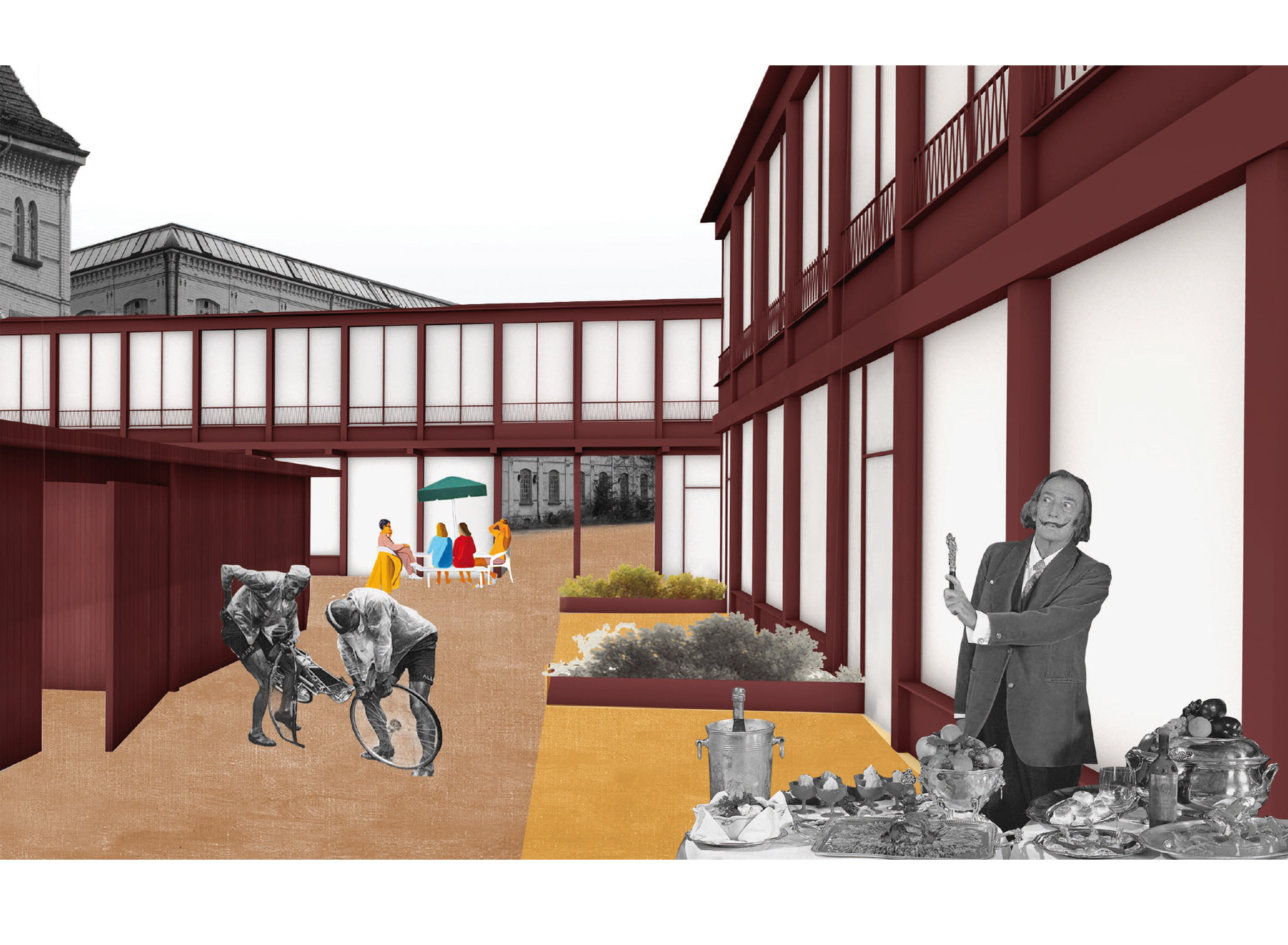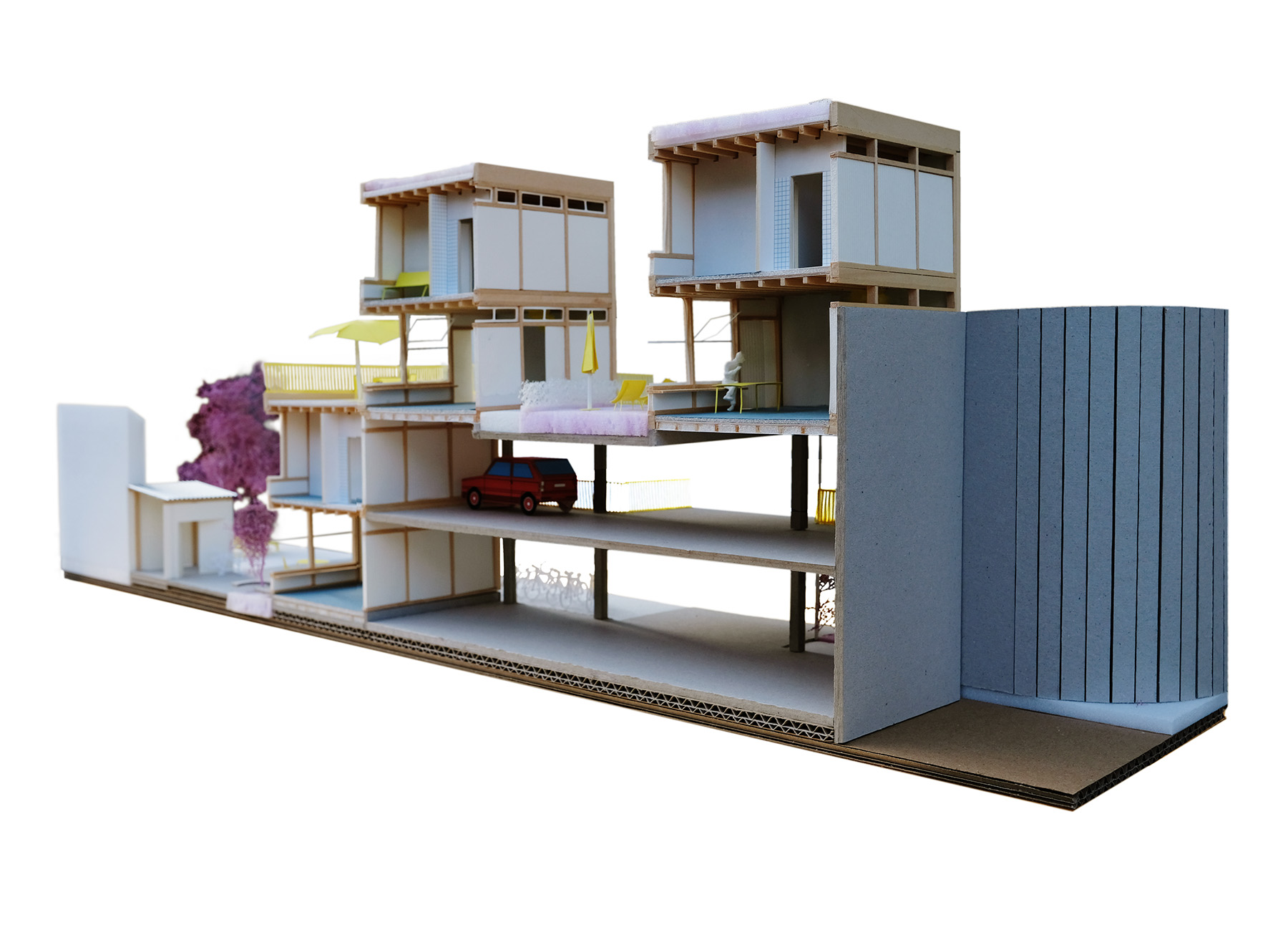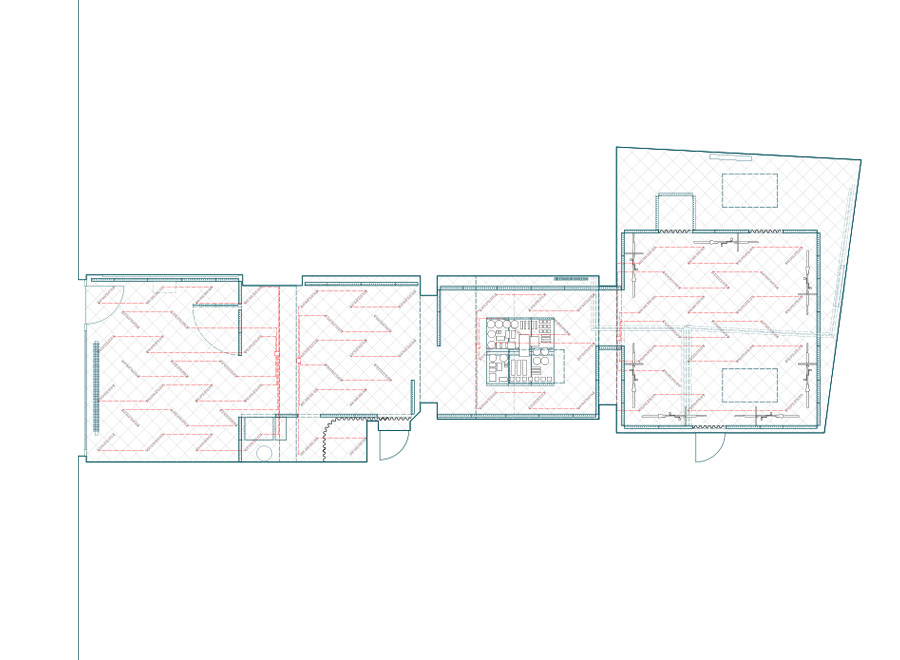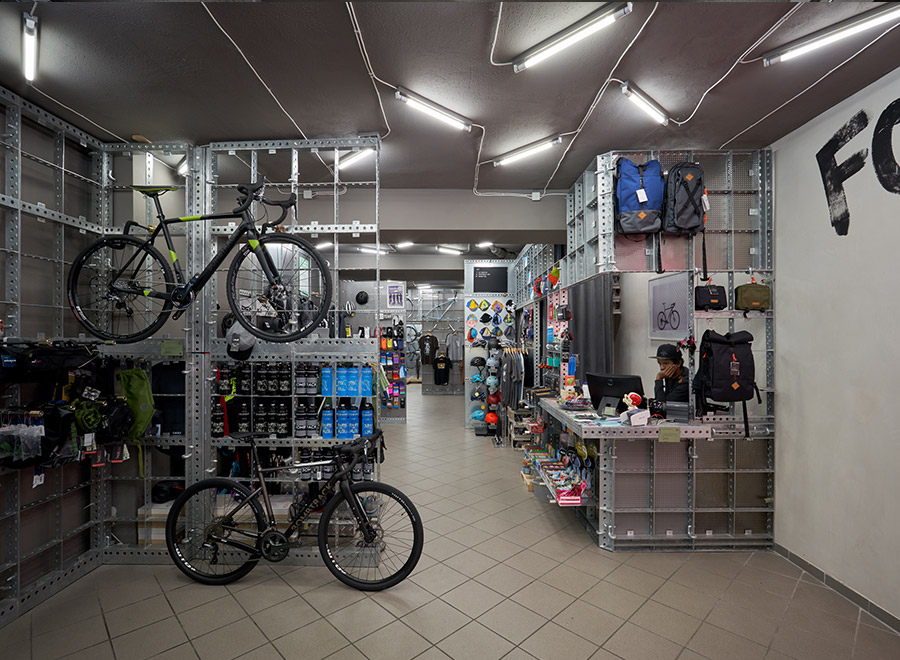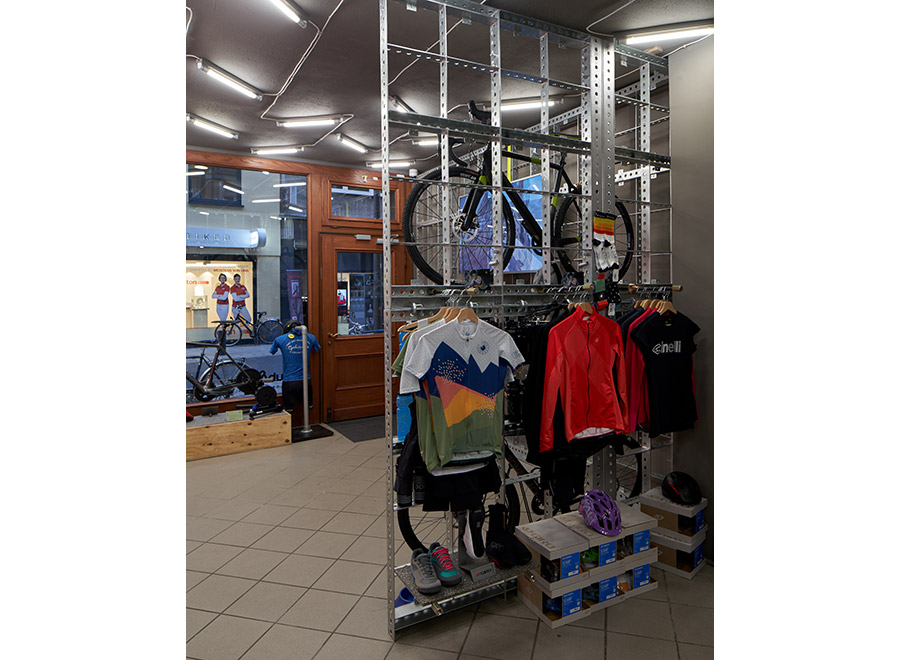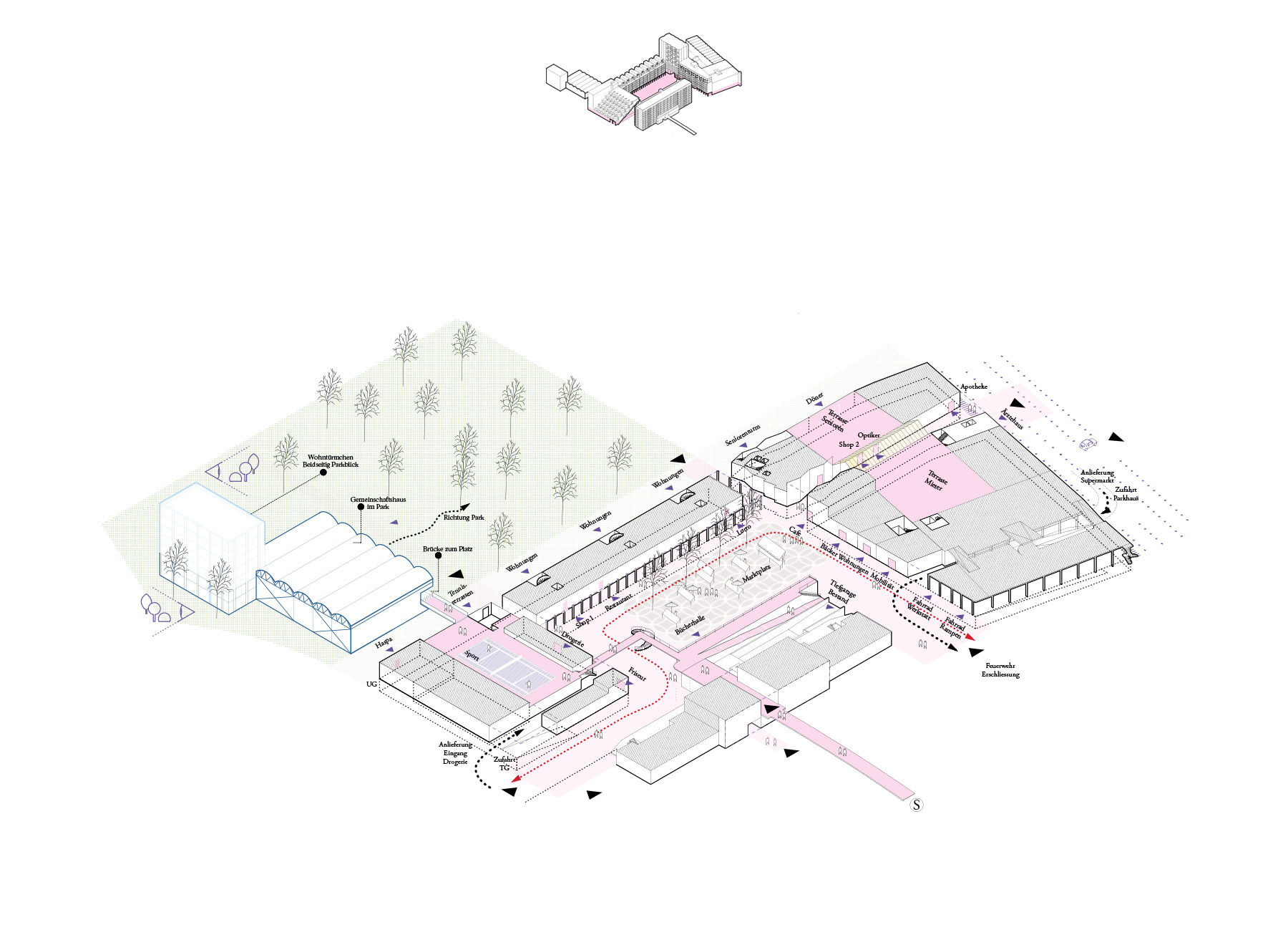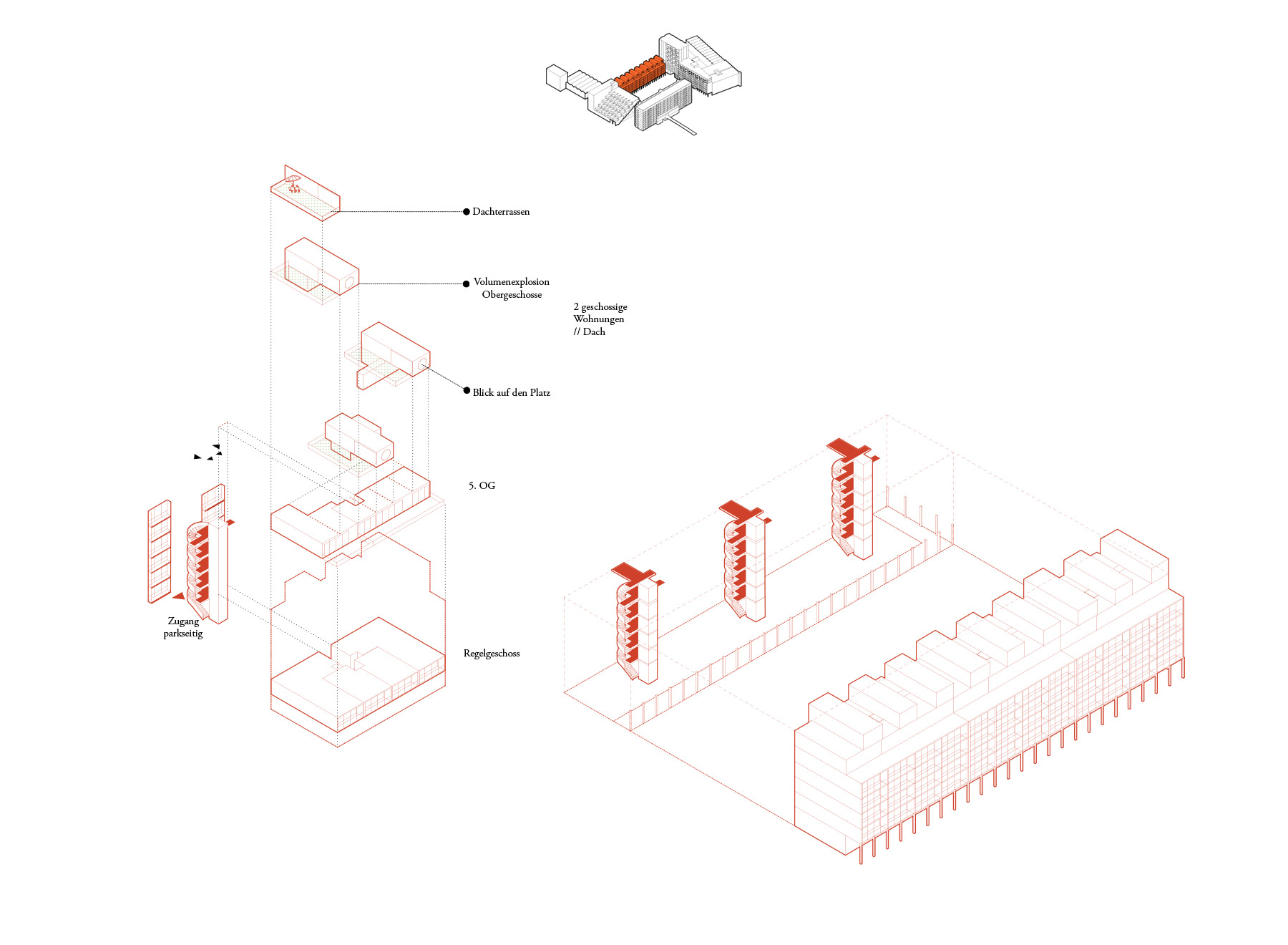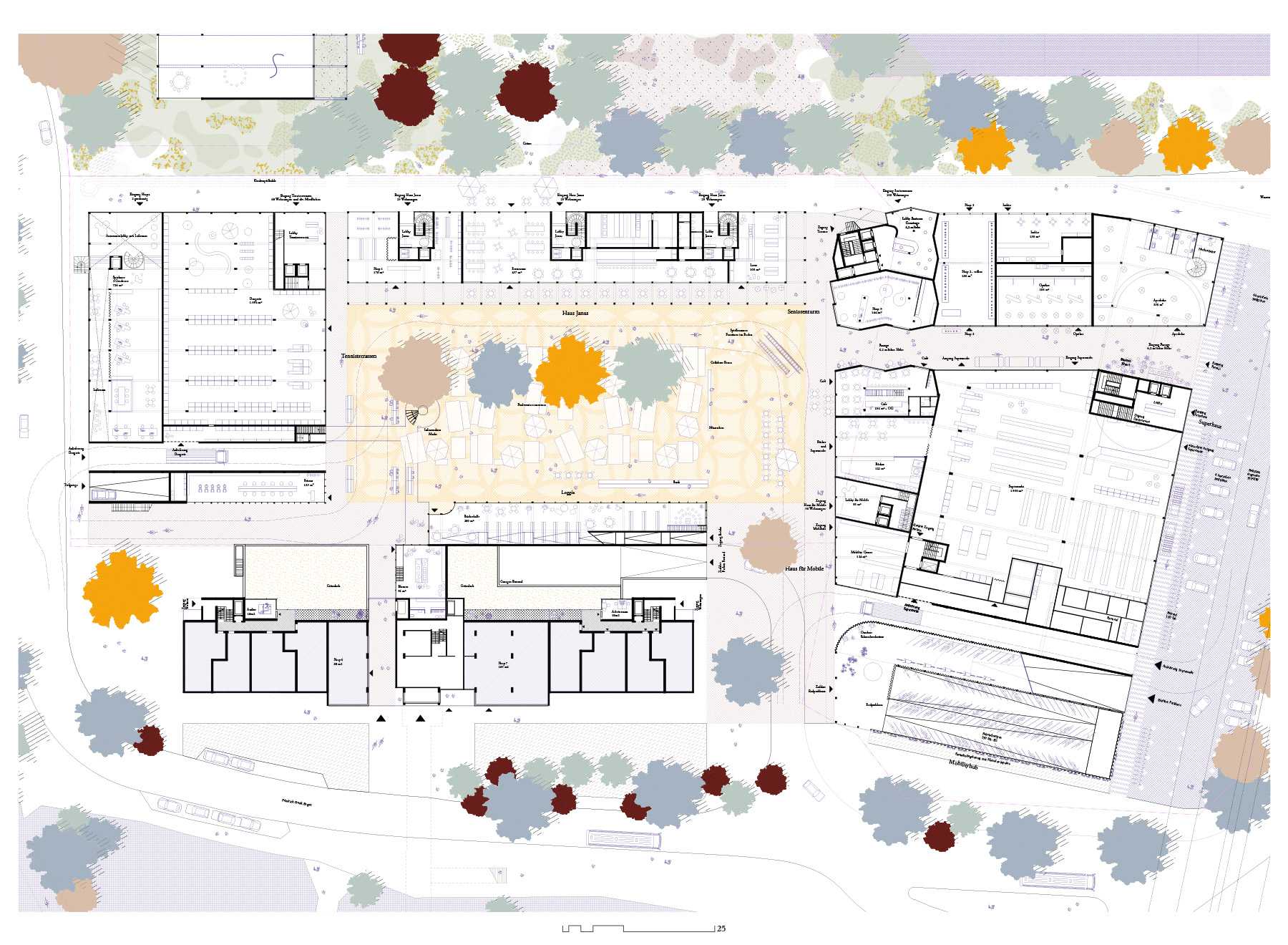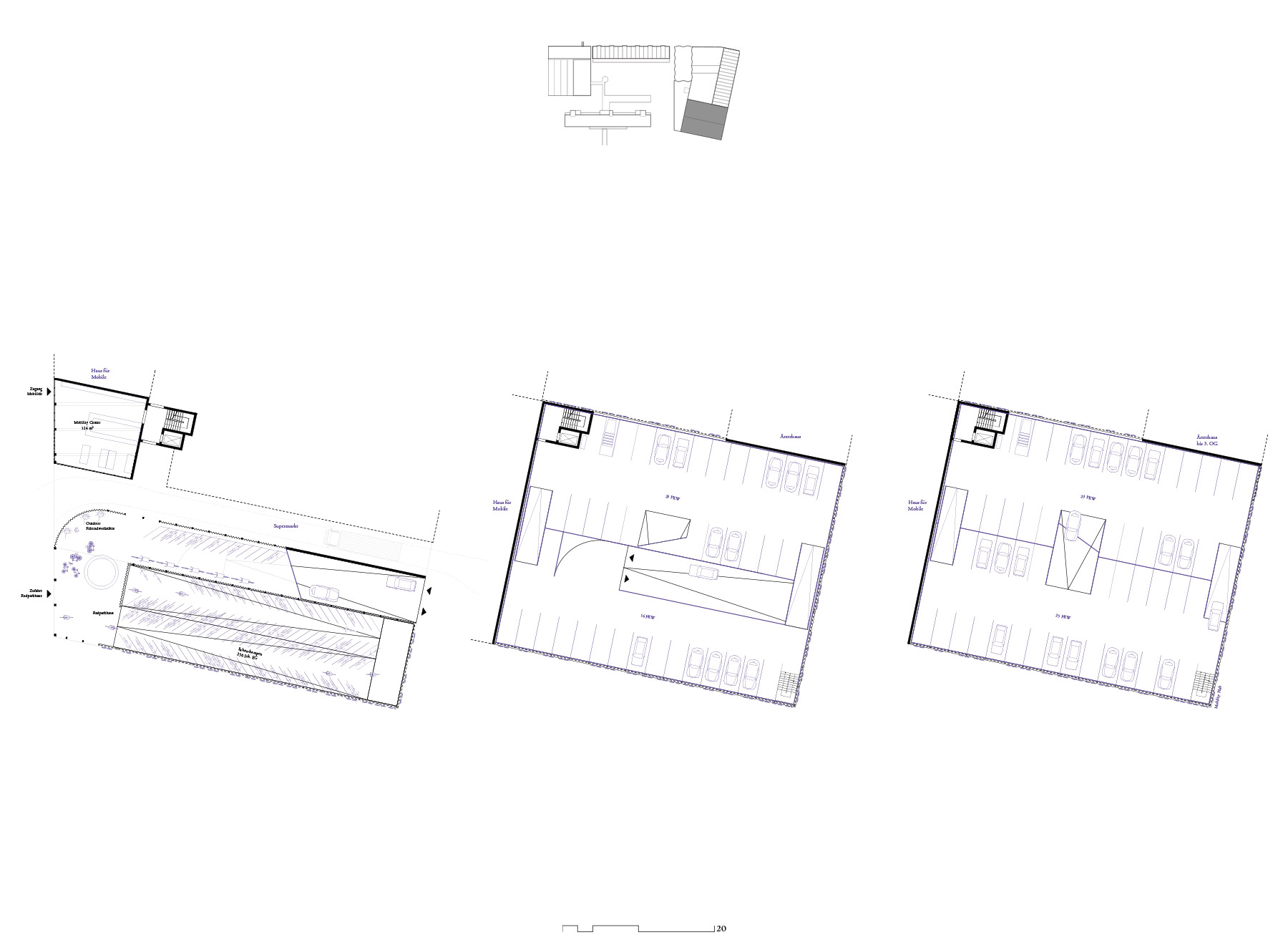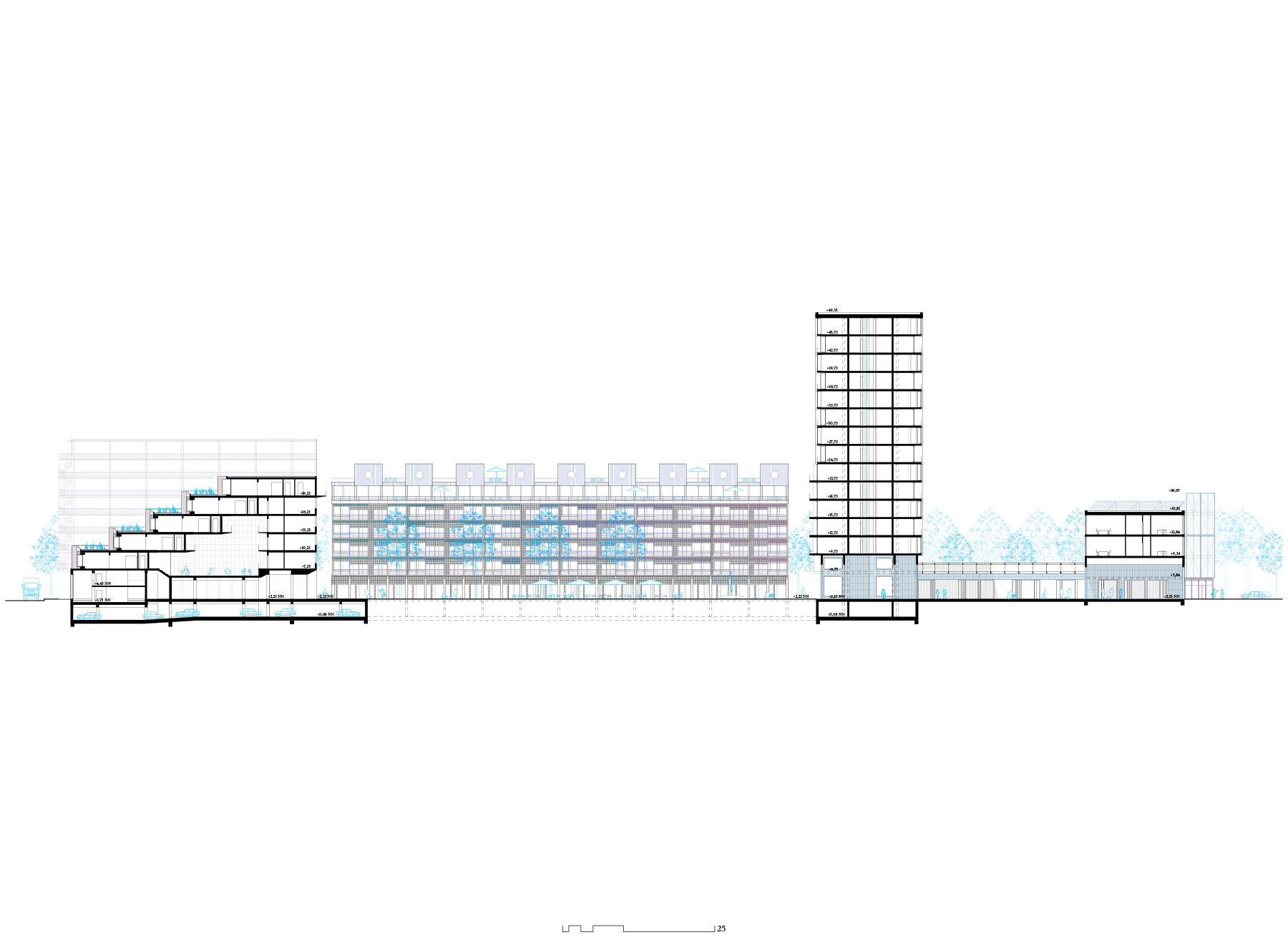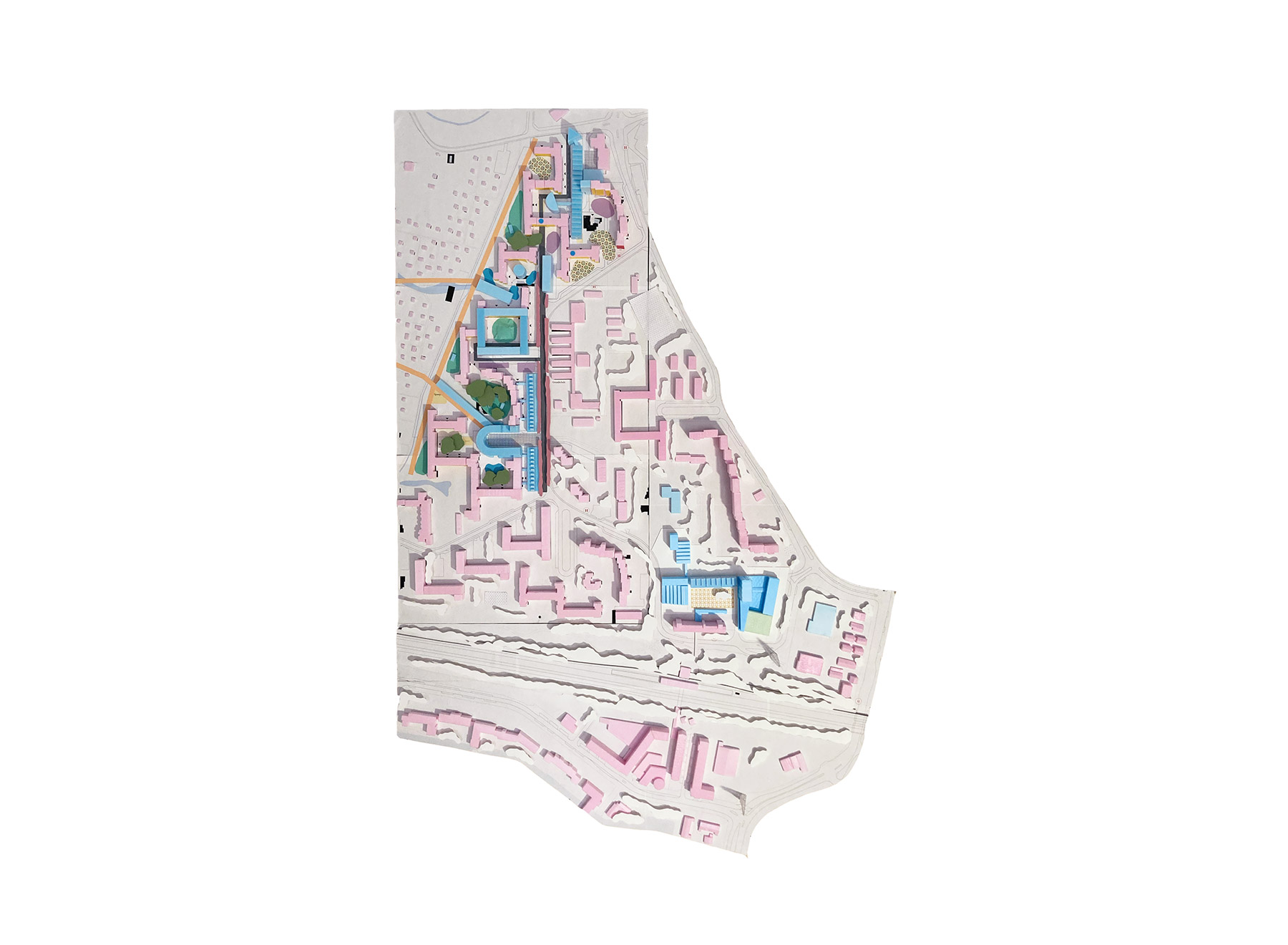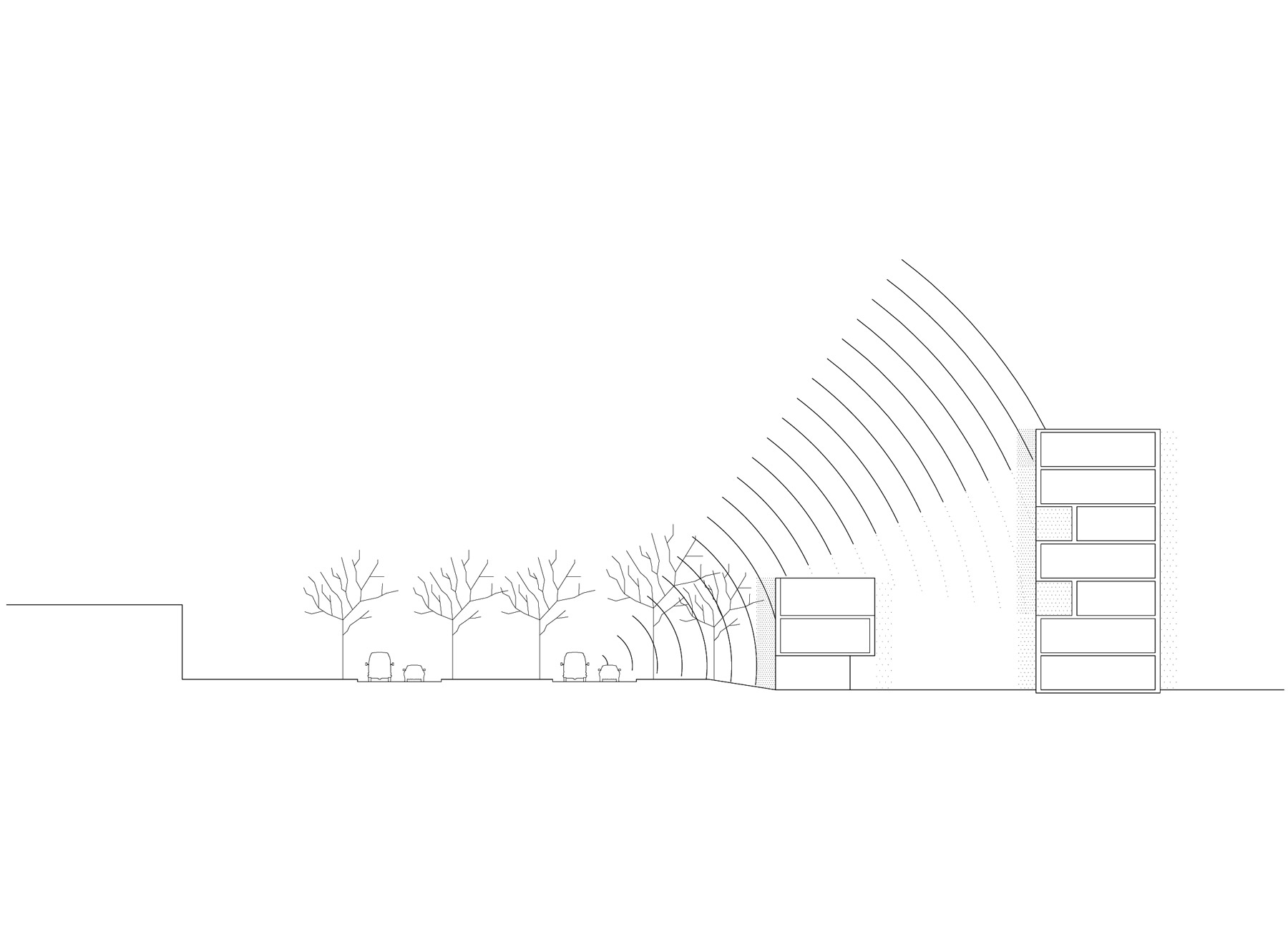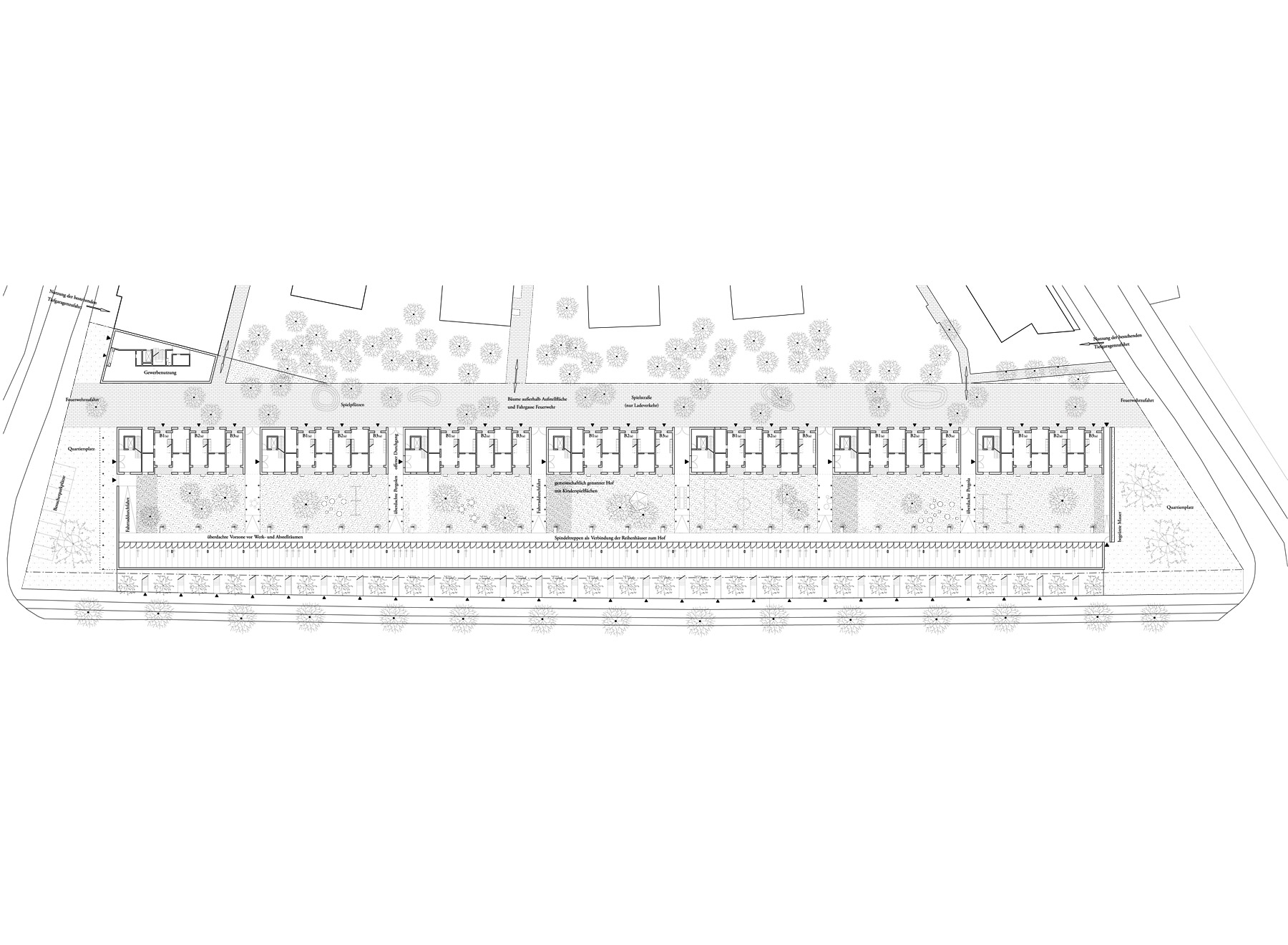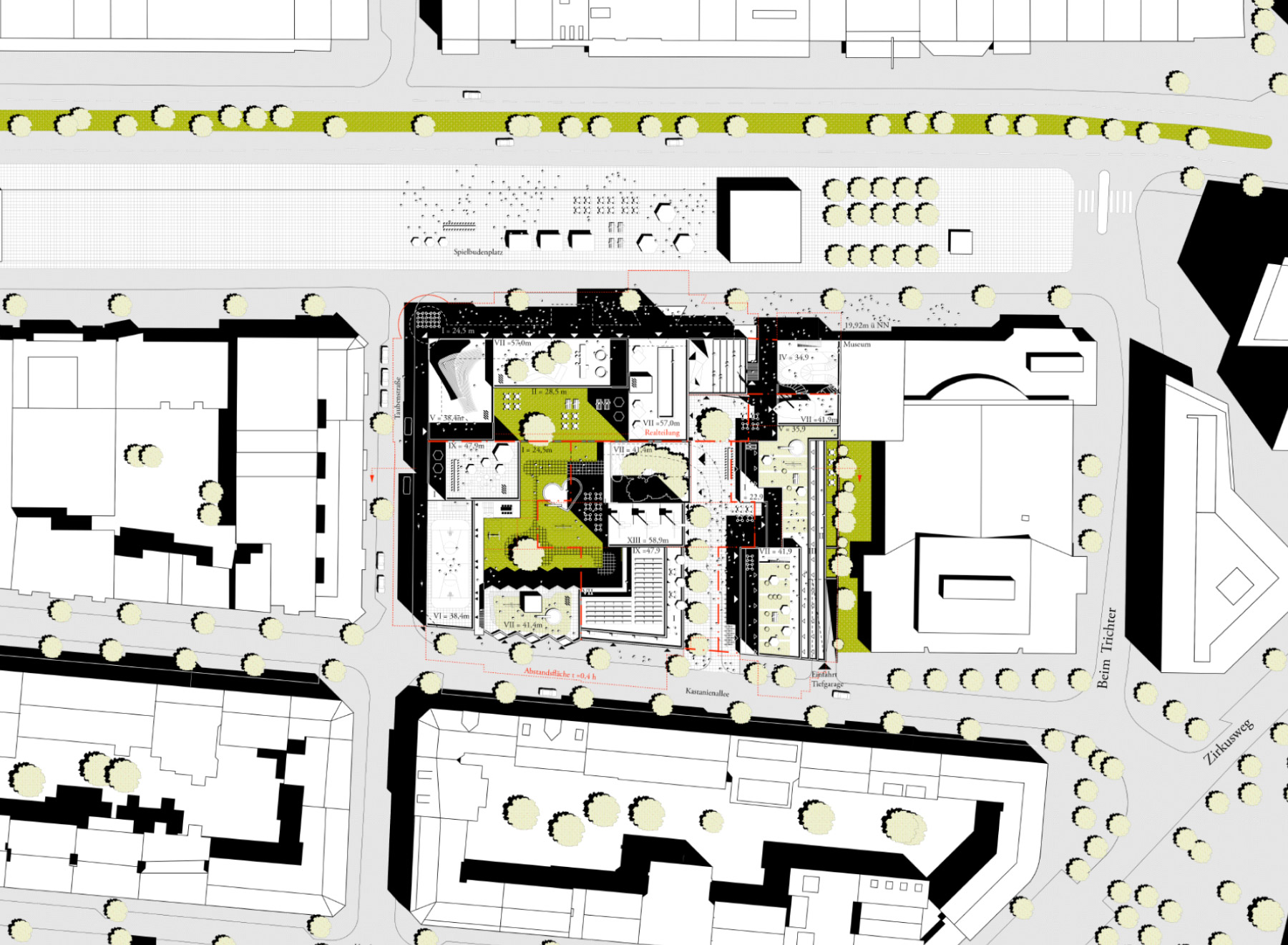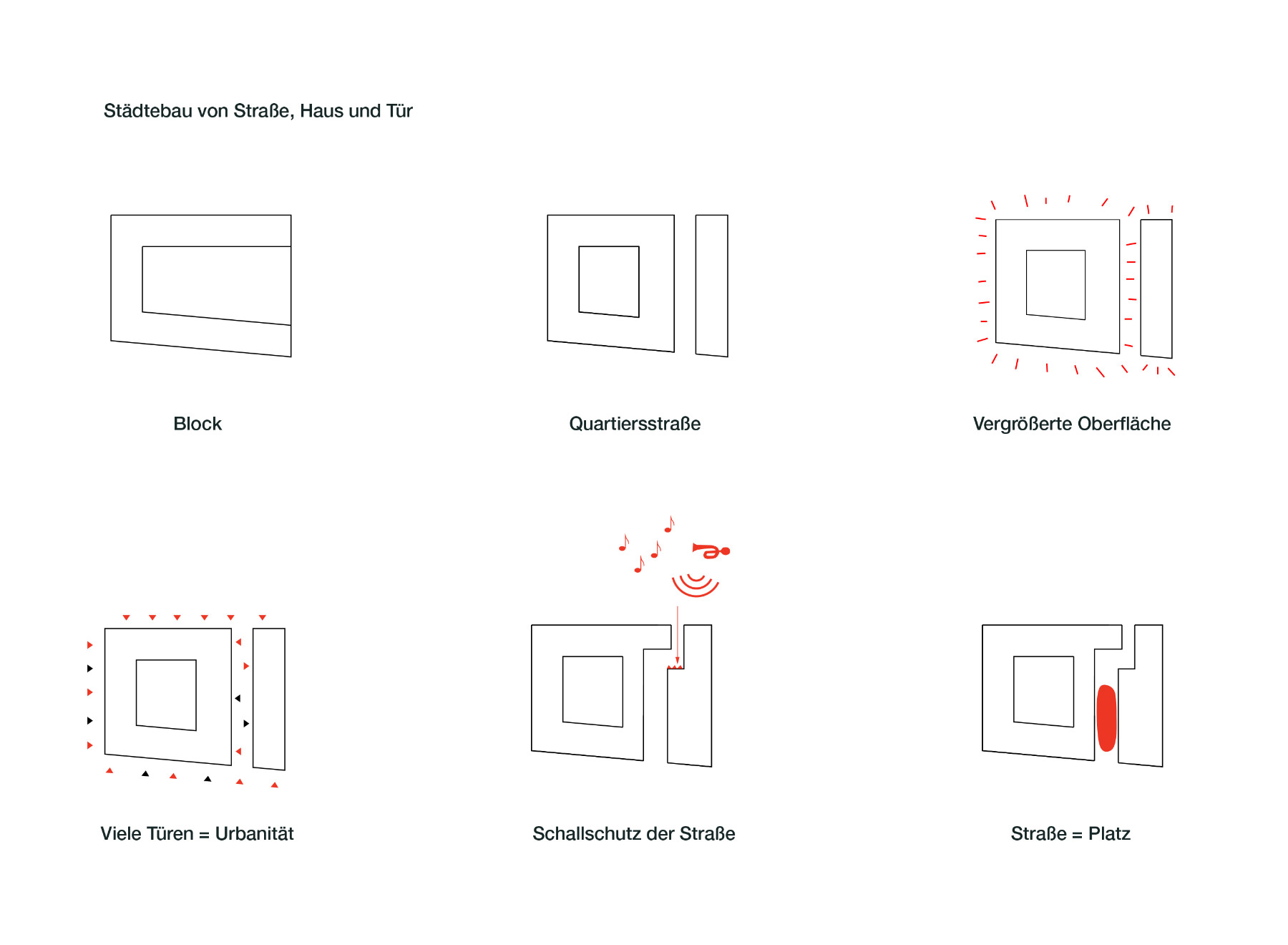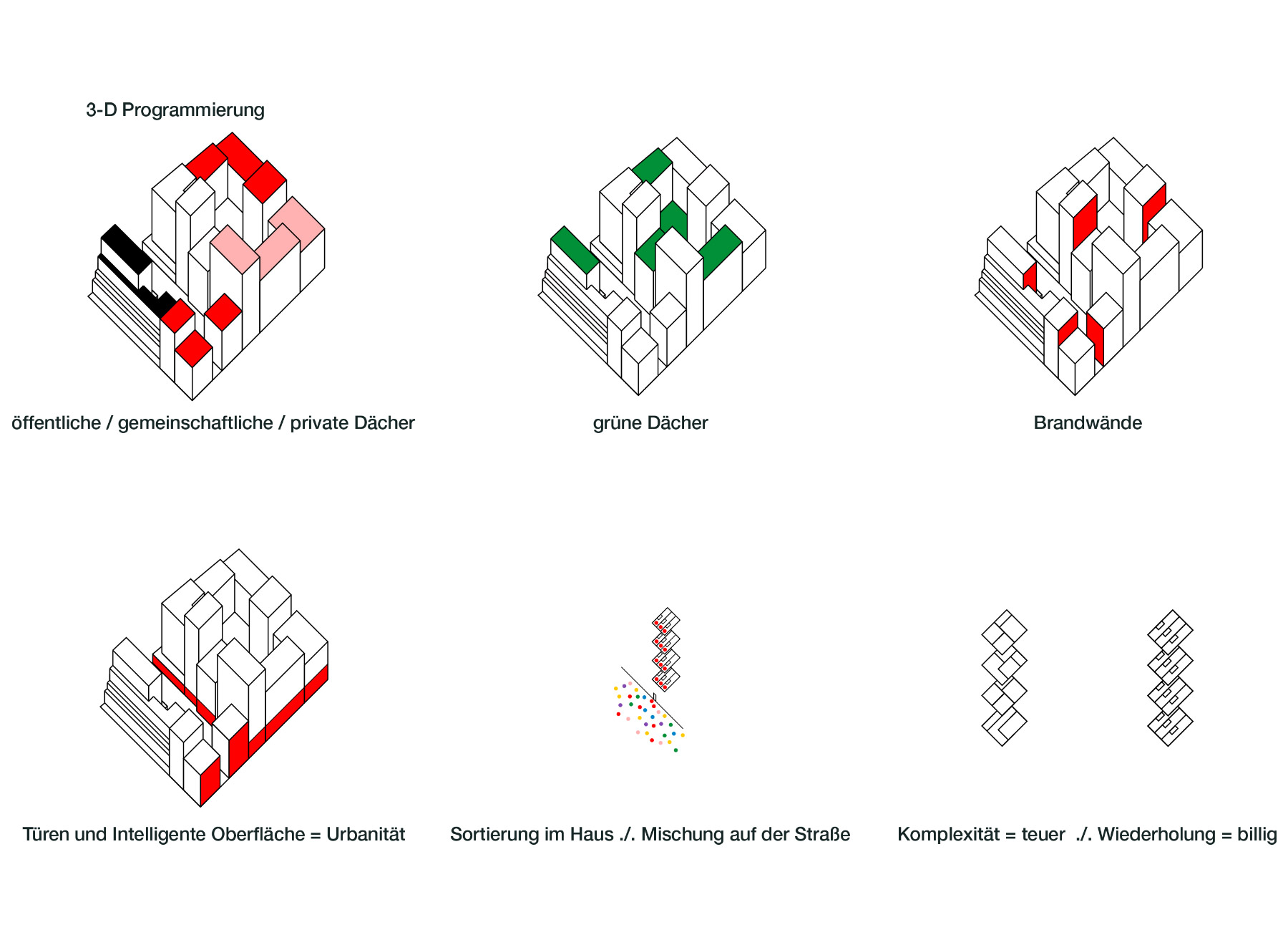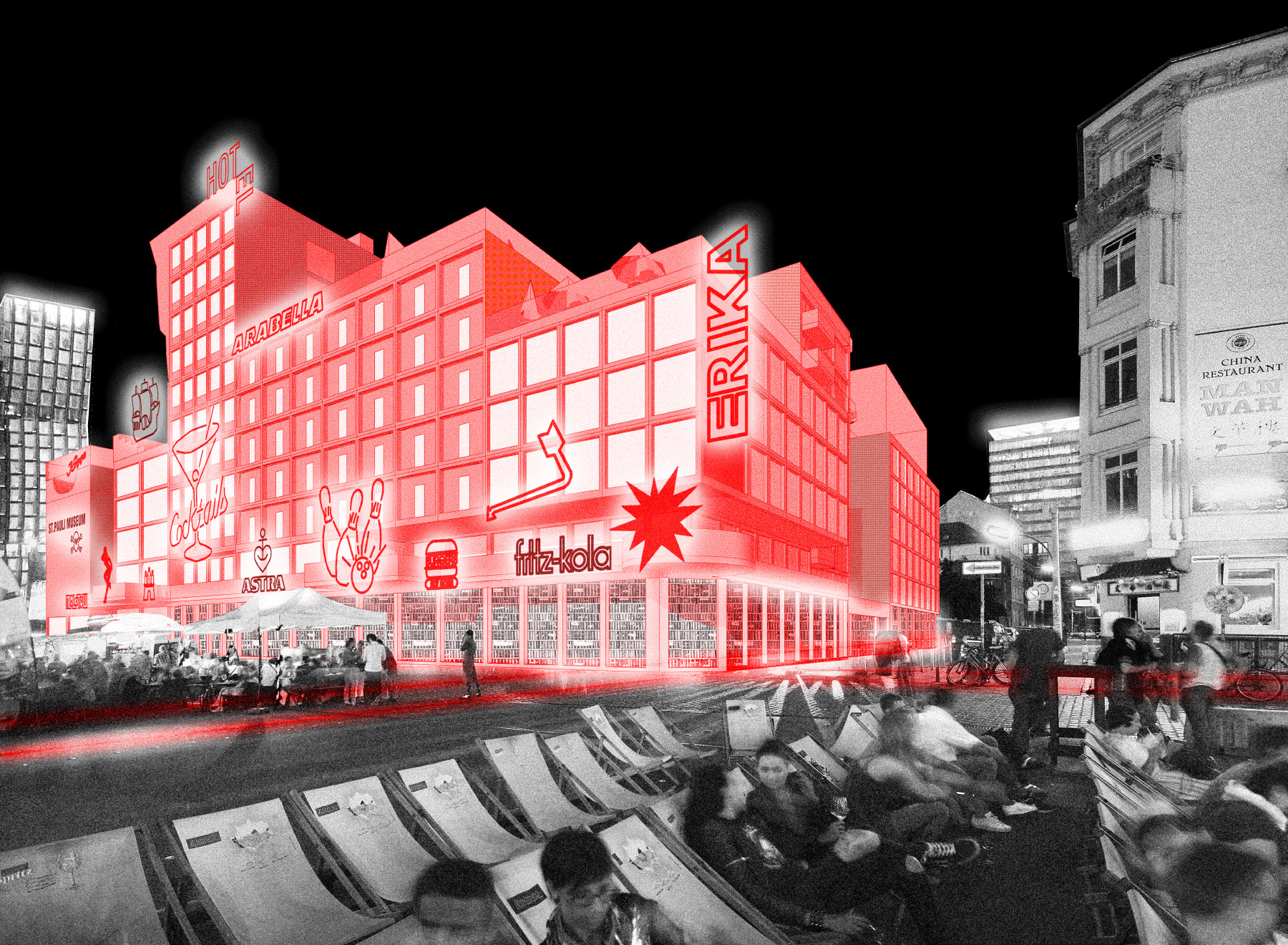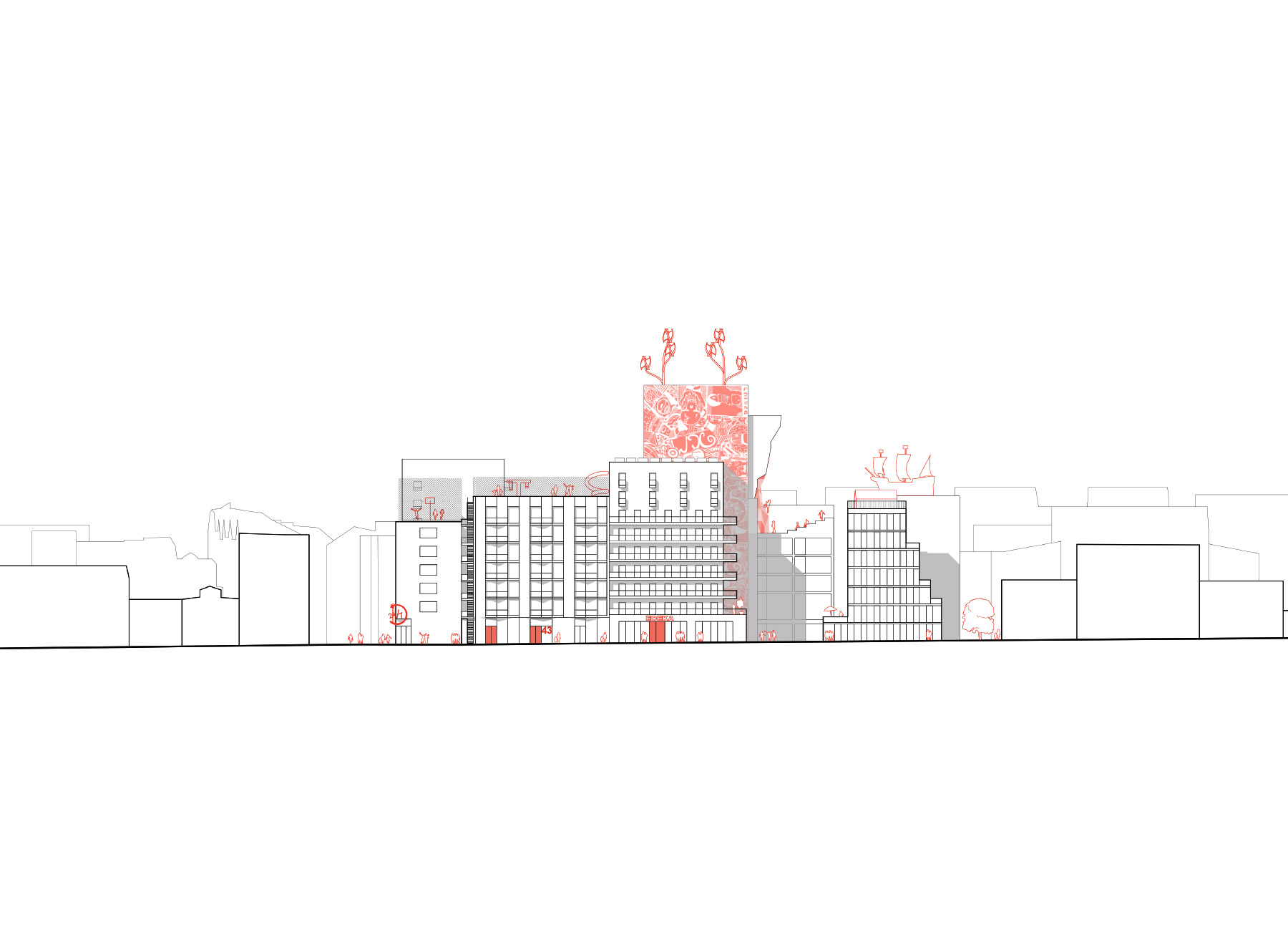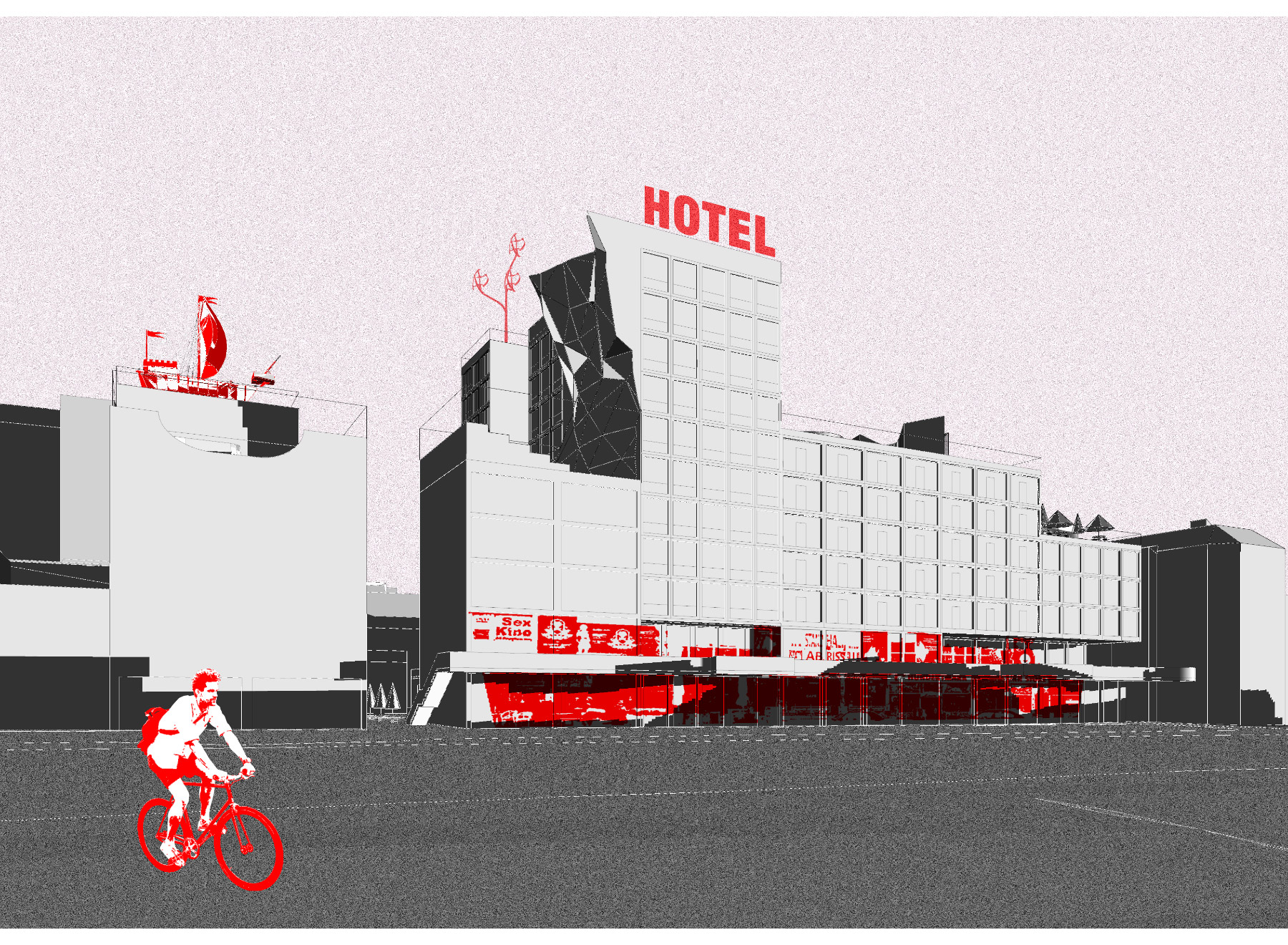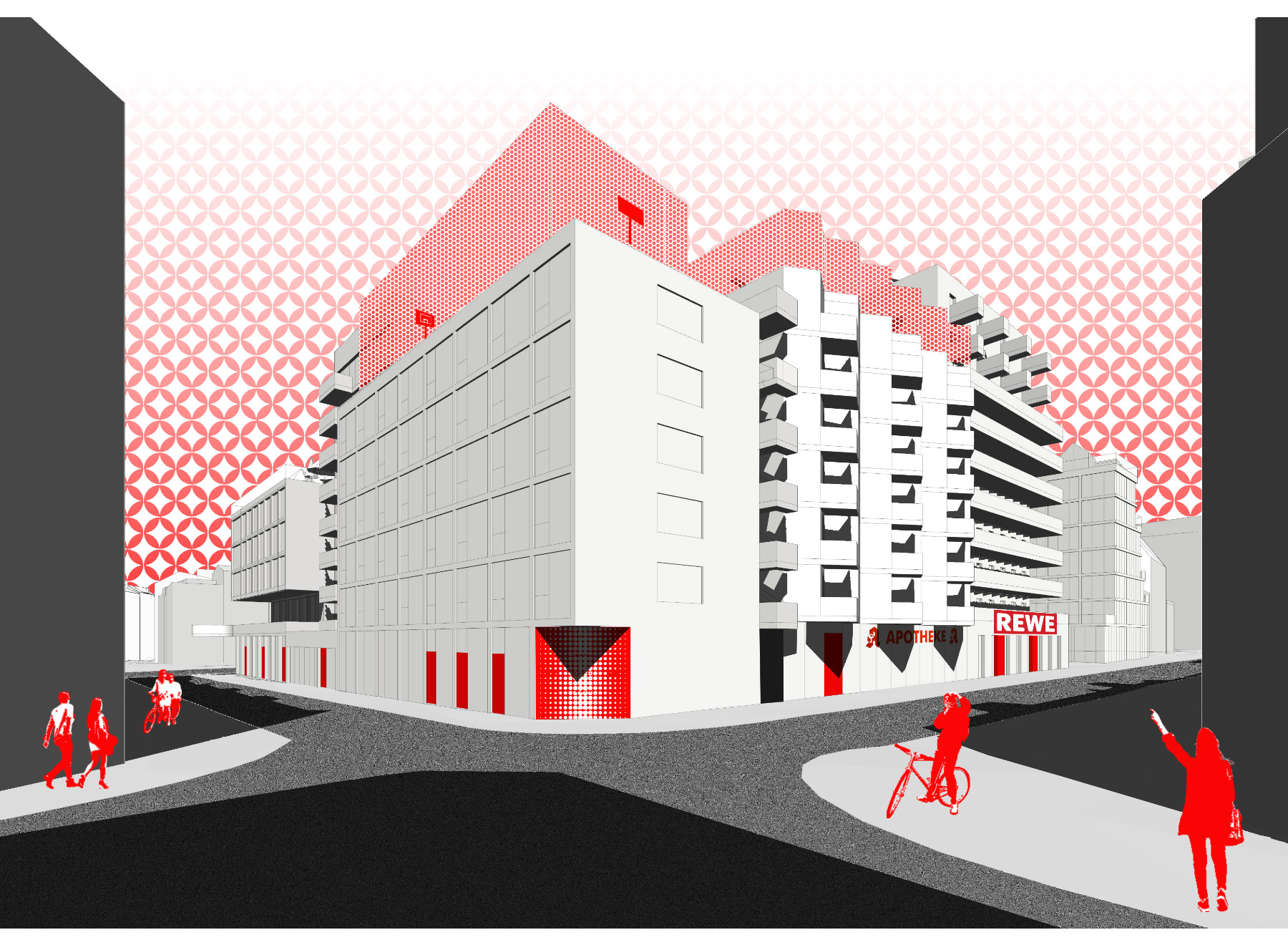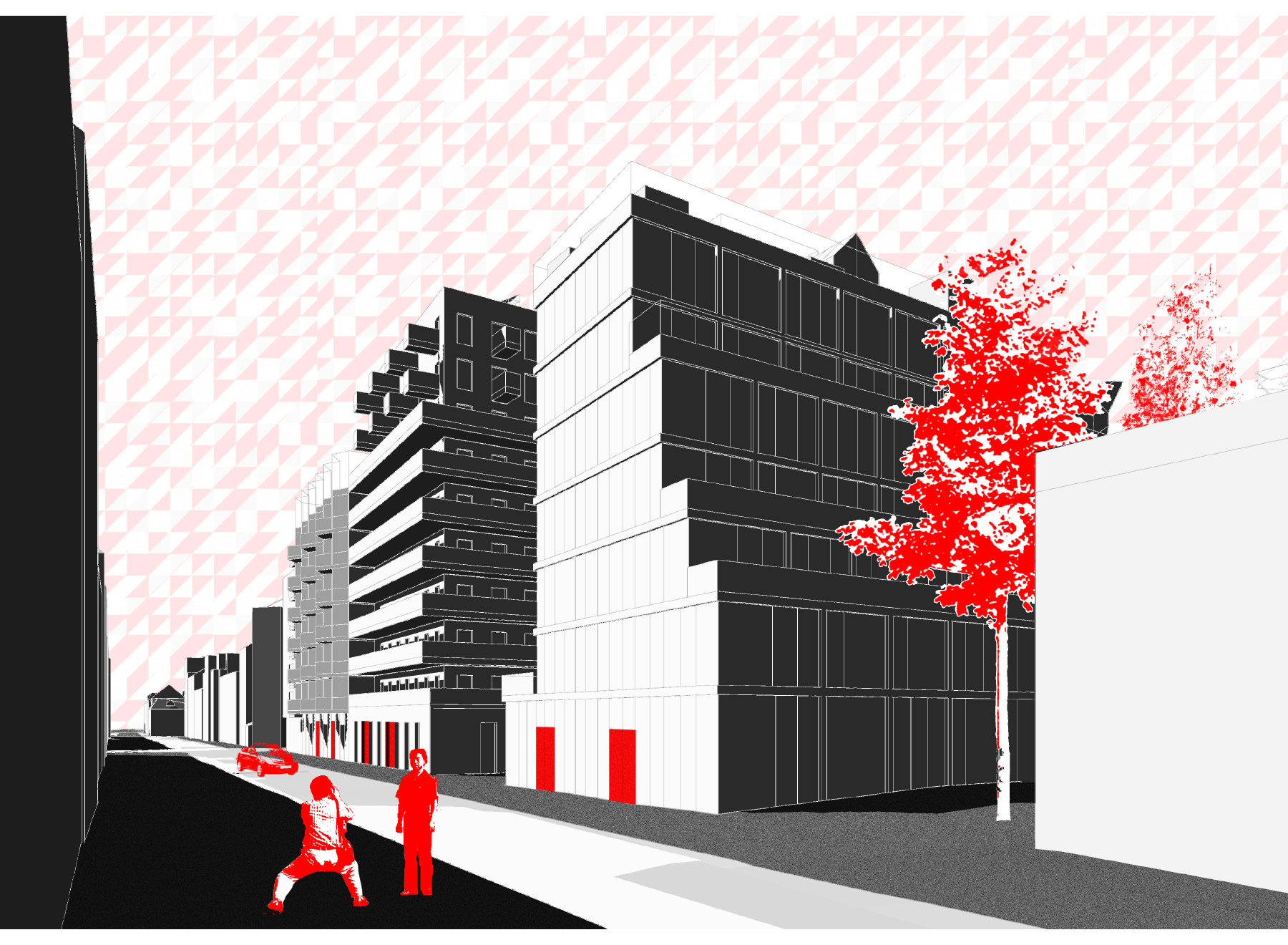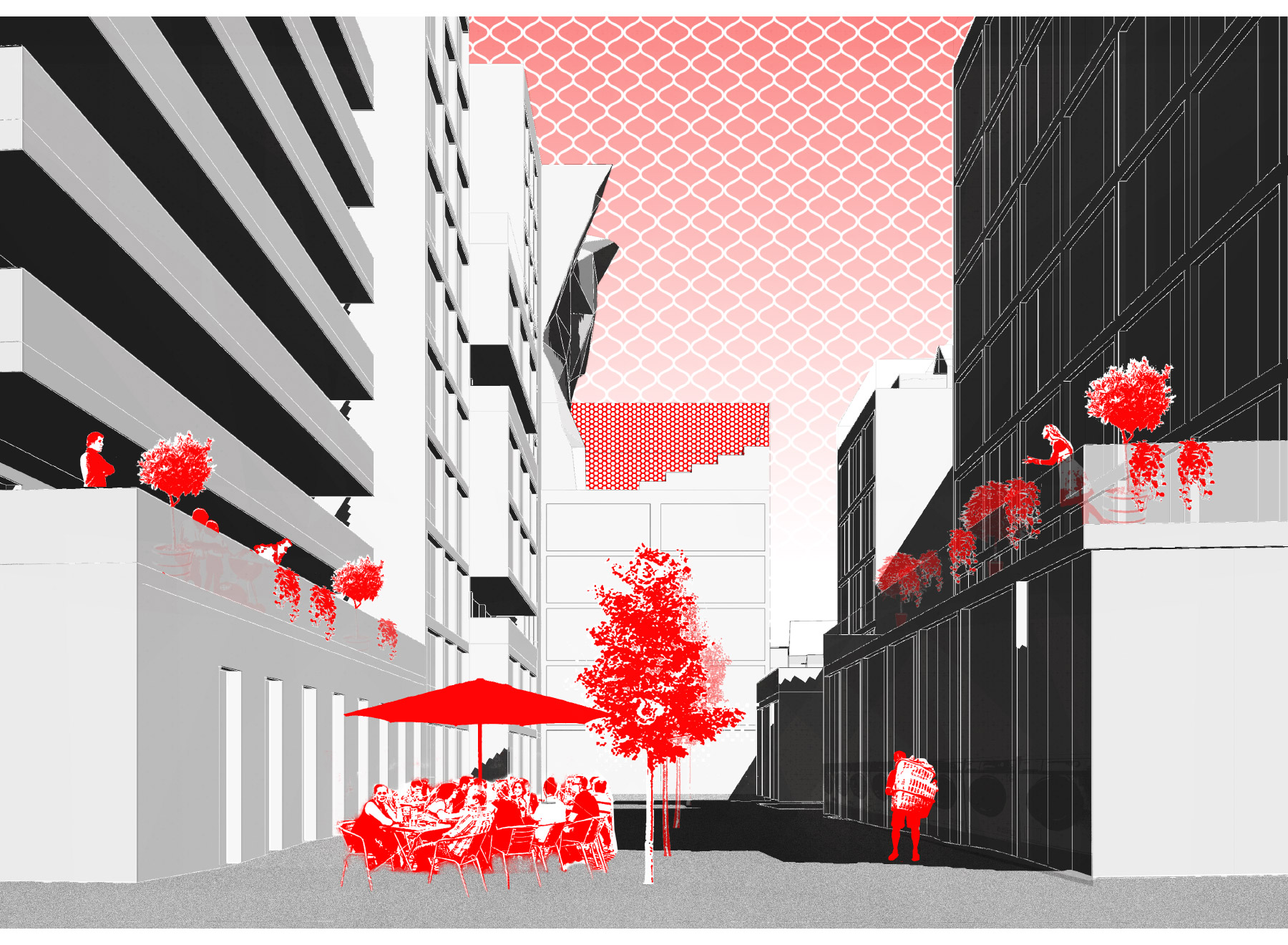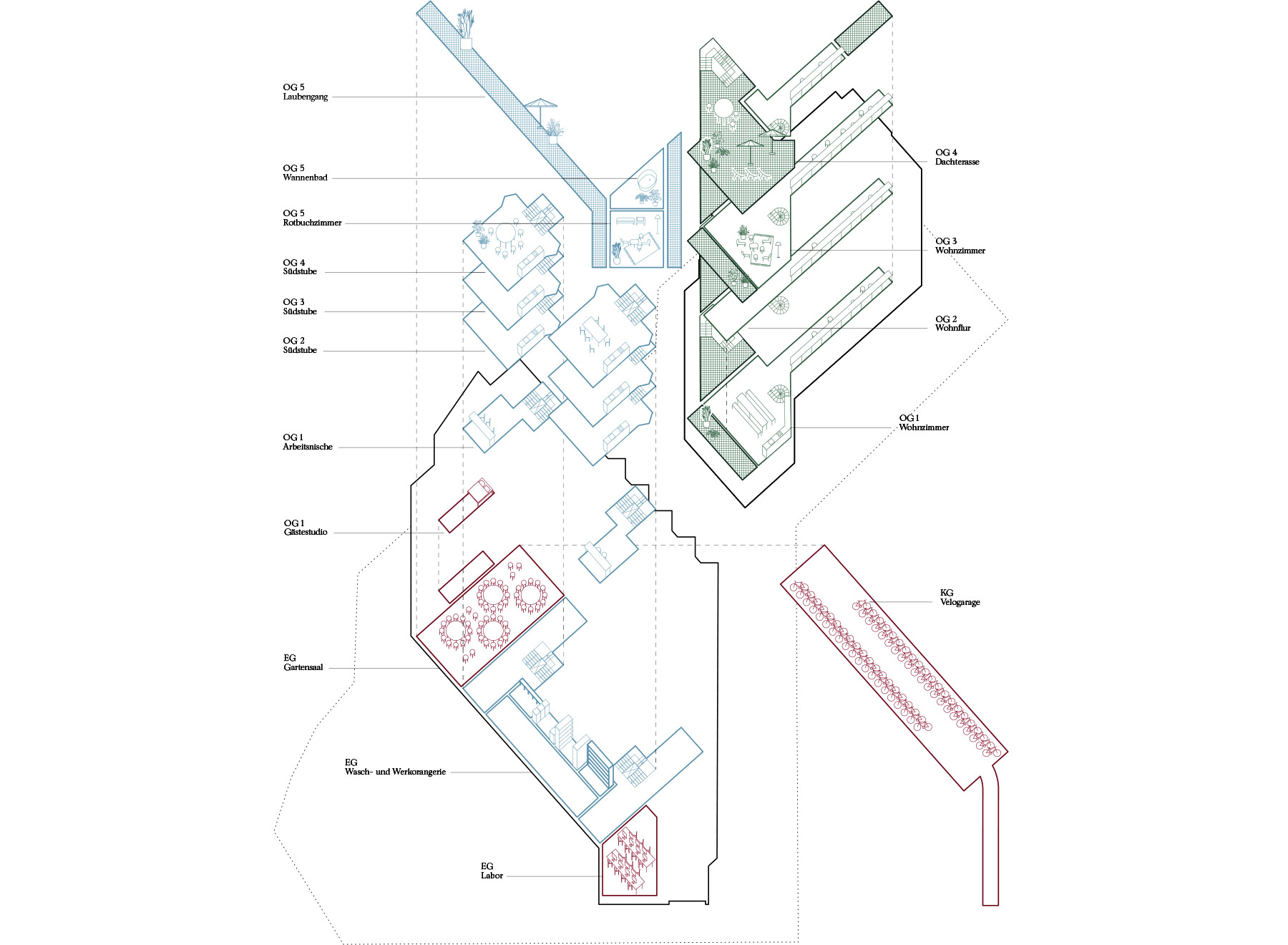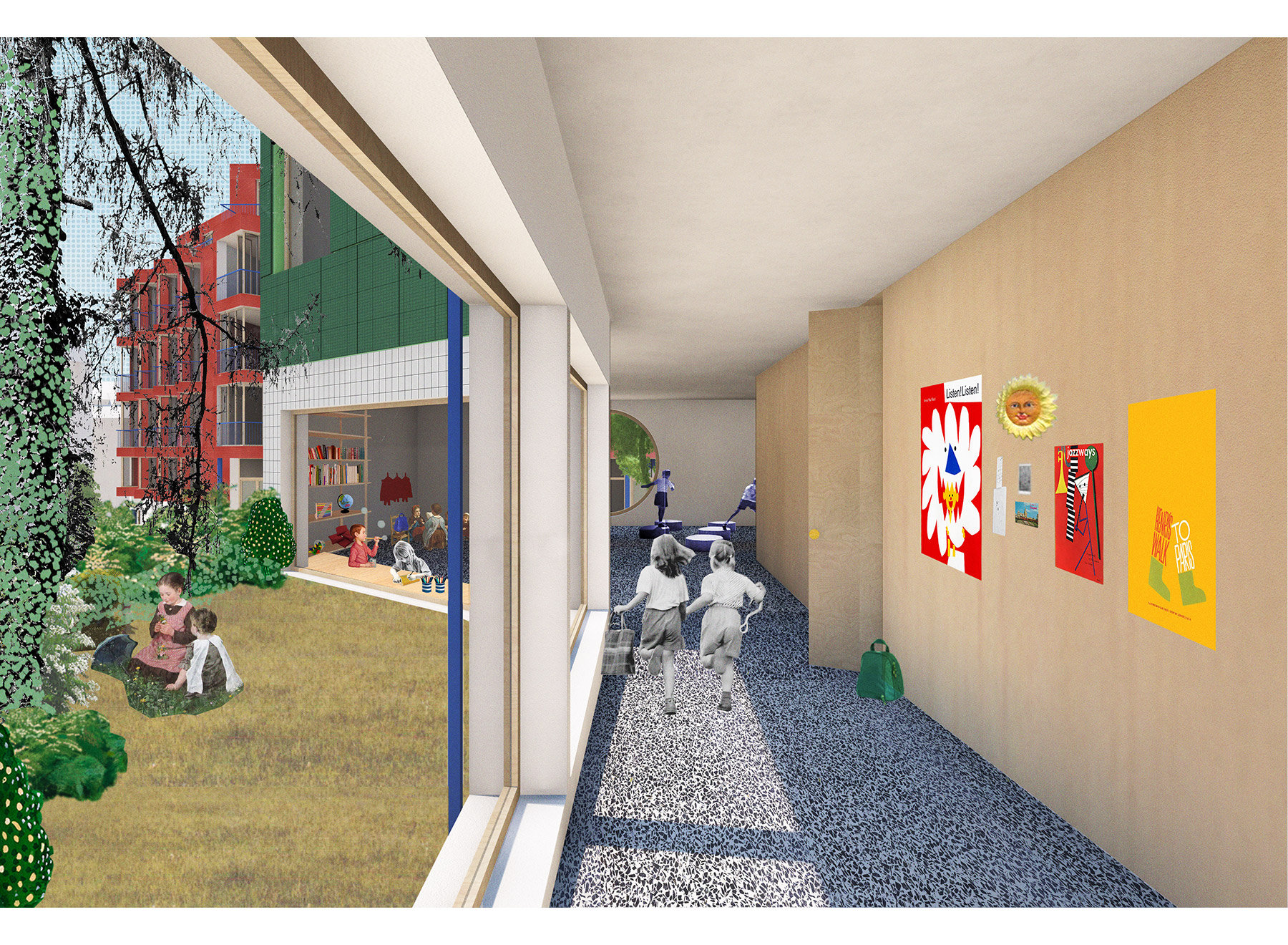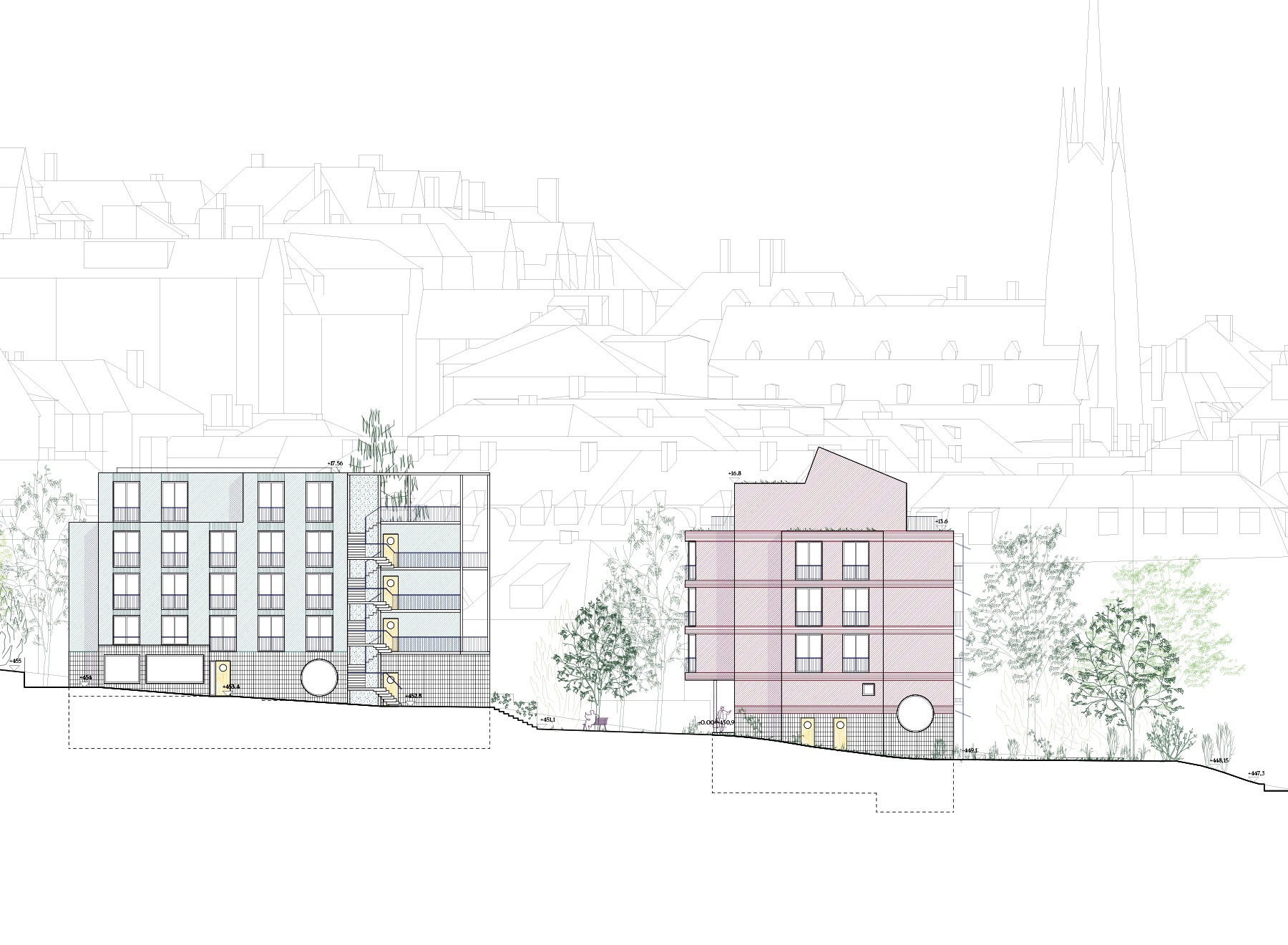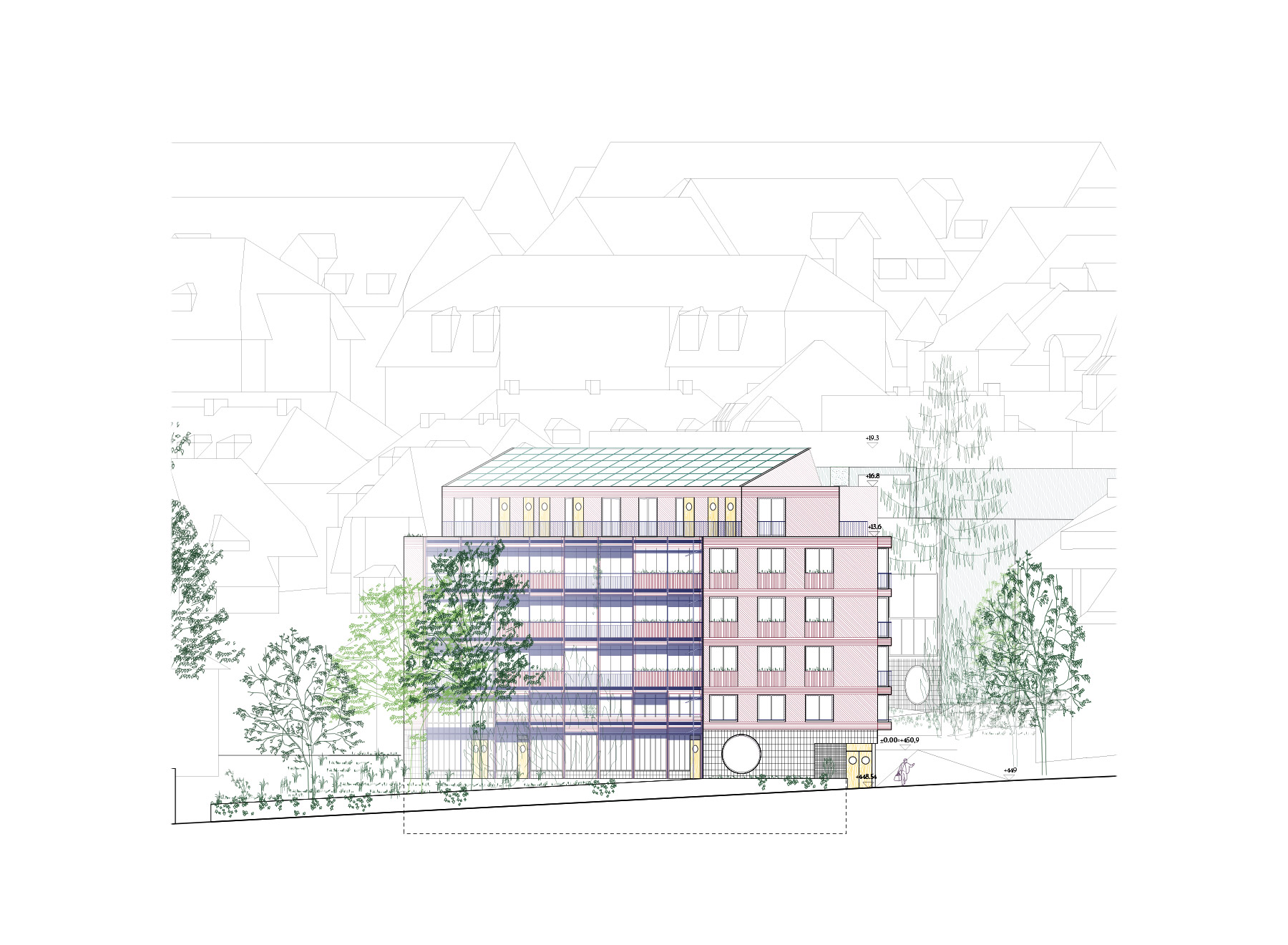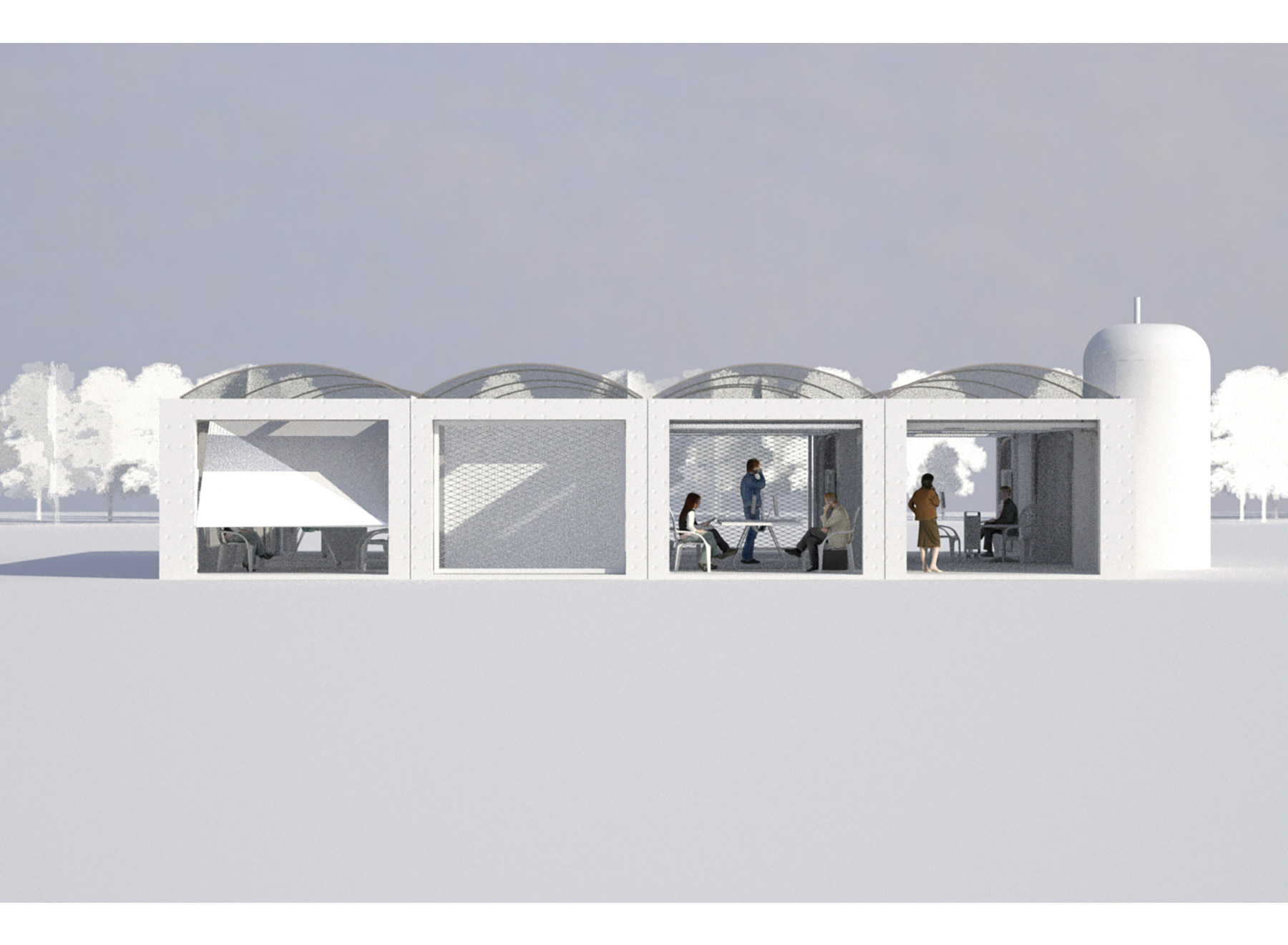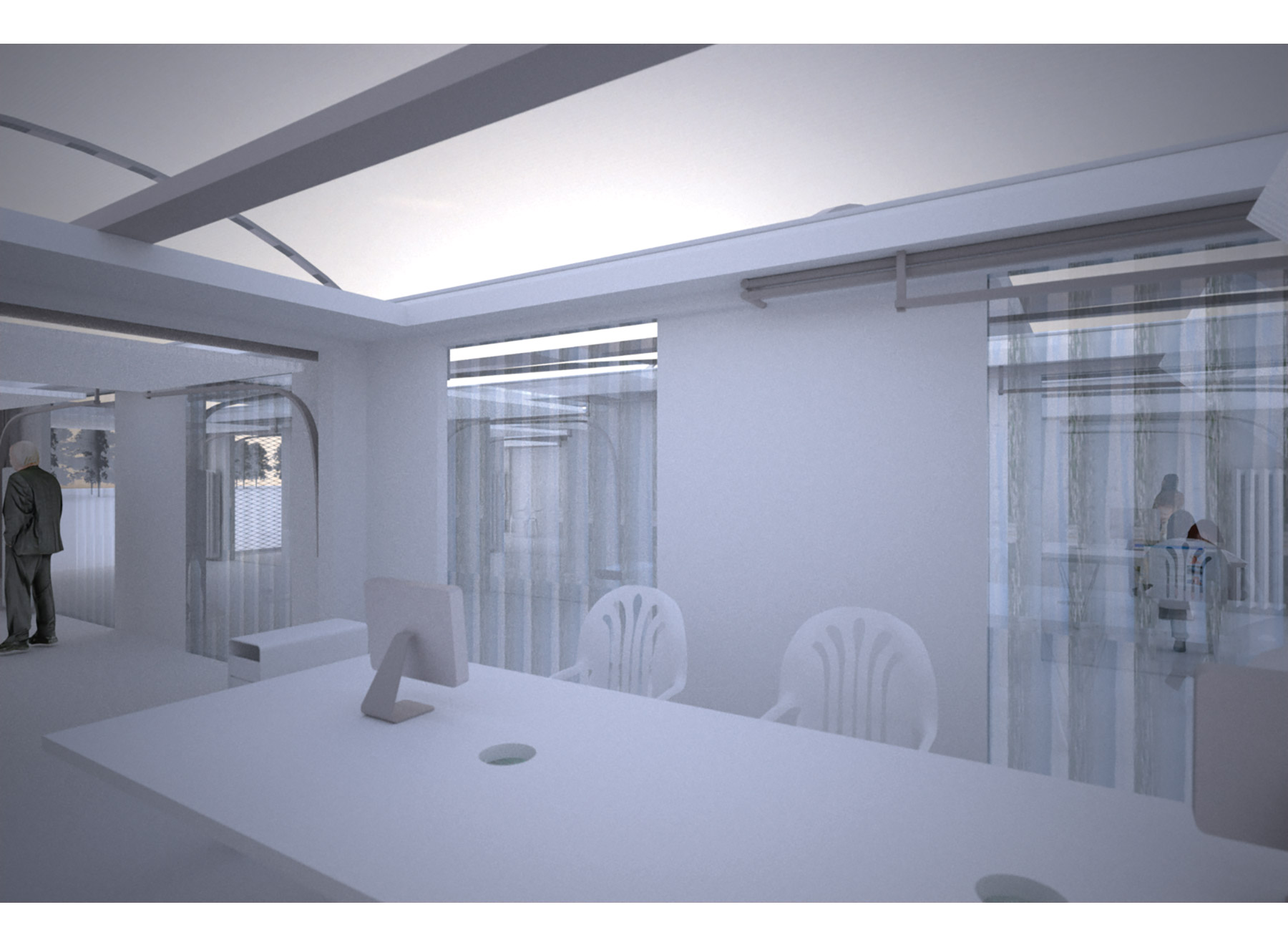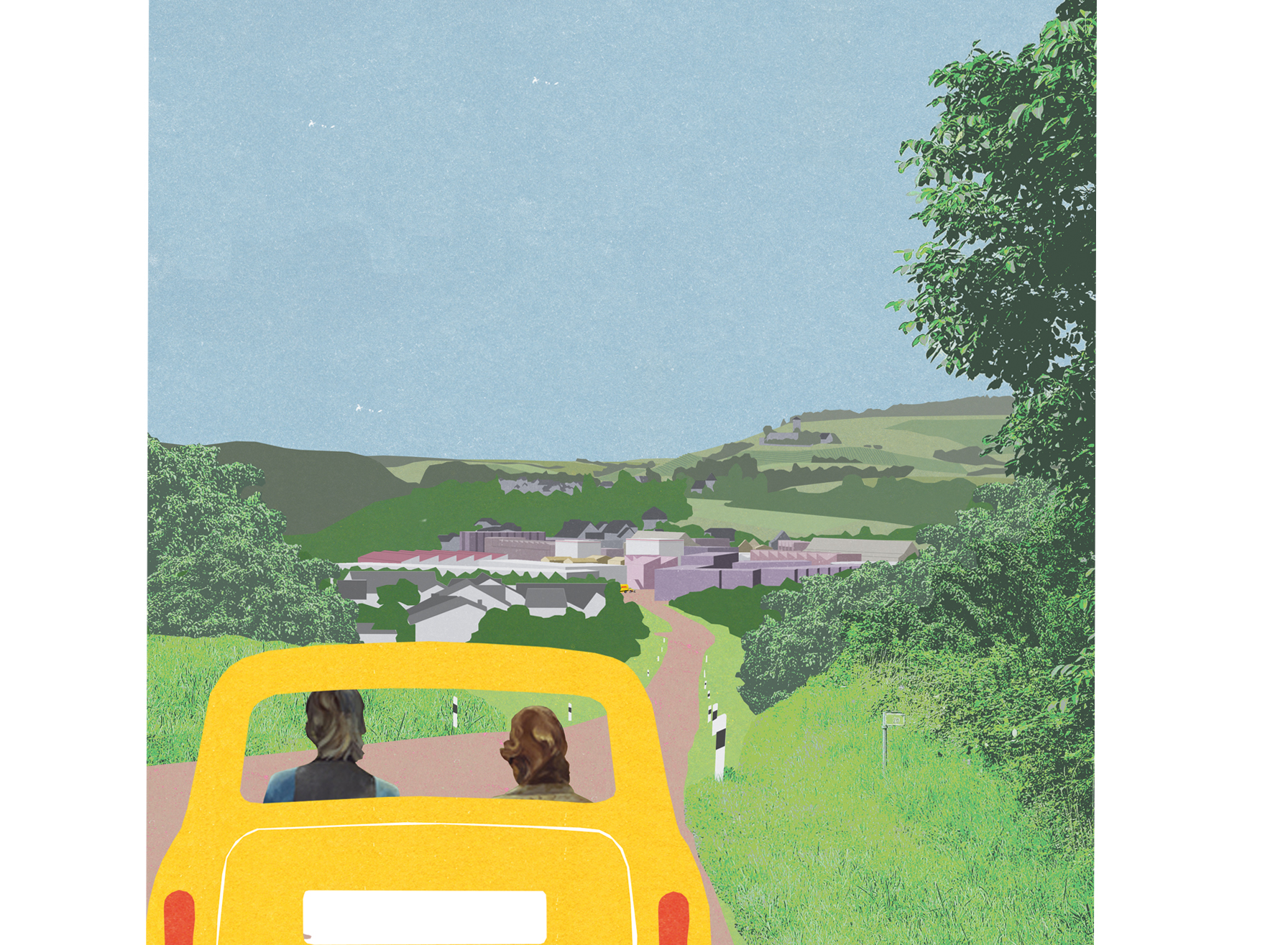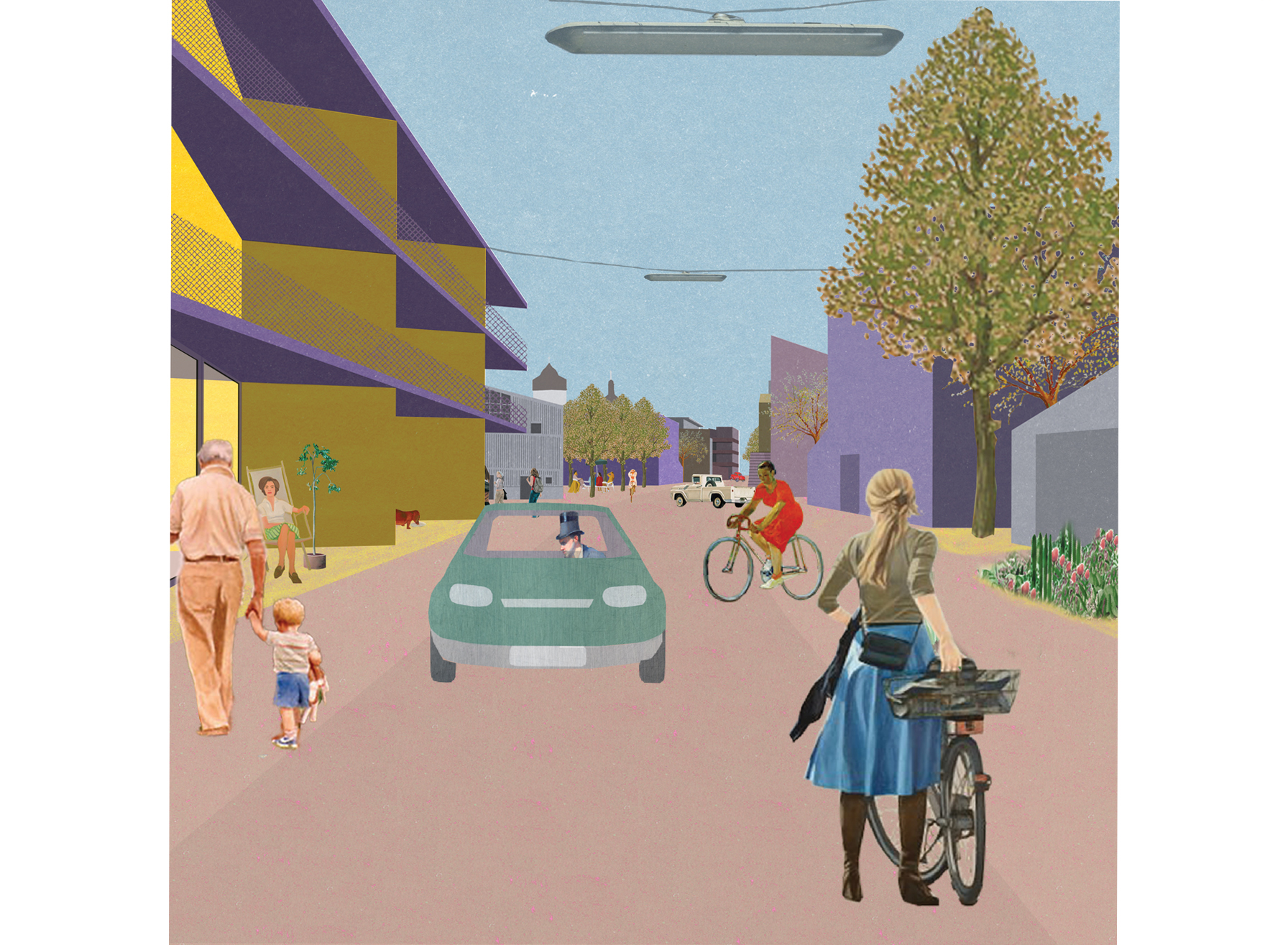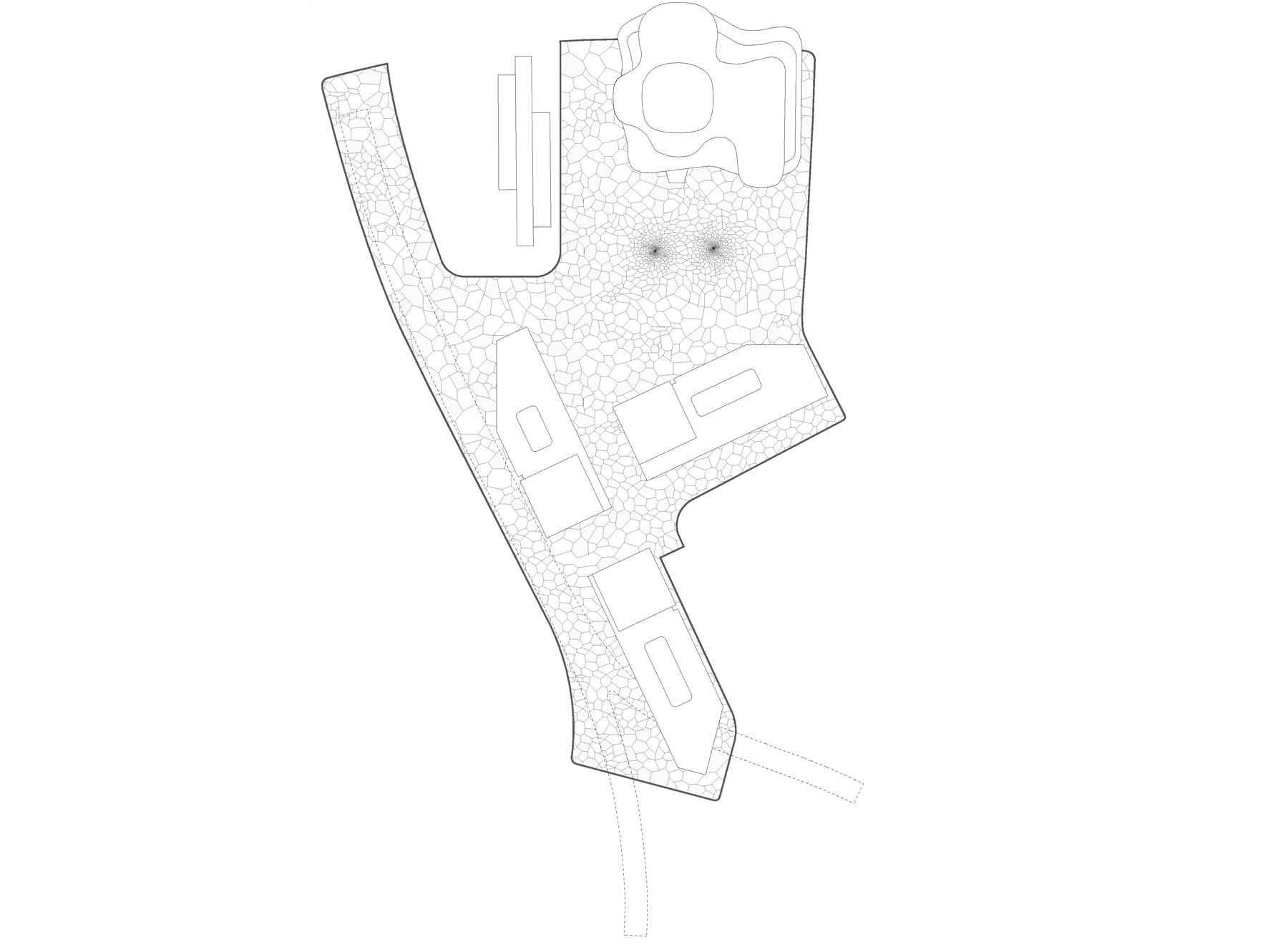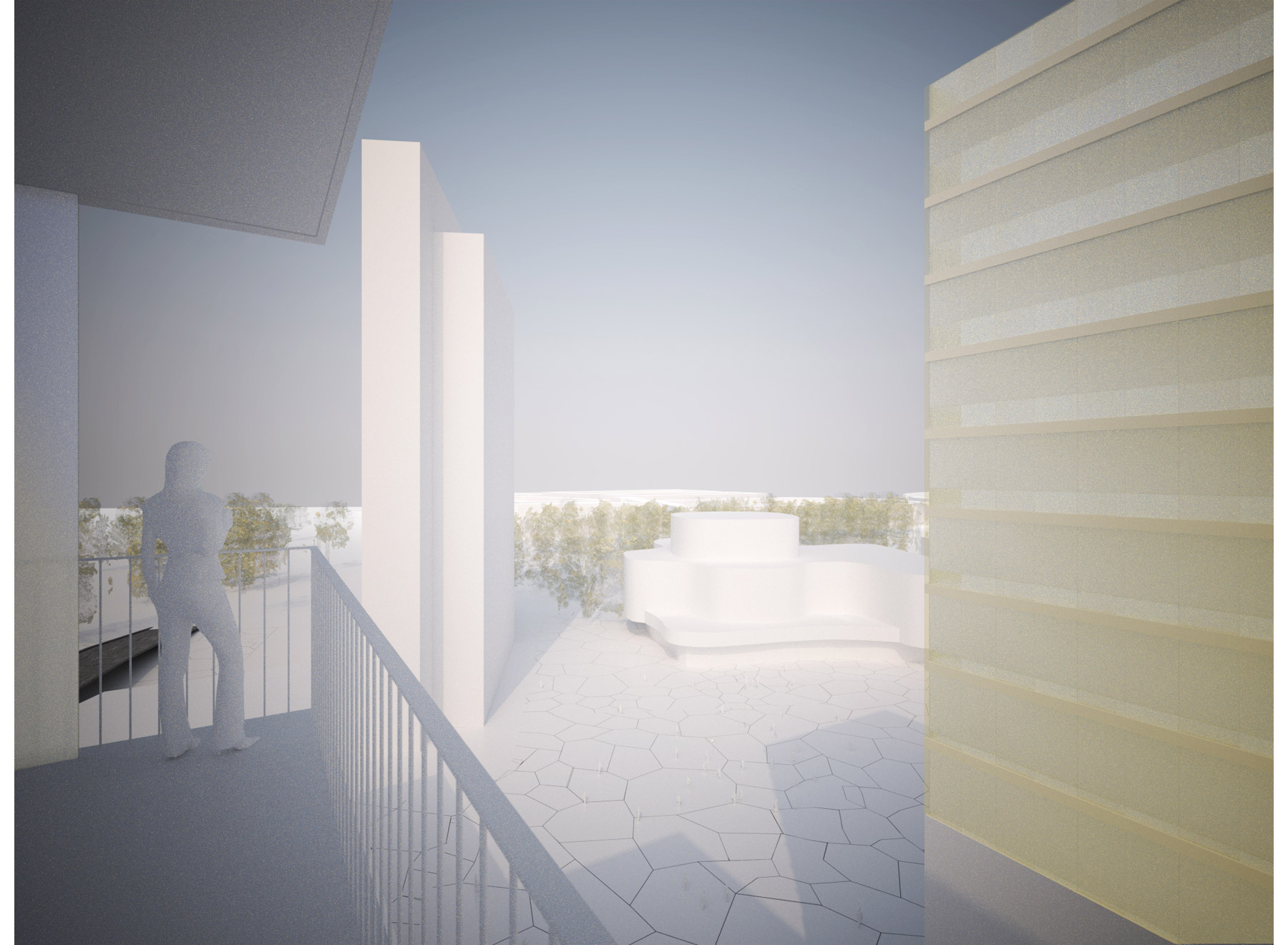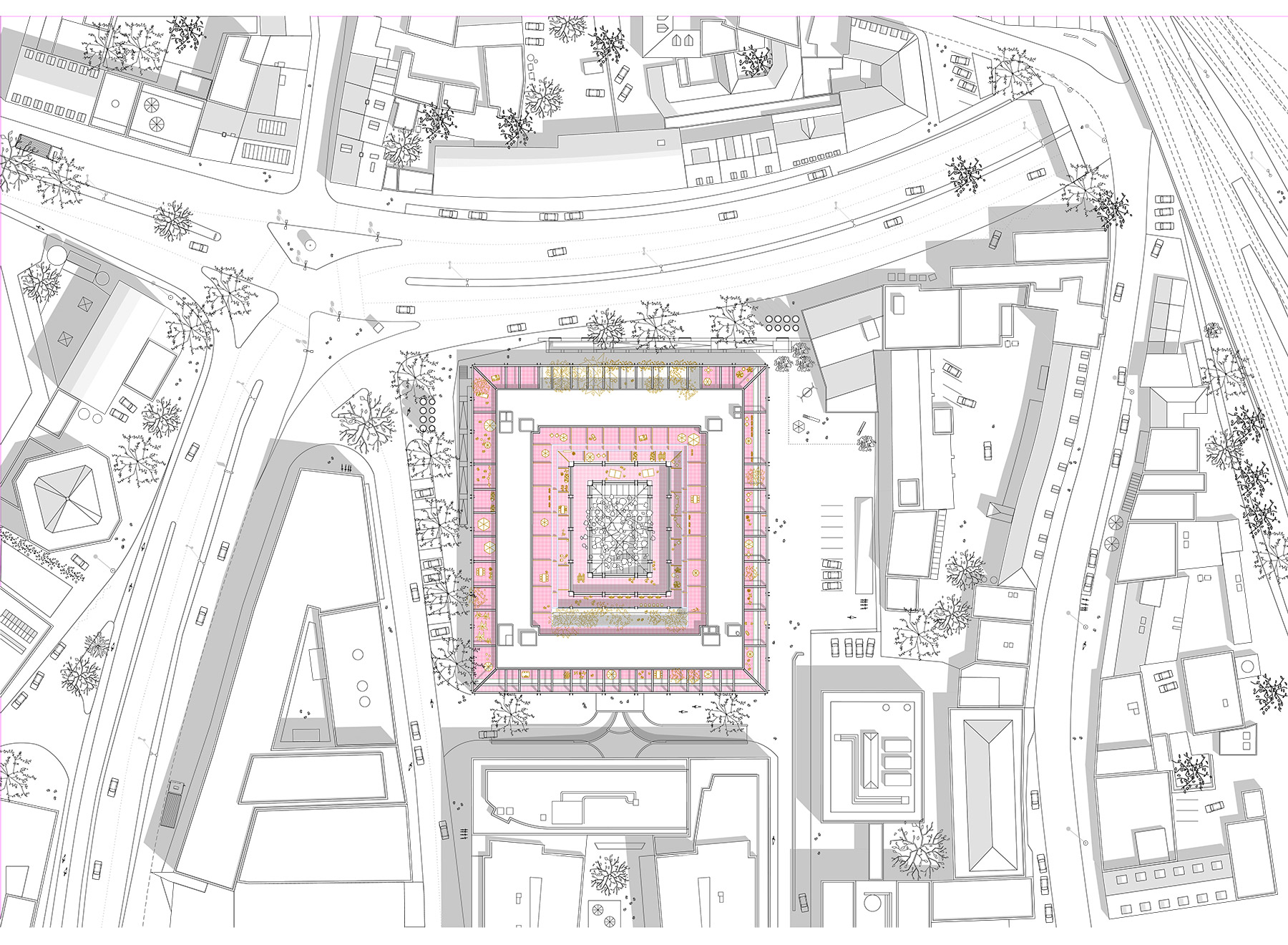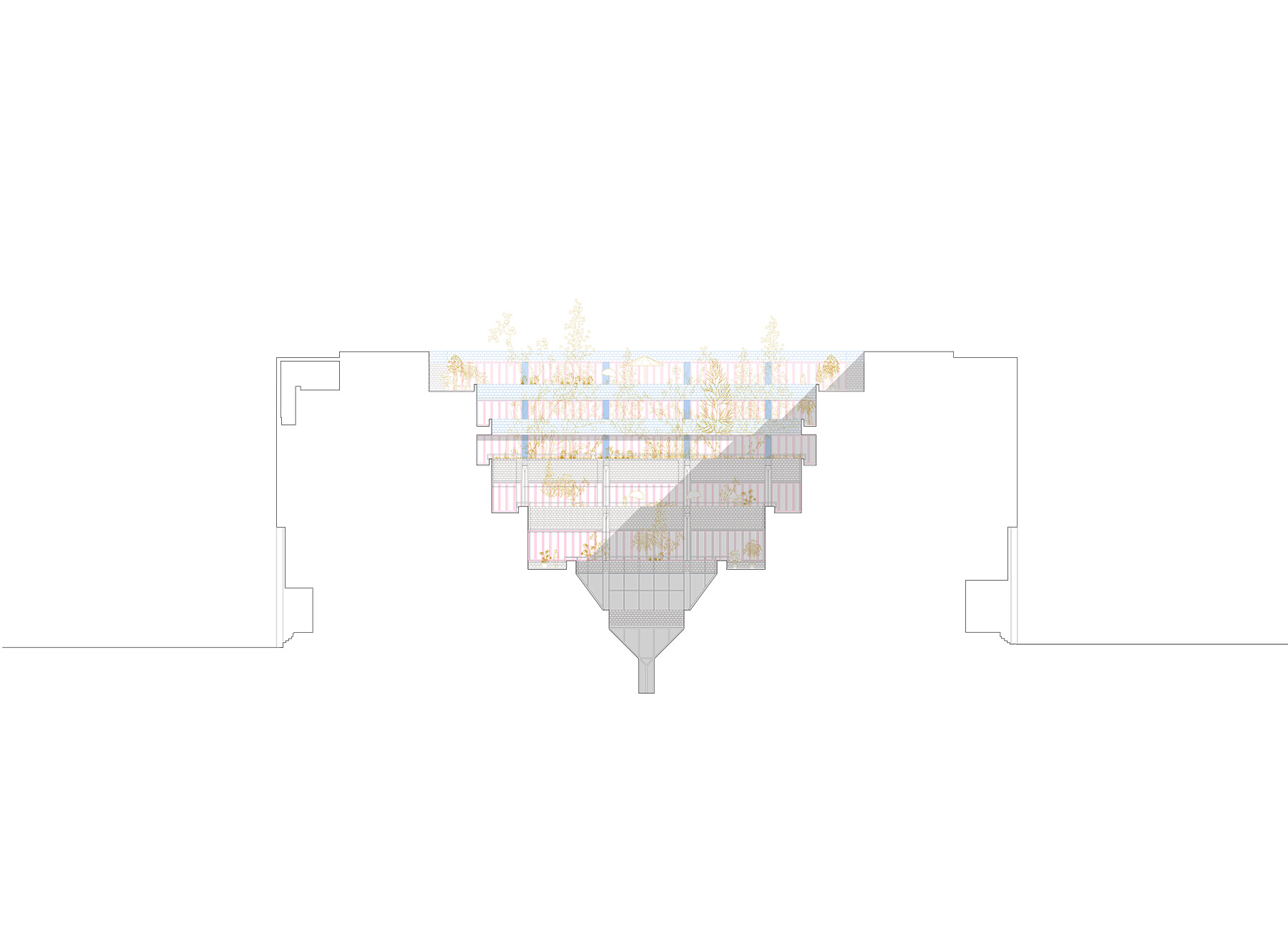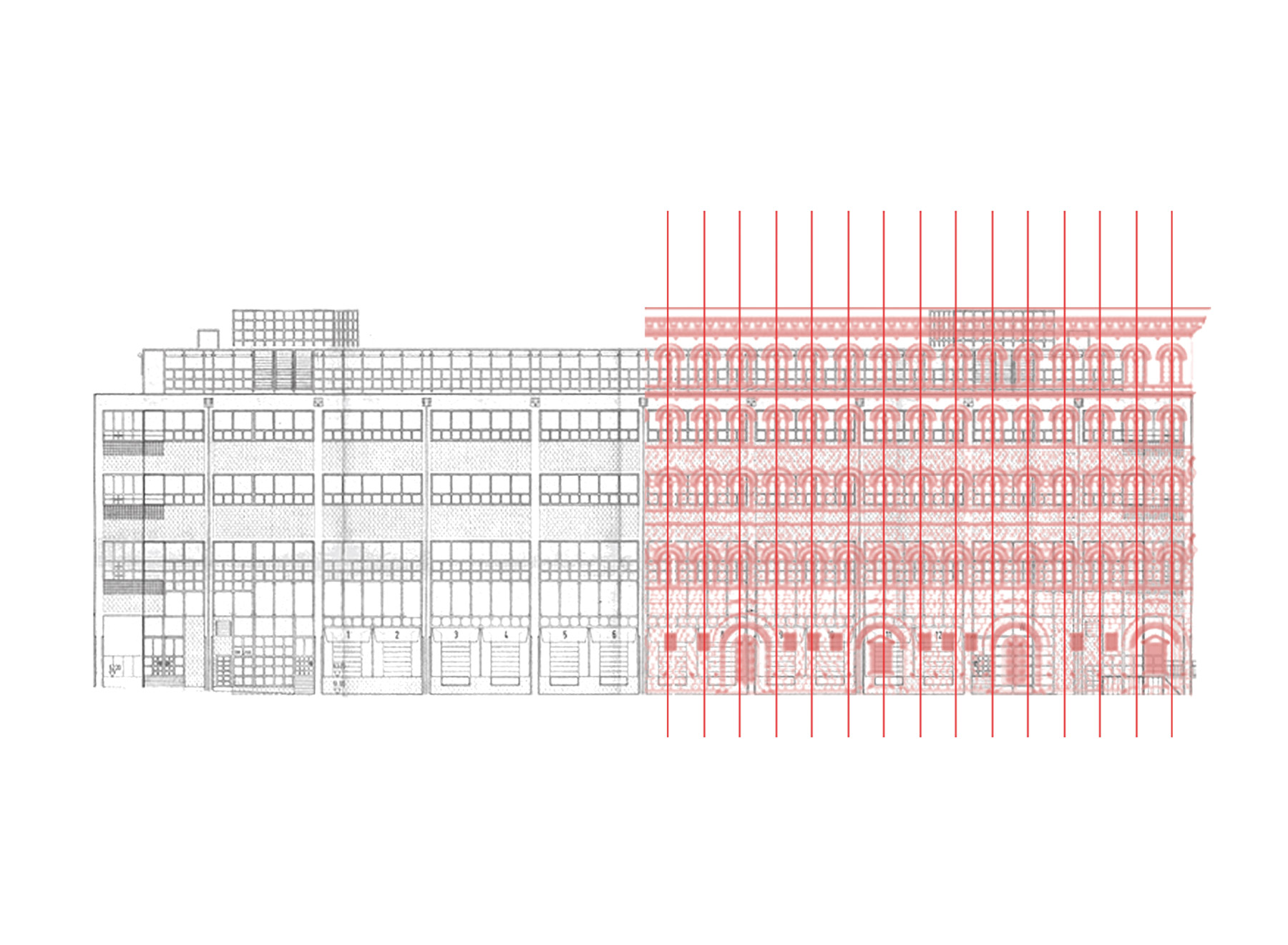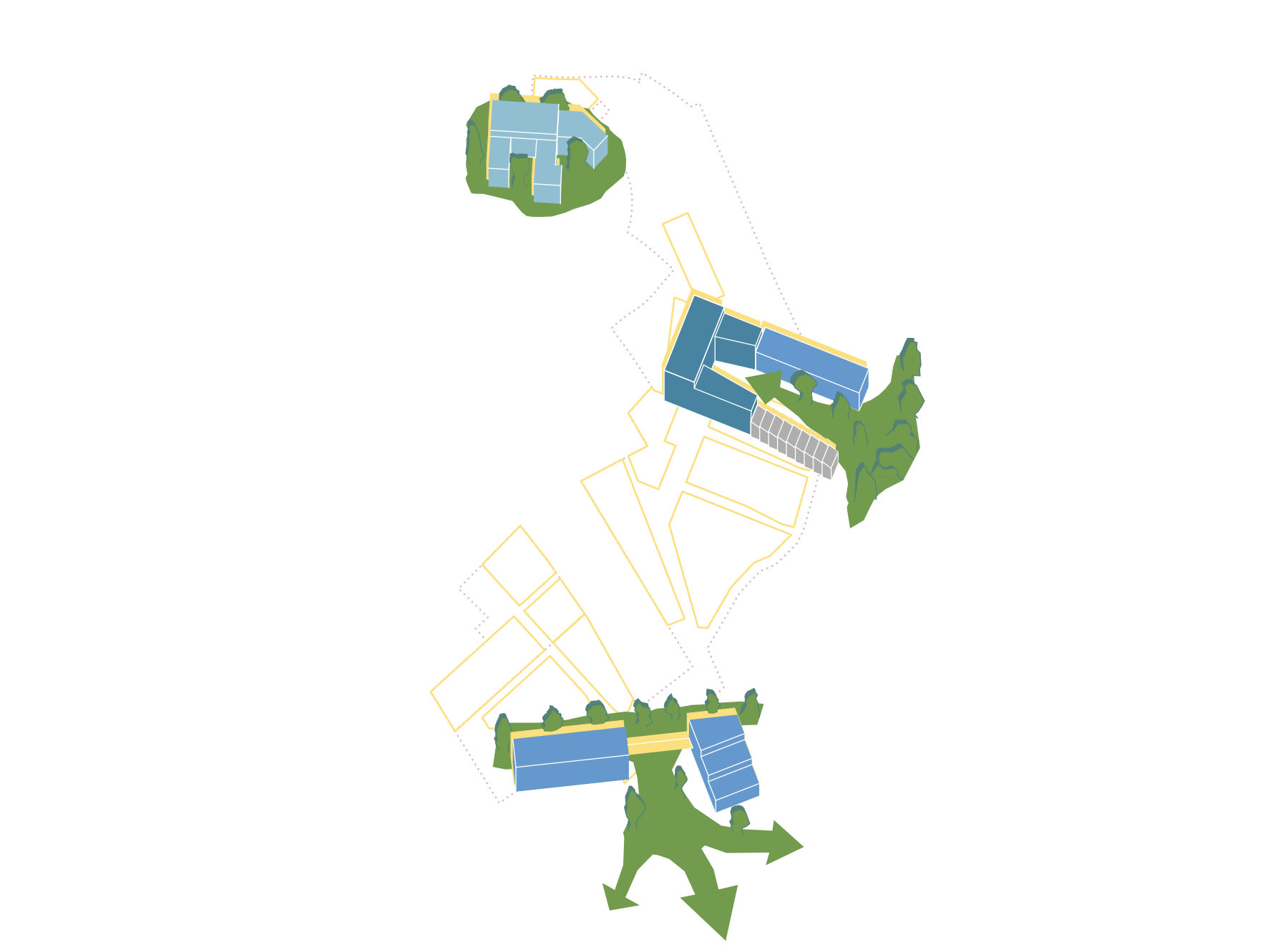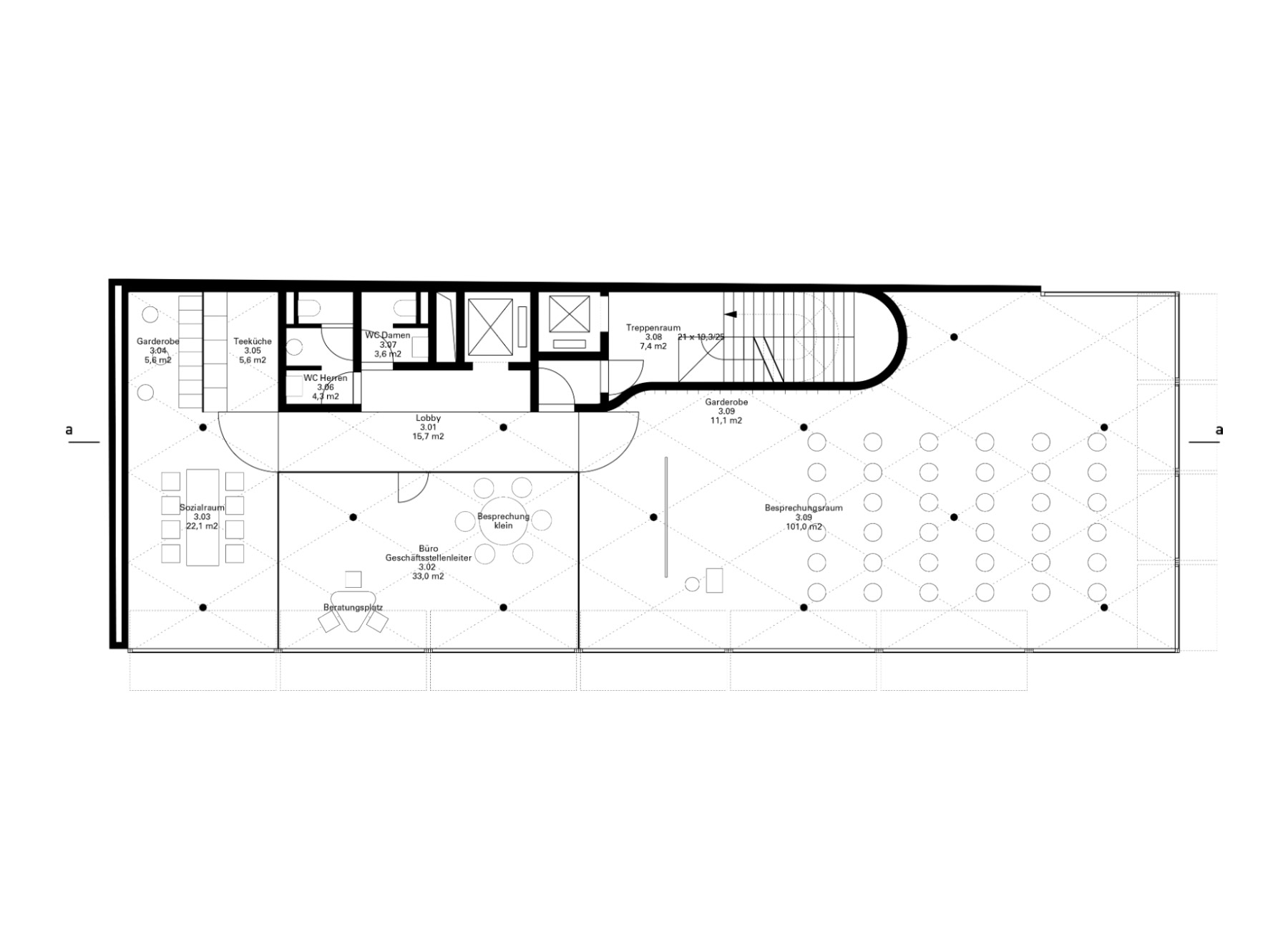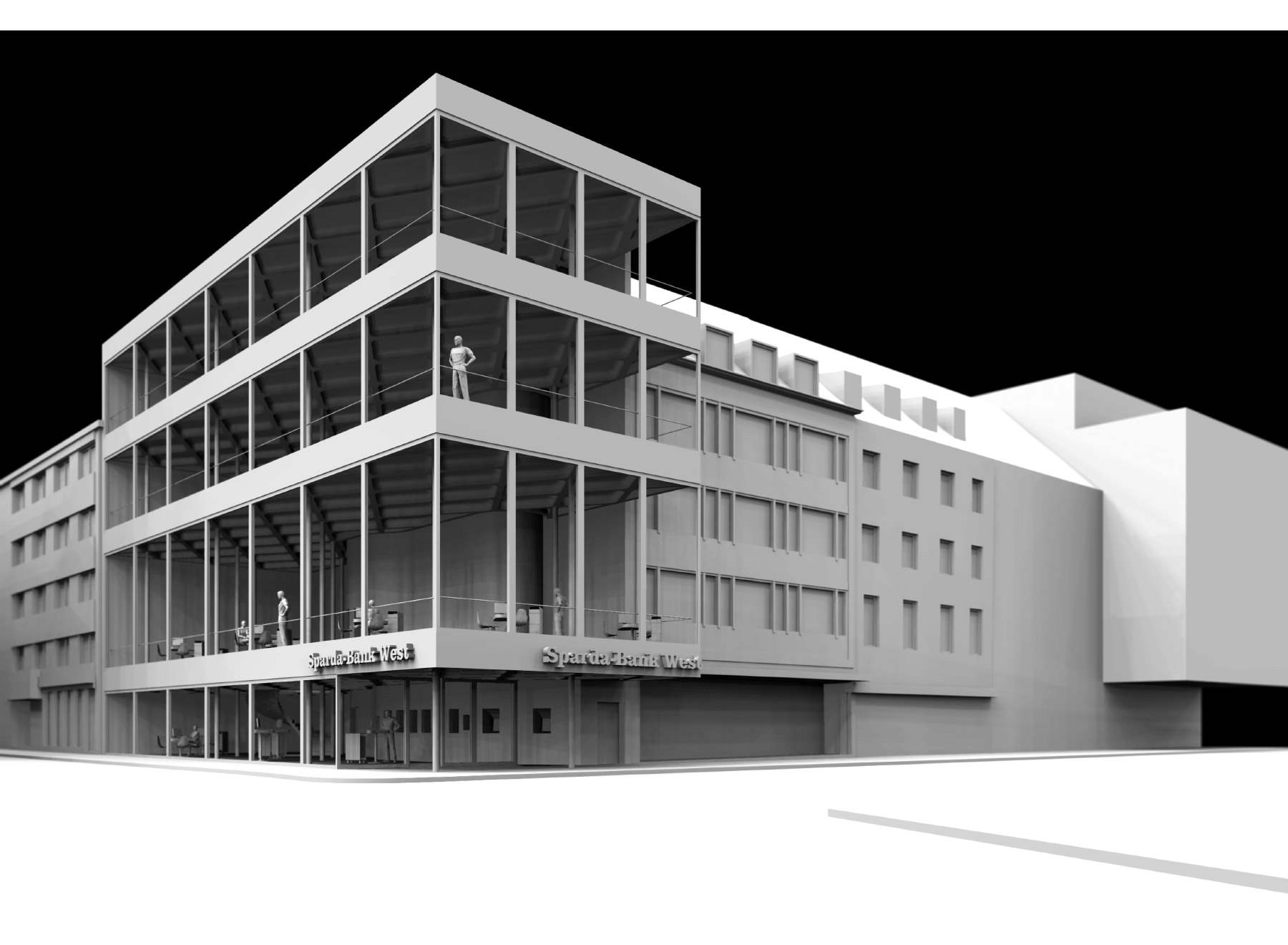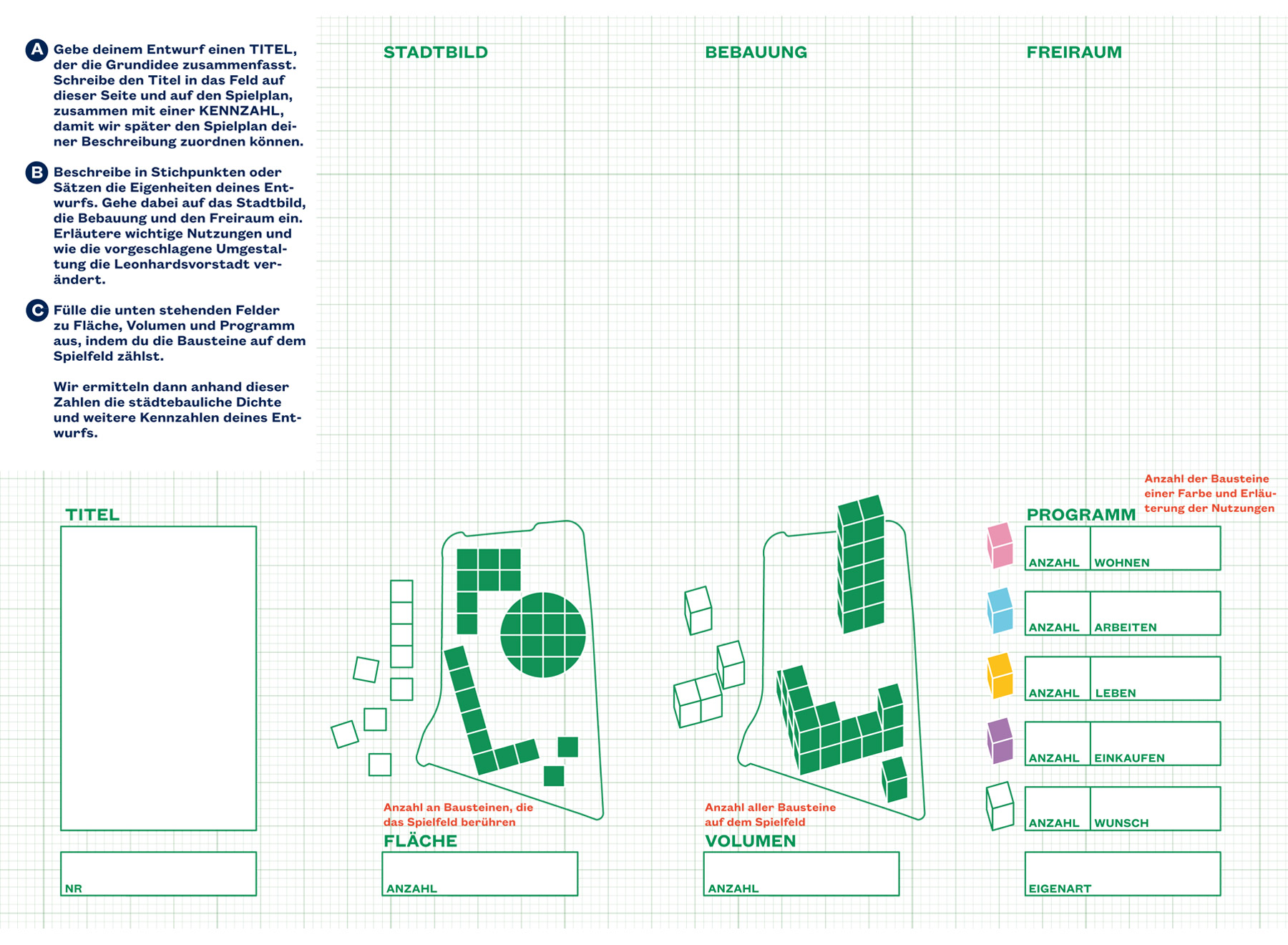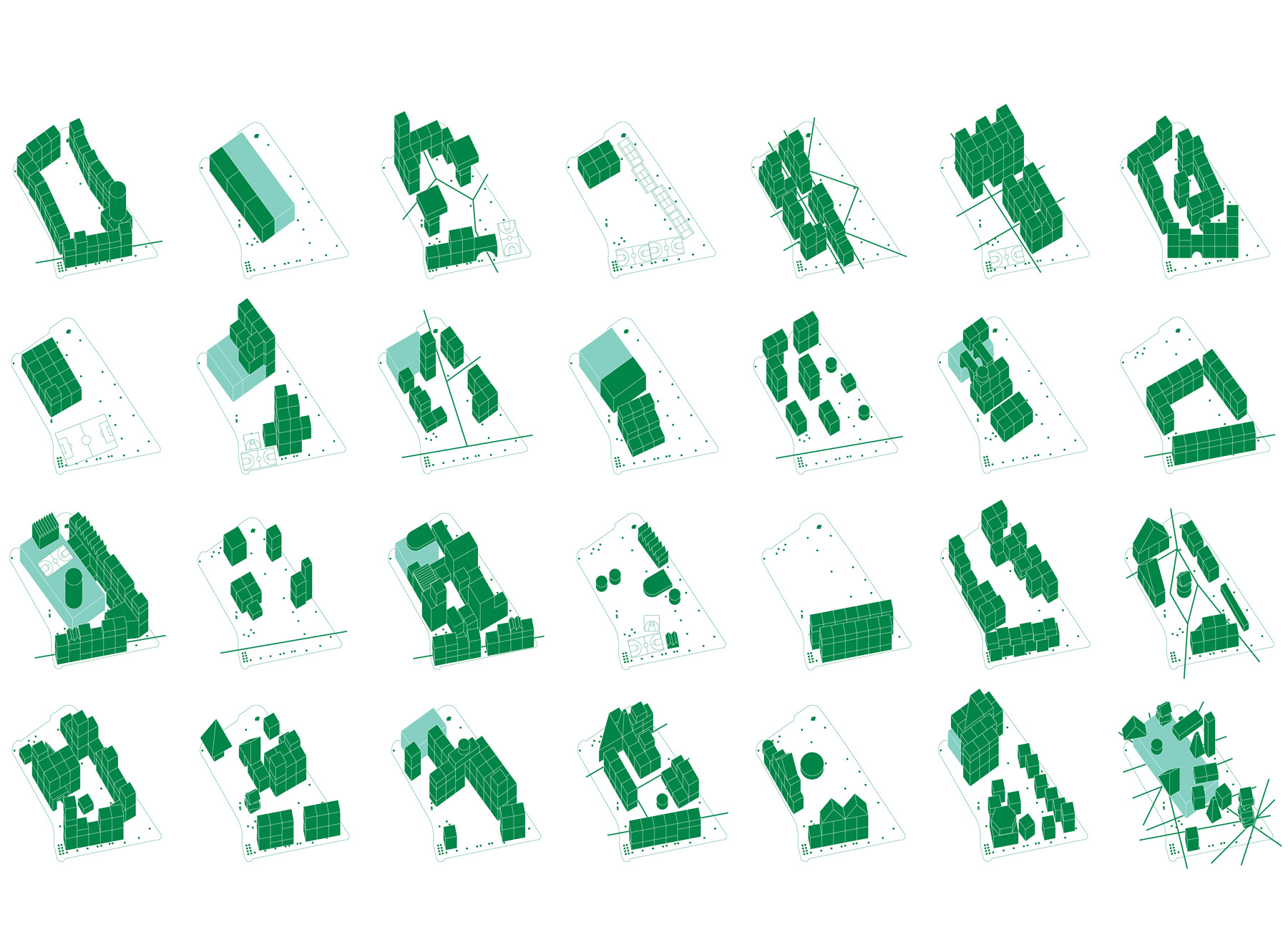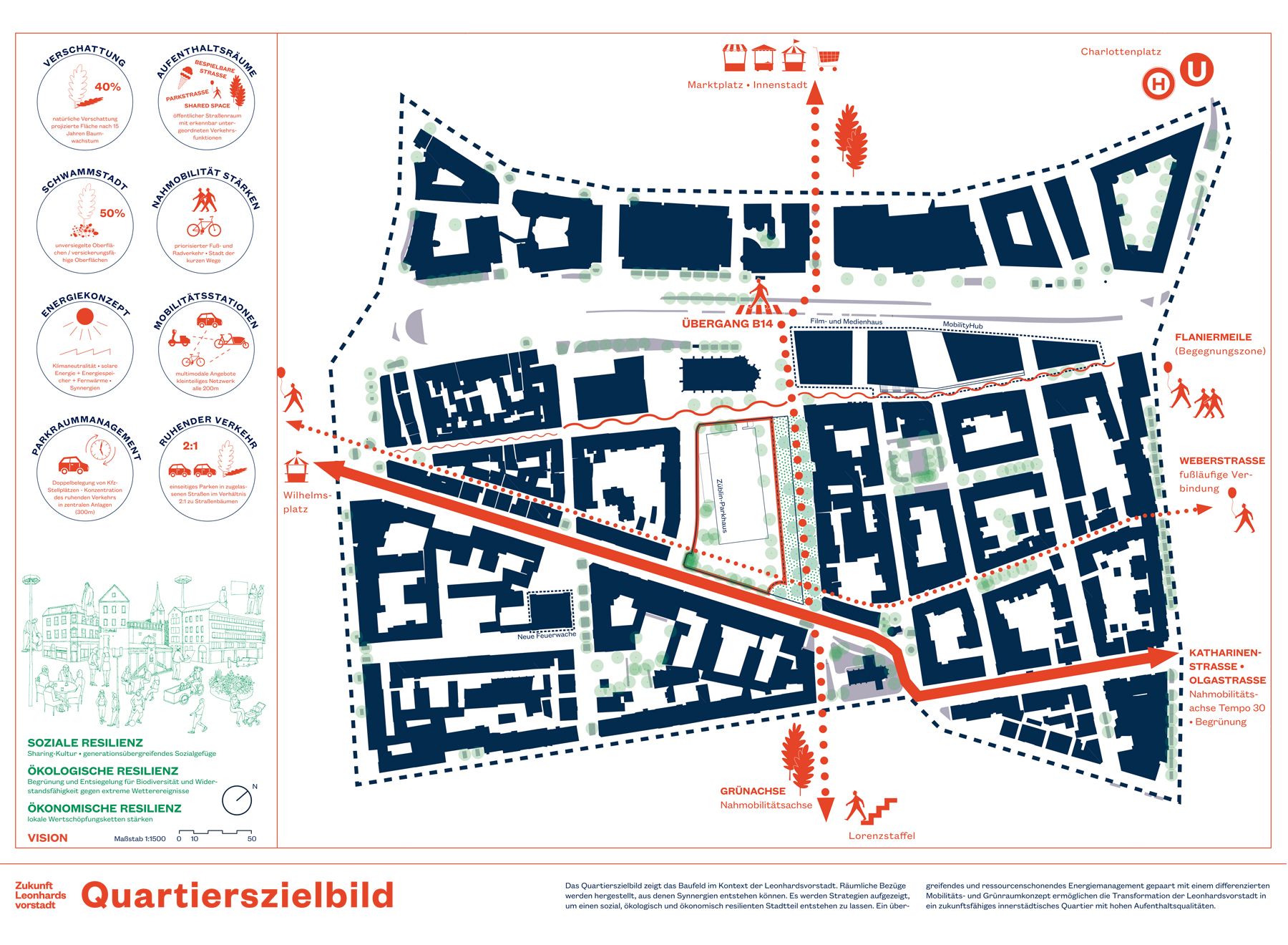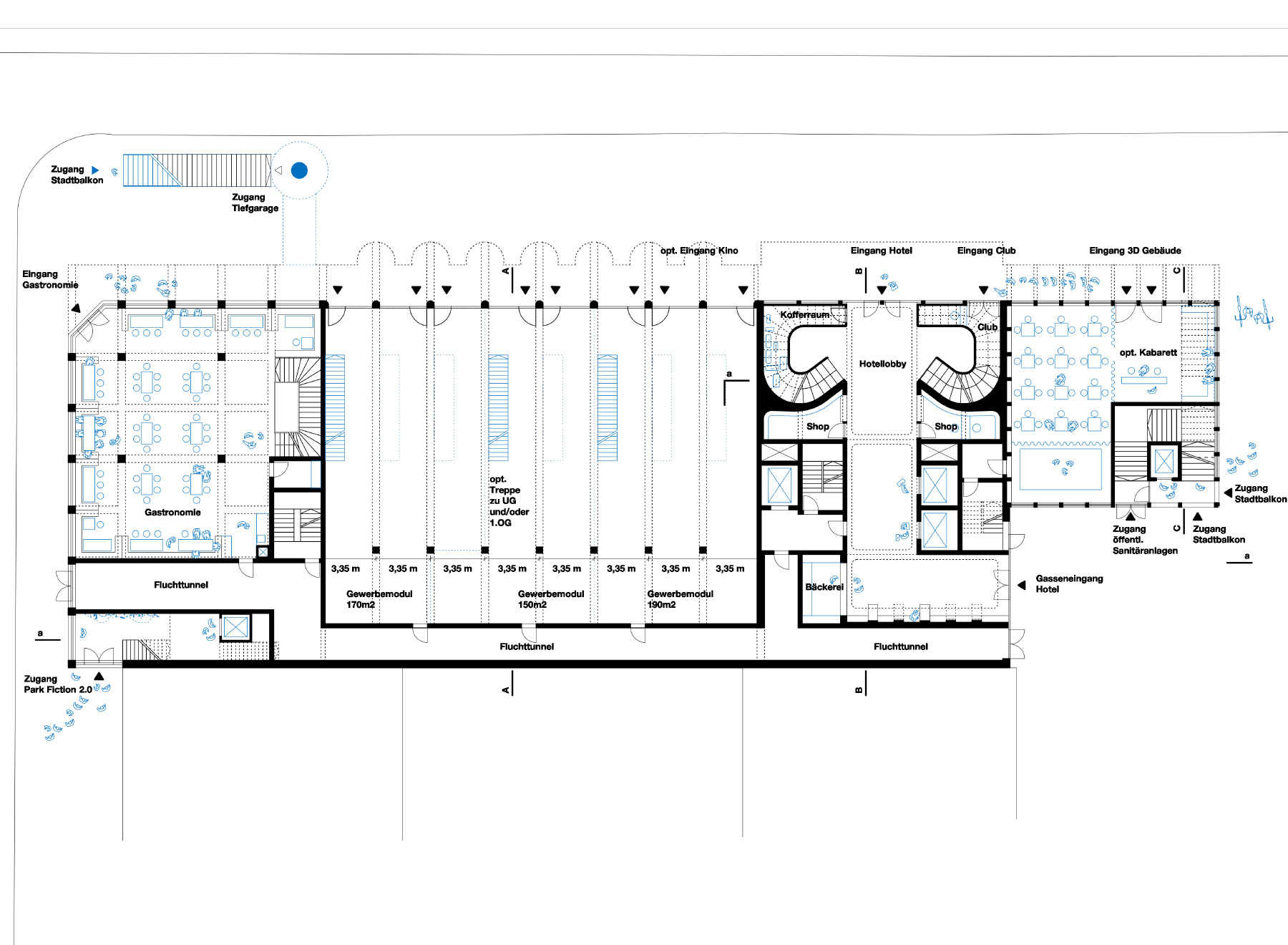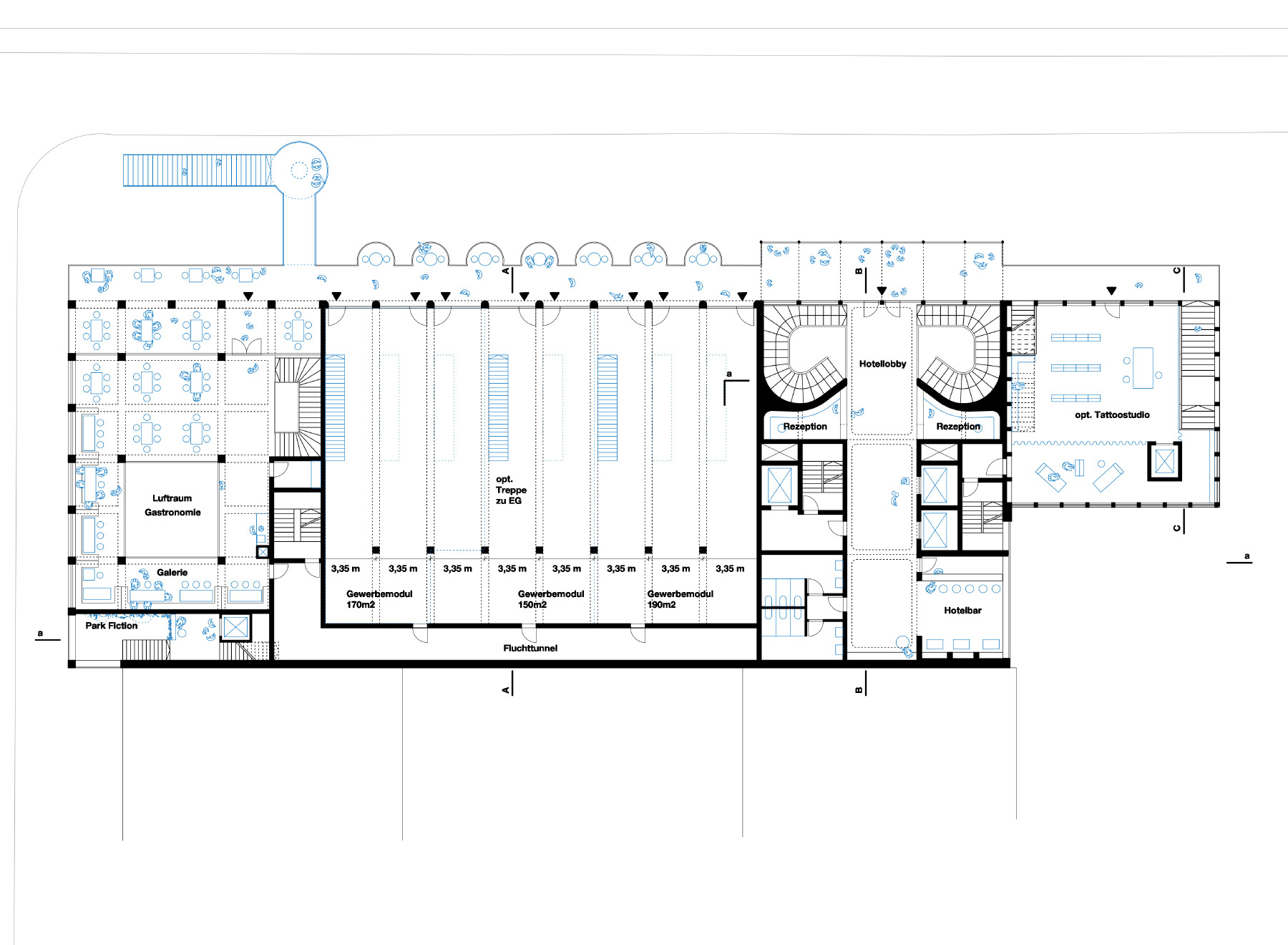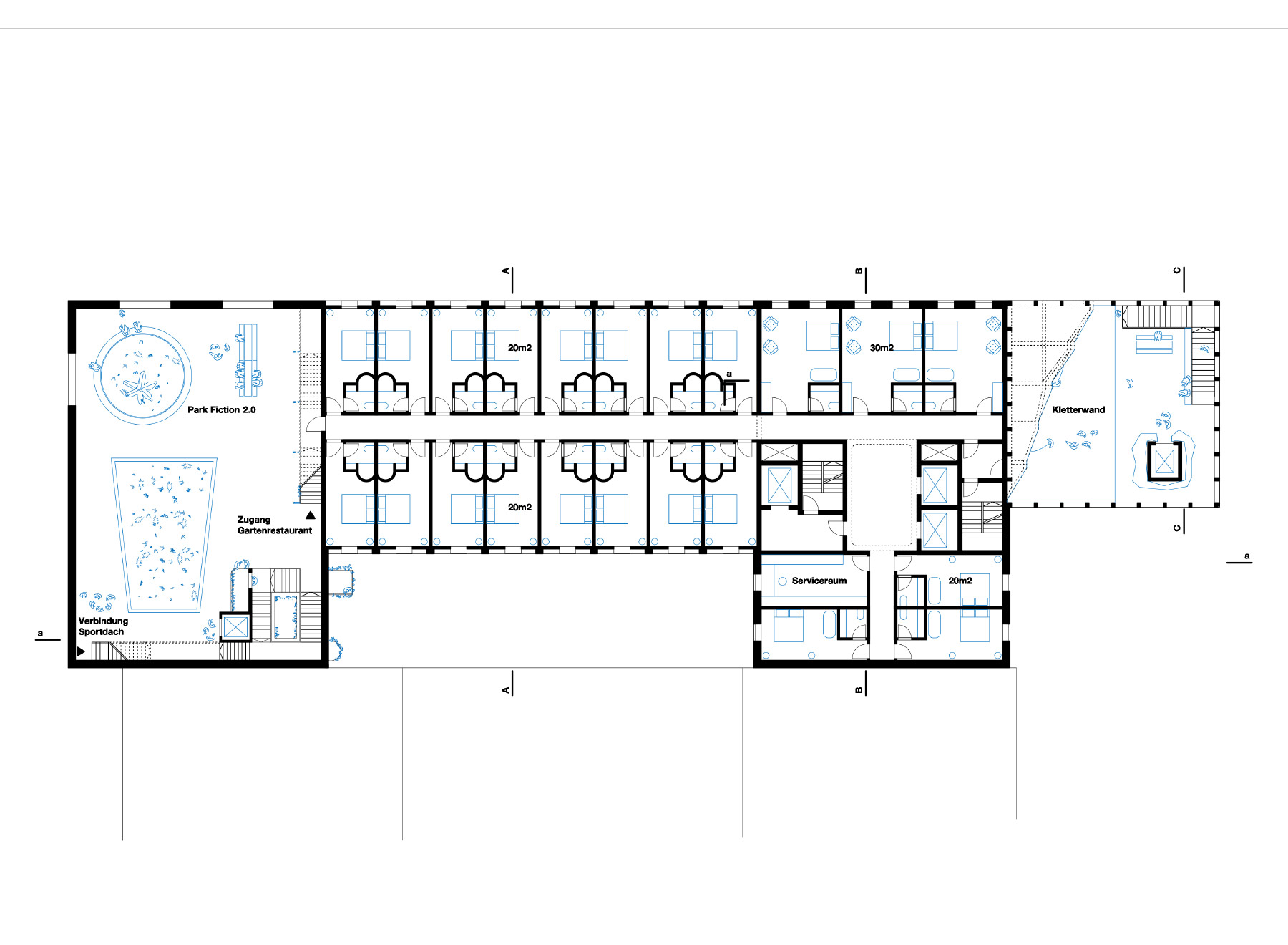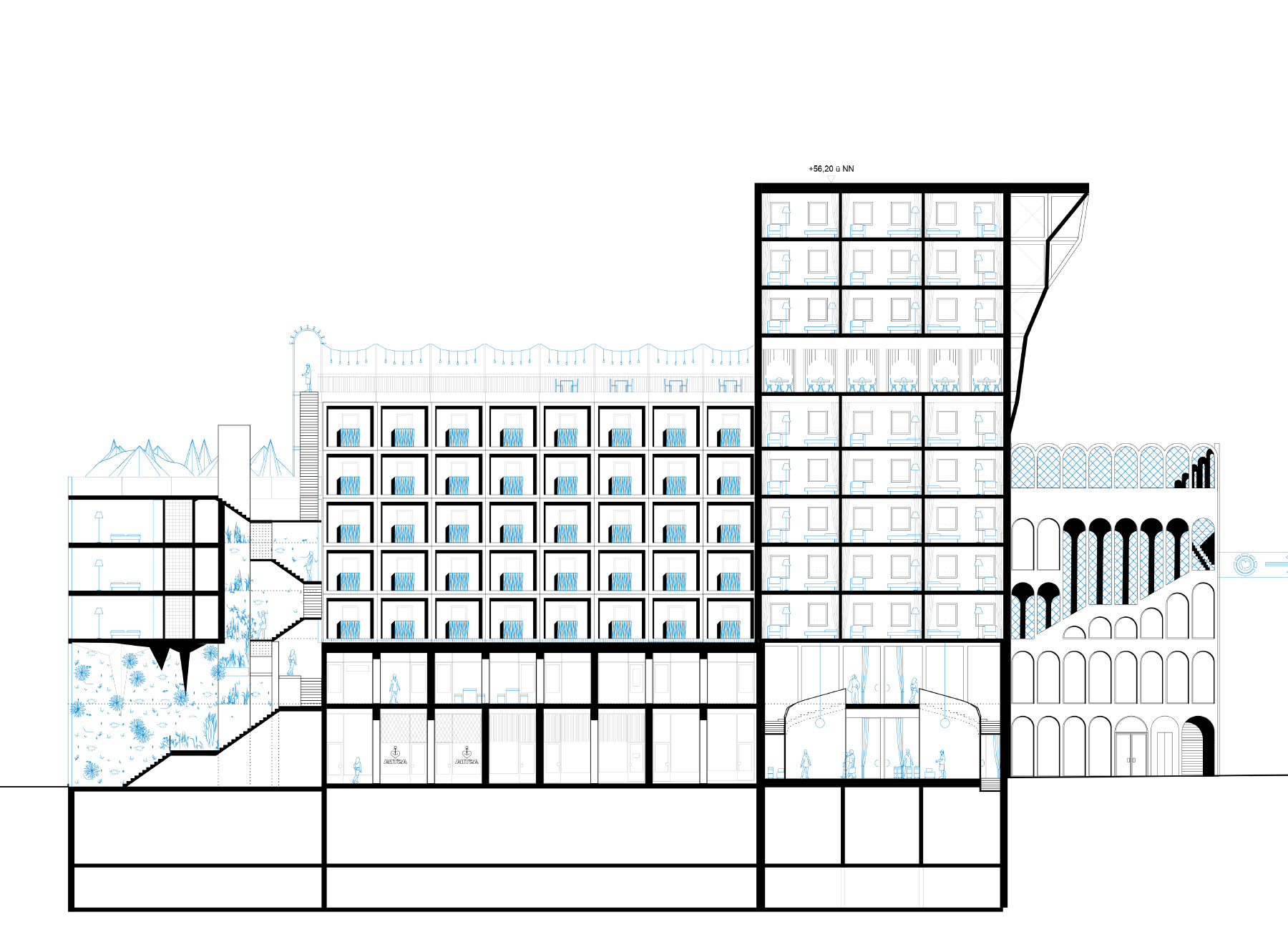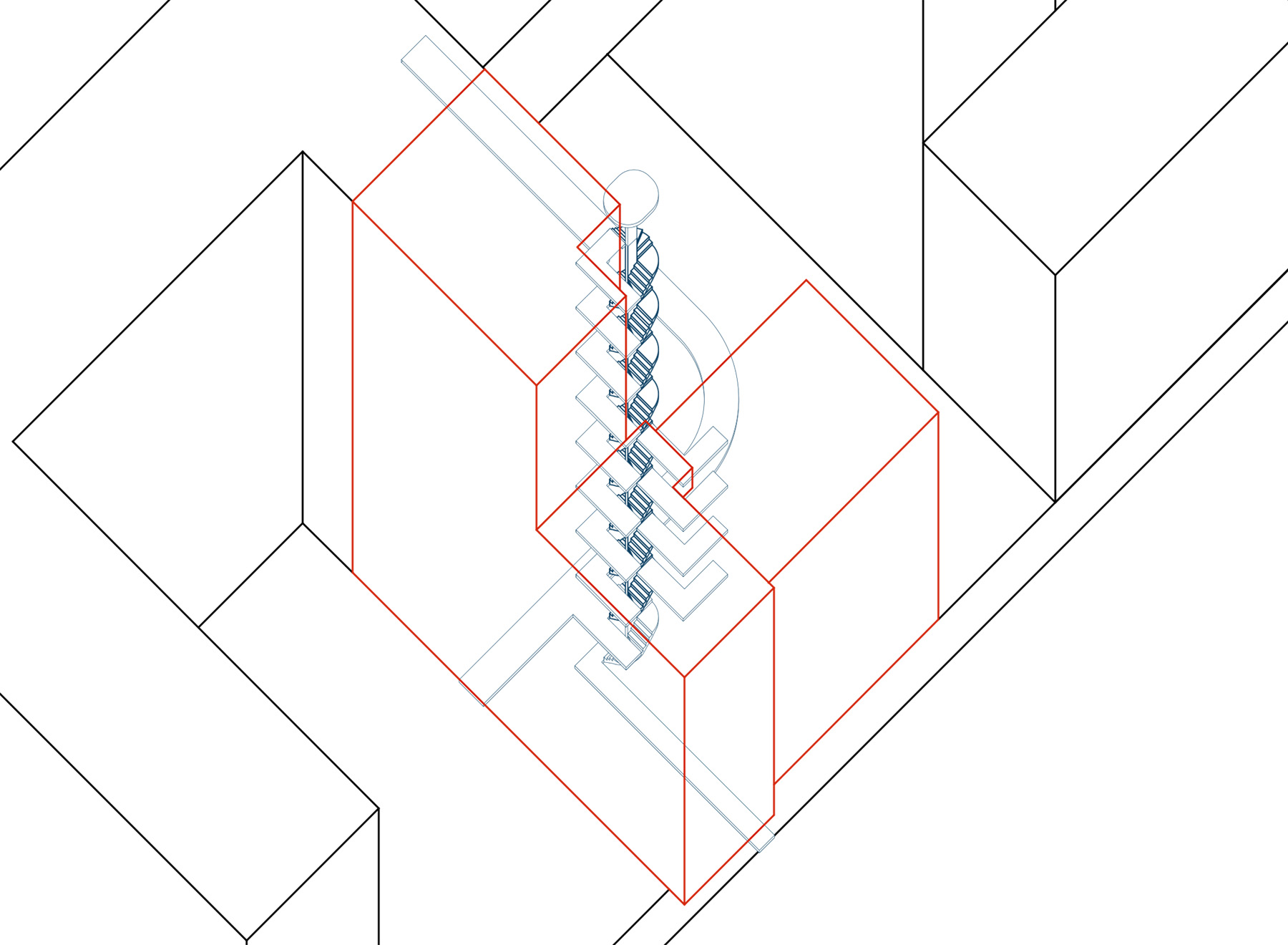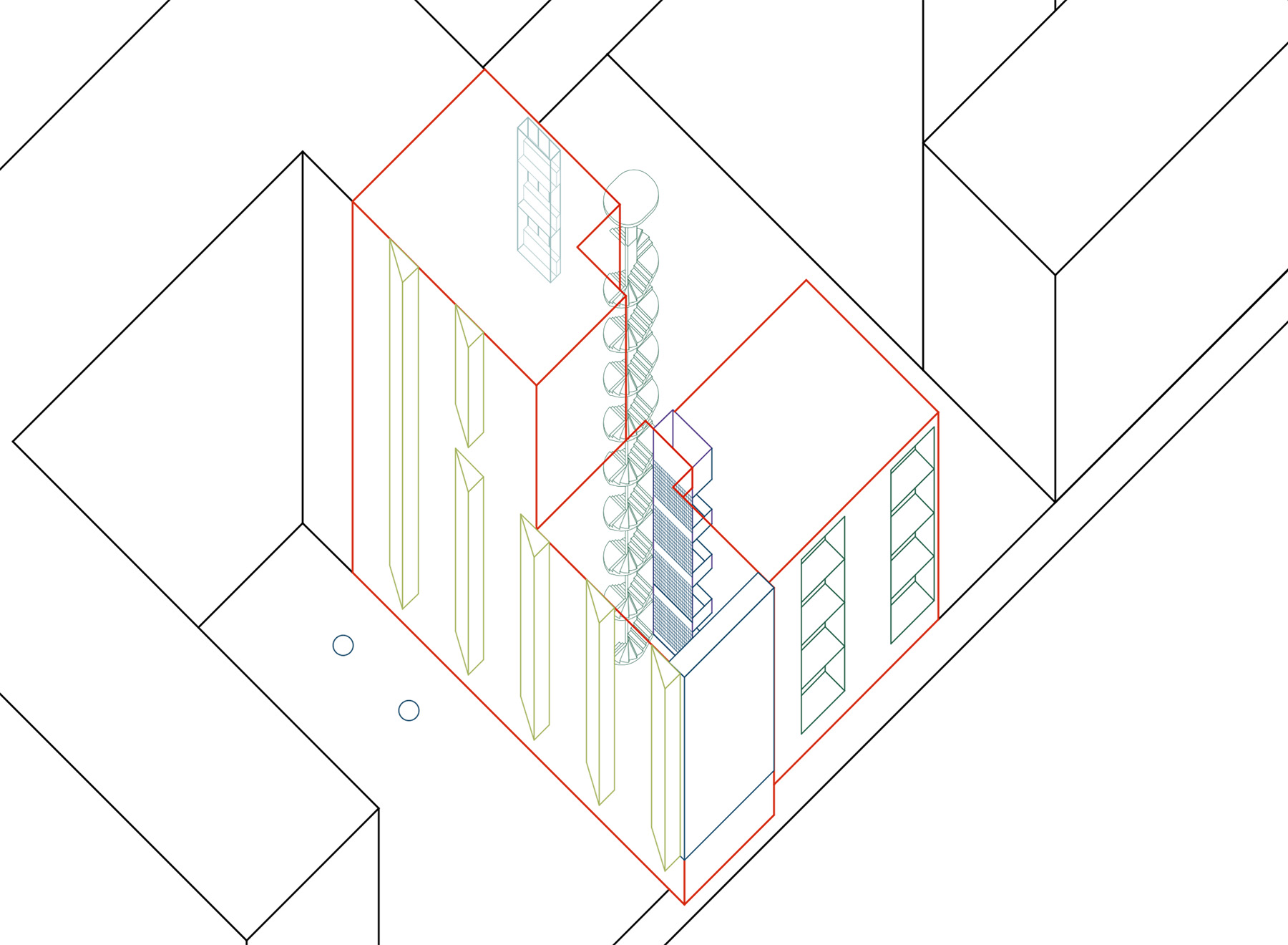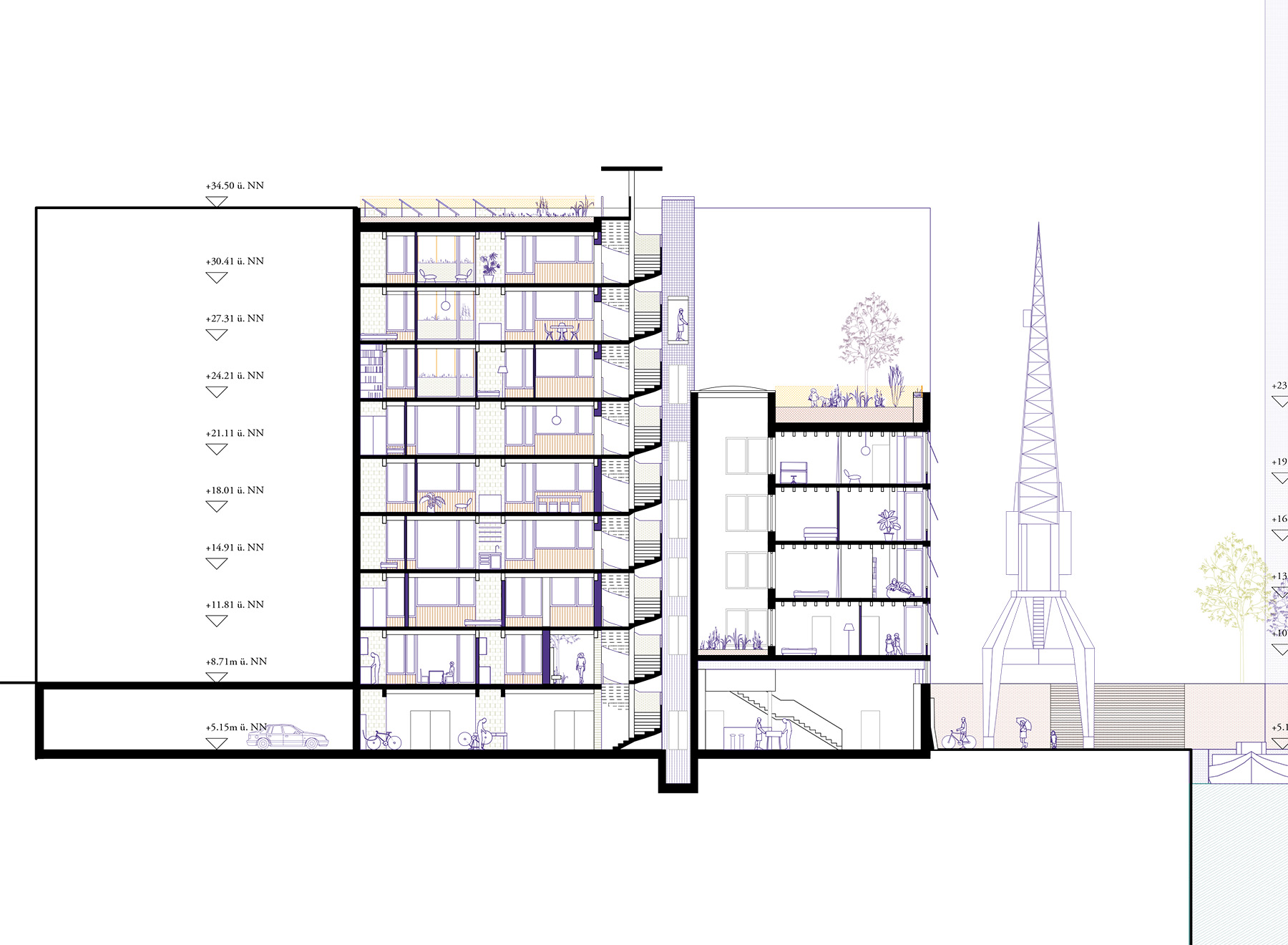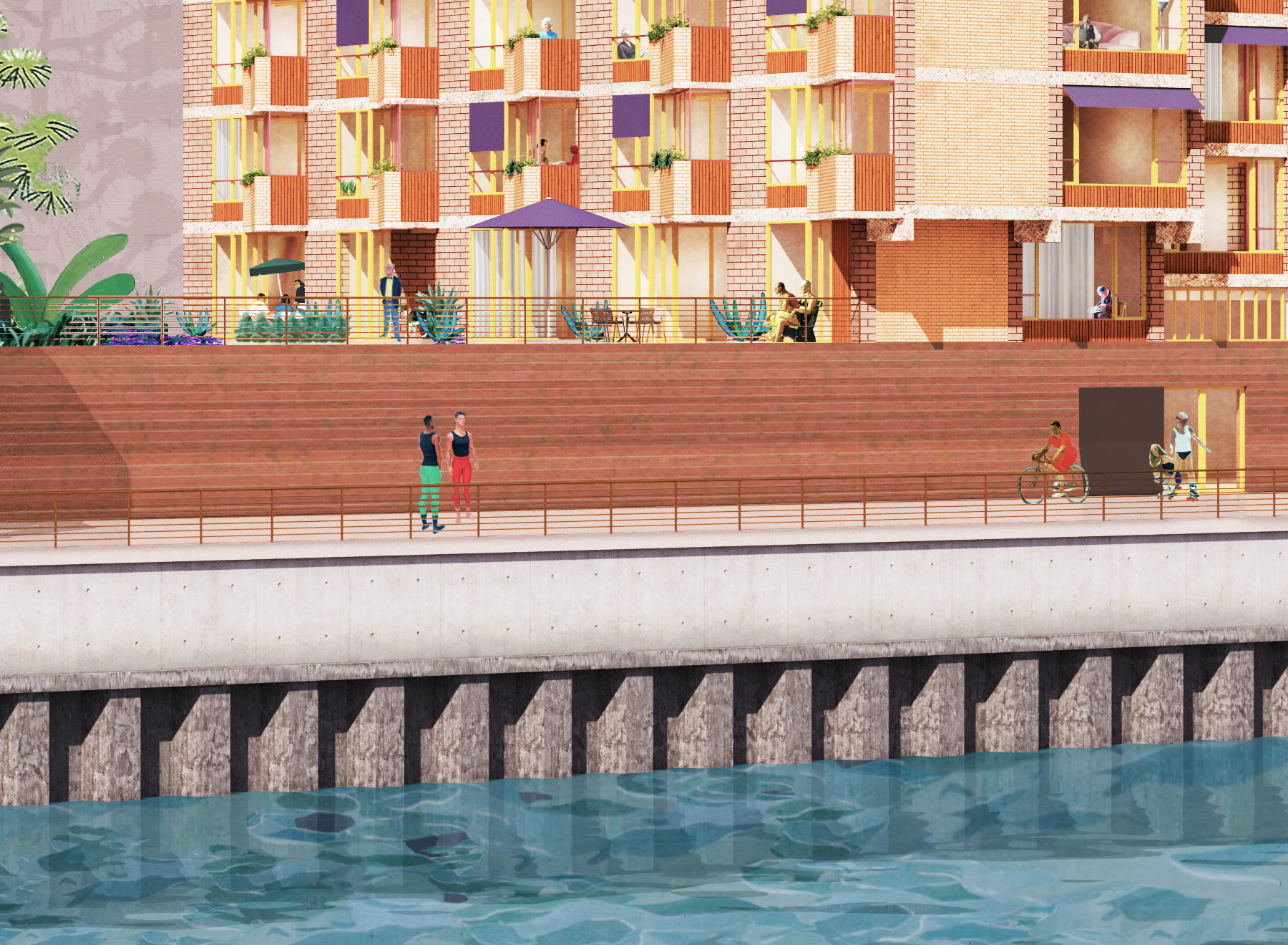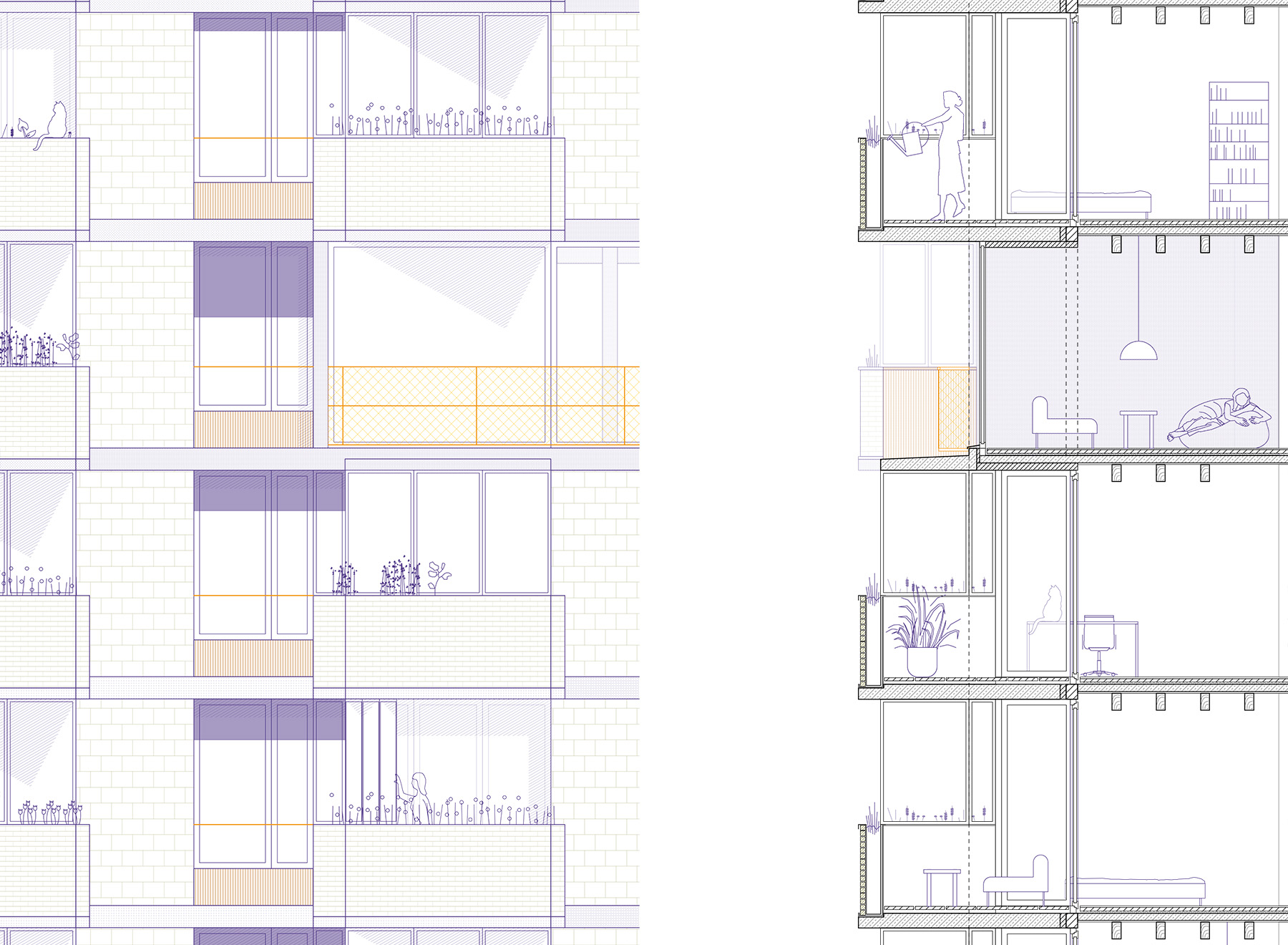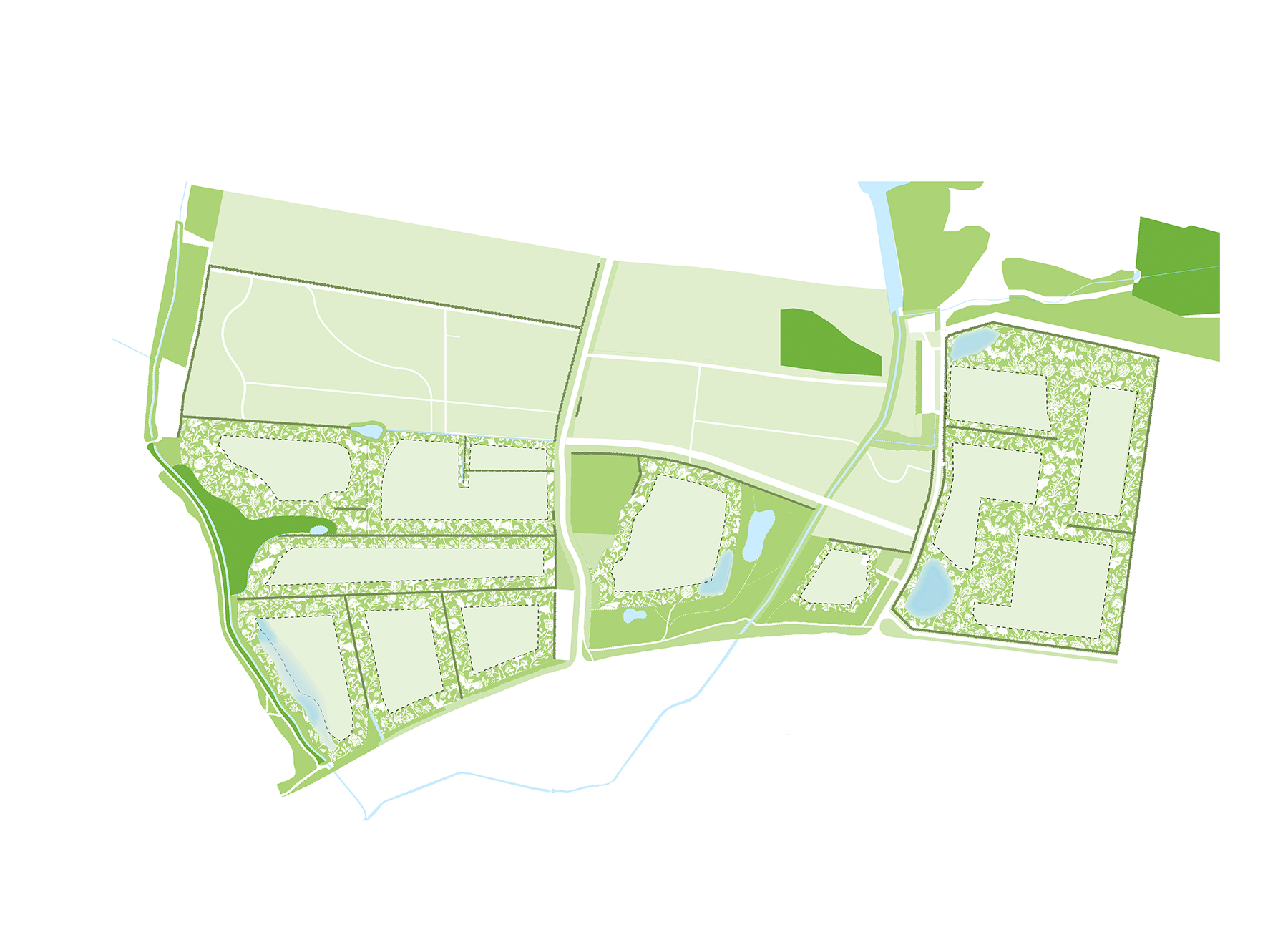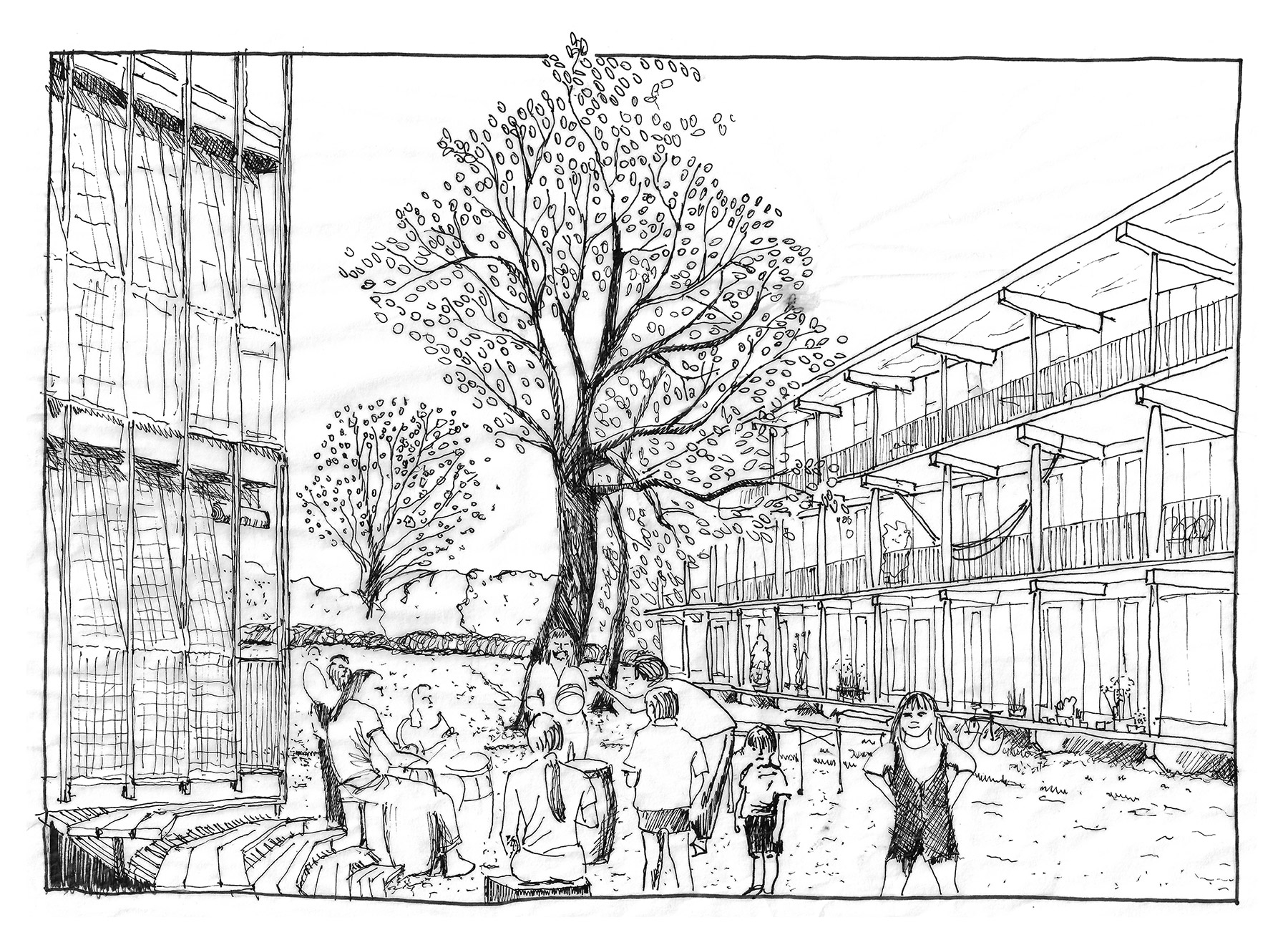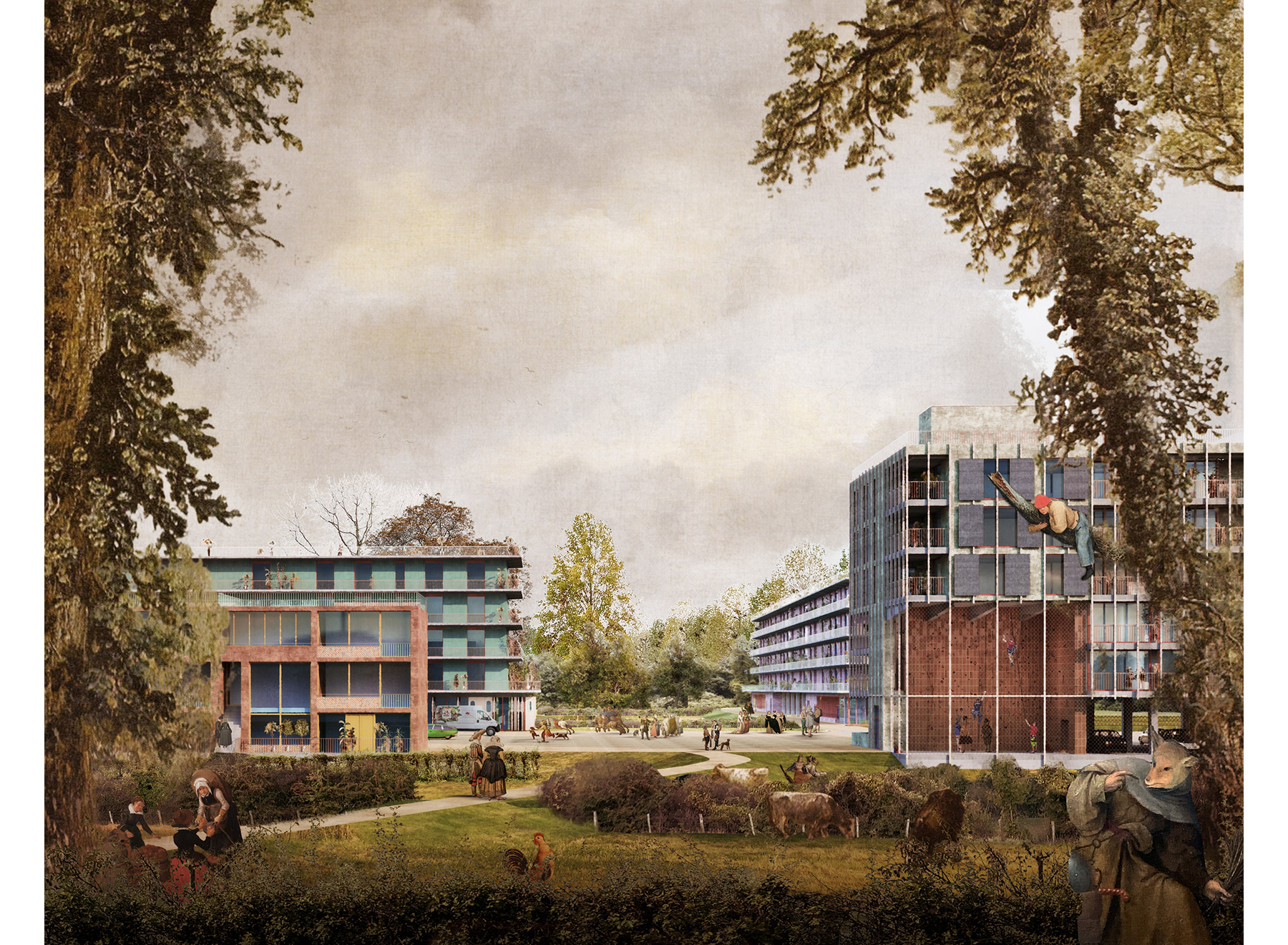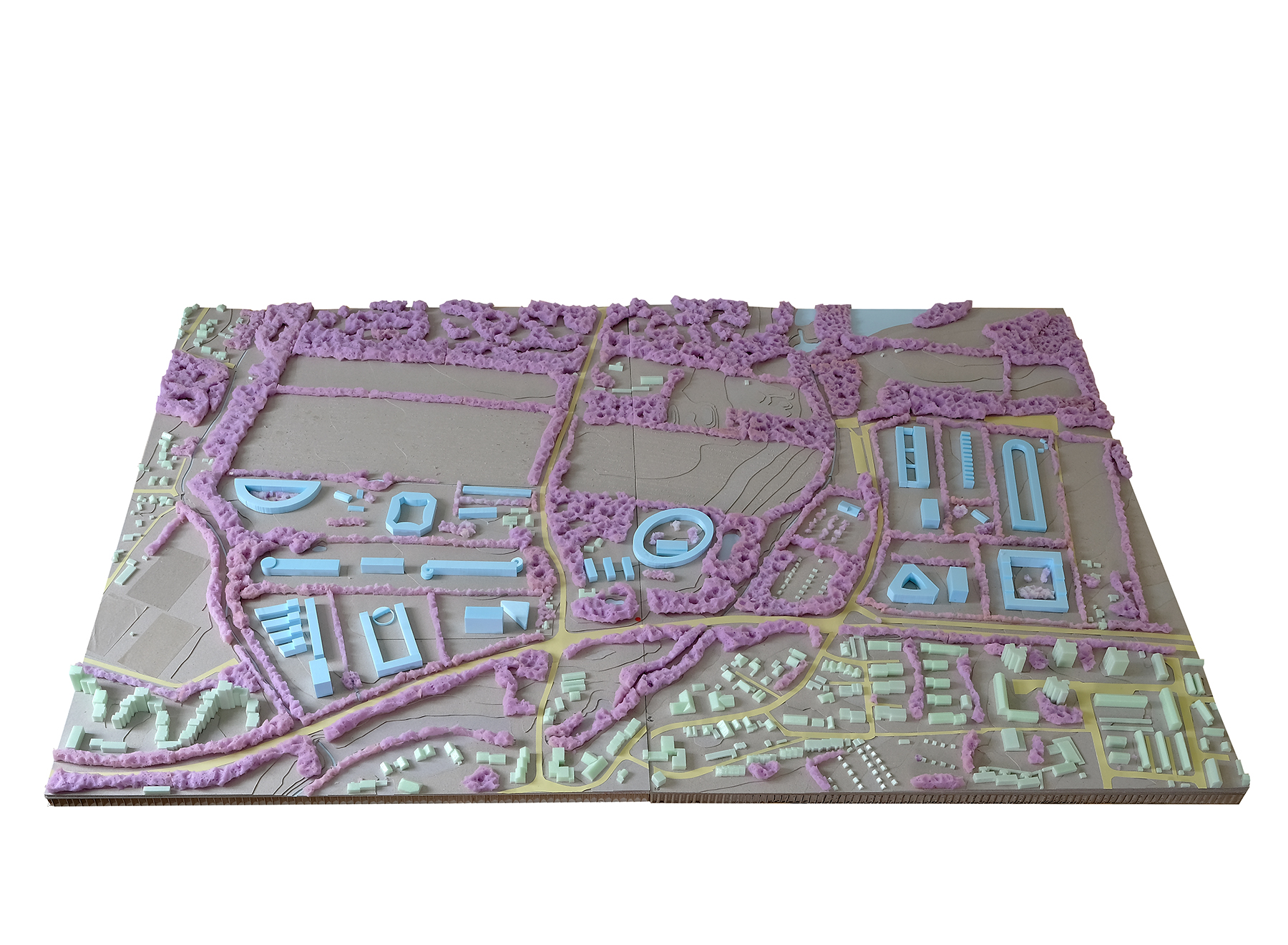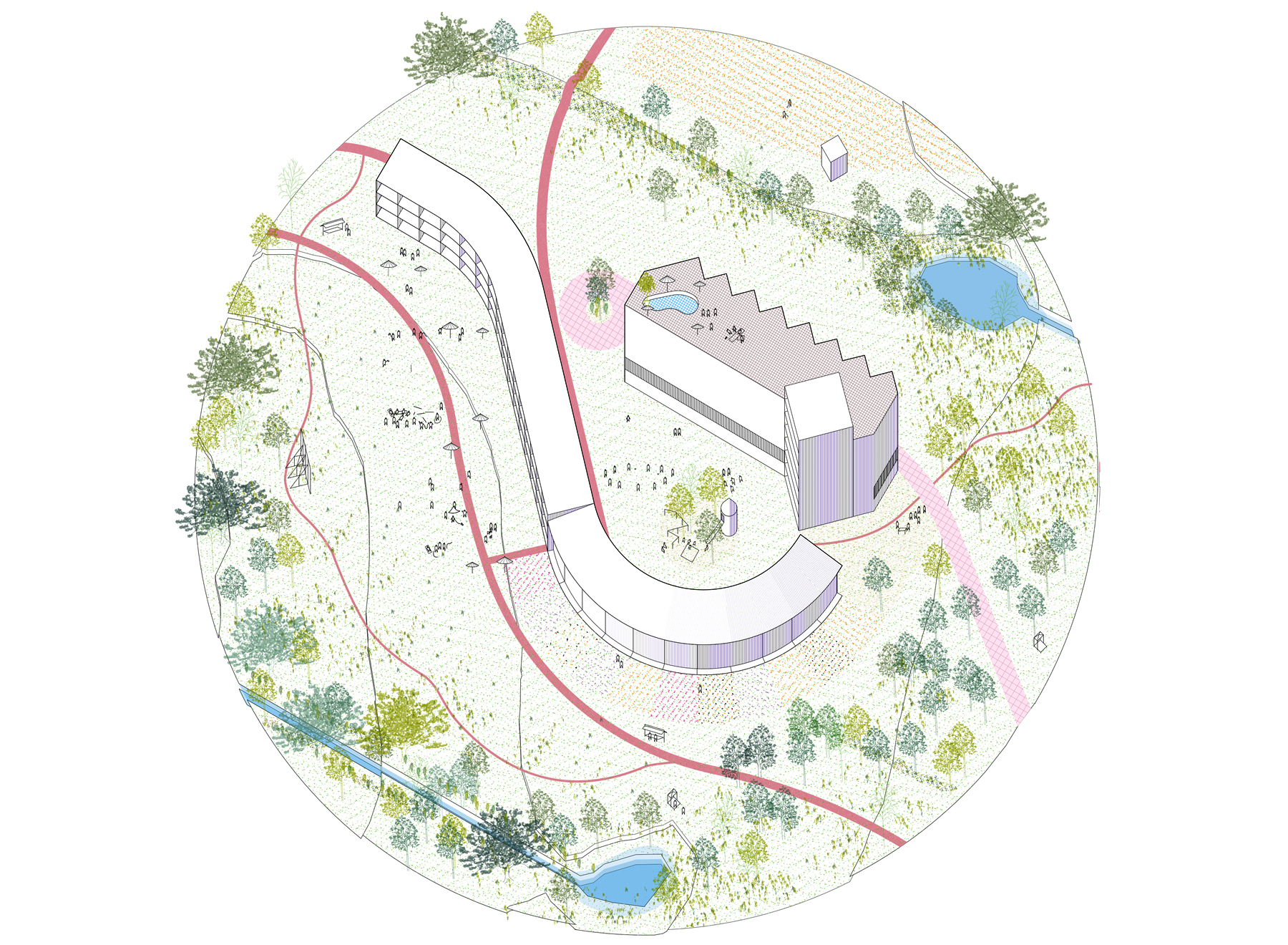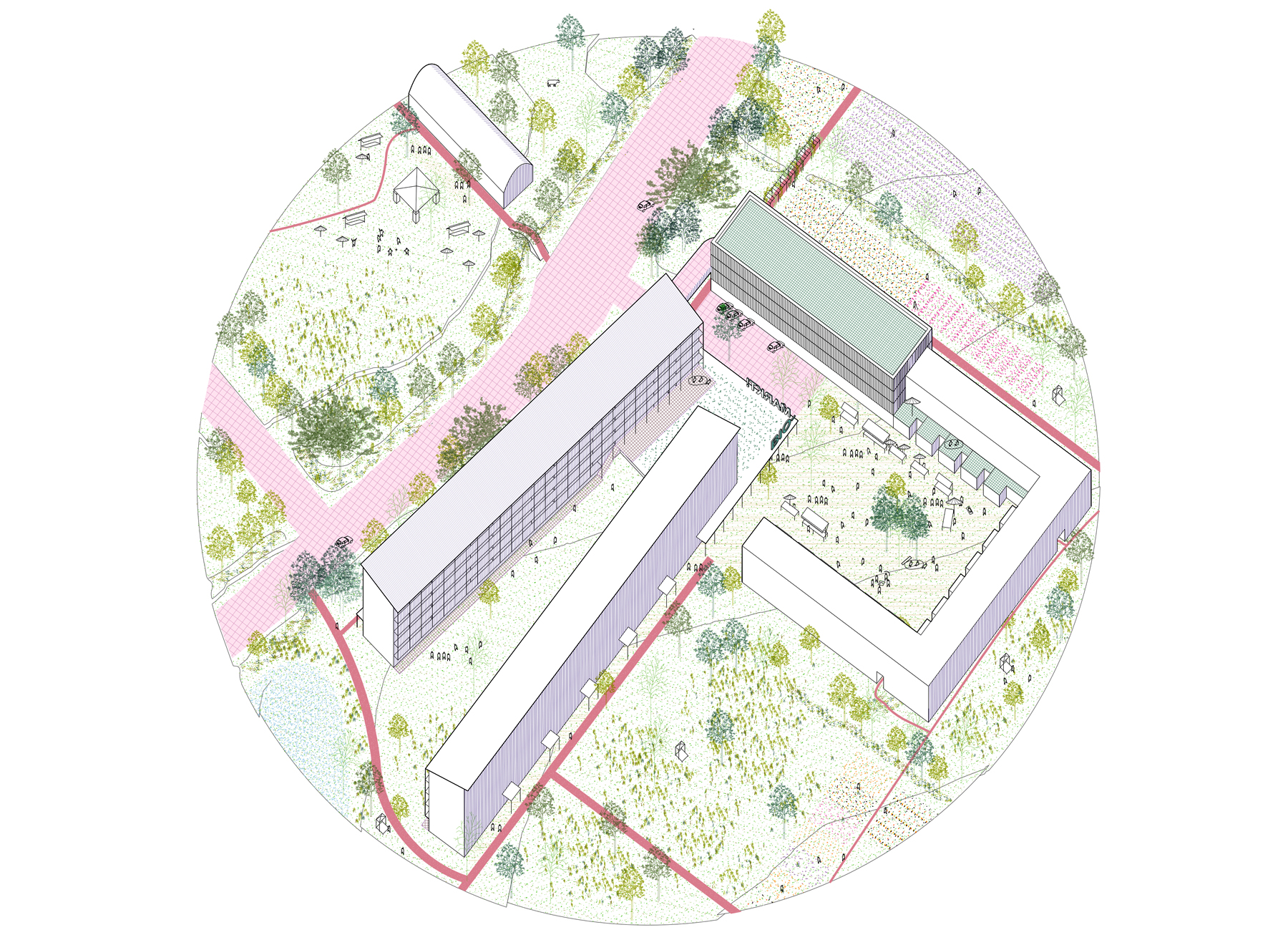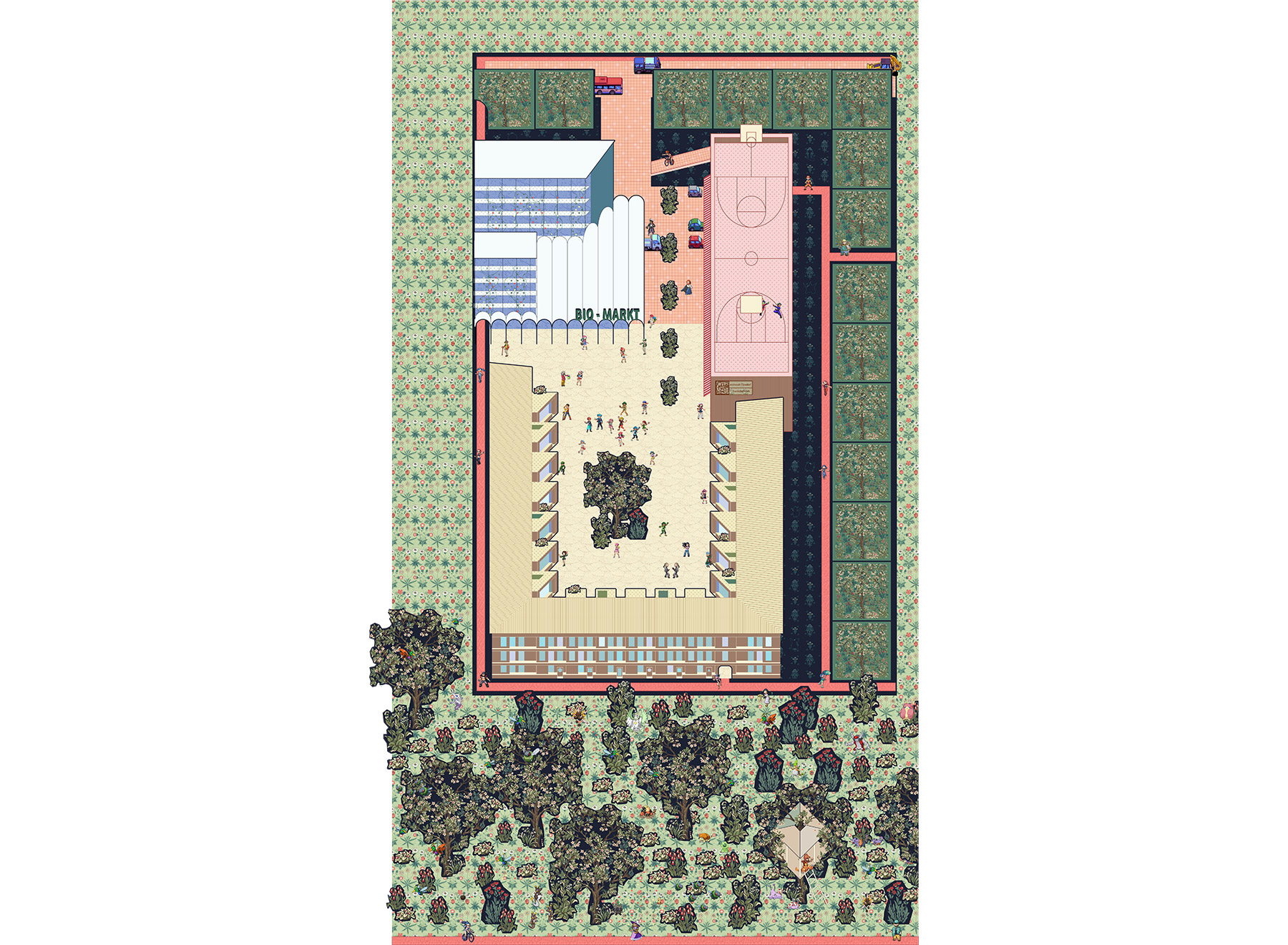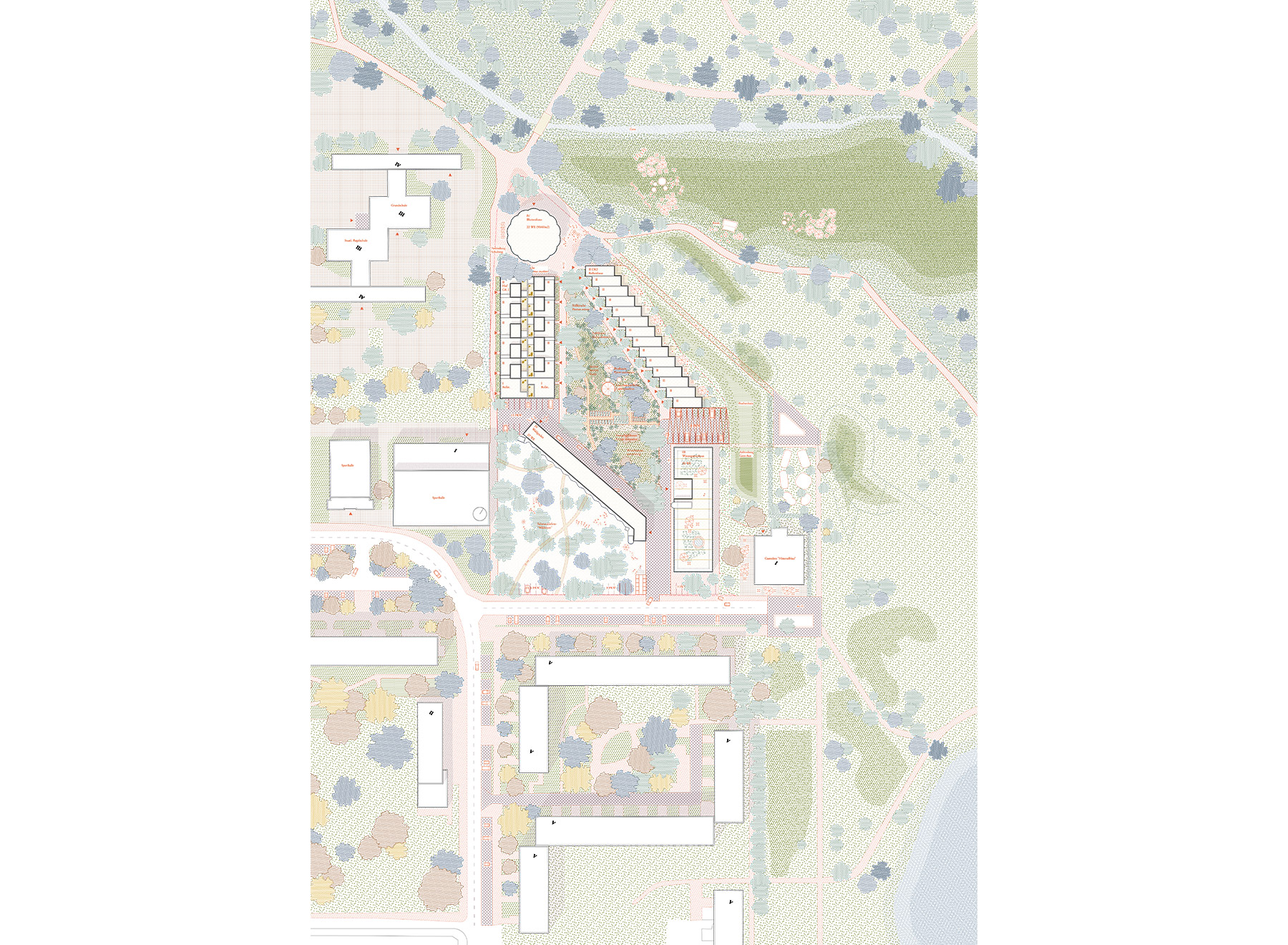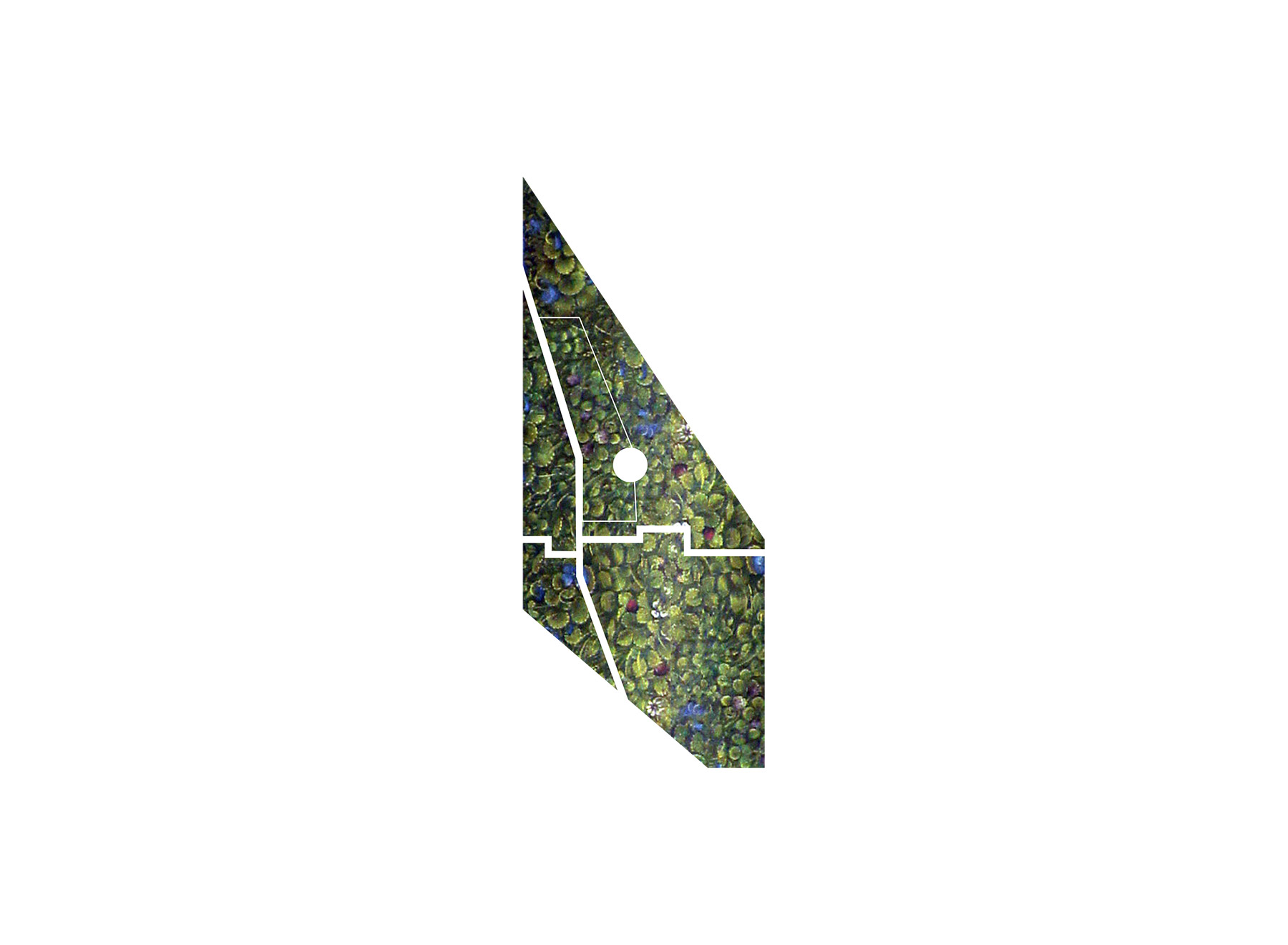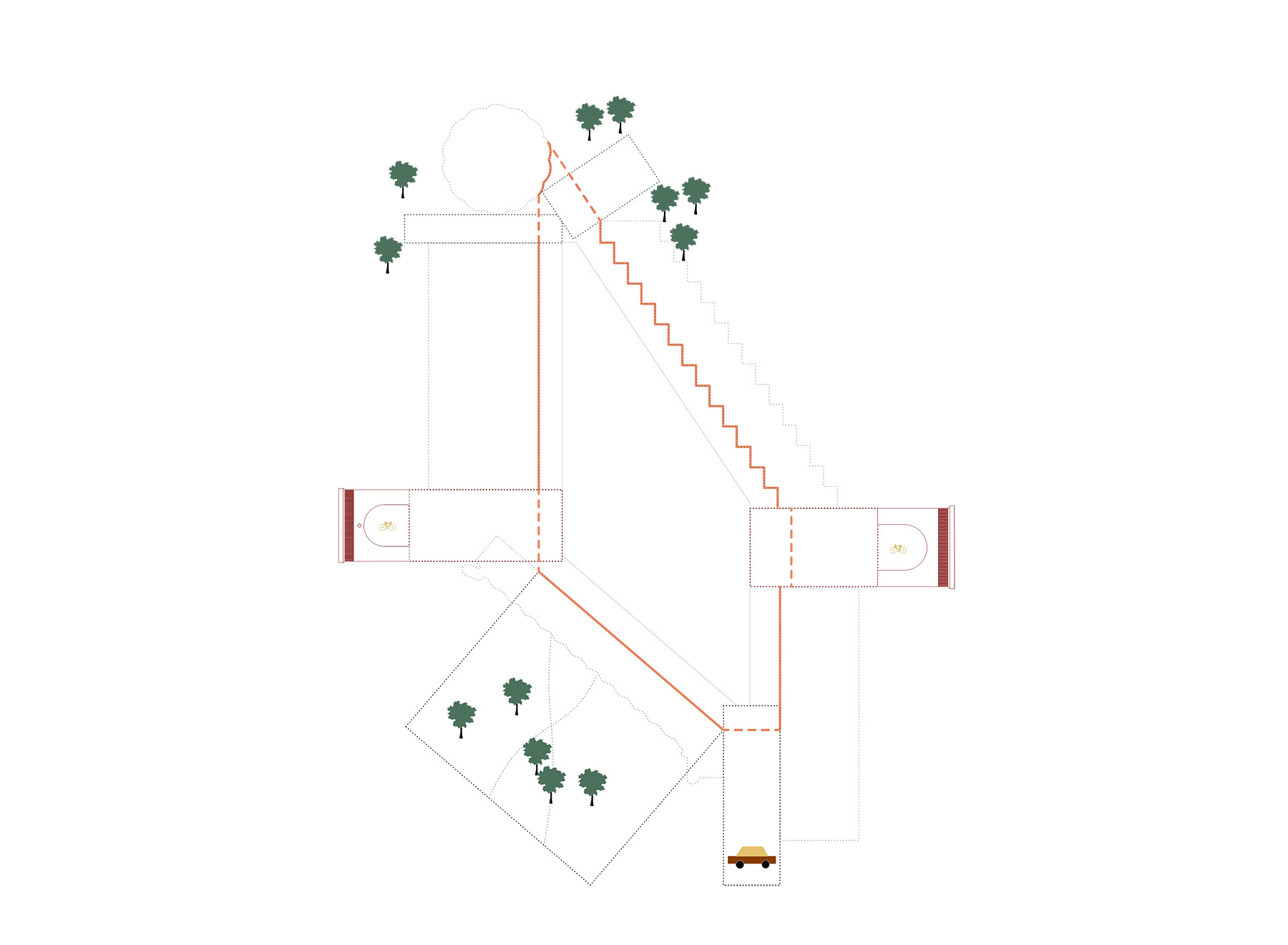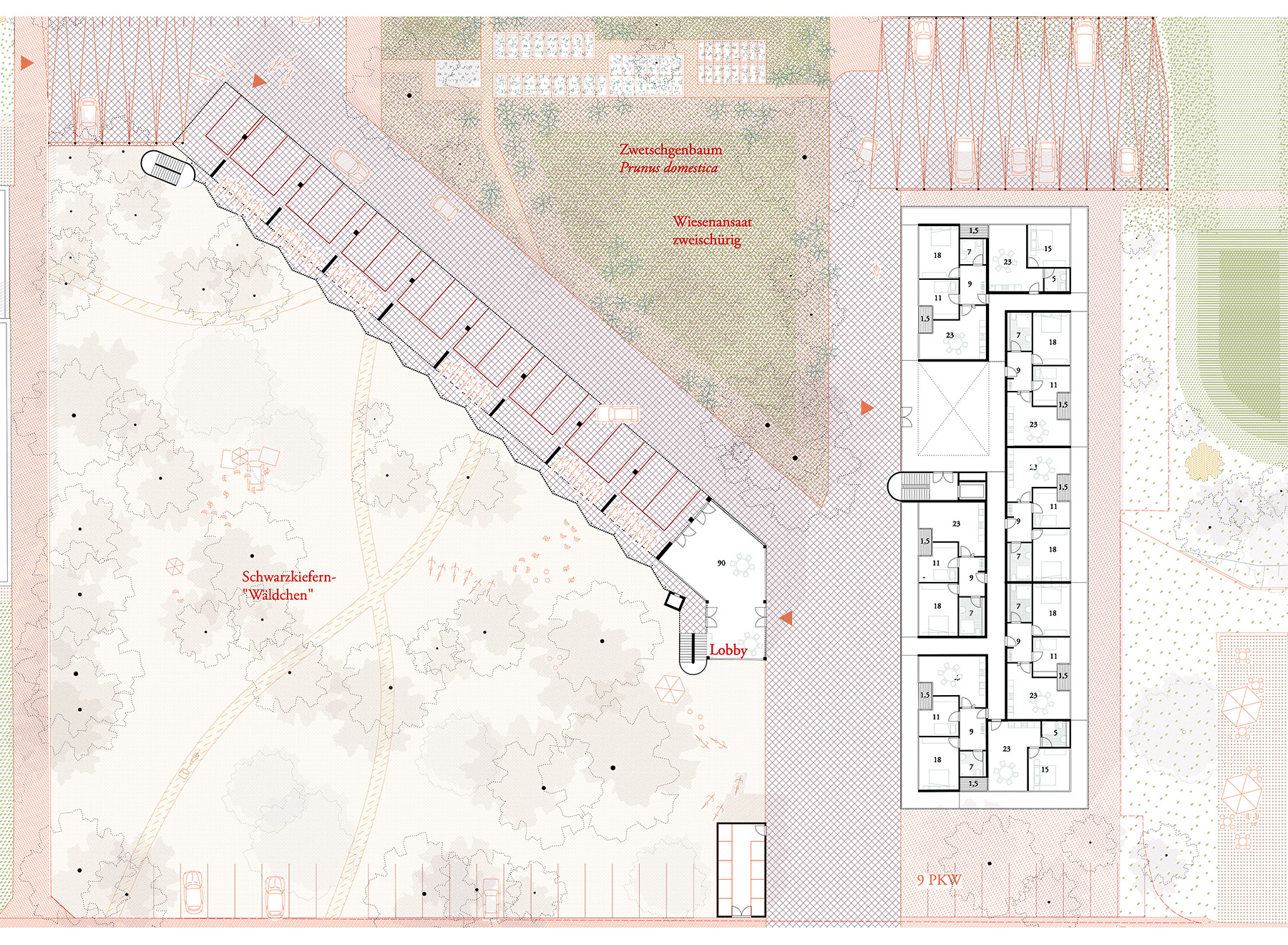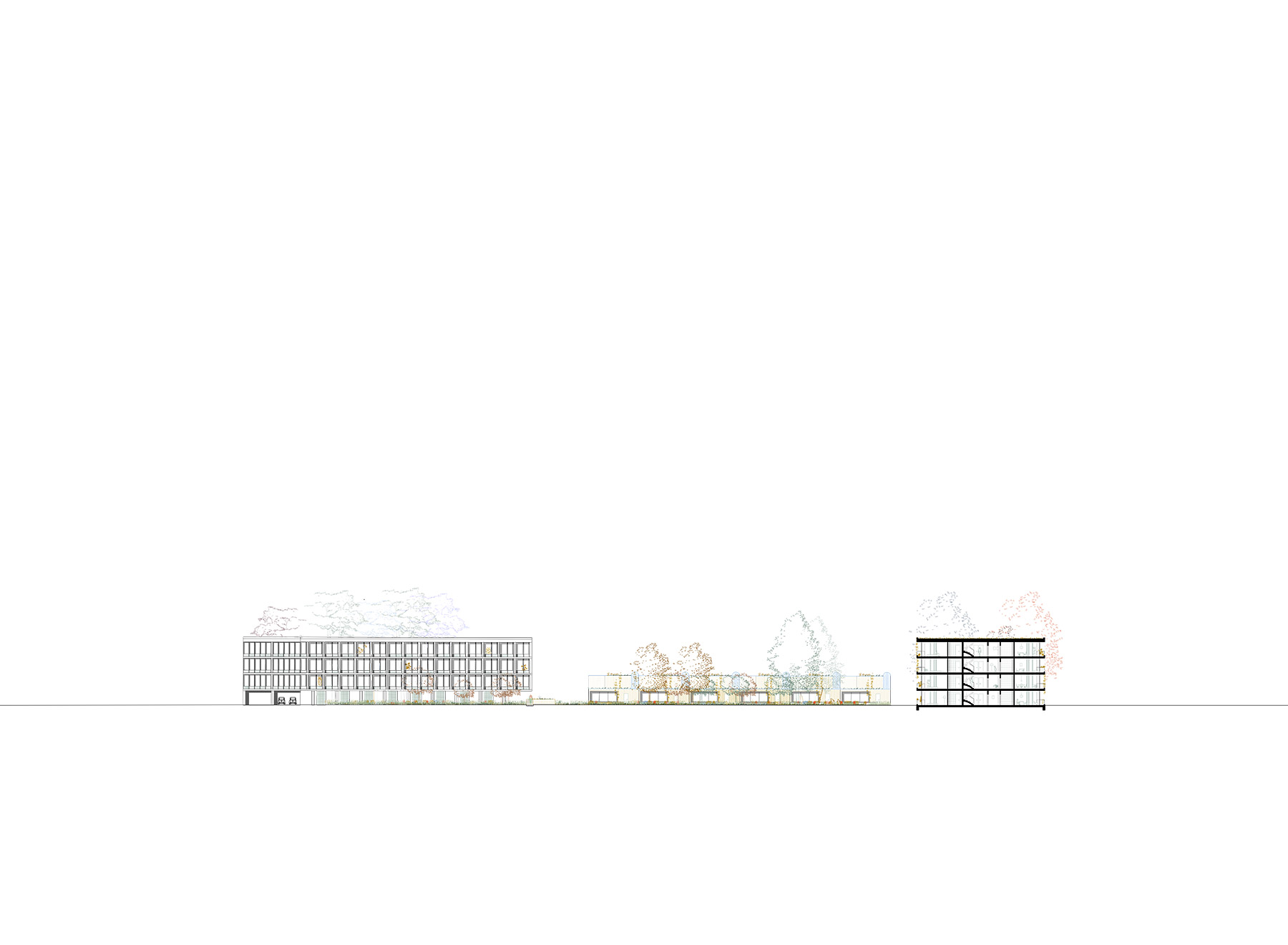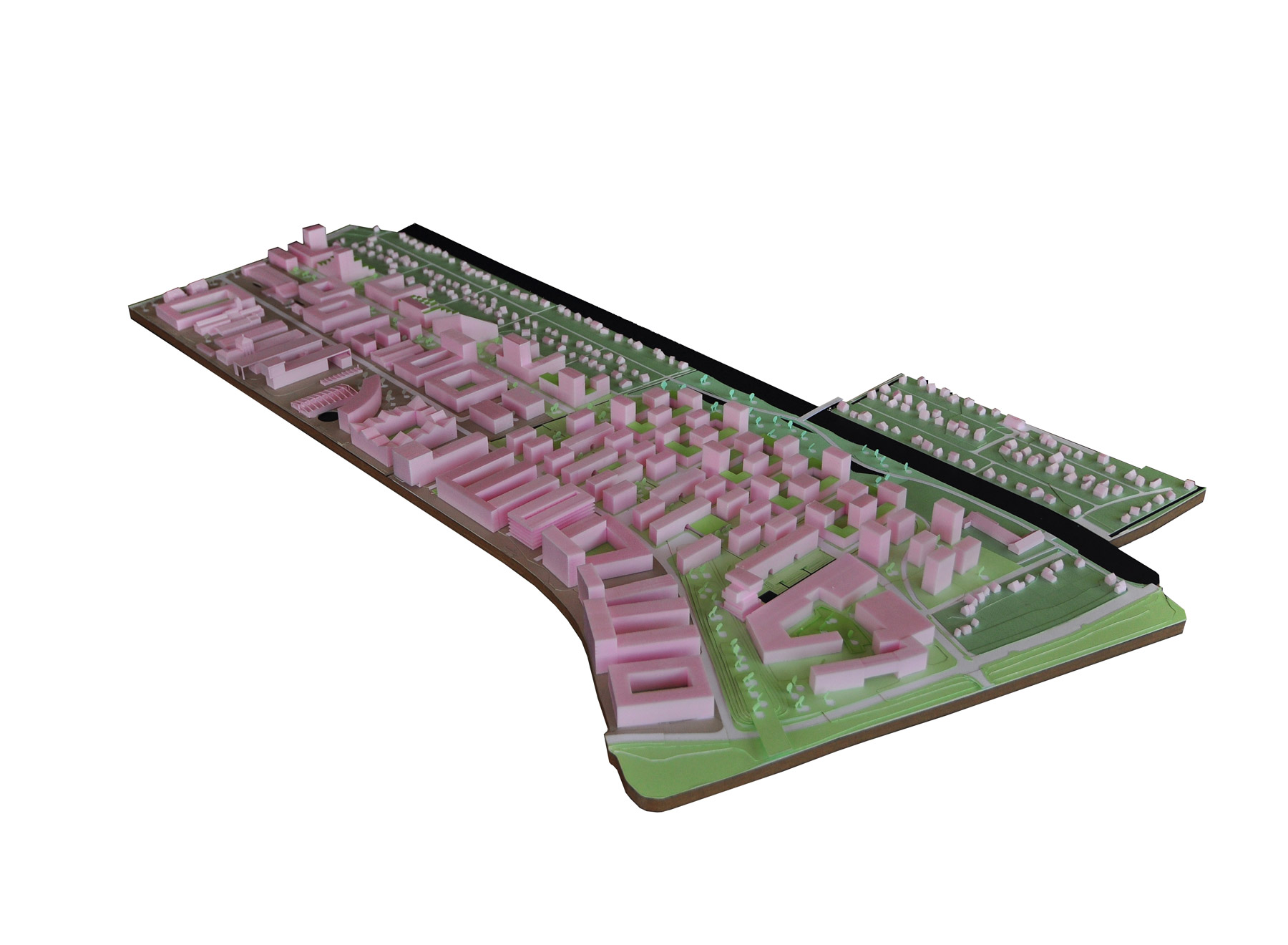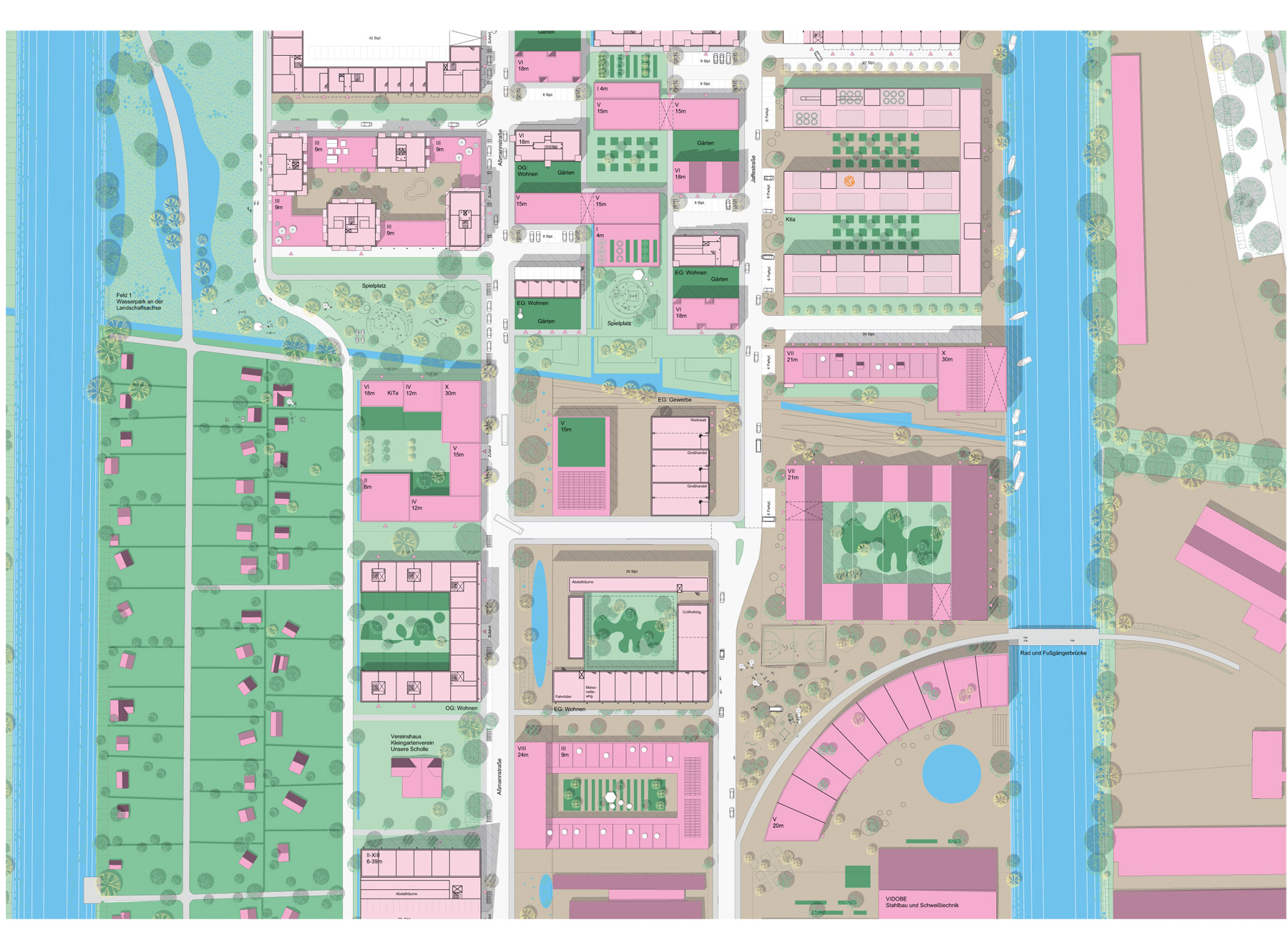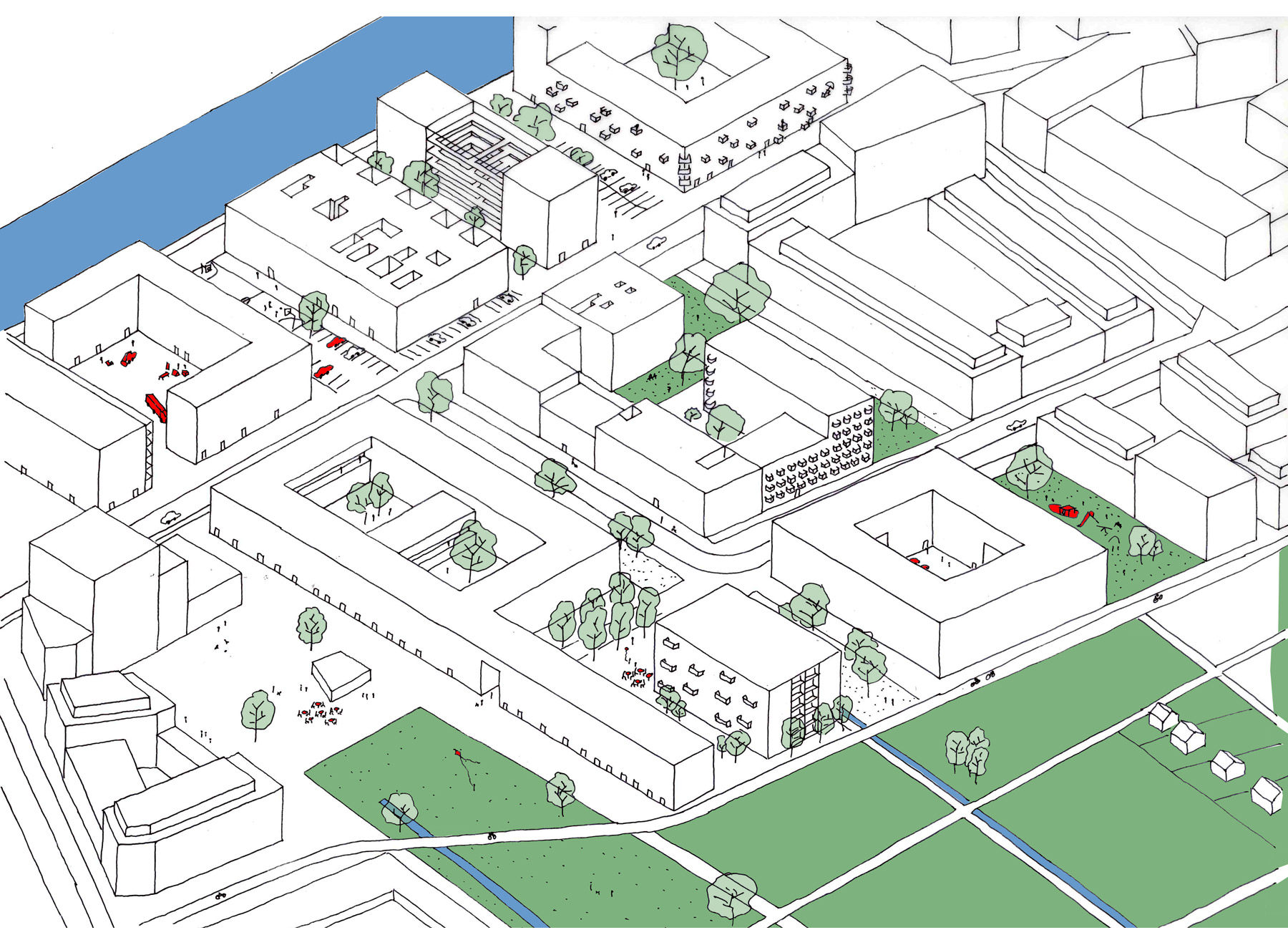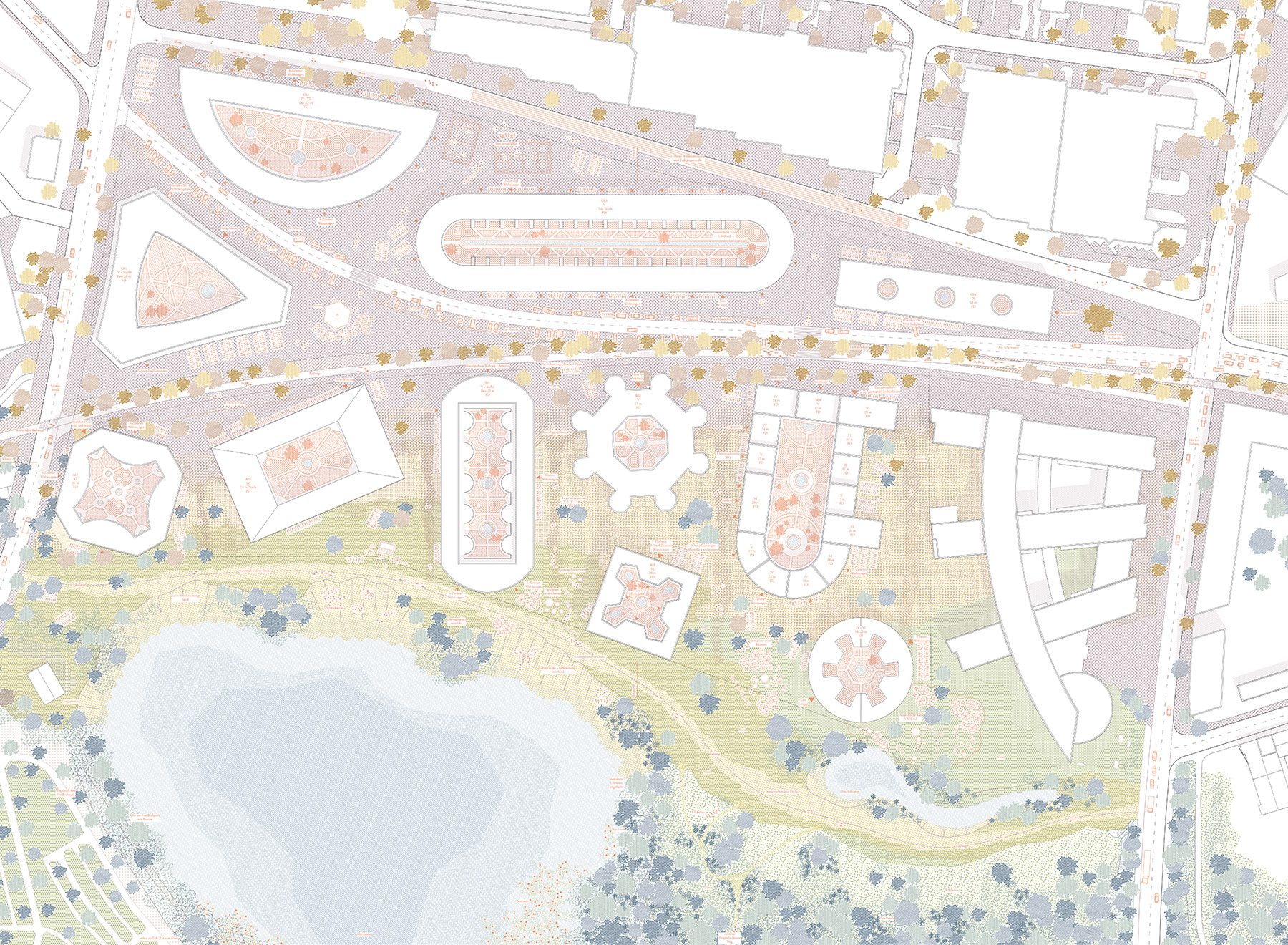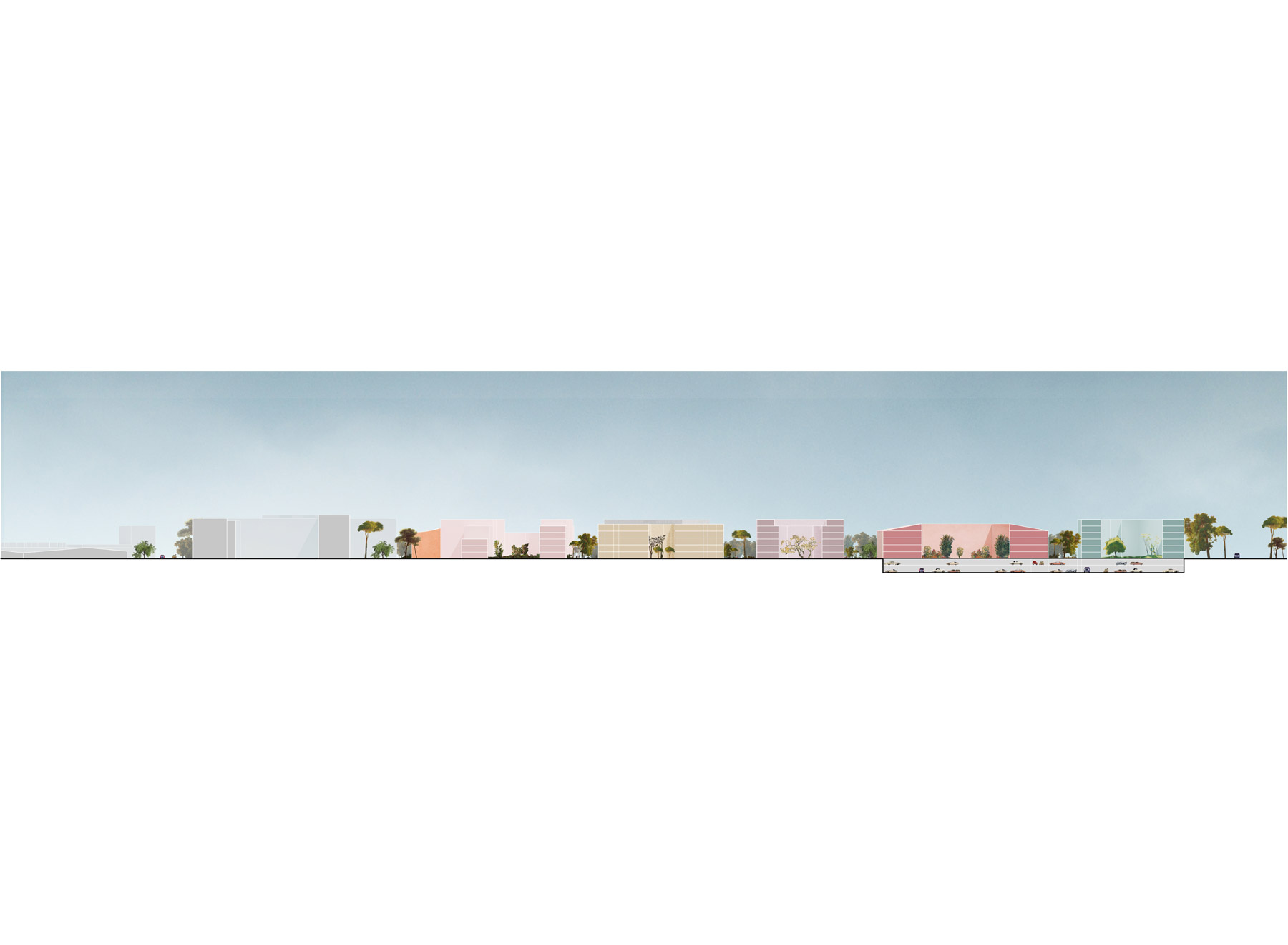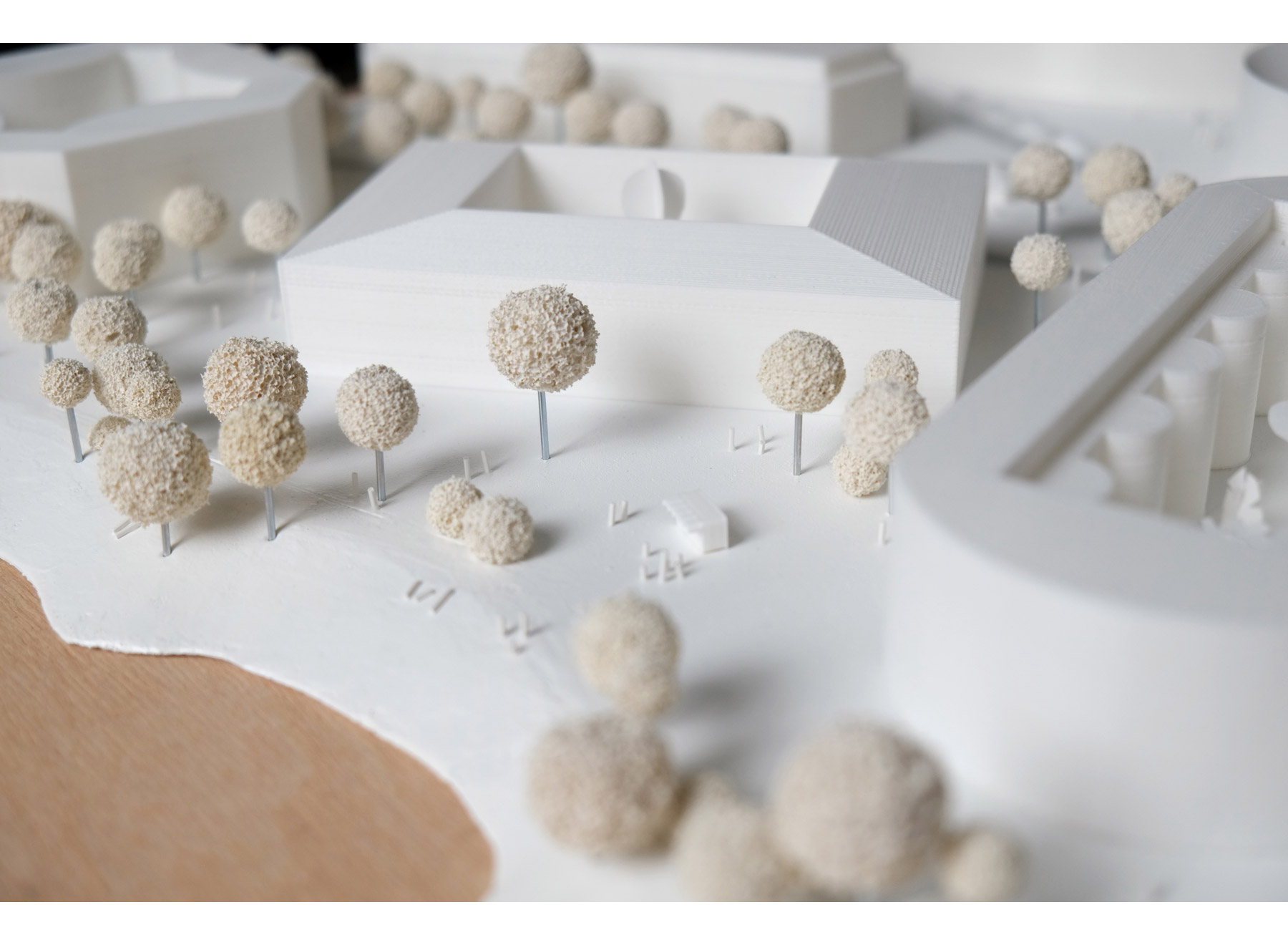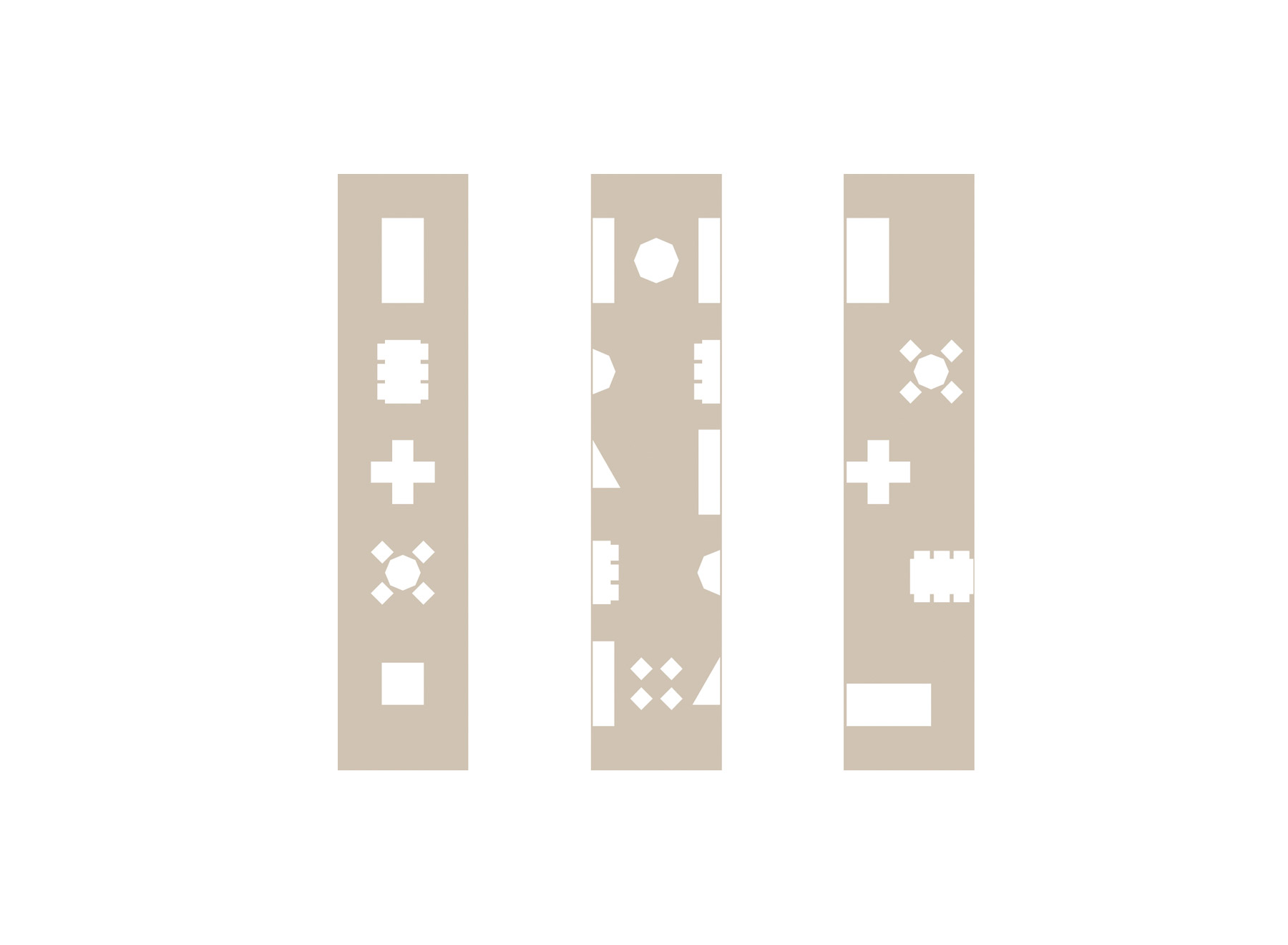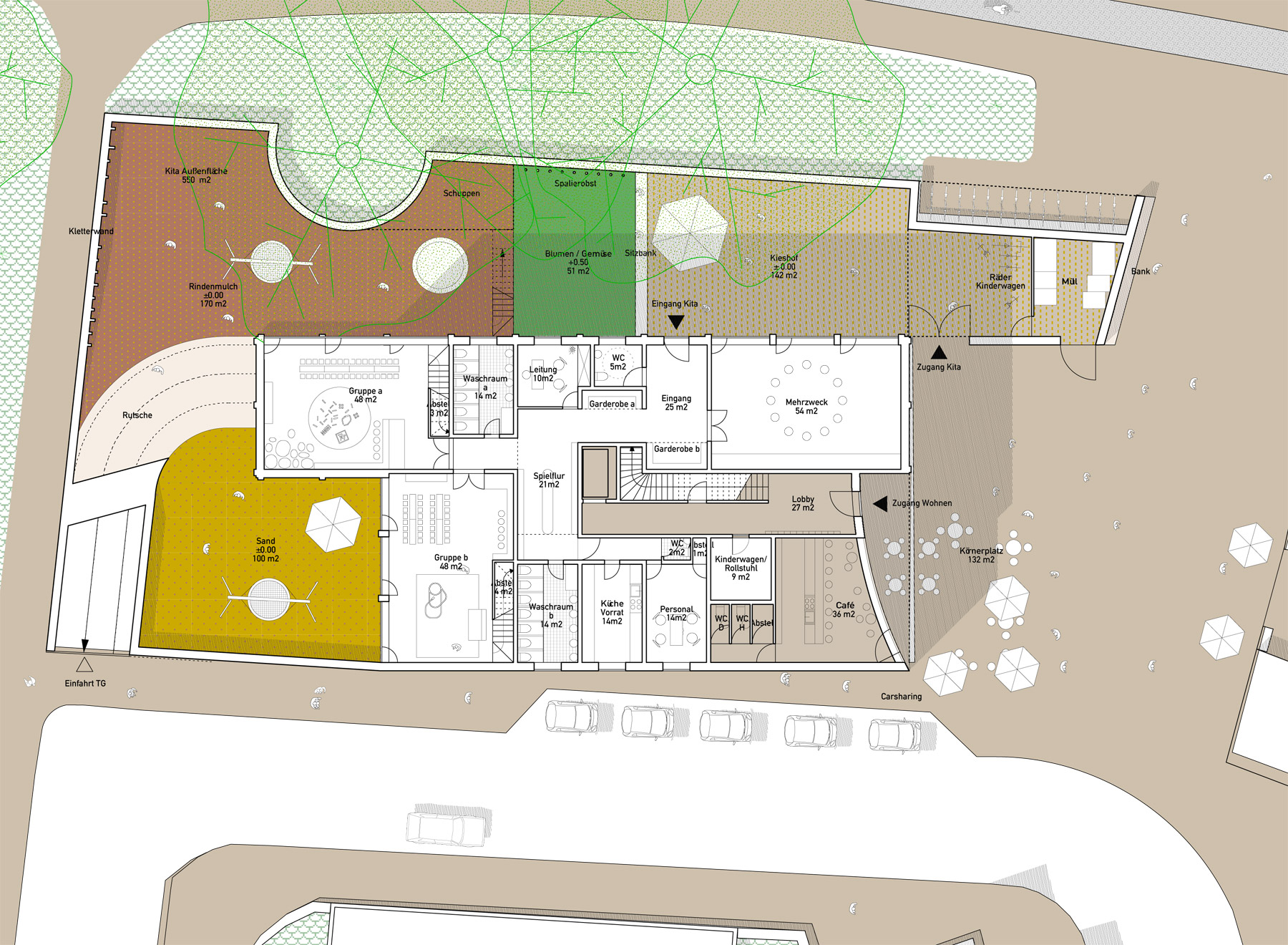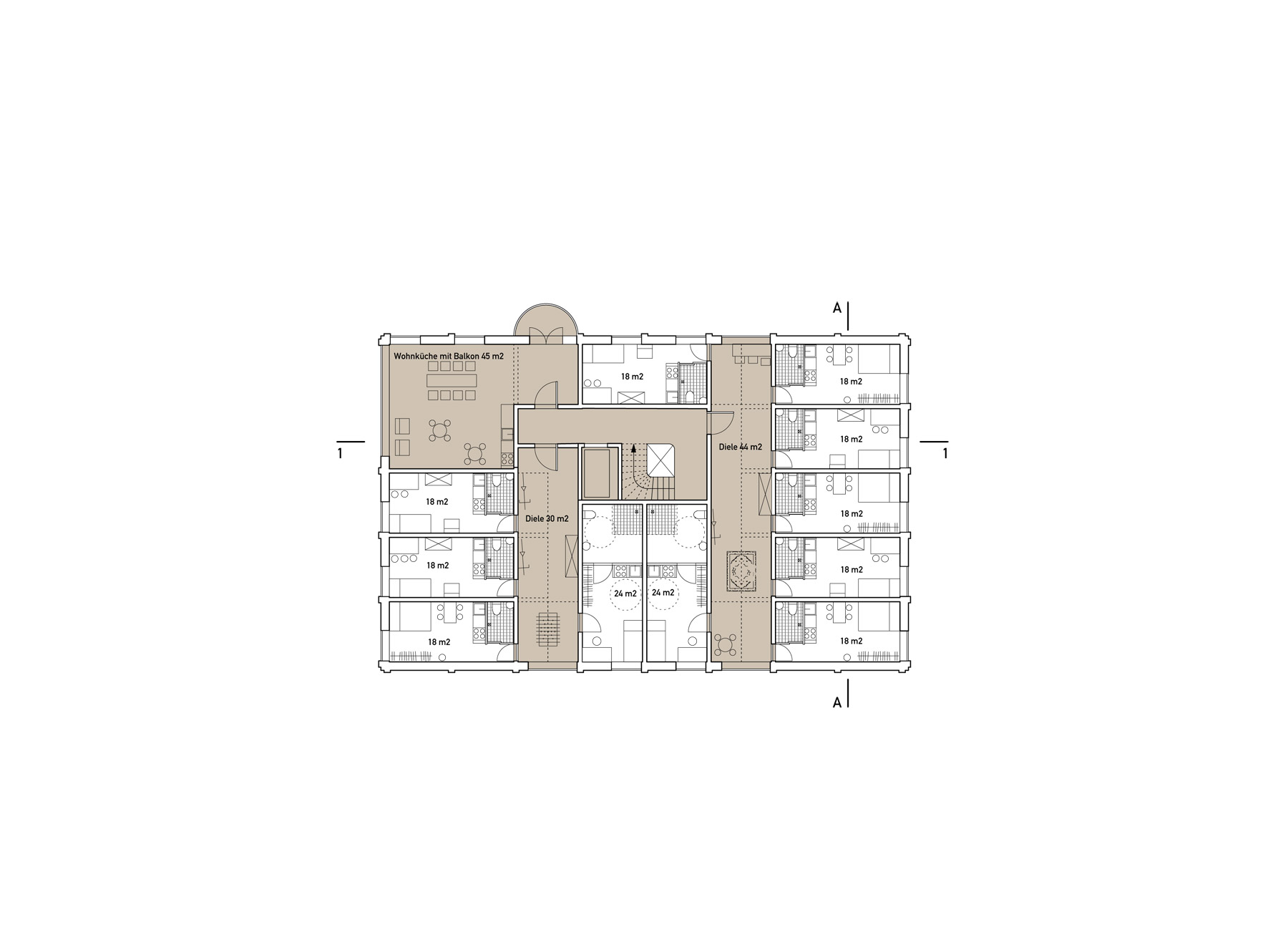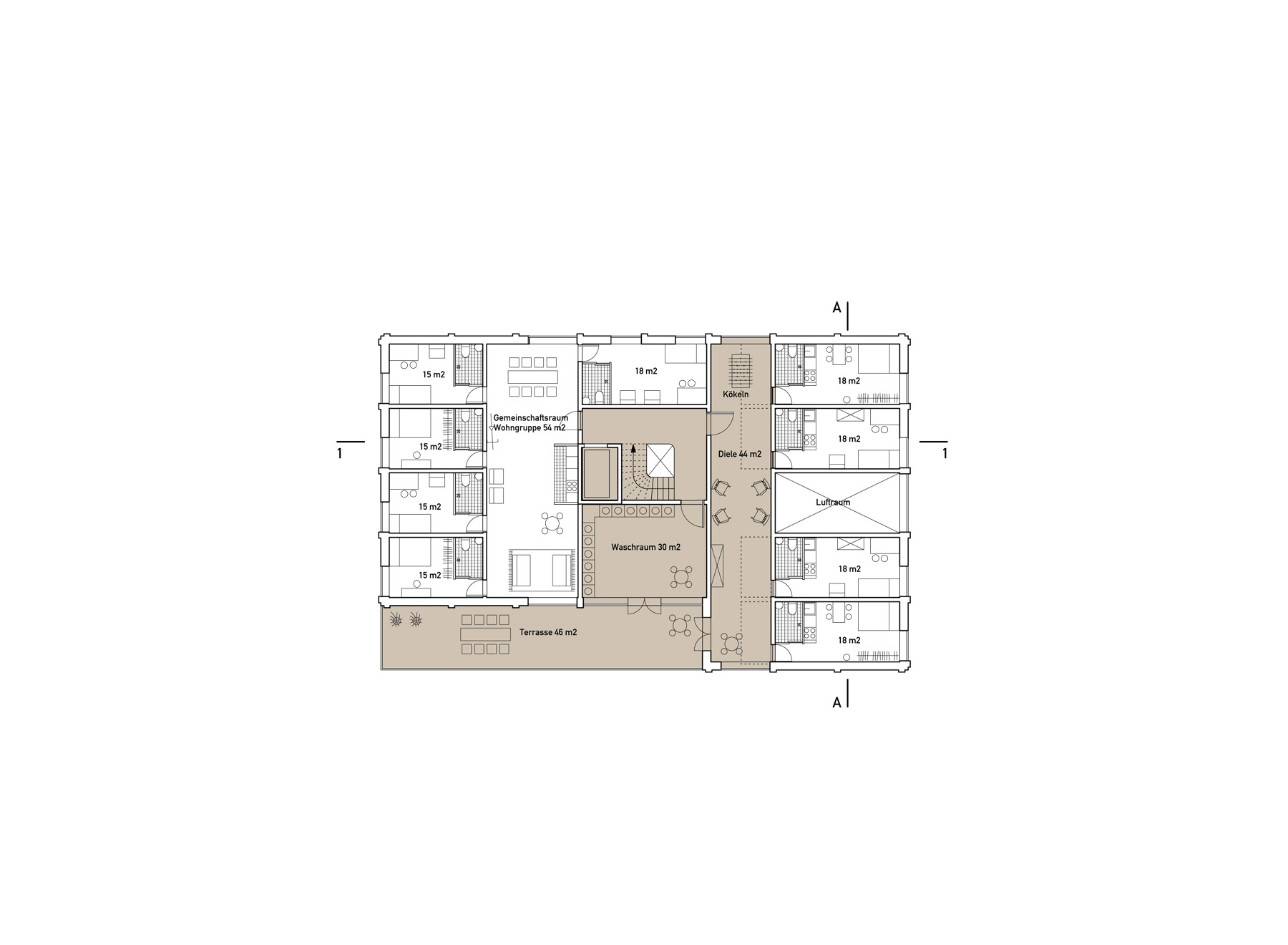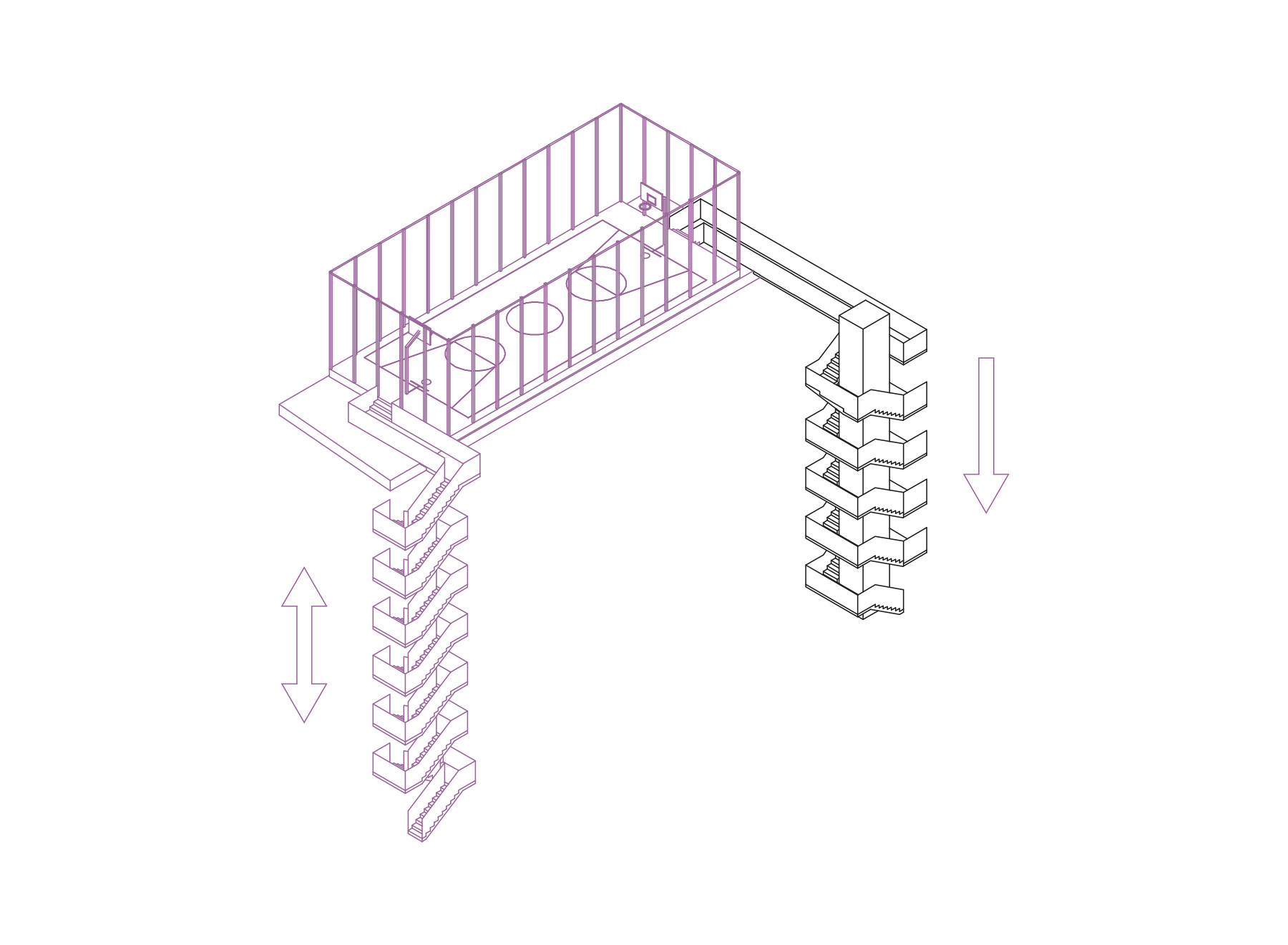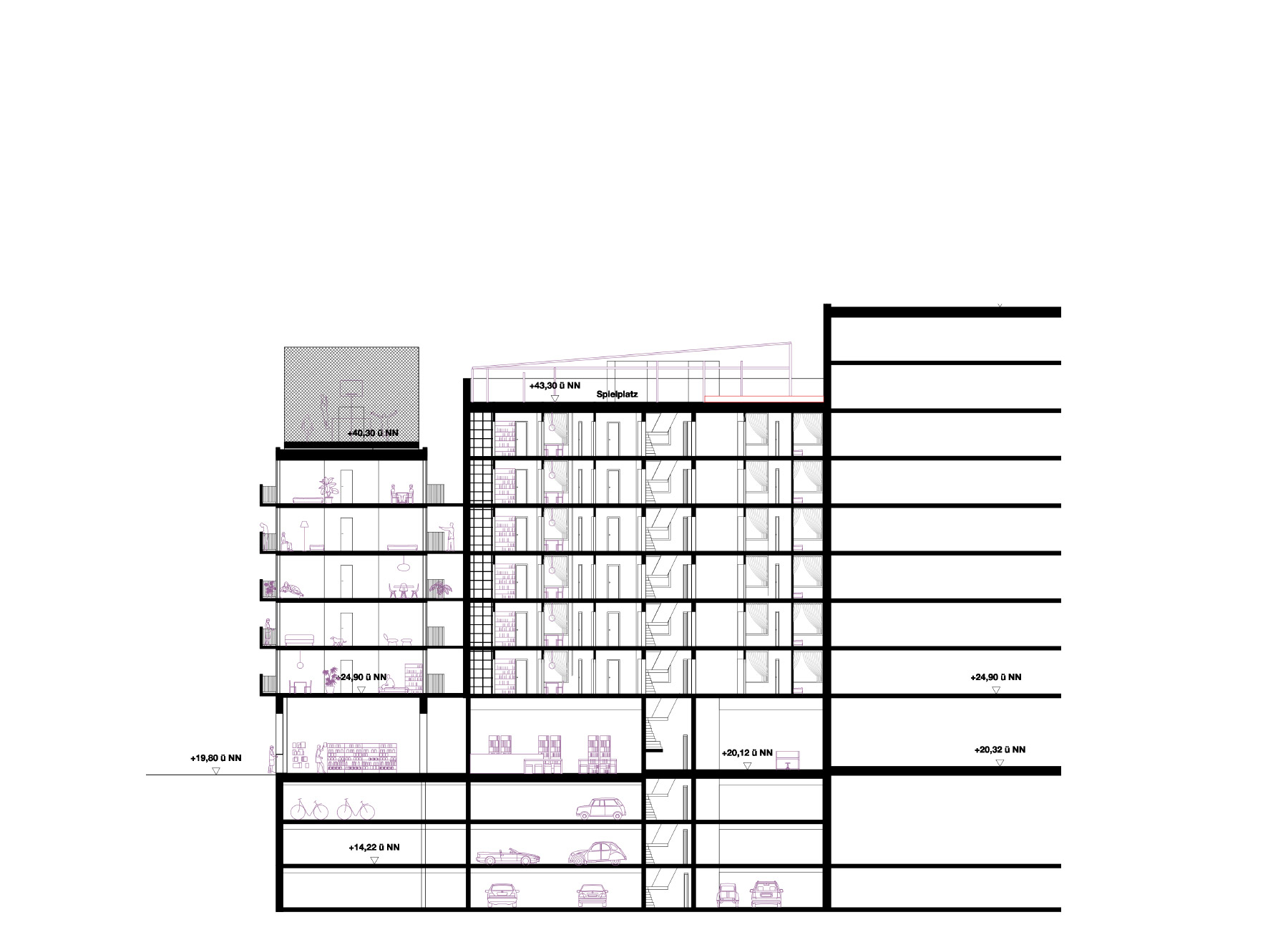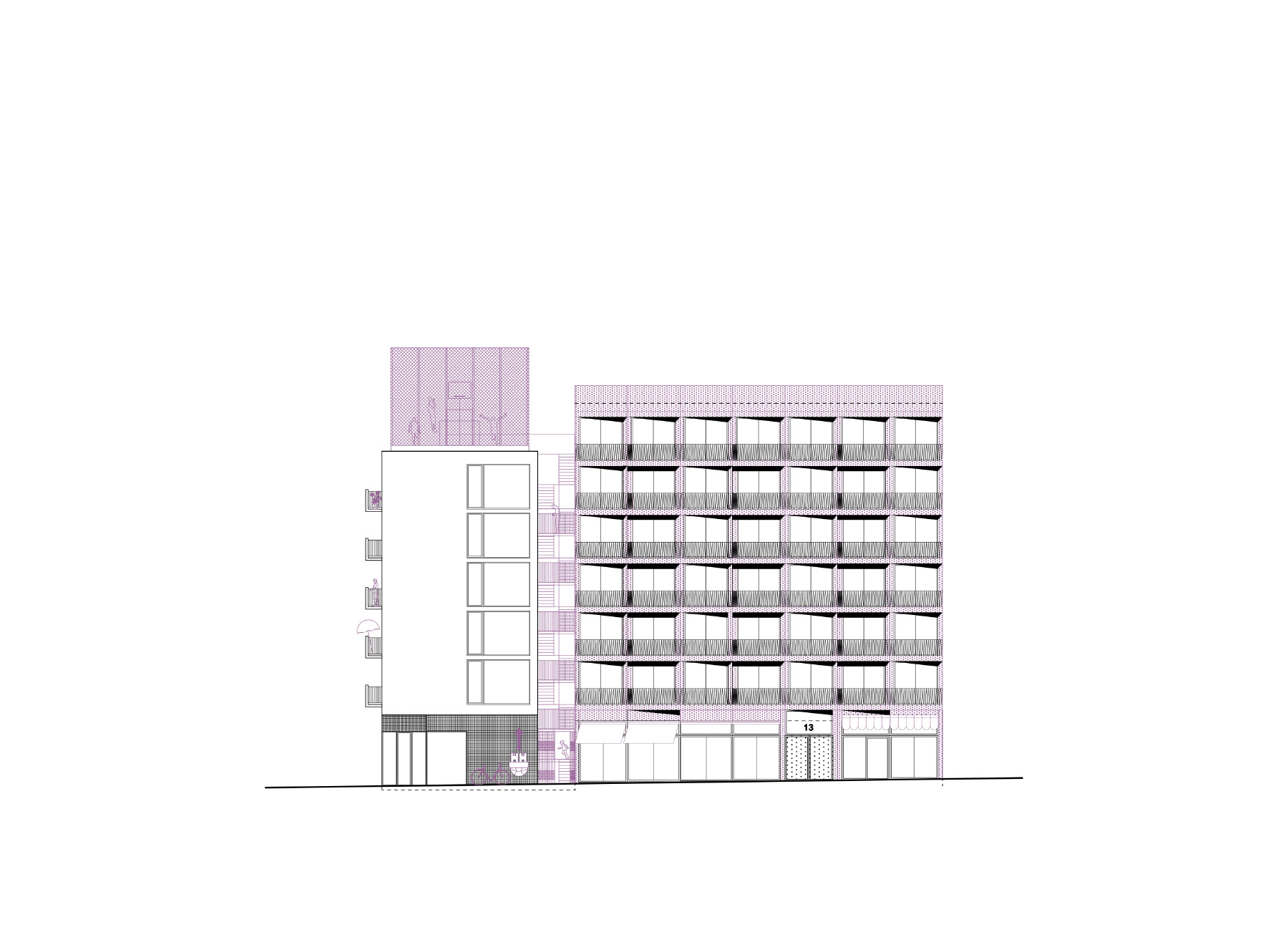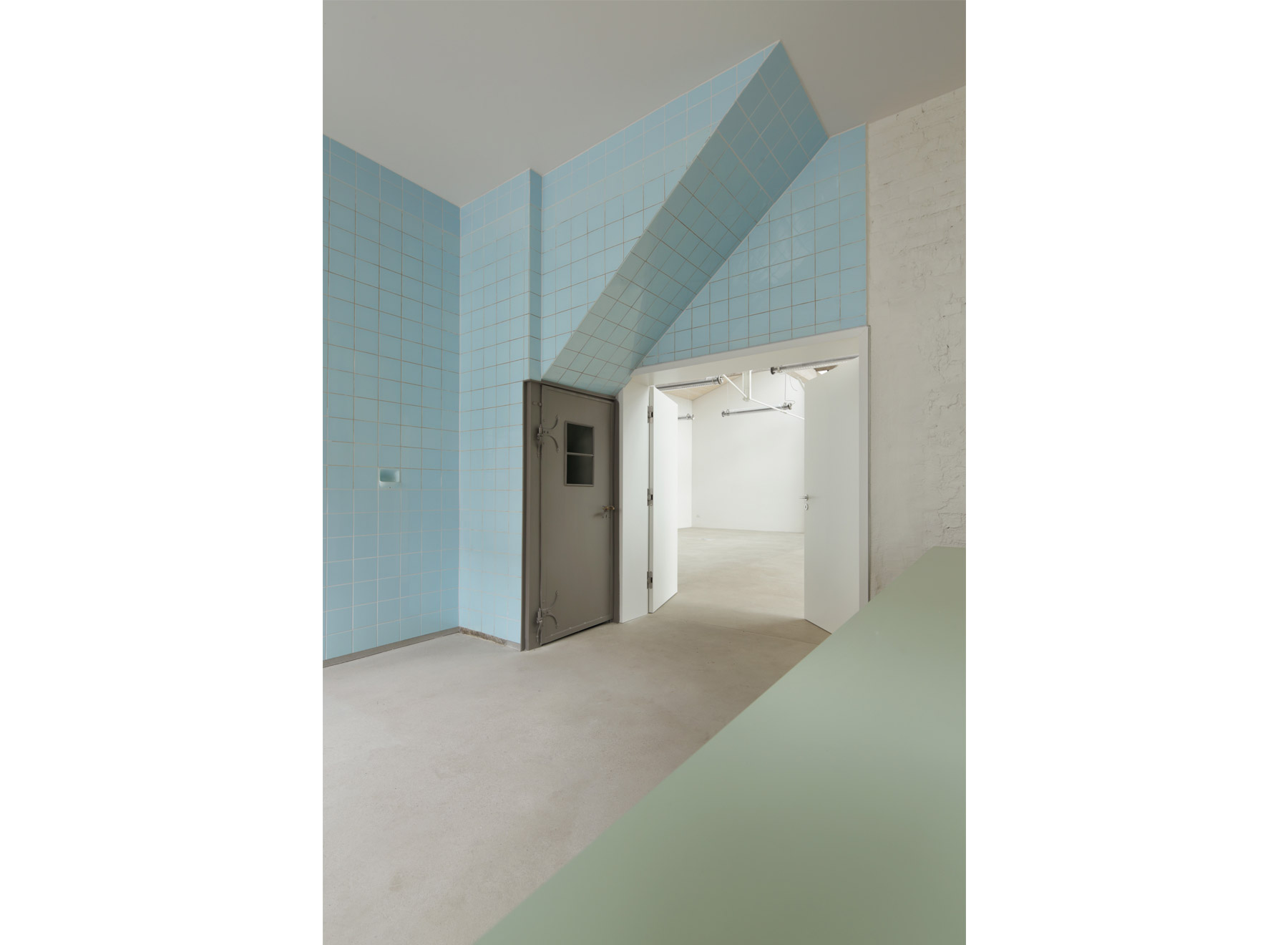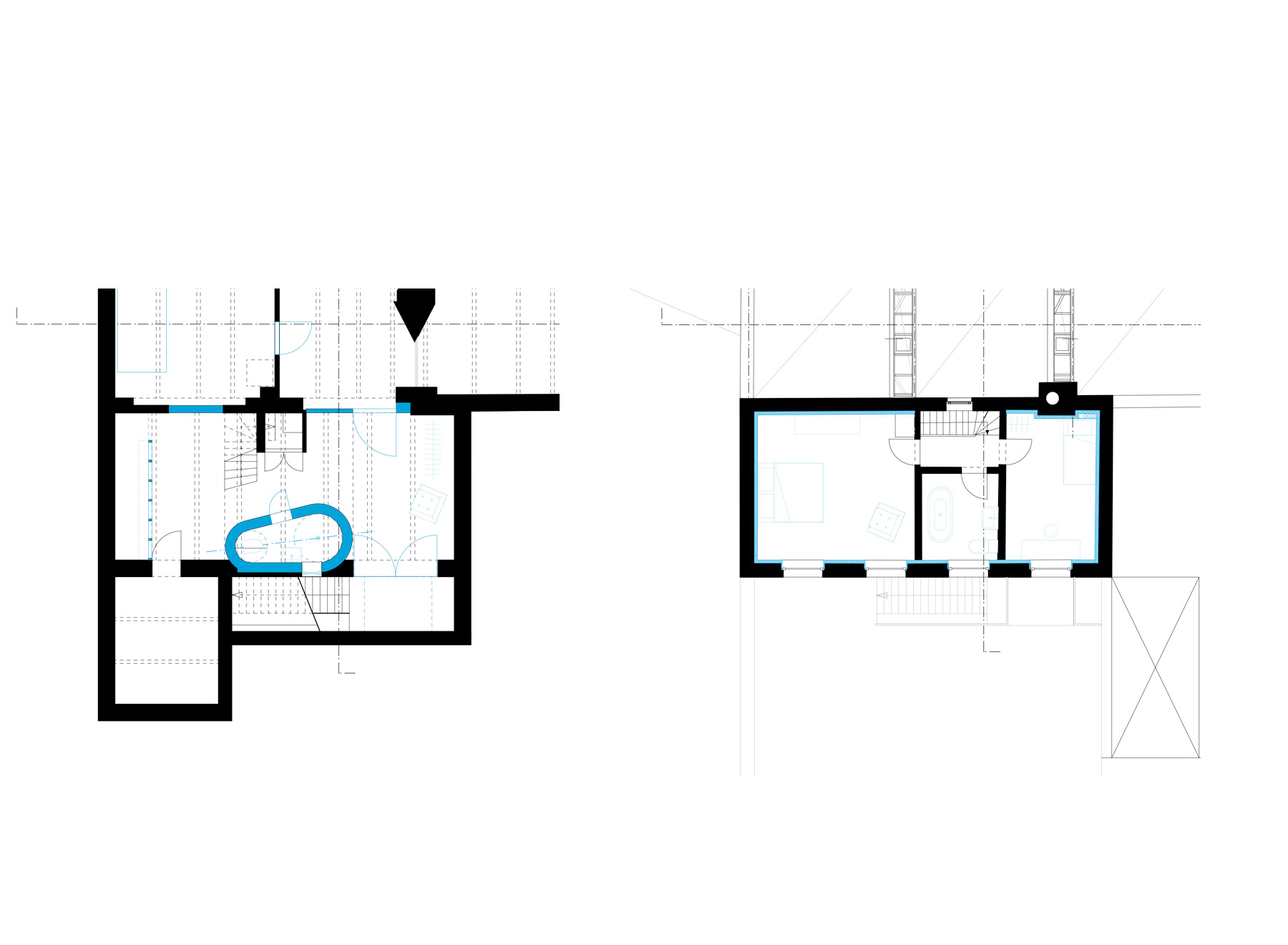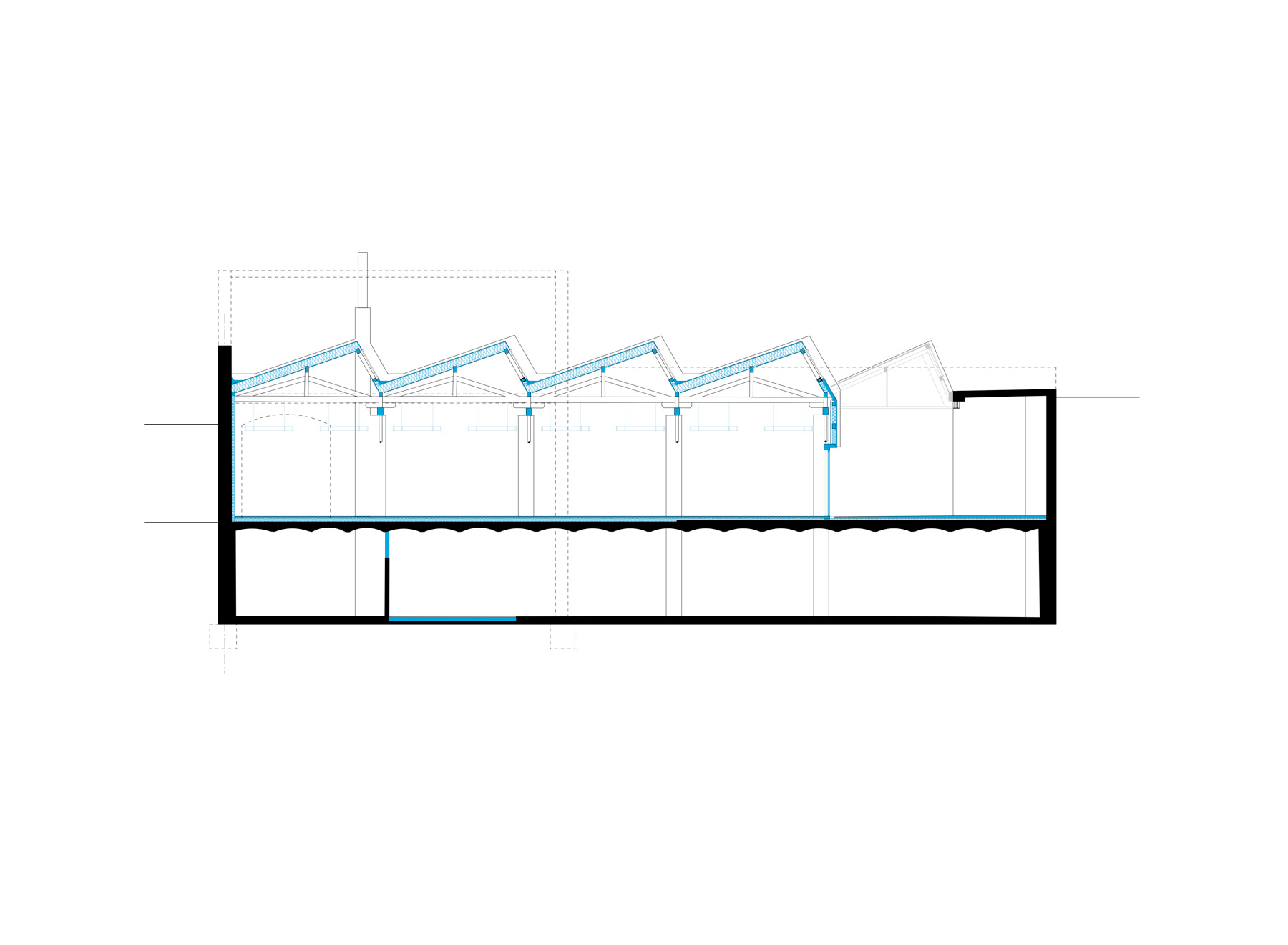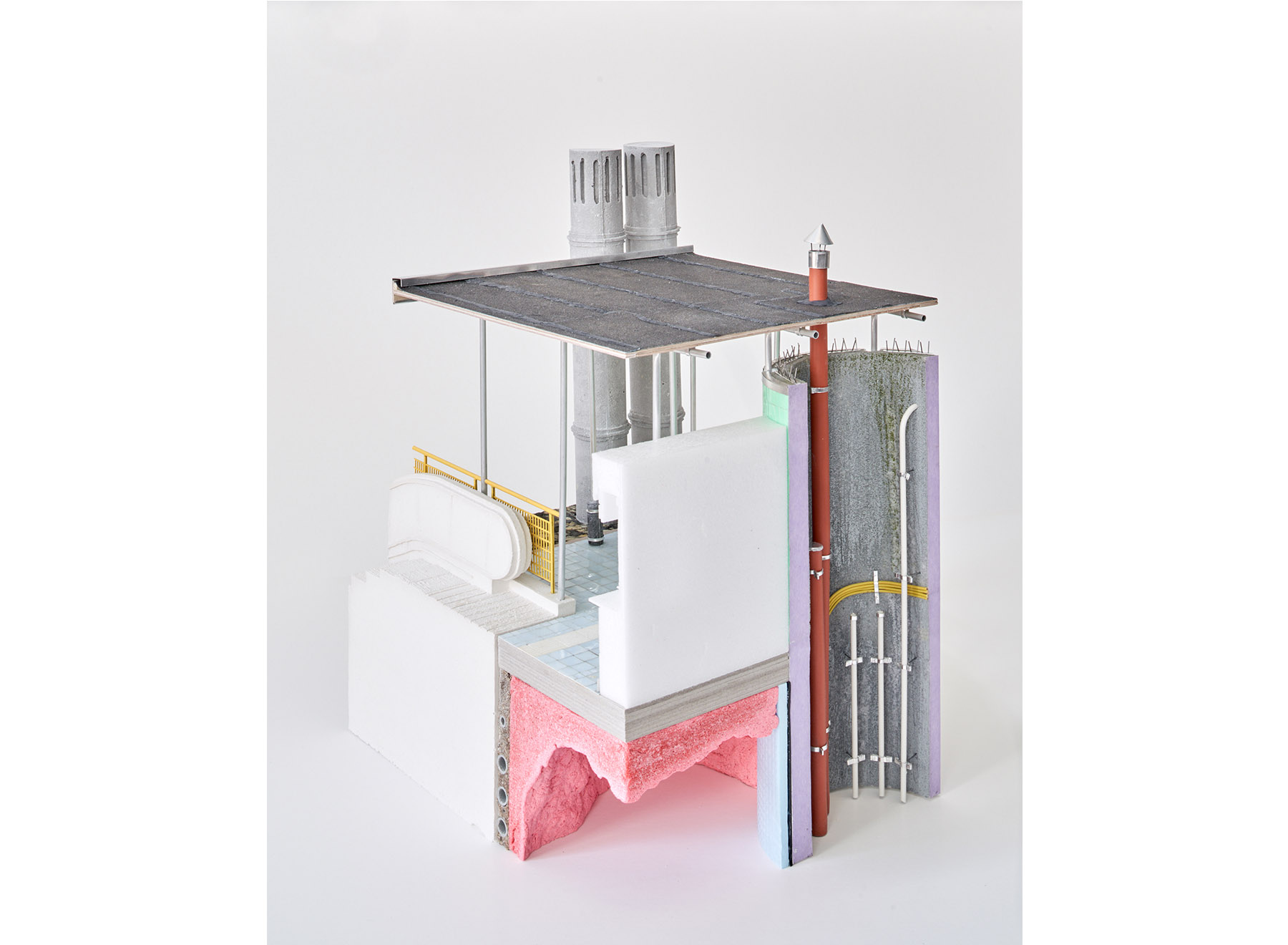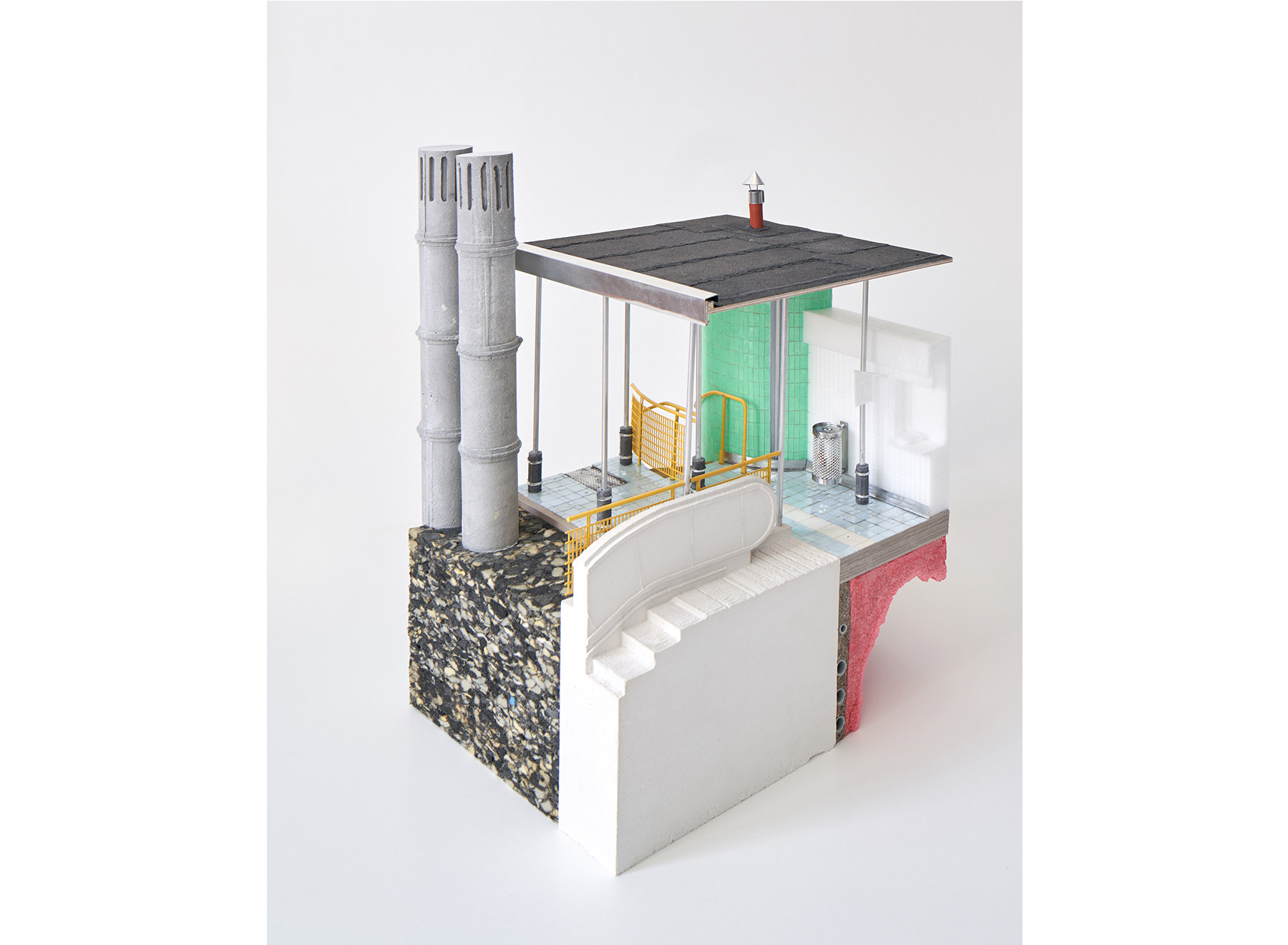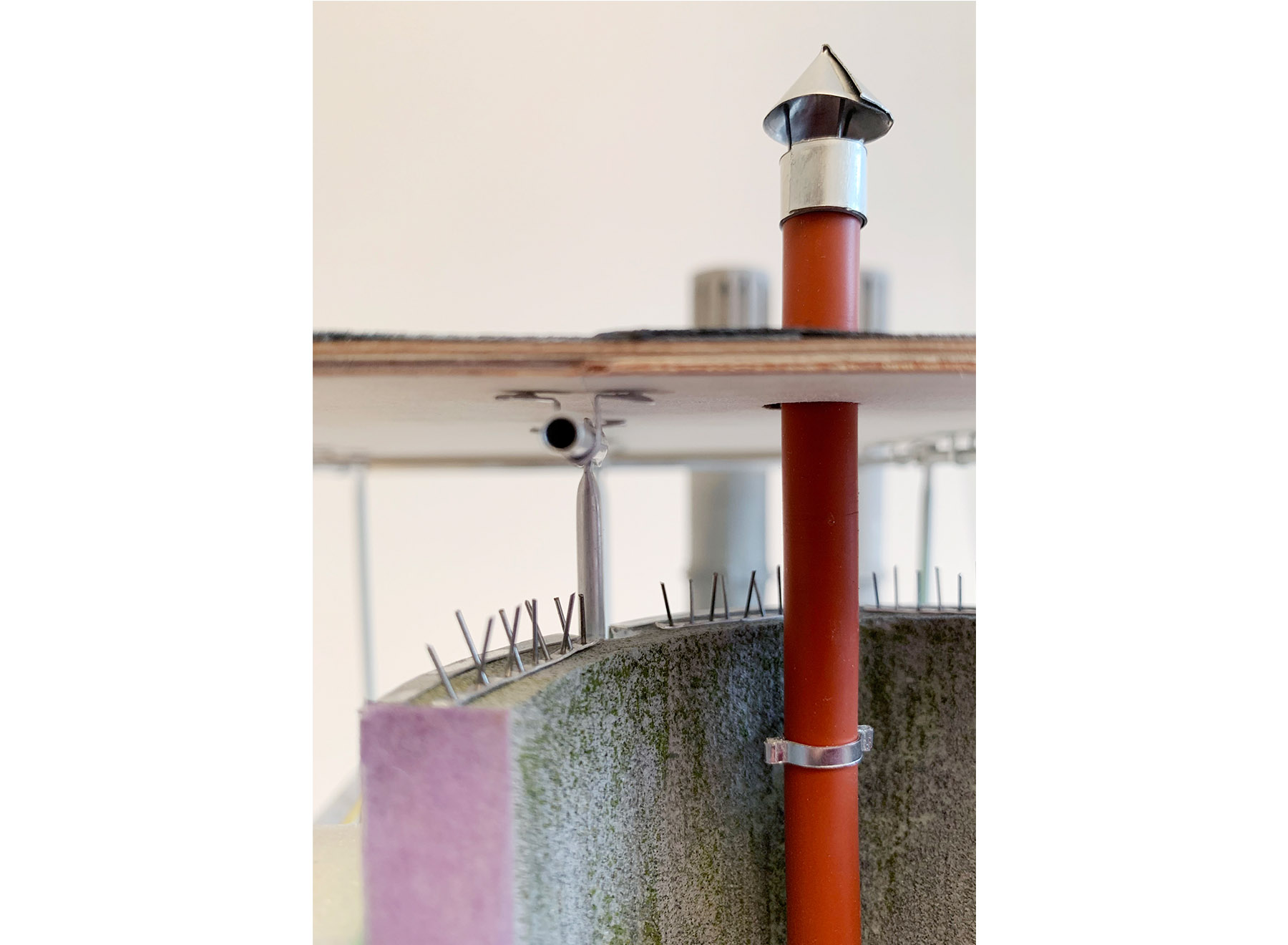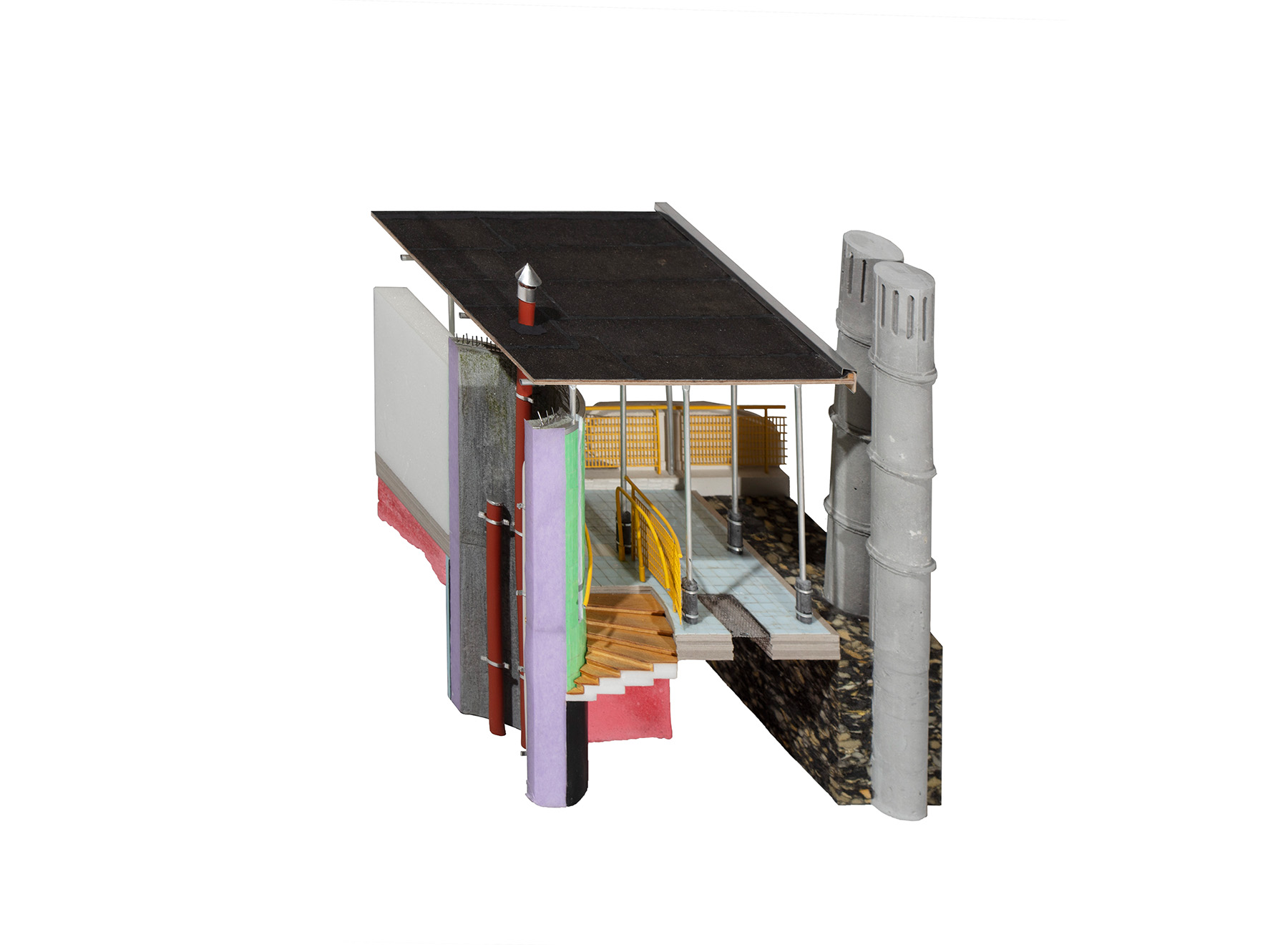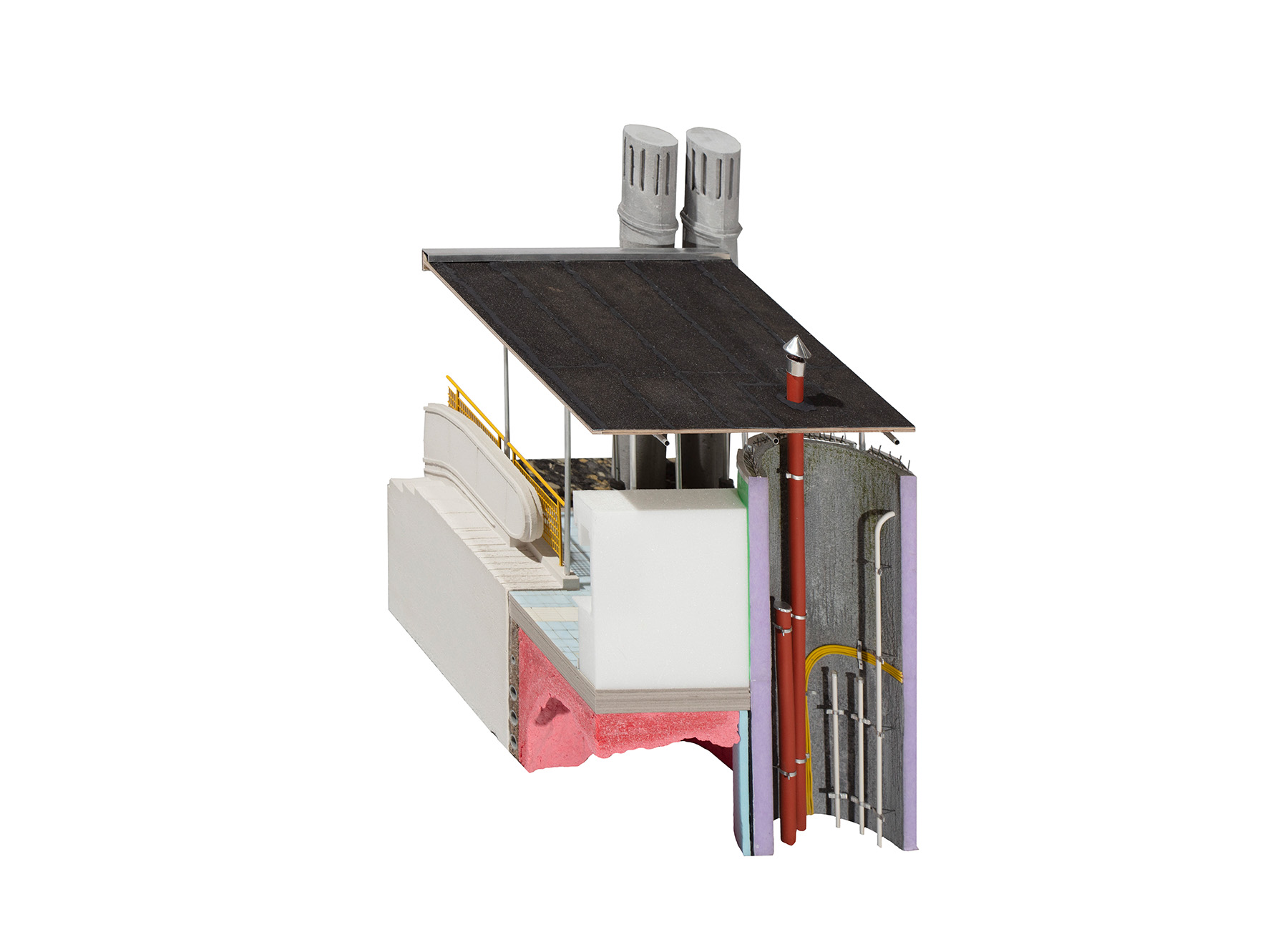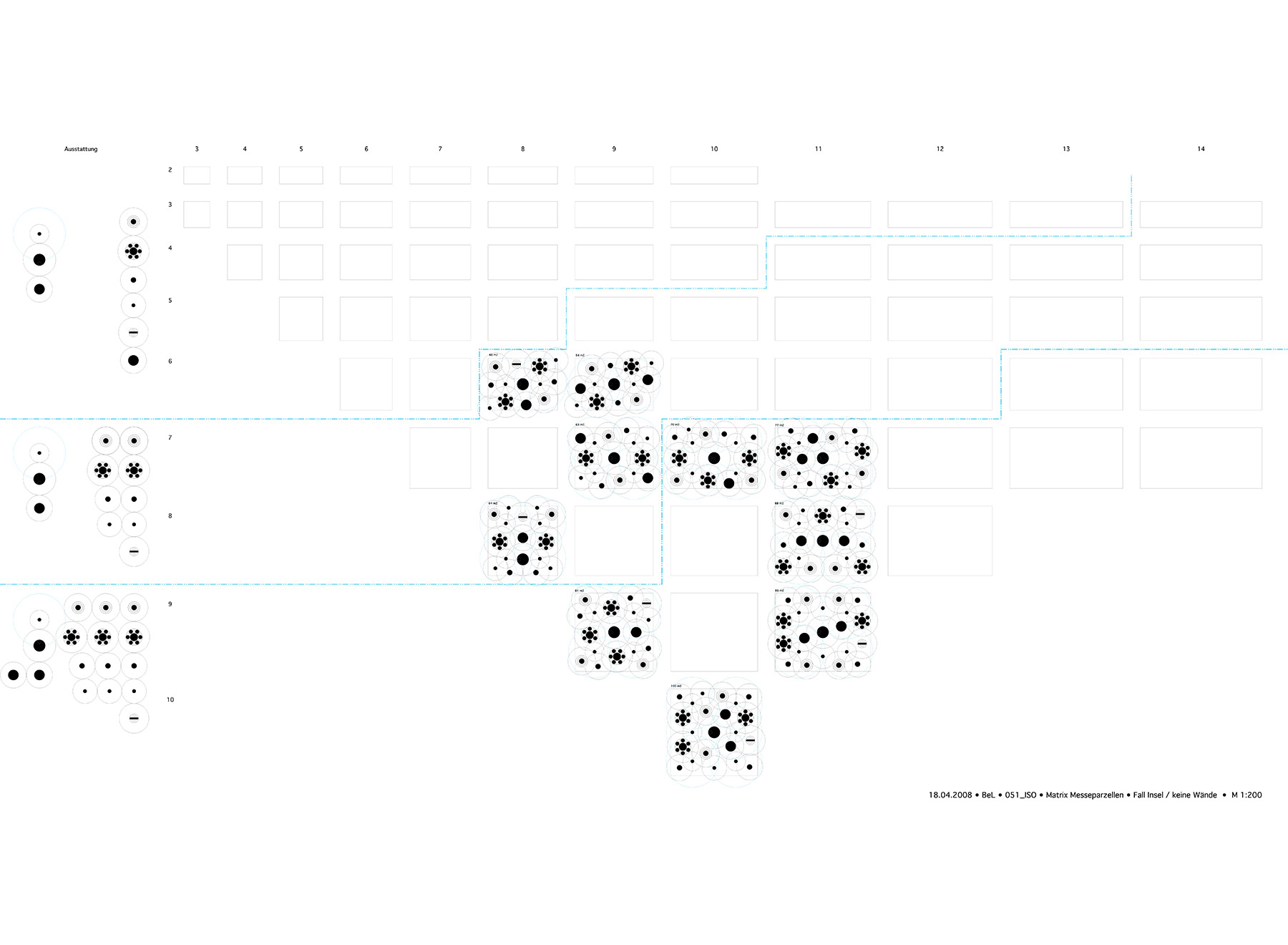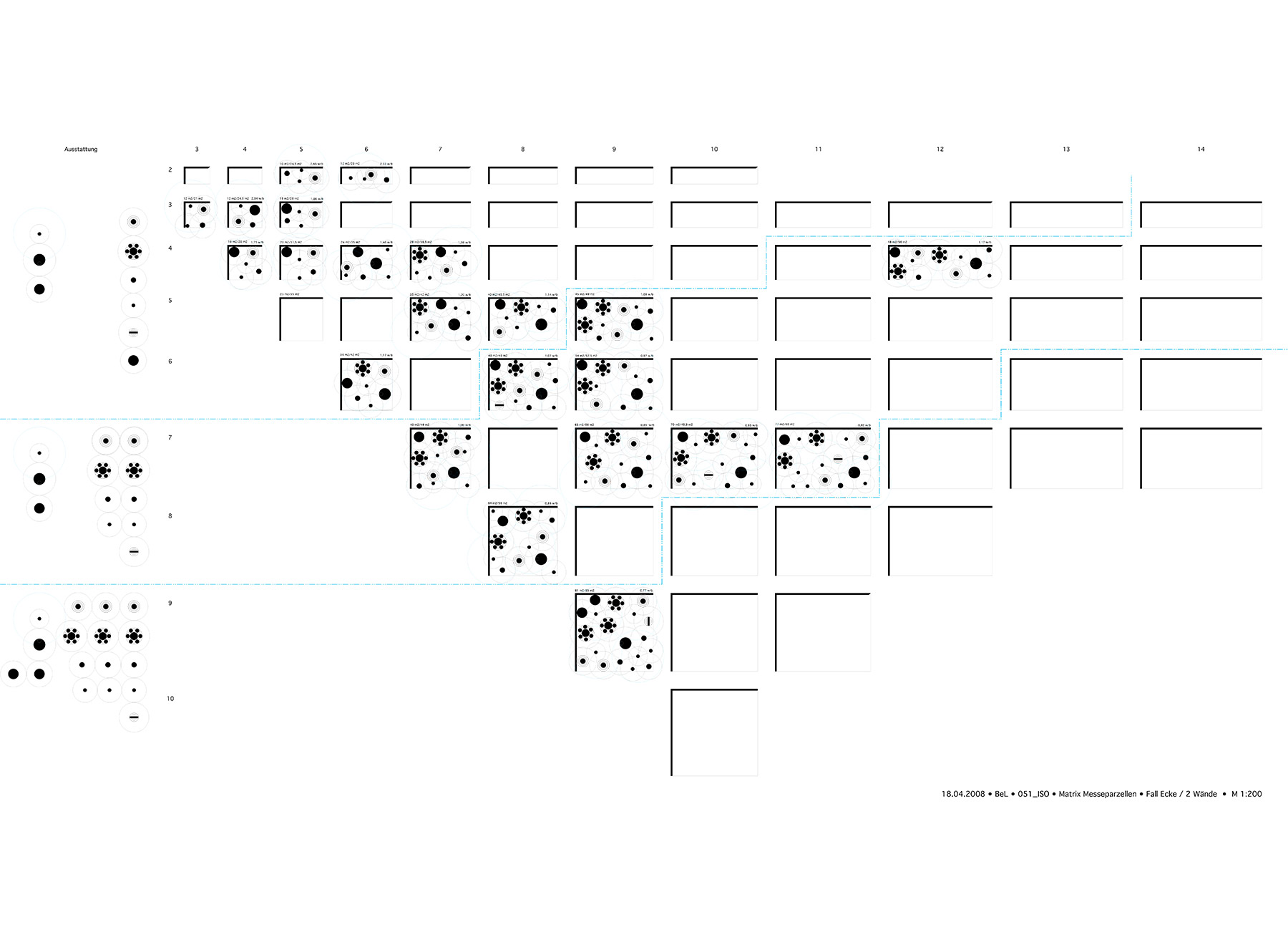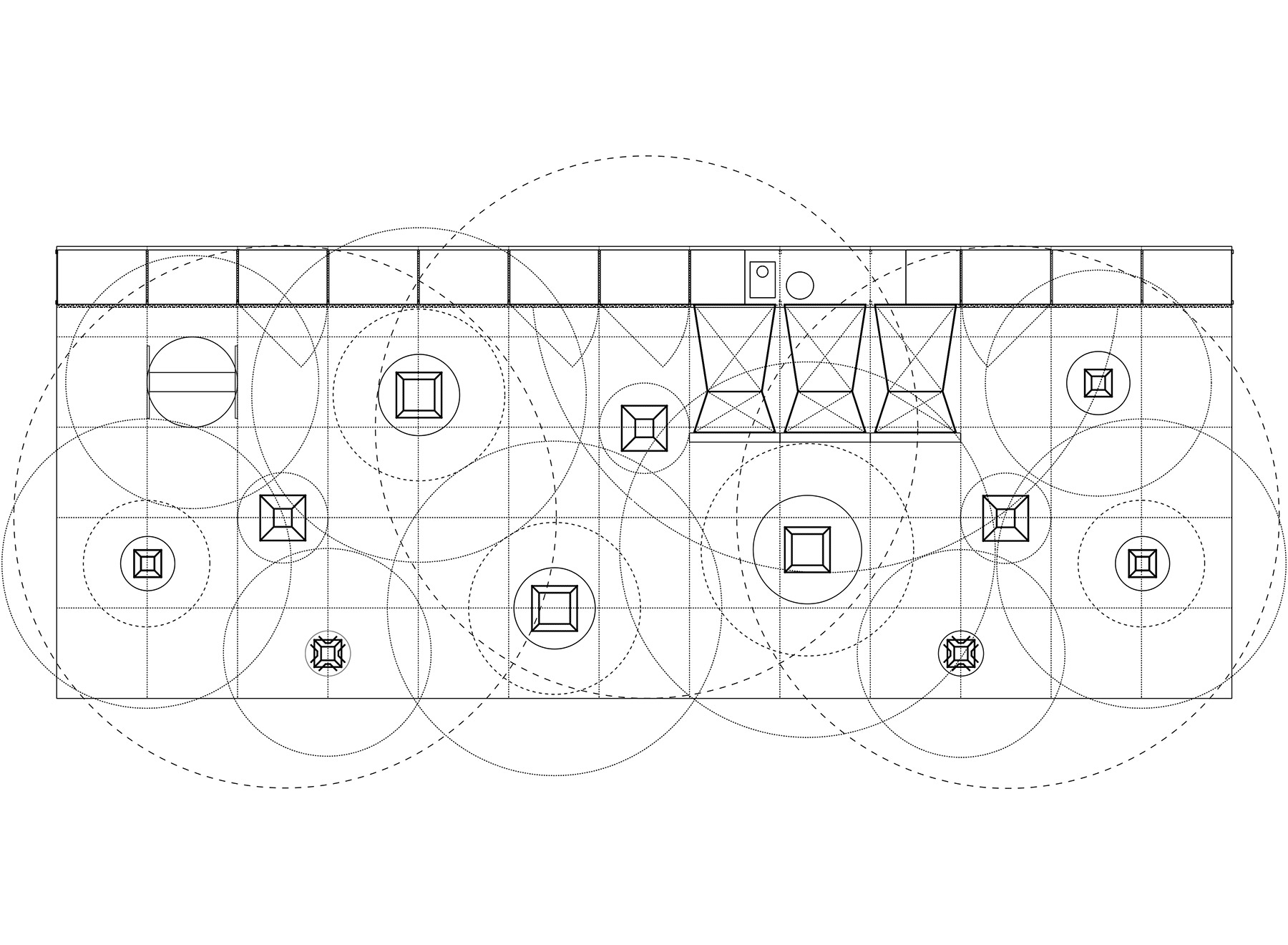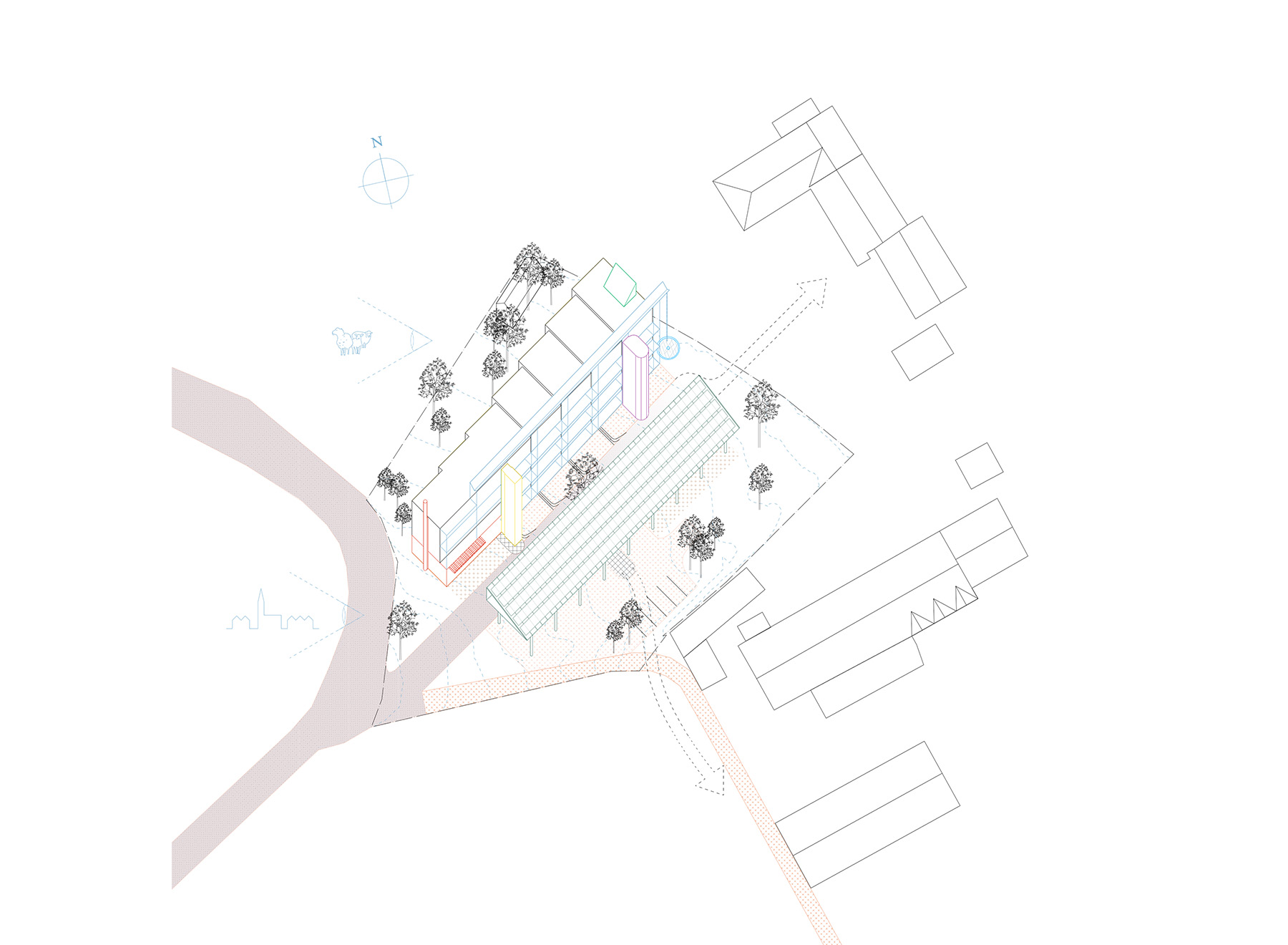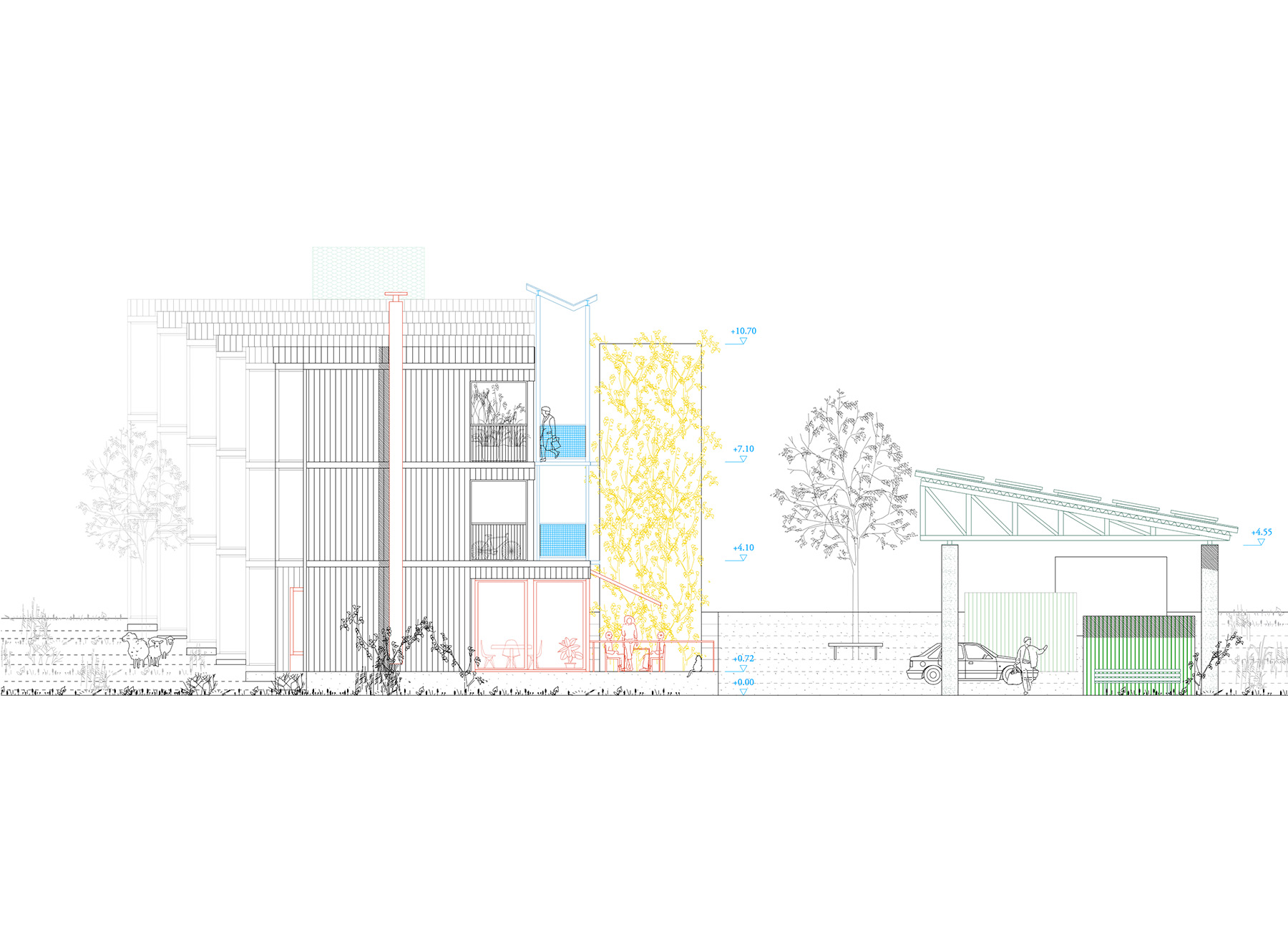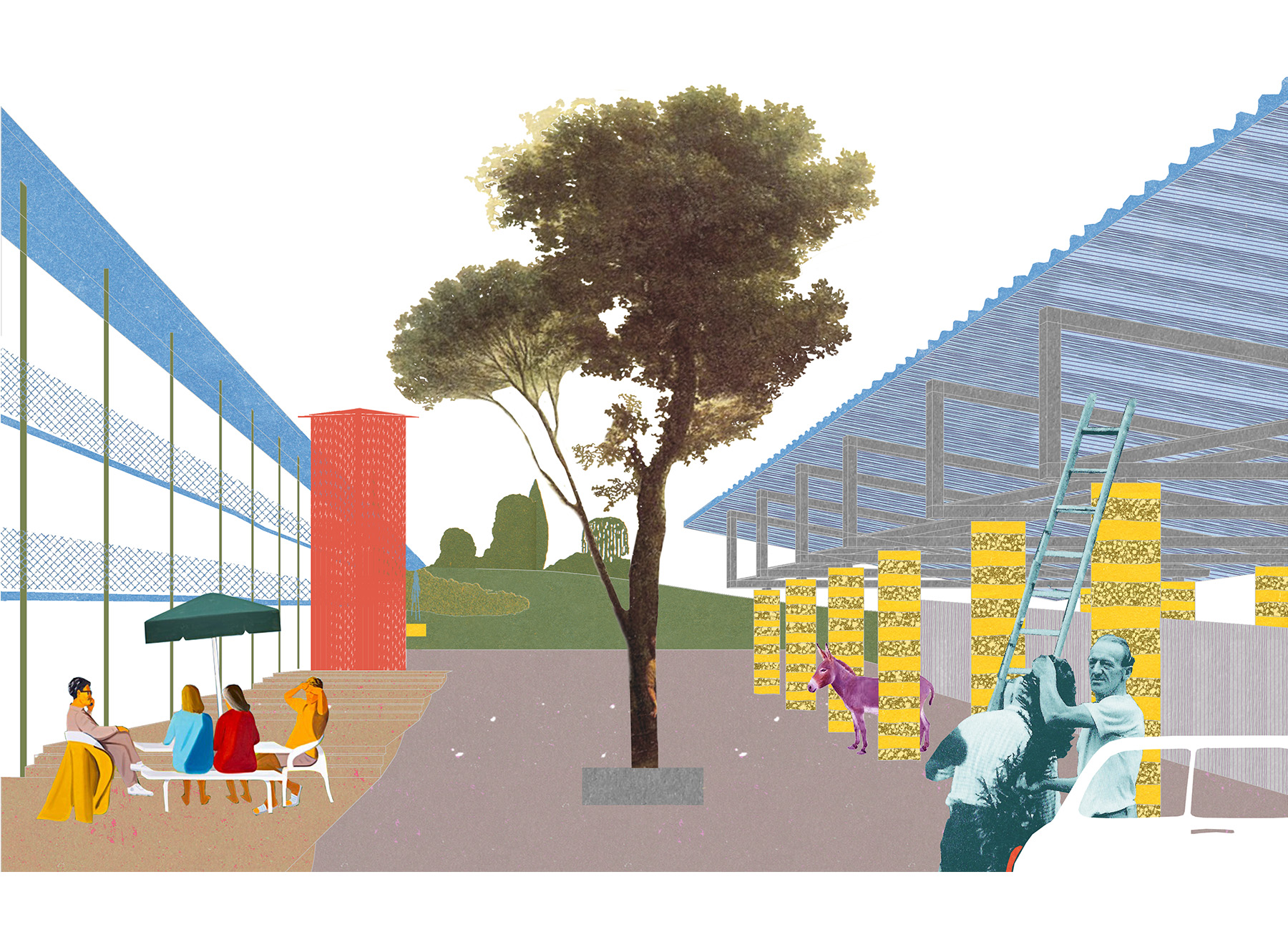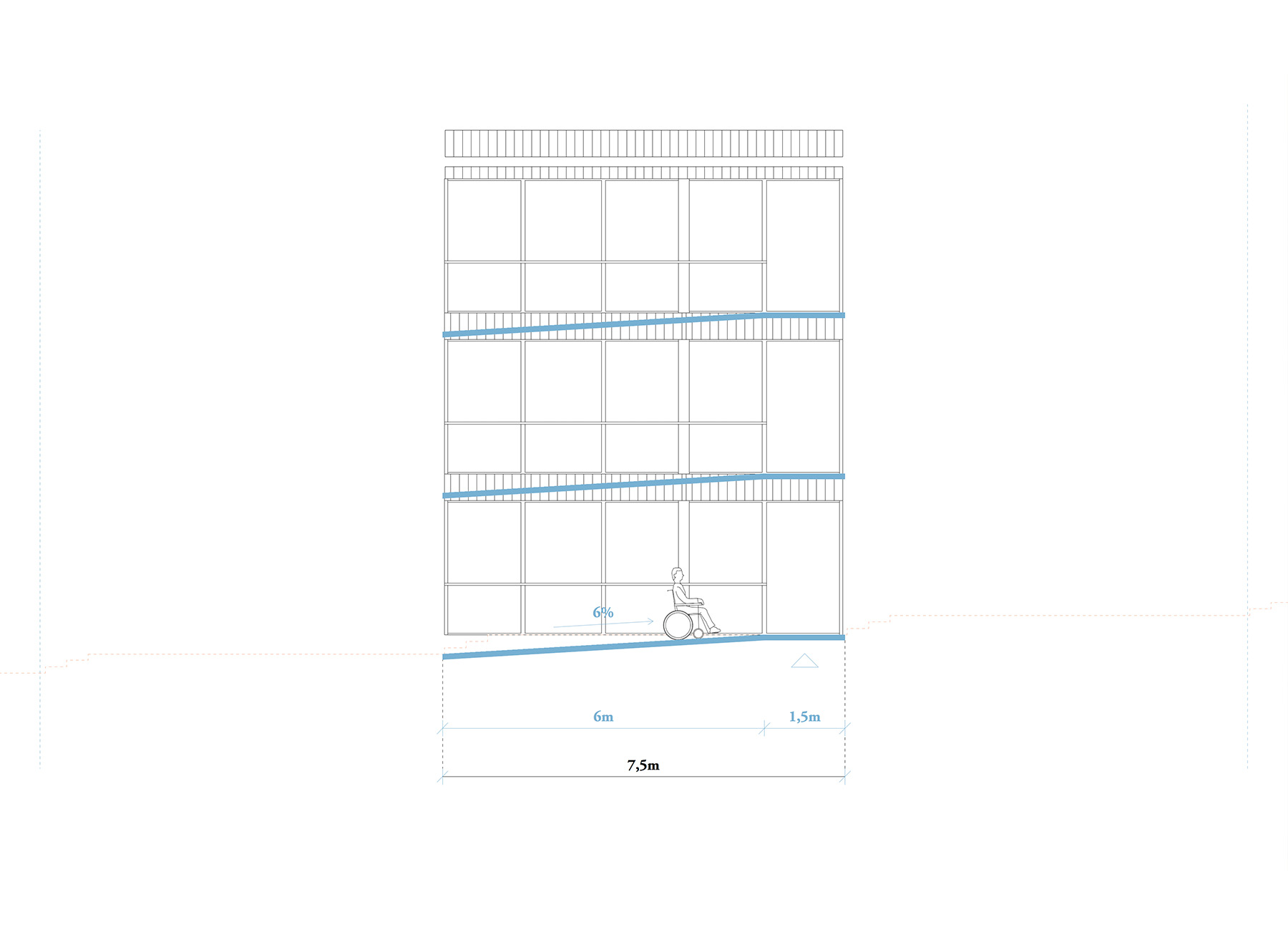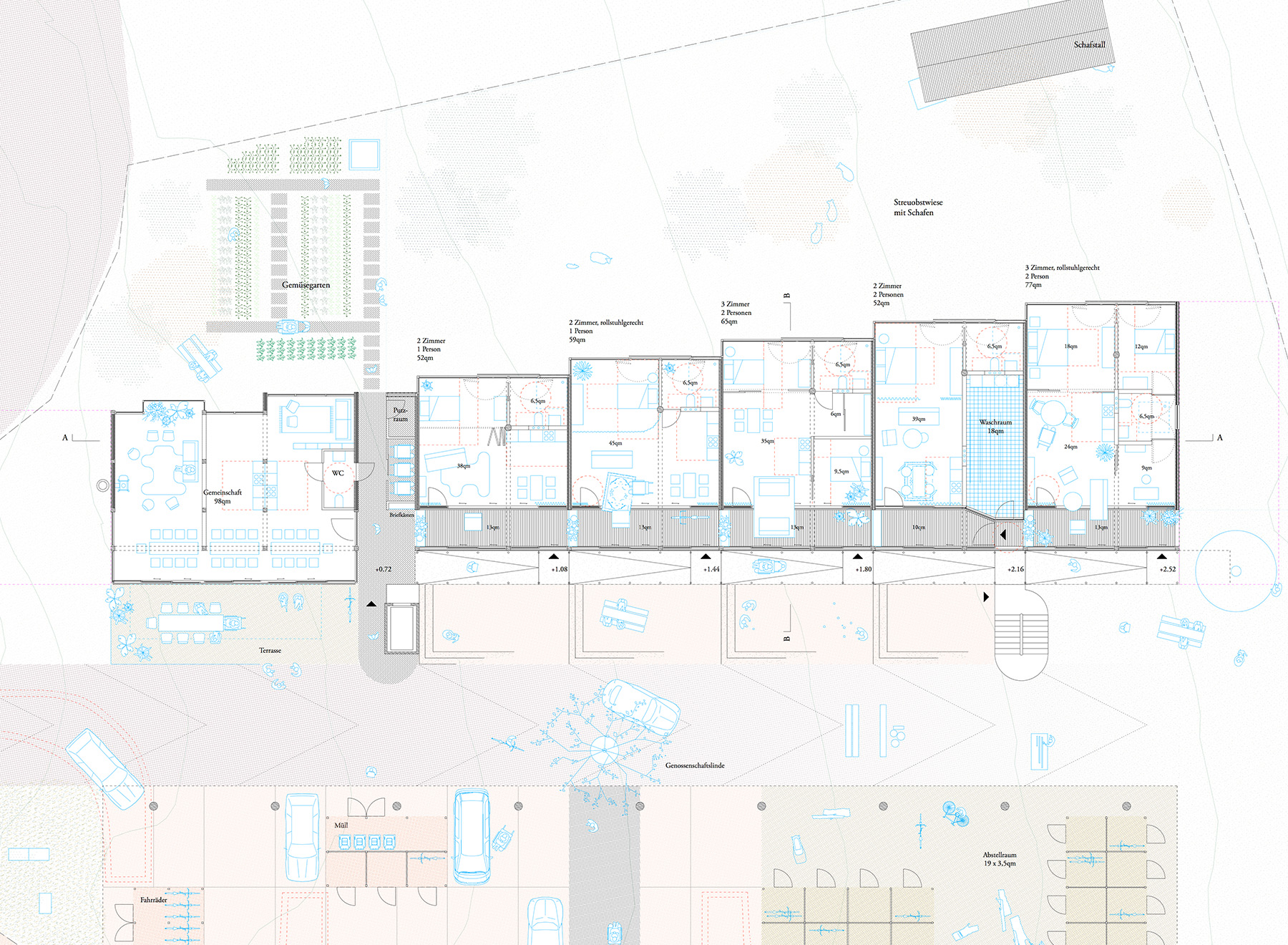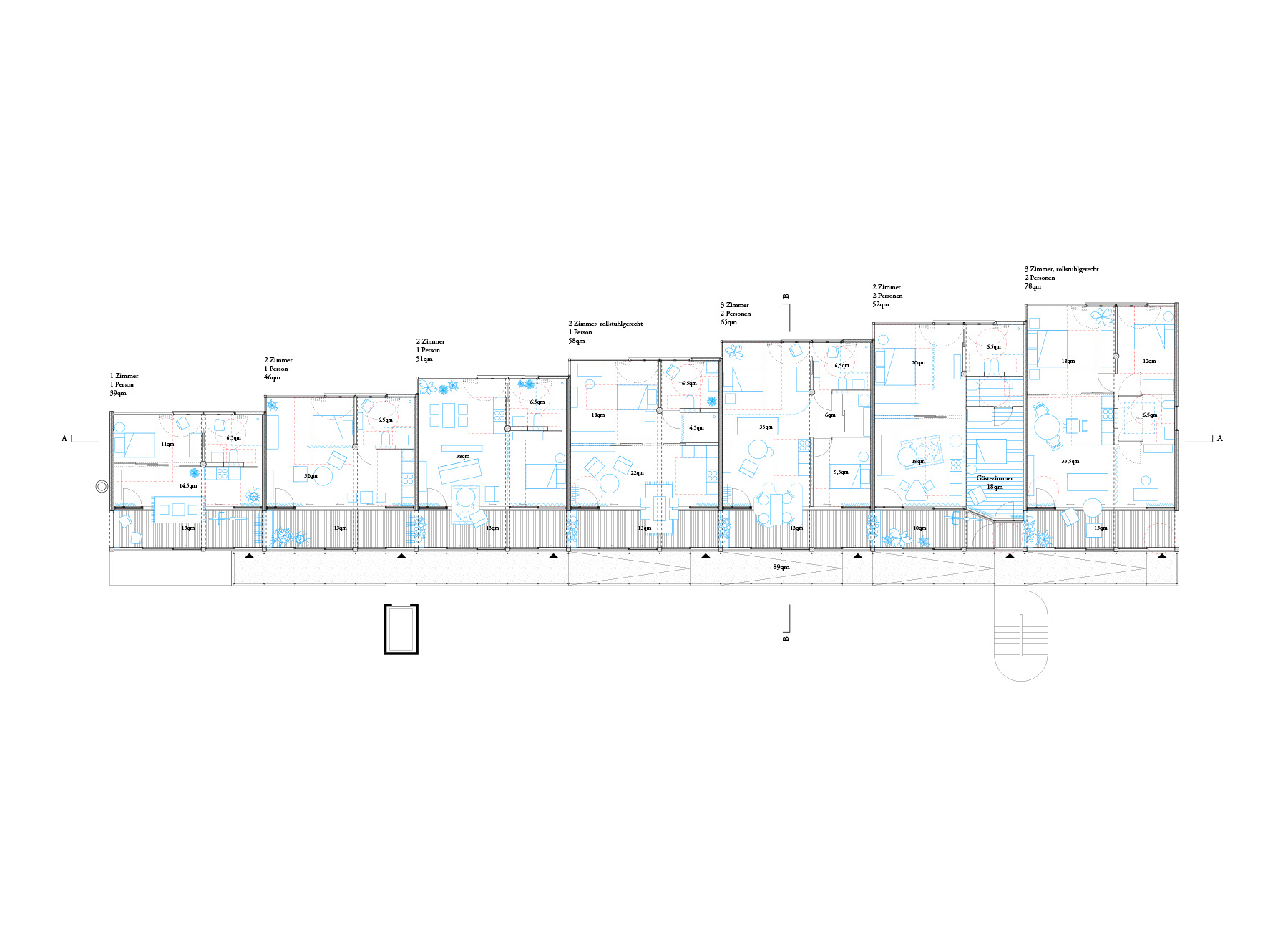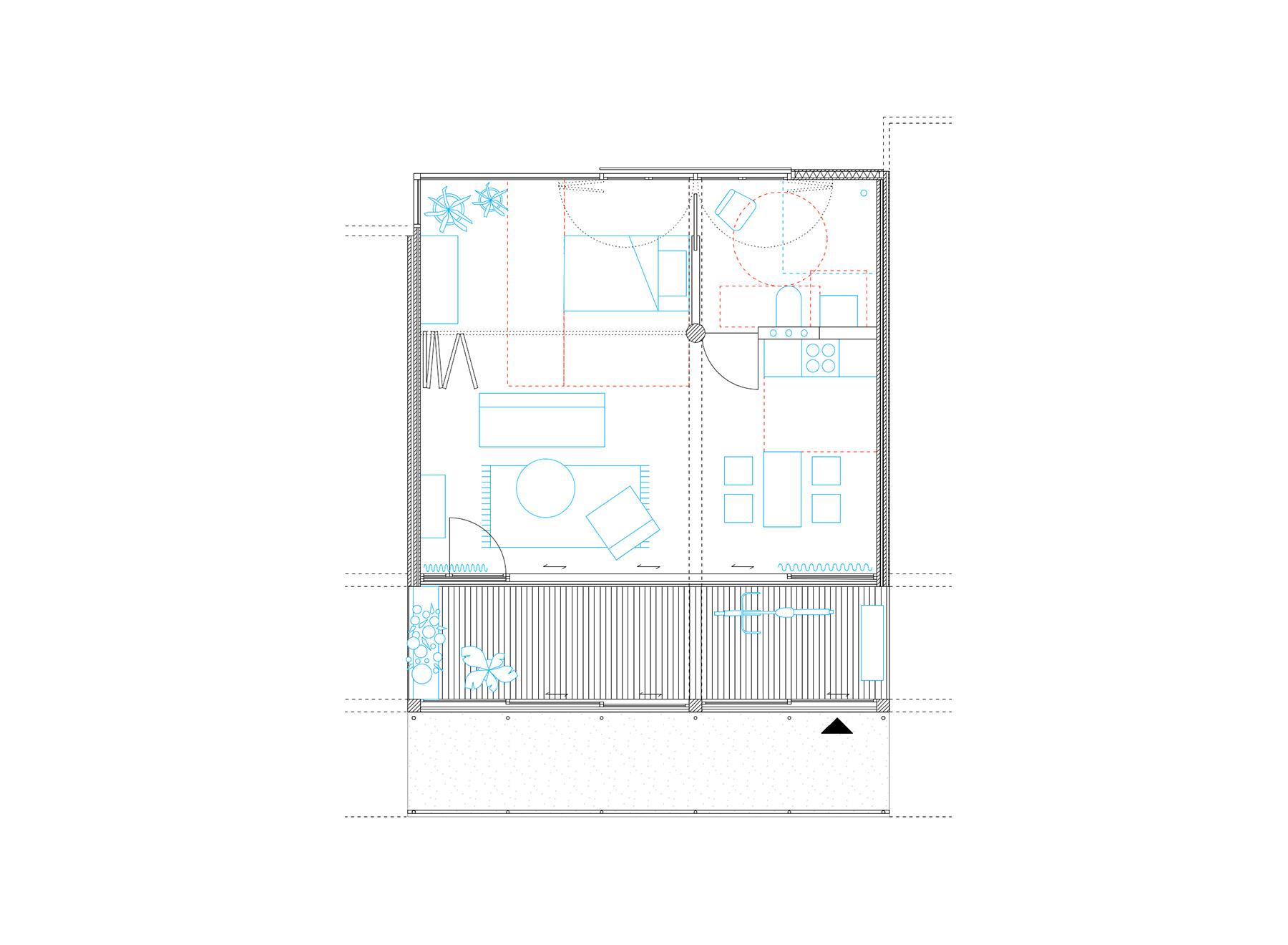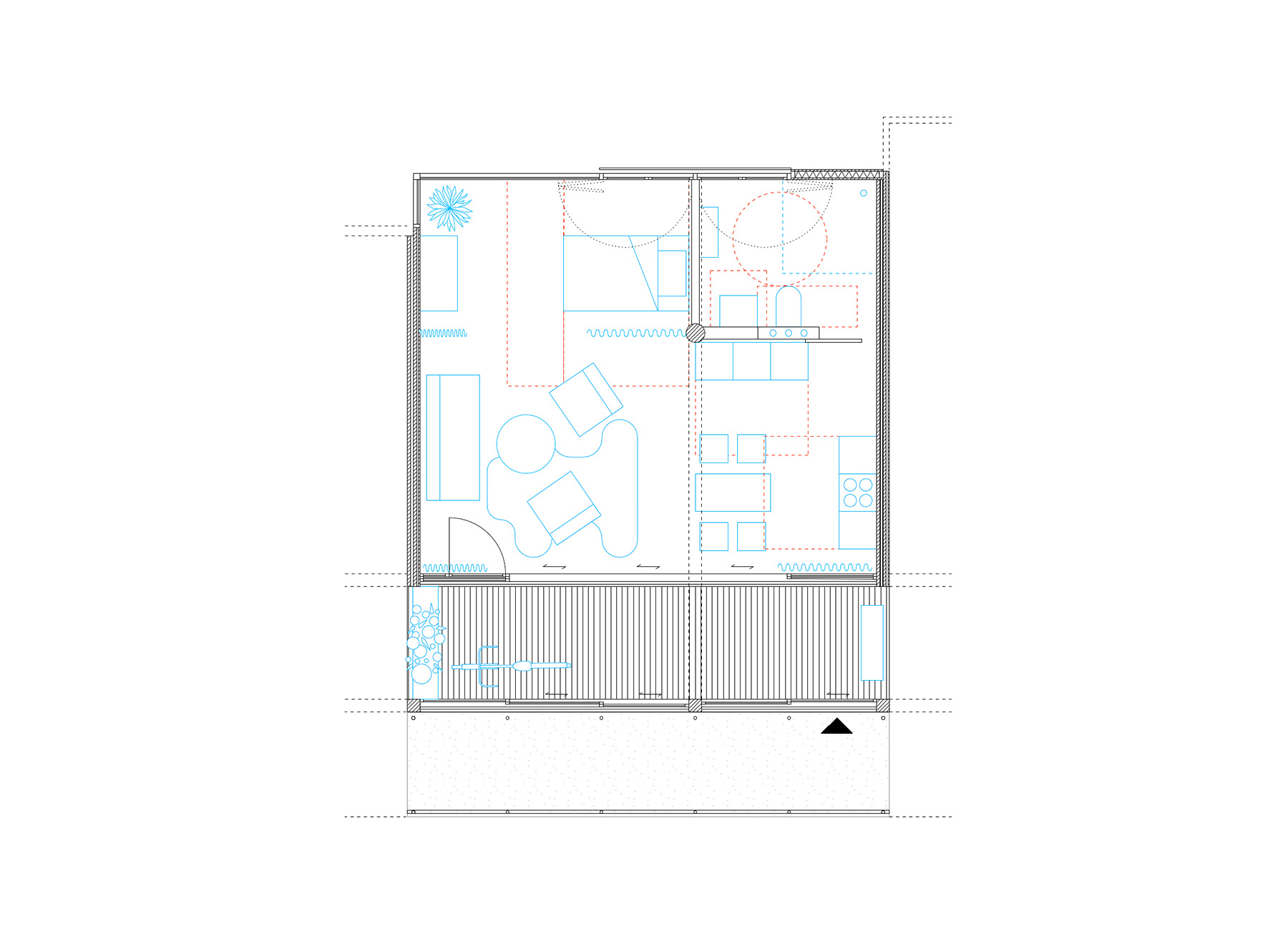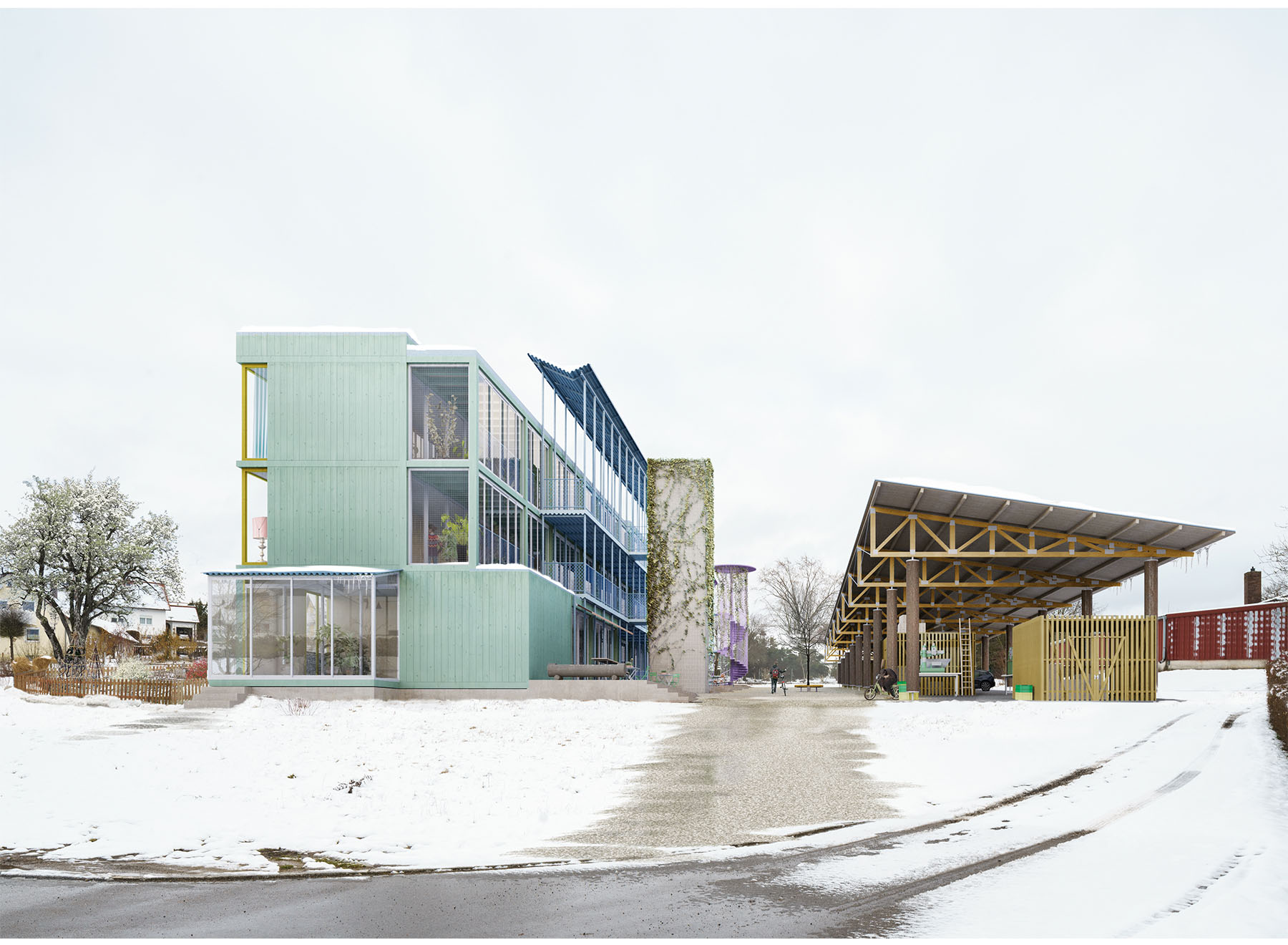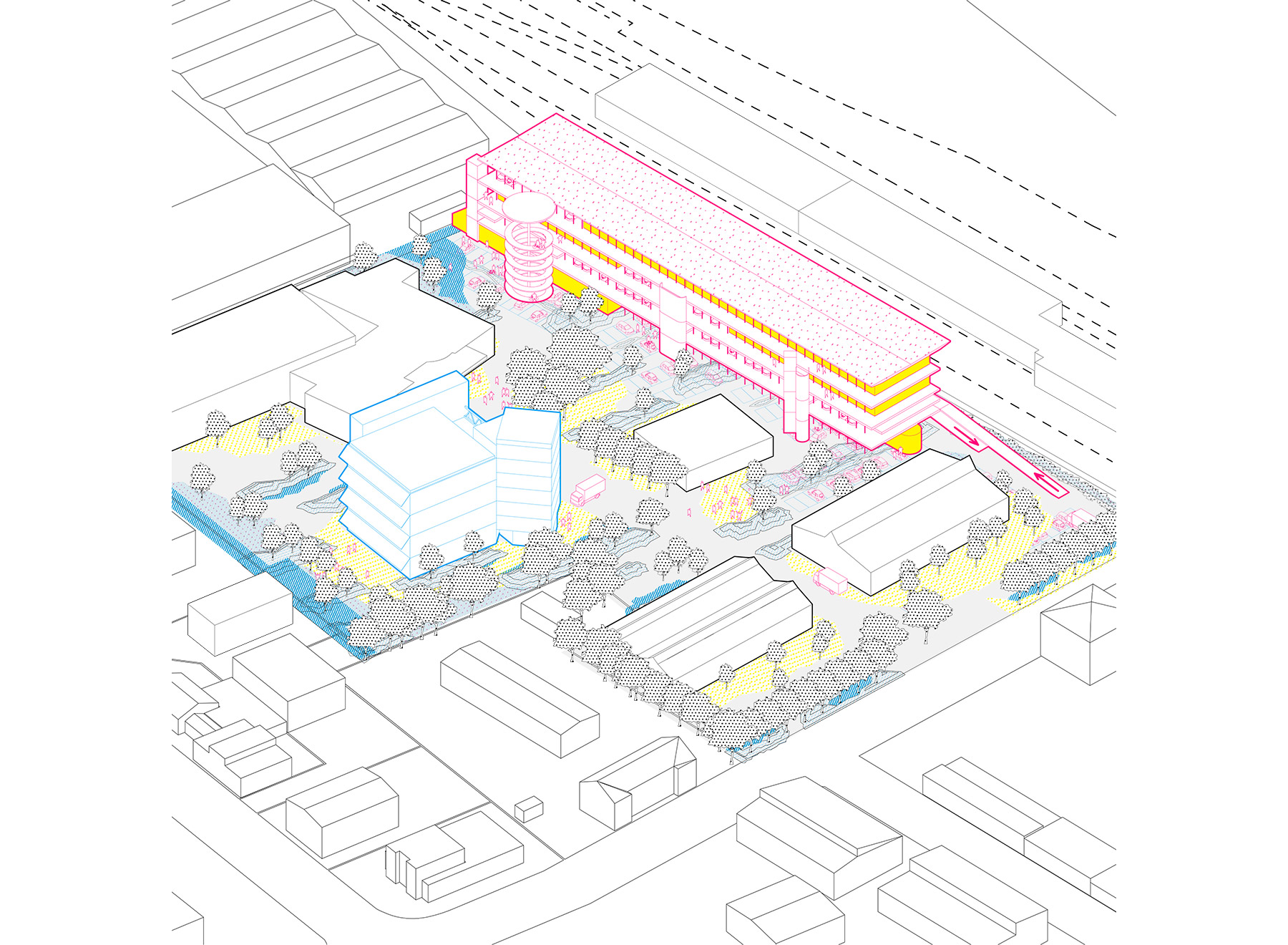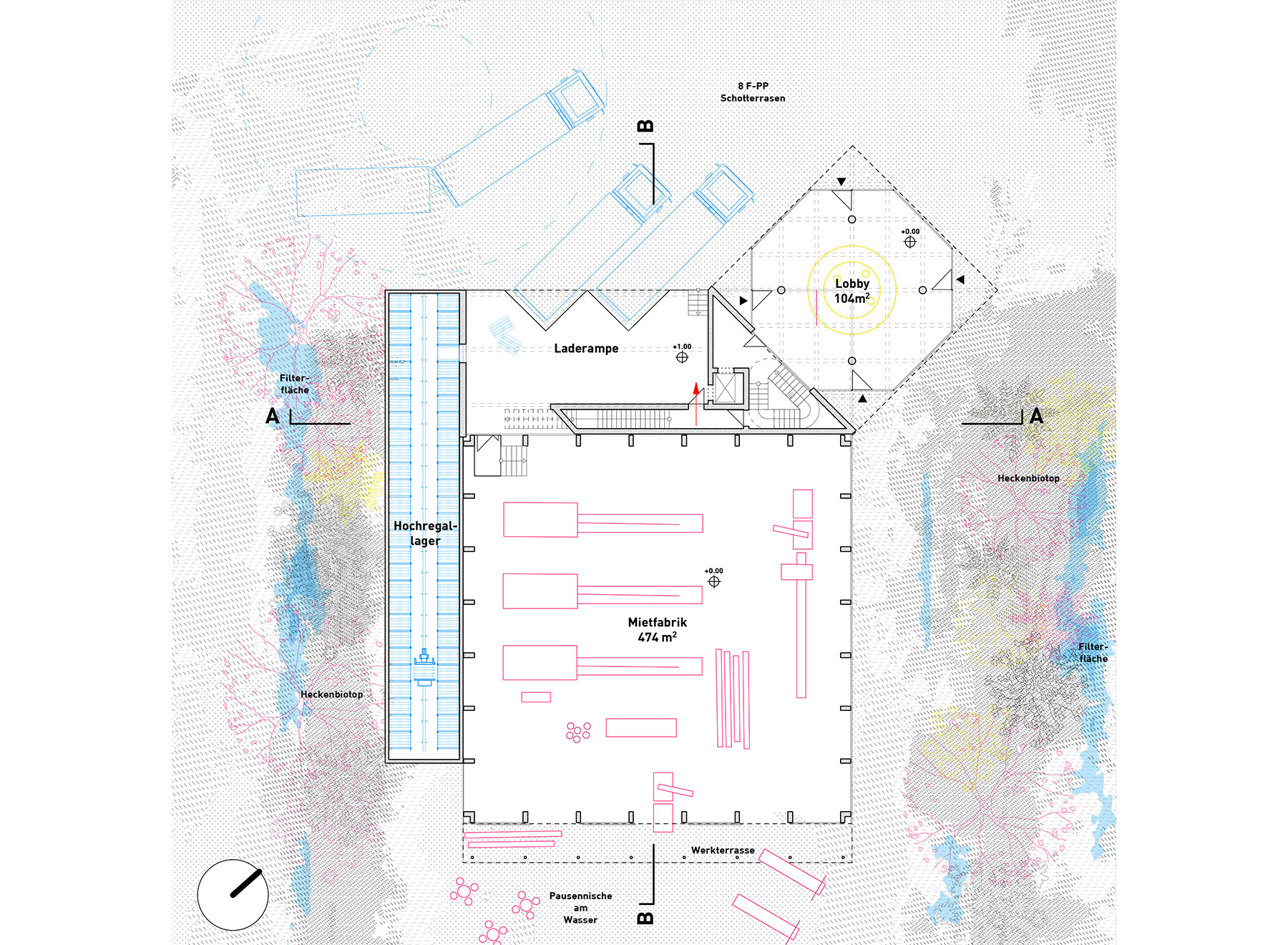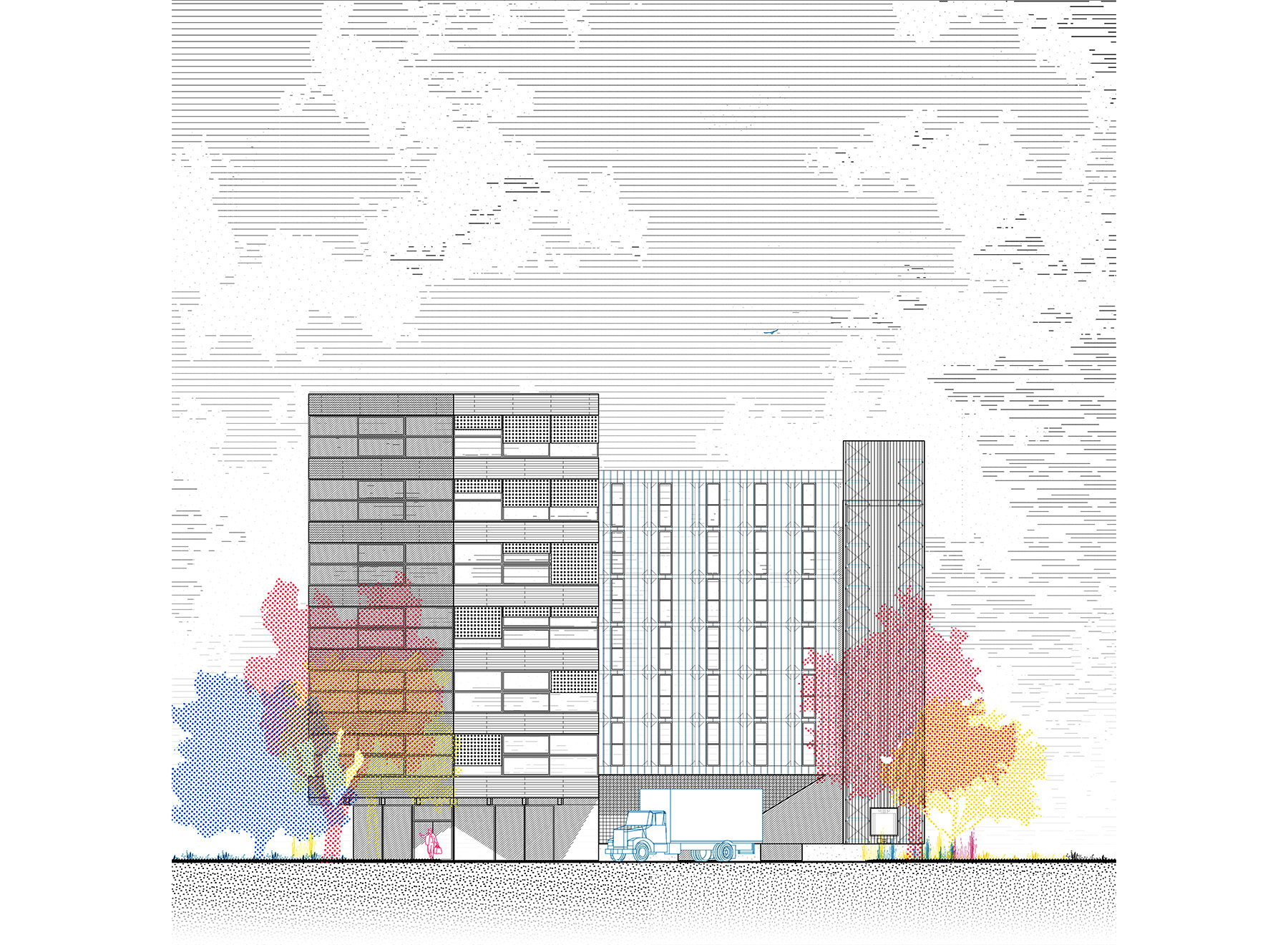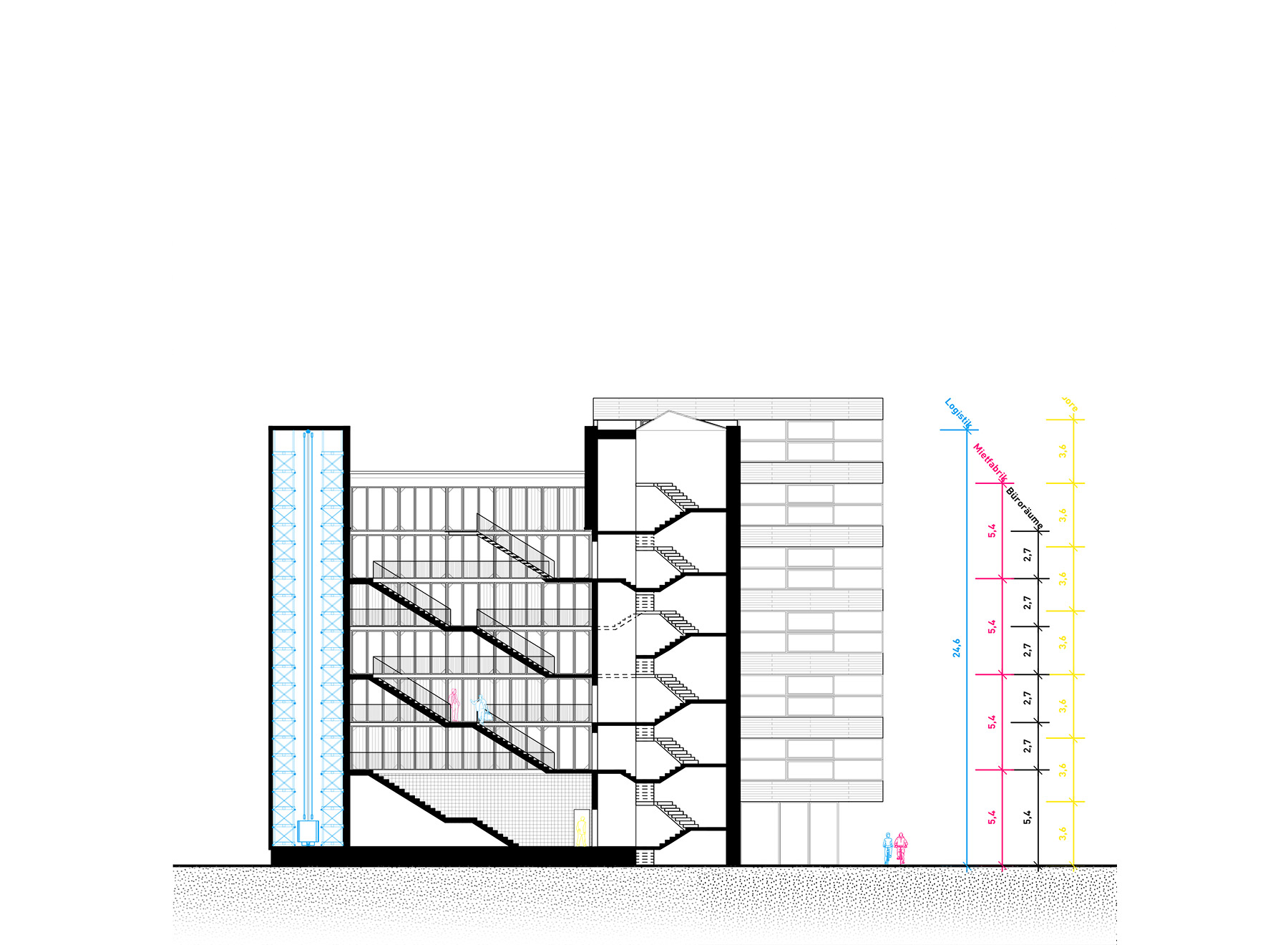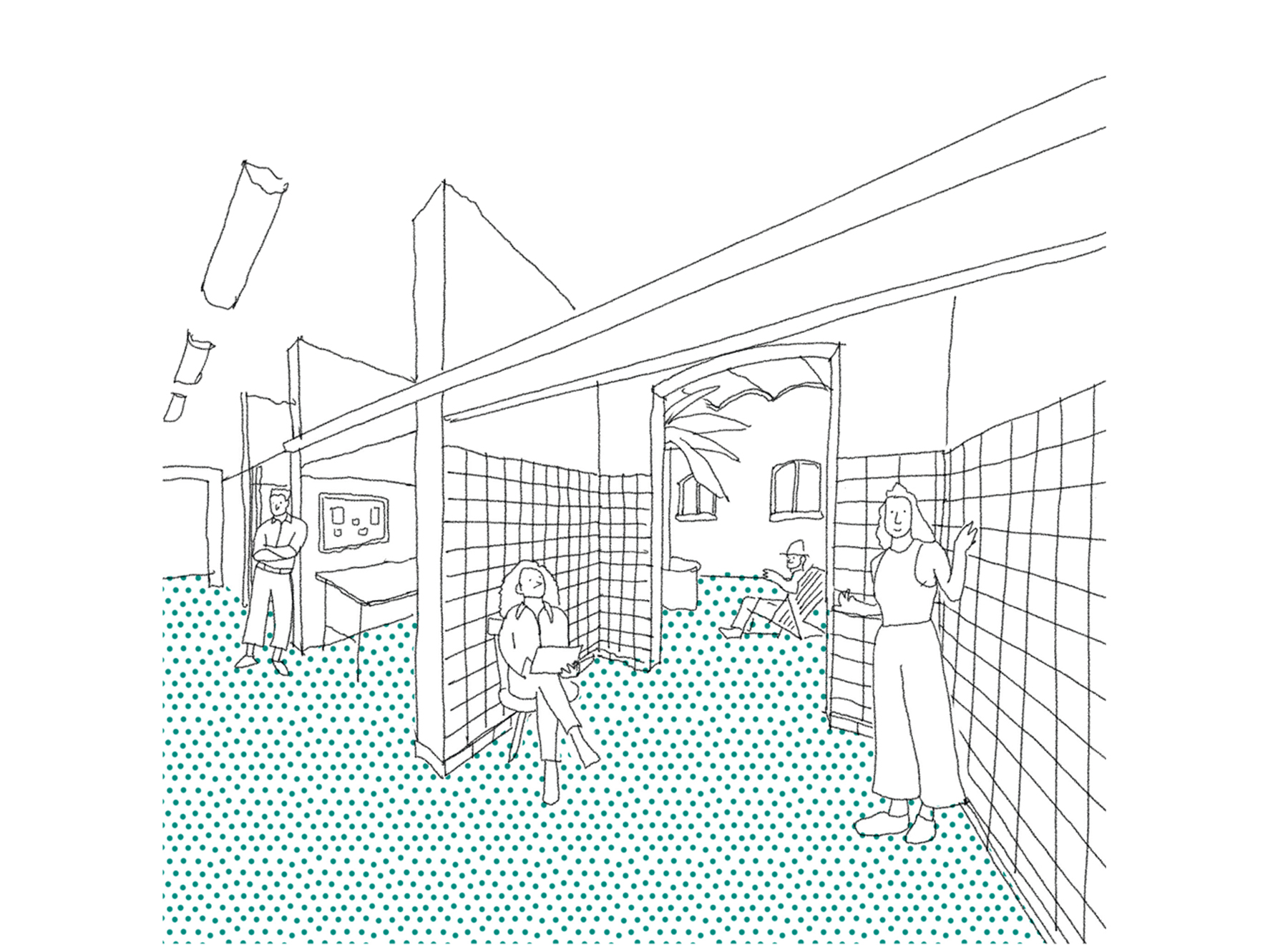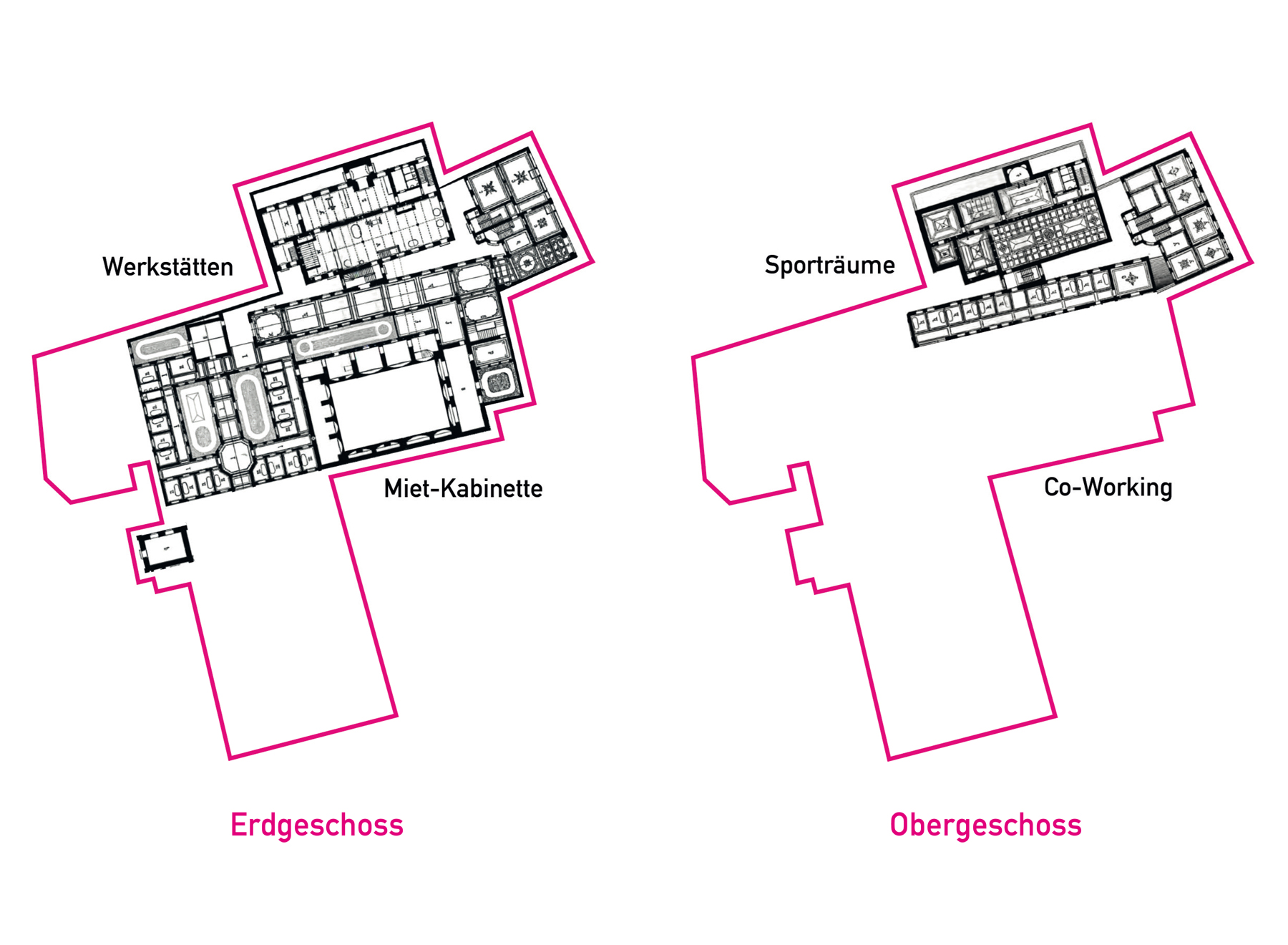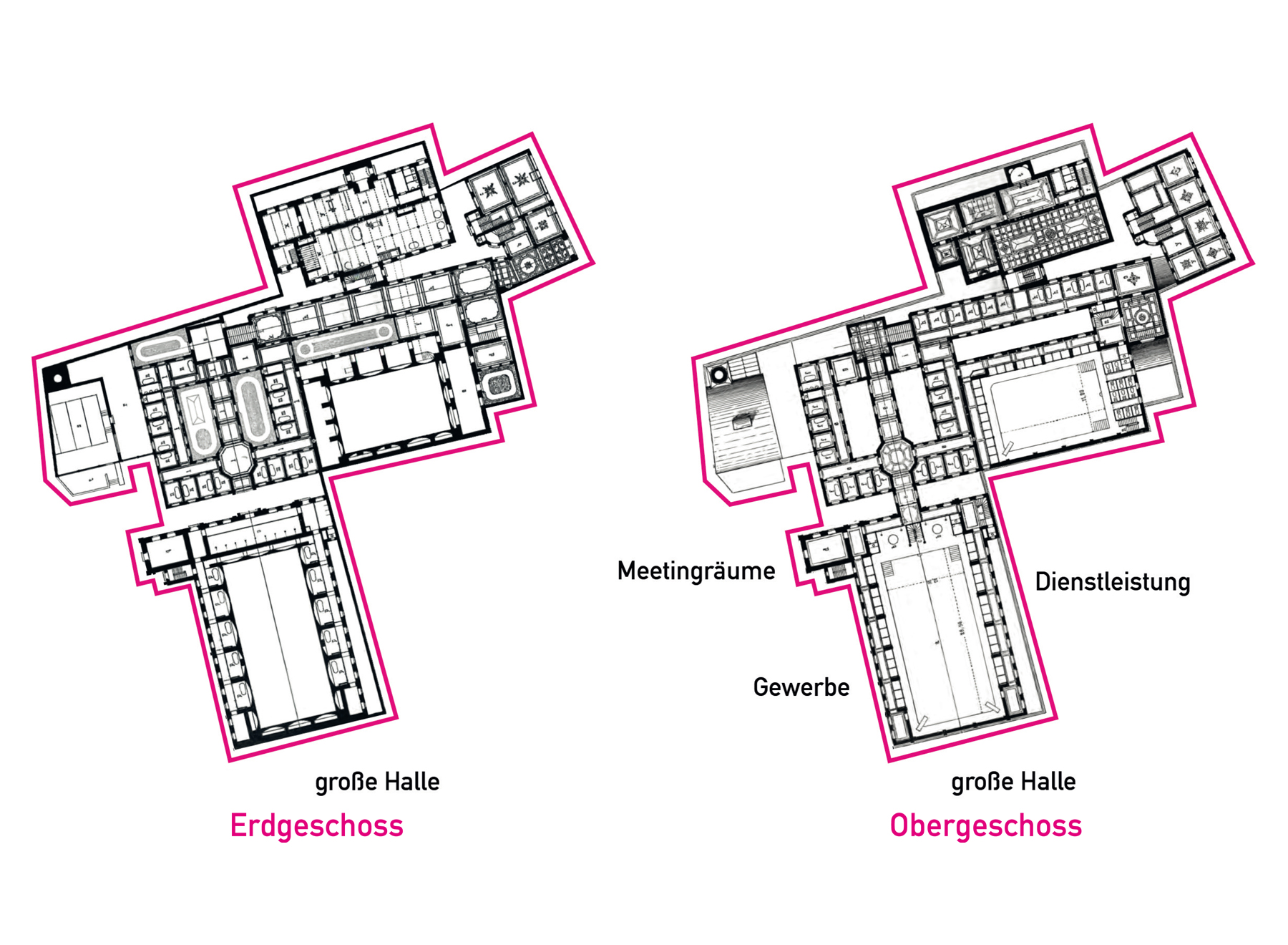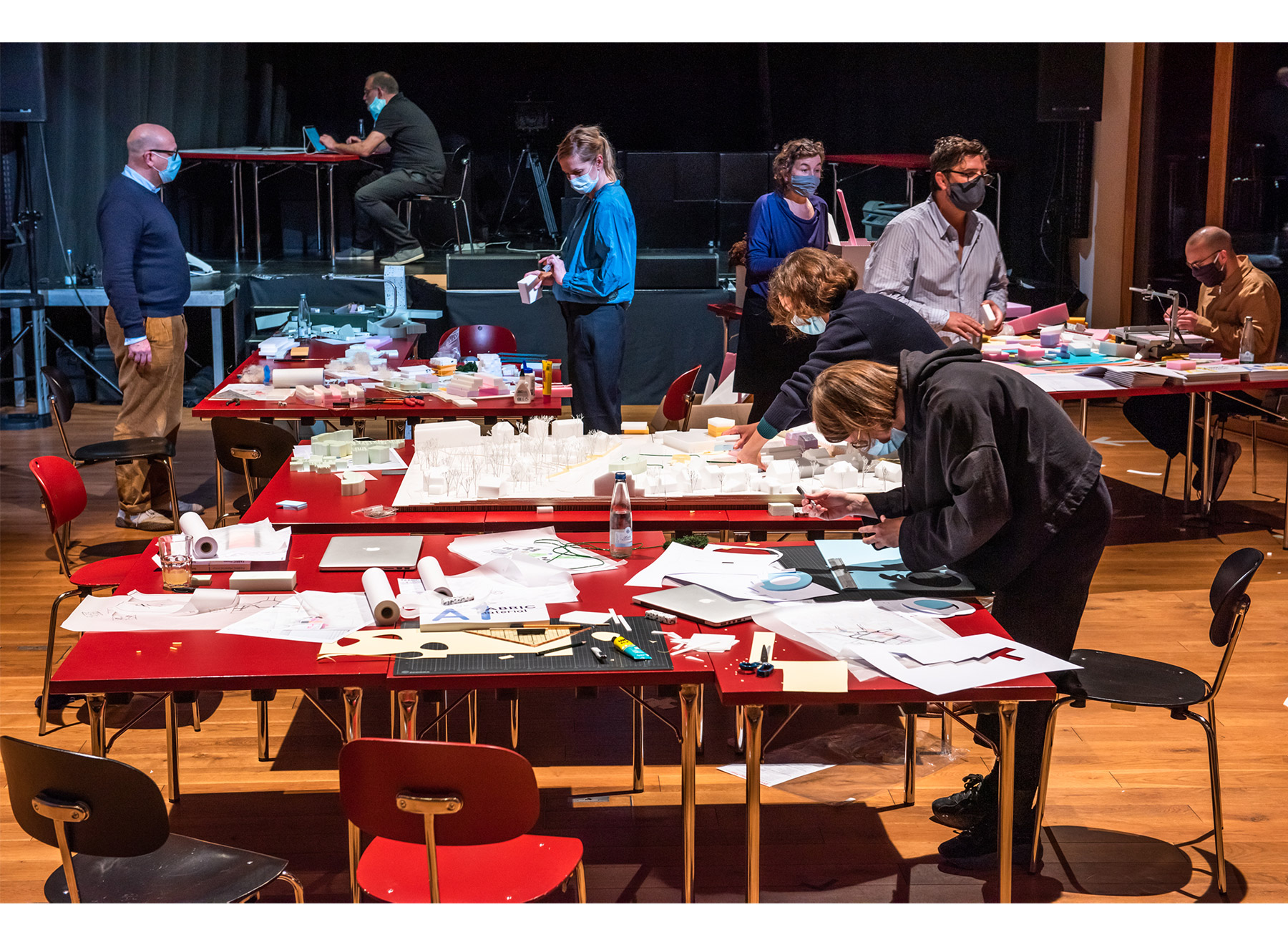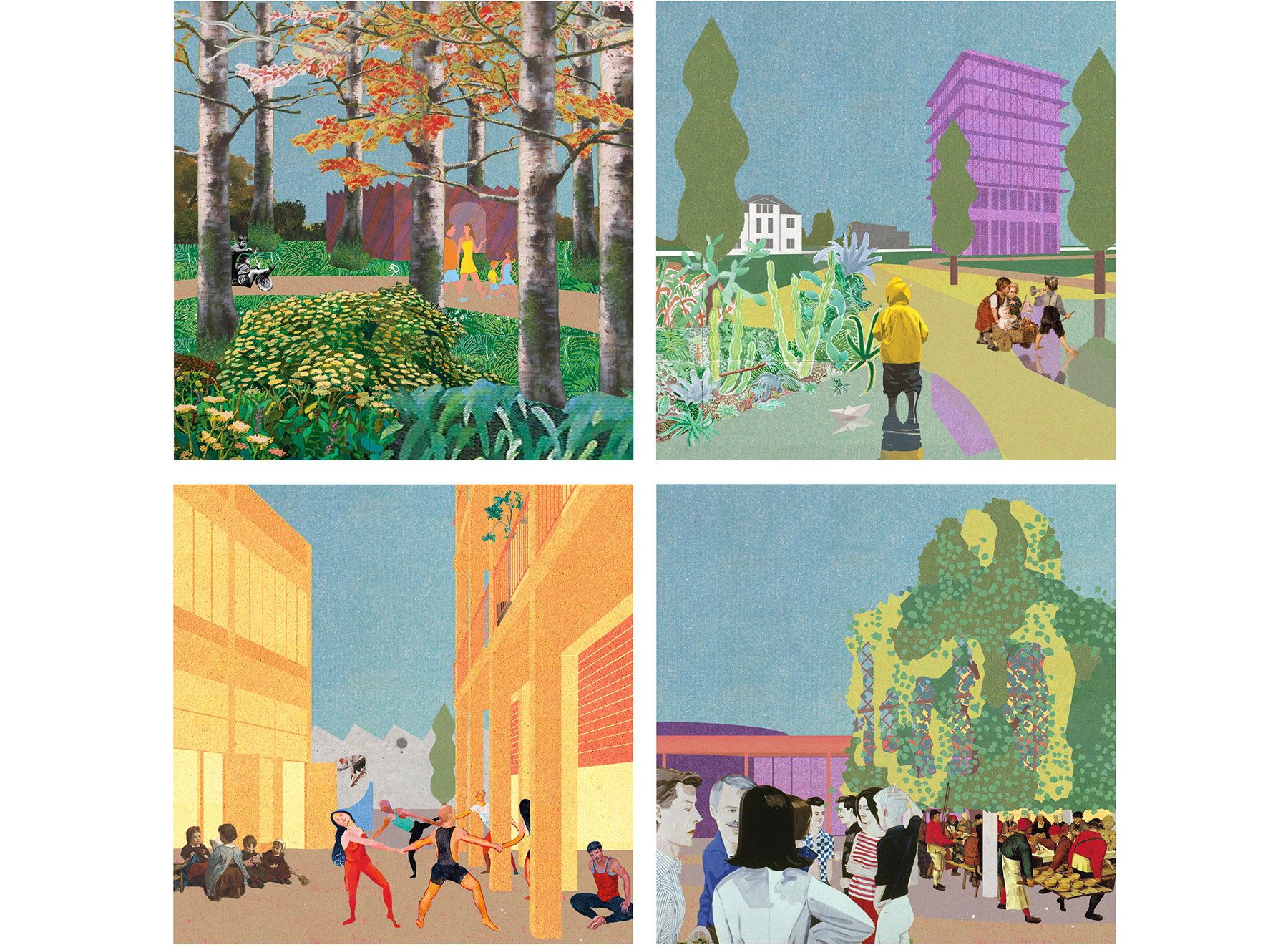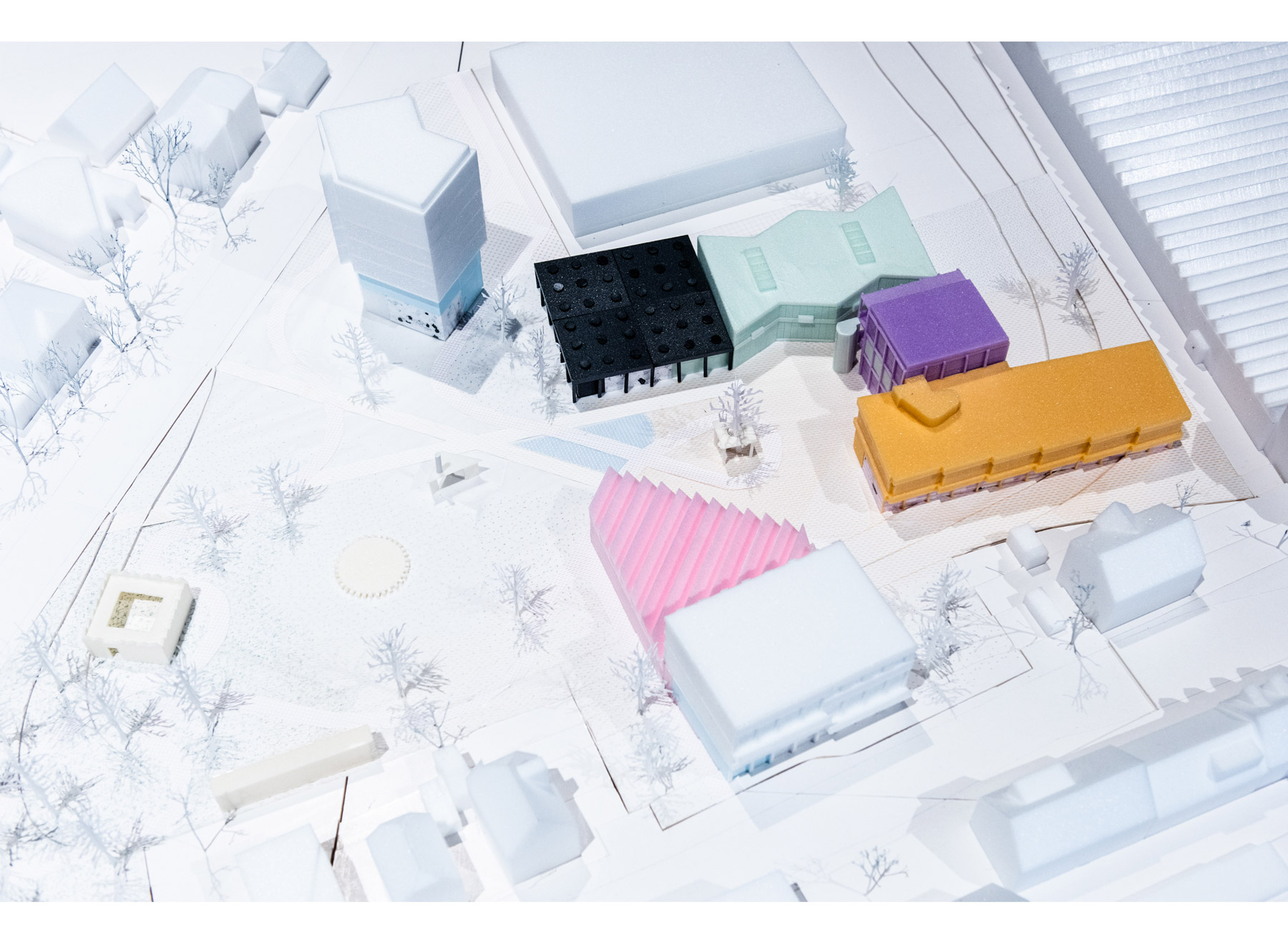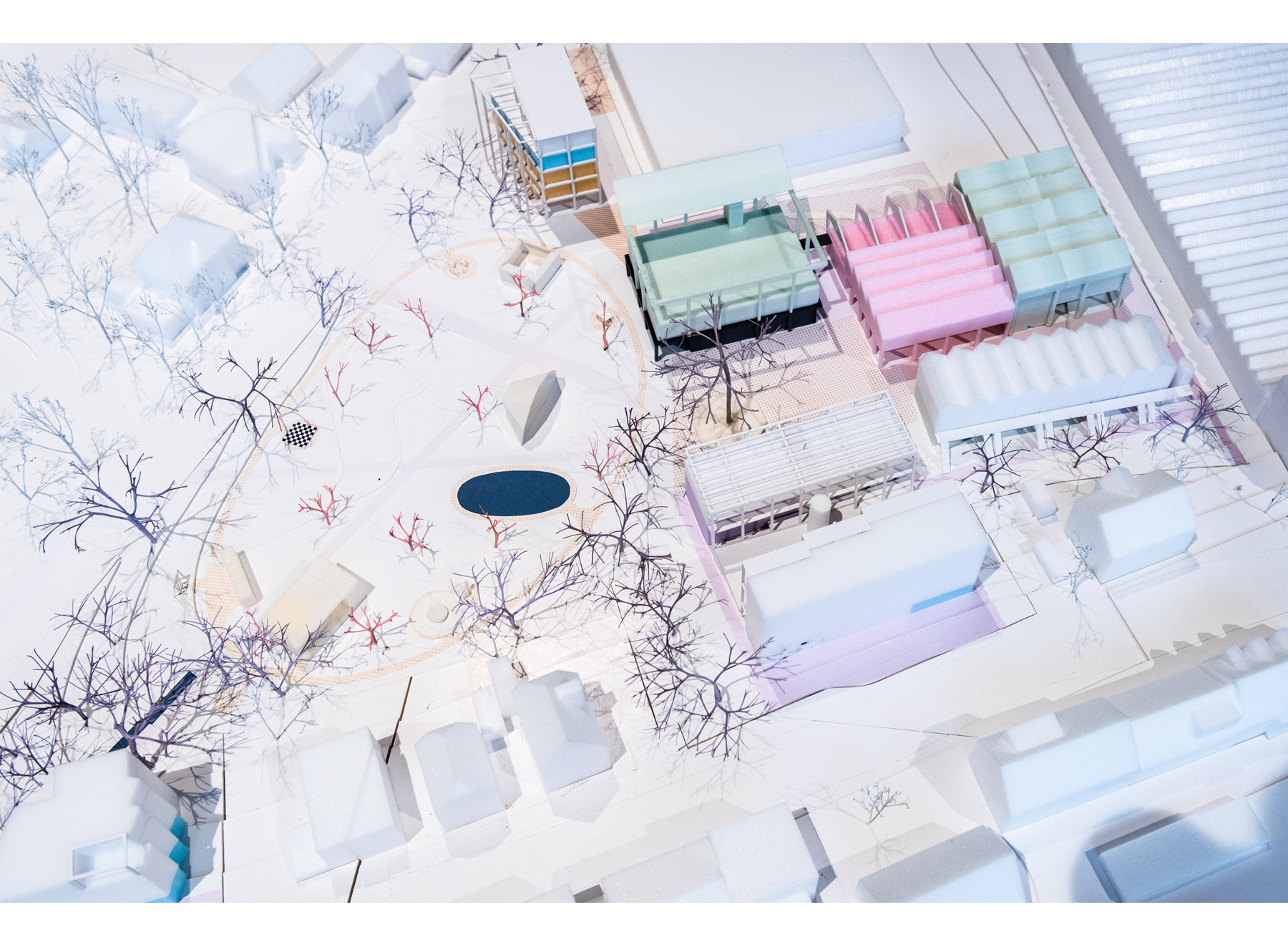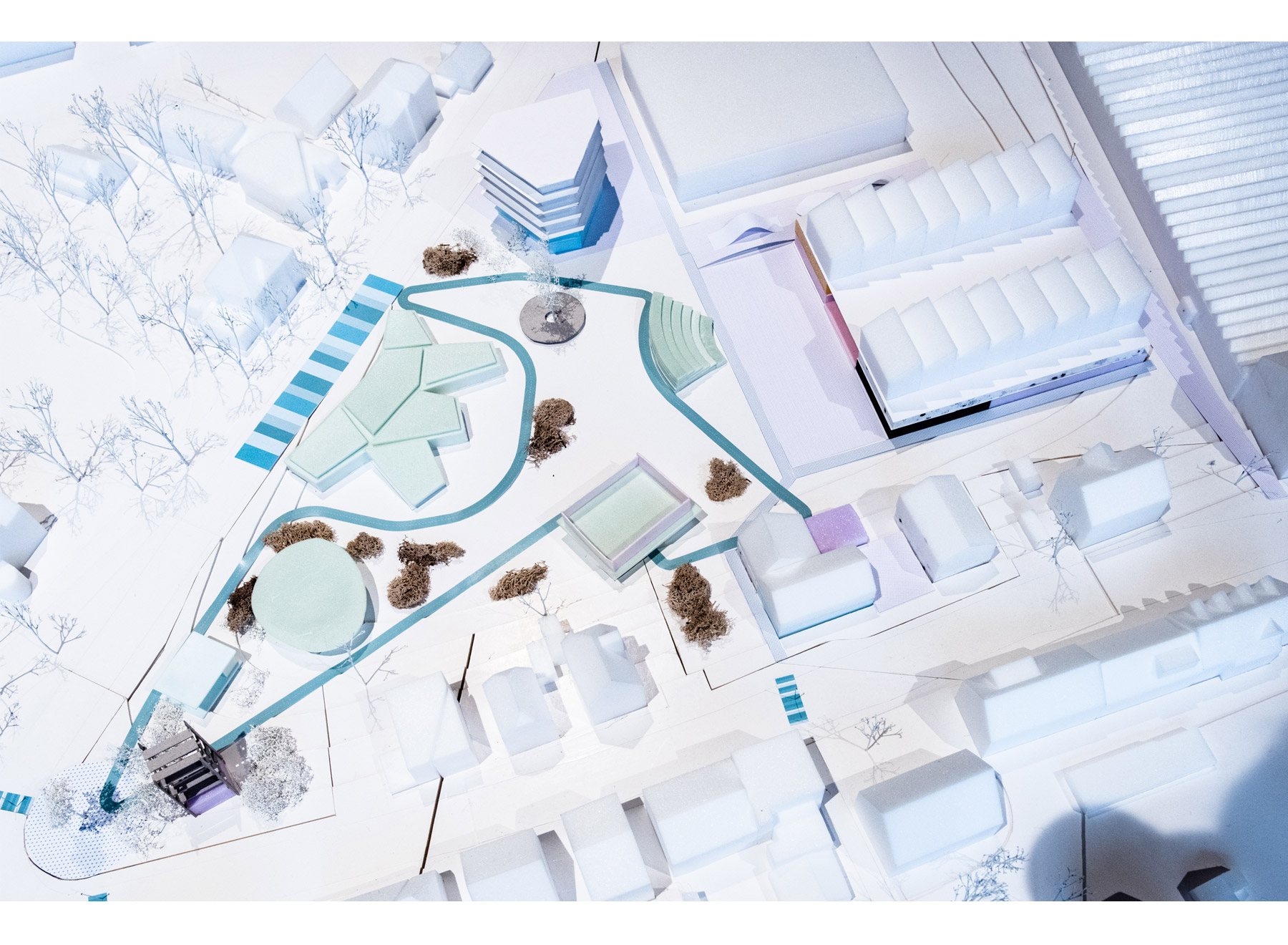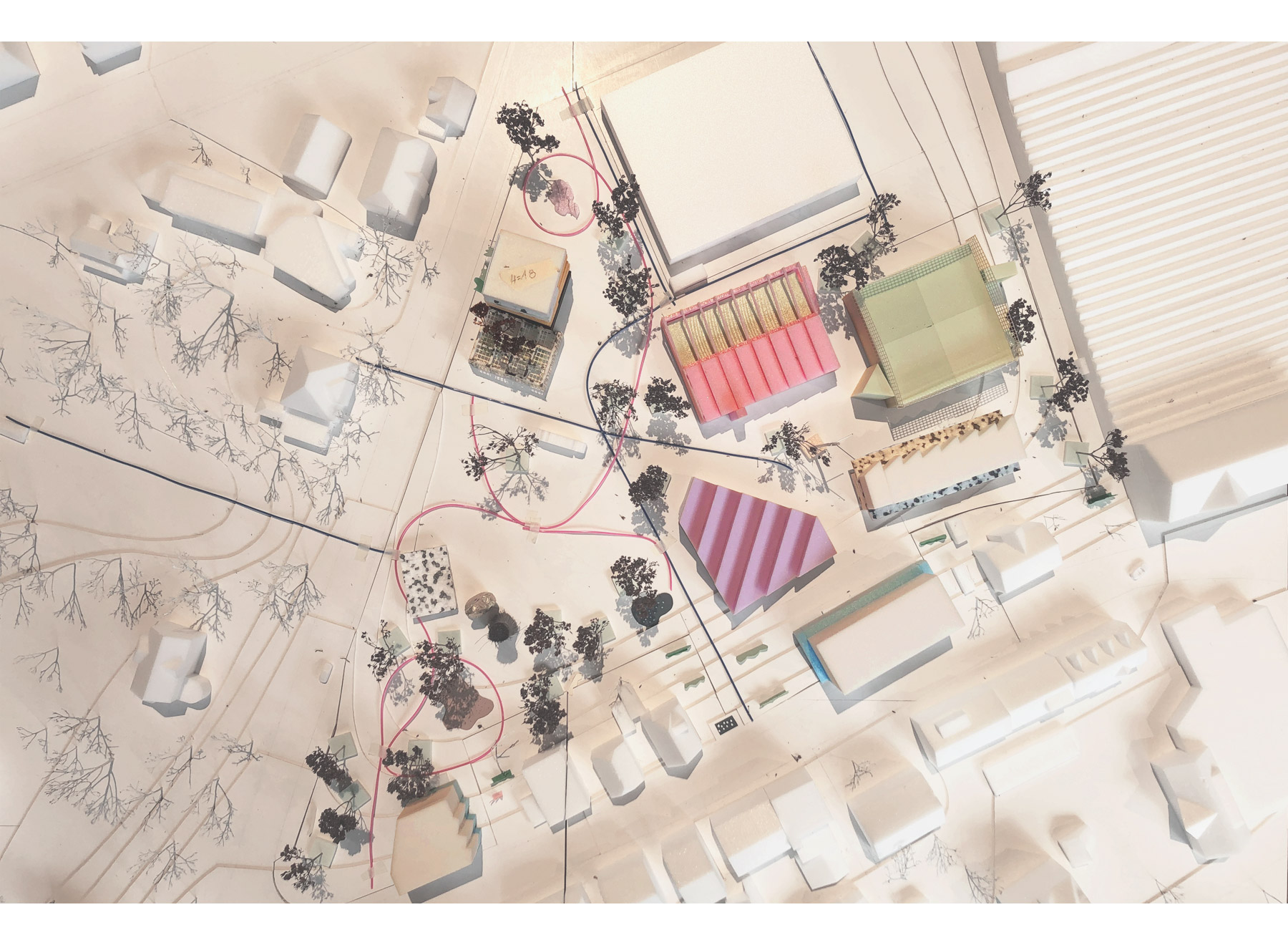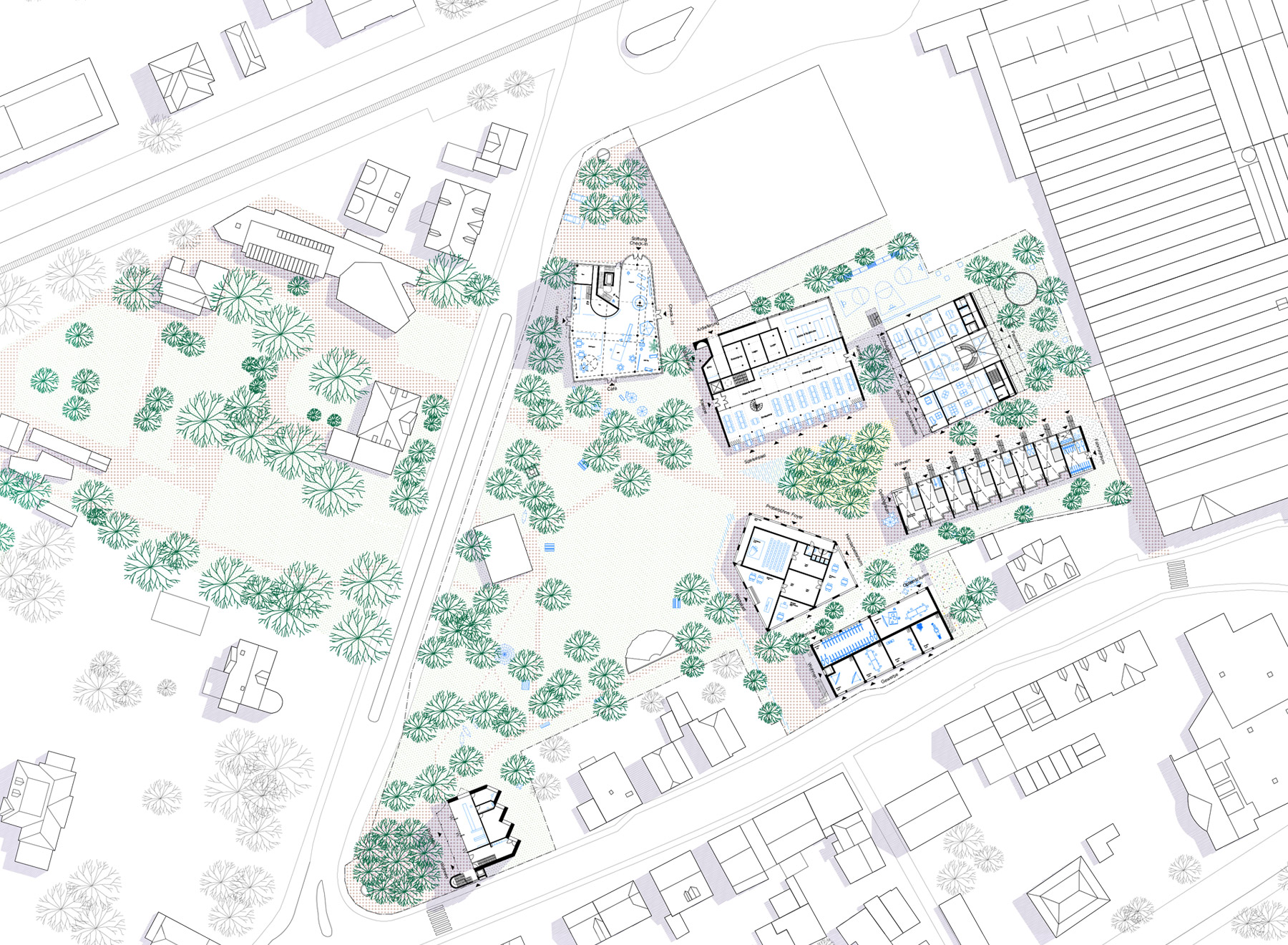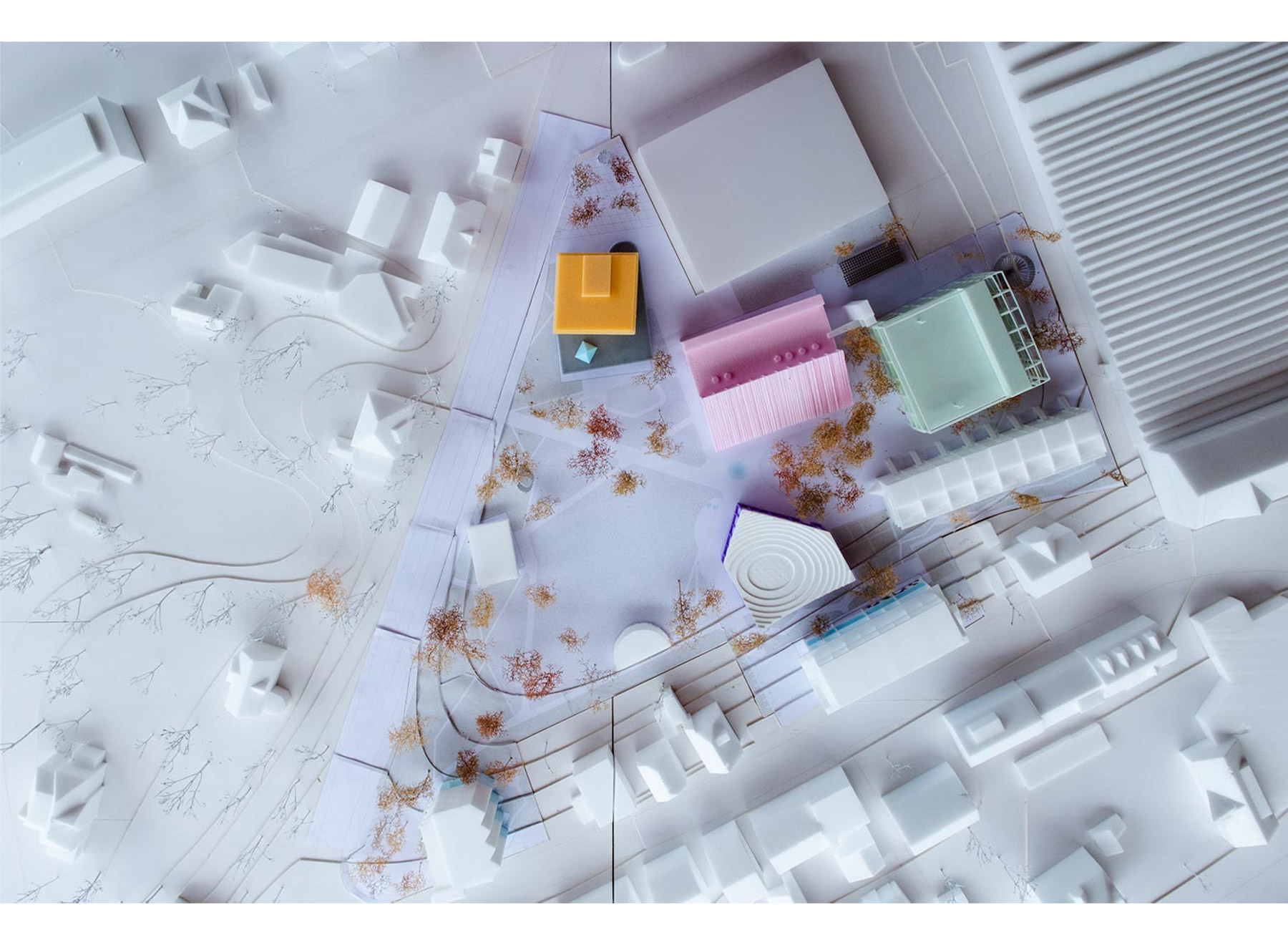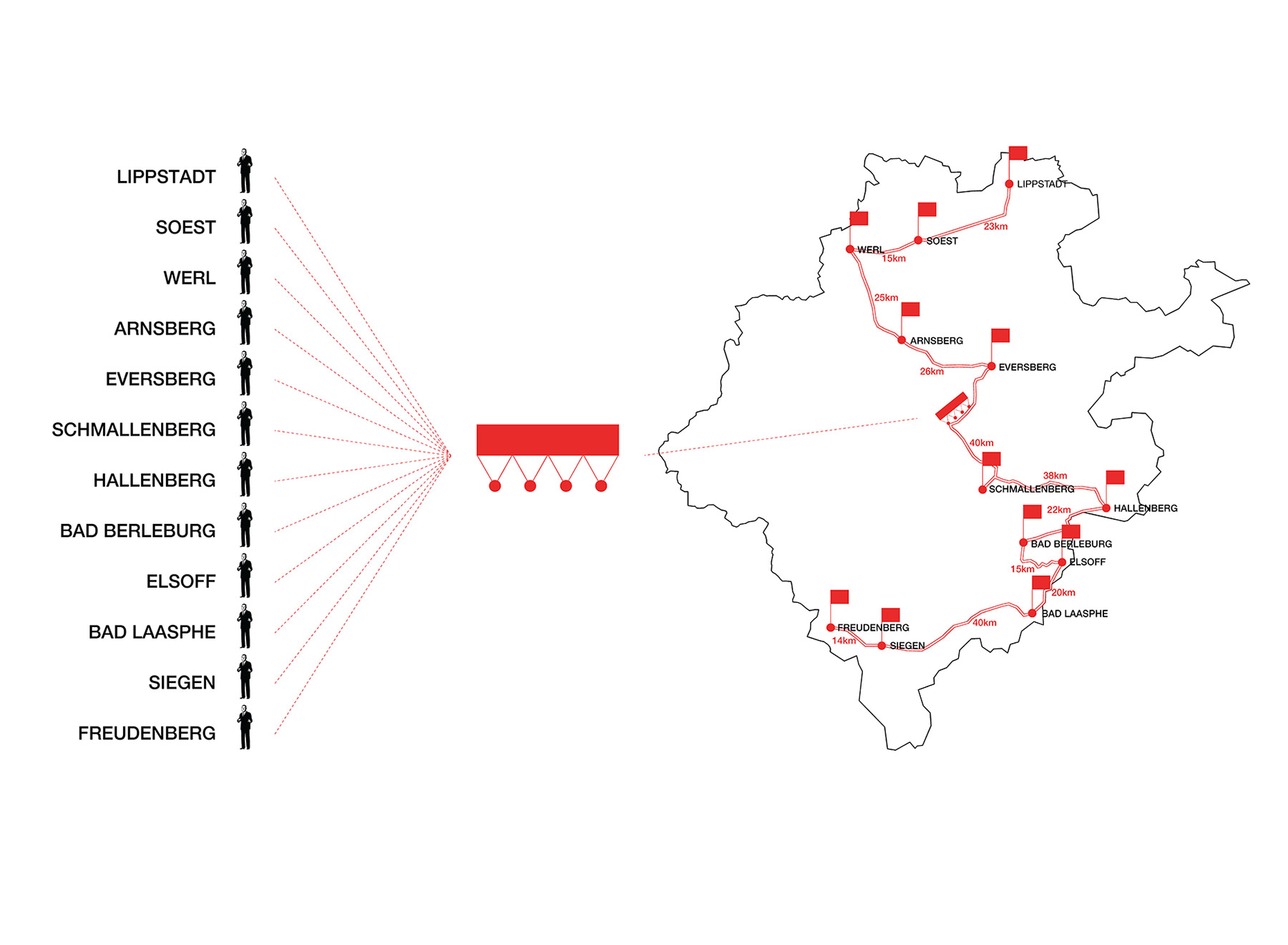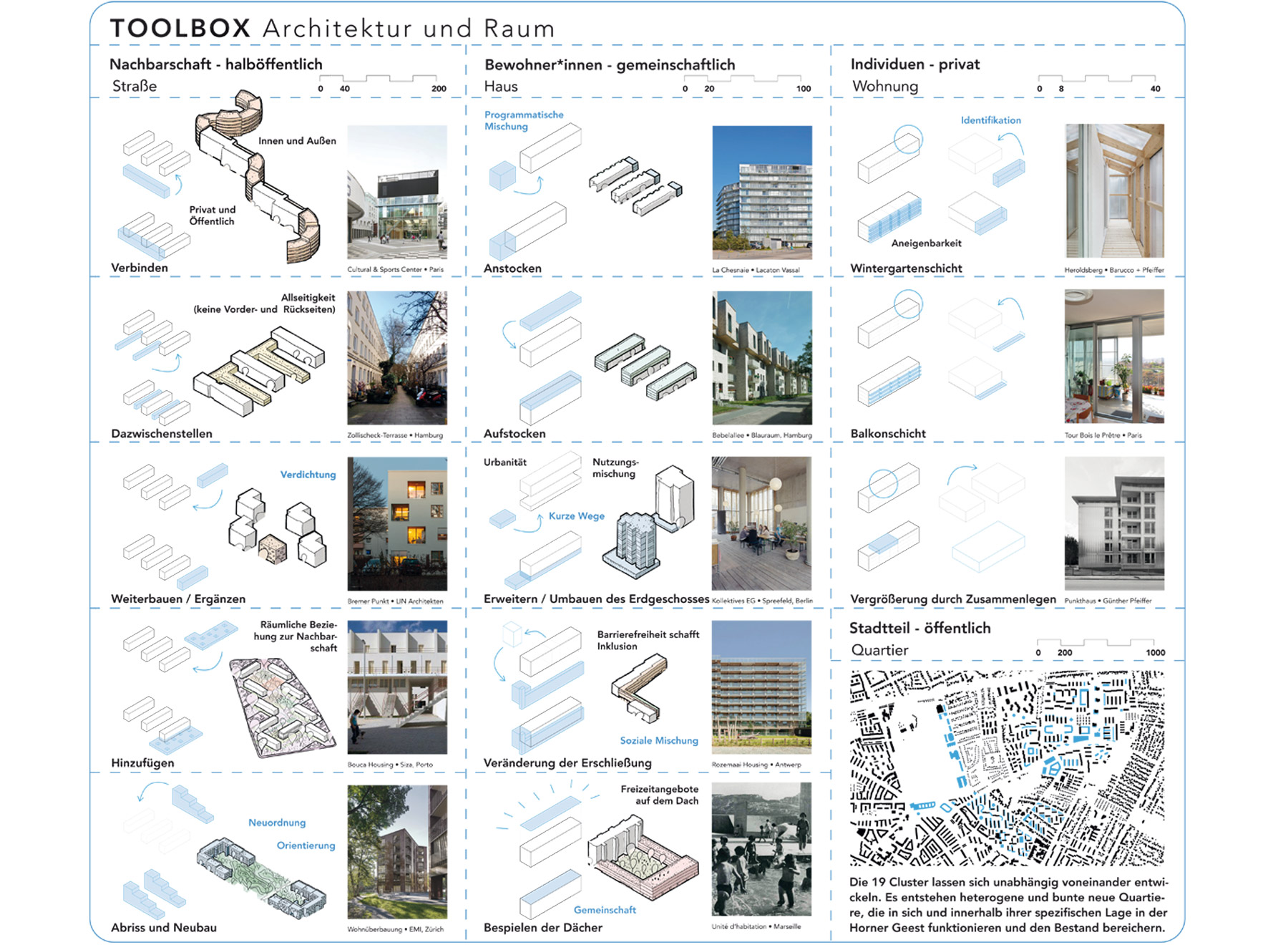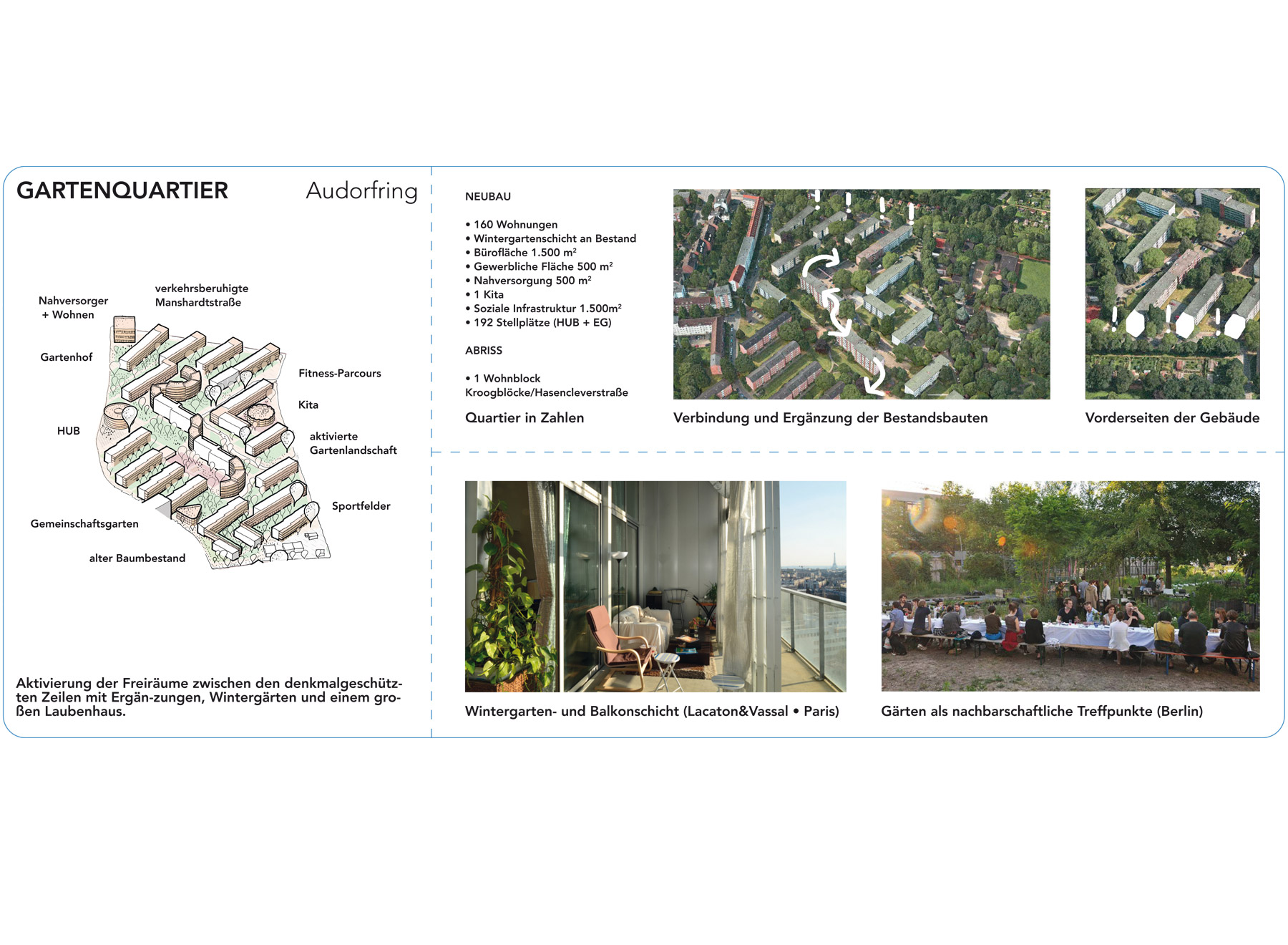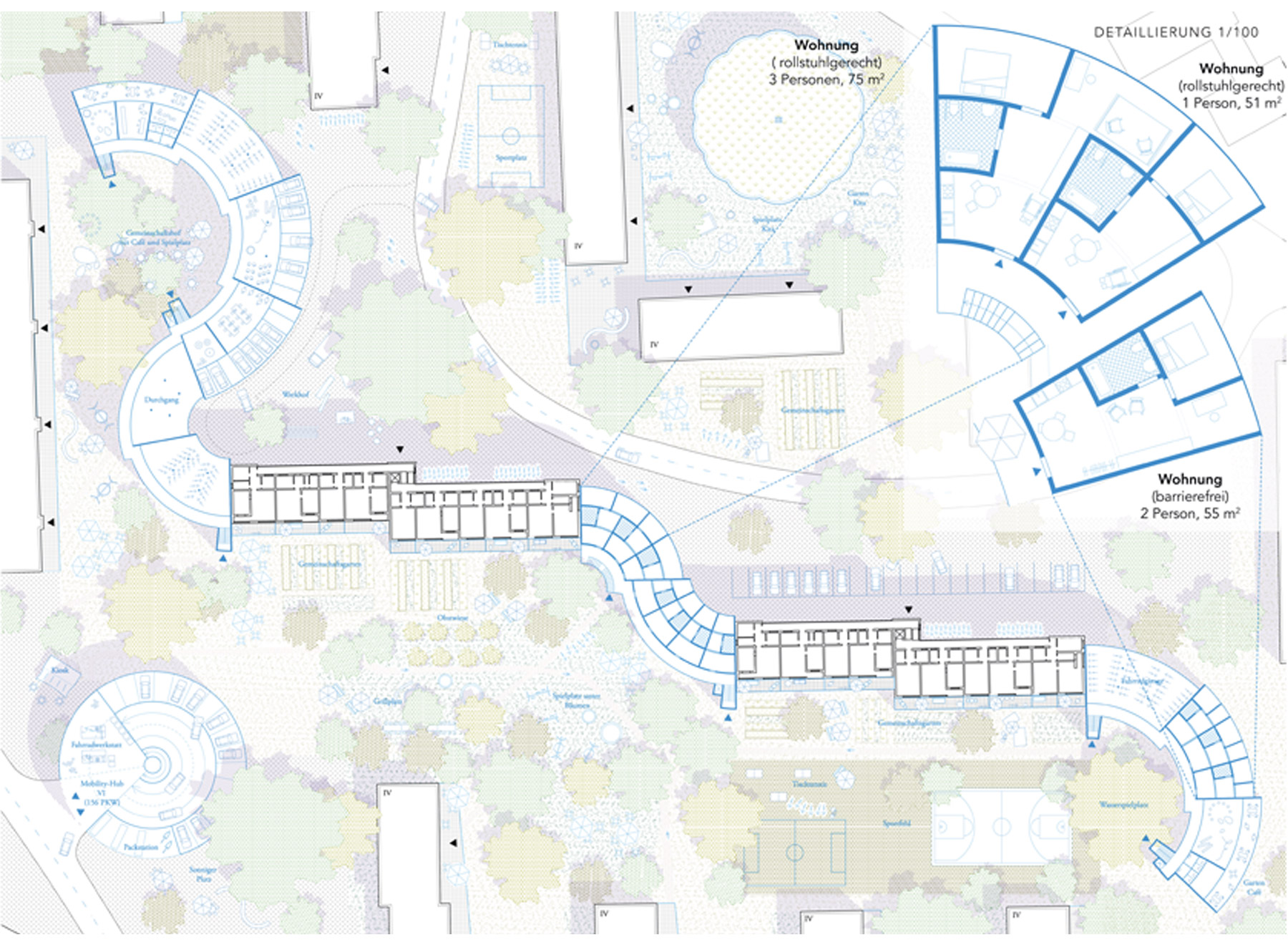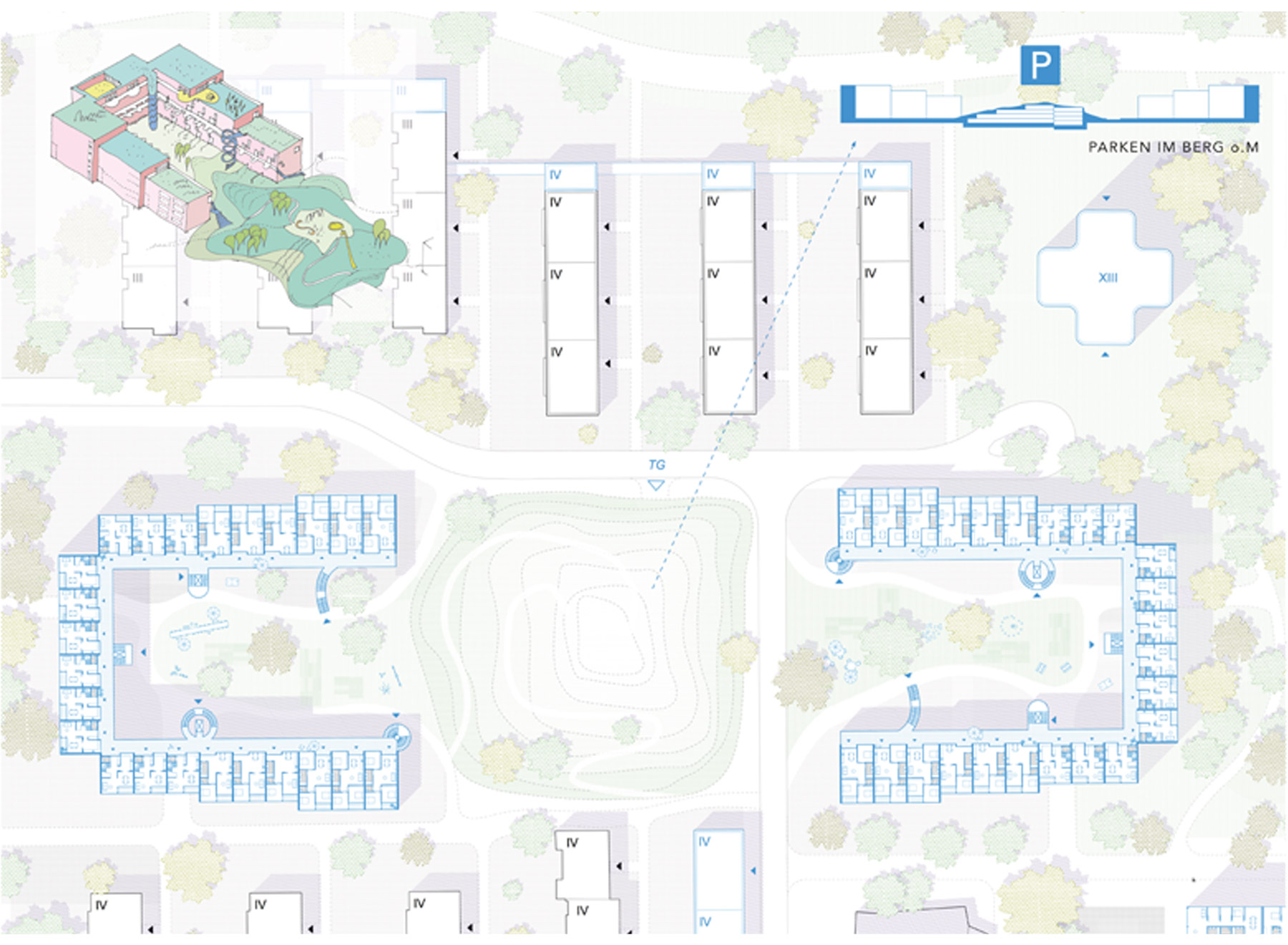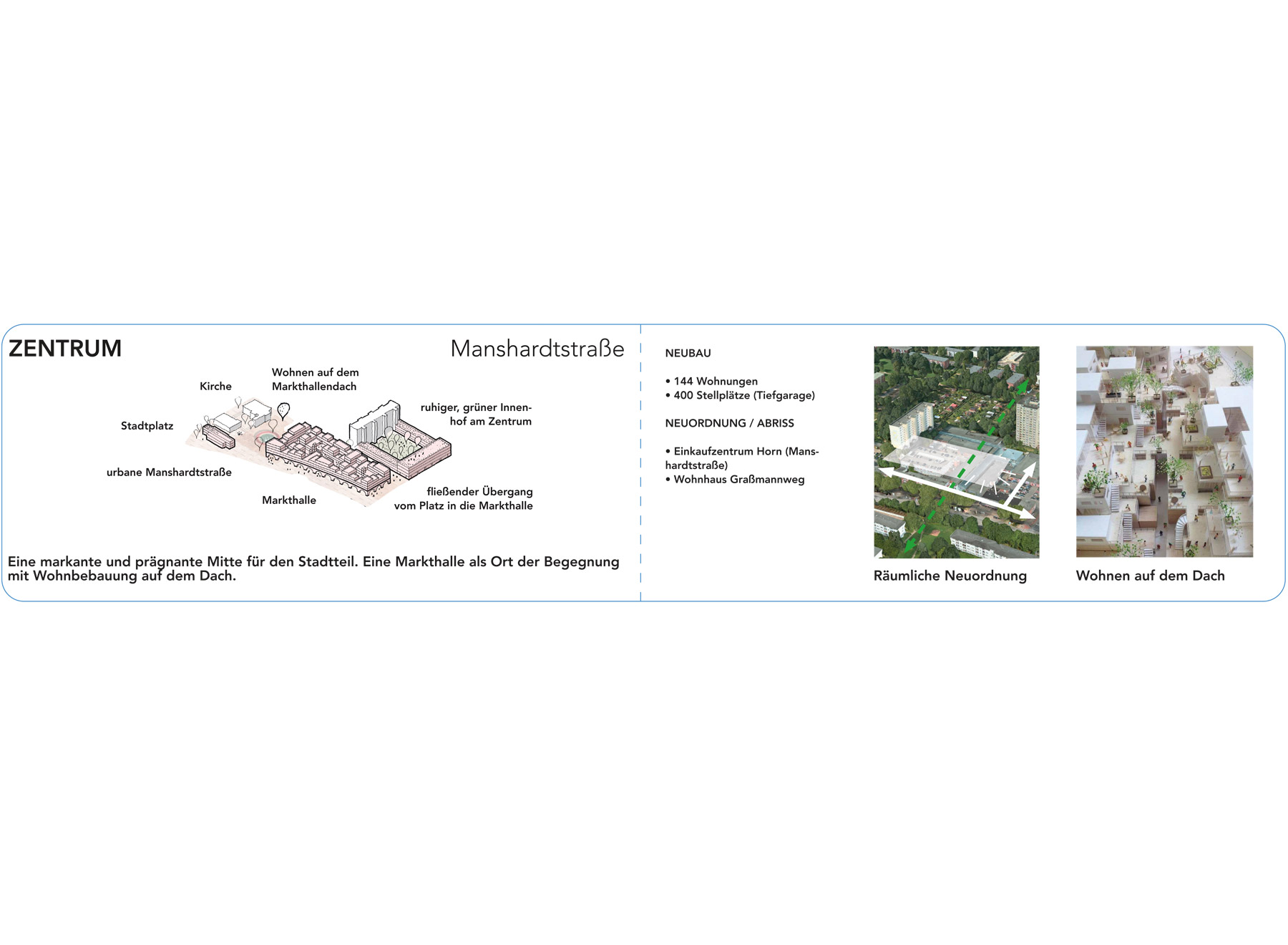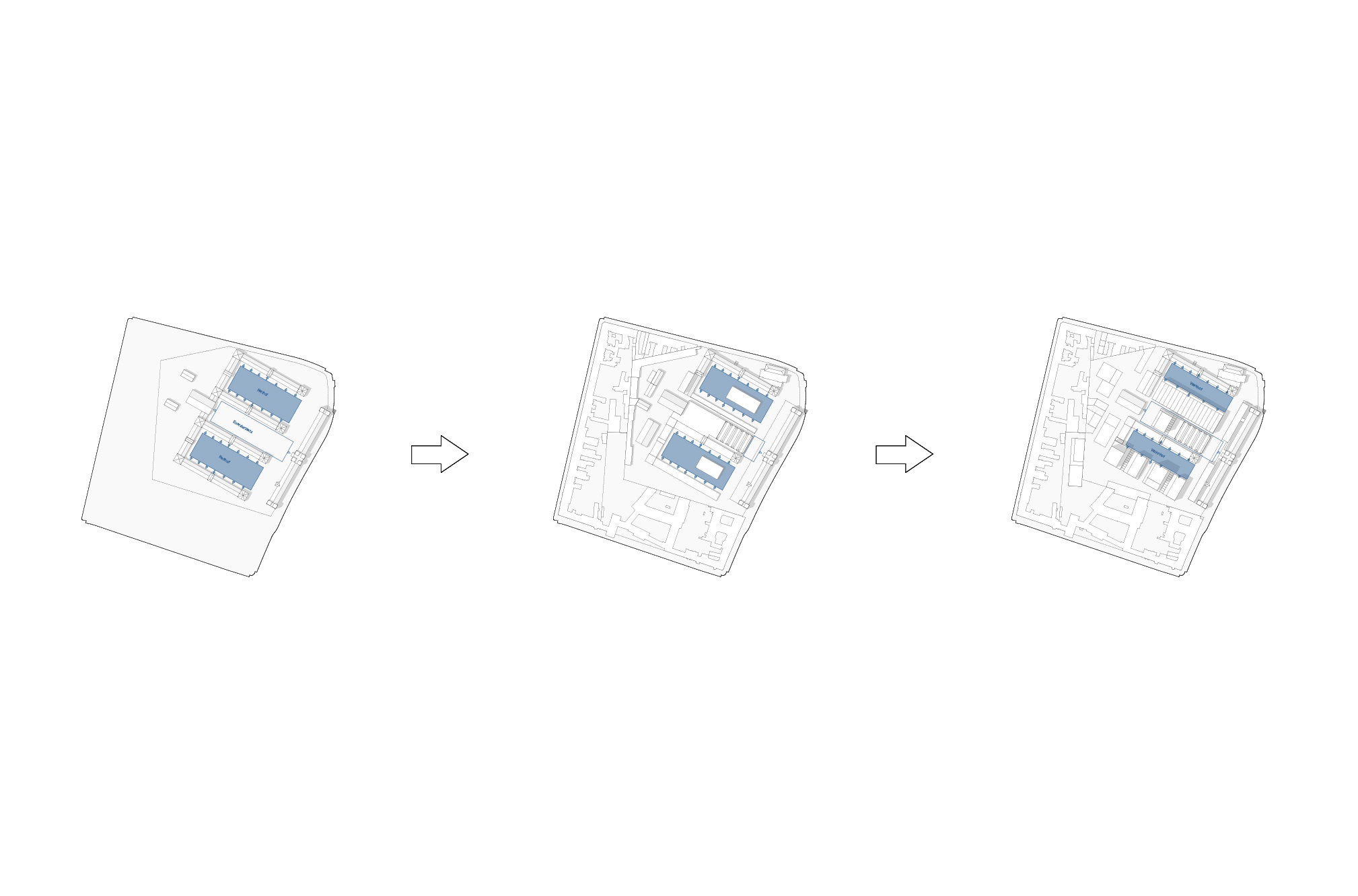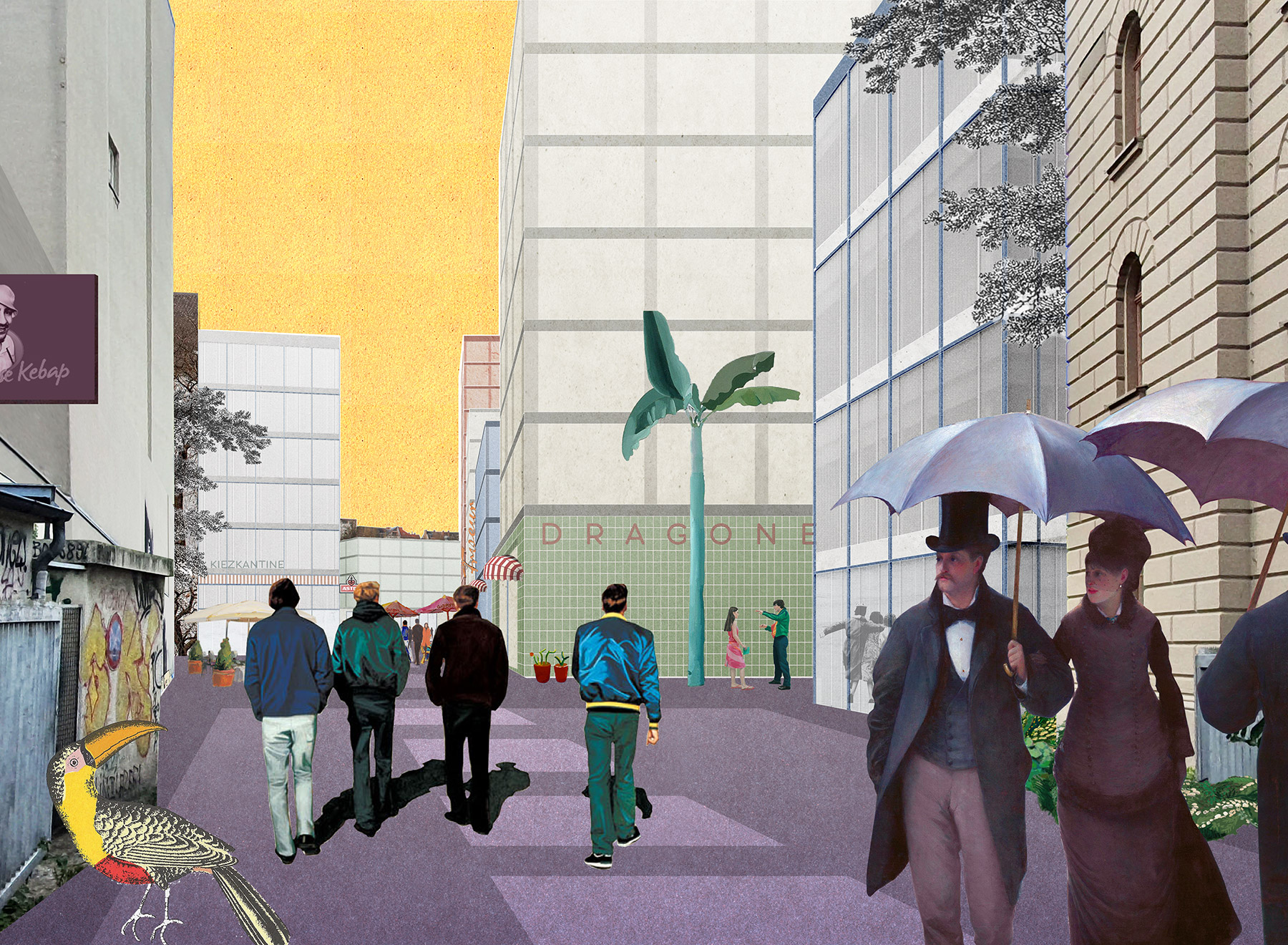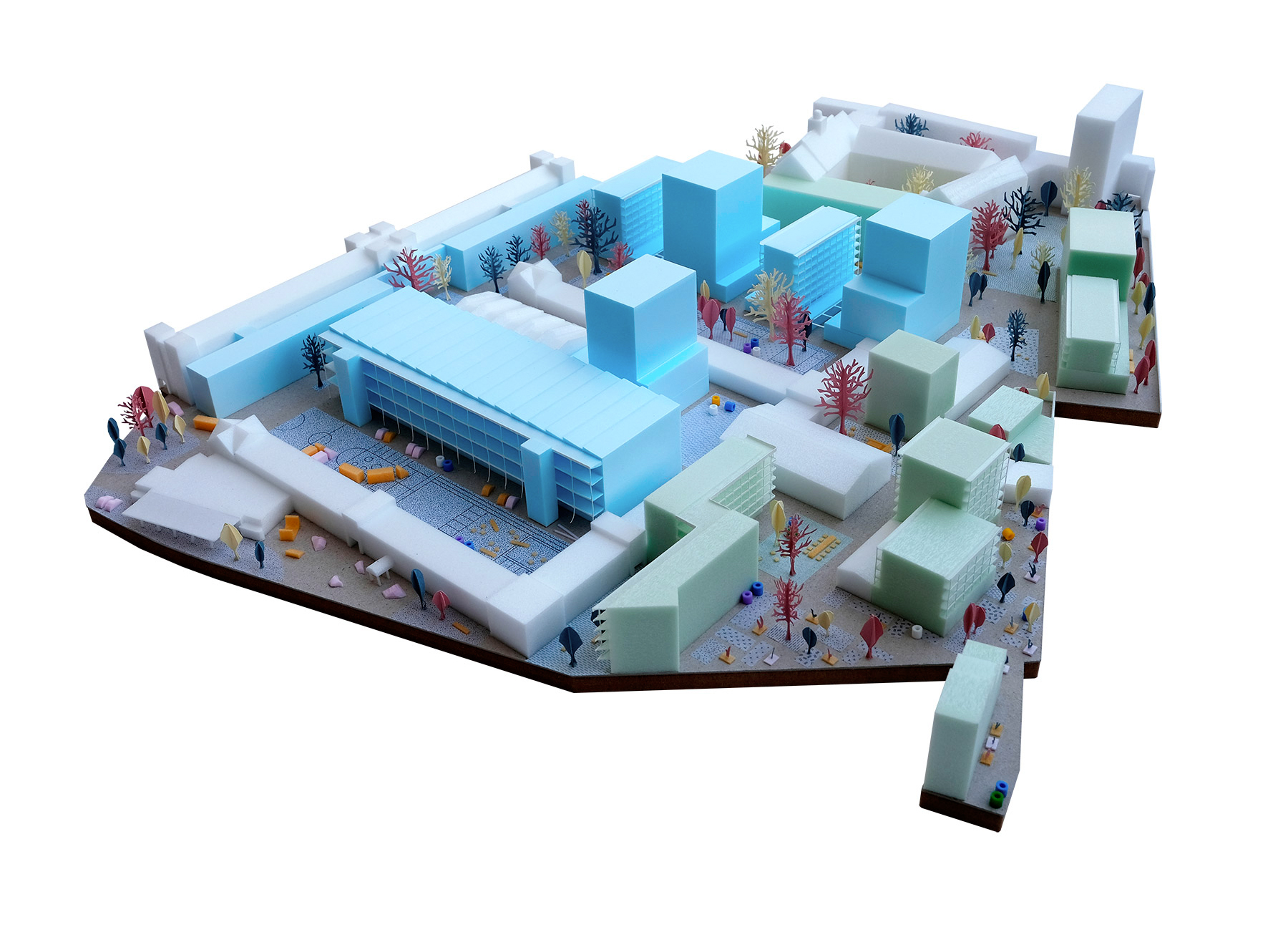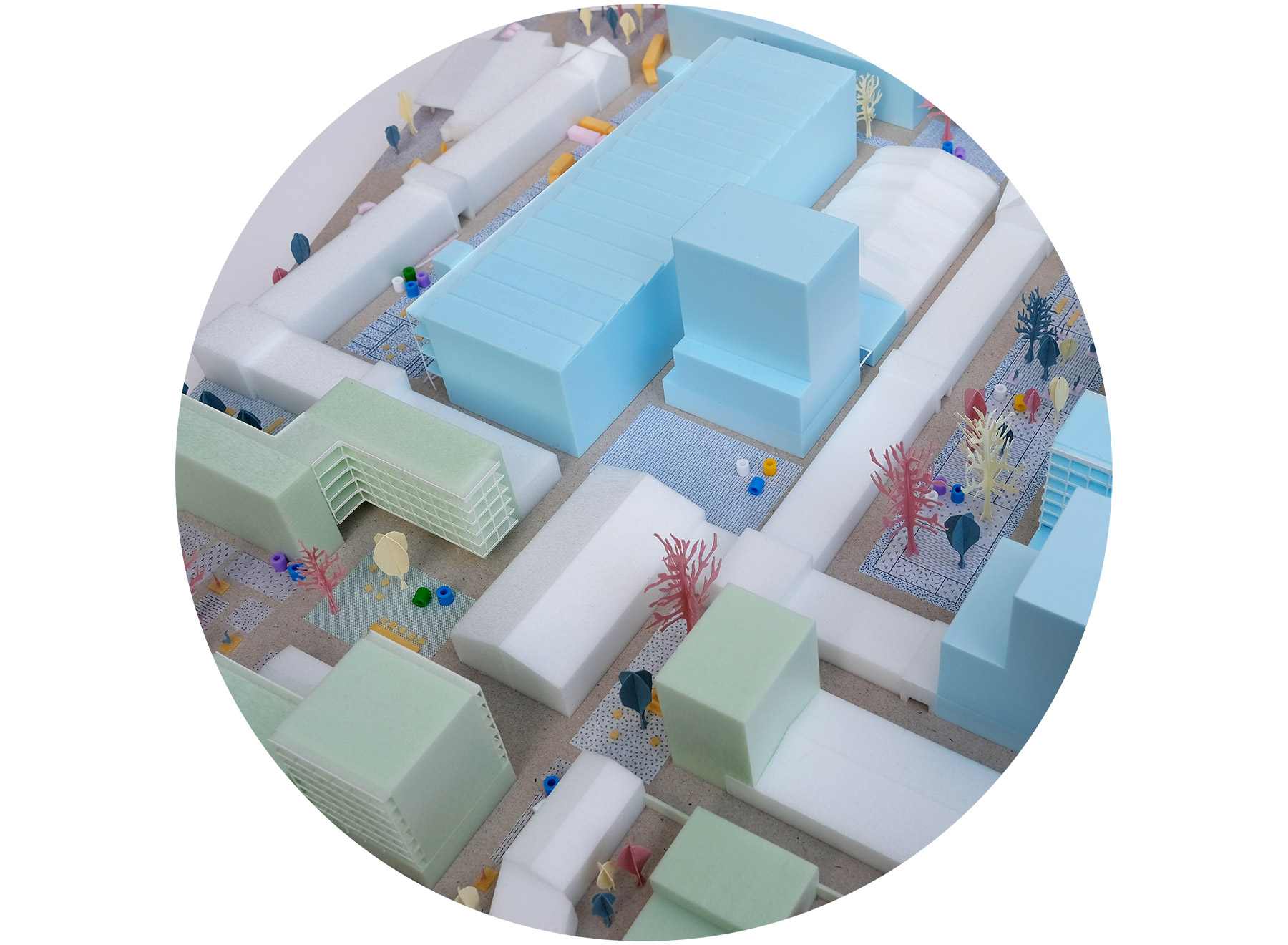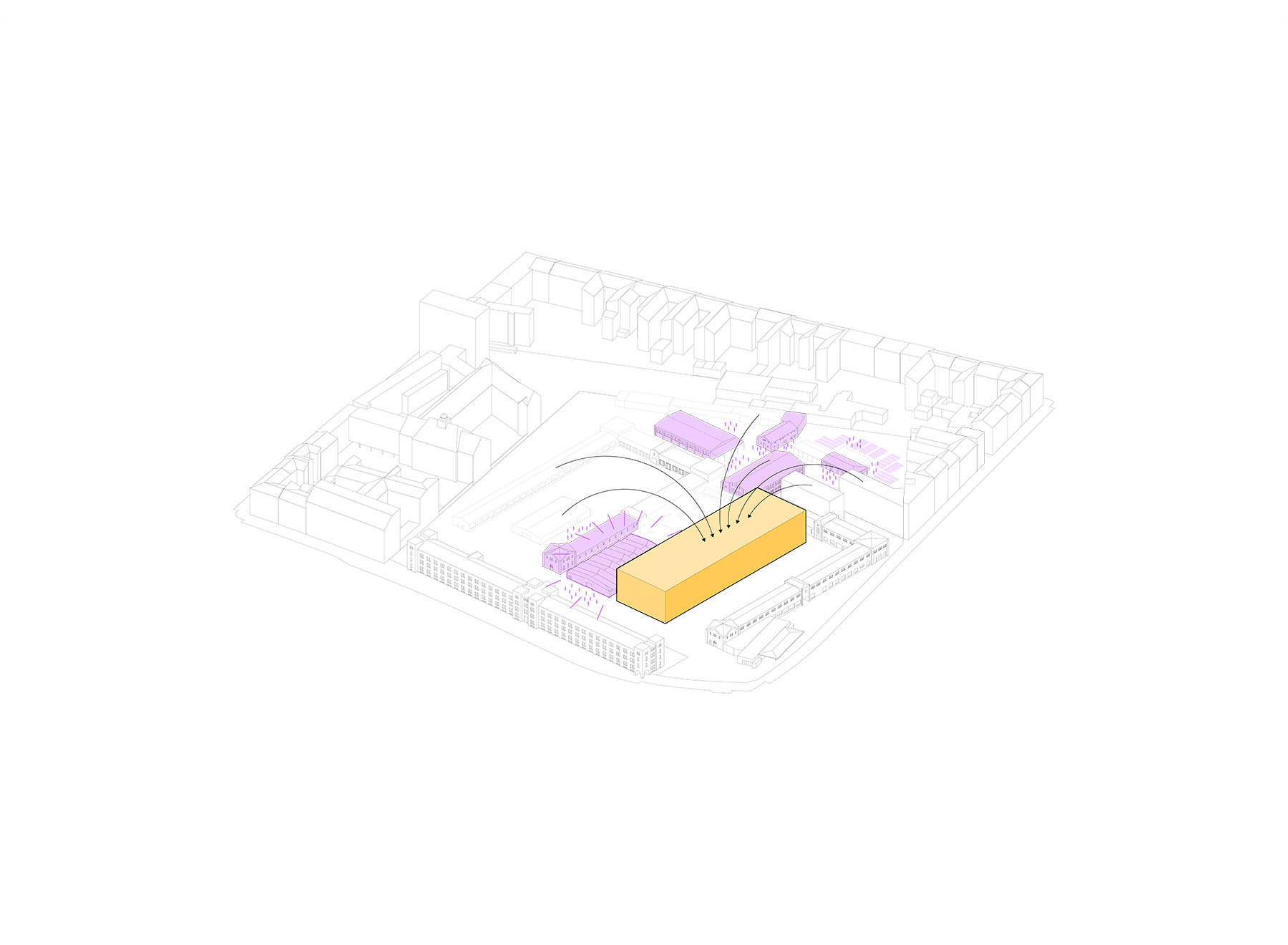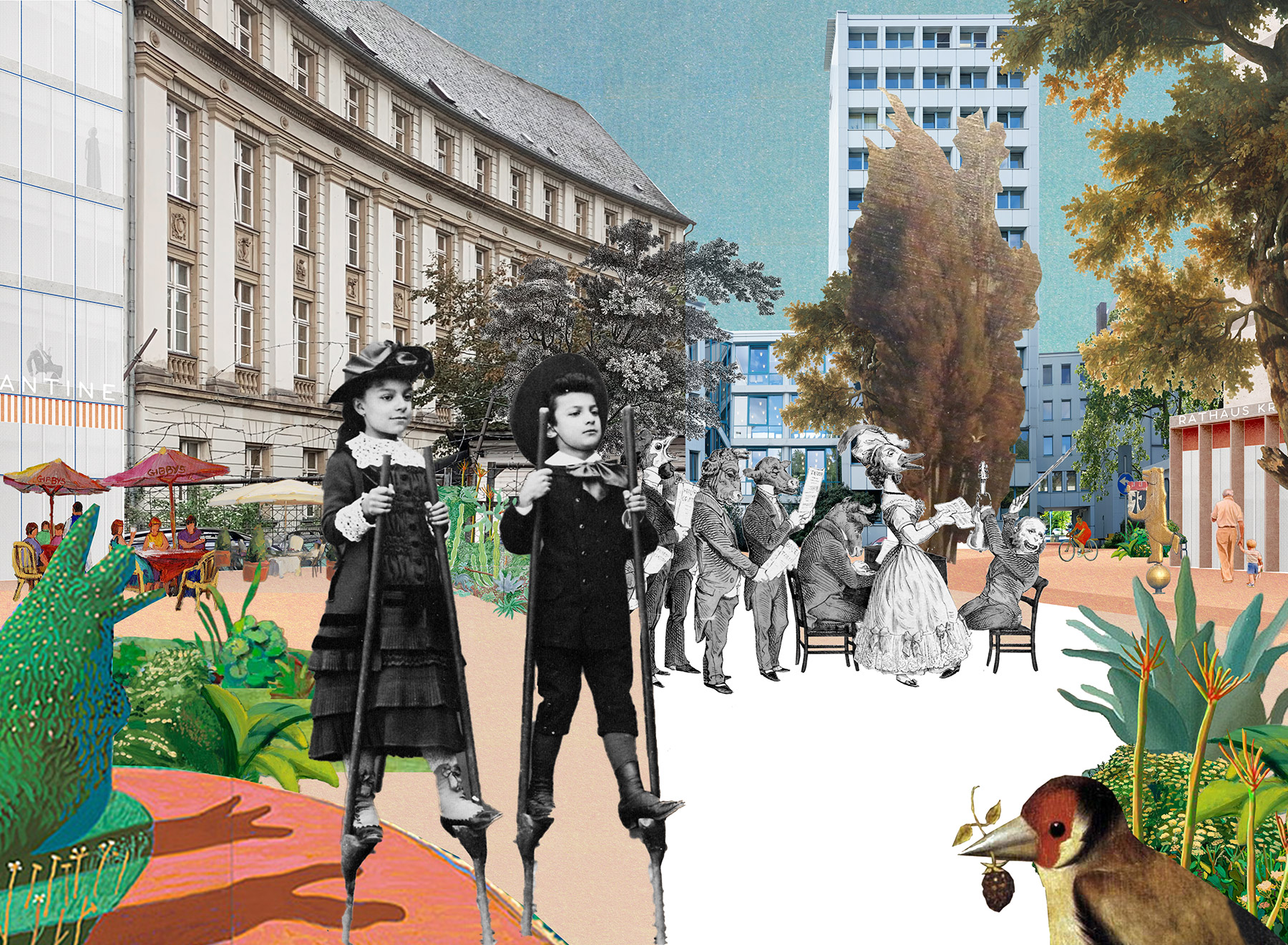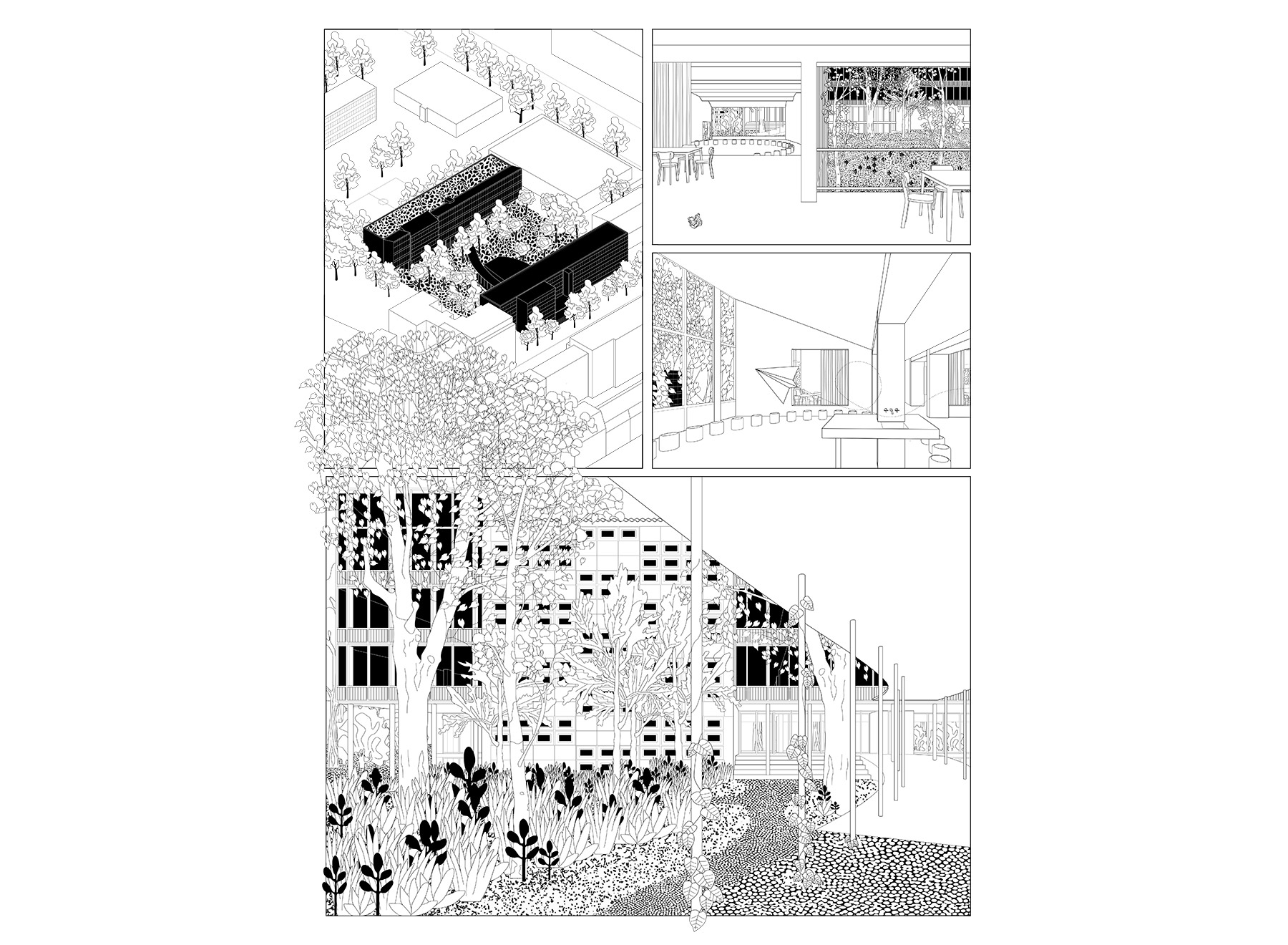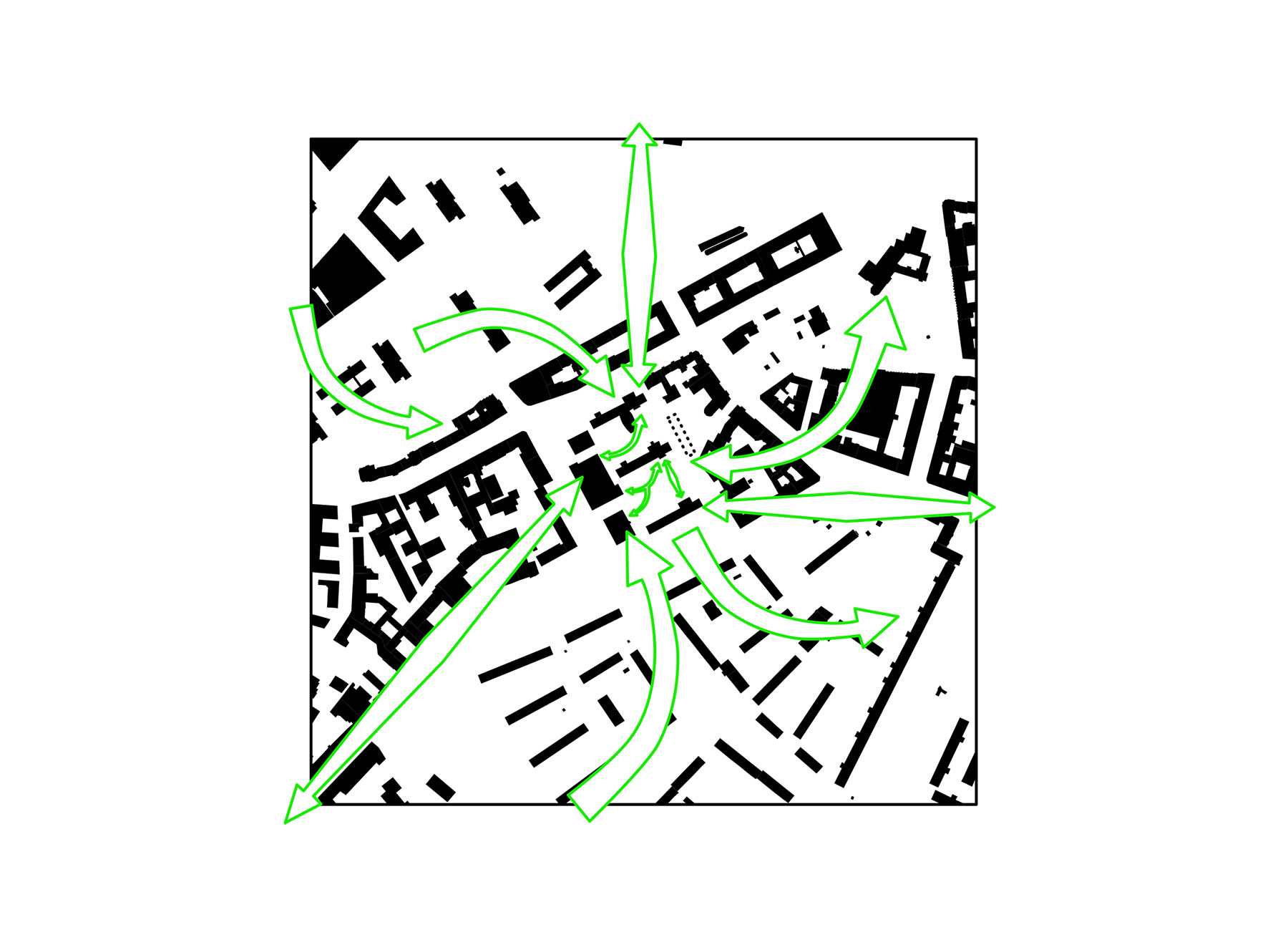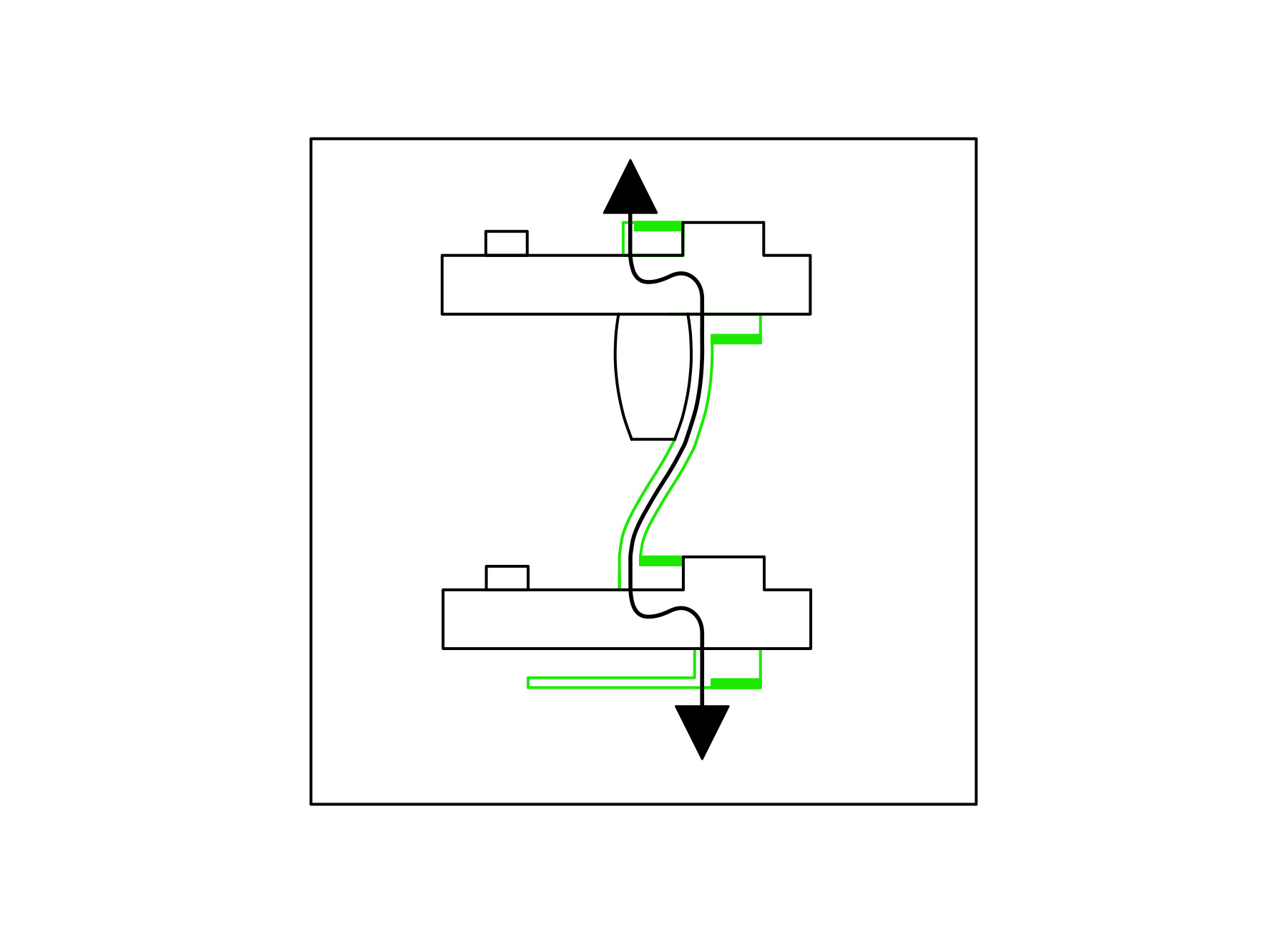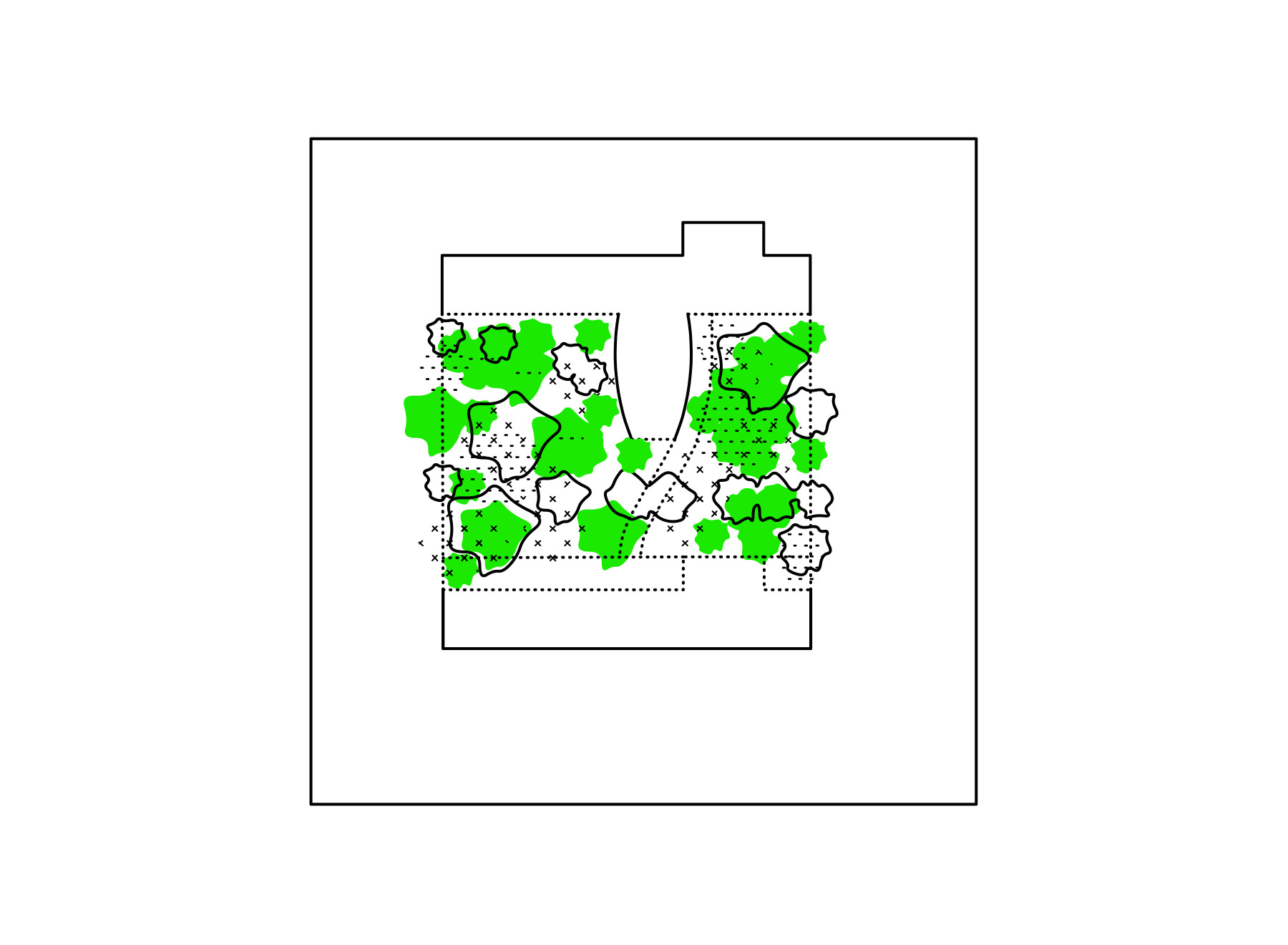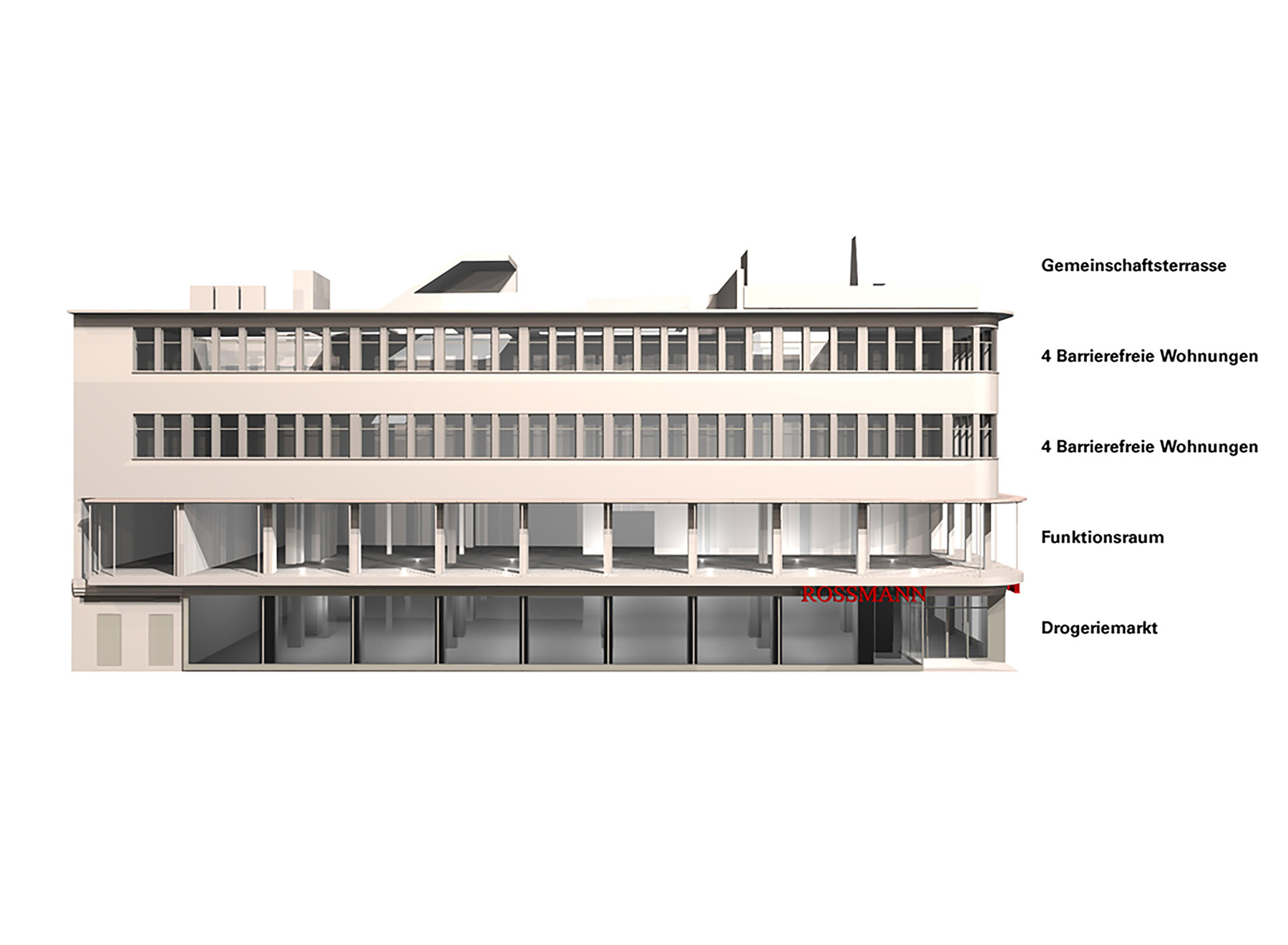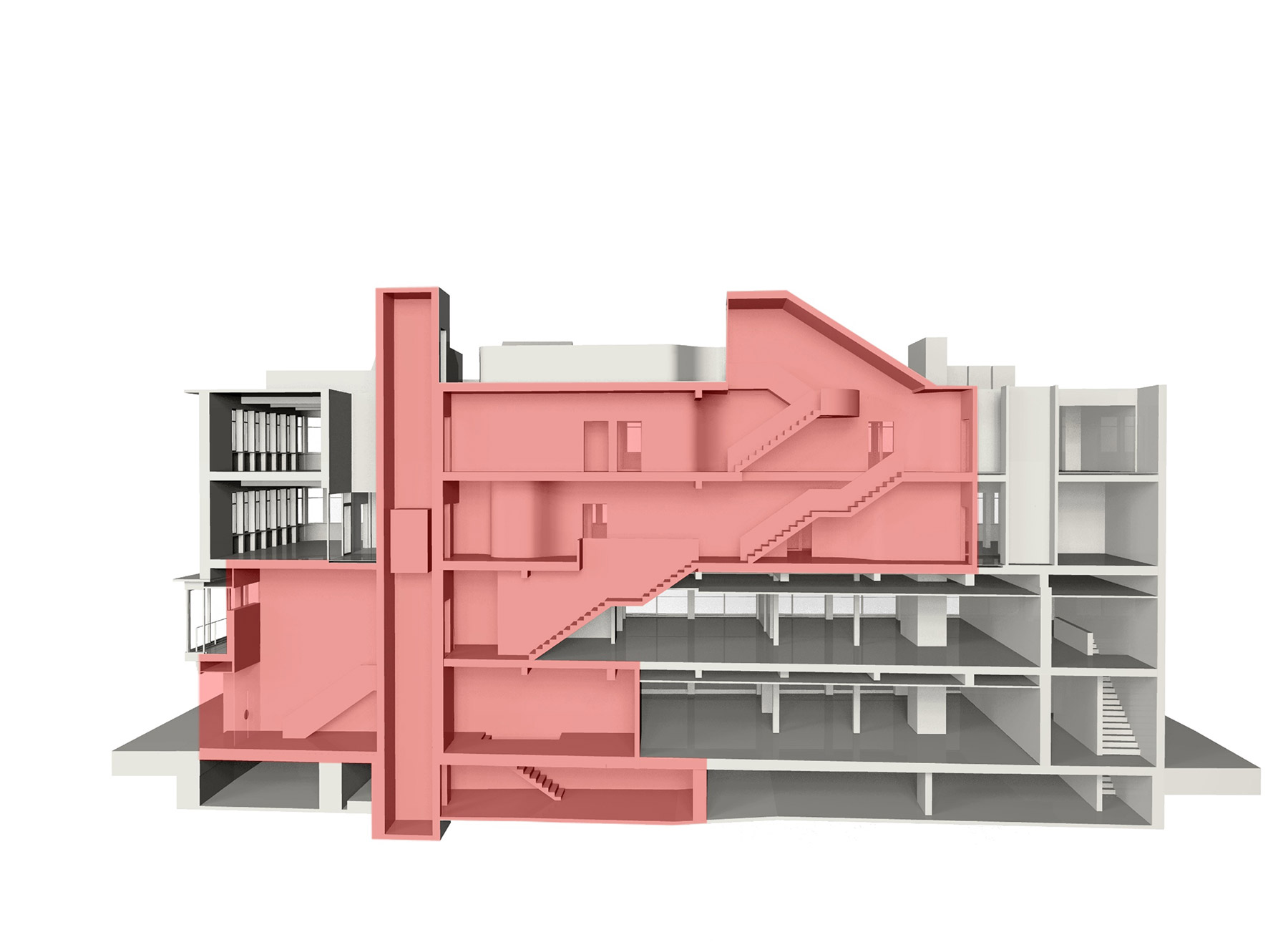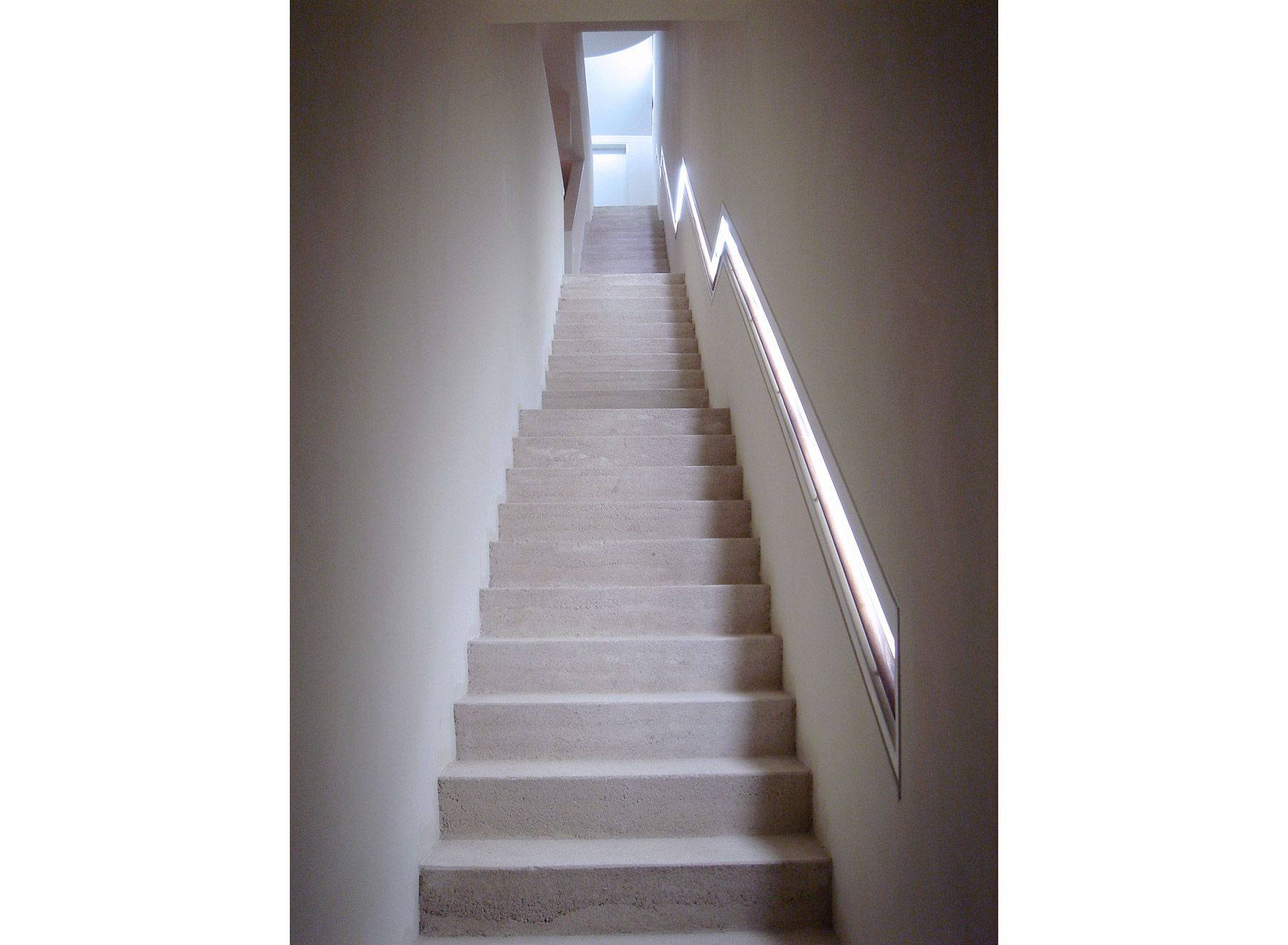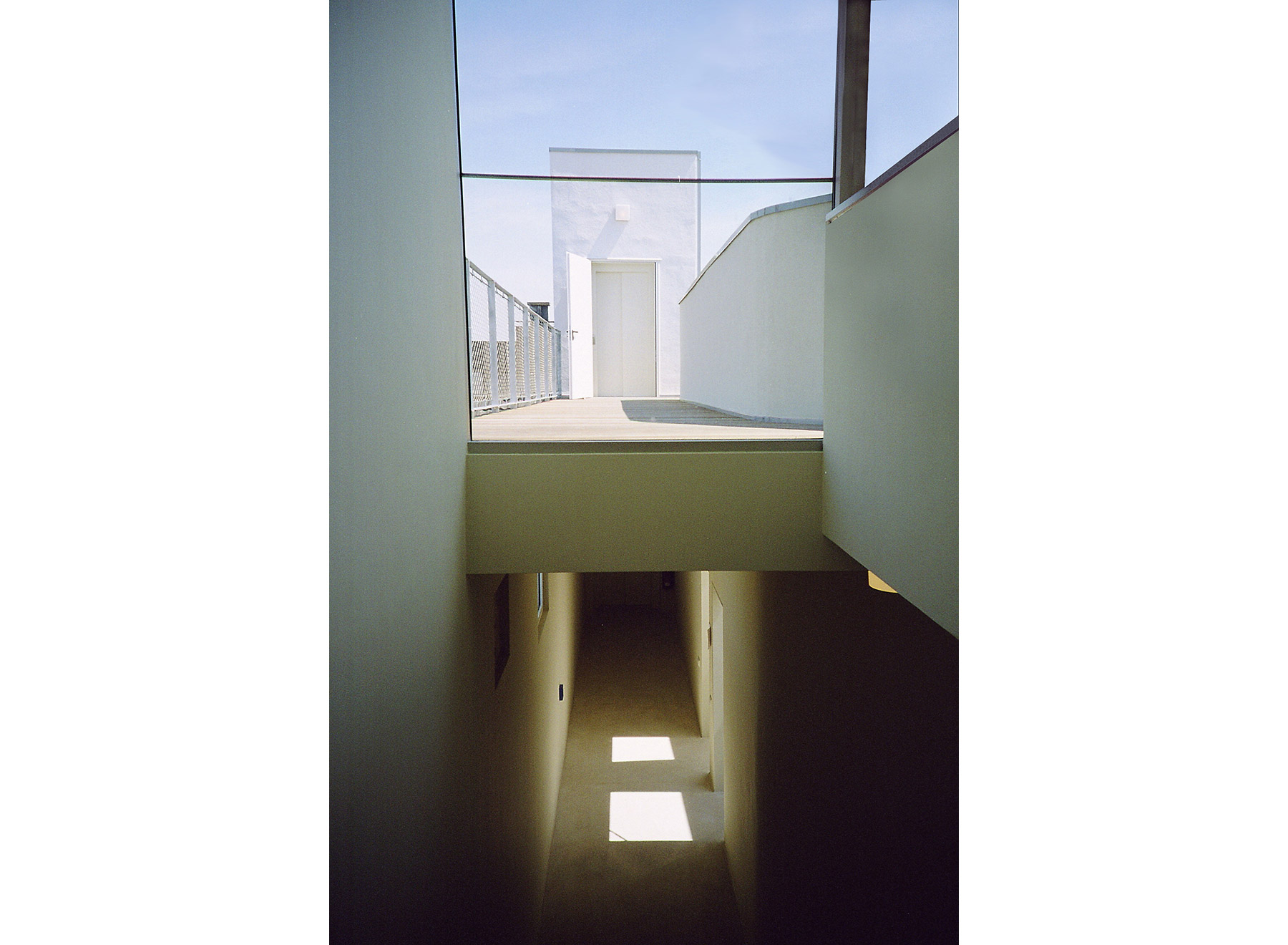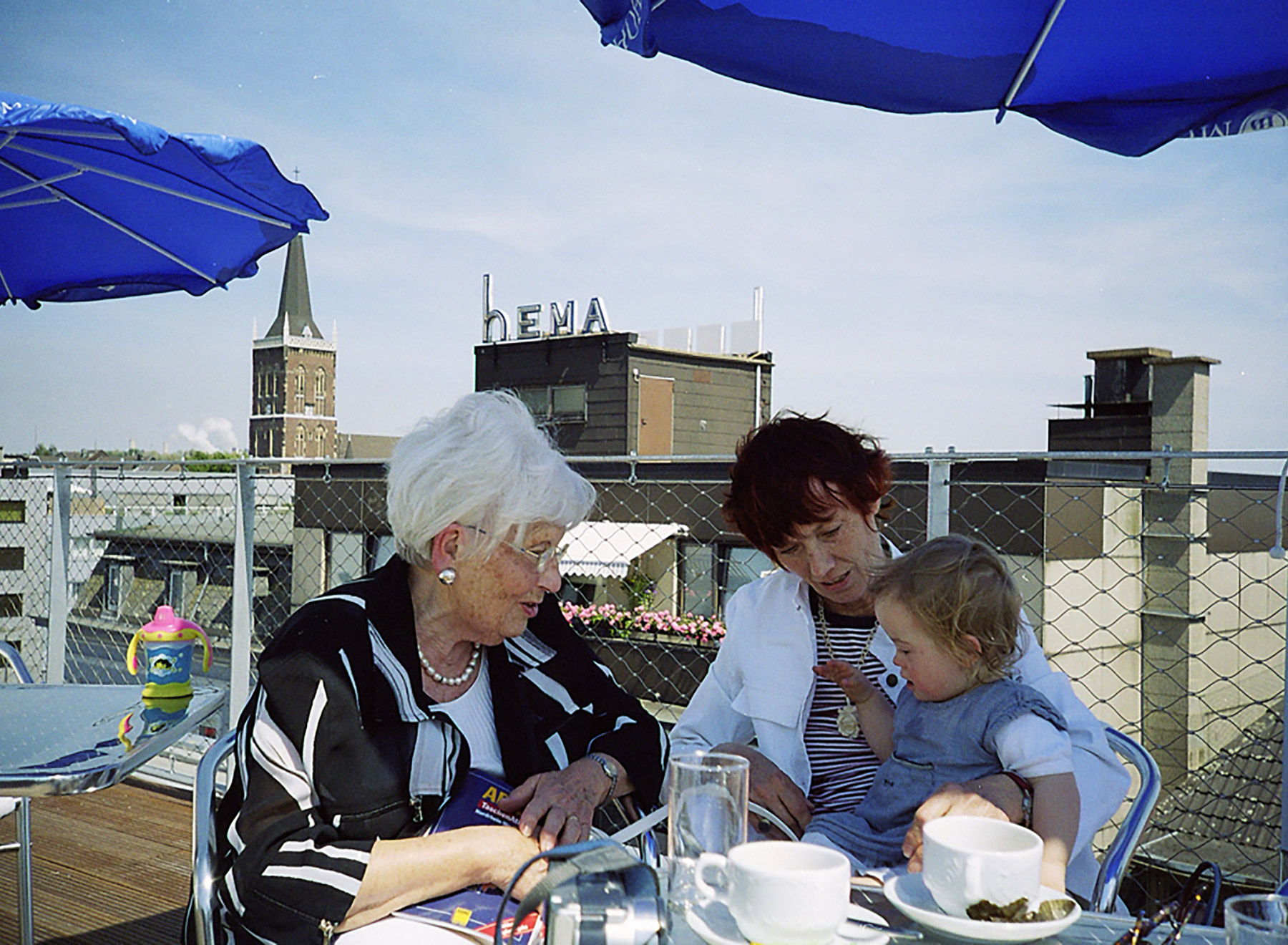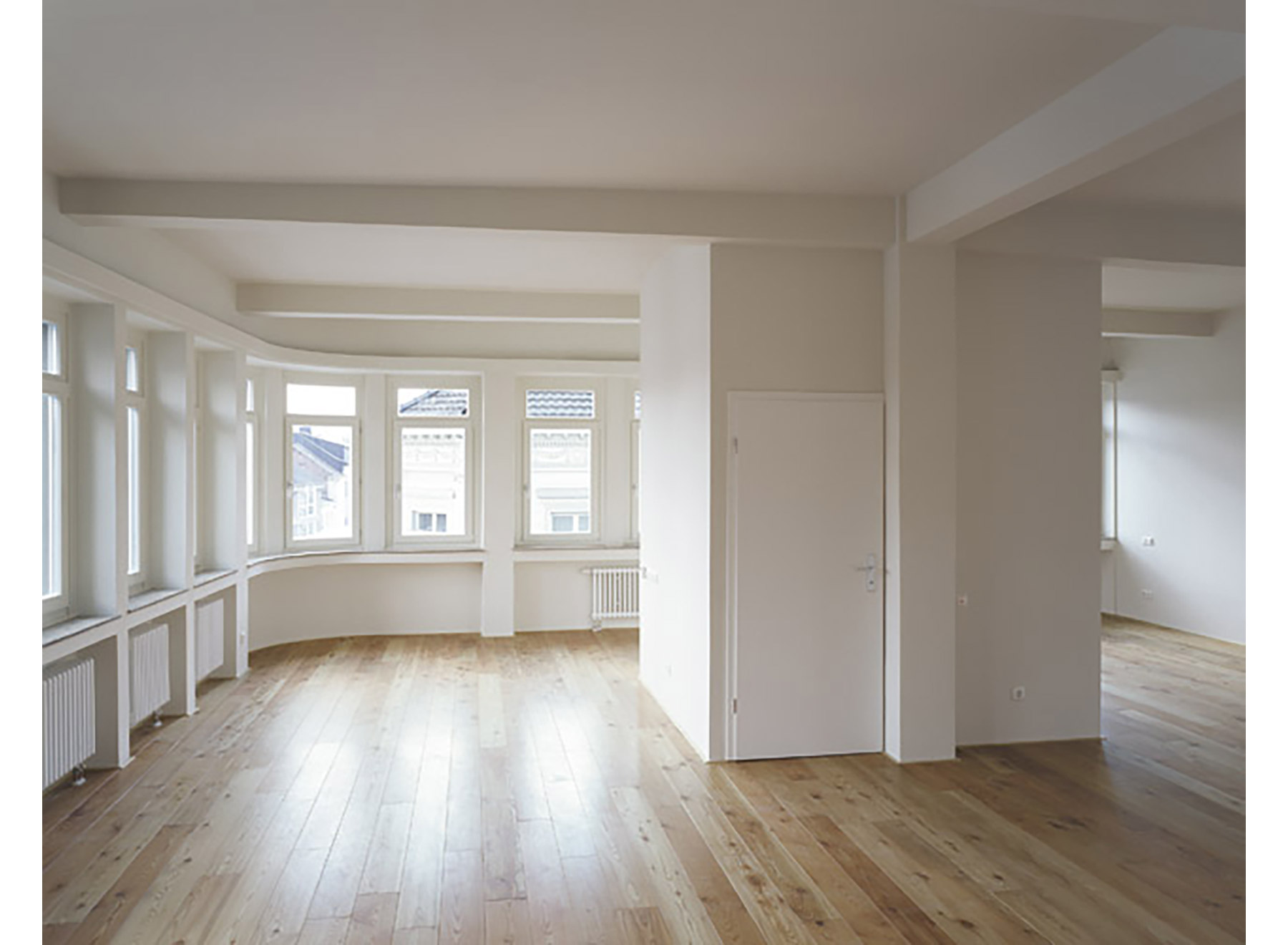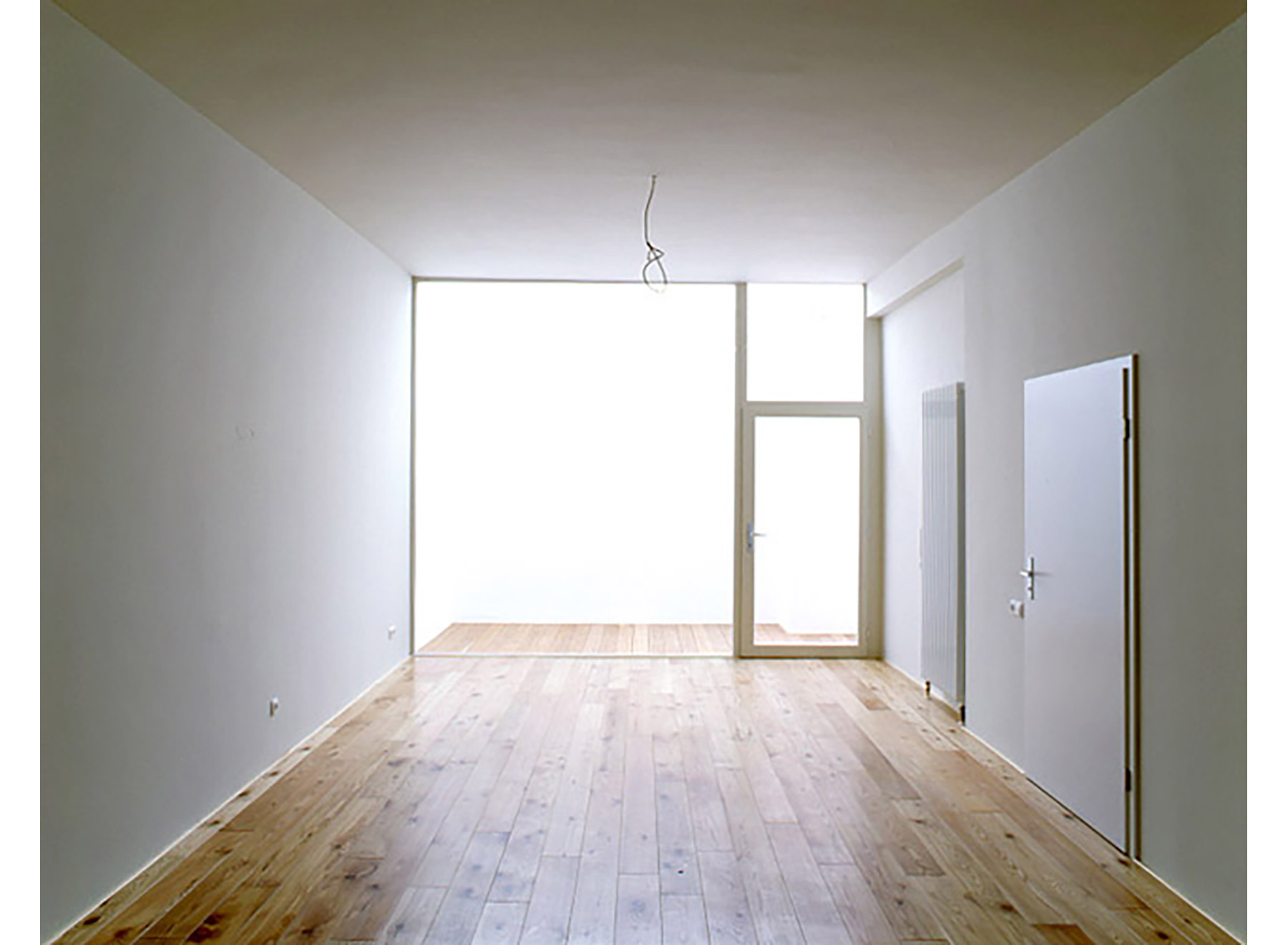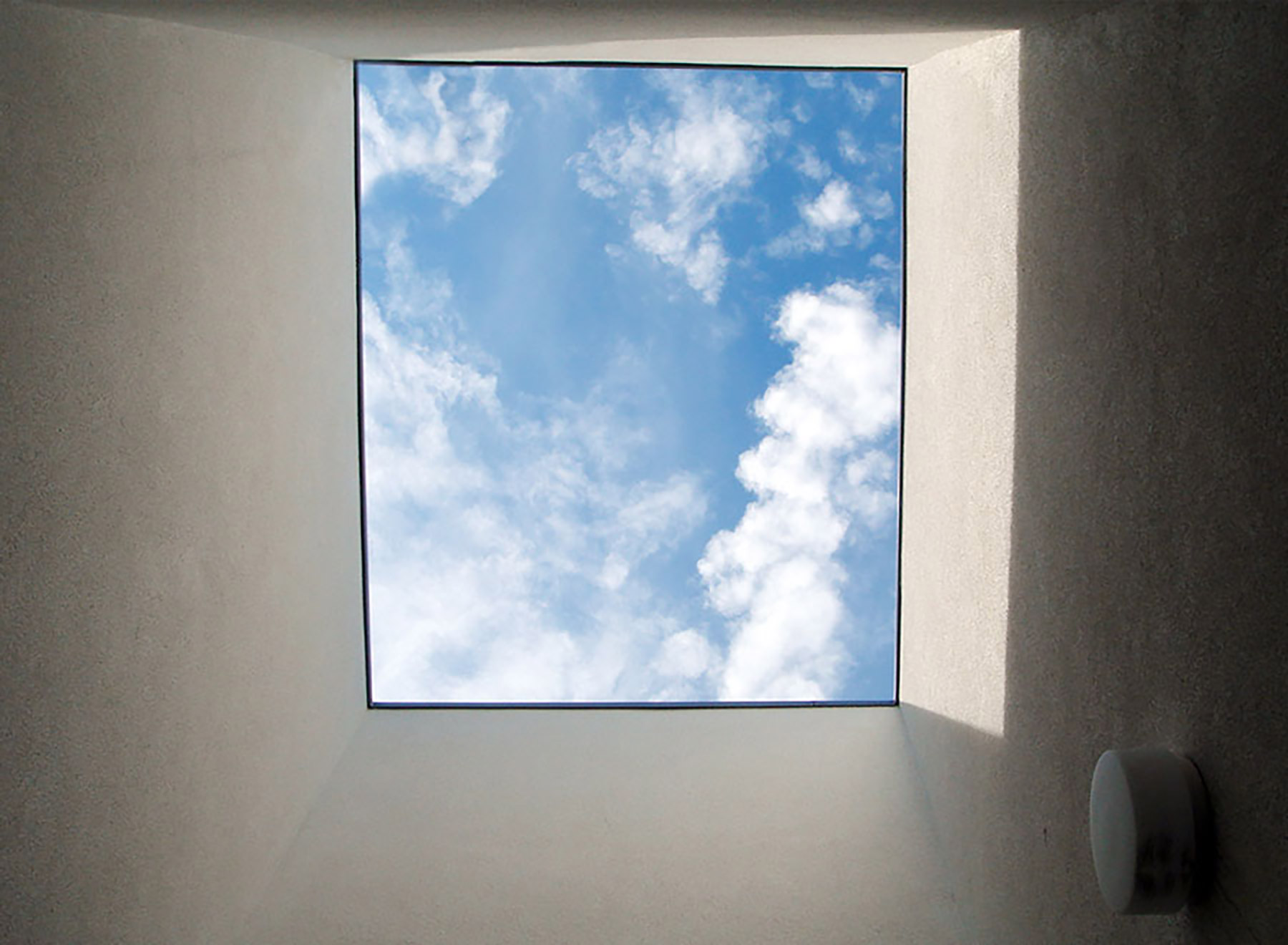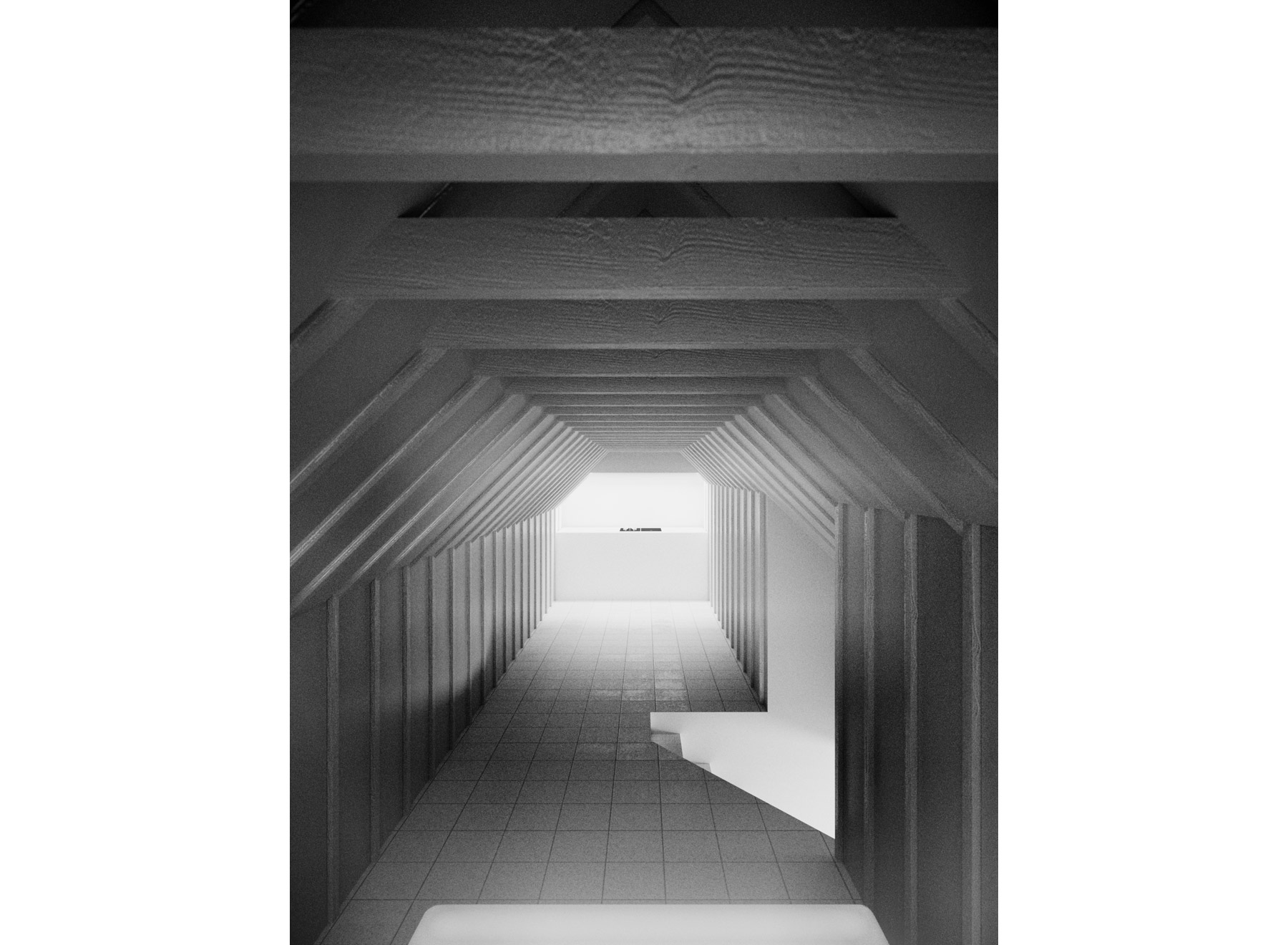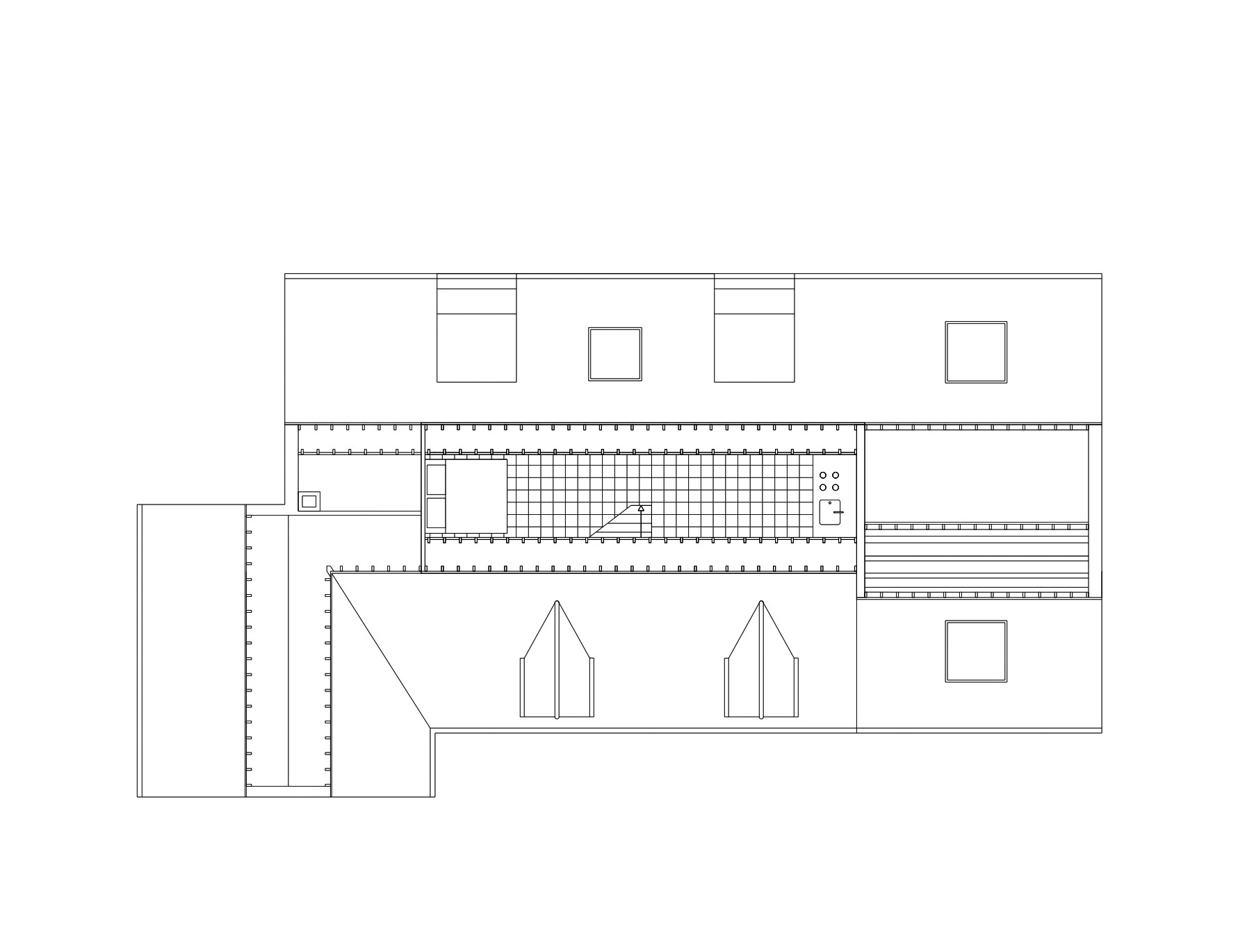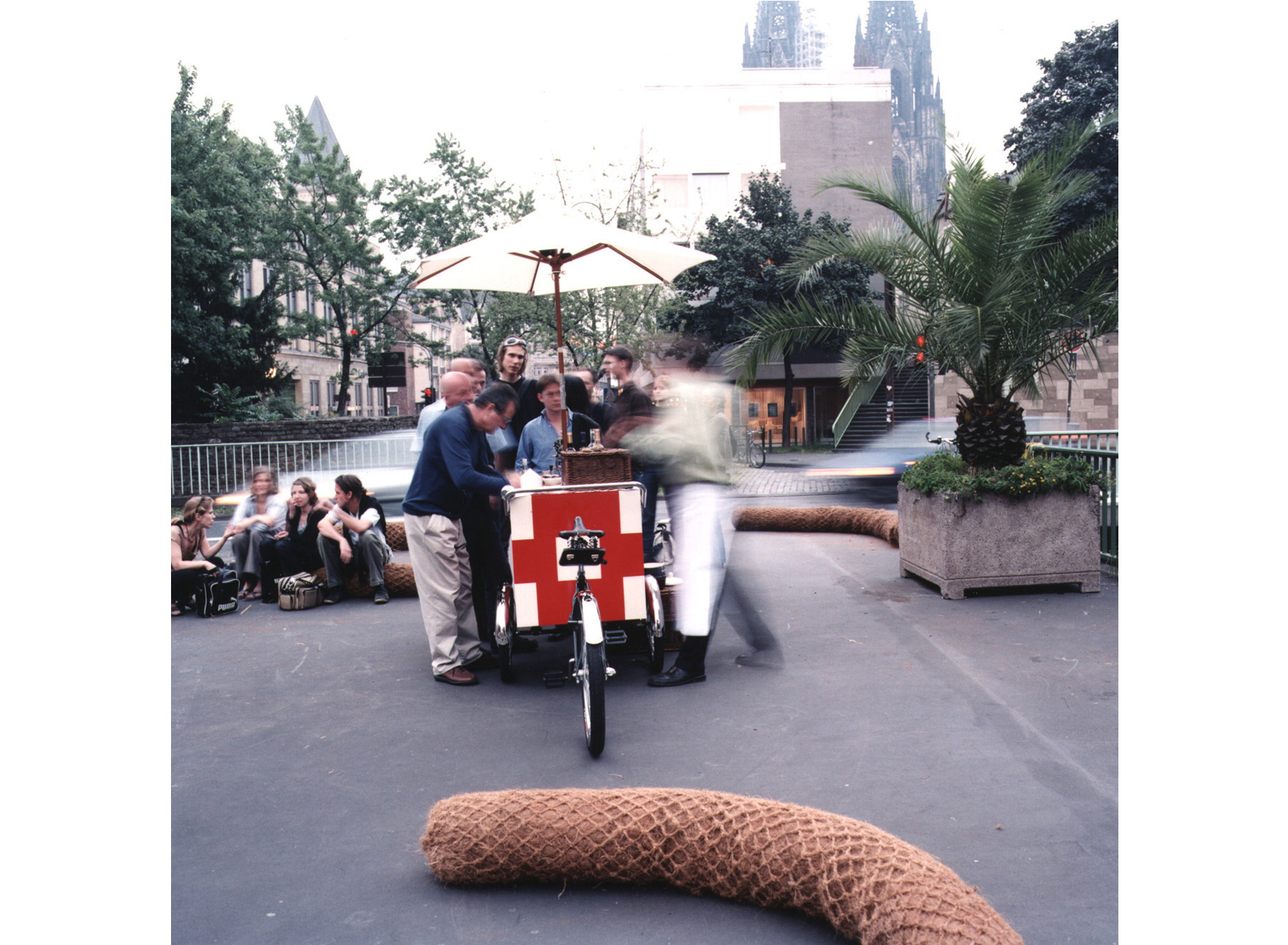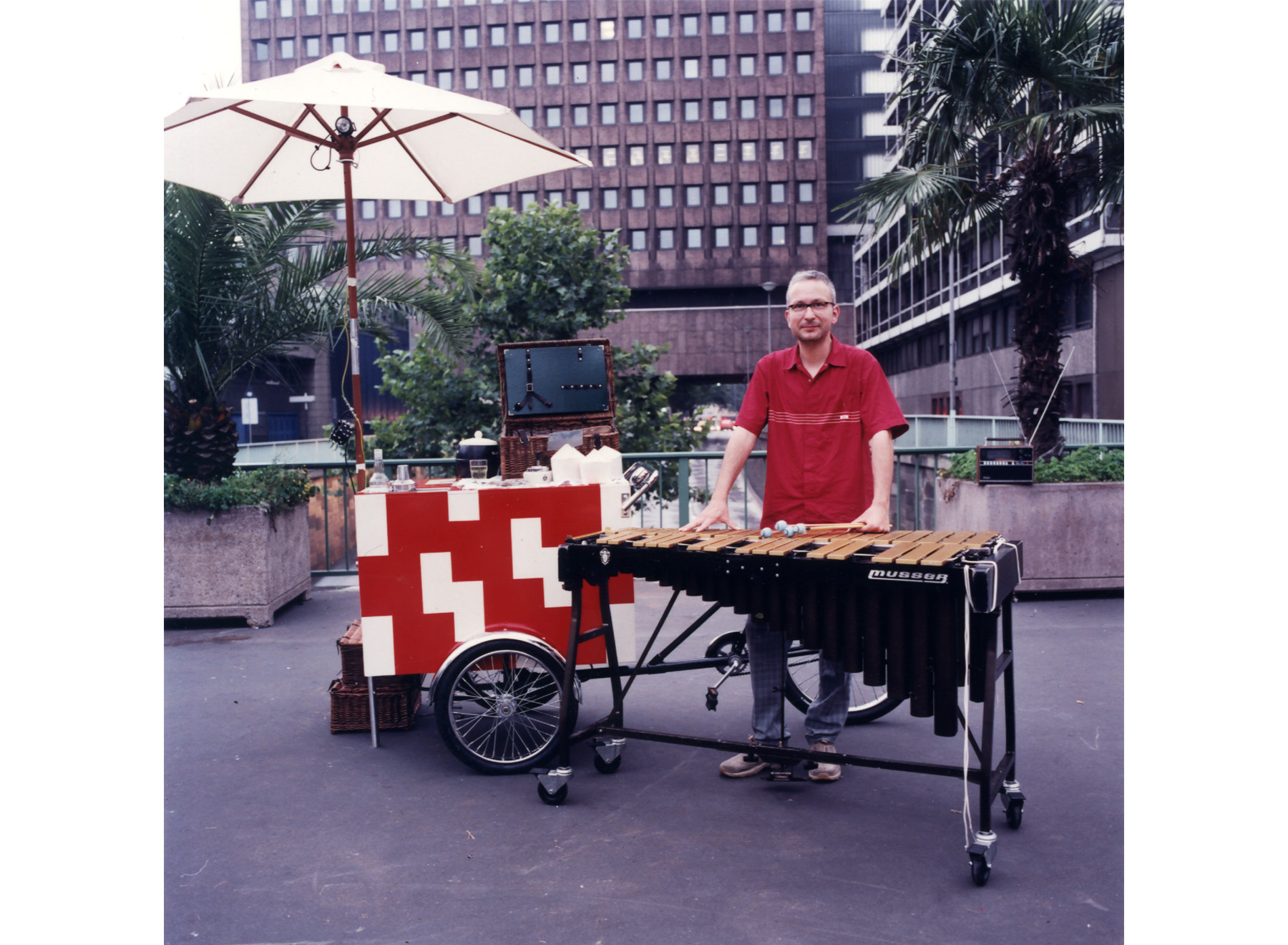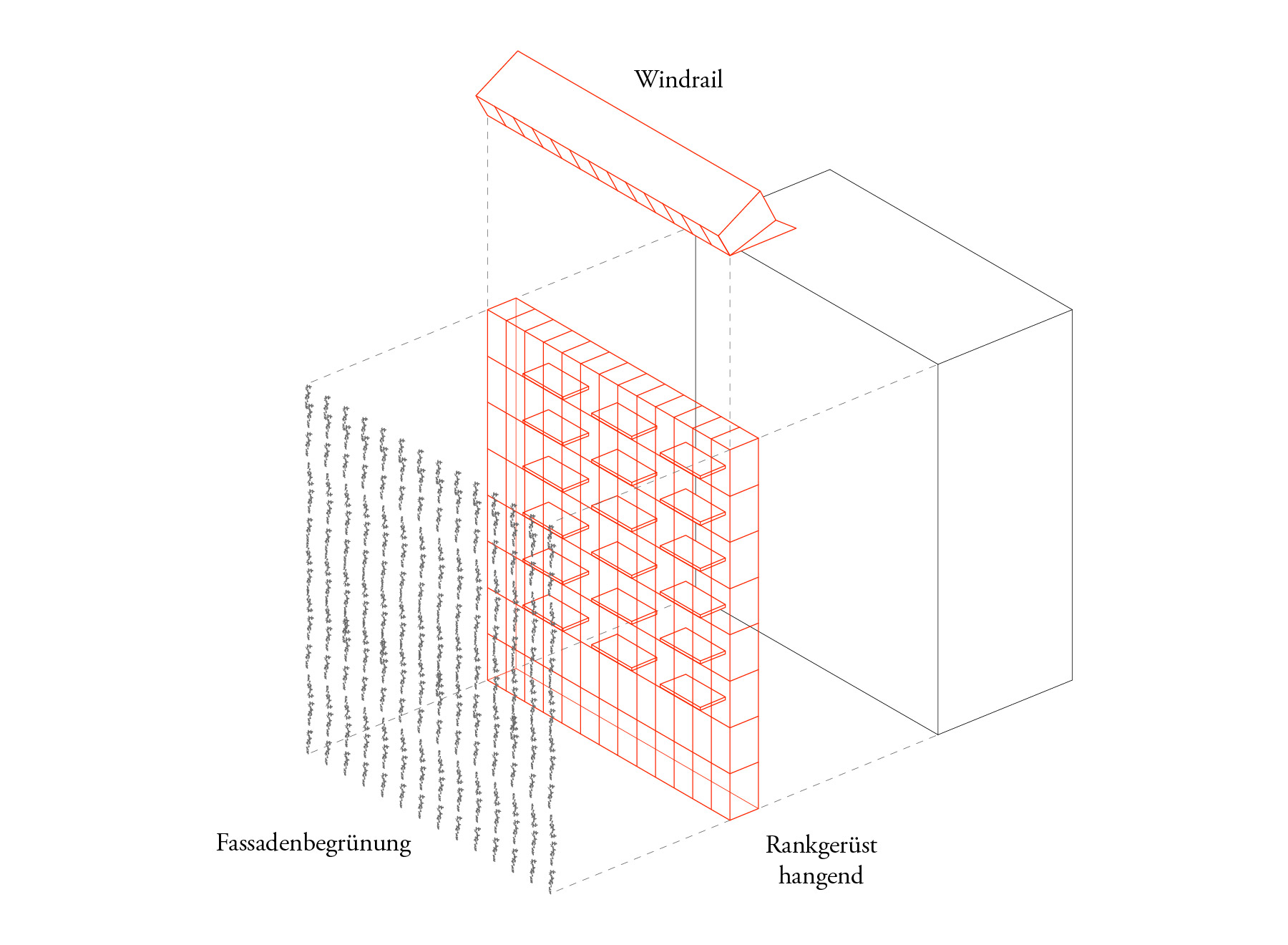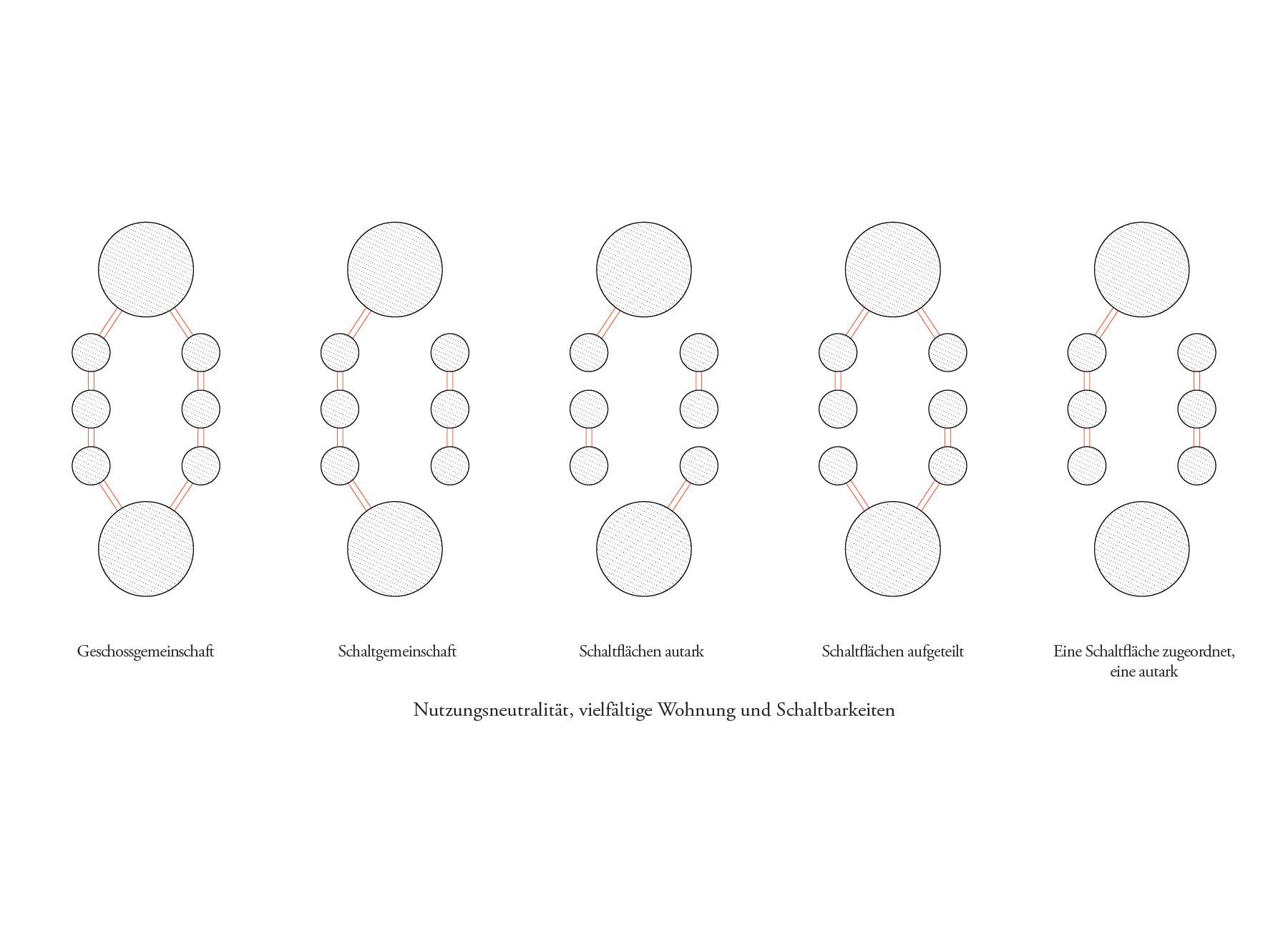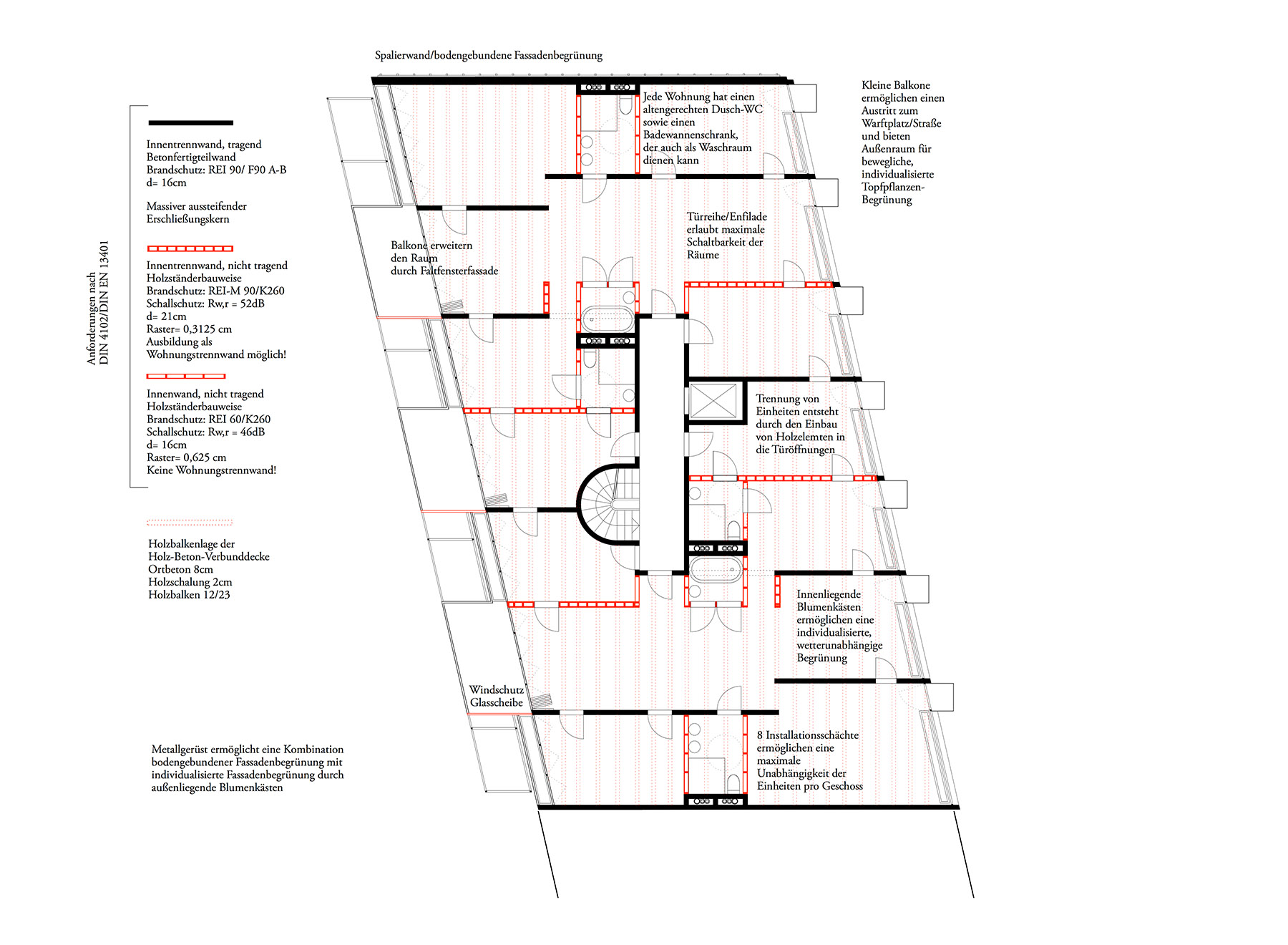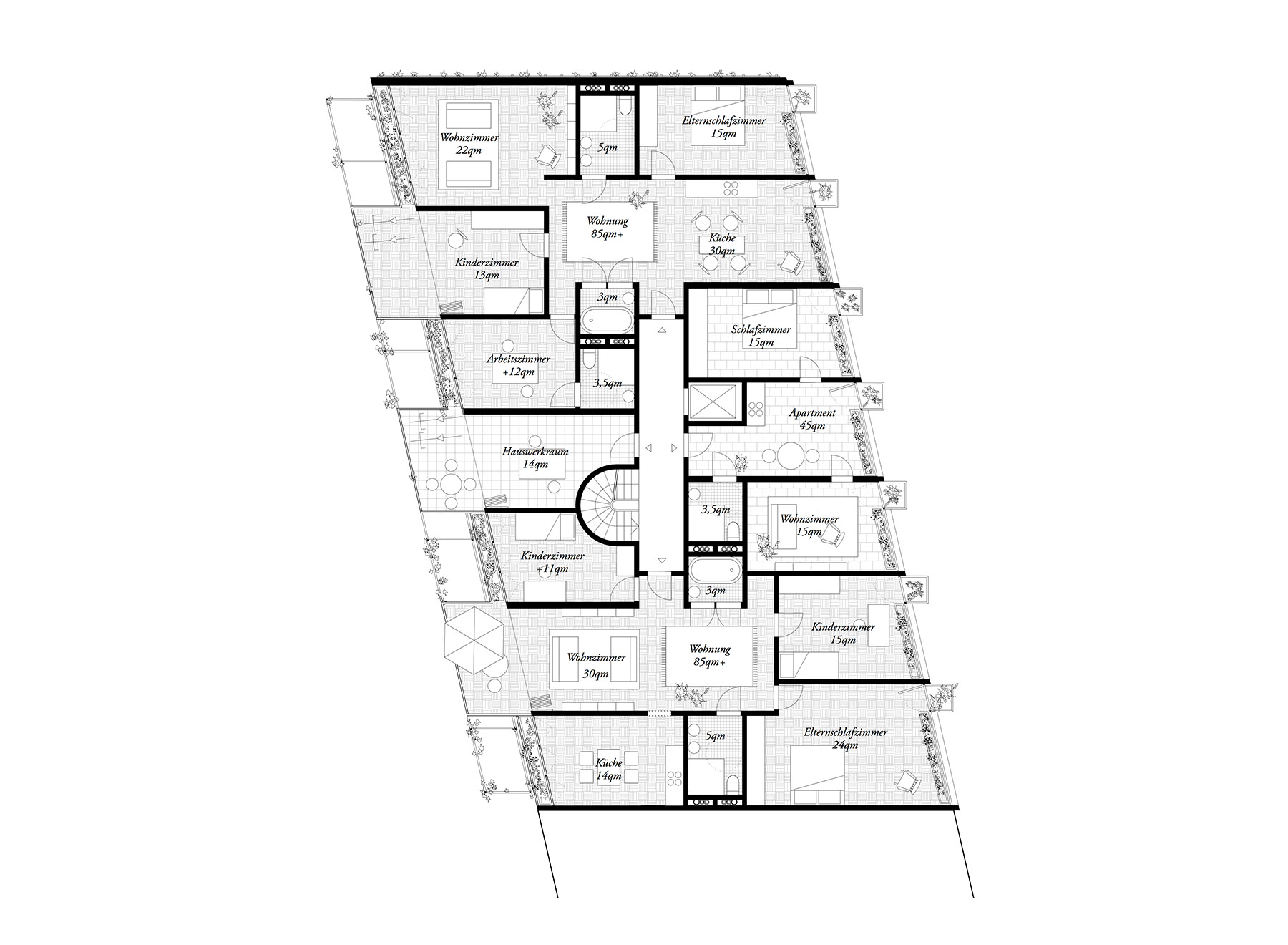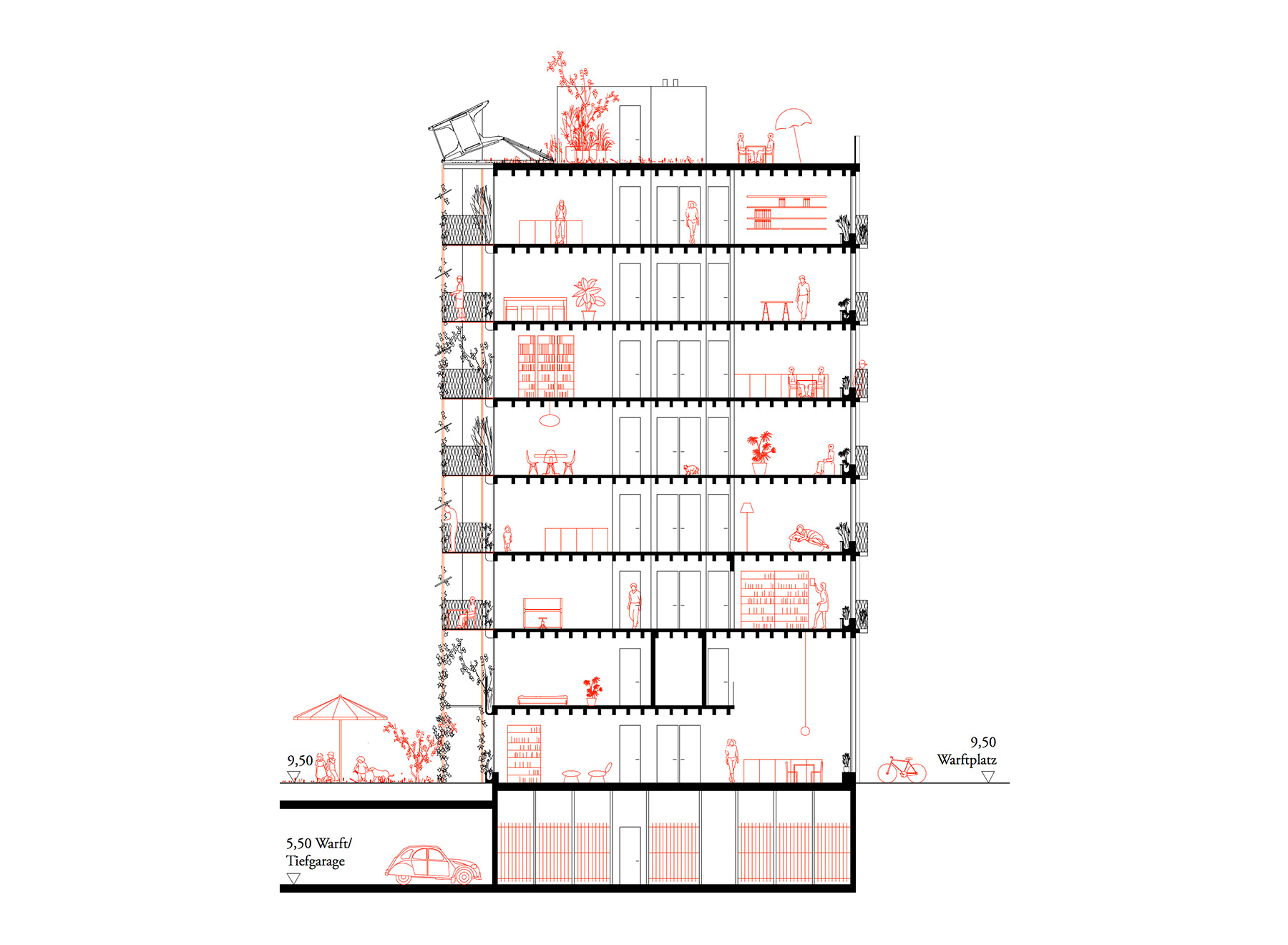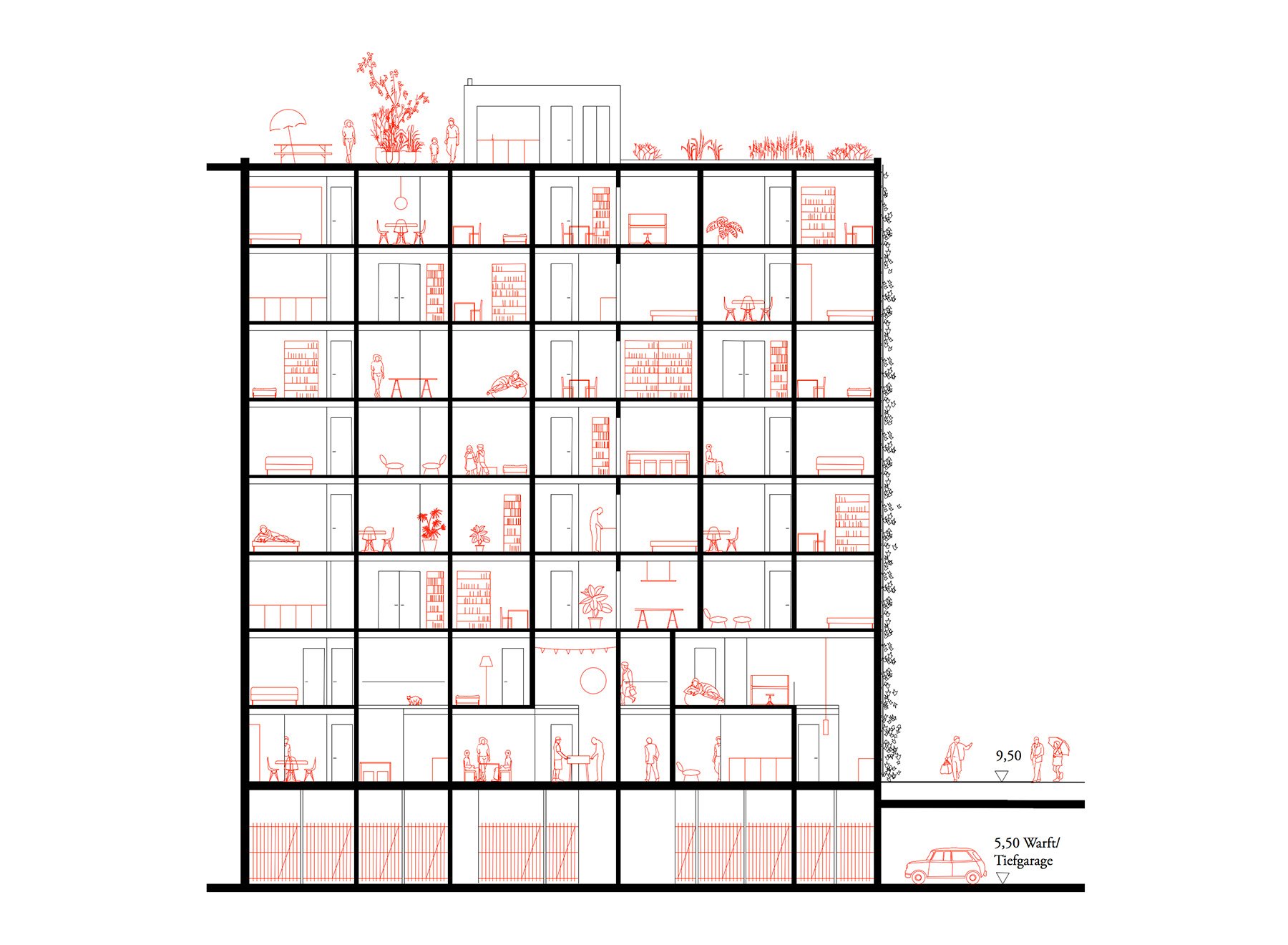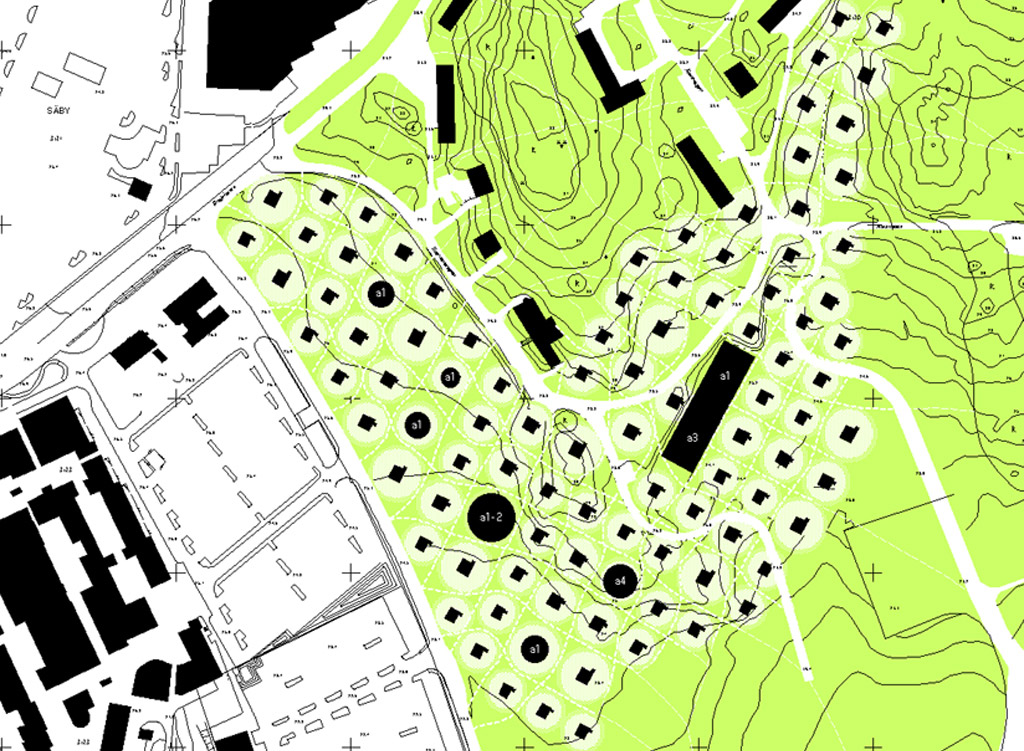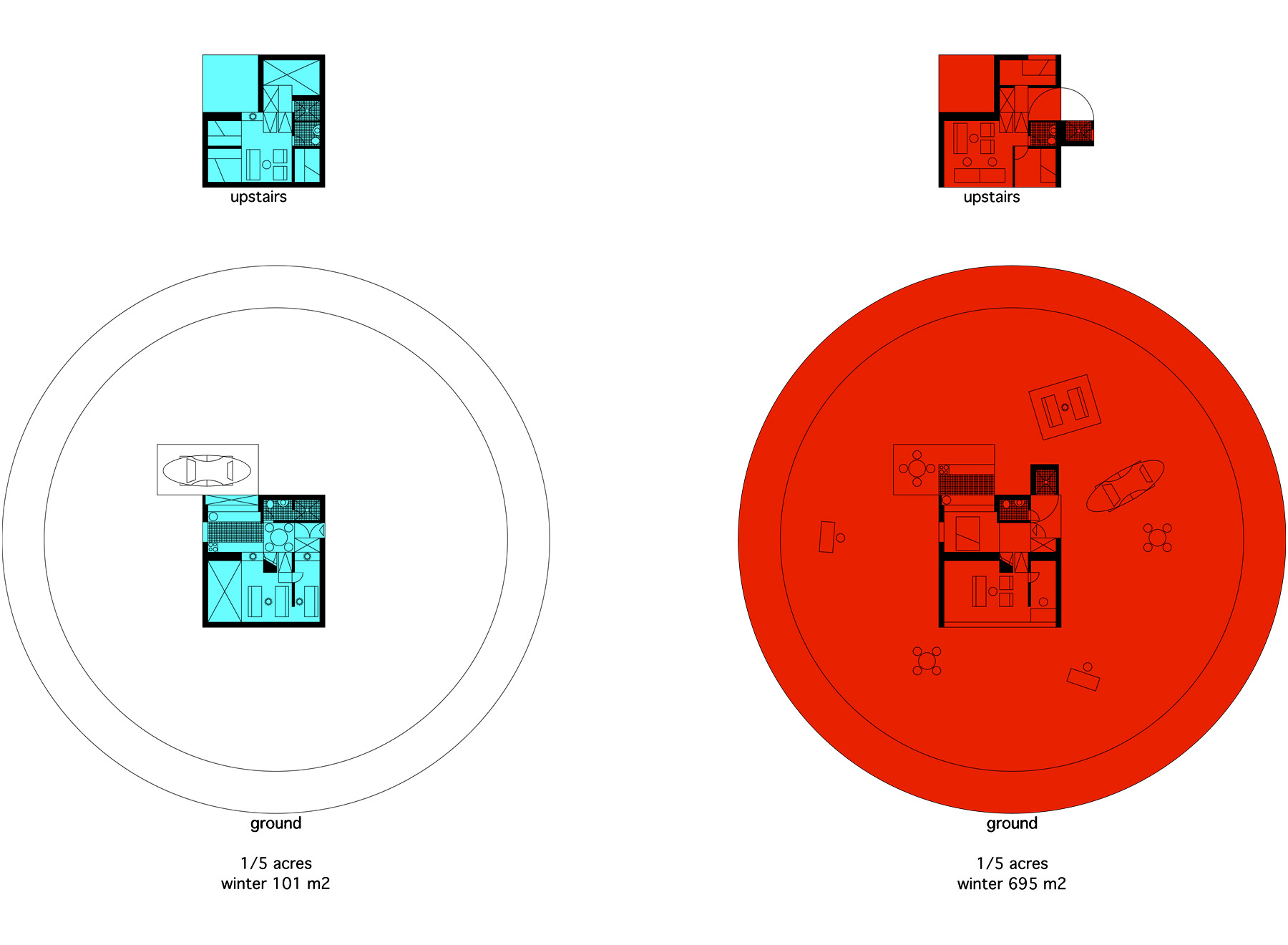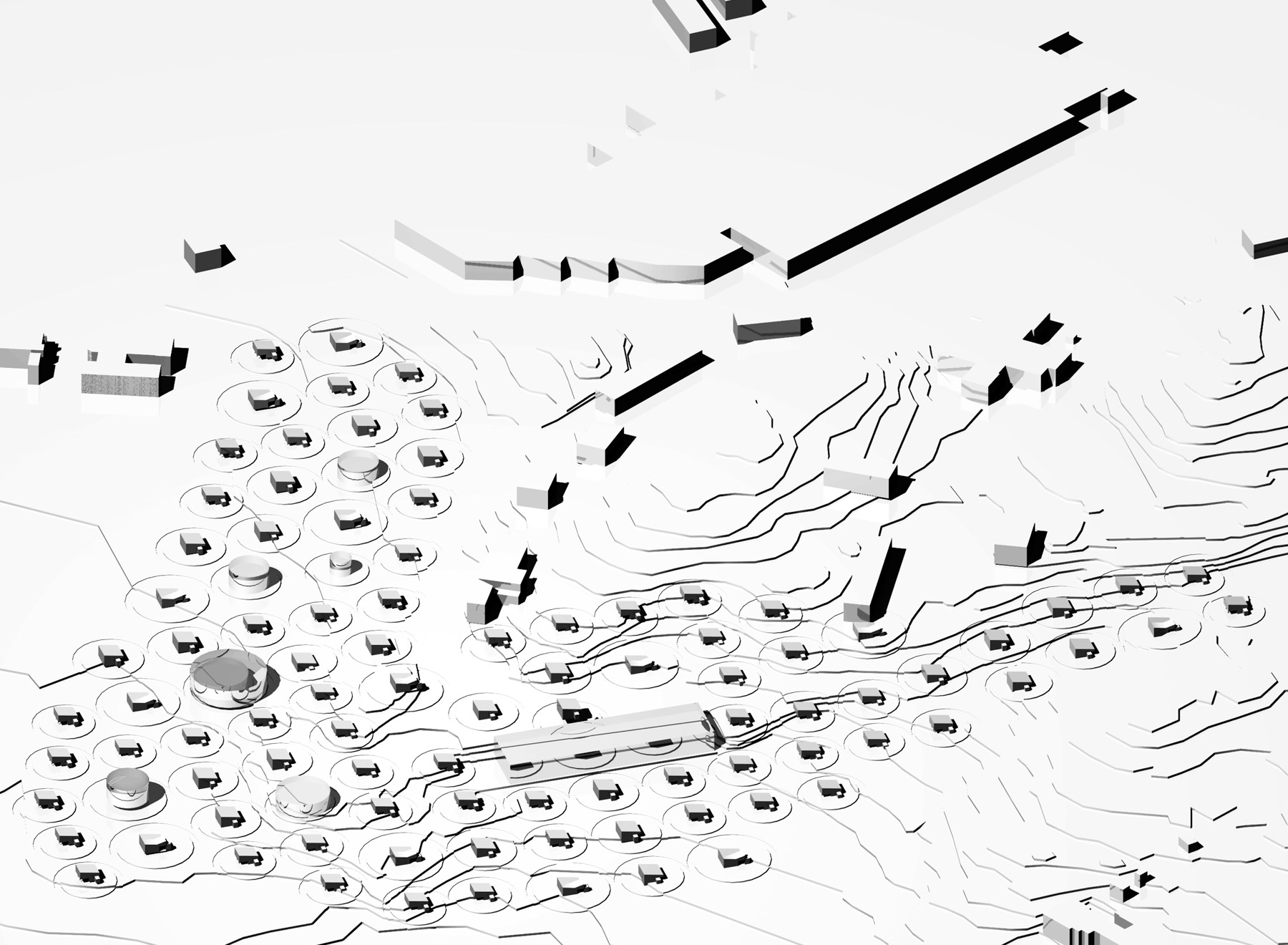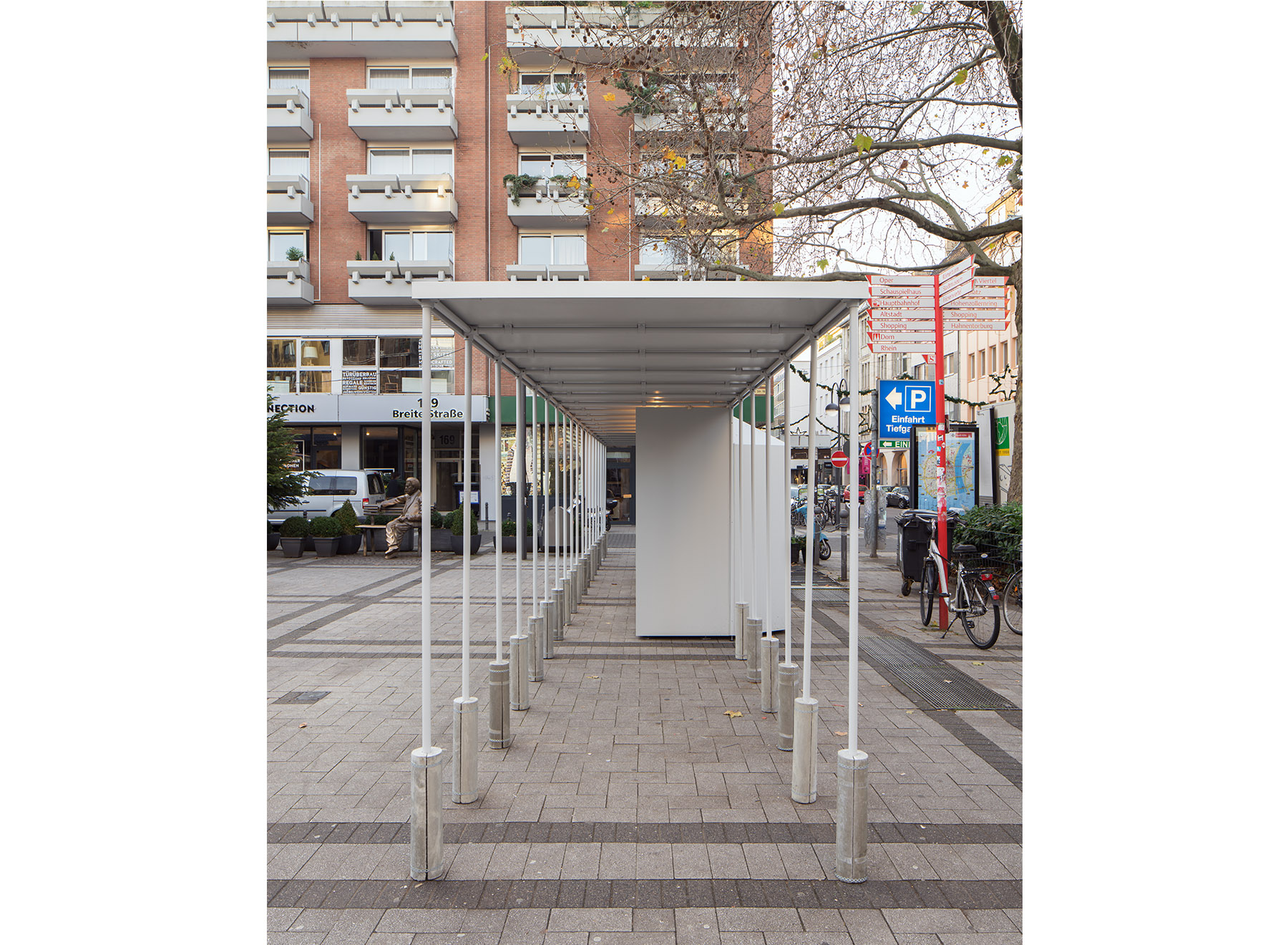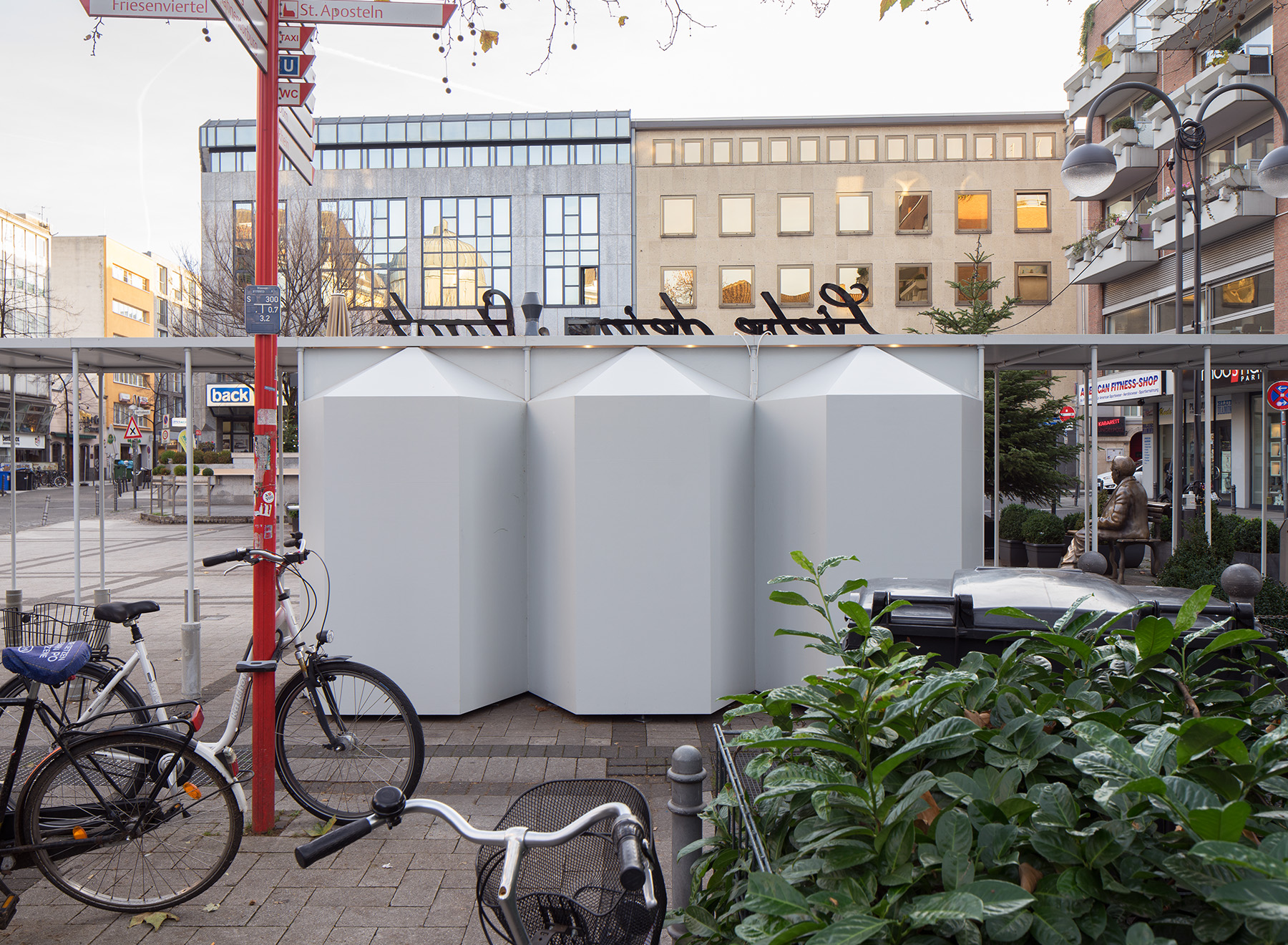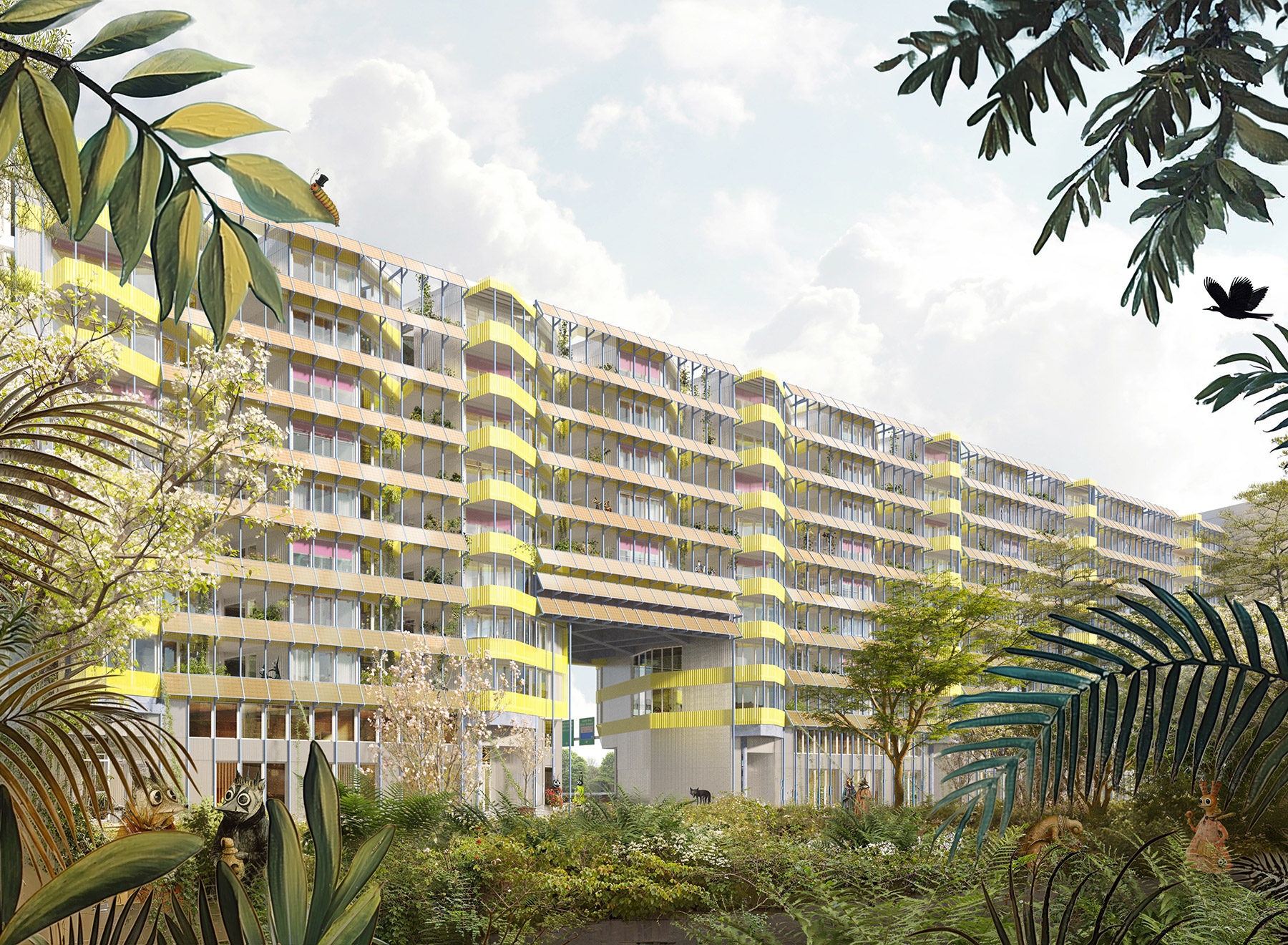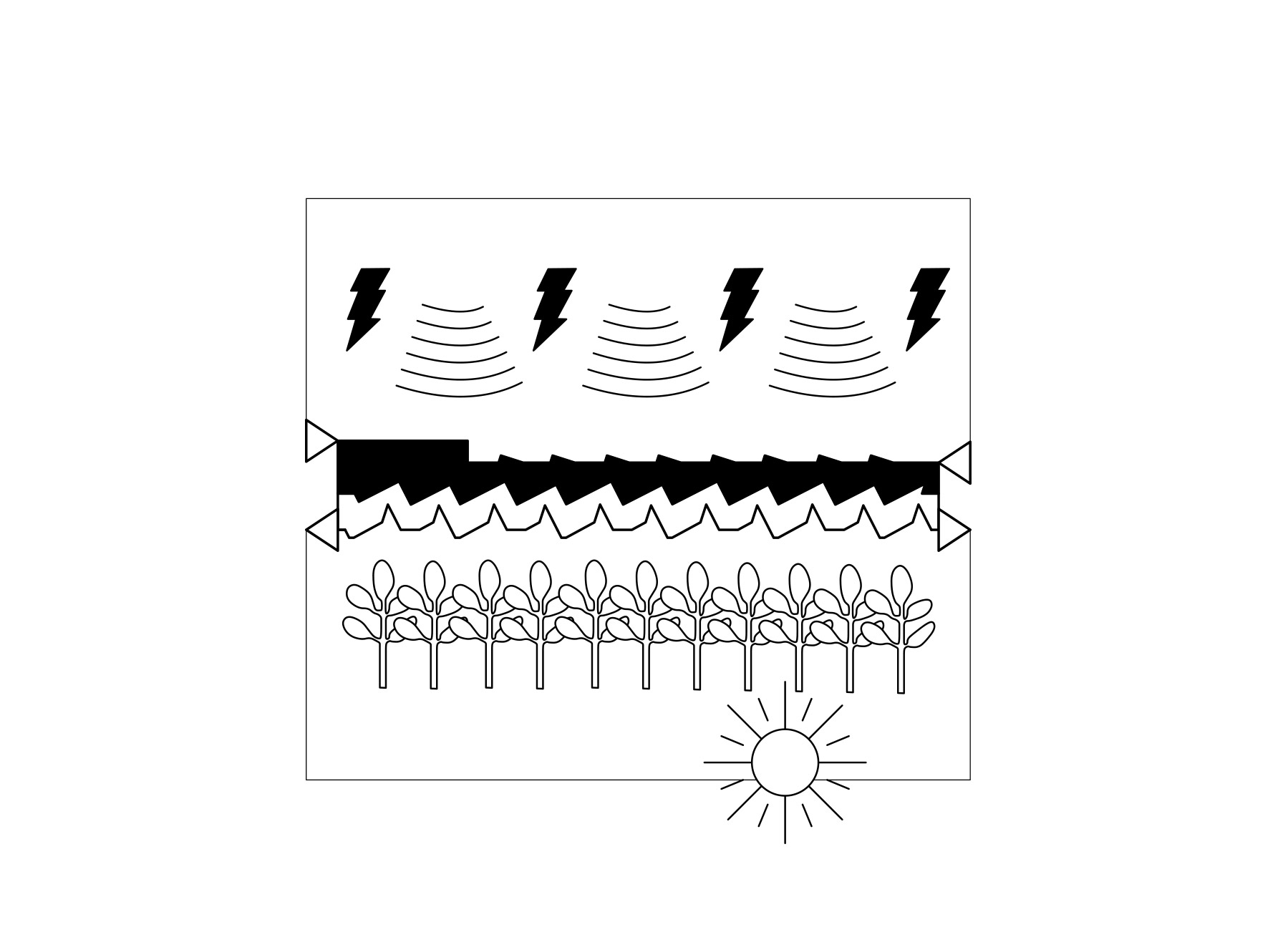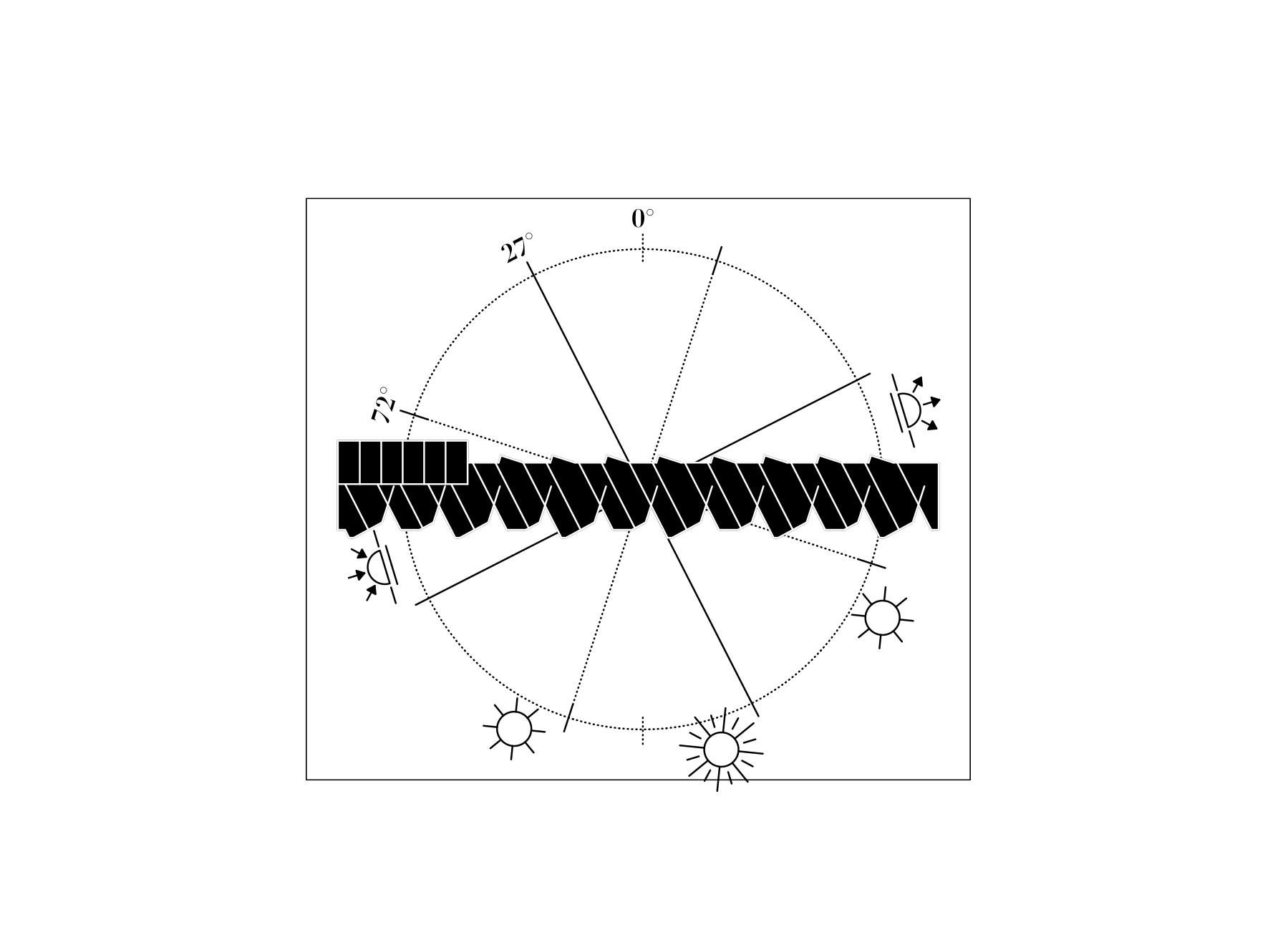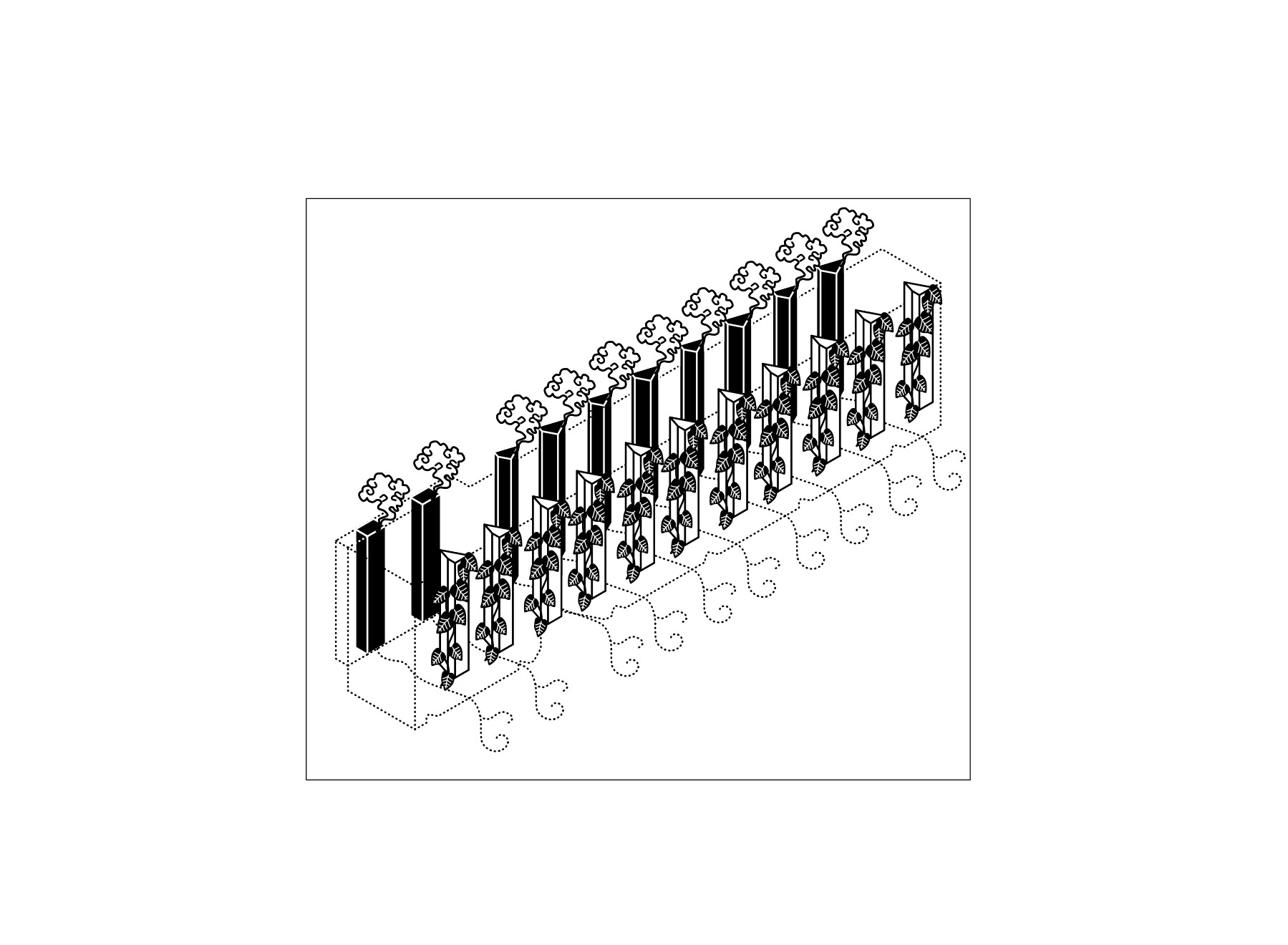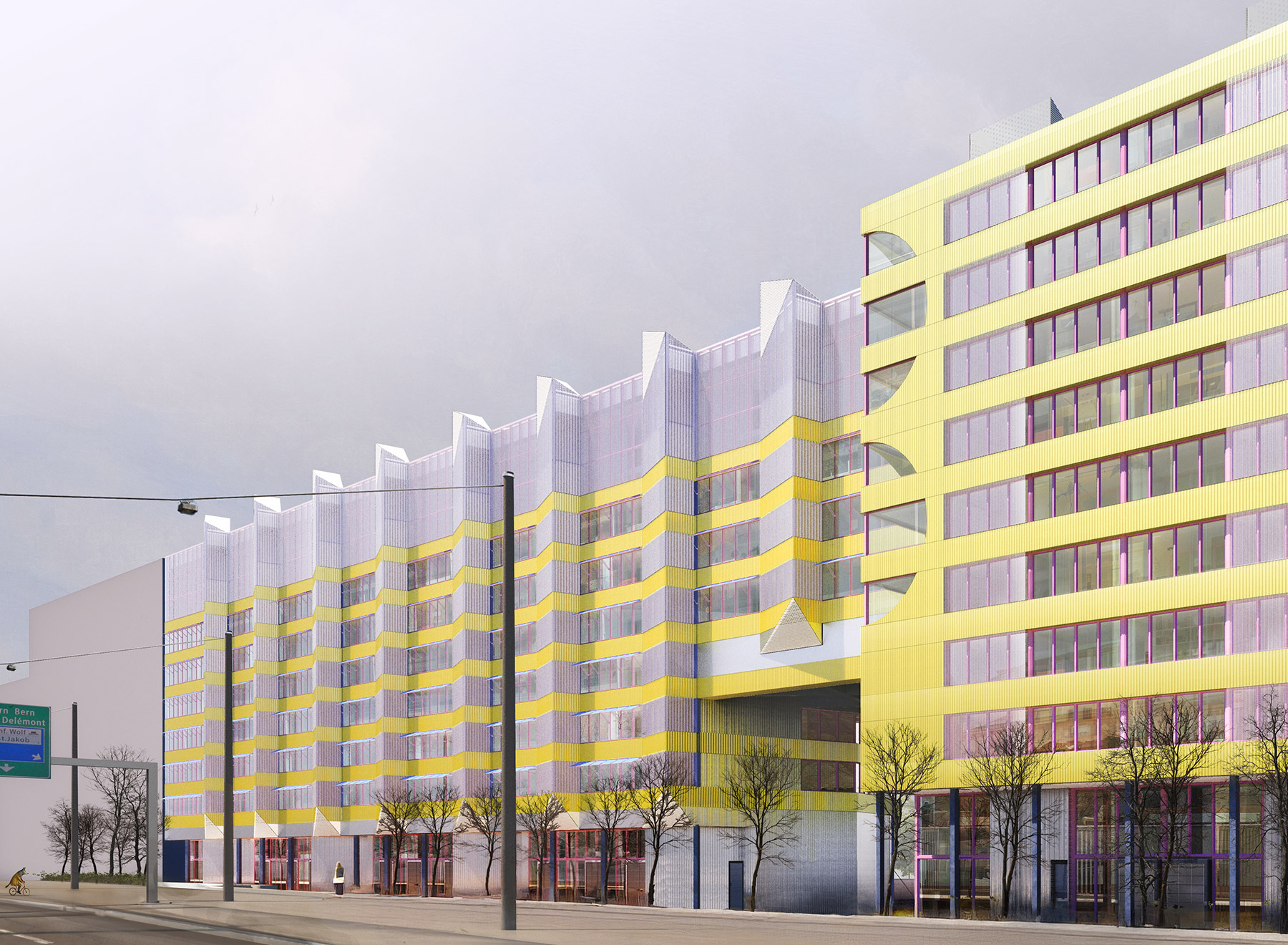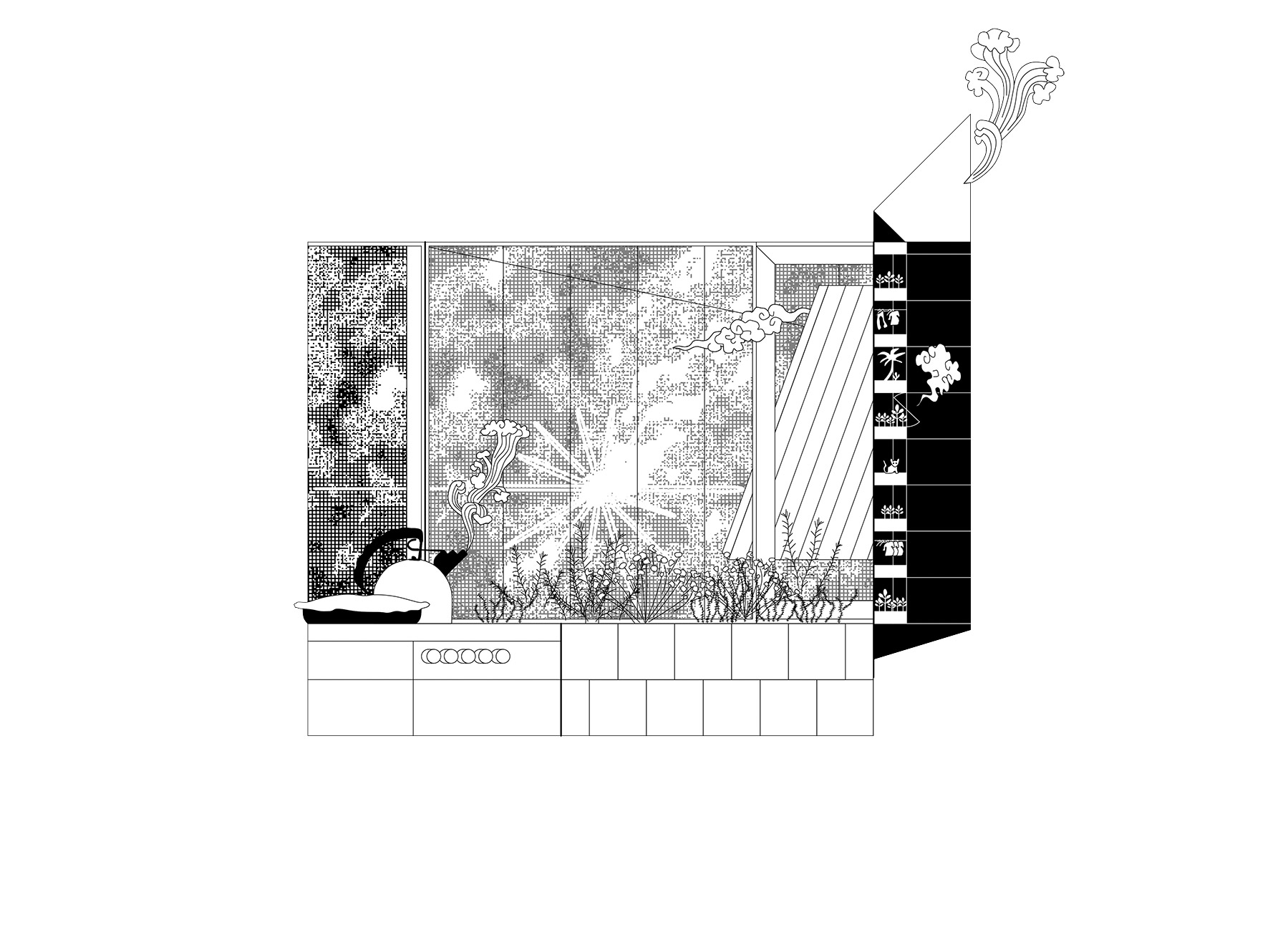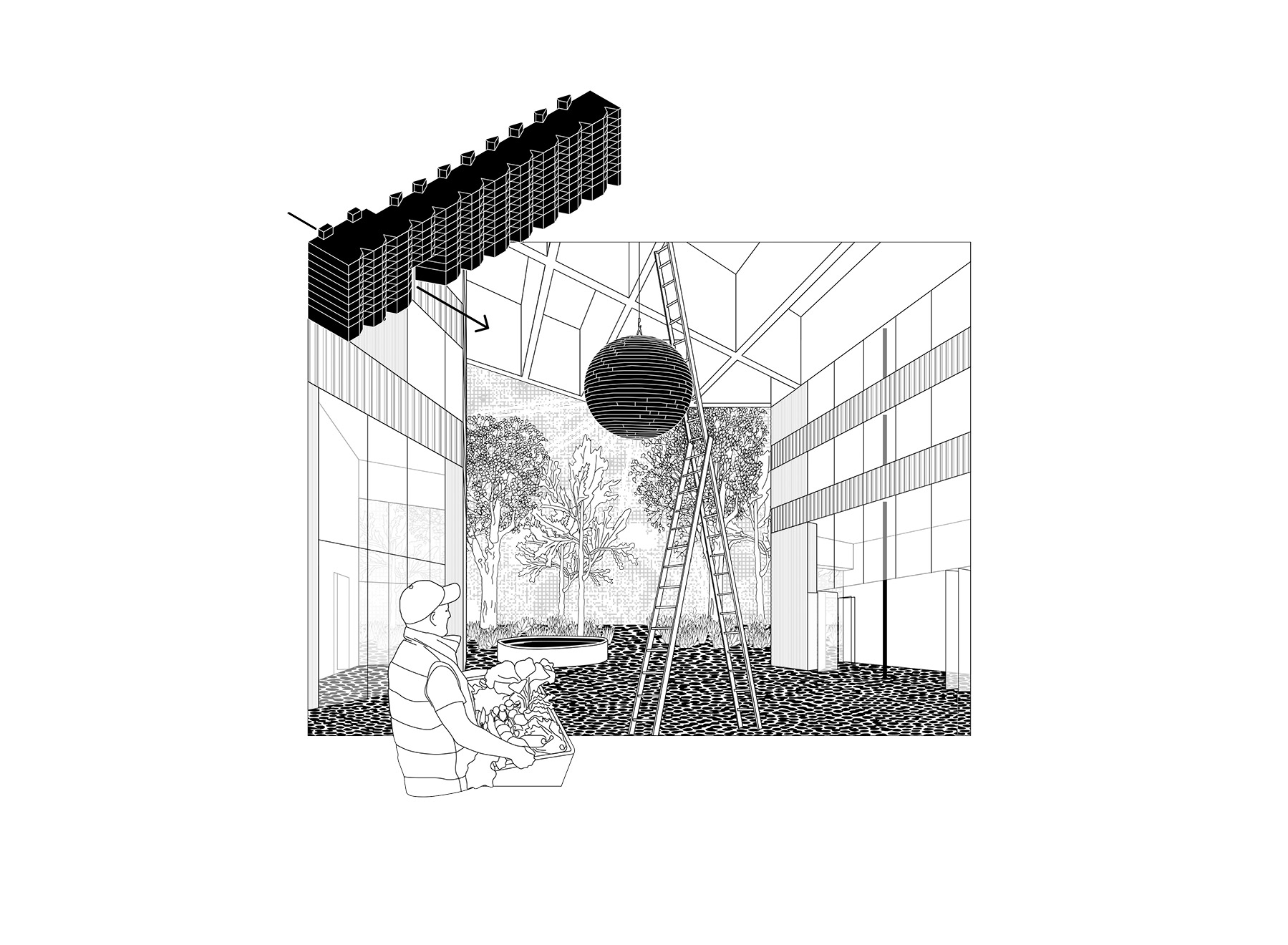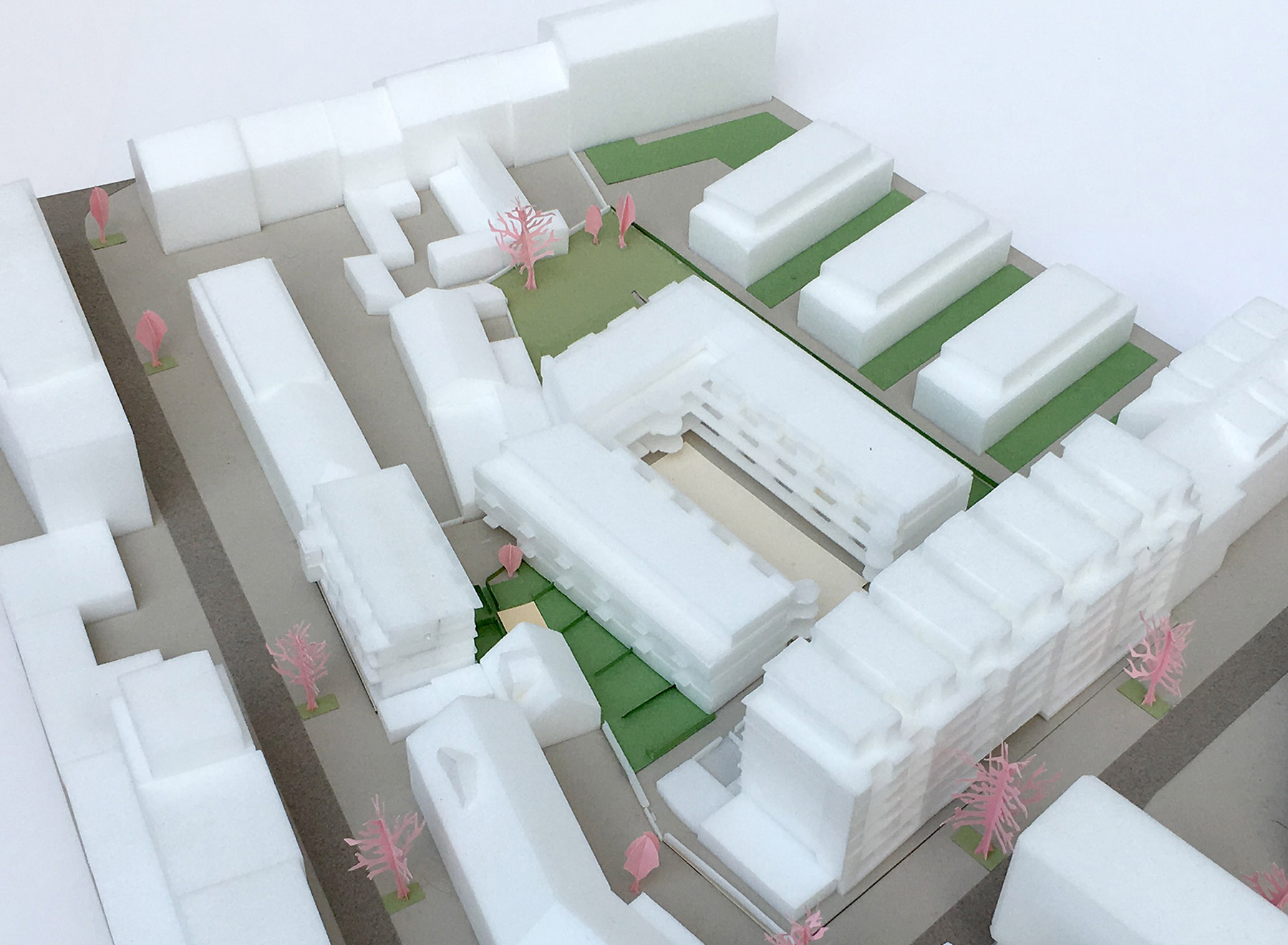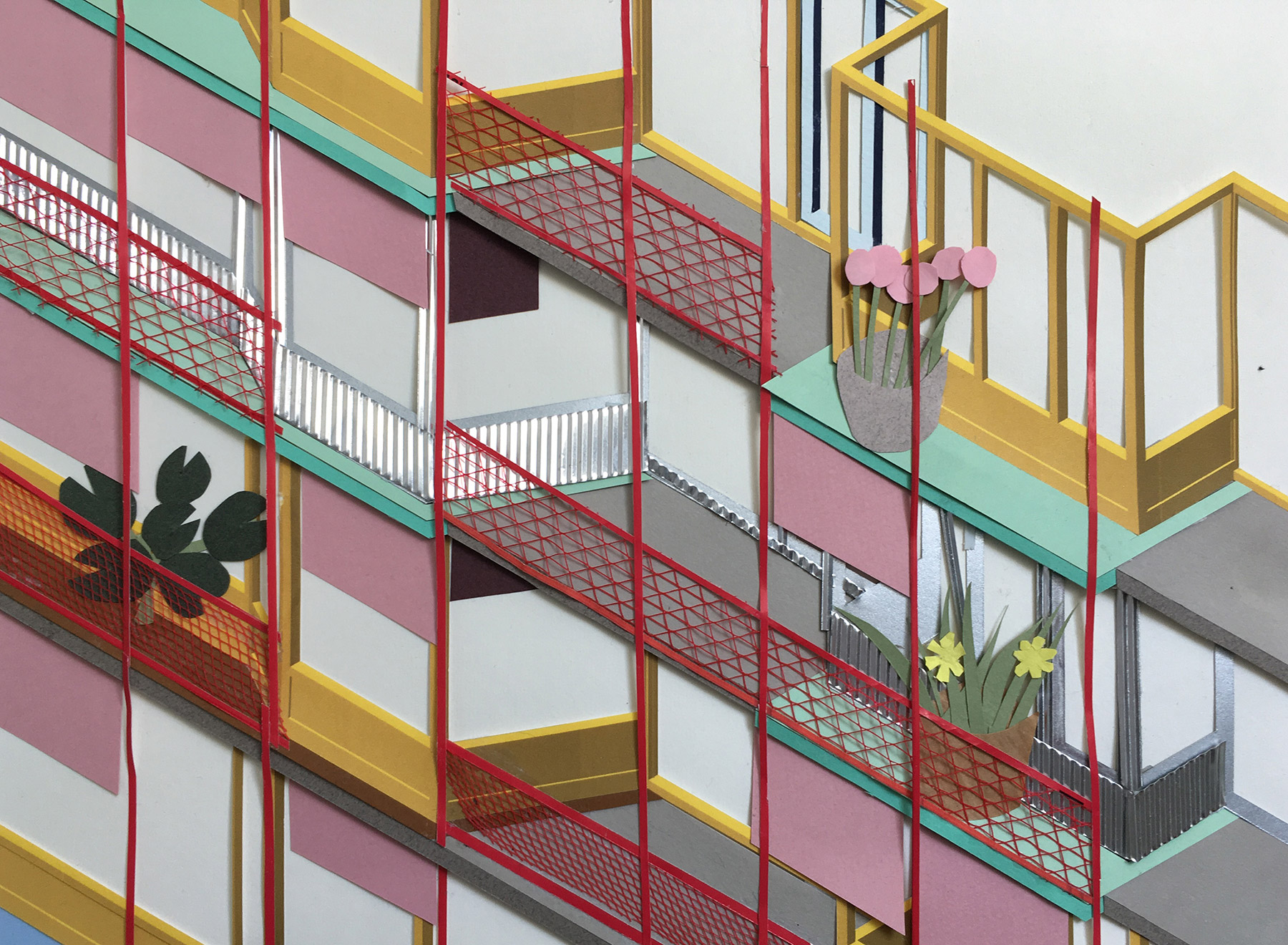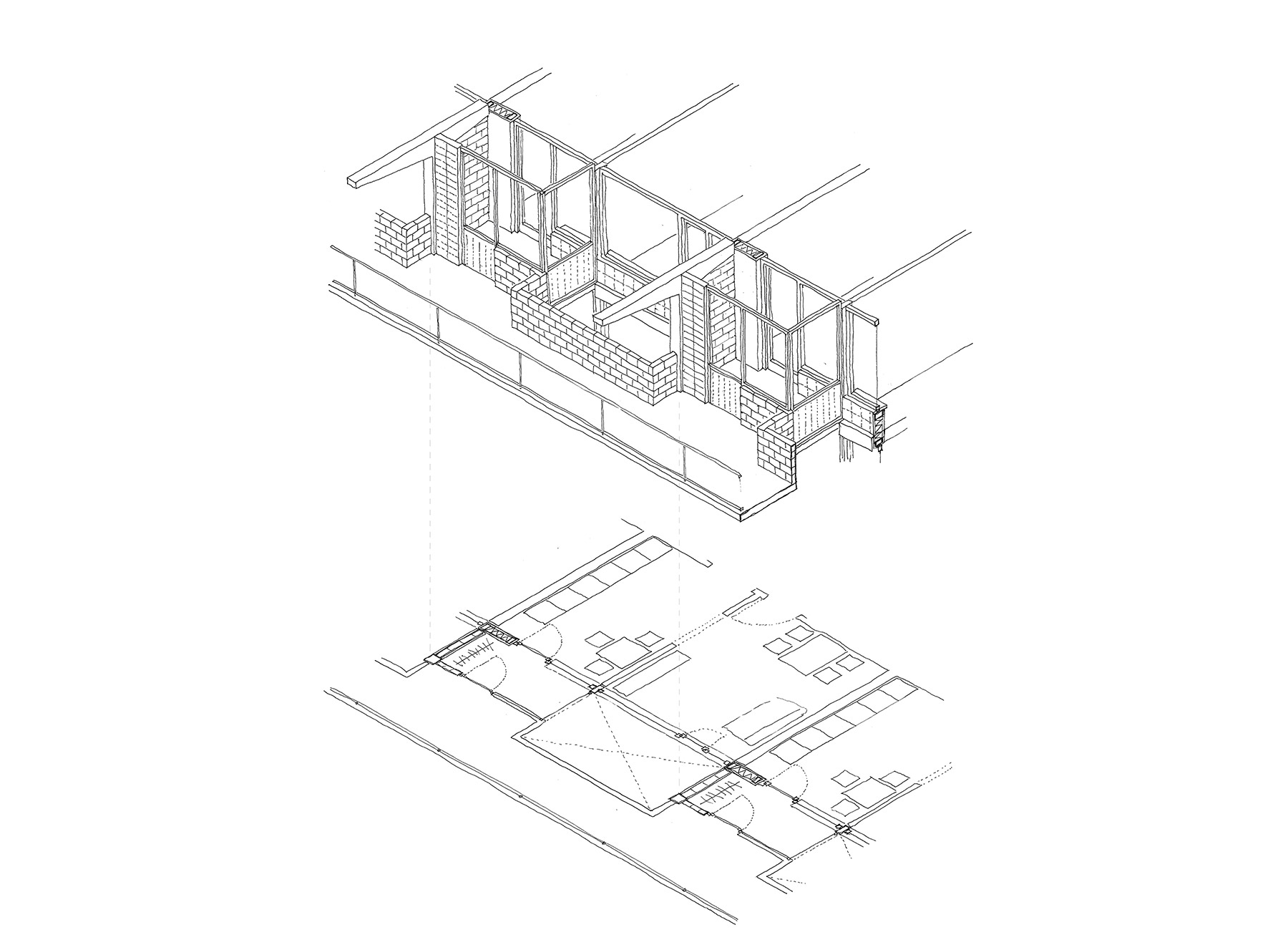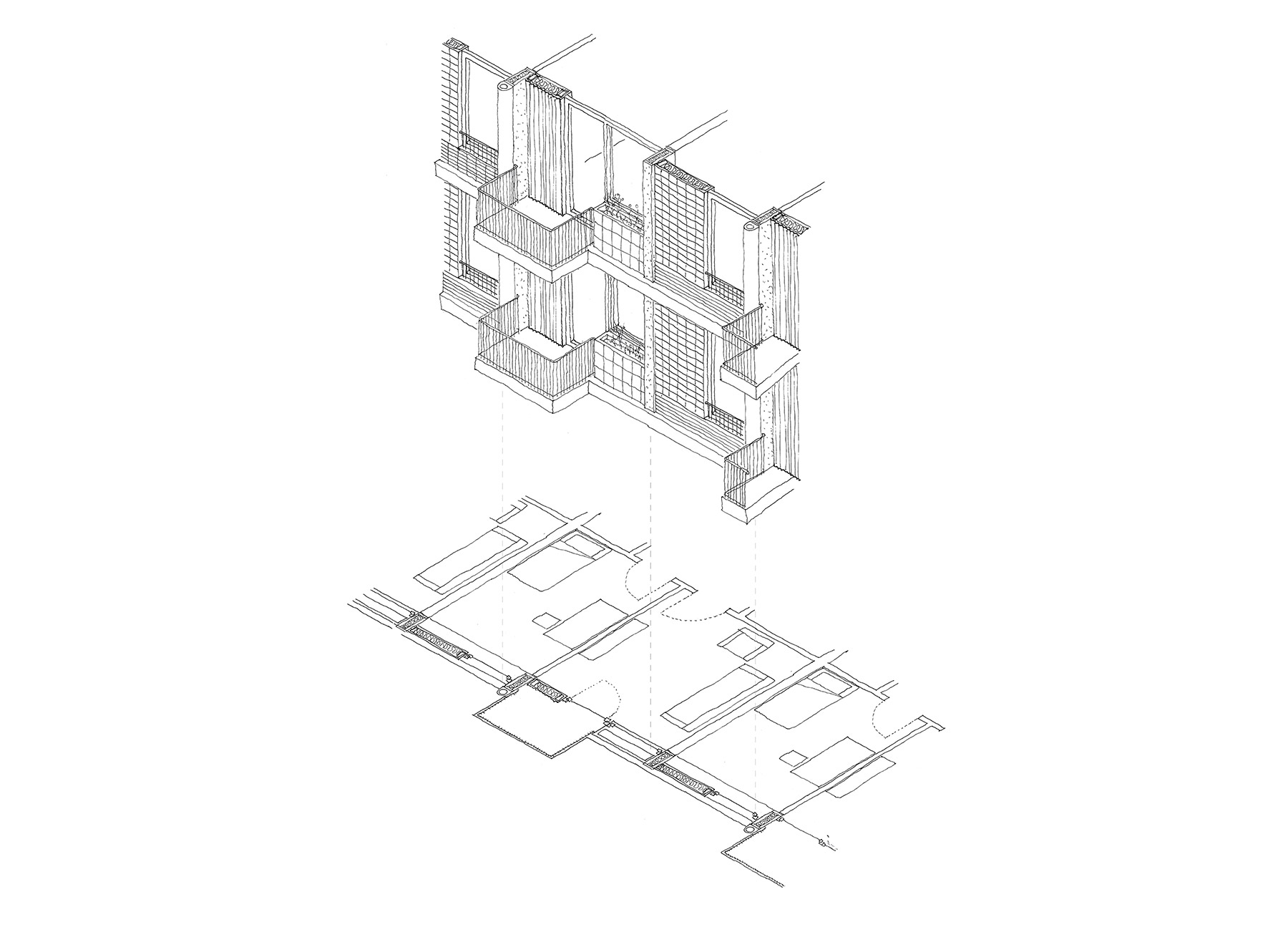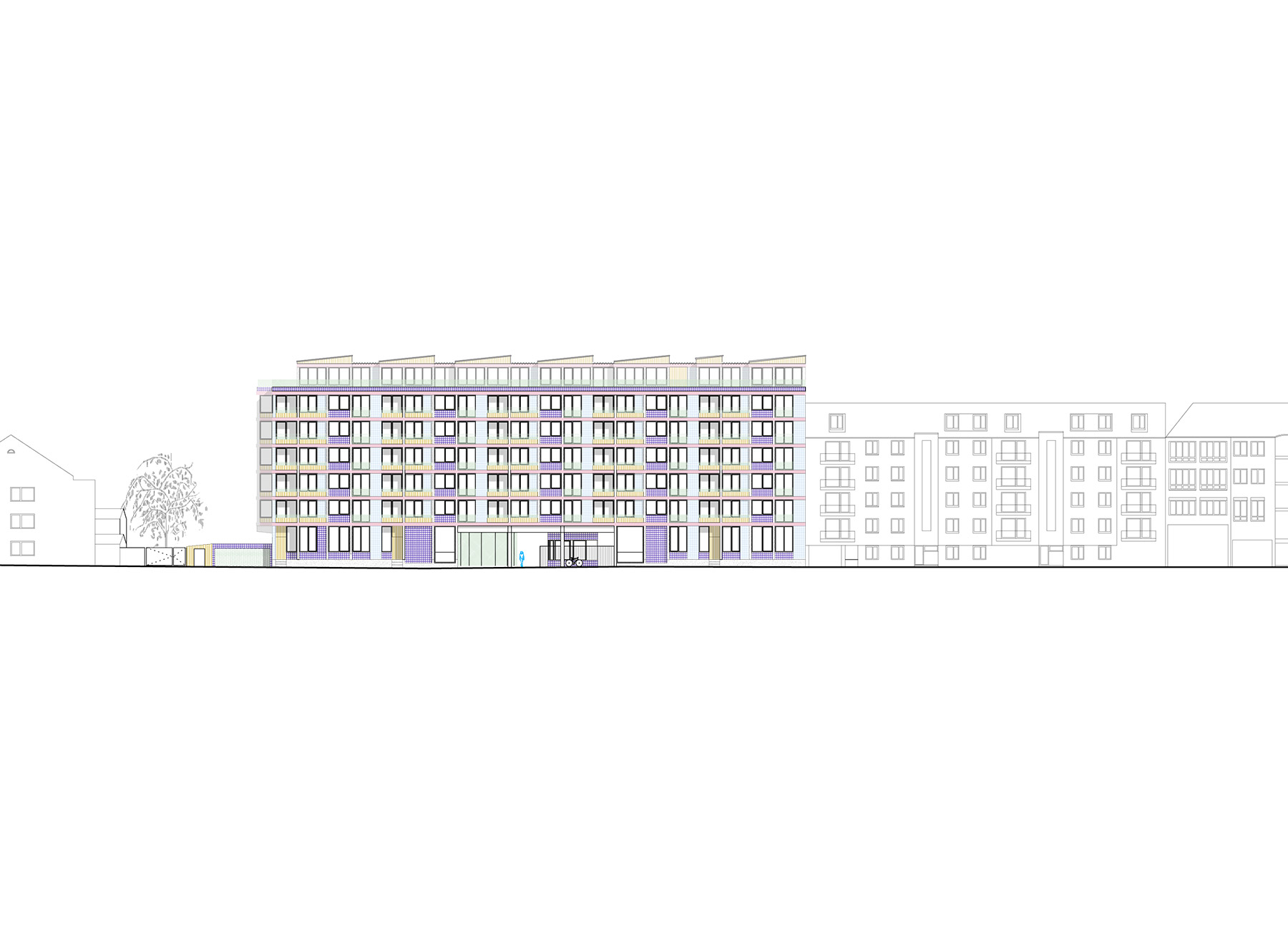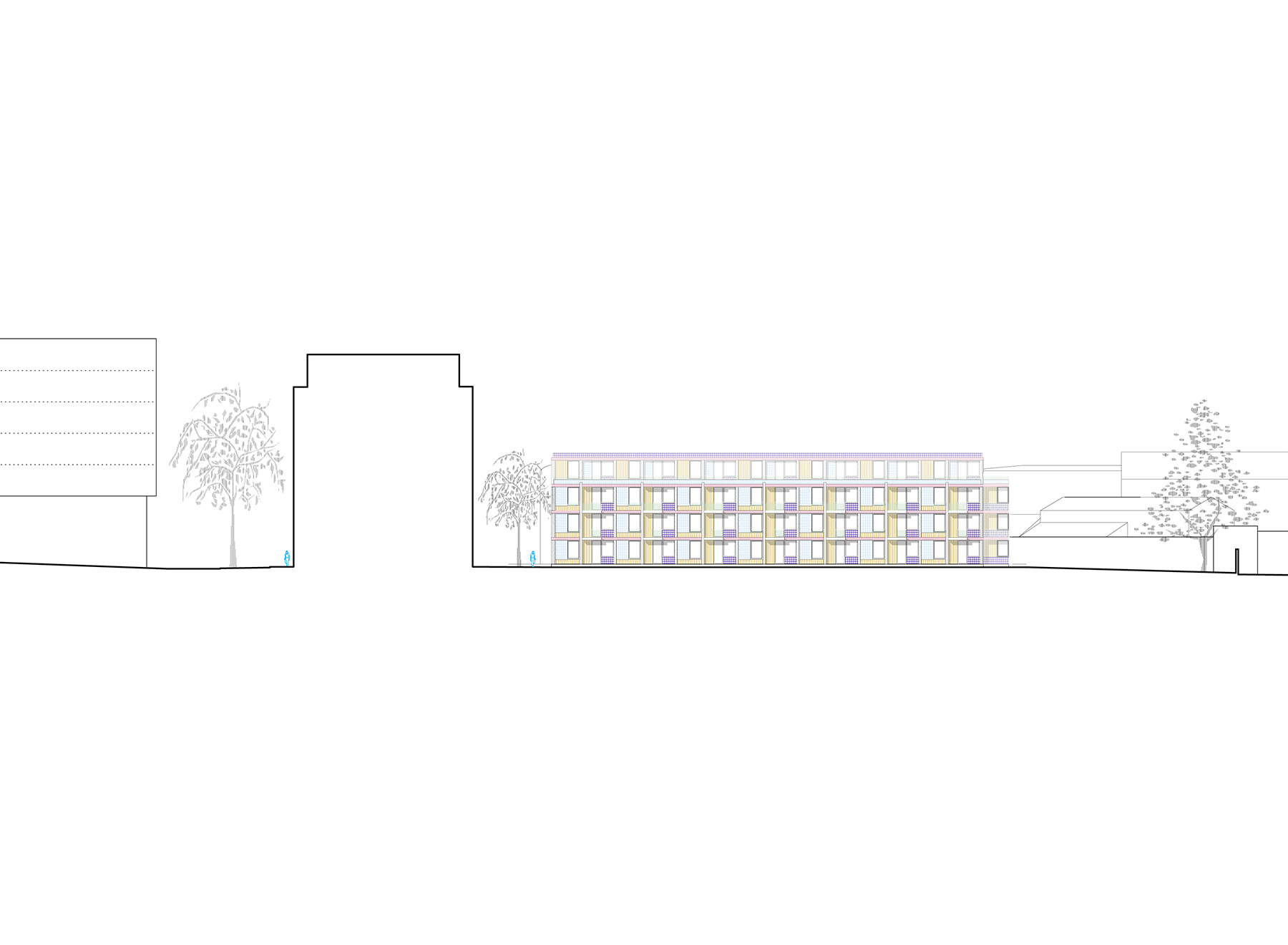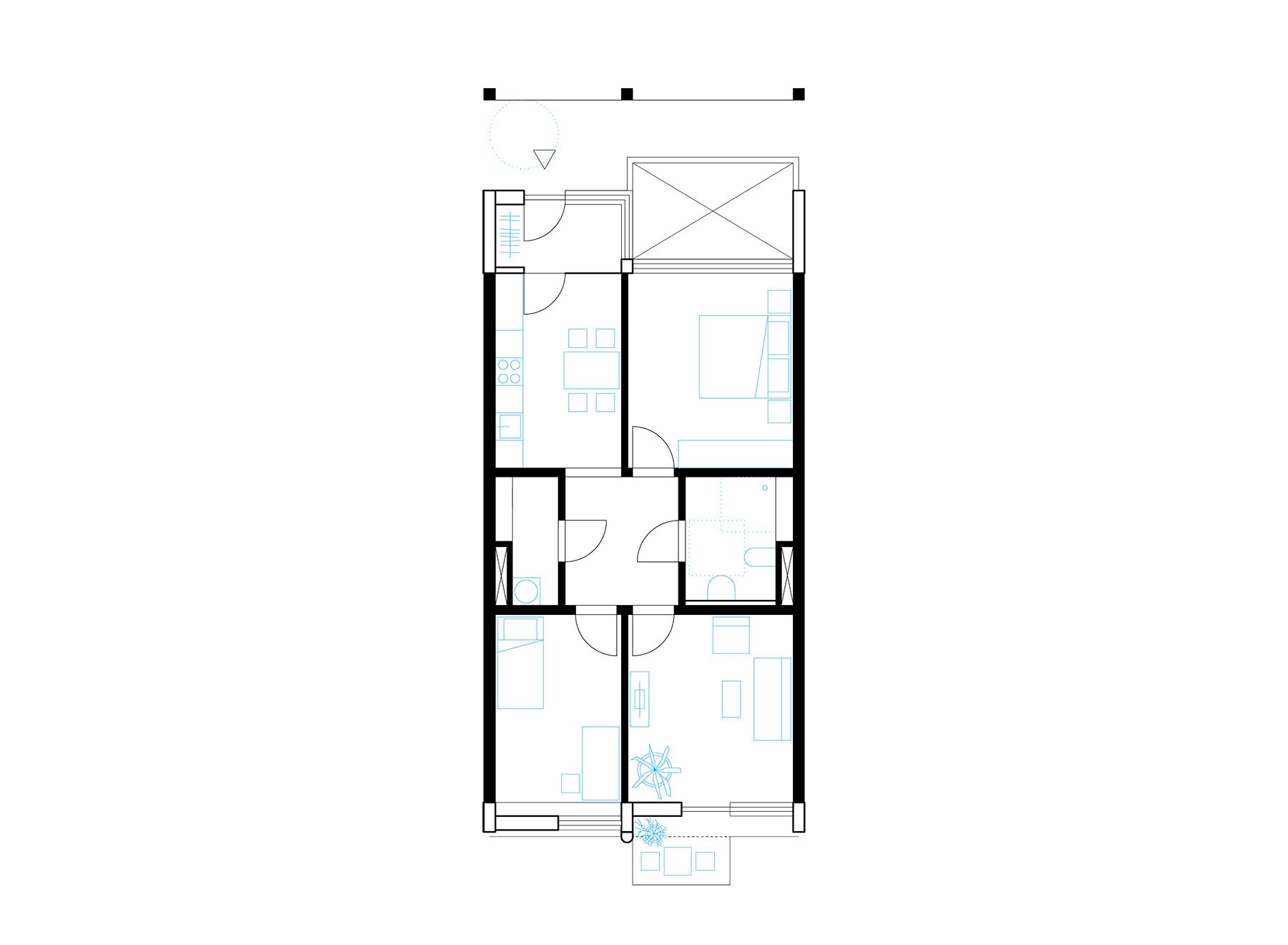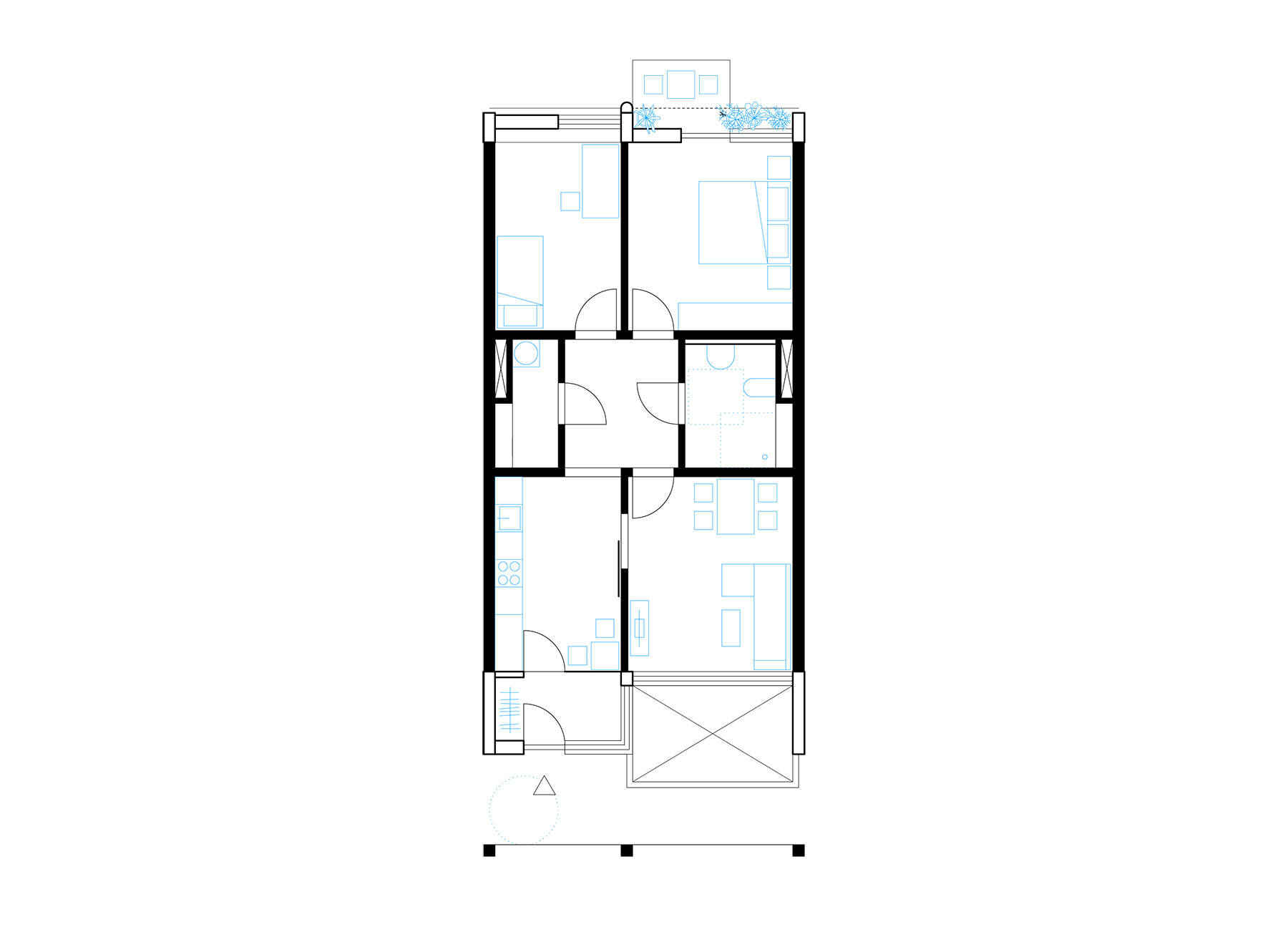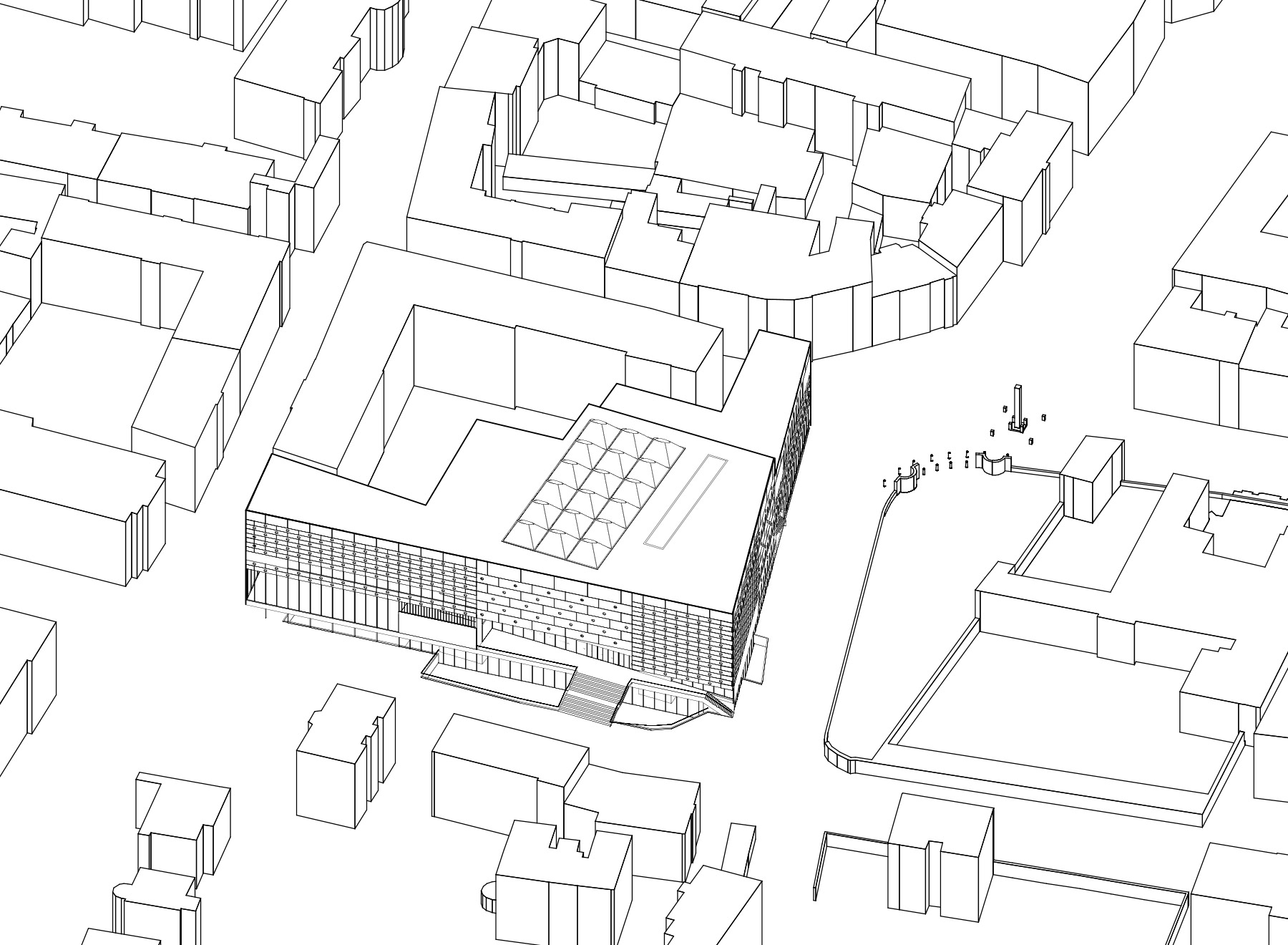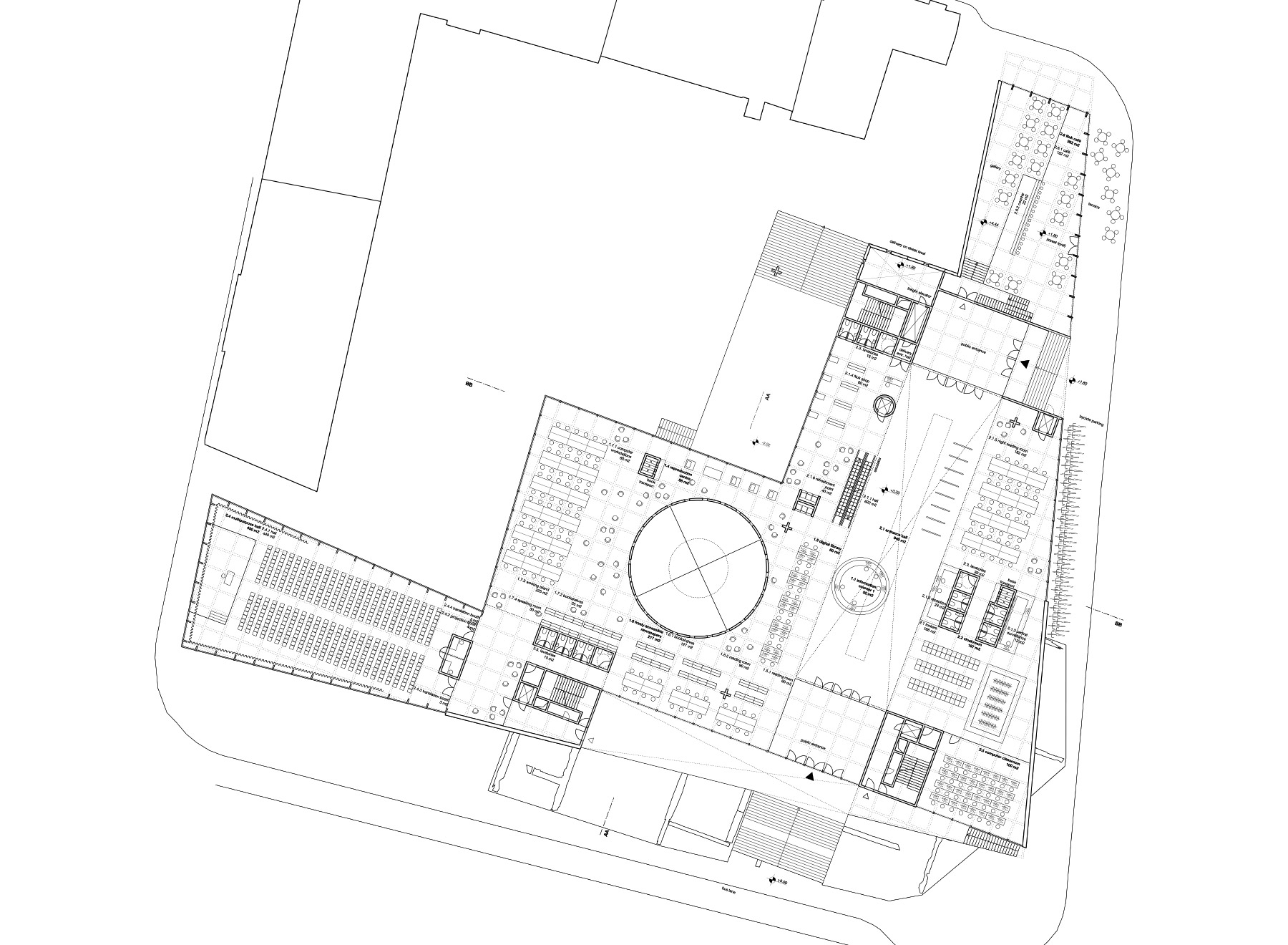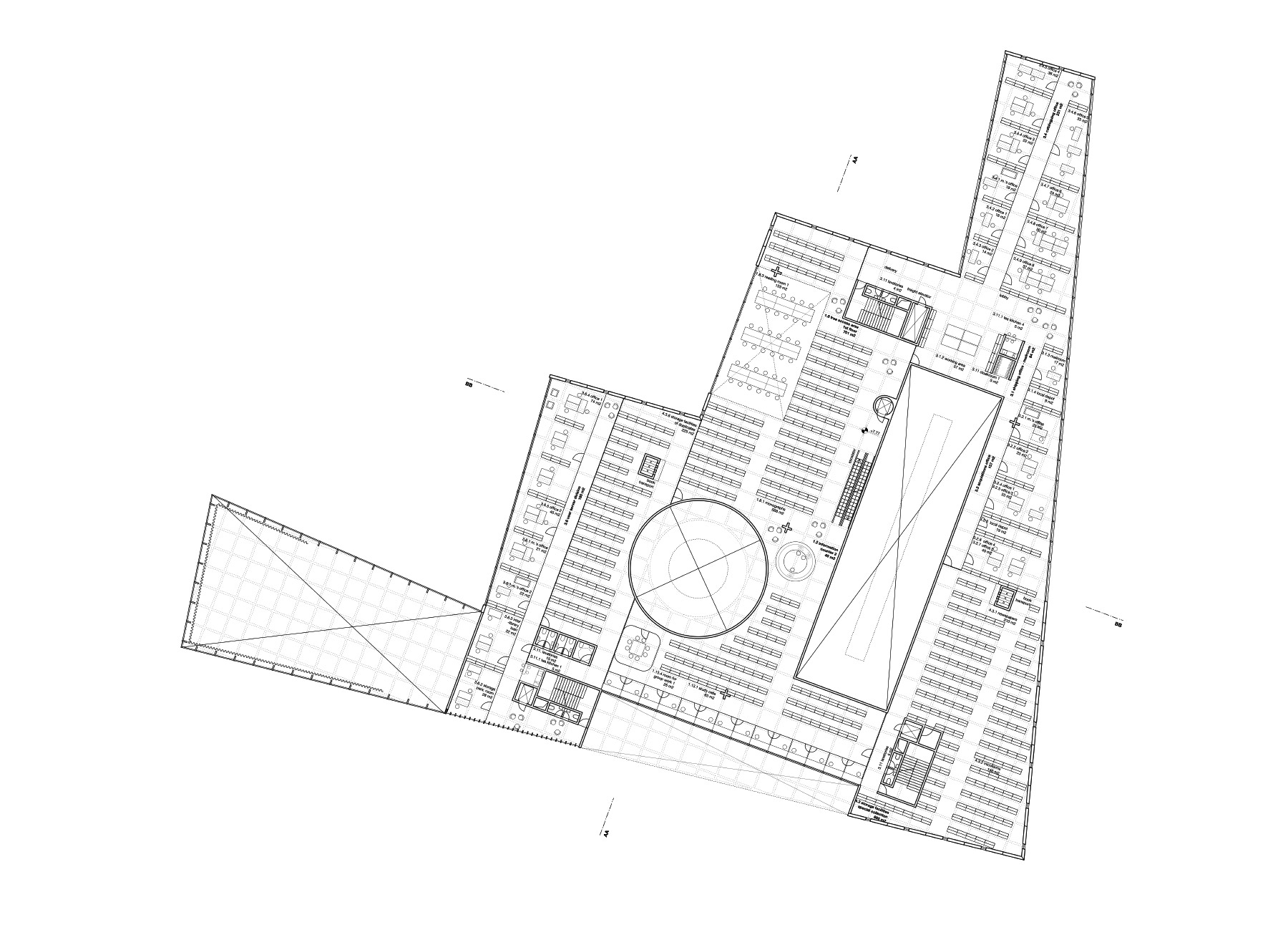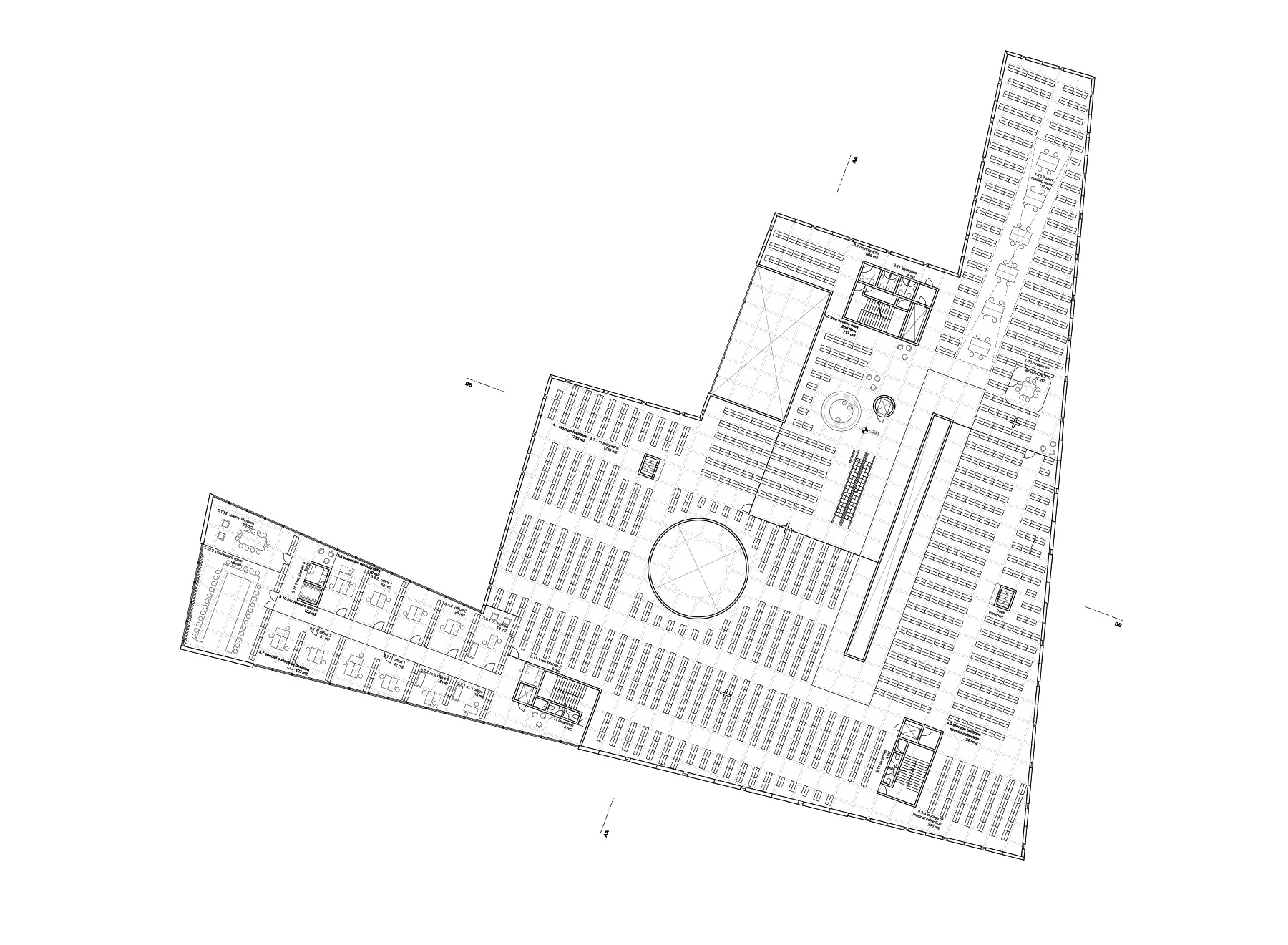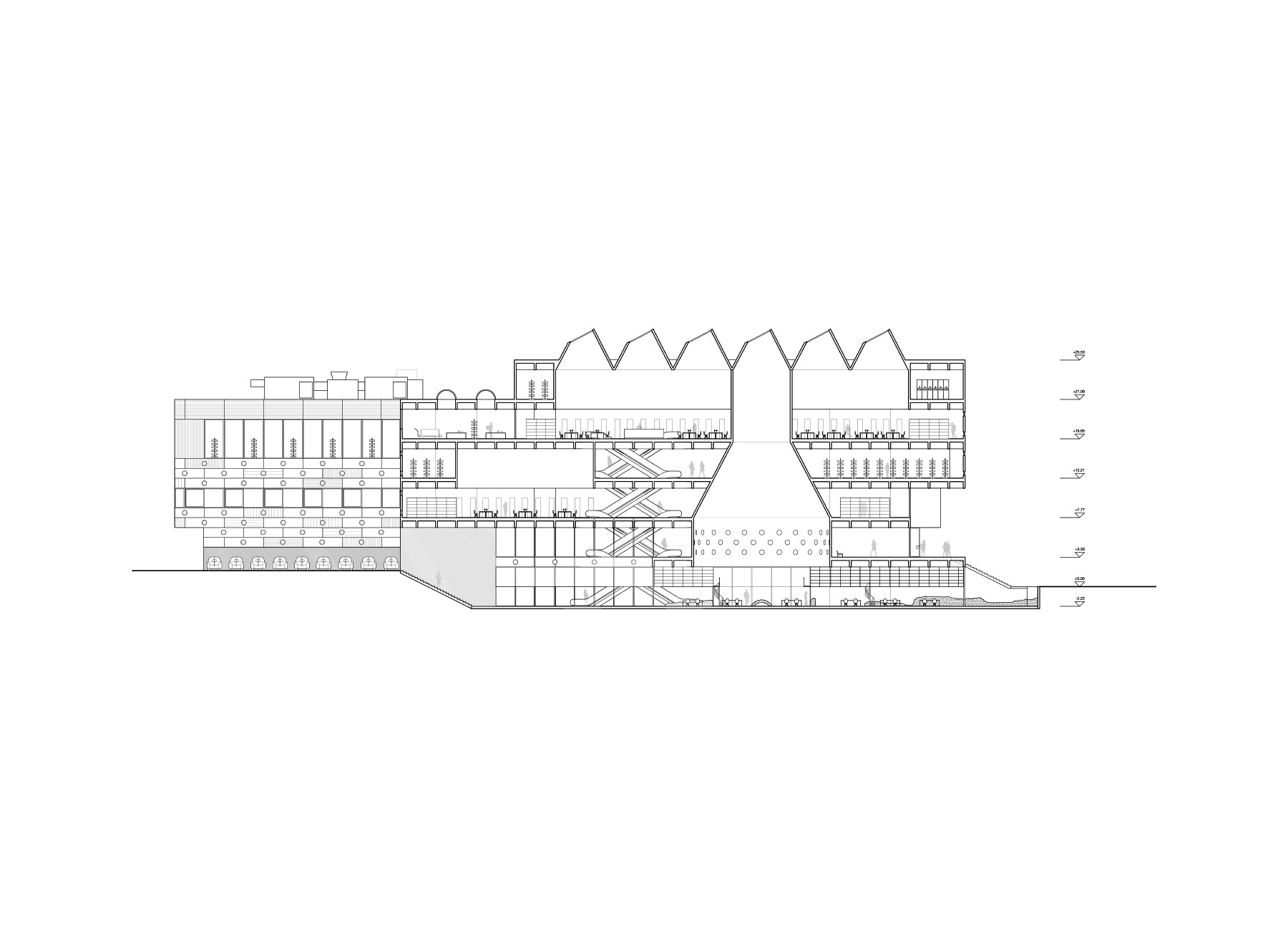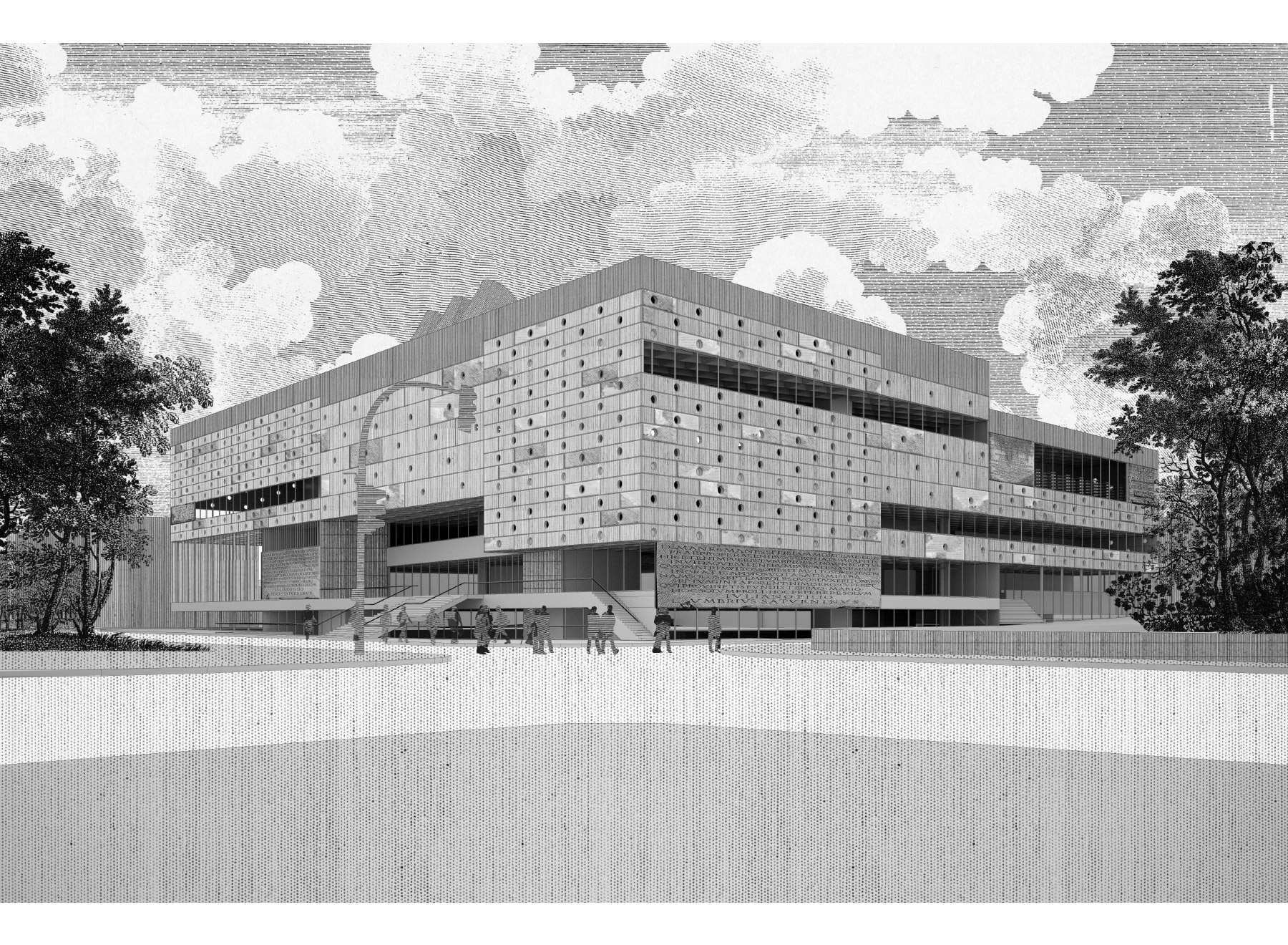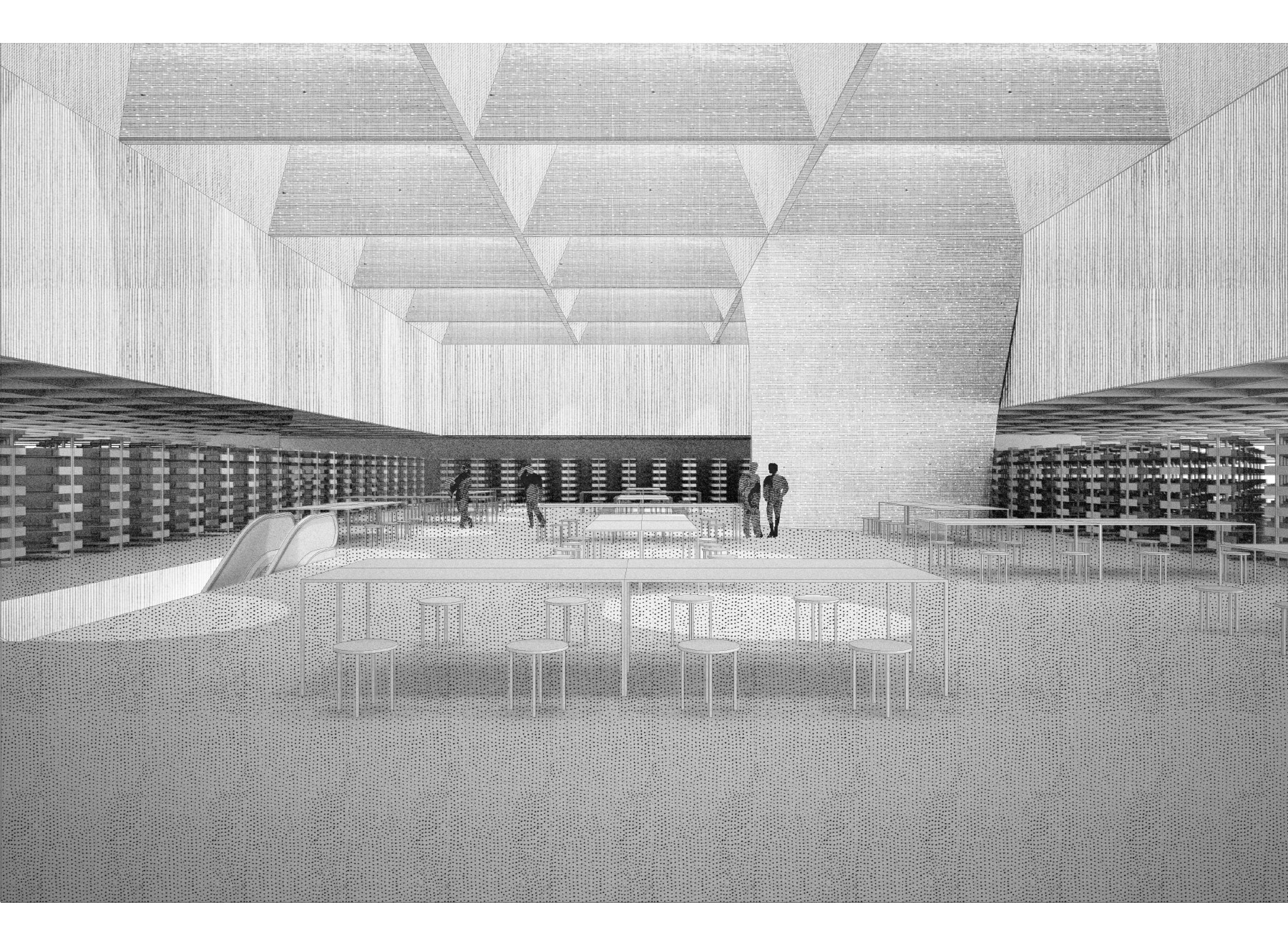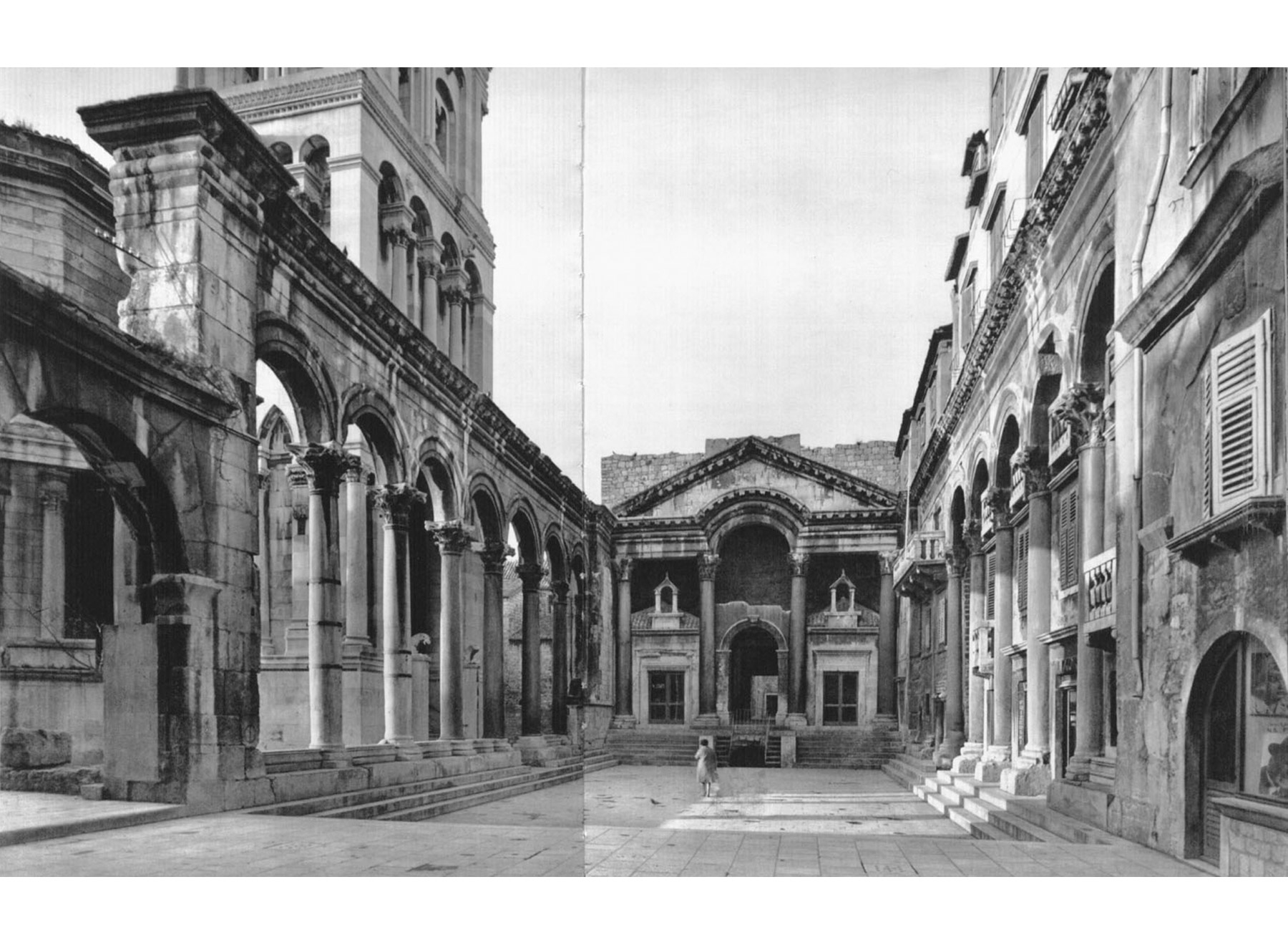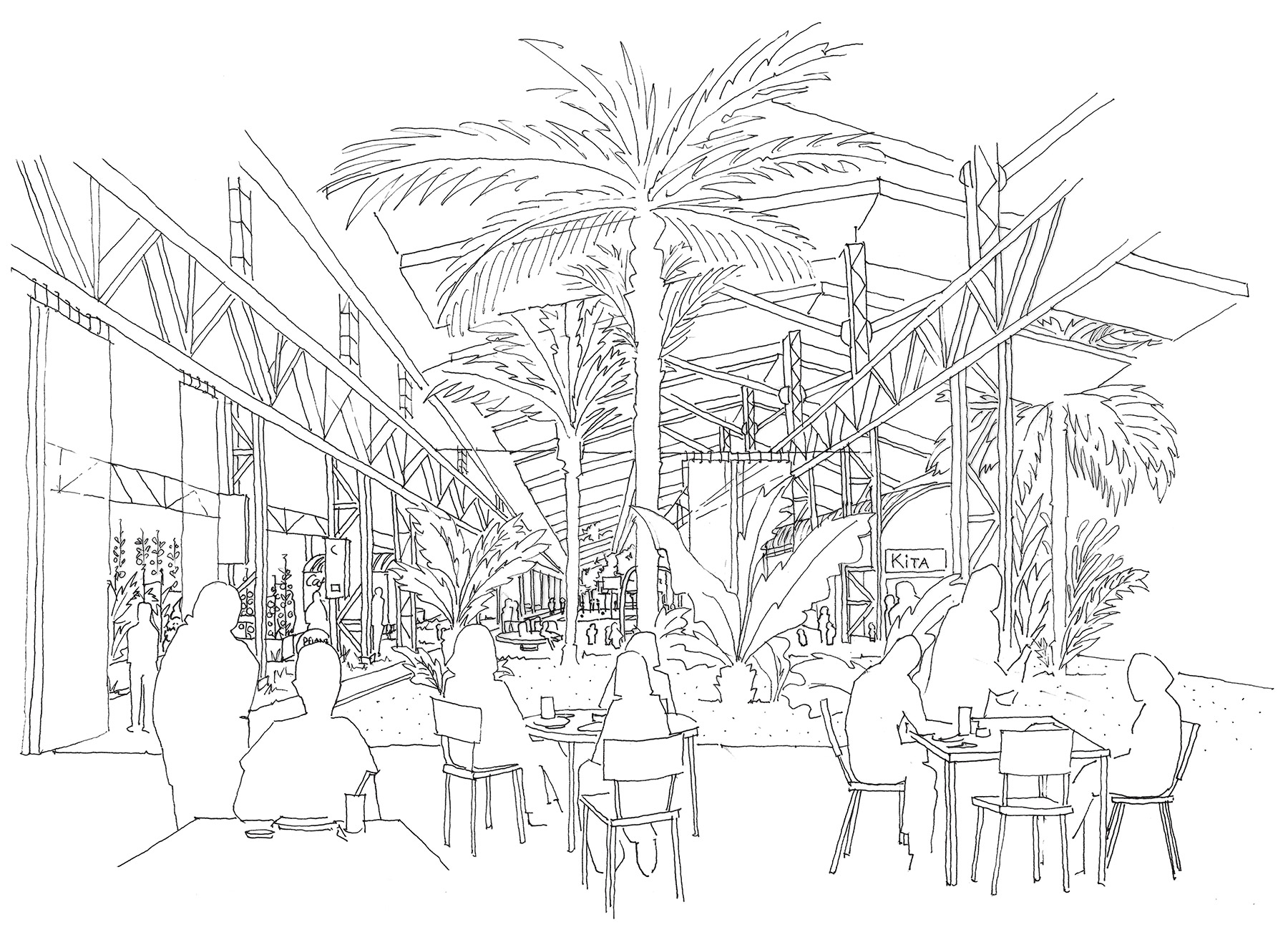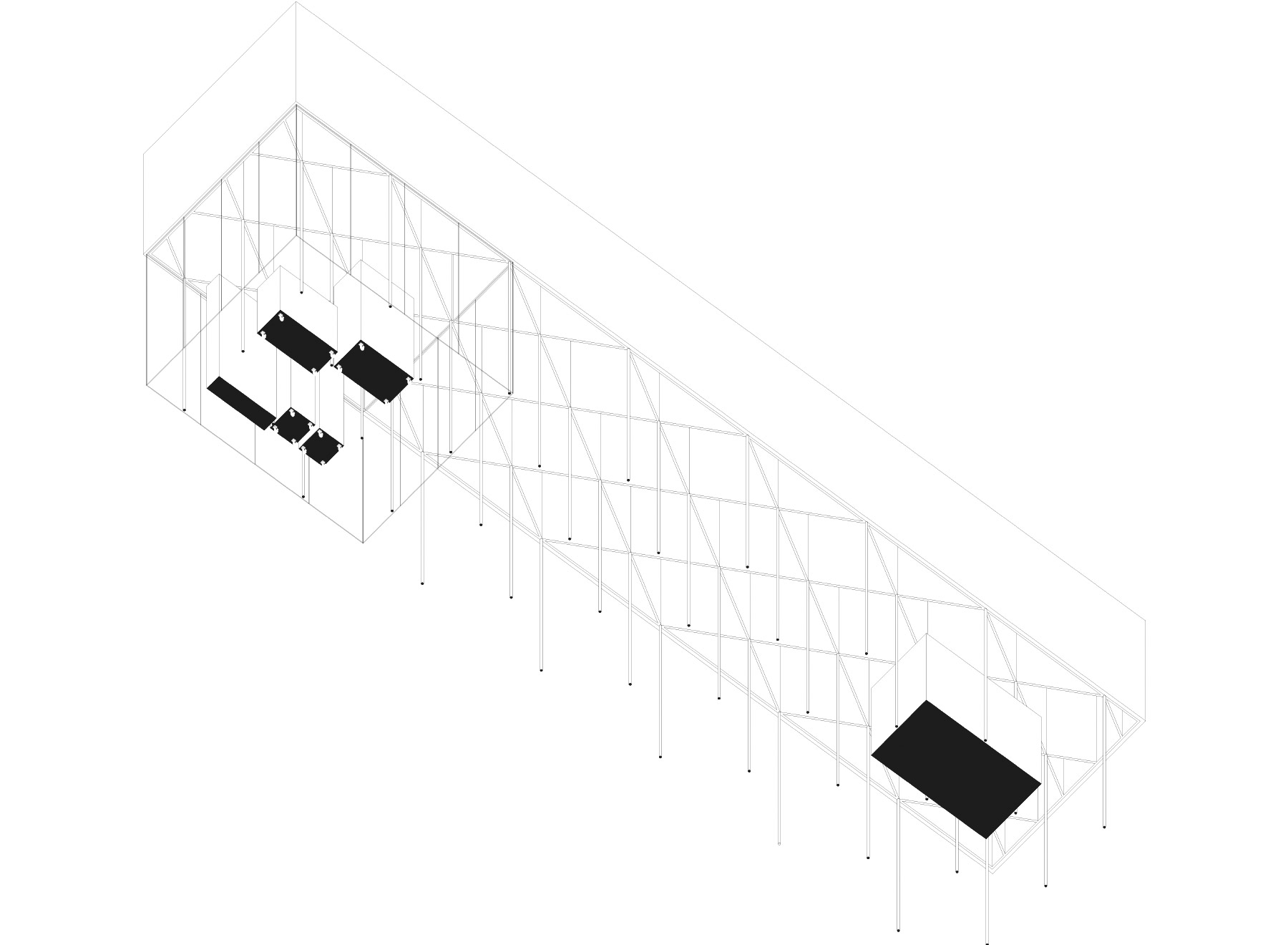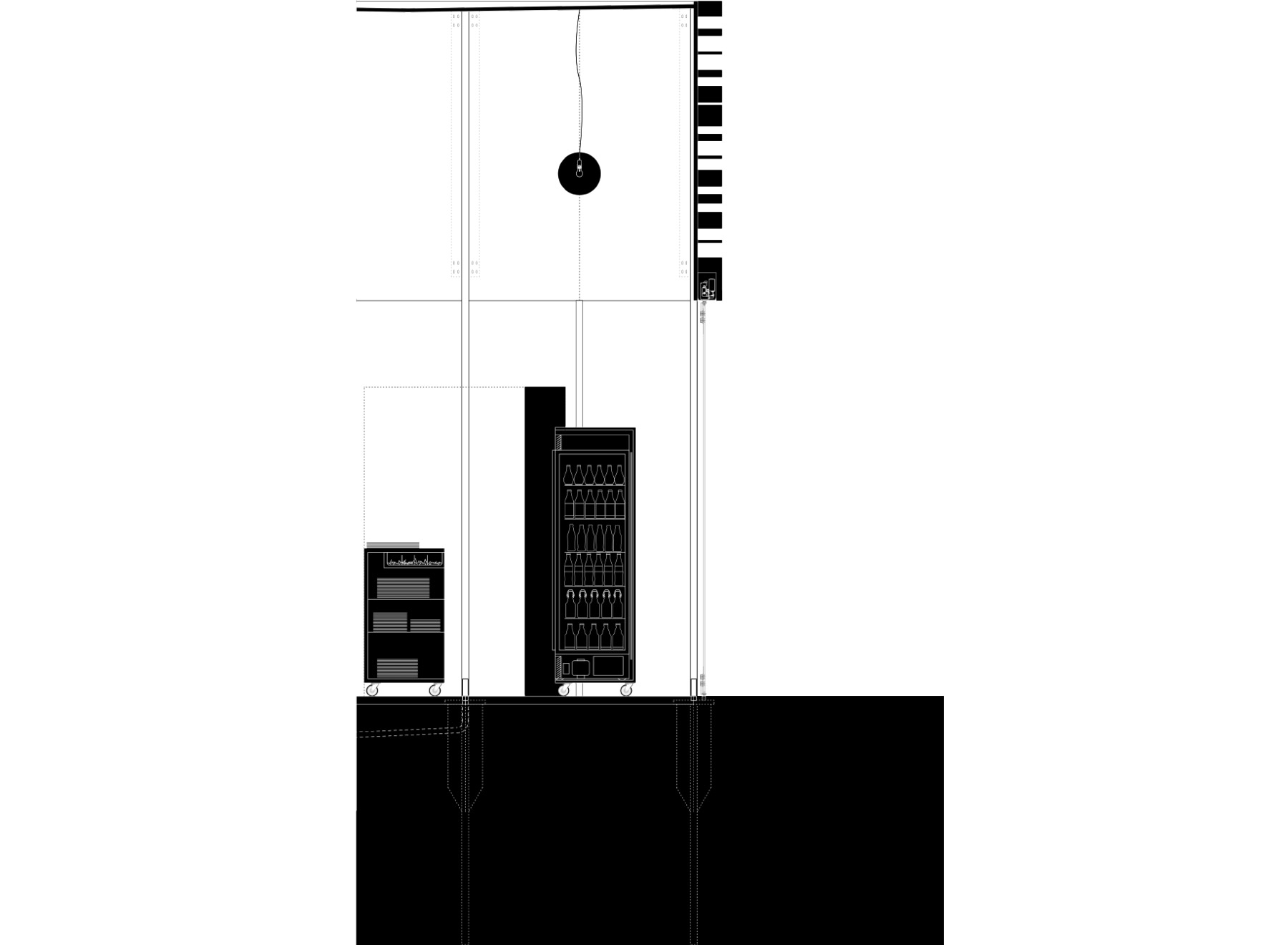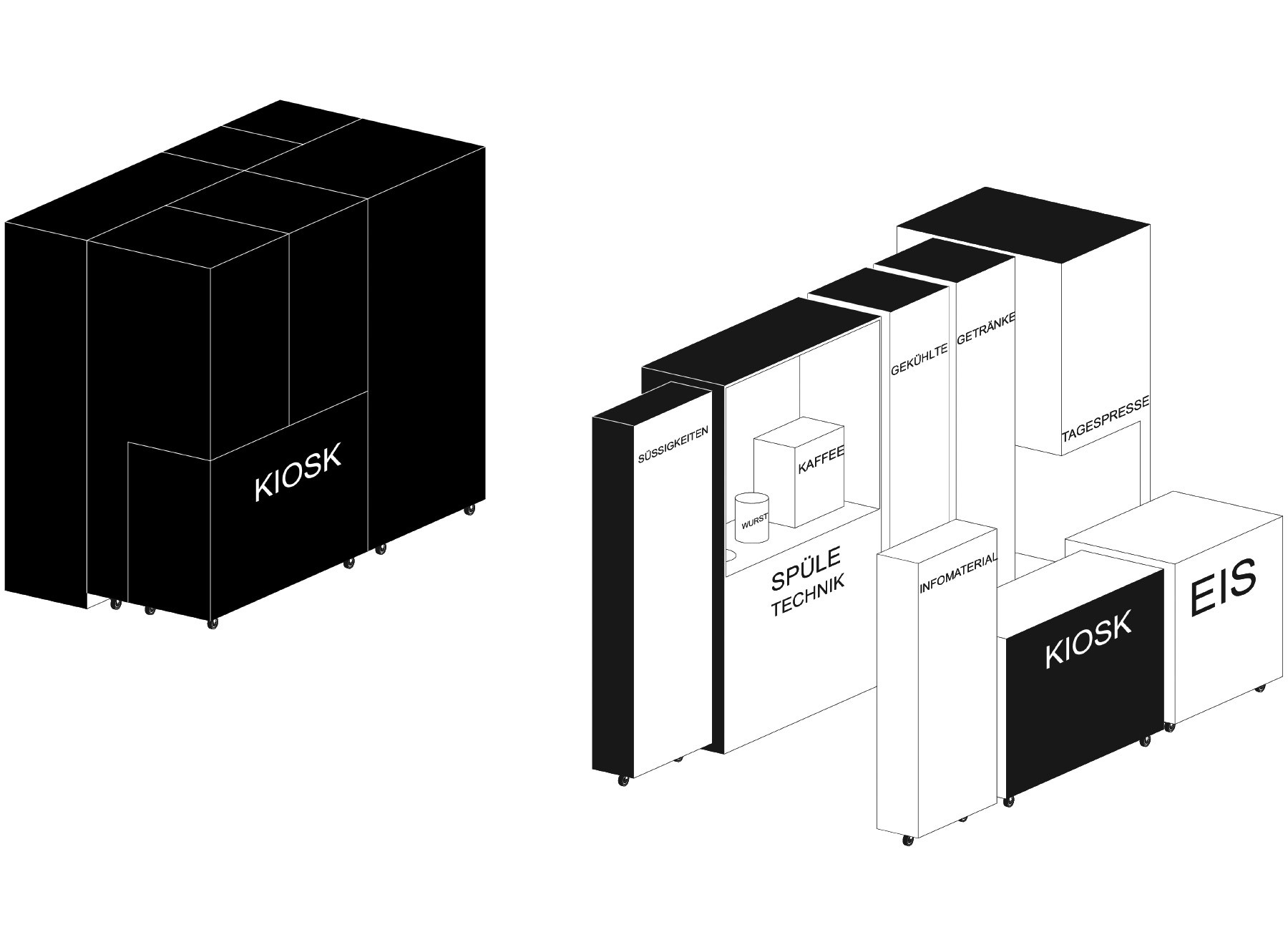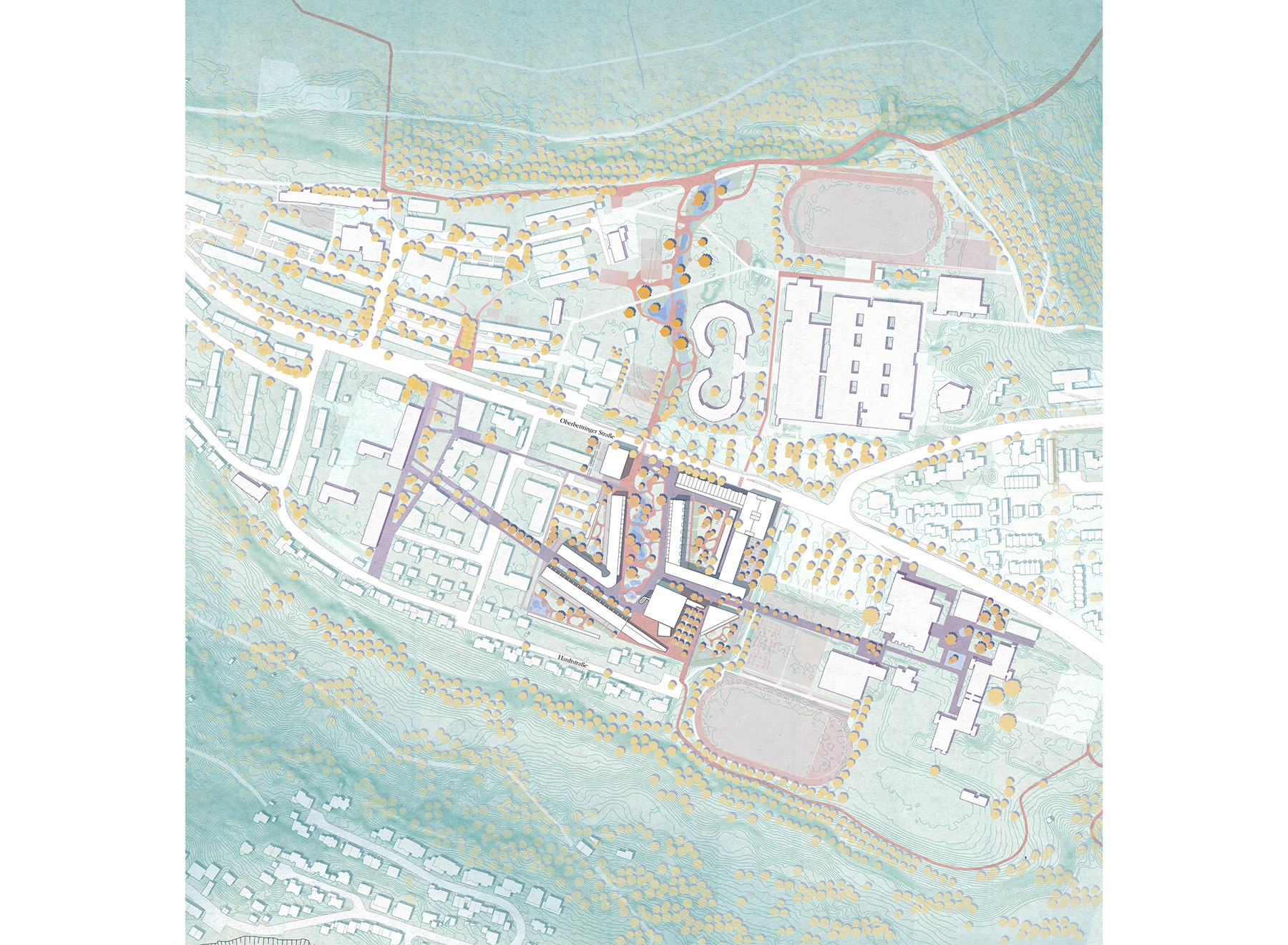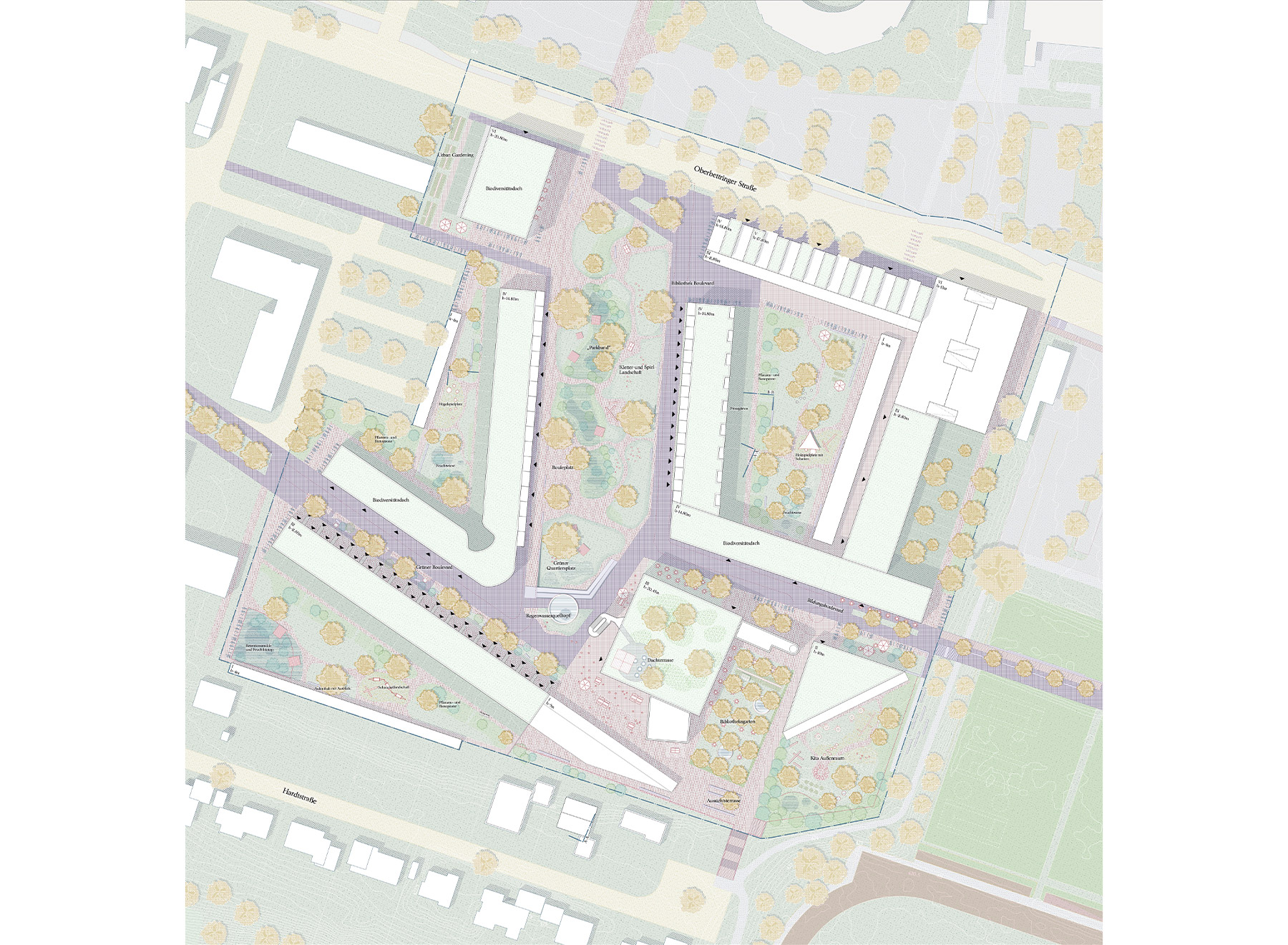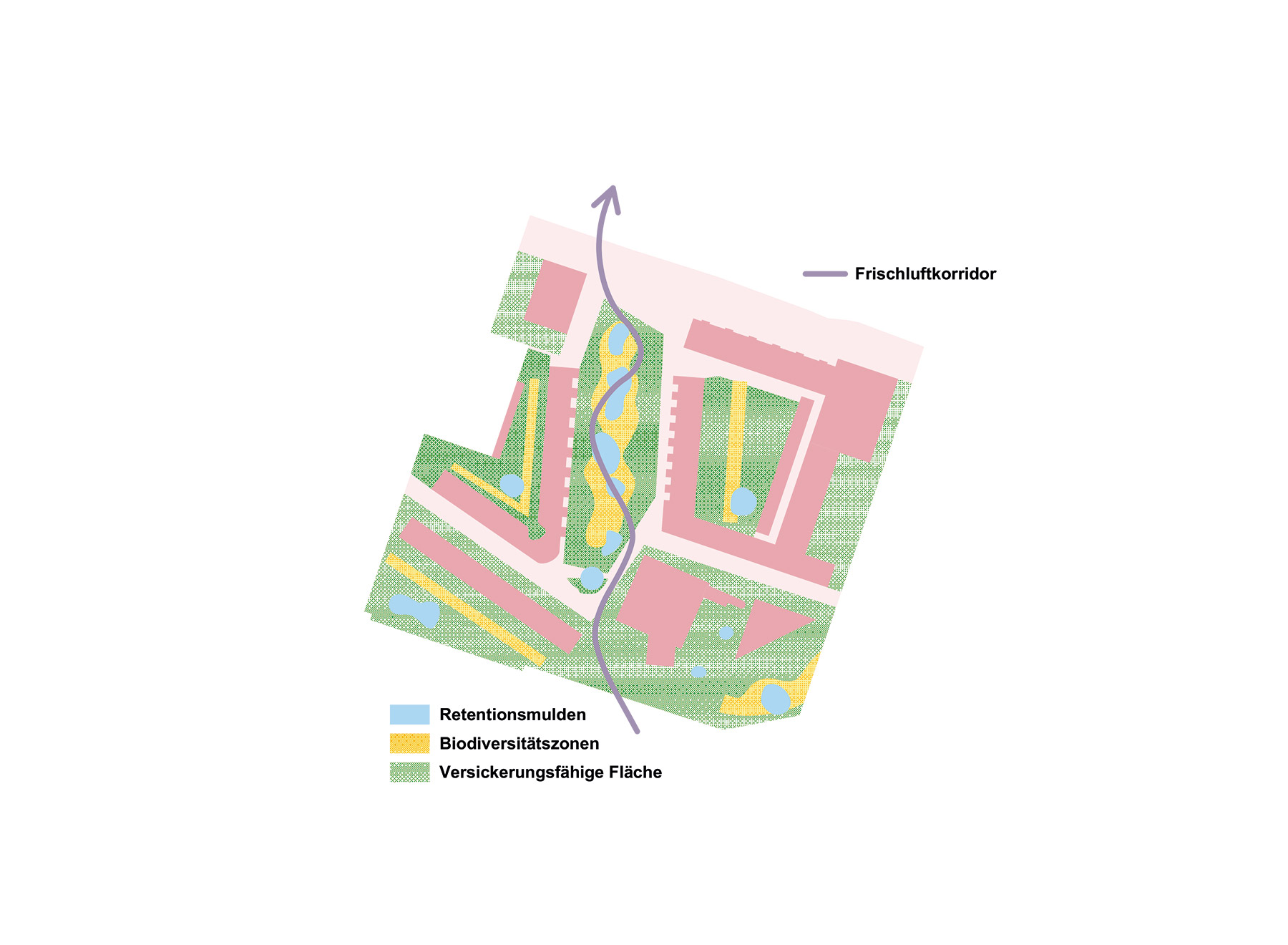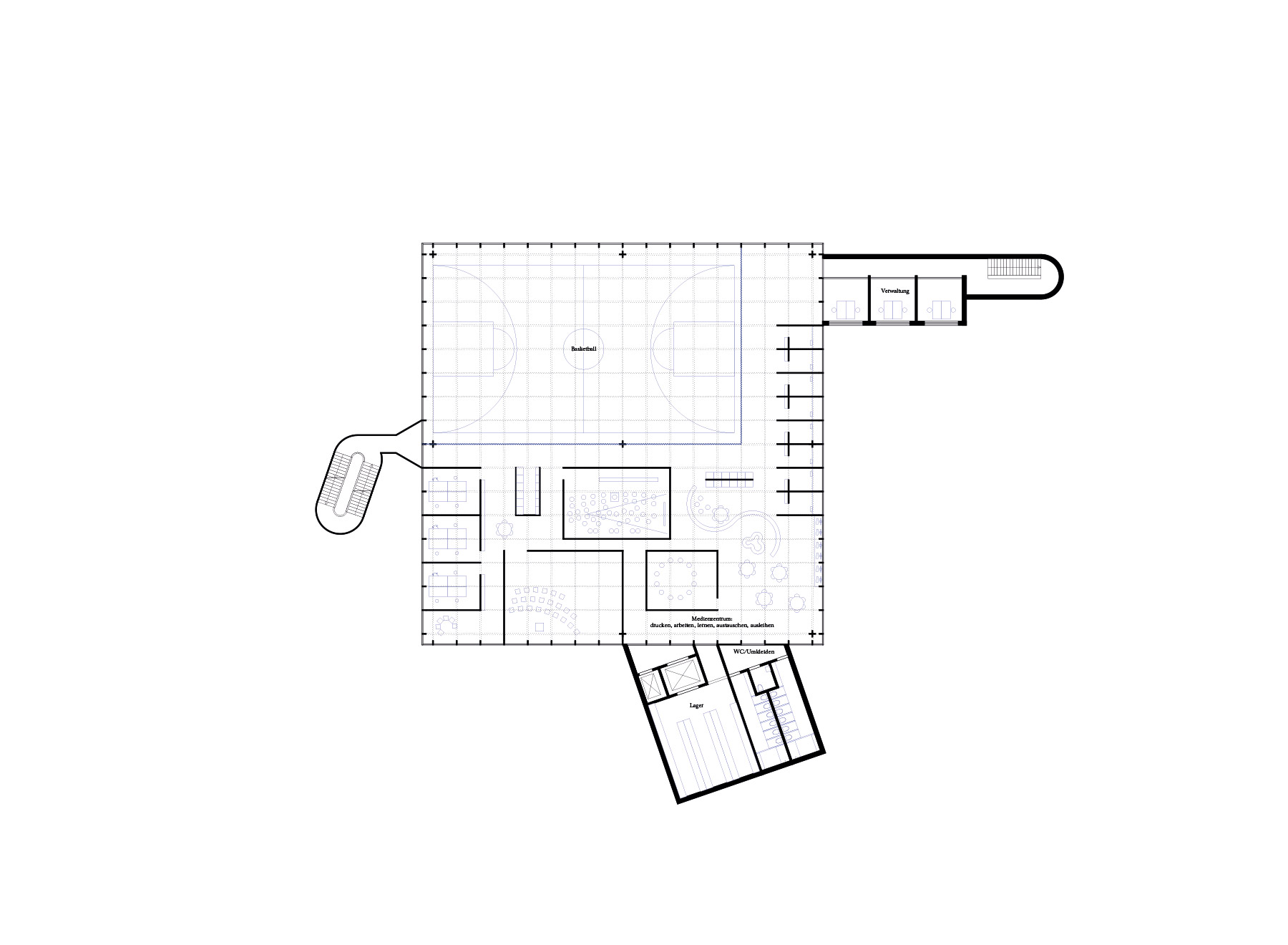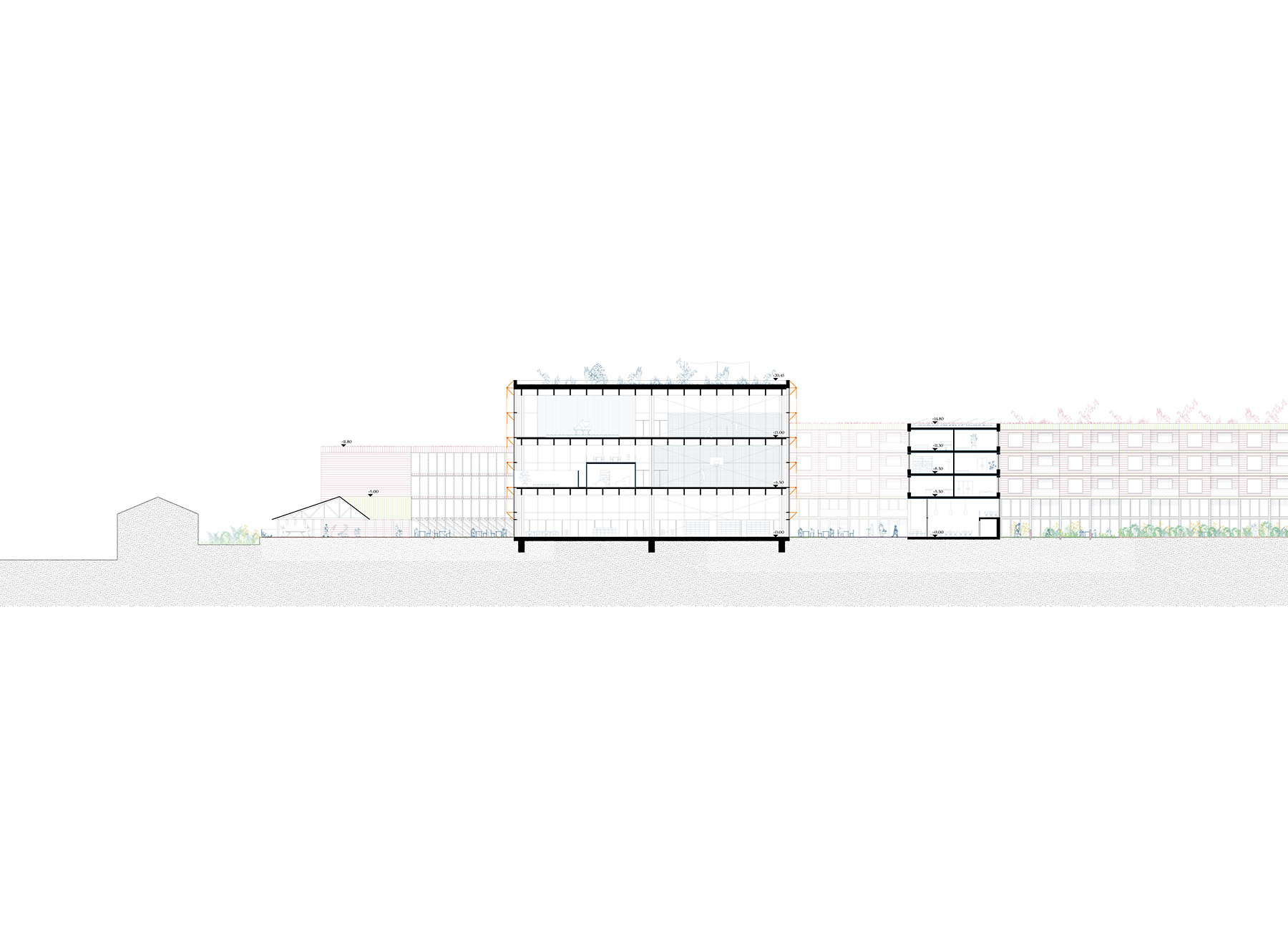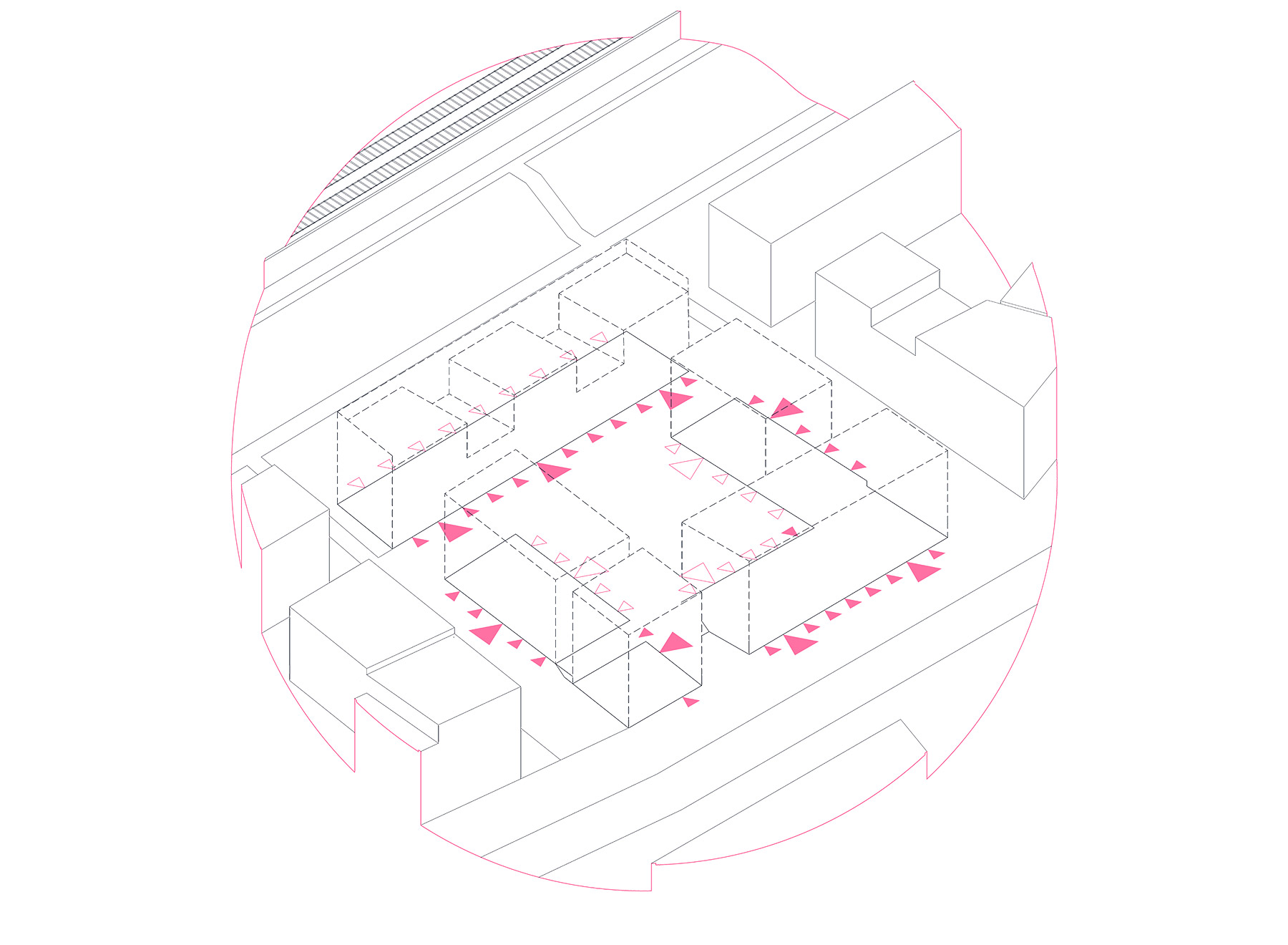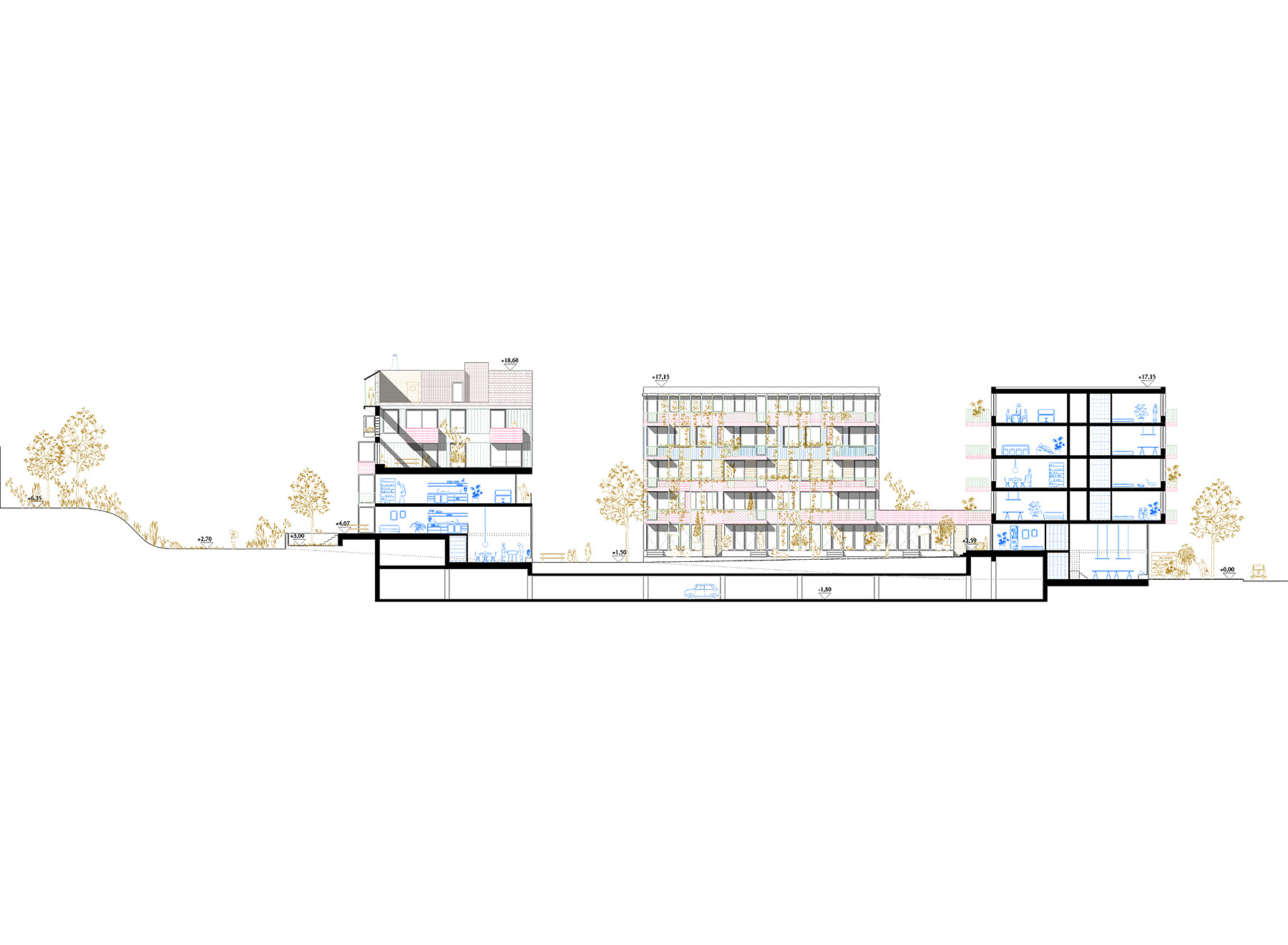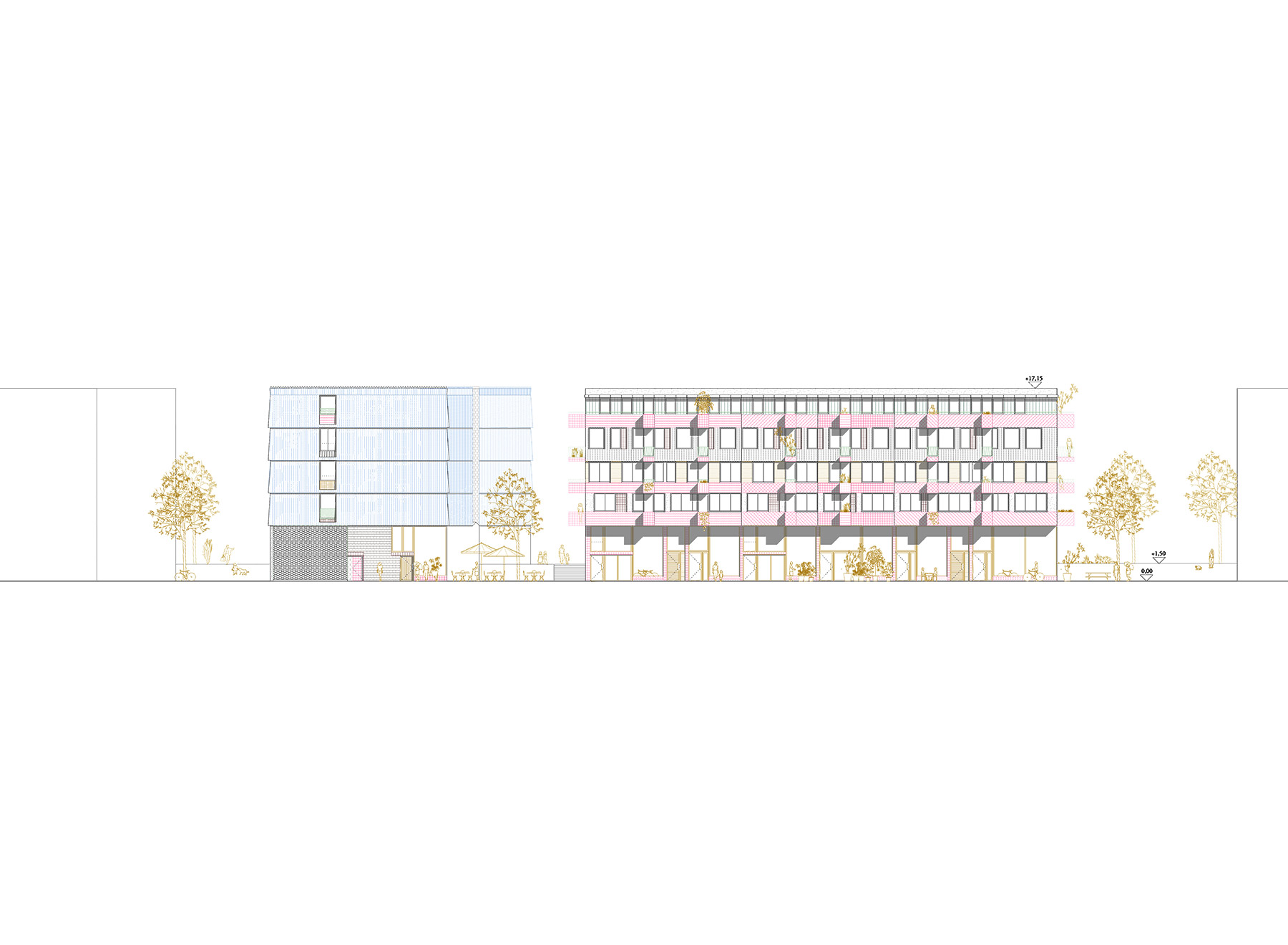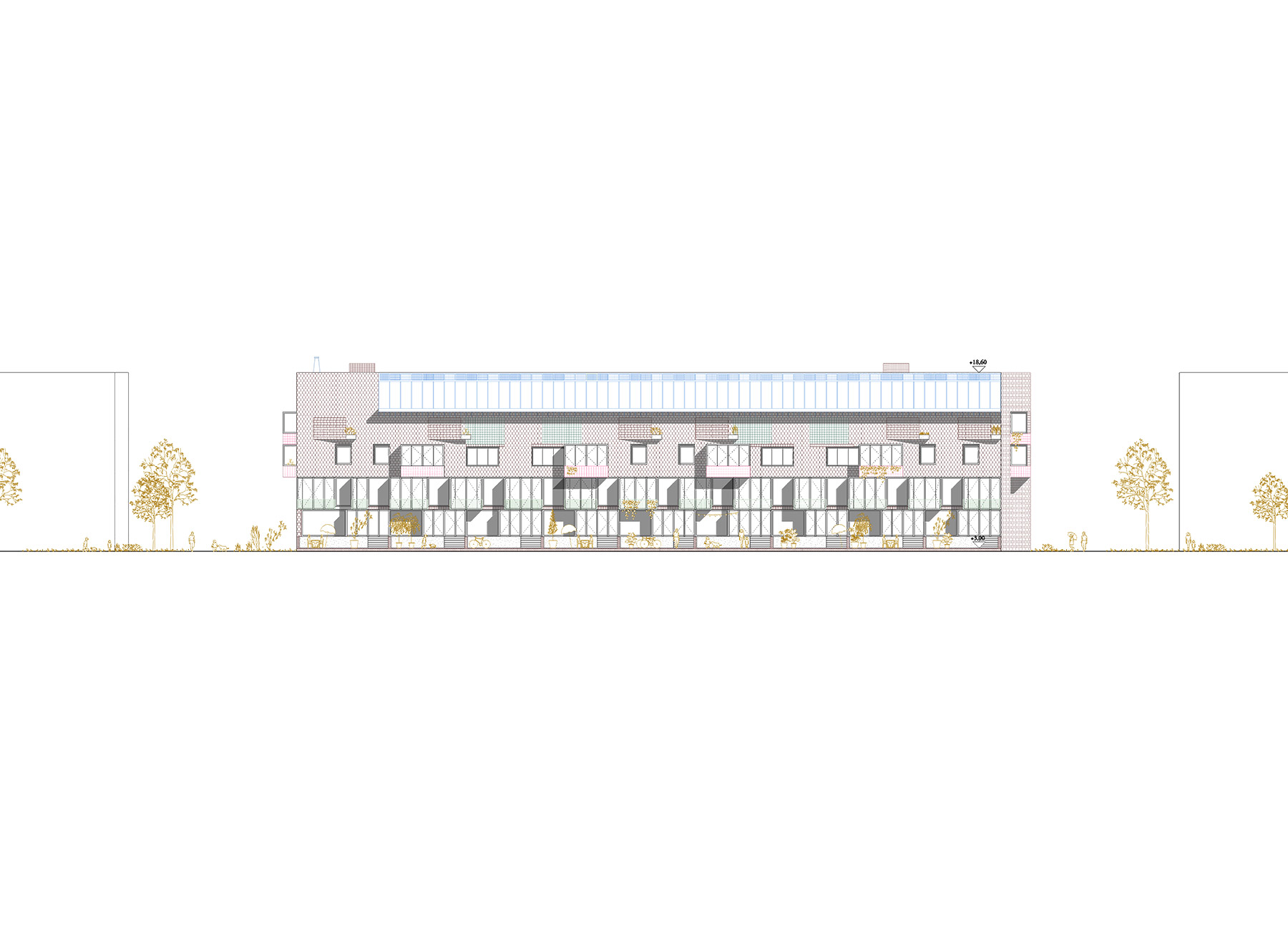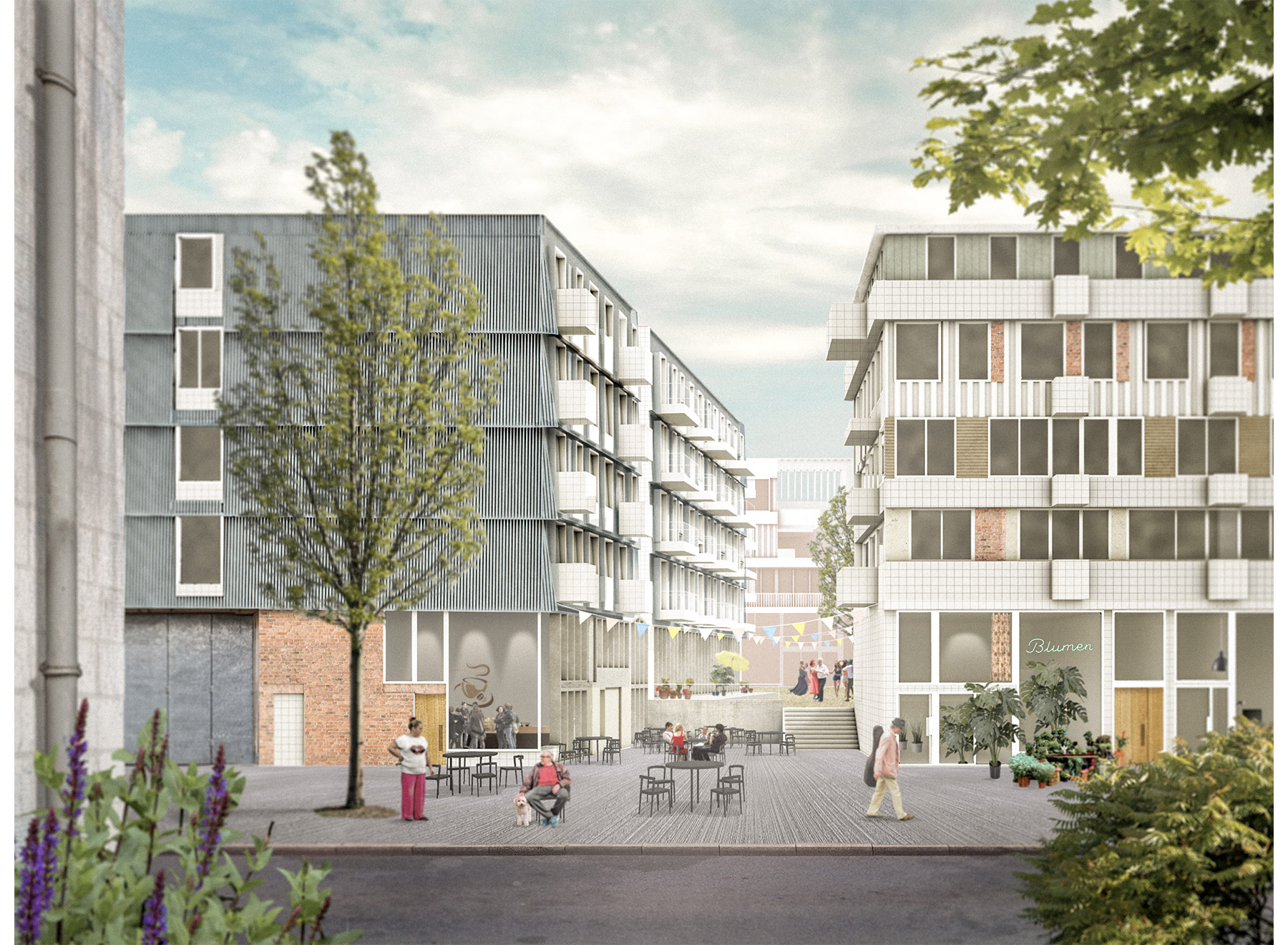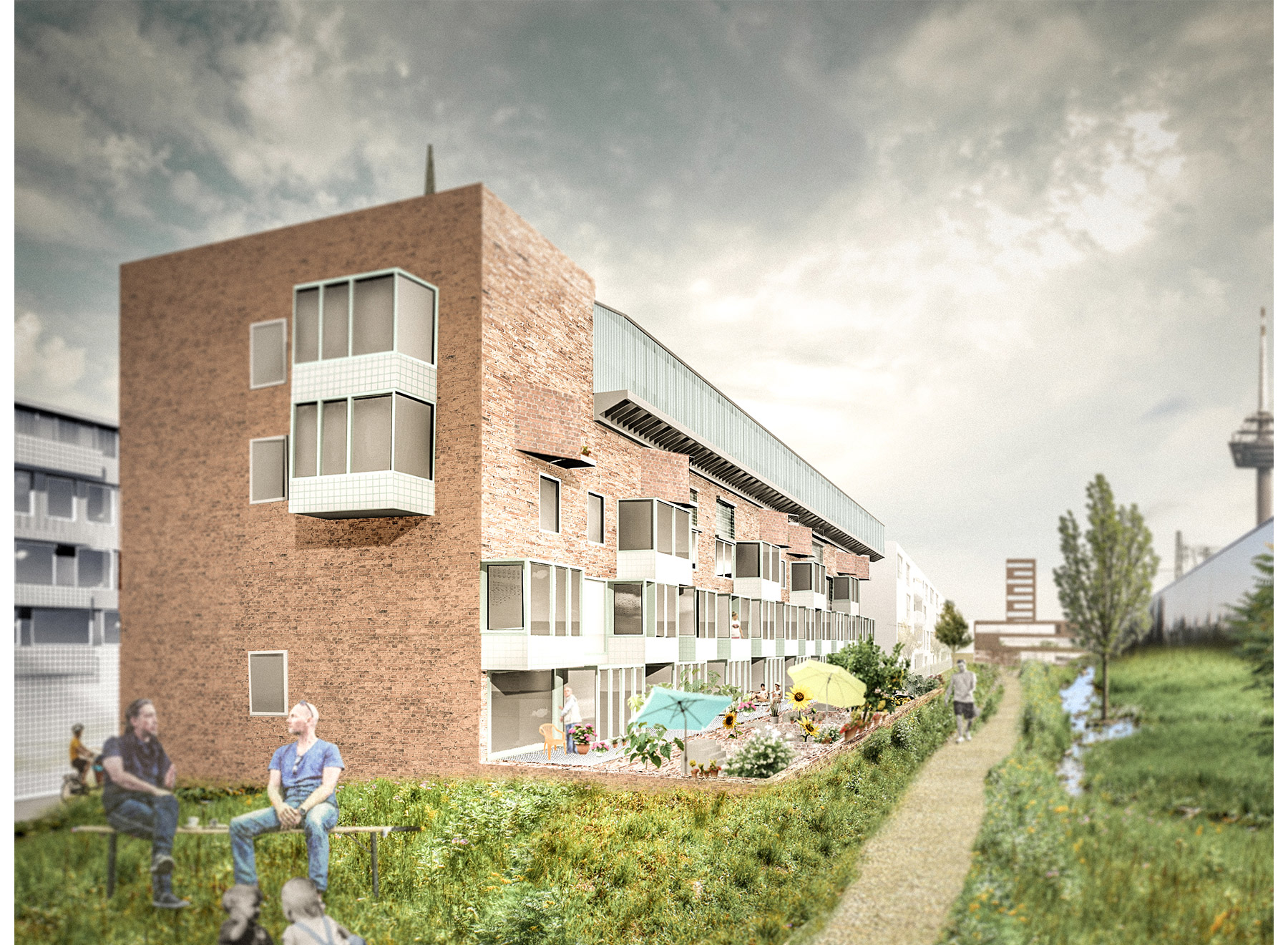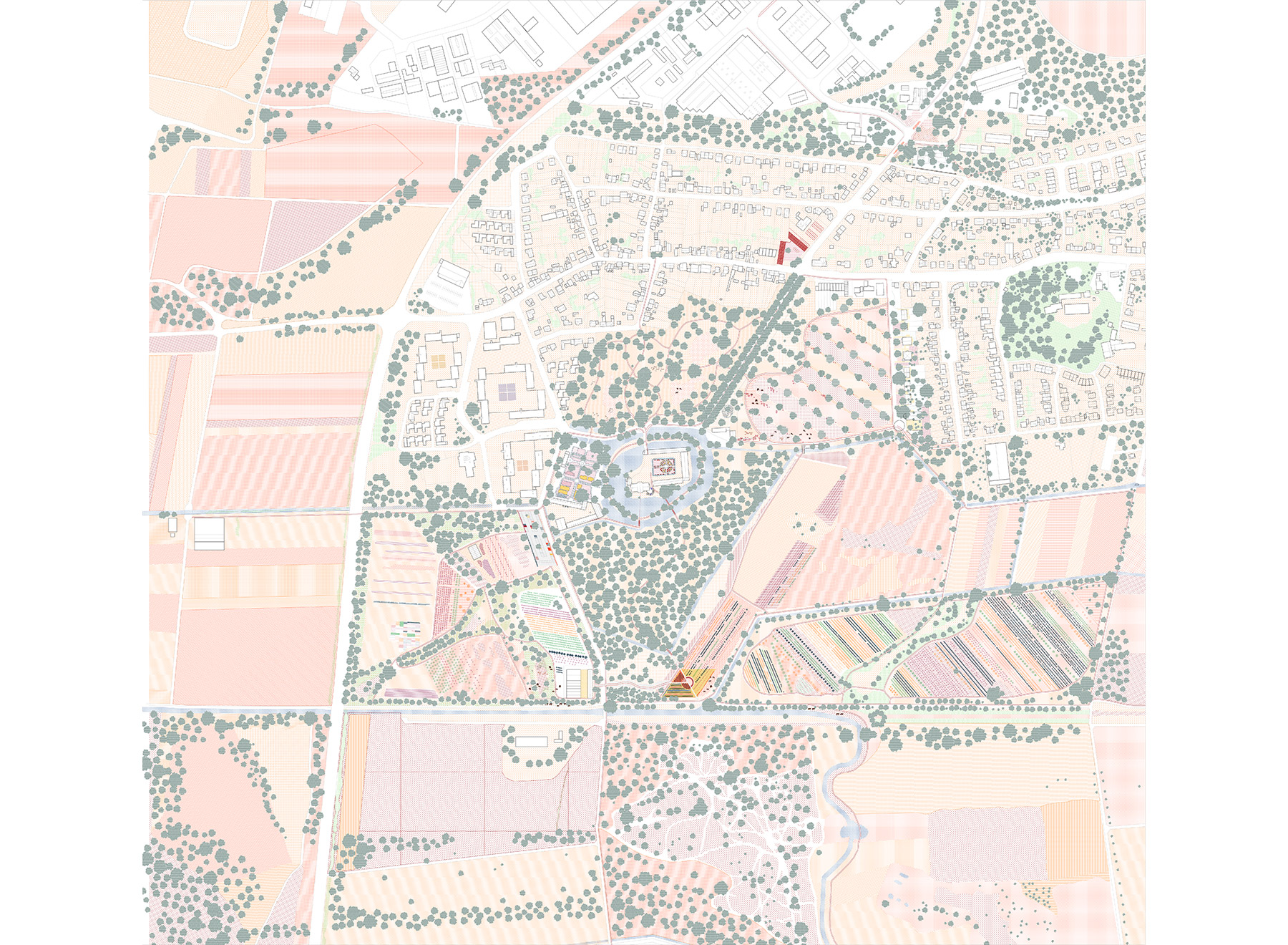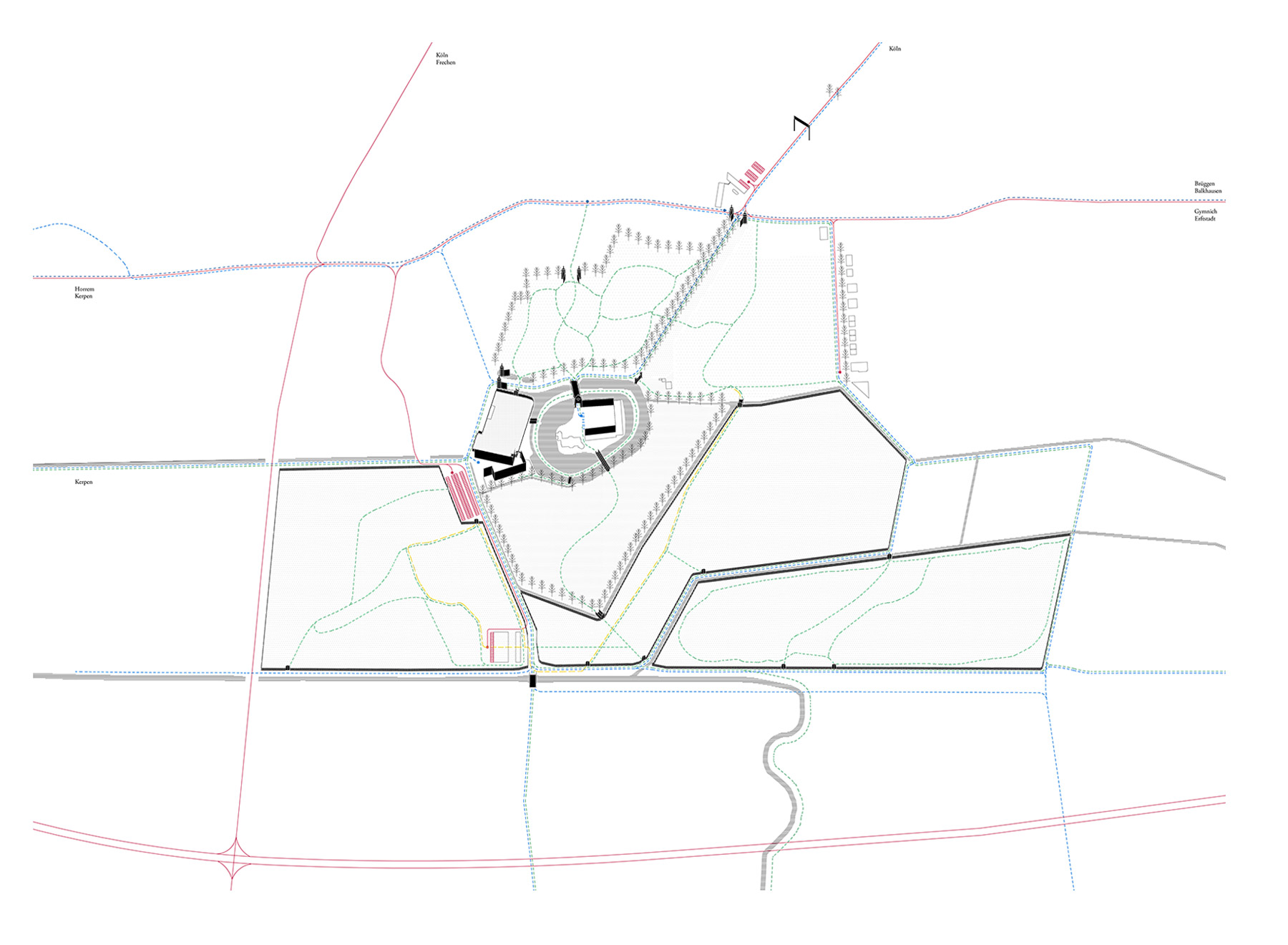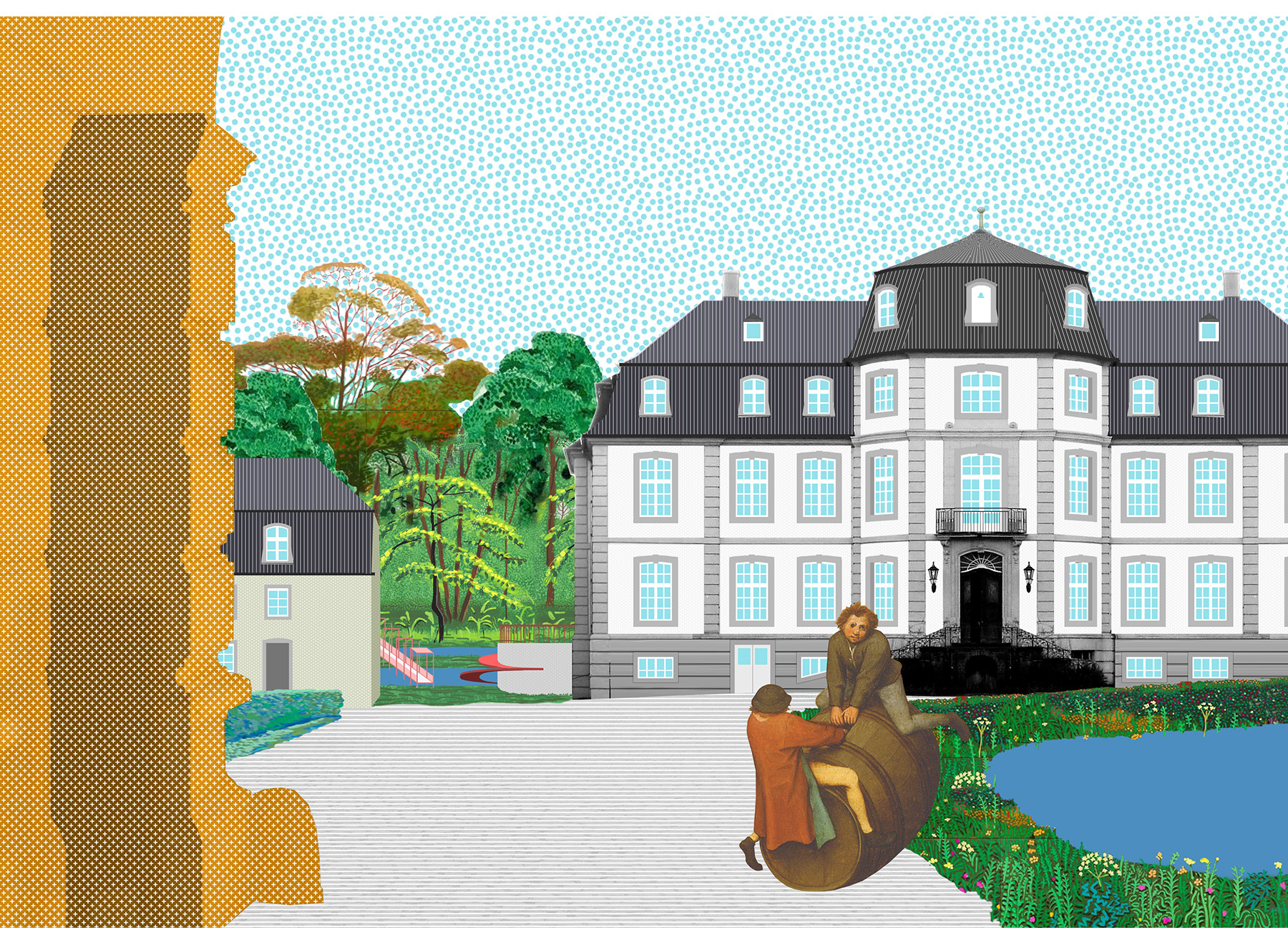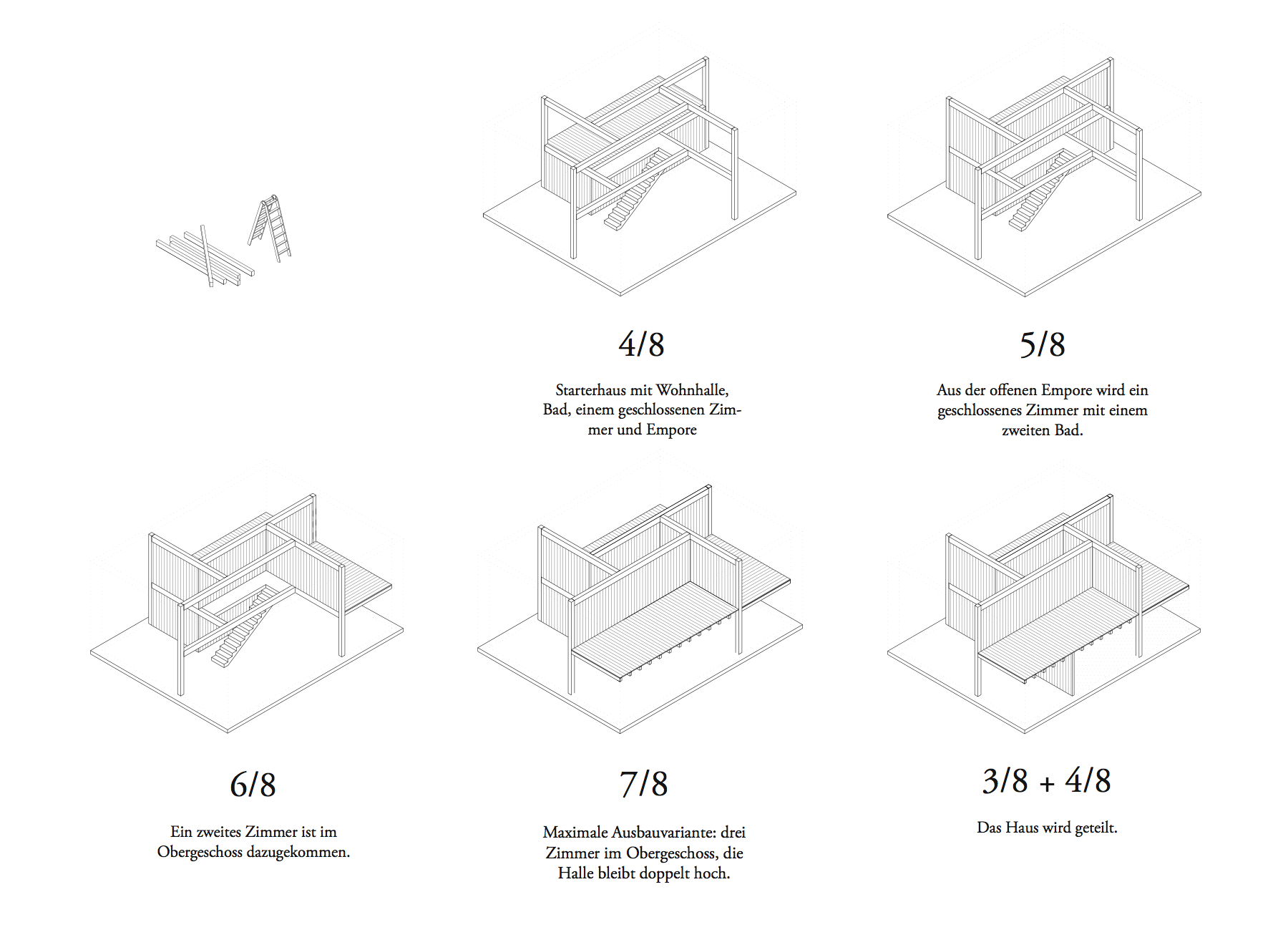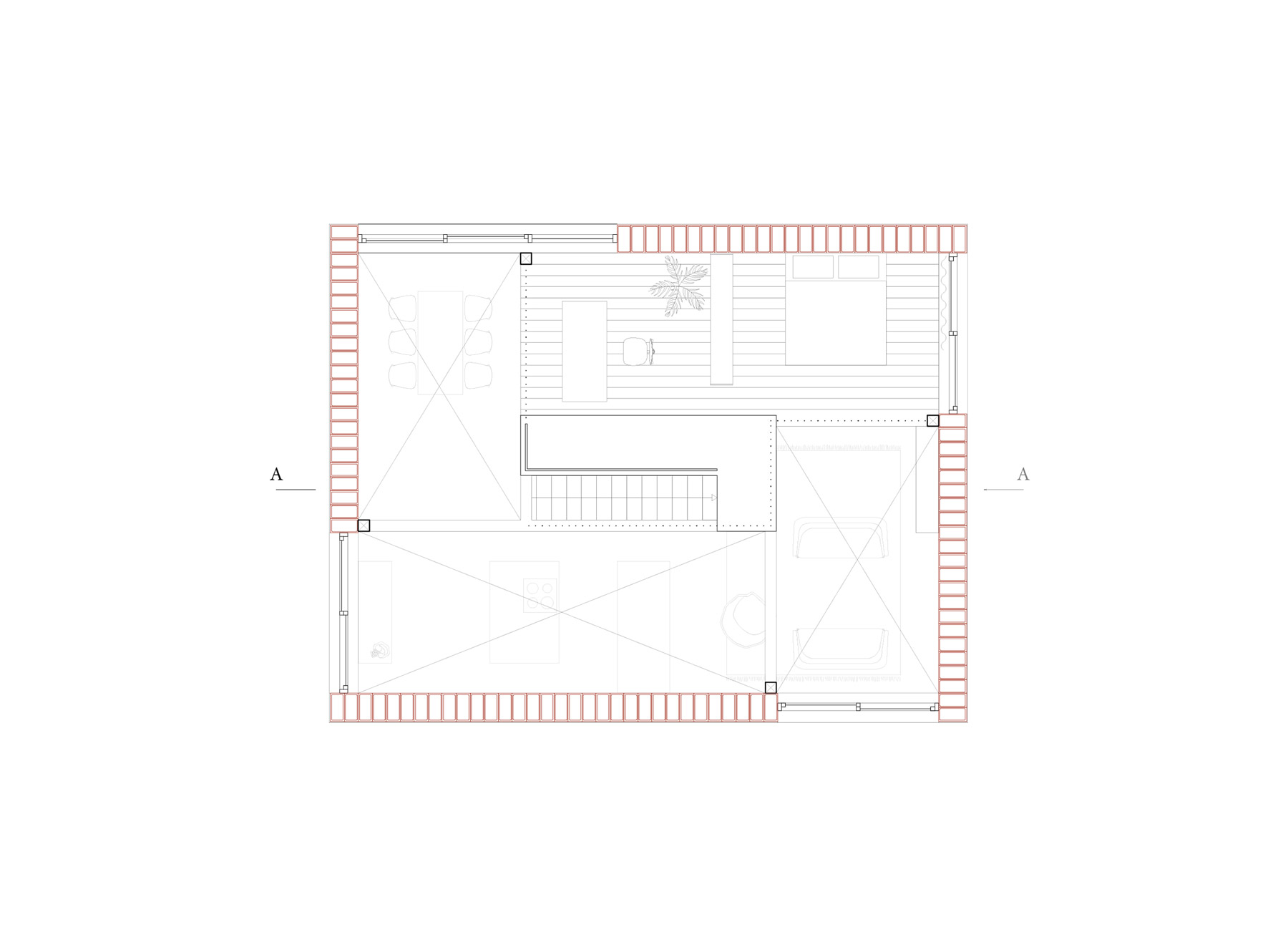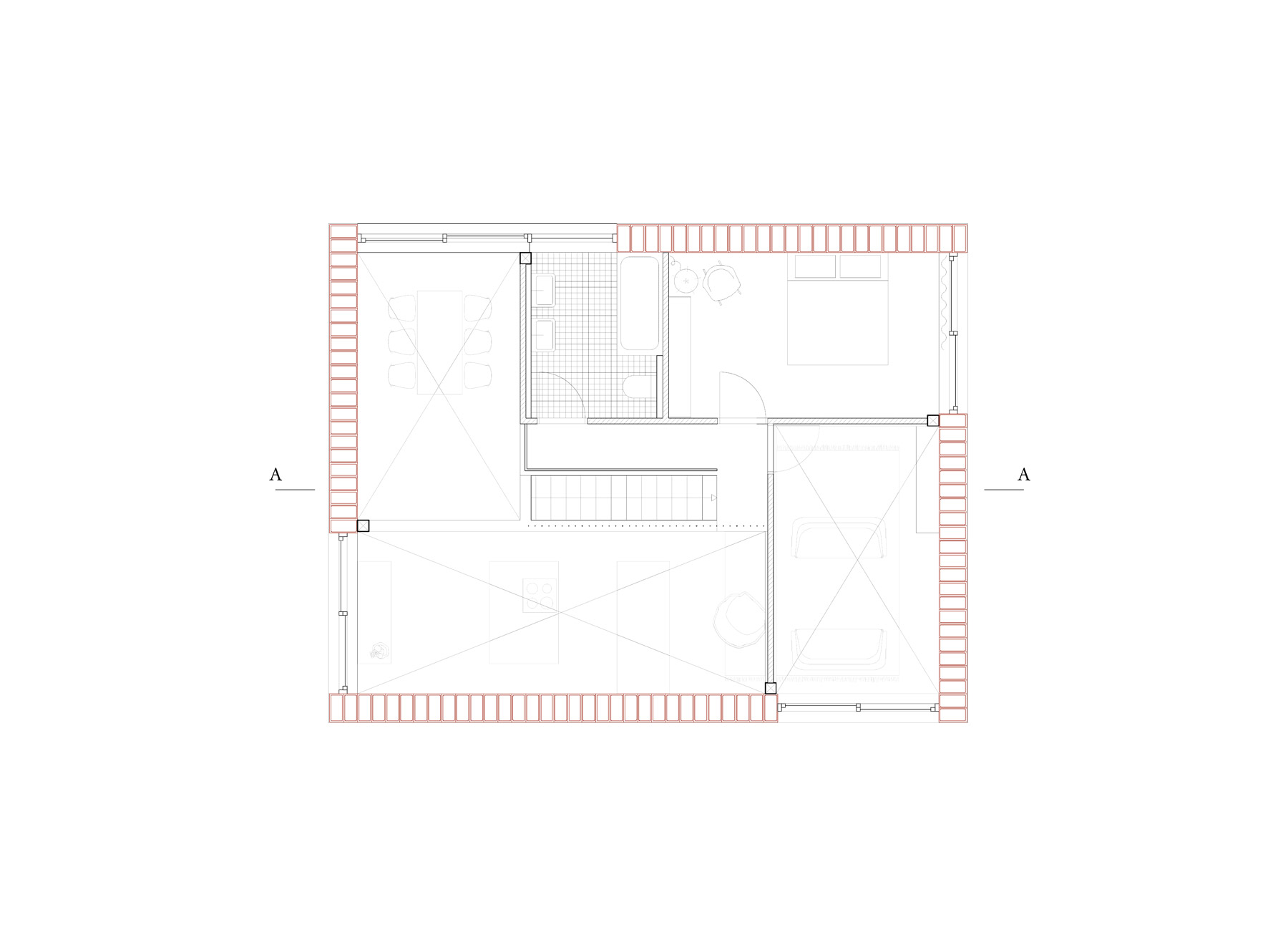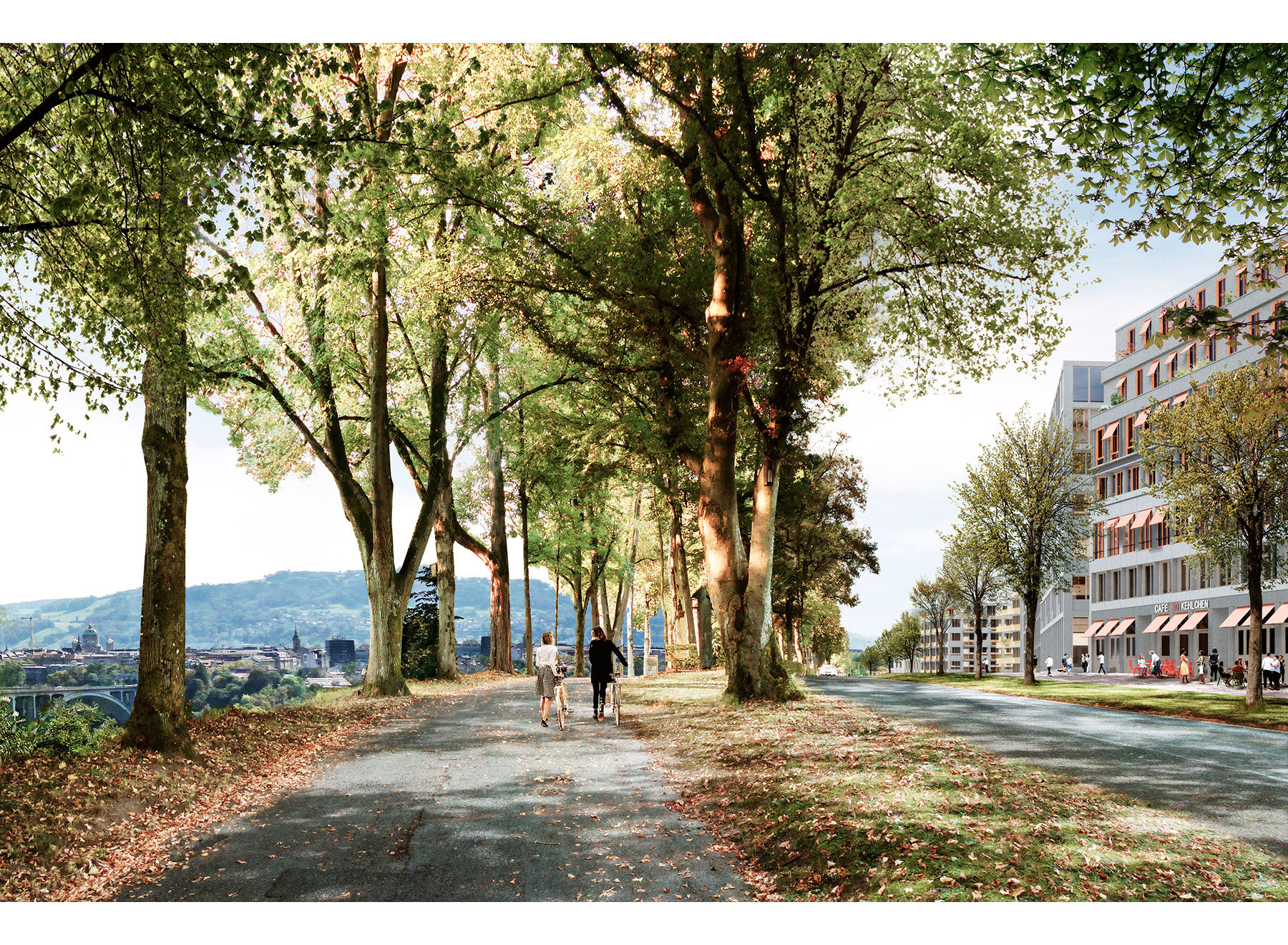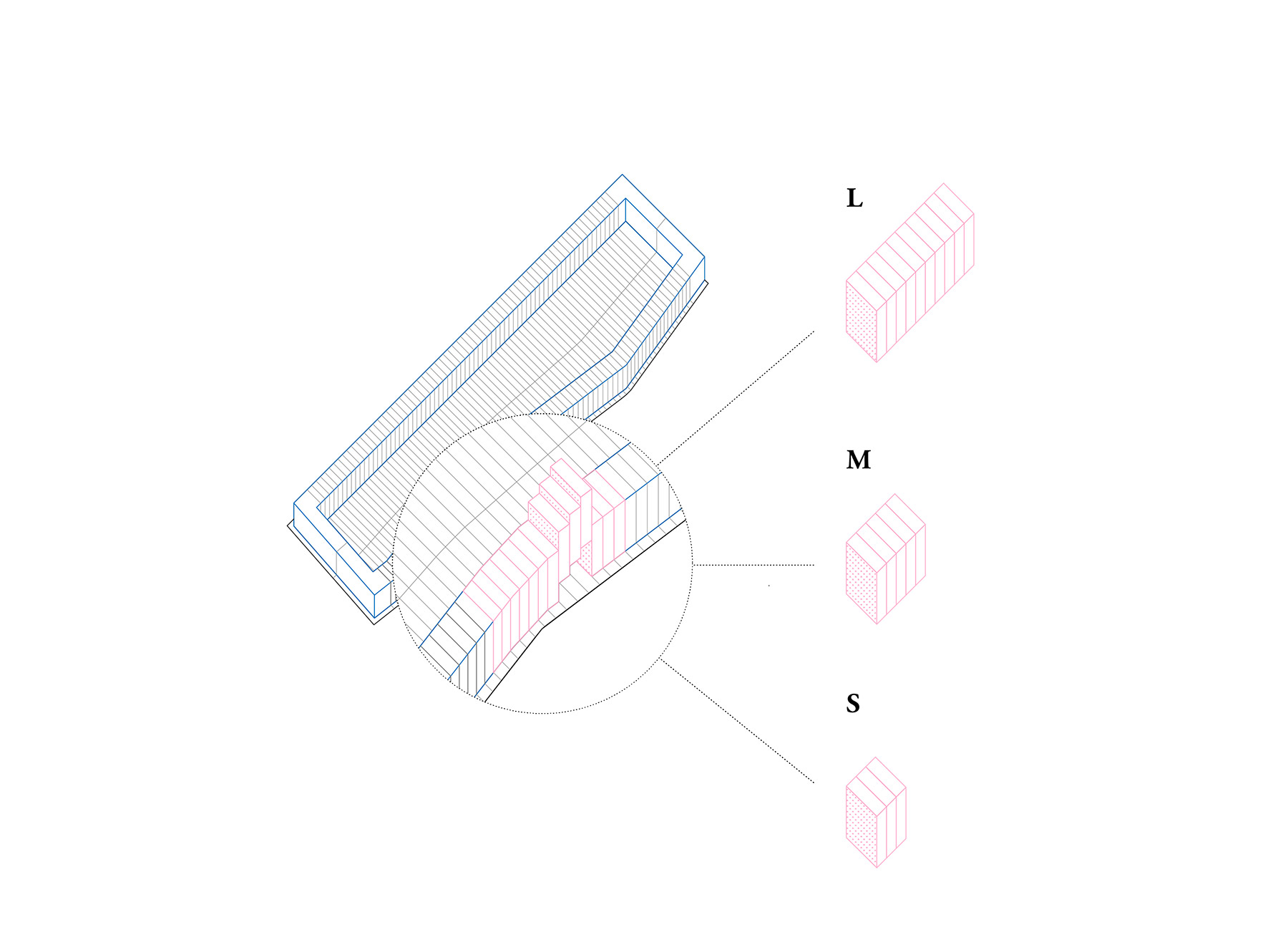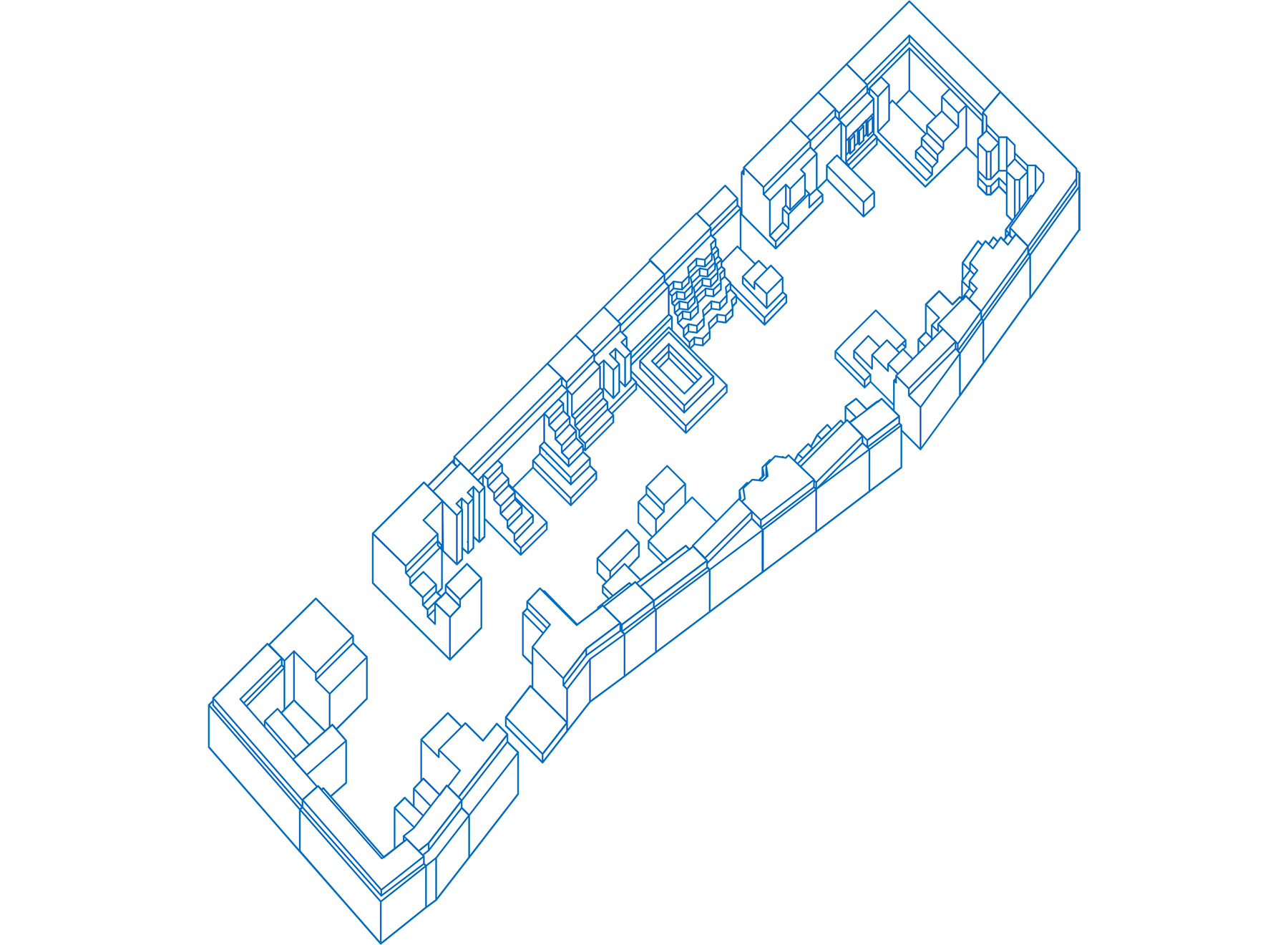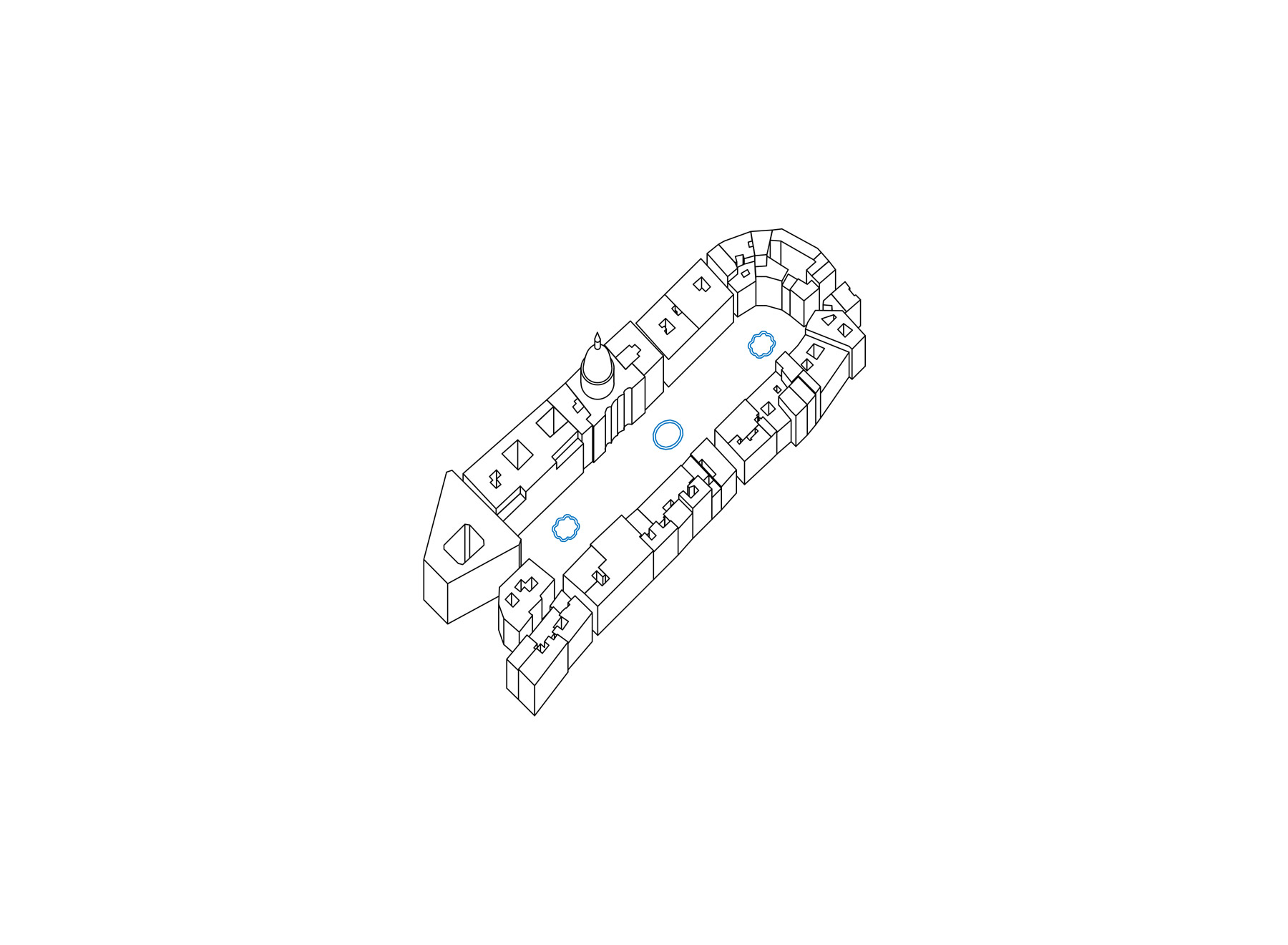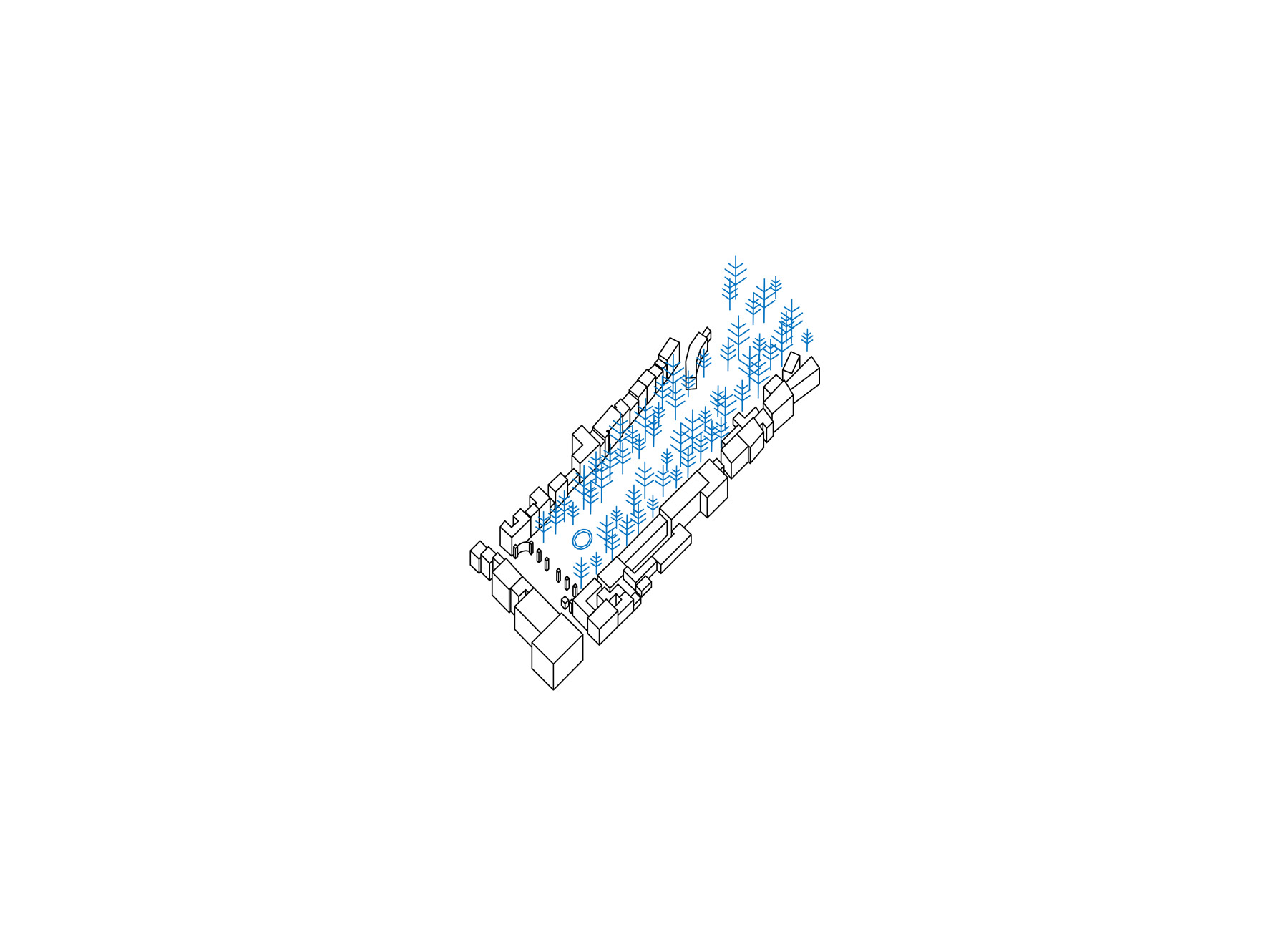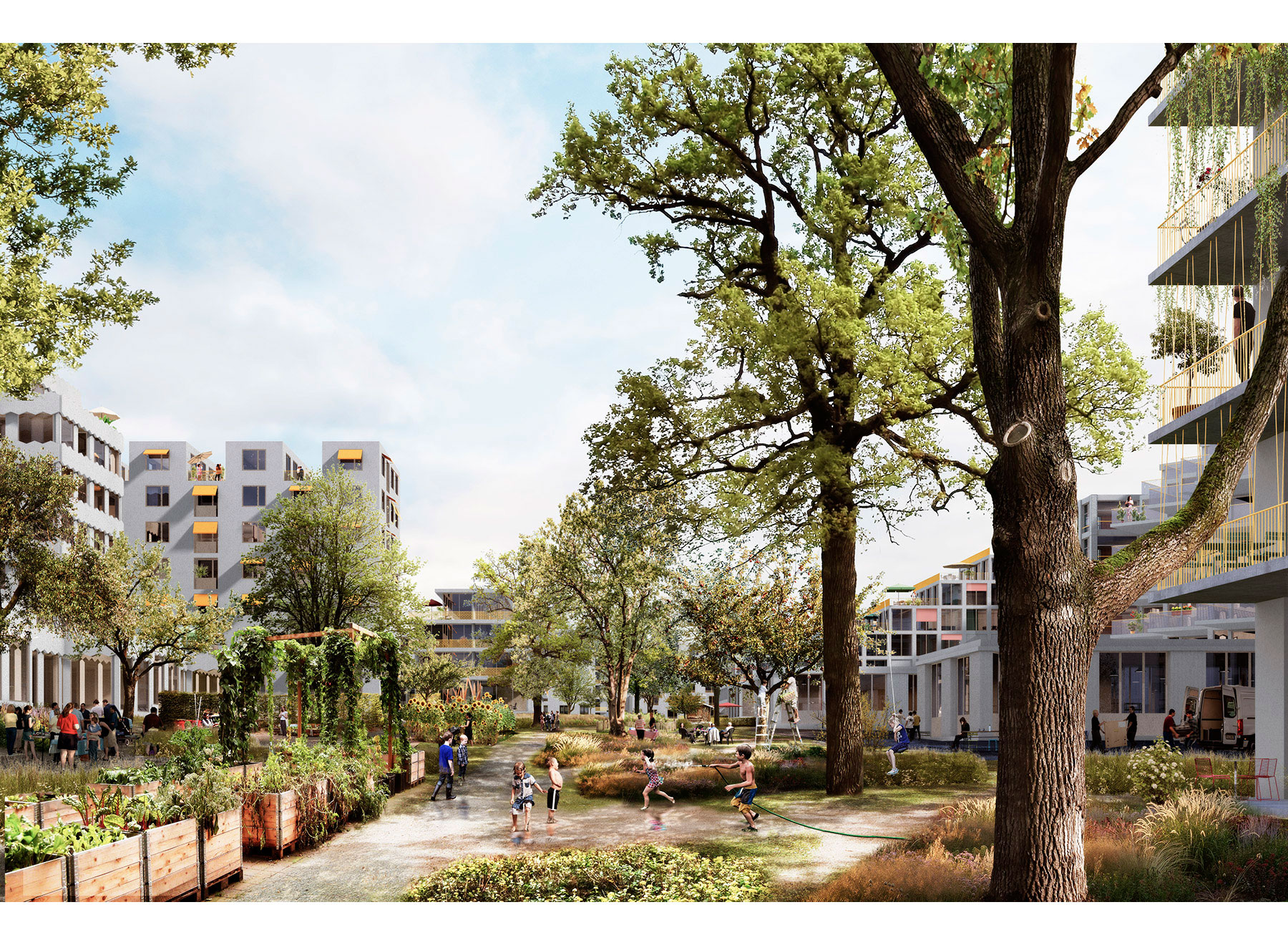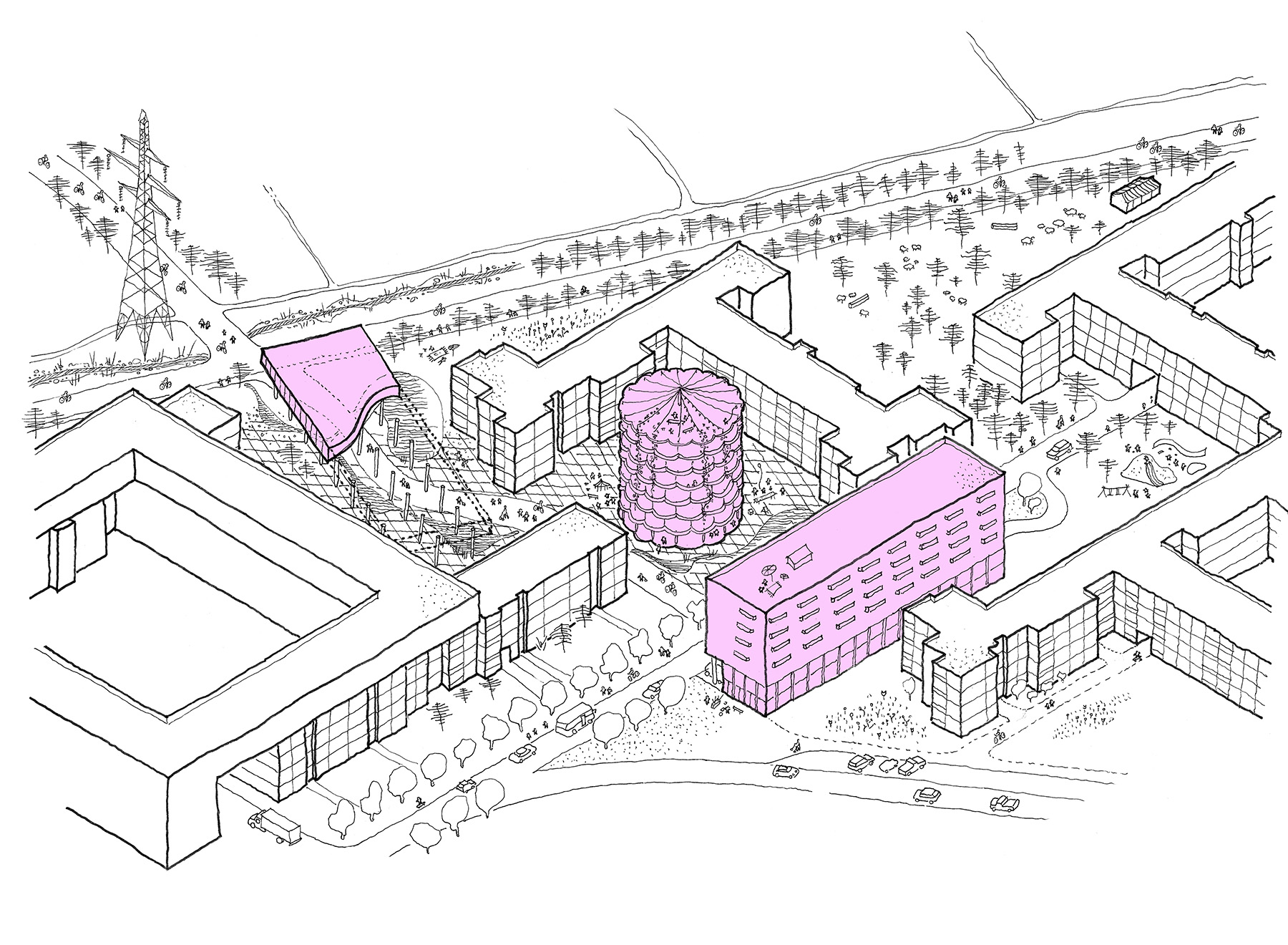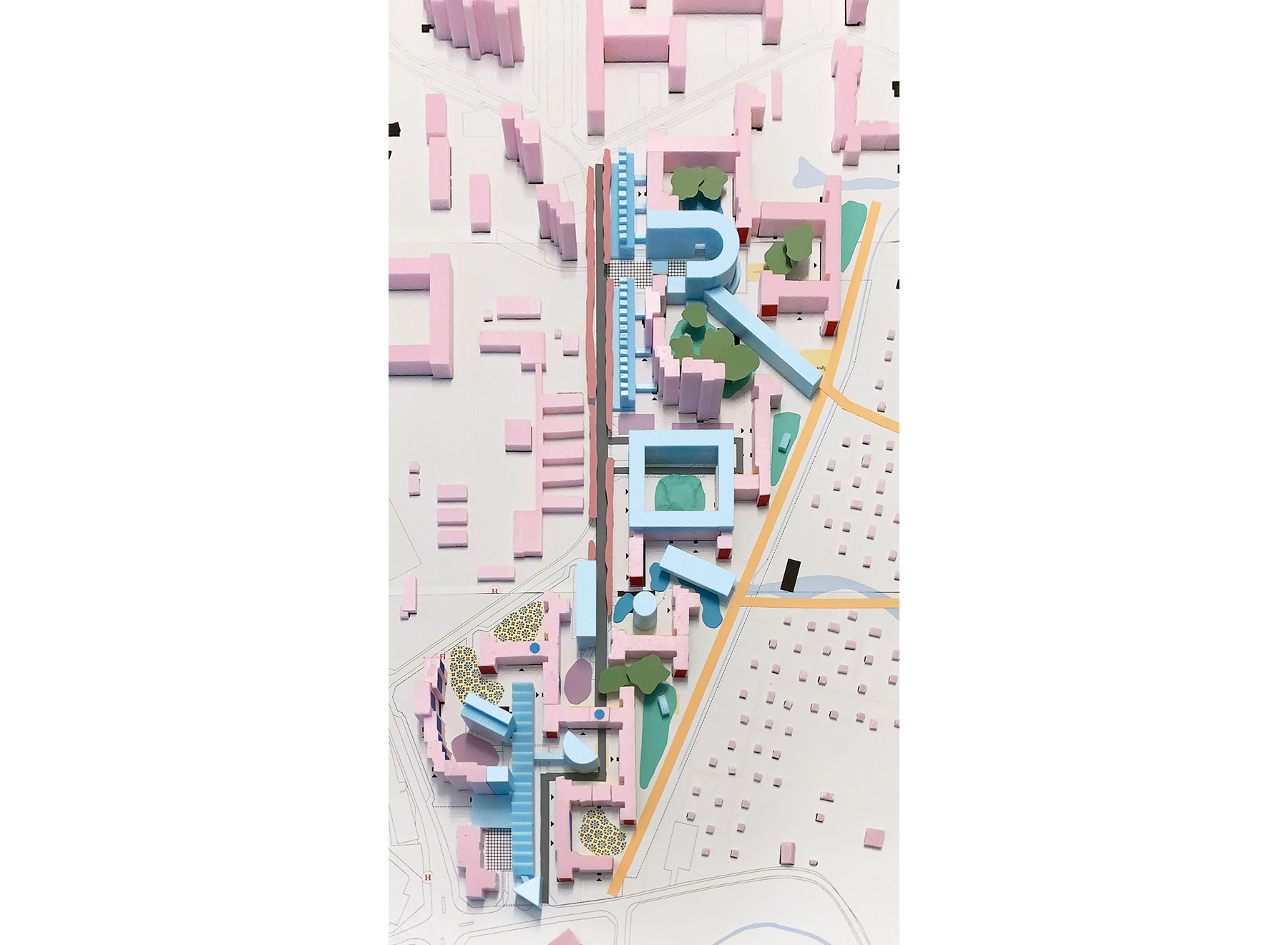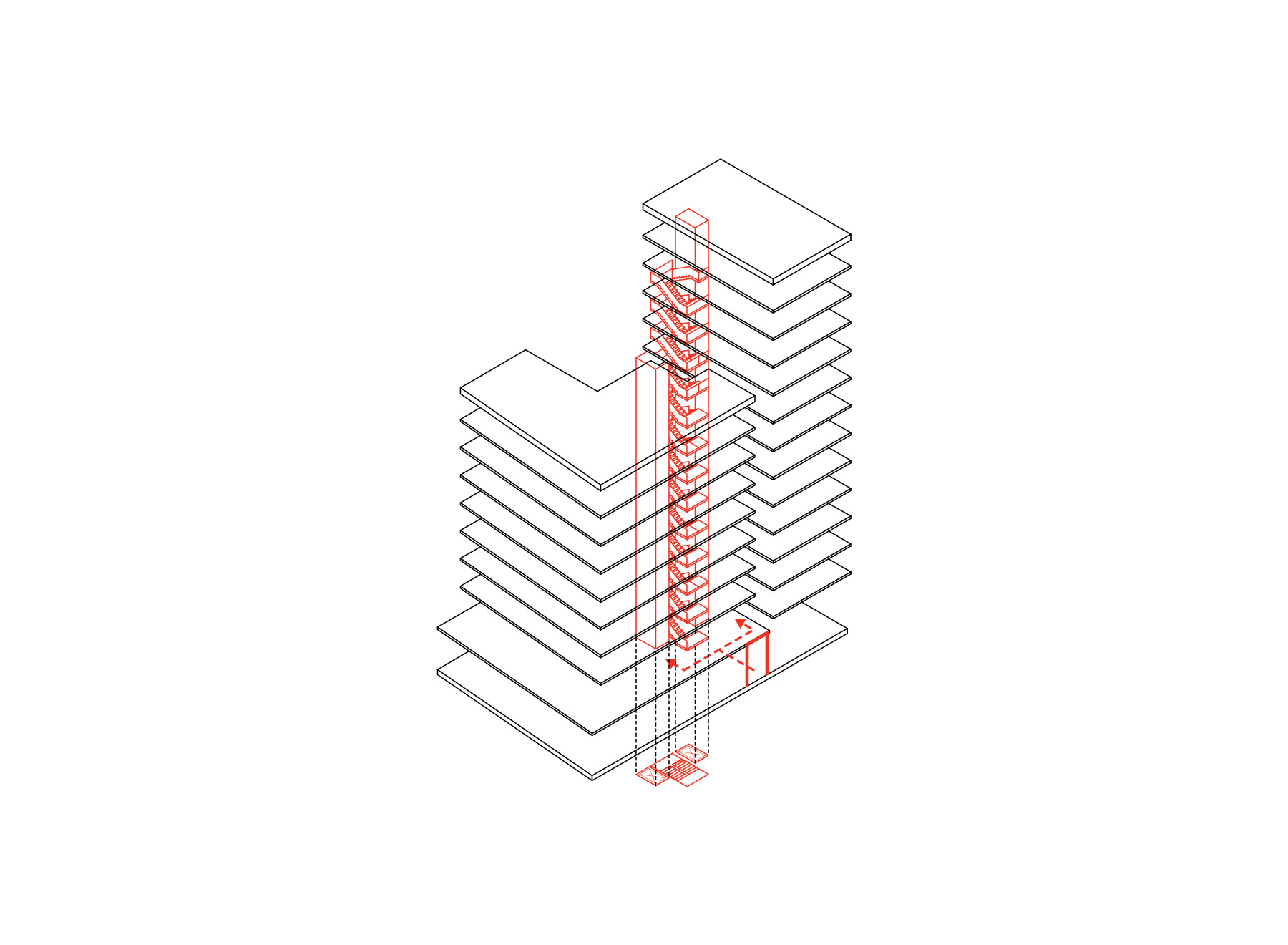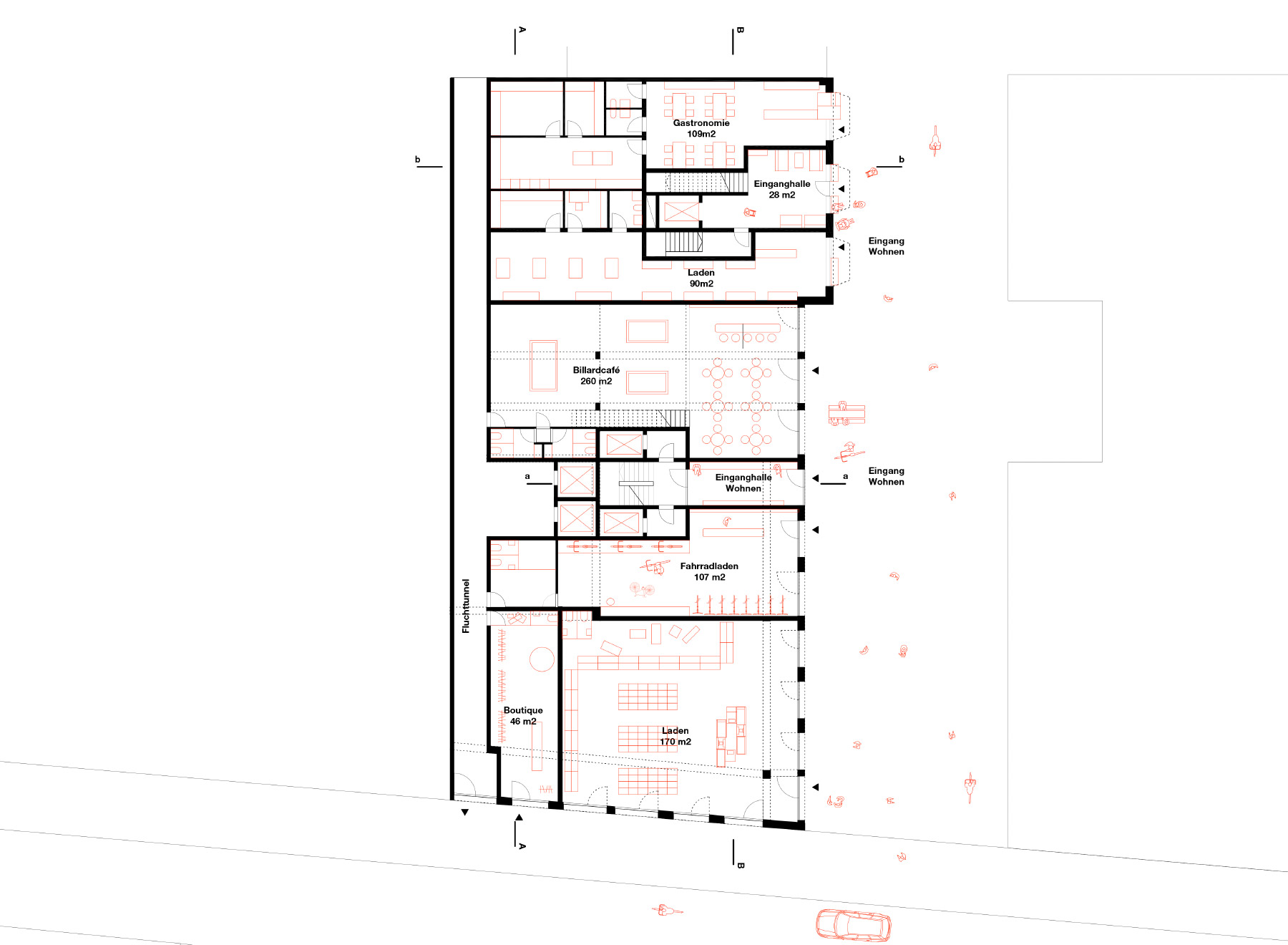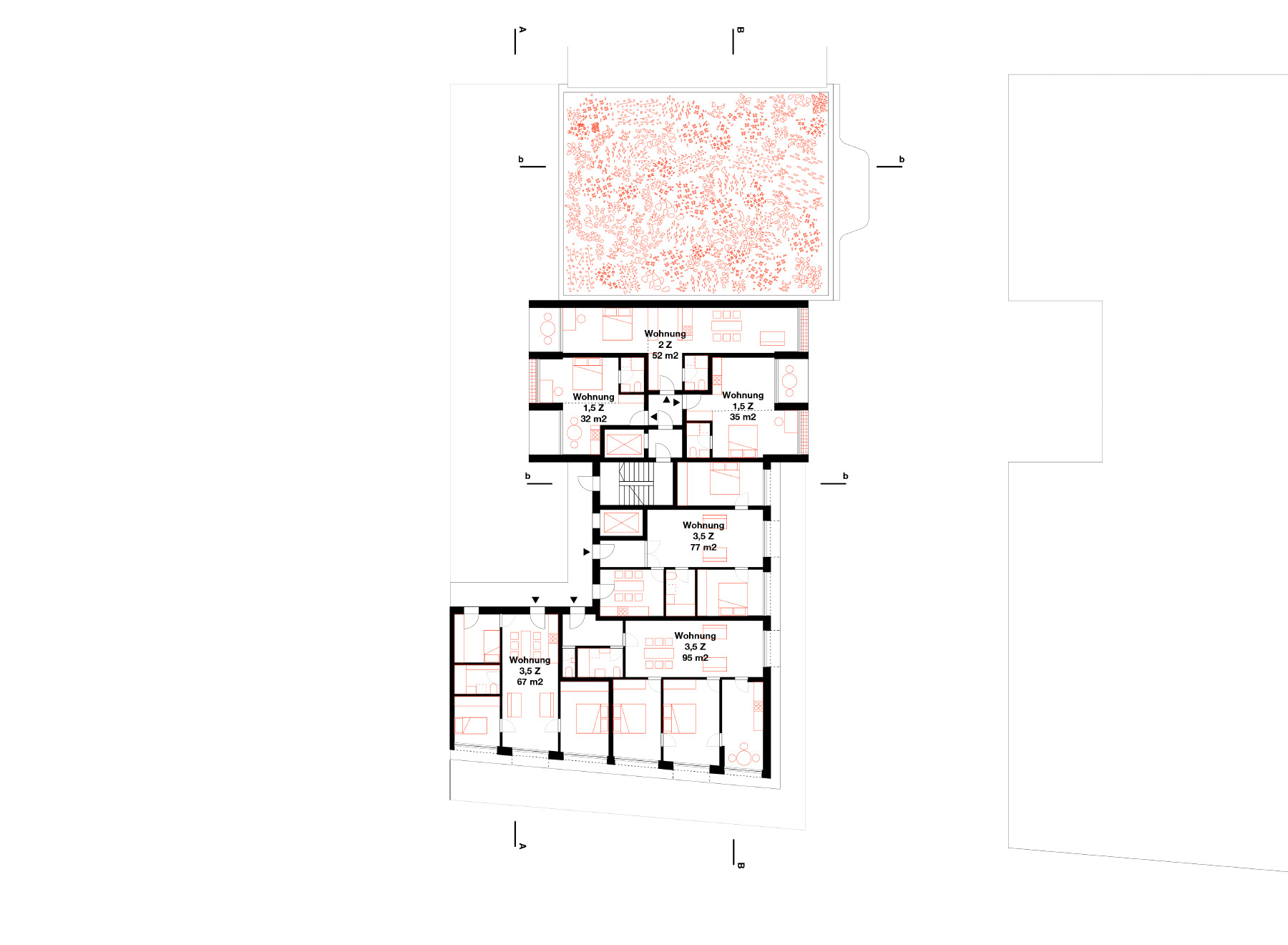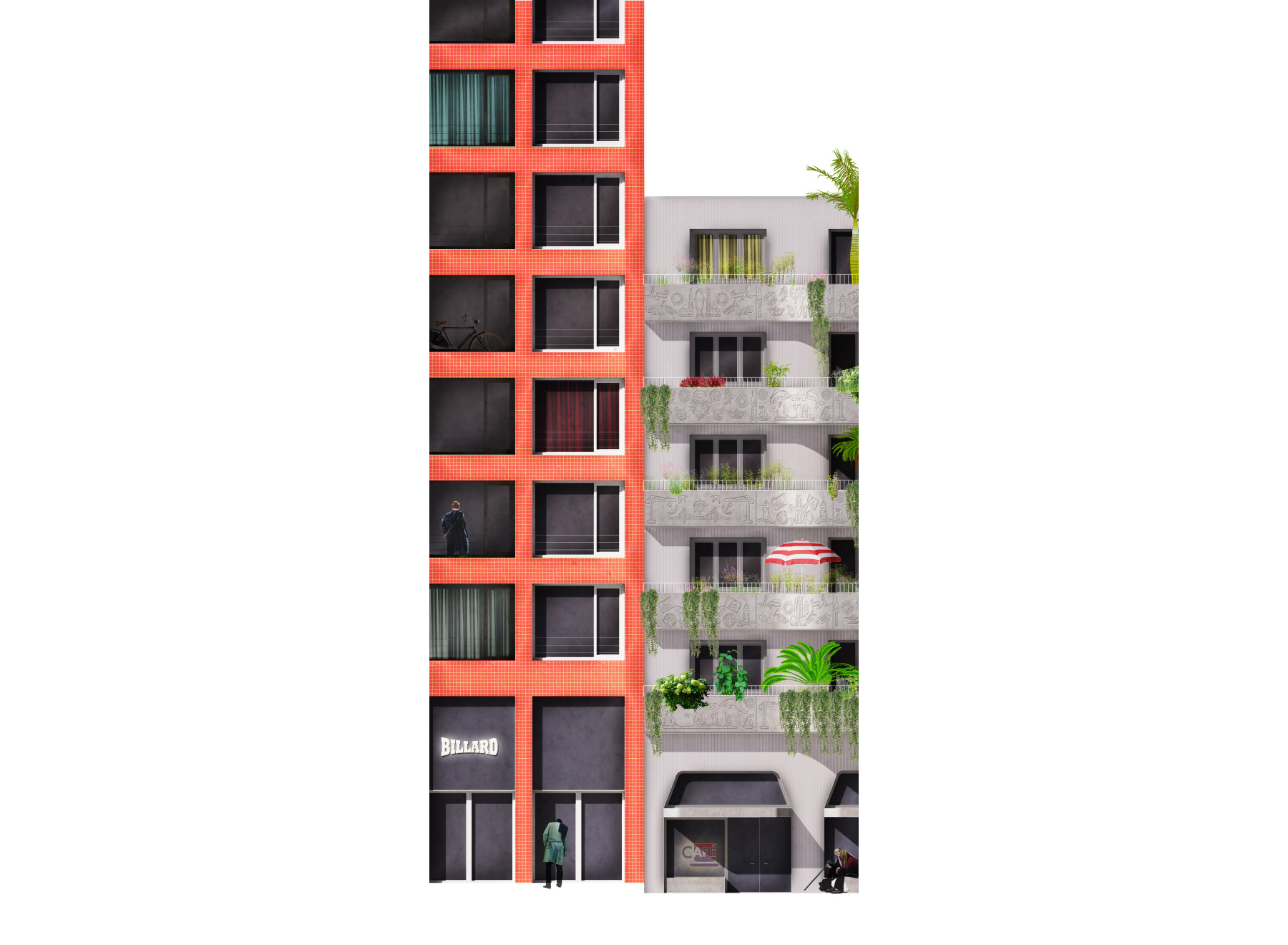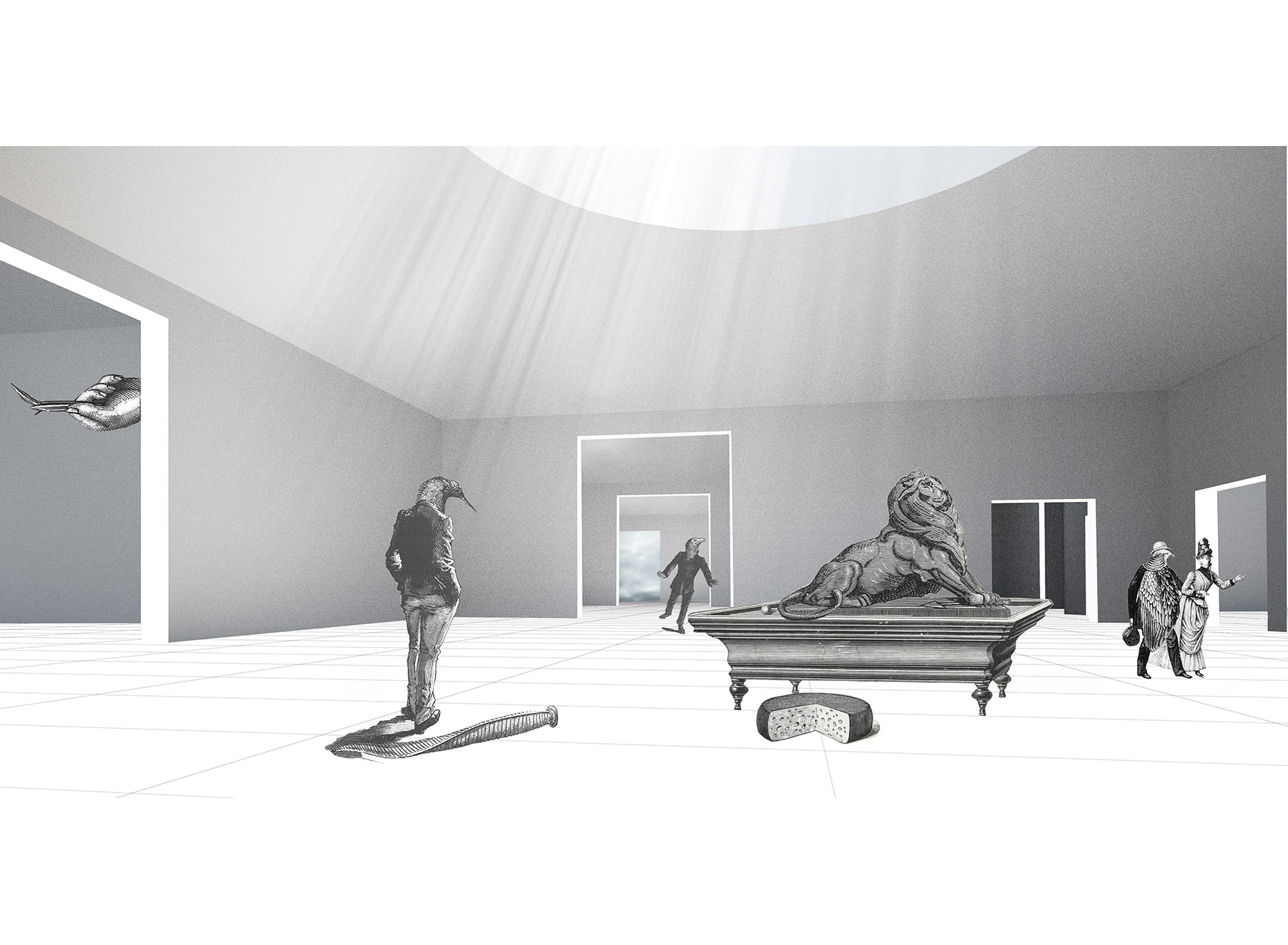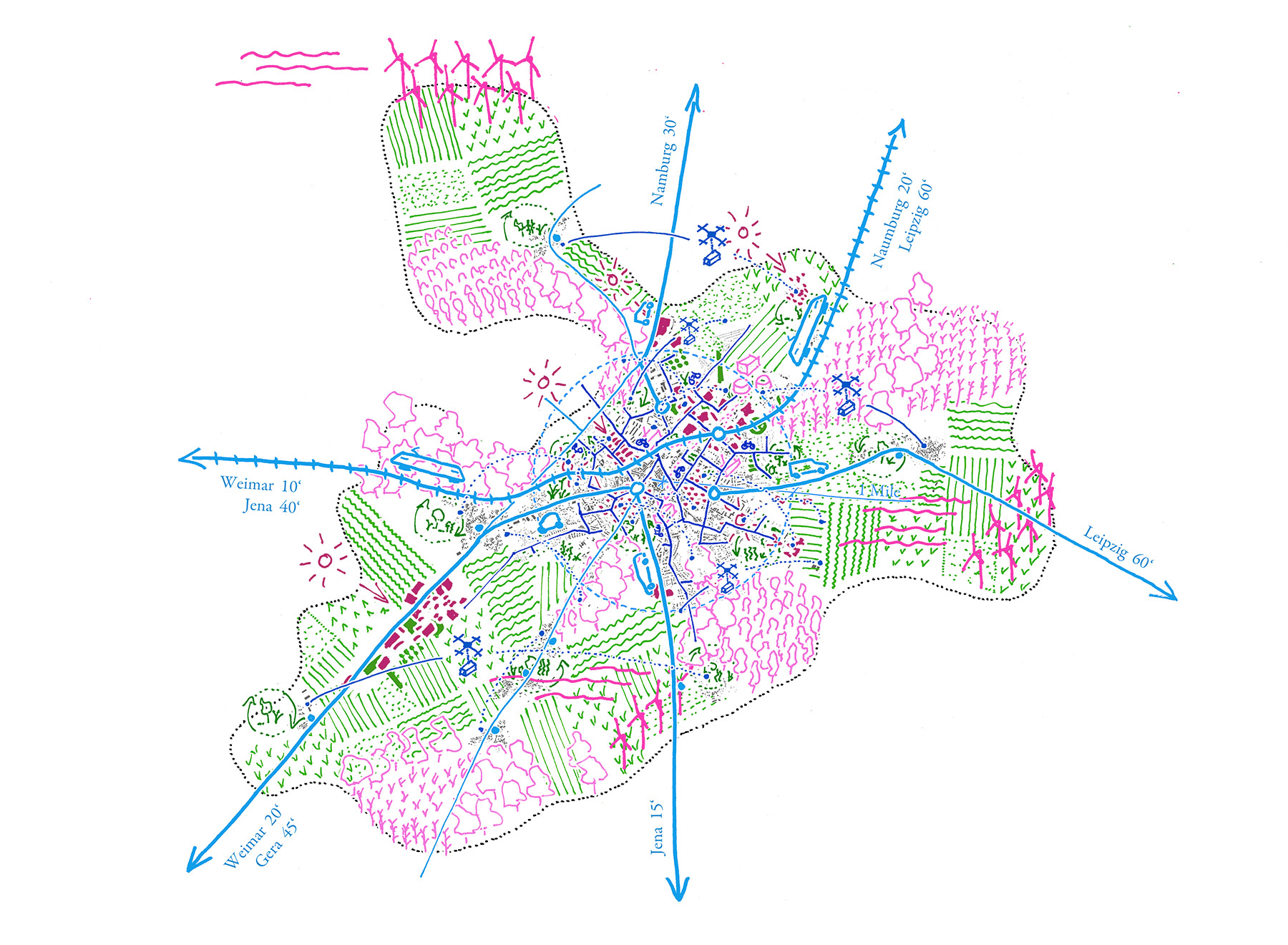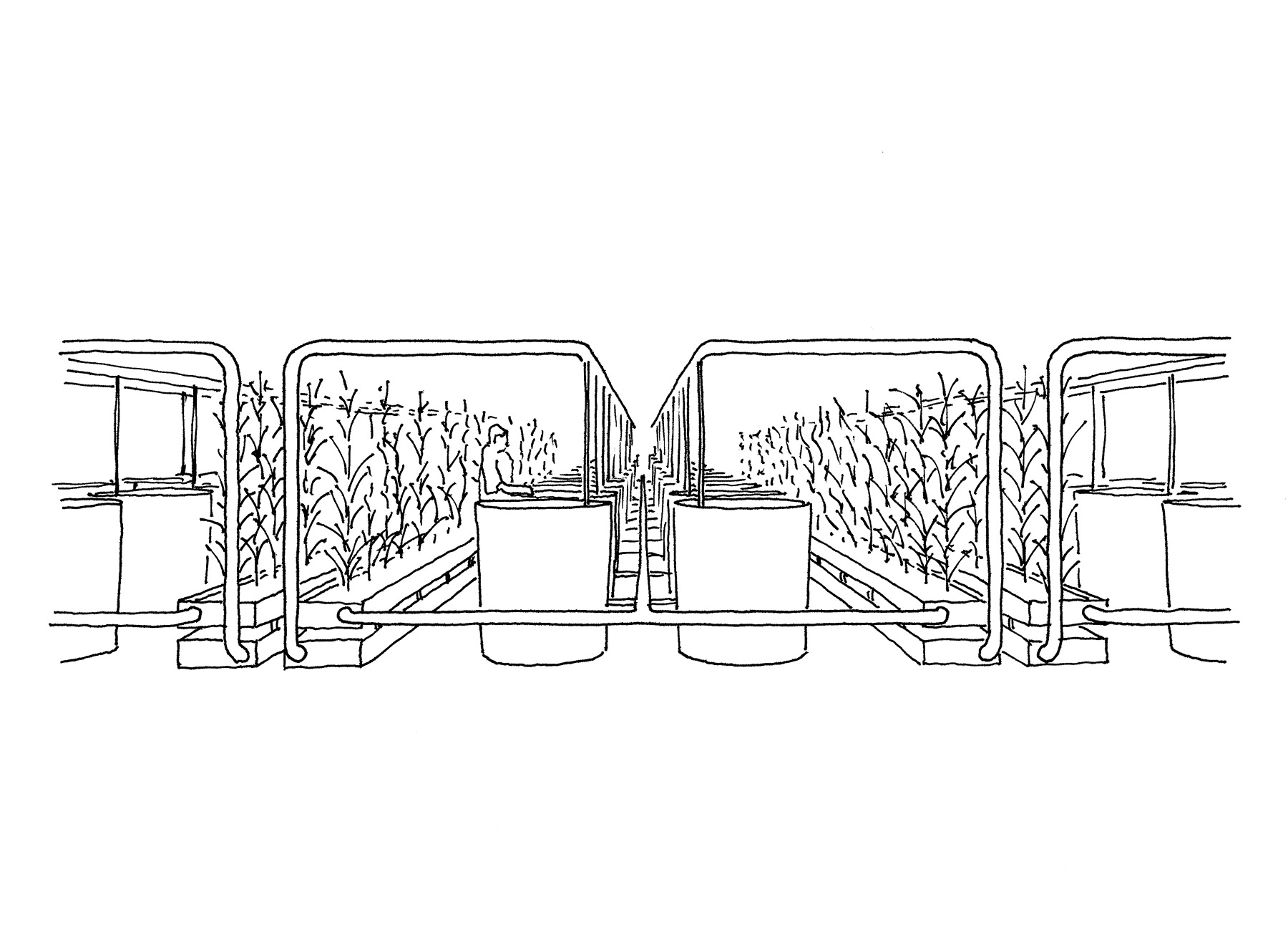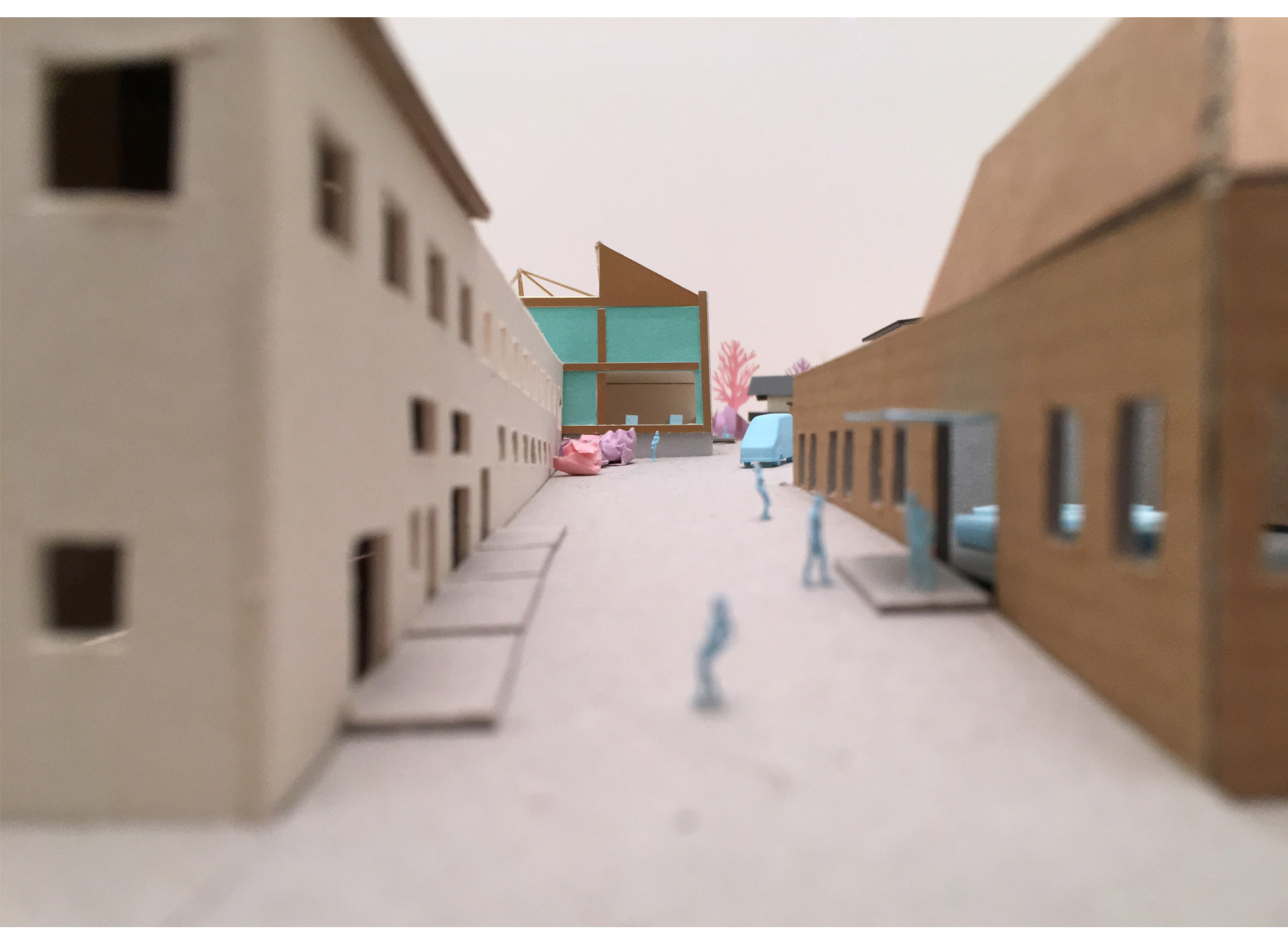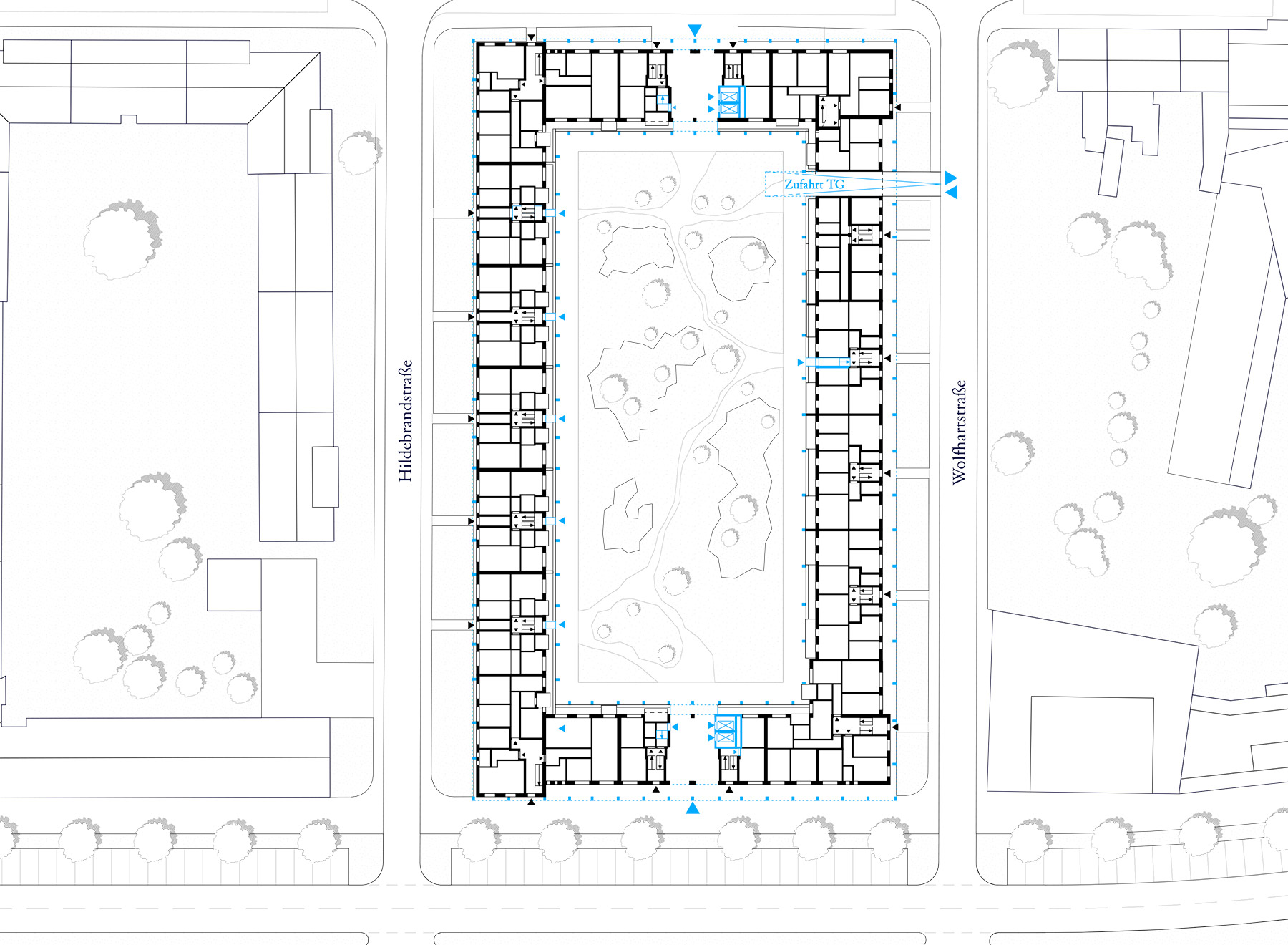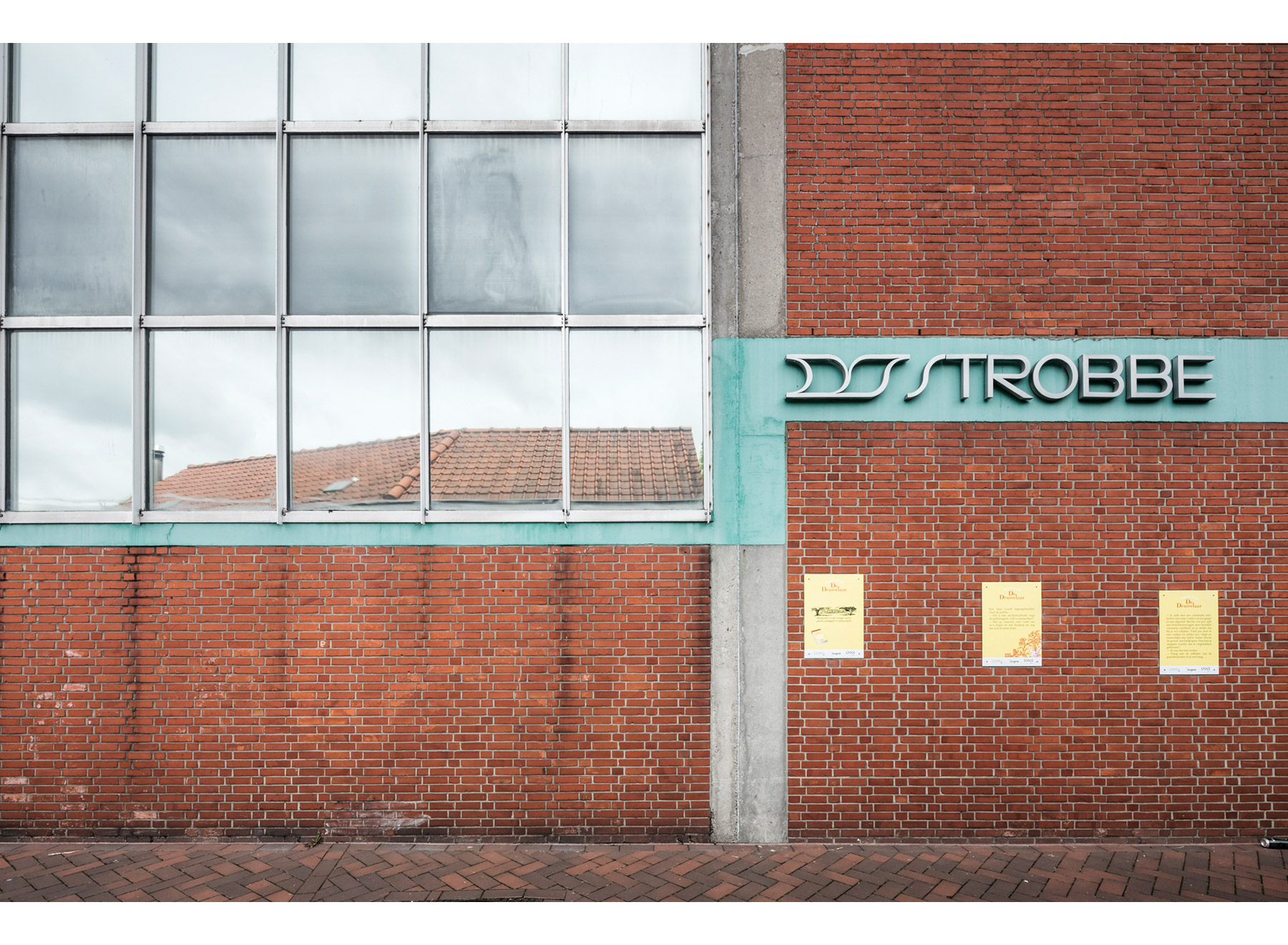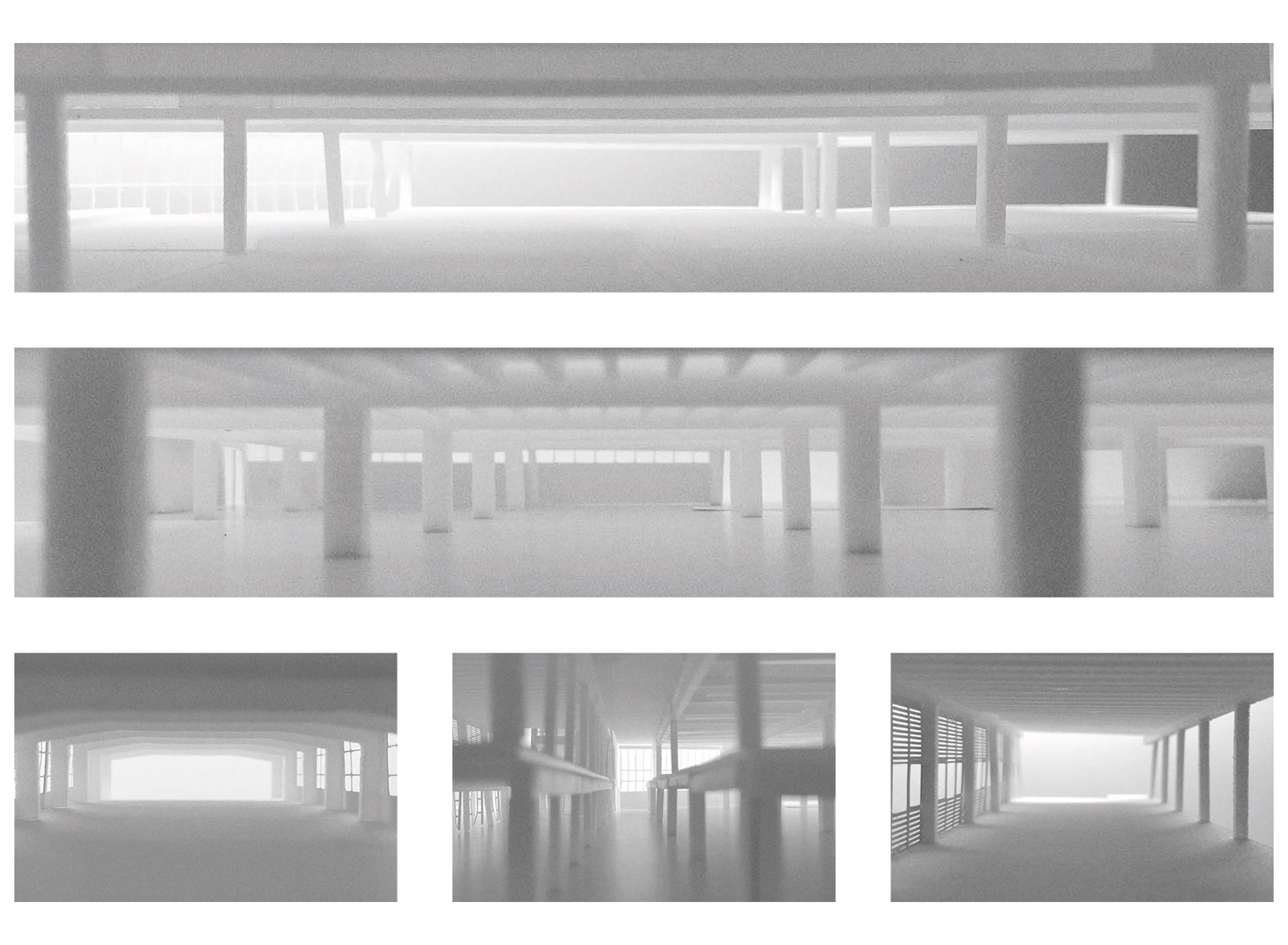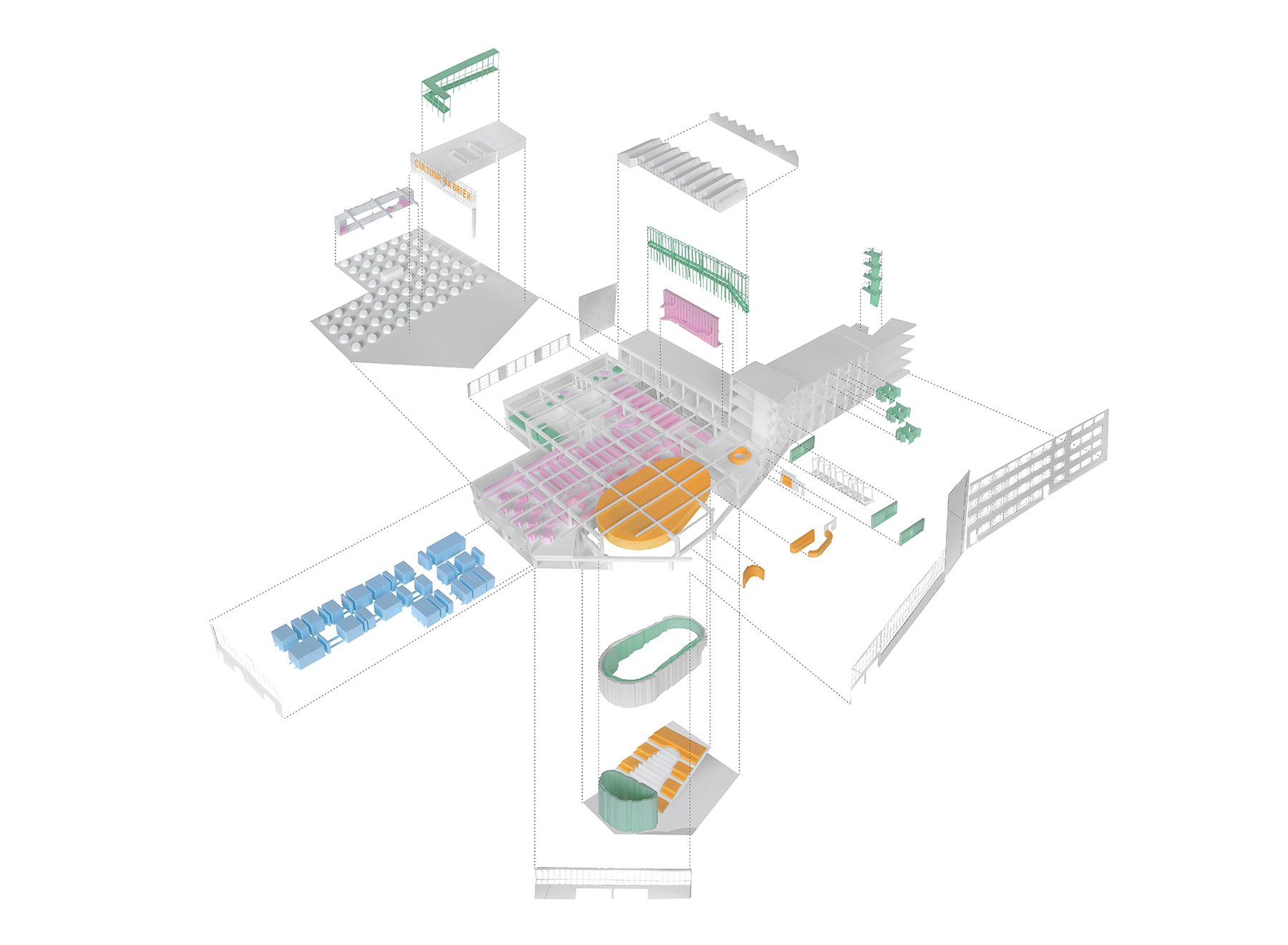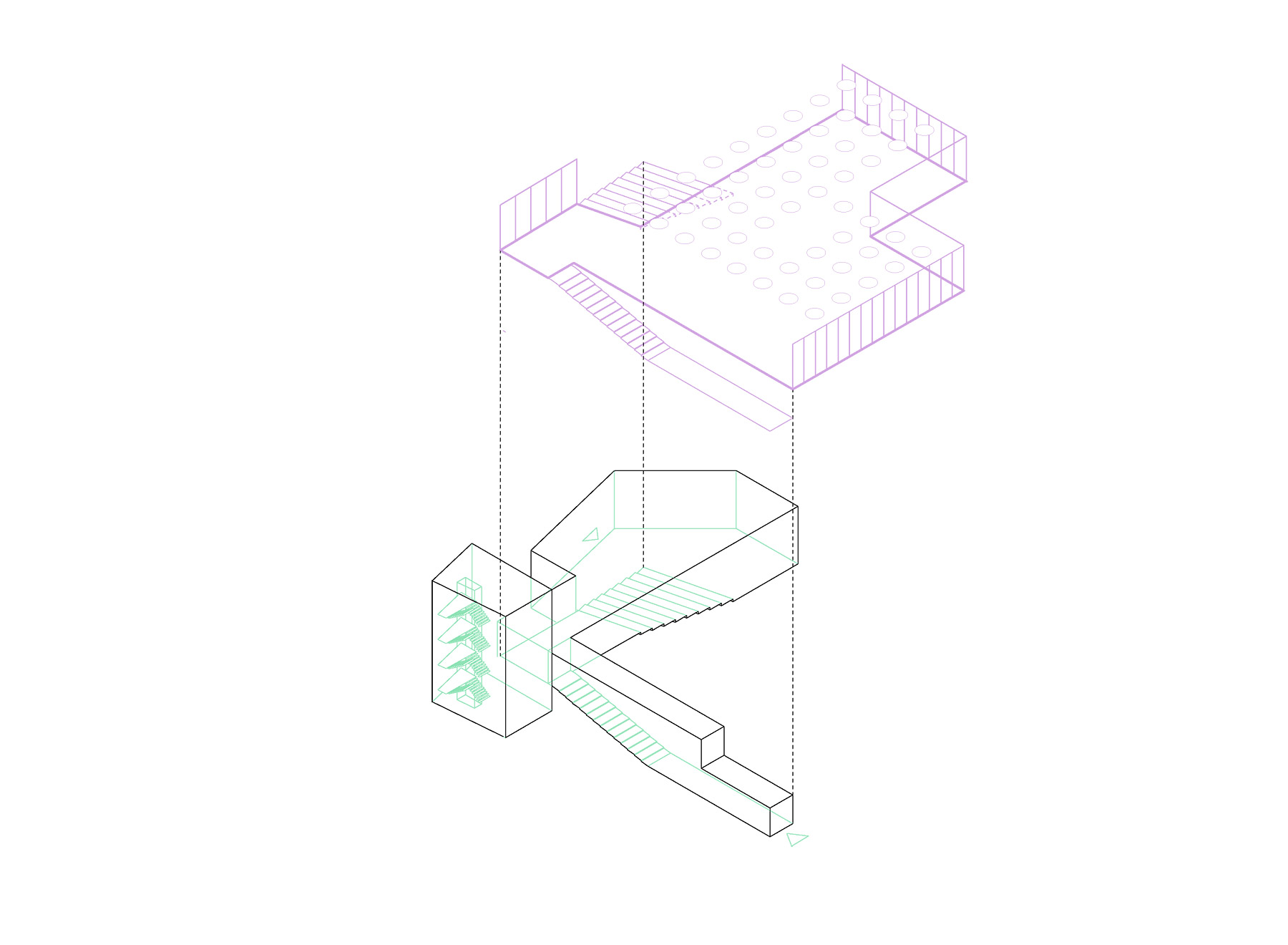117 Clouth Housing Competition, Cologne 2015
/,
text
status: competition
program: housing
location: Clouth urban re-development Nippes, Cologne
team: Anne-Julchen Bernhardt, Jörg Leeser, Matthias Hoffmann, Christiane Schmidt, Wolfgang Zeh
client: Wüstenrot Haus und Städtebau GmbH
date: May 2015
Ja, das möchste: Eine Villa im Grünen mit großer Terrasse,
vorn die Ostsee, hinten die Friedrichstraße;
mit schöner Aussicht, ländlich-mondän,
vom Badezimmer ist die Zugspitze zu sehn -
aber abends zum Kino hast Dus nicht weit.
(aus Theobald Tiger alias Kurt Tucholsky, Das Ideal, Berliner Illustrierte Zeitung 31.7.27)
To the north lies the urban street; to the south, a garden within nature. Here, one finds conditions out of Tucholski's "The Ideal."
The transition from the private to communal areas is finely graded, inviting contact between neighbors. To create a semi-public space along the facade, the ground floor moves back slightly. Each entrance hall is flanked by a finely tiled bench, helping the house to participate in the life of the sidewalk. The two-side oriented apartments have a continuous window strip towards the urban side, where a small balcony enables a connection, while a pergola creates balconies and loggias for all apartments along the garden side.
The building offers a variety of housing, from 2 to 5 ½ room apartments. These are distributed in a balanced mixture over all floors and provide for a wide range of living needs at various scales. The residents can use the floor plan flexibly; small spaces are arranged around a neutral distributor space, which can be both kitchen and living room. In the apartments from 2 ½ rooms or more, the user can decide freely about having a bedroom to the street or towards the garden. Some large apartments can be divided. Due to the flexibility of the ground plans, many alternative housing forms--such as cooperative housing, live/work housing or multi-generational living--are possible under one roof.

005 DIN Adaptable Trade Fair System, 2003
/,
text
status: completed
program: trade-fair stand
location: various
team: Anne-Julchen Bernhardt, Jörg Leeser
net floor area: 60 m2
cost: 73.500 €
date: April 2003 – April 2009
Bauweltpreis 2003, honourable mention
DIN transforms the client's 2-dimensional Corporate Identity into 3-dimensional space.
DIN questions and celebrates German engineering as a "white hole" of sublime emptiness.
Obsessive compliance to the DIN stationary system generates a surreal Wagnerian totality.
Subtle ambiguities of scale and texture reveal inconsistencies of the assumed perfection.
Wall, floor and ceiling consist of a single solid surface material; furniture is made of PU-foam.
Hyperbolic commitment to the presumably perfect order reveals the fragility of certainty.
Overweight managers lower their massive bodies onto the delicate chairs.
The apparent minimalist space is charged with a multitude of possible readings. The real physical space of DIN appears to be an inhabitable computer rendering.
162 Volta Nord Urban Design Competition, Basel 2020 – BeL & Marco Merz Marion Clauss & Studio Céline Baumann
/,
text
status: urban study
program: housing, commerce, industry
location: Basel
team BeL: Anne-Julchen Bernhardt, Jörg Leeser, Julia Kaulen, Hannah Rudolph
with Marco Merz, Marion Clauss, Leonard Schaffner, Céline Baumann, Merlin Bauer, Martina Kausch, Martin Josephy, Bárbara Maçães Costa
client: City of Basel
date: January 2020
The site lies in the transition zone between the Volta industrial area and the St. Johann residential district. A juxtaposition of different scales and building forms defines the site, whose identity emerges in the field of tension between impressive large buildings and small, individual urban building blocks. This juxtaposition is fruitful. Although the buildings and open spaces of the industrial plants follow exclusively logistical necessities, they form qualitative urban spaces which, when converted, result in multi-layered living environments. The urban structure of the design takes up the potential of this industrial context, interweaving the needs of a mixed living and working quarter with the expressive spaces of the industrial environment.
From three elementary typologies—the bar, courtyard building, and comb—a series of large conglomerates are born; creatures with a shifting open-closed character. One moment they appear as object-like solitaires, while the next they yield to the open spaces with a touching intimacy. These large entities are formed from groups of smaller individual typologies which vary in height between five and nine stories; optimized for the lighting of all interior and exterior spaces. A multitude of yards, courts and niches are formed by these large volumes, offering acoustic protection from the noise of the surroundings; each dwelling has at least one façade facing a protected area.
The hierarchy of these spaces—their zones of graduated privacy—can be grasped intuitively. Two vistas into the park in the northern part of the development signal accessibility without thresholds, while large yards—formed with the simple bar-type buildings and characterized by a high degree of collectivity—open to the street for commercial, artistic, educational, or communal uses. The courtyard building-type entrance courts provide a somewhat smaller communal space for residents, while the comb-type buildings, with their small pockets of semi-private space, stitch a small-scale residential character into the industrial-scale surroundings.

058 Das Bauhaus kommt aus Weimar Exhibition Design, Weimar 2009 – BeL & Meyer Voggenreiter Projekte
/,
text
status: completed
program: exhibition design
location: Neues Museum, Bauhaus Museum, Goethe Museum, Schiller Museum, Weimar
architecture: BeL & meyer voggenreiter projekte
team: Anne-Julchen Bernhardt, Jörg Leeser, Adria Daraban, Claudia Hoffmann, Philipp Schneider, Meyer Voggenreiter, Wolfgang Zeh
graphic design exhibition, catalogue, internet: Goldwiege, Weimar
graphic design panorama Bauhaus museum: Are We Designer, Cologne
net floor area: 3.400 m2
client: Klassik Stiftung Weimar
date: April 2009
To occasion the 90th anniversary of the foundation of the Bauhaus, the Foundation of Weimar Classicism is organizing a large Bauhaus exhibition: 4 locations, 3400 m2, 1200 objects, one exhibition, one city: ‘Das Bauhaus kommt aus Weimar’ (The Bauhaus is from Weimar), April 1 - July 5, 2009. The exhibition architecture includes both the interior of the four museums - Bauhaus, Goethe, Schiller and Neues Museum - and connects the 4 exhibition locations to one another.
The inter-museum connection is made via so-called ‘text hedges.’ The text hedges—self-supporting constructions made of two 4 mm thick laser-cut steel sheets—feature quotations from Walter Gropius, which thematically introduce the exhibition. In front of the museums, the text hedges use existing flowerbeds, baroque balustrades and postmodern sandstone walls as substructures, adding a layer of exaggeration to Weimar's closed, harmonious urban space. The motif of the bourgeois quote—welcomed in Weimar—is, through human-sized lettering and radical content, brought to completion.
The Bauhaus wanted nothing less than a new human: industrial mass production as the means to a glistening future... a future which has existed for more than 40 years now. The exhibition architecture is made of a single universal system, used in each museum. Made of aluminum square tubing and white Resoplan panels, this system is all-encompassing. It is made for the exhibition, the trade fair, the supermarket, the store fittings, the everyday life, the Gesamtkunstwerk, theater, photography, text, festivals, etc. The exhibition experience can then also be comprehensive: sleeping, eating, relaxing, looking, contemplating, watching film, seeing theater, teaching, arriving, leaving, returning…

125 Euroforum Competition, Special Prize: Façade, Cologne 2016
/,
text
status: competition. special prize façade
program: housing, workshops, retail
location: Mülheim, Cologne
team: Anne-Julchen Bernhardt, Jörg Leeser, Christiane Schmidt, Matthias Hoffmann, Michel Kleinbrahm, Gina Rauschtenberger, Leonard Palm, Wolfgang Zeh
client: Euroforum Nord GmbH & Co. KG
date: January 2016
The two solitary structures--containing a total of 350 dwellings--inherit their scale, and many of their characteristics, from the industrial architecture of the neighborhood’s past. They maintain a strict structure in their construction and design; the repetition of rational elements lending a calm, impassive presence to the simple building volumes.
The urban outdoor space is diverse and lively. Ground-level residential studios strengthen the creative potential of the area through the mixture of living and working. The urban exteriors stand in contrast to the paradisiac shared interiors, which also offer a habitat for animals and plants. All apartments have at least two types of light and views; looking out, the space is lively and urban, while looking in, it is tranquil and green.
The clear separation of the outside and the inside is reflected in the design of the façades. The street-side façades are clad with prefabricated concrete. While their horizontal structure is homogeneous with soft repetitions, the individual levels differ significantly from one another. This vertical differentiation creates a sculptural relief with diverse and invigorating shadows. In the courtyards, volumes are projected to maximize the surface of the block. The façades are thus uniformly designed as wooden elements; their warm and simple forms adding to the peaceful character of the courtyards.

081 Kleines Haus Blau Conversion, Hürth 2012
/,
text
status: completed
program: conversion and extension of a single-family house
location: Hürth
team: Anne-Julchen Bernhardt, Jörg Leeser, Wiebke Schlüter, Christiane Schmidt
structural engineer: Fritz Münster, Frechen
clients: Sirit and Dirk Breuer
area:136 m2 plus 37 m2 attic
costs: 230.000 €
completion: May 2012
LBS-Preis Das Goldene Haus 2013
Houses of the Year 2013, Shortlist
Kölner Architekturpreis 2014
Architekturpreis NRW 2015
BDA-Architekturpreis Nike 2016
After the purchase of a small settler’s house from the 1950s, there was not much money left for a young family to build themselves a home. The decision was therefore made to refurbish and extend the existing house rather than rebuild it, saving not only money but also the material and energy conserved in the existing structure. The settler’s house is treated as raw structure into which the new is fitted, tuning up the typology, energy use, and accessibility of the house.
The suburban house—its spatial qualities having blurred, its references to history and context gone dim—is brought back to its origins and transformed into architecture. The three stories of the house are differentiated and formed through three different spatial concepts: A lengthwise directed living space on the ground floor, separate rooms circulating around a central access area on the first floor, and an open space concept in the attic.
The load-bearing walls are retained, while the different spatial concepts are introduced into the structure. The new lengthwise directed rooms on the ground floor connect front yard and garden, through the living space. Spacious double doors in the cross-direction link the new terraces on the sides of the house to both living room and kitchen. The new staircase is relocated on the outside of the house, connecting ground and first floor without disrupting the open character of the living-space. The four rooms of the first floor become individual characters—morning, day, evening and the north/garden room—through single windows, all facing a different direction. The attic bares the possibility of being buildout into an open space bedroom, arranged around a well-positioned bath box.
The small house stays small. It grows in length by 2.20m and in space from 118 to 152 m2. The extension rests on the foundations of the former terraces and is built in a light steel construction fitted with wooden walls. The new, insulated rafter-roof connects both parts of the house. The outside walls of the existing structure are insulated and plastered. While the different constructions and materials differentiate the new and the old are inside and out, the overall coloring of the walls keeps this effect subtle.

131.2 Quartier Spielbudenplatz: Museum, Hostel Competition, Hamburg-St. Pauli 2016-2020 – BeL & NL Architects
/,
text
status: competition
program: museum, hostel
location: St. Pauli, Hamburg
team BeL: Anne-Julchen Bernhardt, Jörg Leeser, Christiane Schmidt, Alia Mortada, Julia Kaulen, Michel Kleinbrahm, Jonas Läufer, Wolfgang Zeh
team NL: Kamiel Klaasse, Kirsten Hüsig, Laura Riano Lopez, Pieter Bannenberg, Guilia Pastore, Jasna Kajevic
structural engineer: Jürgen Bernhardt, Cologne
client: Bayerische Hausbau GmbH & Co. KG., Bezirksamt Hamburg Mitte
date: August 2016
The small Plot 2 features a compact, interconnected structure of communal cultural uses. Thus, the complex relationships of opening, demarcation, insight and separation give form to this urban building block. On Spielbudenplatz stands the small museum with a massive façade, crowned by a skate park. Its glass pedestal contains a café and a club, which extends into the basement. From here, a staircase connects the clubs concert space with the townhouse-style hostel next door.
The museum façade acts as a sound barrier, protecting the alley behind and the building itself from the noise of Spielbudenplatz. Operable windows are hidden in the trapezoids of the soundproof wall, and skylights are concealed in the volcanoes of the skate park. A bridge spans the alley, connecting the skate park to the adjacent 3D building of Plot 1. Here skaters spend the afternoon in the evening sun, enjoying the view over the Reeperbahn while a service entrance from the hostel supplies drinks.
The club has two function rooms: a day club on the level of Spielbudenplatz with a stage in the shop window and a subterranean club with a basilica-like layout under the alley. You descend into the club via a central staircase - with cloakroom and box office in what would be the organ loft. From the club, a service staircase leads up to the hostel, where visiting performers can lodge. The hostel is a narrow, eight-story townhouse on the alley with three small double rooms and a slightly larger private room on each floor. The rooms face the alley, each with a façade basket for airing clothes and storing travellers' belongings. A two-story restaurant, which also serves as the reception, opens onto the alley. Here, guests can spend their days and evenings before ascending to their rooms.

153 Neuländer Quarree Competition, 1st prize for A2/A4, Hamburg-Harburg 2019
/,
text
status: competition. 1st prize for A2/A4
program: housing, retail, daycare facility for children
location: Hamburg-Harburg
team: Anne-Julchen Bernhardt, Jörg Leeser, Sebastian Haufe, Julia Kaulen, Alina Uhlenbrock
client: CG group
date: March 2019
The Neuländer Quarree is a decisive building block in the urban transformation of Harburg's inland port. While the typical port traffic, logistics and commercial structures will continue to exist in the long term, residential and leisure uses are beginning to move in, requiring protection—particularly from noise. The urban master plan successfully meets this challenge with the perimeter block development of the building sites, but requires careful architectural interpretation of site-specific qualities. Harburg's inland harbor possess an identity-forming heterogeneity; the autonomous juxtaposition of sometimes dramatically different spaces, scales and building typologies give the area a rough, disorderly charm. Yet disorder is by no means random. The individual buildings each have their own order—corresponding to their individual industrial processes—and they hold together, not through monotony, but through a shared vocabulary of infrastructural elements and a common landscape: large swaths of sky, inland waterways and the resulting presence of water fowl.
The Neuländer Quarree develops its qualities from this balance of autonomy and dependence. The unadorned romanticism of the harbor is reinforced through and engagement with found building types. To this end, conglomeration serves as a principle of orchestration, coordinating a concert of the ordinary, the bulky, the simple, and the magnificent. The individual structures of the quarter are united by the master plan in an orderly manner, and the small blocks create dwellings which deal with the challenges of alignment and noise. However, to participate in aesthetic qualities of their immediate surroundings, the blocks are opened up and re-interpreted as assemblages of smaller parts. These parts are understood as house types which take up an active relationship to their context, evoking memories of familiar residential buildings. The resulting collage is overwritten by a material similarity; the formal structure of corrugation applied in different materials: sheet metal, GRP, ceramics, and precast concrete. These elements are complemented by generous, fowl-safe glass, giving all flats views into the landscape.
The first conglomerate, A1, is composed of three apartment buildings around a small square, one symmetrical, one staggered, and one round. An elevated plinth containing a fully-glazed restaurant and multi-story bike garage connects the symmetrical building to the north with the staggered building to the south. The staged building, in turn, merges into the round building to the west, completing the three sides of the square. The second conglomerate, A2, is formed from a deep-row building and a villa, both sitting on a plinth. The plinth contains 5,6-meter-high studio or commercial units and a generous lobby, serving as address and communal space for the development. The final conglomerate, A4, is more composite, featuring a homogeneous inner courtyard formed by corner, terrace and apartment buildings. The inner courtyard is the garden of the day-care center, which is situated in a ring around it, while the corner and terrace apartments claim expansive views of the harbor.

061 Eisenachstraße Conversion, Cologne 2009
/,
text
status: completed
program: conversion of a terrace house
team: Anne-Julchen Bernhardt, Jörg Leeser, Wiebke Schlüter, Wolfgang Zeh
net floor area: 150 m2
client: N.N.
cost: 150.000 €
structural engineer: Jürgen Bernhardt, Cologne
date: May 2009
The garden city estate of the Köln-Nippeser Bau- und Spargenossenschaft on Eisenachstrasse is one of the oldest cooperative housing estates in Cologne. Next to the large Nippes railroad repair works, the architect Heinrich Krings built around 60 inexpensive terraced houses for railroad workers' families between 1903 and 1905. The settlement won the gold medal for floor plan design at the 1900 World's Fair in Paris. As the last of the settlement houses to retain both street and garden-side facades, House number 38 is now listed for protection. The house suffered the misfortune of a lovelessly executed 90s renovation: three bathrooms were installed, rooms were divided, textured wallpaper and diagonally laid floor tiles covered the simple but robust original materials. By the time the new owners—a family with two children—purchased the house, this renovation had already worn out, but due to very high real estate prices, the remodeling budget was extremely limited.
For the new residents, the three separate units crammed into the existing building were re-integrated with selective interventions. The formerly semi-public stairwell was connected to the adjacent living and dining rooms, the kitchen was relocated to the street side, and the entrance hallway was demolished. A functional wall with integrated storage, work desk and through-way separates the kitchen from the newly created entrance hall. The dining room was given a door to the garden, and a fireplace area connects the dining room to the staircase. On the first floor, the demolition of the bathrooms made it possible to create space for a large living room adjacent to the children's rooms while the master bedroom with dressing room and a large family bathroom inhabit the second floor.
The entire house was remodeled with a dual strategy of brutalization and refinement. The new state is composed of the exposed fragments of all the previous ones: the visible shell of 1903, the framed extension of 1905, first improvements of the 50s, parts of the renovation of the 90s and contemporary interventions. All fragments are connected by a layer of beige paint, graduating their differences. The inset reading nook, fireplace bench, pass-through storage wall and shower niche, complete the programmatic expansion of the house. These new interventions follow the so-called ‘dental filling’ tactic: they fit seamlessly into existing conditions while revealing their independence materially.

072 Grundbau und Siedler Self-Build Housing, IBA Hamburg 2013
/,
text
status: completed
program: self-build housing
team: Anne-Julchen Bernhardt, Jörg Leeser, Christiane Schmidt, Wolfgang Zeh, Leonard Wertgen, Fréderic Schnee
structural engineer: Jürgen Bernhardt, Cologne
HVACR: Energie und Technik, Sittensen
client: Primus AG
gross floor area: 1.352 m2
cost: 1.200.000 €, 830 €/m2 BGF
completion: March 2013
Deutscher Architekturpreis 2013, honorable mention
Universal Design Award 2013 , Universal Design Consumer Favorite 2013
construction manual for settlers
>>> DOWNLOAD HERE
Grundbau und Siedler explores how lower income groups can become home owners. This project was originally developed in the framework of the IBA Hamburg 2013 for the urban district of Wilhelmsburg. The dominant typology in this area is the allotment garden hut, in the 1970s large social housing complexes were also erected there. Although the theme of these developments was "urbanity through density", they are neither densely built nor do they succeed in producing any sense of urbanity.
The project by BeL stretches the typology of the hut to multi-storey housing – a skeleton provides the basic frame, its different stories can be individually filled out, both spatially and over a period of time, by the residents themselves employing self-build methods. The future home-owners buy a package consisting of a plot within a basic, concrete-built skeleton, all the building materials needed to develop their plot, and a handbook giving detailed instructions on all the steps necessary for the development work.
In warmer climatic zones Le Corbusier's Domino House principle from 1914 has proved its value as a successful construction system for informal housing developments. Aashwa´i in Cairo, Polykatoikia in Athens, Gececondu in Istanbul, and Favela in Sao Paulo confirm the superiority of the Domino construction principle – and not just from the viewpoint of costs. It is a shelf that provides ideal conditions for a mix of functions; a surplus of space creates a flexible basis to be appropriated by future extensions, conversions and adaptations. The open basic structure allows flexibility over a long period of time.
Applying the Domino principle in Germany today requires specialized materials and details in order to satisfy the demands made by highly developed post-industrial societies regarding comfort, economy and ecology. The Grundbau or skeleton has a single staircase serving three units on each floor, the structure is five-storeys high and offers twelve sites for settlers. Each of the upper four stories has three units, whereas the ground floor contains the settlers' private workshops, car parking spaces, the public utilities connection room and the approach to the open staircase.
The settlers acquire a complete kit of building components to erect a typical settler's house. This kit contains all the construction material. A detailed handbook describes the steps that they can carry out themselves, as well as indicating those areas of work that must be approved by a specialist. The organization of the floor plans is independent of the load-bearing structure and the neighboring stories. All versions of the typical floor plan in the settlers' kit address different housing needs (the number of persons, lifestyle etc.) and changes of function over time (a growing family, the advent of old age, change of user). A set of functionally neutral spaces is offered with an abundant number of doors. Consequently, the users can employ whatever function they wish. All the rooms are connected to each other; each room has openings to its neighbors. The large number of doors allows the rooms to be grouped as required. For instance: one family may want a large bathroom with a view, whereas another may use this room as a child's bedroom. Each dwelling has two service shafts that are positioned at the intersection of the partition walls and can serve three rooms.
The settlers decide what the rooms will be used for. Flexibility results from use and not through adaptation. Functionally indeterminate spaces in a floor plan without corridors require the settlers to interpret and conquer their own space. In the 1:50 scale configuration model (contained in the building kit) the settlers can examine which ways of using the spaces work best for them. Those who wish so can ignore the recommendations and the material offered in the building kit and can improvise. Settlers can reject the guidelines within their own plot, everyone has the right to make their own mistakes and improvements. The Grundbau contains everything needed to build and operate a unit; the settlers can use the workshop spaces on the ground floor from day one and can run their own construction site from there. The Grundbau has railings making scaffolding unnecessary, the settlers can carry out their work from the 70-cm wide strip of balcony.

103 Briesestraße Conversion, Berlin 2013
/,
text
status: project
program: low cost housing, conversion of a parking garage into housing
location: Briesestraße, Berlin
team: Anne-Julchen Bernhardt, Jörg Leeser, Matthias Hoffmann, Aaron Schirrmann, Christiane Schmidt, Wolfgang Zeh
structural engineer: Jürgen Bernhardt, Cologne
client: Senatsbaudirektion Berlin, Stadt und Land Wohnungsbau-Gesellschaft, Berlin
date: December 2013
The Conversion of the Breisestraße Car Park – A model for Berlin
The conversion of a multi-story car park cautiously densifies the neighborhood with minimal capital, offering room for a community of 91 people. Construction costs of 828 € / m2 NF allow the tenant to pay a monthly rent of only 6.50 € / m2, ensuring equitable housing opportunities. The project is a model for Berlin; the Briesestraße Car Park serves as prototypical scheme, applicable to all d'Humpy system car parks.
All measures to improve the substance of the car park are carried out following the principle of least intervention. The removal of prefabricated ceiling elements enables light to flood in from above into private courtyards, allowing all flats to receive light from two sides. With minimal effort, the car park is thus transformed into a series of courtyard houses, each offering a range of apartment types formed within the ceiling panel grid.
A differentiated open walkway winds itself as a Rue Intérieure through the house with continuous natural light and visual connection to the outside world. Not only does this street provide bike, skateboard and scooter-friendly entry to the interior private courtyard houses, but it enables communal occupation, appropriation and adaptation through a series of common areas: guest rooms, workshops, kiosks, bike rooms, etc. After beginning near the multi-purpose hall on the ground floor, the Rue Intérieure, winds its way up the ramps through the building, culminating in the in the roof terrace, where residents can meet, play, relax and grill.

099 AL29UC Conversion, Cologne 2014
/,
text
status: completed
program: conversion of a 29th floor penthouse into a photographer's office
location: Cologne
team: Anne-Julchen Bernhardt, Jörg Leeser, Conrad Kersting, Christiane Schmidt
structural engineer: Jürgen Bernhardt
client: private
date: September 2014
At 134m high, the Uni-Center in Cologne is one of the largest residential high-rises in Europe. In addition to 1000 apartments, it has several offices and service areas. One of these, the 250 m2 penthouse atop the lowest wing of the building (29 stories) had been divided into 5 office units. With the addition of a few structurally strategic elements, dividing walls could be removed, unifying the penthouse space. With the exception of the neutral gray bathroom and technical room, the office is now composed of a fully glazed large room with a single core of exposed concrete. The glass facade was completely replaced by energy-efficient elements and provided with a large sliding system which opens East onto the roof garden.
The conversion deals with perspective as a symbolic form. An approximately 90 cm high platform takes up most of the space. Under the platform there is space for the large number of cables which dominated the room before the renovation; these are now combined with the existing core and hidden discretely behind the bookcases which run along the edge of the platform. This simple move divides the room into two spaces: a low-lying zone along the facade and a wide, open area above. Below is the library, storage, and tea kitchen, while above are the permanent workspaces, meeting tables and a sitting area. The floor of the platform is covered with a specially designed and manufactured carpet, which—in reference to oriental patterns—contains ornamental elements such as the floor plan of the Uni-Center, the coat of arms of the building owner’s birthplace, and maritime motifs from the Gaudi tile used in the tea kitchen.
In raising the floor 90 cm, a breathtaking panoramic view extends over the balustrade of the roof garden—at a considerable 115 m—to the horizon. The world is at your feet.

220 Co_Living Campus Urban Design Workshop, Braunschweig 2024 – BeL & Students of the TU Braunschweig
/,
text
status: workshop
program: residential, educational, mobility infrastructure, leisure
location: Braunschweig
team BeL: Anne-Julchen Bernhardt, Jörg Leeser, Emmet Elliott
team BeL (students): Birte Jeddeloh, Eda Ipram, Henry Hapke, Jasmin Lammerskitten, Nayaz Othman
client: City of Braunschweig, TU Braunschweig
date: April 2024
1 Co-living campus through division of labor
The Co-Living Campus is being developed jointly. There is a division of labor, the city of Braunschweig begins with the planning and construction of the Ribbon before begining with the residential courtyards, while the University of Braunschweig fills the emerging university clusters with innovative buildings.
2 Form enables process
The Co-Living Campus is developed according to the principle of structure and infill. The communal open space as a poché provides the structure. Large courtyards for living and compact university clusters alternate and face each other across this green colourful backbone.
3 The Ribbon as a lively center
The Ribbon is the center of the co-living campus, where all paths, encounters, entrances and pauses come together. It is generously permeable, greened, shaded by many trees and interspersed with sports and leisure areas.
4 Living in courtyard communities
At the Ribbon, two courtyard communities are developed from the existing buildings, one is added to the east, and the spontaneous woodland encampment is left in place. With between 30 and 200 residential units apiece, each community is centered around a unique relationship to open space: a central communal courtyard garden, a private garden/communal alleyway, and a view into the surrounding landscape.
5 Studying and researching in society
A compact, divided infrastructure results in three clusters of larger building plots for the university. One half of each of these clusters is located on the Ribbon and uses and promotes its public nature. Studying, researching and working takes place in society.

052 Costeras Competition, Sardinia, Italy 2008 – BeL & Büro für Konstruktivismus
/,
text
status: competition
architecture: BeL & Büro für Konstruktivismus
team: Anne-Julchen Bernhardt, Jörg Leeser, Sandra Bartoli, Silvan Linden, Adria Daraban
client: Regione Autonoma della Sardegna
date: September 2007
Marceddi, Torre Salinas, you click it on the browser and fall on planet Earth from the heights of the stratosphere. Flying in on forests, sea, lagune, zooming into spontaneous trails between groves and fields, unplanned open areas along the coast, hidden camping facilities, scruffy mountains, draught areas, stray animals, rivers, curves of silver, fishes, boulders, dust. The entire island is full of beauty, even in beautiful sad places such as Marceddì, or the desert-like splendour of the lagune in Torre Salinas. From these simple observations and the use of Google Earth we developed the idea to produce new aerial photos of the two places. These aerial images - rather paintings than plans - intend to be new realities, assumptions of a future landscape, parallel to the current situation.
We travel through Sardinia in search of our own modern Arcadia.
Everything starts with the landscape: cultural and natural landscape.
The landscape is Sardinia's asset.
The landscape rather than buildings will serve as a catalyst for identity and urbanization.
The landscape becomes richer: it grows instead of disappearing.
The landscape saturates in its qualities: it becomes greener, bluer, wetter, dryer, thicker, airier, etc.
The consequence is the bonding of foreign and native, work and free time, nature and culture, good and bad.
Tourists and Sardinians live together in the same place: minimal separation and no boundaries
Tourism in a real Sardinia: it's not a theme park. All material comes from the site.
Minimal impact with moderate alterations corresponds to feasible economic principles.
Everything starts with aerial composites of the existing.
A thorough analysis in detail leads to the recognition of the existing qualities.
The image and the landscape are not identical. But once having reworked the image we've already affected the landscape.
The image, and consequently the landscape, is quantifiable.
It is about reaching critical mass to understand the relation of the landscape and its use. (The point when a landscape becomes periphery, a tourist village a sprawled strip, etc.)
Local retouching: all material comes from the site.
The result of the work is a perfect aerial image, we have found Arcadia, an idealized landscape.

122 NEUBAU 15th Architecture Biennale, Venice 2016
/,
text
status: completed
program: cities of assembly
location: Arsenale, Venice
team: Anne-Julchen Bernhardt, Jörg Leeser, Michel Kleinbrahm, Matthias Hoffmann, Christiane Schmidt, Gina Rauschtenberger, Leonard Palm, Mariel Kaiser-Crompton, Alia Mortada, Julia Kaulen, Wolfgang Zeh, Achim Nagel, Roman Krükel, Paula Frasch, Jonas Läufer, Sofya Panova, Christian Kühnle, Moritz Dornseifer, Mihails Staluns, David Taffner, Yasemin Bulut, Stefanie Oßenkamp, Nicola Schmalt, Thomas Bohne, Philipp Kentgens, Laura Fuchs, Lara Fieguth, Norman Schroeder, Katja Göser, Judith Neyses, Amelie Kulassek, Sinam Hawro Yakoob, Kaja Gerstein, Johanna Willert, Valentin Lindenlauf, Henriette Riecke, Eva Neumann, Tom Walther, Jan Rothstein, Lavinia Hoeck, Nina Ismar, Ruslan Dimov, Tobias Fink, Anton Schwingen, Franz Klein-Wiele, Janina Pahlke, Veit Landwehr, Tom May, Jürgen Bernhardt, Edith Bernhardt, Peter Schomann, Guillaume Deforet, Bernhard Stratmann, Klaus-Dieter Münchhofen, James Roderick O'Donovan, Lilith Bernhardt
with the support of: PRIMUS developments GmbH, Freie und Hansestadt Hamburg, IBA Hamburg GmbH, Stadt München, Bauwelt Delmes Heitmann, Peter Behrens School of Arts, RWTH Aachen University, Preisser, Dow International, Schuckertz Modellbau, Bundesarchiv, Daniela Westphal-Reichow, Georg Westermann Verlag, Verlag Ernst Wasmuth
client: la Biennale di Venezia
date: May 2016
NEUBAU - on Königsberger Straße and Aleppoer Weg
Germany is an immigration country, in the metropolitan regions there is a housing shortage. By 2026 this shortage will amount to around four million affordable dwellings. In a large model NEUBAU shows four speculative self-build cities which represent a further development of the project Grundbau und Siedler that was implemented at the IBA in Hamburg. A comparison to the major reconstruction work after 1945 reveals similarities and differences over a period of ten years. We call the urban districts "city of assembly". They are co-productions; between the poles of self-determination and planning a wide variety of spaces is developed for community, production, trade, and private use. 50% of the residents have a migration background, these are districts for everyone.

043 CNL Competition, Prague, Czech Republic 2006
/,
text
status: competition
program: Czech National Library
location: Prague, Czech Republic
team: Anne-Julchen Bernhardt, Jörg Leeser, Eveline Jürgens, Thomas Schneider, Lynn Kukelies
net floor area: 53.826 m2
client: National Library of the Czech Republic, Prague
structural engineer: Jürgen Bernhardt, Cologne
date: September 2006
The building of the New National Library marks the western edge of Letenská plain. Even though building mass is added to the area, the wide and open terrain is preserved as a multifunctional urban space. Corresponding to the monumental dimensions of the urban context, the New National Library rests as a simplistic volume on the extended gravel surface of Letenská plain. Oriented parallel to the open area, the building has a square footprint of 97,20m2 based on an 8,10 m square grid. To the north, an open plaza provides the main entrance for pedestrians. To the east, the library café, which also serves as an entrance, features a terrace looking onto the infinite gravel surface of Letenská plain.
The New National Library is a hybrid typology between utilitarian functionality and public grandeur. Sixty percent of the floor area is used solely for storage, with twenty percent of the floor area is open to the public. The presence of 10 million books creates a monumentality by sheer number, similar to baroque libraries, where visitors and employees are completely surrounded by books. With generic typologies such as supermarkets as a model the scheme juxtaposes the programmatic necessities of separating magazine and public spaces with the baroque approach of universal presence. The enormous size and complexity of a National Library reflects into simplistic spatial matrix.
In plan the 97,20 m deep open space is structured by supportive cylinders and voids in the floor. The voids connect spatially to the lower floors, which are mainly used as magazine spaces. The cylinders also provide controlled natural light through circular patios. Four cores contain vertical circulation, fire escapes, public and freight elevators with car capacity. Upper floors have 6,75 m clearance, lower floors 2,33 m. The neutrality of the system allows for a wide array of possible layouts. Essentially the ground floor contains public services, the first floor reading rooms, the second floor administration and public services. Restaurant and auditorium are also on the second floor.
Each upper floor is accompanied by a secondary lower floor (inverted mezzanine) that provides storage space for the public.

079 Gärtnerhof Overmeyer Organic Farm, Seevetal 2014 – BeL & urban catalyst studio
/,
text
status: completed
program: organic farm with barn, stables, farmstead and farm shop
location: Seevetal
team: Anne-Julchen Bernhardt, Jörg Leeser, Klaus Overmeyer, Maike Basista, Matthias Hoffmann, Luc Knödler, Philipp Schläger, Christiane Schmidt, Wolfgang Zeh
structural engineer: Jürgen Bernhardt, Cologne
area: 2000 m2, 10 ha
clients: Kerstin & Uli Overmeyer, Seevetal
costs: 2.000.000 €
completion: March 2014
Agricultural engineers Ulrich and Kerstin Overmeyer have built a new biodynamic farm with a farm store, residential building, stable and barn on a ten-hectare plot in Emmelndorf. In front of the organic market garden on Emmelndorfer Straße, a large scattered fruit meadow and a wetland biotope have been created. "We want to make primary production tangible and make shopping a direct sensory experience," says Kerstin Overmeyer, explaining the concept. "We want to make sustainable management in harmony with nature tangible. Anyone who comes to us should immediately be immersed in our agriculture," adds her husband Uli Overmeyer.
The courtyard is composed by individual volumes, all with views of the garden landscape. The large volumes are constructed of timber and are themselves composed of smaller volumes with thresholds, intermediate and partial spaces that take up references to the neighboring buildings. The overall structure of Gärtnerhof becomes smaller and larger simultaniously. In the patchwork of facades there are different veneers made of re-used bricks. The spaces all communicate with one another across the yard; all annexable according to the seasonal and momentary needs of the residents and operators.
The Gärtnerhof is a cross between a garden and a farm; a charged island in the landscape. The garden is compaction, in the yard the garden experience is opened up and thus further condensed; it is a space of rural conjestion. The farm is so compact that life and work are immediately perceptible, that the operational processes are optimized. The farm has a closed energy cycle. Animals, houses, equipment, fruit, vegetables and people coexist in a dynamic, cultivated order, to the rhythm of the seasons, in accord with the laws of nature.

037 FRABA Production Plant, Slubice, Poland 2006
/,
text
status: completed
program: production plant
location: Slubice, Poland
team: Anne-Julchen Bernhardt, Jörg Leeser, Eveline Jürgens
net floor area: 2069 m2
net volume: 9310 m3
cost: 1.200.000 €
client: FRABA Sp. z o.o, Slubice, Poland
structural engineering and site supervision: ARUP Warzaw
Balthasar Neumann Preis 2007 shortlist
As a non-hierarchical, uniformed, infinite and flexible space FRABA Sp. z o.o. is a metageneric production plant. FRABA produces electronic components for the automation industry in a non-automated manufacturing process. The products are hand assembled in small series. The assembly consists of tables, shelves and trolleys.
On a tight gross budget of 580€/m2 a prototype plant for future expansions around the globe is developed. The design reacts to location specific construction and logistic conditions for each site.
In Poland there is a sufficient supply of timber at considerable low costs compared to the conventional steel structure. With a global steel market overheated by Chinese demand and the affordable labour costs in Poland, a lightweight timber structure becomes reasonable.
The structural system consists of a 52m diameter 60°solid web beam grid. It rests on 19 17cm diameter stressed steel tube columns with a clear span of 9,70m. The shell is made of prefabricated insulated plywood elements, 14% of the roof is covered with triangular skylight domes. The top surface is aluminium coated bituminous roofing membrane. Gross floor area is 2069 m2 with an overall clearance of 4,5m. The building has mechanical and conditioned ventilation, Skylights are specifically designed for perfect daylight assembly conditions and avoid heat gains during the summer.
The circle is an optimized box. In comparison to a rectangular building of the same volume it has less surface, which in addition to saving energy, reduces construction material by up to 13%. The triangular grid minimizes the constructive complexity while offering a maximum of possible layout variations. The dimension of the triangular grid is adapted to the needs of the company; optimized for the client's production process as well as for possible future uses.

223 Sindelwalden Competition, Honorable Mention, Sindelfingen 2024 – BeL & Uta Gerhardt – Büro für Landschaftsarchitektur
/,
text
status: competition
program: residential, educational, mobility infrastructure, leisure
location: Sindelfingen
team BeL: Anne-Julchen Bernhardt, Jörg Leeser, Christian Kühnle, Mariel Kaiser-Crompton
team Uta Gerhardt: Uta Gerhardt, Joline Höwisch
client: City of Sindelfingen, IBA Stuttgart
date: September 2024
When Henry David Thoreau moved into a self-built cabin on Lake Walden near Concord, Massachusetts, for two years on July 4, 1845, his personal retreat was a utopian alternative to the resource- and time-wasting early industrial mass society. Thoreau lived in his cabin in well-measured seclusion, but maintained constant contact with the city. His experiment of a better life in harmony with nature is still relevant today.
Sindelwalden has almost everything it needs to become a forward-looking, wondrous, symbiotic and heterotopic place for many. The surrounding forest offers climate, atmosphere and identity, the former hospital buildings are not only a counter-world to the forest, but also a resource of space and materials. The hut in Sindelwalden is large and has already been extensively built; we are intervening in a minimally invasive way and adding to previously sealed areas.
Not one hermit lives in this large hut, but soon 2,302 people, 1,915 people work, produce and study here on weekdays and 1,260 people visit regularly to celebrate, shop, learn and play. In addition to the human inhabitants, Sindelwalden is home to numerous animal and plant creatures. Sindelwalden is biodiverse, hybrid, resource-friendly, cool, damp and communal.
Sindelwalden is home to previously unknown mixtures of nature and culture, forest and clearing, public and communal and private, living and working, utopia and practice, inside and outside, density and open space, clearing and forest and forest center. Sindelwalden will be a fantastic world.

026 Walden Installation, Düsseldorf 2004
/,
text
status: completed, temporary installation
location: Waage Orte eV., Düsseldorf
team: Anne-Julchen Bernhardt, Jörg Leeser
cost: 150 €
client: Orte e.V.
dates: 25.06. - 07.07. 2004
The freight station in the Düsseldorf district of Derendorf has not been in its original use for several years, but has been occupied by a variety of temporary, alternative uses. This process of conversion will be completed in early 2005 with the demolition of all existing structures and the construction of new buildings for living and working.
Among the existing structures, at the site entrance, is a truck scale consisting of a concrete area for trucks inlaid at ground level and a small building for the scale apparatus. This building will be used by Orte e.V. as an exhibition and event venue for one summer. On 25.6. 2004, the 105th birthday of architect Hans Schwippert, BeL opened the exhibition entitled "Walden".
"Walden, or Life in the Woods" is the most famous work by Henry David Thoreau. As an account of his experiences, it describes the years from 1845 to 1847, during which Thoreau, a teacher and surveyor, built a log cabin not far from his hometown of Concord, Massachusetts, on Walden Lake and lived there as a hermit.
The truck scale belonged to the Swiss shipping company Danzas. After Louis Danzas fought for Napoleon at Waterloo, he began working for the Michel l'Eveque transportation company in St.-Louis in 1815. He became a partner in 1840 and lent the company his name soon after.
"Walden" includes three makeshift furniture made of poplar plywood and staples. All dimensions of the furniture comply with the DIN formats of the German Institute for Standardization. A couch, a chair and a table make the building habitable.

214 Nördlich Kalkumer Schloßallee Urban Design Competition, 1st Prize, Düsseldorf 2024 – BeL & Venus Architekten & Greenbox
/,
text
status: ongoing
program: residential, educational, mobility infrastructure
location: Düsseldorf
team BeL: Anne-Julchen Bernhardt, Jörg Leeser, Emmet Elliott, Amelie Kulassek, Alina Uhlenbrock
team Venus: Carsten Venus, Sebastian Schmidt, Saskia Carus, Cedric Batzies, Martje Anett Banck, Sayma Shilota
team Venus: Hubertus Schäfer, Marharyta Kuzminova, André Teymouri
client: City of Düsseldorf
date: February 2024
161 Am Mühlkanal Urban Design Workshop, Salach 2019
/,
text
status: urban development workshop
program: conversion, housing, workshops, offices, retail, public spaces
location: Salach
team: Anne-Julchen Bernhardt, Jörg Leeser, Mariel Kaiser-Crompton, Hannah Rudolph
client: Gemeinde Salach, IBA-GmbH StadtRegion Stuttgart
date: December 2019
With the Mühlkanal quarter, Salach is developing a unique piece of the city and a special piece of the landscape. The space between the railway and the river Fils - both the infrastructural elements which have allowed the city to grow - is now itself joining that city. The industrial ensemble and the floodplain thus emerge as charged urban spaces. The 1,000 employees of the Schachenmayr, Mann & Cie company almost 100 years ago will now become approx. 1,000 people (approx. 700 residents, 300 jobs) who live and work in the Mühlkanal quarter.
The conversion and extension of the protected buildings establish an ensemble, both culturally and socially outstanding. The four buildings of industrial culture - each exemplary of the techniques, structure and design of its time - are carefully converted and minimally supplemented. These structures are only suitable for living in a few areas, and thus require a special programmatic mix, developed in relation to each structure. Each of the four buildings receives a loose focus: work/studio space, small-scale production shops, a market/event hall and culture/education. In the existing buildings, people continue to produce and work, but also research, trade, educate themselves, meet and relax. To create an urban fabric, however, more is needed; the generous areas for working are supplemented by diverse typologies for living.
The new buildings are added to the existing ones as new rooms in a spatial sequence; a continuation of the sites industrial logic. The saw tooth halls are connected to the factory building via the workshop, offering expandable residential studios of various sizes on two double floors and a building of cluster apartments. The long row of three wool-sorting buildings to the north is extended by one building. The resulting comb-like structure functions as mobility house for cars and bicycles, and features South-facing terraced apartments, forming the Northern edge of a lively residential street. The Southern edge is then created by three groups of back-to-back row houses. These row houses are arranged according to size, creating small plazas along the street to the north before condensing into residential paths leading southward into the landscape. Flanking these paths, small residential towers frame views toward the river. One step over the new mill canal and you are standing in the wild river landscape along the Fils. New gardens and meadows can be found here, seating steps can be discovered along the bank, and in the thicket of the otherwise inaccessible biotope, one finds the secluded refurbished Hattie-Barreis hut, now a picturesque beer garden.

144 Radladen Staub & Teer Bikeshop, Cologne 2018
/,
text
status: completed
program: bike shop
location: Severinstraße 49, Cologne
team: Anne-Julchen Bernhardt, Jörg Leeser, Christian Kühnle
costs: 50.000 €
net floor area: 105 m2
completion: October 2018
Verzinkerpreis 2019, honorable mention: sustainability
The staub&teer bike shop in Cologne is a sustainable project. The salesroom for gravel bikes and accessories of a Cologne bike factory had a fixed budget of €50,000 for 100 m2 of space. For this, the complete drywall construction, the electrical, lighting and sanitary installations, painting work and the sales equipment were to be carried out. The shop - perfectly located in the Roman Cardo street - had no spatial or atmospheric qualities, so only a strong overhaul of the space would make the shop a place of commerce.
The spatial or atmospheric upgrading of the room is achieved by installing a construction system from an alien context - a ready-made. The galvanized EURO formwork construction system serves as a wall, room divider, paneling, door, counter and shelf, and can be deconstructed without leaving any residue. The differently joined modular elements, fixed by means of clamps, form a sequence of rooms: the vestibule, the counter space, the cabinet of curiosities and the bicycle gallery are lined up, one after another.
The construction system was built by the shop operators themselves in 5 days, and fulfills the individual functions through various modifications. Perforated or galvanized steel sheets are set with magnets; flush with the outside as a presentation surface or flush with the inside as shelf backing. As bicycle holders, bent anchor rods were inserted into the anchor nuts inherent in the system. As product holders, stock insert-able hooks were inserted into the perforated panels. The universal formwork, purchased for 30.000 €, required no modification, and can thus be resold after a possible dismantling.
Since opening, the bike shop has become a social meeting place—given its universality and the energy of the operators—serving this role in addition to that of a sales room: https://www.instagram.com/staubundteer/

180 New District Center Bergedorf-West Competition, 3rd prize, Hamburg 2020
/,
text
status: urban planning competition, 3rd prize
program: housing, retail, public open spaces
location: Bergedorf-West, Hamburg
team: Anne-Julchen Bernhardt, Jörg Leeser, Katharina Volgger, Alina Uhlenbrock, Tessa Gaunt, Emmet Elliott
client: City of Hamburg
date: January 2021
Bergedorf West gets a new square and an old park. Life in the settlement in the southeast of Hamburg becomes more beautiful, articulated and charged with meaning through the two urban spaces. The two open spaces are formed by an ensemble of volumes, which balance the juxtaposition of their contrasting qualities.
The previous Werner-Neben-Platz is in the wrong place - on the edge of the urban activity. It thus becomes Werner-Neben-Park, its paving is removed and reshaped into a sand-grass-shrub landscape. Now the water can seep away here; one sits in the midst of the beautiful old trees, the children play in their shade. The house in the Werner Neben-Park is the new district center. It is an intensive prelude to the beginning of the green corridor through Bergedorf West, which connects all the social facilities of the district. The Fritz-Manke-Weg passes through here, and the programs are connected via the open space.
The new Werner-Neben-Platz is moved 60m to the South, where it remains car-free, bundling all necessities and movement of daily life. Staking out a square is a fundamental act of founding a city. The spatial sequence of movement through the district begins and ends here in a powerful dramaturgy: Exit from the S-Bahn - view into the urban landscape - then with the bridge over the Friedrich-Frank-Bogen, through the Billehochhaus and onto the square. One arrives here on the first floor, greeted with a broad overview of the plaza. The space is framed by an ensemble of 5(.5) volumes: a loggia/city balcony attached to the to the identity-creating Billehochhaus on the long South side, the Tennisterrassen in the West, Haus Janus in the North, and the Seniorenturm and Haus für Mobile in the East.

111 Raderthal Urban Design Competition, Cologne 2014
/,
text
status: competition
program: housing
location: Raderthalgürtel, Cologne
team: Anne-Julchen Bernhardt, Jörg Leeser, Paula Frasch, Matthias Hoffmann, Christiane Schmidt
client: PARETO GmbH
date: September 2014
Even after a century of development, Cologne’s ring road or ‚Gürtel’ contains large reserves for the potential development and expansion of Cologne. To integrate this expansion into the overarching urbanism of the ‘Gürtel,’ a precise urban morphological analysis of all sections of the Cologne Belt was conducted. The resulting catalogue of urban building blocks forms the ground out of which the proposal--‘Der Raderthalgürtel’--grows. The section of the ring in question is one of the youngest on the Cologne Belt. The 1970s construction of the ‘Deutsche Welle’ and ‘Deutschlandfunk’ high-rise buildings produced diffusely urbanized and intensified the area, which was still partly agricultural and partly industrial.
At 220 meters in length, the ‘Große Siedlungshaus’ is the horizontal counterweight to these high-rises, while the compact physical presence of such a large structure compliments and furthers the urban diversity of the greater ring road. Row houses with roof terraces face south onto the Gürtel, reflecting the characteristic 19th century reform urbanism of neighboring Klettenberg and Sülz. To the North, the Siedlungshaus presents a façade with seven towers and seven gates leading to seven interior courtyards. These courtyards are shielded from street noise by the row houses, but because of their low stature, still receive generous amounts of sunlight. The adjacency of the large ring road with the small housing typologies generates an interplay of private and public space for all ages. Semi-private niches face to the North while a series of Jane Jacobs-esque stoops lead South onto to ring road sidewalk. The uniformly distributed through-ways gently describe interior yards in which ‘en passant’ supervision of children comes naturally.

118 Quartier Spielbudenplatz Urban Design Competition, 1st prize, Hamburg-St.Pauli 2015 – BeL & NL Architects
/,
text
status: in progress
program: multi-use; housing, hotel, shopping, entertainment etc.
location: St. Pauli, Hamburg
team BeL: Anne-Julchen Bernhardt, Jörg Leeser, Paula Frasch, Matthias Hoffmann, Conrad Kersting, Christiane Schmidt, Wolfgang Zeh
team NL: Kamiel Klaasse, Kirsten Huesig, Barbora Hlavackova, Laura Riano Lopez, Laura Nazzari, Guilia Pastore
client: Bayerische Hausbau GmbH & Co. KG, Bezirksamt Hamburg Mitte
date: August 2015
St. Pauli is a neighborhood of Hamburg known for its red-light district and for its coexistence of extremes. ‘Der Kiez’ is a unique biotope for sub-cultures, one of the rare strongholds in the resistance against Disneyfication. The tenants here struggled for years to save the Esso Häuser from demolition, but after a forced eviction in December 2013, the protest's focus switched towards securing the return of tenants to a new building. Under the auspices of the so-called PlanBude an intense participation process with the citizens of St. Pauli took place. The PlanBude formulated the St. Pauli Code by conducting interviews and collecting over 2000 suggestions, wherein residents used drawings, clay models and letters to express their hopes and fantasies. This extraordinary bottom-up process formed the basis for an urban planning competition to develop the now vacant plot of slightly over 6.000 m² on the Reeperbahn.
The St. Pauli code in short:
1. Diversity instead of uniformity
2. Small-scaledness
3. Affordable instead expensive
4. Originality and tolerance
5. Appropriation and vitality
6. Experiment and subculture
7. Public space without consumerism
Is it possible to safeguard (or even catalyze) the specific character of St. Pauli in anything new?
The urban plan is based on a strategy of small parcels, ´Kleinteilig', in order to guarantee diversity. The overall plot will be subdivided in five properties, assorted according to their usage. This so-called Realteilung is deployed both as a social and an economic tool. Specific residential typologies are separated and organized into a series of individual buildings. Within each building, identical units are simply stacked; this lack of internal complexity keeps construction costs—and thus apartments—affordable. At the same time, the homogeneity within each building meets the heterogeneity of the entire complex on the streets.
This results in an urban complexity exemplified by the ground floor. It features 42 doors, providing access for residents and a cocktail of public functions. This sparking potential exchanges within the city; interactions are an instrument of tolerance. This street life is also diversified and organized through several tactics. Residential buildings are placed along the quieter Kastananienallee side of the development, while the hotel is placed on the much livelier Spielbudenplatz. To increase density and deal with zoning regulations, a new street is added to the site, greatly increasing the public perimeter of the block. Through an offsetting of the building mass at the street’s entrance, it creates a public space protected from the noise and reveling of the Reeperbahn. To this space, a collection of communal roofs, a shared courtyard, and a public balcony are added, completing an armada of places where the sub-cultures of St. Pauli, young creatives, hotel guests, residents of the apartments, families and the elderly can all mix and mingle.

178 Siedlung Rotbuch Competition, Zürich 2020 – BeL & Marco Merz Marion Clauss
/,
text
status: competition
program: housing
location: Zürich - Unterstrass
team BeL: Anne-Julchen Bernhardt, Jörg Leeser, Julia Kaulen, Leander Lentner with Marco Merz, Marion Clauss, Olivia Schmidt
client: Stiftung Einfach Wohnen
date: December 2020
The new Rotbuch-settlement is composed of an unequal double; two house ‚characters‘ that complement the colorful image of the neighborhood.
The larger, angled townhouse is oriented towards the street and forms a generous green corner against the intersection, while the smaller garden-house joins the group of second-row-houses placed in the topography. Together, these characters mediate between the scales of the surroundings, continue the open building structure and seek a self-evident presence in the midst of the beautiful vegetation.
The townhouse is developed as a dense package of rooms with common spaces of various scale and use. Floor communities of different micro apartment sizes (1-, 2-, and 3-rooms), intentionally located next to each other create mixed-age, mixed-living-model communities around South-facing, shared living rooms. The living spaces emerge from within the structure of the building; open spaces supplemented only by the adjoining smart-closet bathrooms.
The garden-house leaves space for the large existing Larch and has a clear, simple structure and layout. Kindergarten and Day-care share the first floor along the garden with morning sun, while above are two maisonette-cluster apartments with a communal terrace.
The heart of the new ensemble is the collective courtyard between the two buildings. High-crowned trees shade the gravel square. Connecting the two access roads, it offers space for communal activities and meetings, becoming the center of gravity for the settlement.

053 Start-Up Garage Competition, Essen 2008 – BeL & Sascha Glasl
/,
text
status: project
program: flexible working spaces
architecture: BeL & Sascha Glasl
team: Anne-Julchen Bernhardt, Jörg Leeser, Sascha Glasl
gross floor area: 221 m2
cost: 30.000,- € + sponsoring
client: Entwicklungs-Gesellschaft Zeche Zollverein Essen
date: September 2007
1893 Henry Ford builds his first car, the Quadricycle in a garage
1939 Bill Hewlett and David Packard found the company "HP" in a garage
1976 Steve Jobs and Steve Wozniak build the "Apple I" in Job's garage
1998 Larry Page and Sergey Brin found the company "Google" in a garage
Great ideas are born in everyday places: in the bathtub, on the train, flying a kite, or in garages. Today, people work everywhere: in cafes, on trains, on the street or at the kitchen table. Throughout history, great ideas have also come from places of aura: the Medici court, Monte Verità, Montmatré and Warhol's Factory. Start Up Garage mixes the mundane with the auratic.
Working as a solo entrepreneur is possible anytime and anywhere, no need to build a new space for it, the world is already there. What the solo entrepreneur lacks are others who are like her, and a space with the same spirit. Start Up Garage is 221 m2 and can be used by several sole entrepreneurs with 6-month stipends. Start-up Garage consists of 12 stock-issue carport modules and fosters different uses by connecting and separating different spaces with a variety of garage doors: latticed, insulated with door, closed insulated and non-insulated. Each room is lit by a translucent polycarbonate roof, while the transverse openings of the modules closed with PVC curtains. Sufficient sound insulation and climate protection is ensured despite the high degree of transparency. The traditionally dank space of the garage is filled with a diffuse, heavenly light.

187 Bottwarwiesen Urban Design Competition, Oberstenfeld 2021 – BeL & Studio Vulkan
/,
text
status: urban design competition
program: multi-use; housing, kindergarden, allotment gardening, retail, education, industry, community space
location: Oberstenfeld
team BeL: Anne-Julchen Bernhardt, Jörg Leeser, Julia Kaulen, Alina Uhlenbrock, Laura Fuchs, Amelie Kulassek
team Studio Vulkan: Dominik Bueckers Florian Strauss, Fanny Brandauer
client: Gemeinde Oberstenfeld
date: September 2021
Oberstenfeld grows and is woven more tightly through the means of the existing structure. The main elements are the streets, which doubling as living space offer a scenic sequence of everyday actions.
In this way, they continue the quality of the historic local street: a gently curved space with busy first floors, inhabited upper floors, slow cars, people crossing, cyclists, fountains, small squares and a flowing transition with glimpses of courtyards, small gardens and residential paths.
Open space and development of the Bottwar meadows are conceived in synthesis. The Bottwar space is the heart of the area and links major public uses together - people live and work by the Bottwar. All building sites are only a few steps away from it and all residential paths look and lead onto to the wide banks of the stream.
The site is minimally paved and developed as a kind of model settlement for the principle of the sponge city - preventing temperature peaks and keeping raw materials on site.
The four new neighborhoods in the fabric are inherently mixed - similar to the existing structure of the town center. The housing typologies are developed as local types from Oberstenfeld's independent building culture and connect to the scale of the small town.
Existing industrial buildings are integrated into each neighborhood. The halls are converted in a low-threshold manner, used communally and interweave the 100-year industrial history of the Bottwar meadows with the future.

063 Kö-Bogen Urban Design Competition, Düsseldorf 2008 – BeL & Heide & von Beckerath
/,
text
status: urban design competition
program: city center redevelopment
architecture: BeL & Heide & von Beckerath & Locodrom Landschaftsarchitekten
team: Anne-Julchen Bernhardt, Jörg Leeser, Jan Derveaux, Verena von Beckerath, Tim Heide, Wolfgang Zeh, Phillip Schneider
client: Stadt Düsseldorf
date: December 2008
The result of car-oriented city planning, Düsseldorfs Kö-Bogen’ area no longer satisfies the demands of a contemporary, publicly perceptible urban space. In particular, the intersection of Hochstraße, Berliner Allee, Schadowstraße and Hofgartenstraße, as well as the crossing streetcar lines, create a public space inadequate for the needs of a pedestrian-oriented city center: offers for cyclists and pedestrians are missing and Gustaf-Gründgens-Platz is isolated by parking ramps. It has been reduced to an underused, mono-functional theater square. This urban planning proposal follows a integrated, yet selectively targeted strategy to transform the site. The negatively perceived compression of urban dynamics, caused by the noise and exhaust of road traffic, and the barrier-forming traffic infrastructure, are reformed into an exciting, comfortable and livable urban space. The existing dynamics of the site are not negated, but absorbed. Nuisances and hazards are eliminated through the clever arrangement of new features and the re-appropriation of the old.
By removing the traffic from the overpass and routing it underground, or integrating it into the surrounding city, a new piece of public infrastructure is created. The ‘Tausendfüßler’ (centipede) creates a high-quality outdoor space with weather protection unparalleled in Europe, creating a distinctive new feature for Düsseldorf. The new space is an amplifier and transformer of adjacent uses. Connected to ground level by six new vertical accesses, the Tausendfüßler creates a two-level horizontal sequence of different programs. This space connects the Hofgarten, Berliner Allee and Immermannstraße with a marketplace, outdoor theater, cafes and play areas for children and adults.
Gustaf-Gründgens-Platz will now be connected at ground level with the new open spaces surrounding it. The surface of the new urban space will consist of exposed aggregate concrete slabs in four light, slightly varying shades of gray. The slabs form a generous polygonal units with surfaces treated to give them the shimmering mica effect typical of gneiss. Two low points are both water fountains, square drainage and light sources for the parking garages below. The subway station is connected to the ground surface by an opening including a staircase and is related to the other public spaces.
Living in the center of the city, in close proximity to the cultural center and the Hofgarten, is a central component of the design concept. Gustaf-Gründgens-Platz, which is given a new presence, is enlivened by residential use and enhanced in its function as a public space. To this end, two new structures replace the former buildings at Gustaf-Gründgens-Platz and Tuchtinsel, while a third new structure completes the constellation. The structures each consist of a 25 m high base and a 54 m high tower. The northwestern building is connected to the elevated streetcar station, while the southern building spans the Tausendfüßler. To the north, the buildings’ 6 m high arcades open directly onto the square, concentrating commercial and public uses. Here, the apartment buildings’ lower floors participate directly in the urbanity of the square (children's laughter, latte macchiato, ice rink in winter, water games in summer), while apartments on the upper floors bring with them a view over the city. For the residents, the Hofgarten is perceived as a front yard.

139 Postfassade Facade Competition, Honourable Mention, Cologne 2017
/,
text
status: facade competition, honourable mention
program: housing, boarding house, co-working space / vertical village principle
location: Cologne
team: Anne-Julchen Bernhardt, Jörg Leeser, Laura Fuchs, Amelie Bimberg, Jonas Läufer, Leonard Palm, Wolfgang Zeh
client: CG Group
date: August 2017
With their Post Office 3, Cologne, Joachim and Margot Schürmann monumentally, finely and humanely inserted an infrastructural building into the city. The BDA prize-wining Post Office 3 is a very serious work of architecture. In the tradition of great architects, the Schürmanns produced a whole in which all its considerations—from urban positioning to material dimensioning—interlock perfectly. In the 35 years since its design, however, the digital revolution has radically changed the industrial needs of the post. Conversion of the city block-sized building to living quarters therefore makes sense, but cannot be approached as a typical industrial building conversion. To preserve the spirit of Post Office 3 as it is adapted for a second cycle of use, requires the humble work of apprehension and analysis. The internal logic of the building, its principles and rules, must serve as the basis for its metamorphosis.
One can see in its size, proportion and volumetric articulation, a reference to the palazzo of the Italian Renaissance at work in the Schürmanns design. They structured the building both vertically (in the base zone, middle zone and roof) and horizontally (in an overarching axial symmetry with emphases center and corner) according to classical rules. They then filled the exterior load-bearing skeleton of the post office with window bands and masonry bands, combining their pre-modern principles of structure and proportion with modern, precise construction. Consistent detailing is a principle of all good architecture; a labor which here resulted in concrete structures, masonry, metalwork and glasswork of outstanding quality. This uniquely modern glasswork (for the walkways along the street, the interior courtyard ring, and staircase to the roof) taken in tandem with the open terraces and stairs of the corners, expresses the final principle of the design: the life of the building is made visible. Joachim and Margot Schürmann have translated the movements of the people into architectural form.
These features form the basis for the new façade concept: transparent solidity. The façade becomes a climatic and acoustic space for habitation, allowing for the preservation of the buildings exquisite detailing (designed to fulfill 30-year-old energy requirements). A loggia is closed off with glass blocks and single-glazed reversible windows, extending the compact living spaces of the interior and inviting residents to vary connection to the outdoor space. From a distance, the classical solidity of the building’s preserved volumes is reinforced by the shiny surfaces of its materials, while from close-up, the façade reveals its multi-layeredness and new residential content. The new division of the flats in the floor plan is perceptible in the subtle rhythm of the reversible windows while the newly added upper floors introduce a slight syncopation to the western façade. The clear, slightly turquoise glass blocks fit effortlessly into the building’s dimensions and together with glazed brick parapets they introduce light blue and light green into the pallet of beige, grey and white. The tiled floor of the loggia adds a warm pink to the mix, without overpowering the façade. This new colorful residential character is repeated in the inner courtyard, where generous tiled terraces adopt the brick parapet, stepping back with each floor and providing all units with direct access to the sky.

206 Plankerheide Urban Design Competition, Honourable Mention, Krefeld 2023 – BeL & bauchplan ).(
/,
text
status: urban design competition
program: residential, educational, mobility infrastructure
location: Krefeld
team BeL: Anne-Julchen Bernhardt, Jörg Leeser, Emmet Elliott, Amelie Kulassek, Leon Weissheimer, Finn Marcelli
team bauchplan ).(: Fernando Nebot Gomez, Luisa Mowitz, Linn Amelung, Maria Winkler, Zhiqing Zhou
client: City of Krefled, NRW.Urban
date: June 2023
This project is structured around climate protection. It translates parameters of climate-friendly building into form. The structure is determined by fresh air movements, the drainage patterns and a regiment of minimal paving of the former agricultural landscape. The entire development is placed as a coherent figure in the landscape, against which it communicates and responds.
The movement and open spaces represent air corridors, the cool air from the fields is passed on into the area. The green main structure of a boulevard, formed by straight lines and circle segments, forms a first order, from which green landscape pockets depart. The main structure oscillates along the existing landscape elements the adjacent cemetery and fields. This structure also translates fire regulation into the form of the urban design in order to minimize paving. Thus, our paved circulation requires only 6% of the developments area instead of the planned 15%. This saved 9% is dedicated to green spaces. On the boulevard there are buildings that open outwards. The structures are higher along the boulevard and lower towards the landscape, framing vistas. Towards the South, the structures are composed by conglomerating housing typologies.

045 Sparda Bank Competition, Bonn 2007
/,
text
status: competition
program: bank
team: Anne-Julchen Bernhardt, Jörg Leeser, Thomas Schneider
gross floor area: 1.034 m2
cost: 2.648.632,00 €
client: Sparda-Bank West
structural engineer: Jürgen Bernhardt, Cologne
date: January 2007
The scheme is based on Edward T. Halls theory of proxemics, a study on the individual's need for personal space. To guarantee privacy within an open space, confidential conversations need to be protected by minimum distances. The proposal embraces the conflicting requirements of openness and privacy and encourages customers to ascend to the upper floors.
A low-ceilinged Rustico welcomes the customer on street level. The ground floor is open to the public 24 hours a day and houses several ATMs. During business hours an extra-wide spiral staircase opens to a spacious Piano Nobile. The structural system of the building consists of 13 slim columns and 5 waffle floor slabs. A service core contains ATMs, a staircase and an elevator.
Due to the cooperative heritage of the Sparda Bank the project indulges in humbleness.

177 Zukunft Leonhardsvorstadt Urban Planning Game, Stuttgart 2021 – BeL & Studio Malta
/,
text
status: project
program: participatory design game for the IBA’27 StadtRegion Stuttgart, example for a good communal life (pre-planning)
location: Leonhardsvorstadt, Stuttgart
team BeL: Anne-Julchen Bernhardt, Laura Fuchs, Leander Lentner
team Studio Malta: Marta Toscano, Aaron Schirrmann, Aida Nejad and team Belius: Andreas Foidl, Andreas Krüger
client: IBA’27 StadtRegion Stuttgart
date: August 2020- Oktober 2020
Many changes are in store for Leonhardsvorstadt. The two parking garages are to be replaced by new buildings. New apartments can be built; a new center can emerge with spaces for the community and for the neighborhood, with a film and media house creating a cultural focus point for the city.
The entire Leonhardsvorstadt should benefit from this tailwind: the residents, those who work and shop here, the guests, the young and the old, but before the planning of the Neue Mitte begins with a competition, the people in the neighborhood are being asked for their input. What do they hope for the future, how do they imagine living, working, staying in Leonhardsvorstadt?
Bring your ideas, tell us about the history of this special part of Stuttgart. Let us know what you like about the neighborhood, what you miss, what you like to do here and what you would like to do here. Play through with us what the Leonhardsvorstadt could become.
With a mixture of analog and digital we want to shape the future together.
zukunft-leonhardsvorstadt.de

131.1 Quartier Spielbudenplatz: Hotel Competition, 1st prize, Hamburg-St. Pauli 2016-2020 – BeL & NL Architects
/,
text
status: in-progress
program: hotel, retail
location: St. Pauli, Hamburg
team BeL: Anne-Julchen Bernhardt, Jörg Leeser, Christiane Schmidt, Alia Mortada, Julia Kaulen, Michel Kleinbrahm, Jonas Läufer, Wolfgang Zeh
team NL: Kamiel Klaasse, Kirsten Hüsig, Laura Riano Lopez, Pieter Bannenberg, Guilia Pastore, Jasna Kajevic
structural engineer: Jürgen Bernhardt, Cologne
client: Bayerische Hausbau GmbH & Co. KG., Bezirksamt Hamburg Mitte
date: August 2016
Following the example of the 1920s Haus Vaterland in Berlin, Plot 1 is an implosion of urban life that welcomes and delights residents of Hamburg and tourists alike. St. Pauli is formed by a variety of actors, a diverse cast of characters all of whom meet on the street. The hotel and 3D building stand on Spielbudenplatz, a colorful hybrid structure which becomes a street unto itself. It has two ground floors - one at ground level and one on the ‘Stadtbalkon’ - both with countless doors. These two floors—like the street they embrace—are dedicated to characters of St. Pauli, offering them new places for encounters, for meeting, and to linger. The balcony is a distinct throughway connected with the street by stairs at both ends: it is a street and a square in the air.
The hotel itself combines three different hotel types: the Grand hotel, the artist hotel, and the hotel tower. The foyer on the ground floor of the hotel forms a passage from Spielbudenplatz to the alley. Small retail / craft shops and a bakery are located here, enlivening this semi-public space. A double staircase leads upstairs to the lobby of the hotel, which connects the ground floor to the stadtbalkon. The façade facing Spielbudenplatz unites the different types into a multifaceted design that is reminiscent of the Esso houses as well as various famous hotels. The rooms are different in the three parts of the hotel. There is a room here for everyone.
Each hotel volume features a different public roof function. Crowning the lowest, western volume is Park Fiction 2.0: an open space for all Hamburgers. A stair leads from the park to the garden restaurant which inhabits the seventh floor of the tower and spills out onto the roof of the central hotel building; it offers a panoramic view over Spielbudenplatz, St. Pauli the roofs of Hamburg. The eastern façade of the tower provides the necessary elevation for a climbing wall, the faceted geometry of which gives the street face of the tower its distinctive form. The climbing wall is accessed from the roof of the adjoining 3D building.
The 3D building is a rectangular Leaning Tower of Pisa; a solitary building enclosed by columns and containing a winding vertical walkway. The tower extends the public space vertically. A freely accessible staircase begins in the alley, rising towards the city balcony to the East and then continues upwards towards the South in front of the hotel. From there you climb through a series of programmable public levels and overlook the alley from bridge to the skate park, before a final turn takes you up to the public climbing gym.

159 Baufeld 84 Competition, 3rd prize, Hamburg 2019
/,
text
status: competition. 3rd prize
program: housing
location: Baakenhafen, HafenCity, Hamburg
team: Anne-Julchen Bernhardt, Jörg Leeser, Julia Kaulen, Alina Uhlenbrock
client: Hamburger Wohnen eG & building cooperative „AMIGO“
date: August 2019
The transformation of the ‘hafen’ (harbor) into HafenCity is a challenge. Where once large-scale mono-functionality of harbor basins, crane facilities and quay sheds dominated, a small-scale mixed quarter is now emerging. This project seeks to weave these strands—of place, identity, function, construction, space and material—together. The industrial grandeur remains tangible; the openness of the formerly mono-functional large remains present in the small-scale mixed.
This begins with the structure of the building, a hybrid of skeleton and load-bearing bulkhead construction. This three-nave masonry pier structure is the unifying essence of the building, binding together space, material and façade. Its neutral spatial structure enables the construction of 30 different flat types with specific requirements for divisibility, switch-ability and, in some cases, very determinate dimensions. Changes in family or occupant structure throughout the entire house can thus be accommodated without structural interference. Thanks to short spans, composite timber ceilings and prefabricated elements are possible, reducing carbon-hungry materials and allowing for easy re- and deconstruction. On the facades, the structure is reinterpreted as functional ornamentation. This restrained narrative is contextual: it is a masonry building on the harbor. Was there before? Is it a converted warehouse building? The visible structure, the ordinariness of living and its prominent location make for a quietly peculiar building.
The terp-formed pedestal facing the Versmannstraße and the promenade along the wharf below result in the building’s two ground floors. The plan development follows, subtly differentiating the building into two volumes: an L-shaped structure—eight stories to the North and five to the South—sits atop the terp, while a four-story cube faces onto the promenade. Offset by half a story, but with an aligned parapet, they form a split-level building which is nevertheless legible as an independent body; first cut in, then exposed. The upper ground floor is hidden from the street by its neighbor—the communal entrance courtyard is reached through a passage—while the lower ground floor perforates the terp wall modestly, connecting it with the promenade. Here the 1,5-floor high ‘Quarter-pipe’ communal space is accessible from both sides, constituting the first of the buildings various communal spaces. Others include a play place at ground level, a communal kitchen/terrace and multiple roof gardens. These spaces, the two volumes, and the apartments themselves are united through a single external stair: the social heart of the building. The staircase creates an address and an identity, offering easy ascent through the split levels, casual interactions, and —from the 4th floor upwards—views onto the Hamburg harbor.

074 van Dyck Coffee Roastery, Cologne 2010 – BeL & nondesign
/,
text
status: completed
program: coffee roastery
team: Anne-Julchen Bernhardt, Jörg Leeser, Wolfgang Zeh
brand design: nondesign, Jörg Waschat
cost: 150.000,- €
net floor area: 185 m2
completion: July 2010
AIT-Award 2012
The van Dyck roasting plant is located at Körnerstraße 43 in Cologne-Ehrenfeld, a district characterized by its development during the industrial revolution. Its dense, orthogonal street network is lined by Rhenish three-window houses. Workers and petty bourgeois lived here, while in the block interiors, artisanal businesses and companies such as Audi, 4711, Helios, Herbrand and the chocolate factory Kwatta maintained production facilities. Since the Second World War, many immigrant workers moved to neighborhood, and recent development has been characterized by gentrification. While Ehrenfeld's industrial and artisanal importance is steadily declining, the gastronomic offer is steadily growing.
The design concept of the newly founded coffee roastery Van Dyck hearkens back to the industrial founding of the neighborhood without nostalgia. The technical production processes of a coffee roaster become the central design element; the experience of production becomes a gastronomic idea. With the roasting machine as a tabernacle in the visual axis of the room and the packing table serving as connecting element to the shop window, the guests participate intensively in the production of the coffee. The visit becomes a tasting; coffee and food are served at the packing table. The privilege of participating in the roasters' lunch break—behind the scenes of a legendary production plant—determines the perception of van Dyck.
An automotive enthusiast's greatest happiness is a visit to the "hallowed halls," the production facilities of his beloved make. Coffee lovers worldwide can now enjoy daily van Dyck coffee on Körnerstrasse.

164 New Garden City Oejendorf, Landscape City Master Plan, Hamburg 2020 – 2023
/,
text
status: urban planning study
program: housing, landscape, public open spaces, kindergarten, school, farming
location: Oejendorf, Hamburg
team: Anne-Julchen Bernhardt, Jörg Leeser, Alina Uhlenbrock, Emmet Elliott, Tessa Gaunt, Leander Lentner
nature conservation and landscape planner: Planungemeinschaft Marienau, Bleckede
traffic planner: ARGUS Stadt und Verkehr Partnerschaft mbB, Hamburg
client: City of Hamburg
date: January 2020 - January 2023
The New Garden City Öjendorf is not a garden city, but a landscape city.
The space of fields framed with hedgerows, leading in gentle topography through oak avenues to the Öjendorf cemetery and Lake Öjendorf, contrasts in its original, beautiful, man-made, landscape character with the surrounding settlement space. The design attempts to create a symbiosis of landscape and development and to carefully refine the site.
The development is interpreted as a system of landscape halls that are habitats for people, animals and plants. A context for people is established via enfilades, while the thick floral walls form the habitat for animals.
The field communities are developed as courtyard variants in relation to the landscape. The character of each ensemble is developed for the specific character of its field. A minimally invasive circulation system ties the twelve courtyard communities together, while each remains open to the landscape. Each flat, therefore, has views of the ecologically dense field edge. City and landscape city combine in view and movement.
The landscape city is the work of many. It relies on the commitment of its residents - in the planning, in the self-construction, in the maintenance and in the management. The design is not a final formal image, but a robust framework for living in the landscape.

145 Gartenstadt Erfurt Competition, Erfurt 2018
/,
text
status: competition
program: housing
location: Erfurt
team: Anne-Julchen Bernhardt, Jörg Leeser, Malte Wilms, Alina Uhlenbrock
client: KoWo Erfurt
date: February 2018
In the historic garden city, the residential courtyard is the spatial image used: buildings enclose a common space as a garden. In reference to this spatial image of social togetherness, a differentiated courtyard structure is created in Erfurt: individual buildings stand at the edge of the plot, leaving a common center free. The existing link between the Muskauer Platz neighborhood and the Gera floodplain is not cut off by the courtyard structure, but spatially charged. The openings between form transitions, from the residential area through the garden courtyard and into the Gera floodplain. The threshold spaces reference the gates of the historic garden city: four for foot and bike, one for foot, bike car, and fire brigade. In keeping with the courtyard type, all buildings are accessed from the garden, with additional entrances from the outside to avoid creating a backside.
The communal garden of approx. 3500 m² is used as a meeting point, offering not only a place to relax but also the opportunity to garden and harvest. The loose grove of fruit trees and the flowering meadows create a free, serene atmosphere. A garden house near the raised beds and the lawn creates a spatial anchor point, providing space for garden tools and movable furniture. Here, vegetables are cleaned, honey is extracted and juice is pressed together in autumn. The chosen plants attract insects and animals, thus reinforcing the character of the large, shared garden: consciously different from floodplain and actively cultivated by all 340 residents.
To fulfill the systematization requirements of a garden city, the design consists of small series-buildings. While the outdoor space is a large form, the buildings are of medium size. In all five houses, the same flat types are grouped together; horizontally and—in the case of the larger ones, vertically—thus creating maximum repetition in the buildings. The garden houses are designed contextually; developed from the site, each with its own garden interpretation. The entire complex forms an encyclopedia of garden types and corresponding dwellings. The black pine house looks out into the forest and forms the main gateway to the courtyard. Bikes and cars are parked under the house, while the apartments above take on the quality of tree houses floating above the garden. To the North, staggered row houses feature extroverted gardens facing onto the floodplain, exemplifying private garden life. The conservatory house celebrates communal spaces with a framed roof terrace and a double facade. This envelope creates a buffer where exotic plants can grow year-round. The courtyard houses have the most radical reference to the garden, with living rooms at ground level, opening onto the introverted courtyard. Finally, the flower house crowns the yard. It is designed as a large cluster house of connectable individual flats, all with views into the park. The communal roof garden makes it a green beacon, while at the ground floor, a kiosk serves the park ice cream and lemonade.

126 Nord-Süd Achse Competition & Workshop, Hamburg-Wilhelmsburg, 2016 – BeL & NL Architects & Inside Outside
/,
text
status: competition and workshop contribution
program: multi-use; housing, retail, recreation, education, industry, allotment gardening
location: Wilhelmsburg, Hamburg
team BeL: Anne-Julchen Bernhardt, Jörg Leeser, Christiane Schmidt, Alia Mortada
team NL: Kamiel Klaasse, Pieter Bannenberg, Walter van Dijk, Gen Yamamoto, Kirsten Hüsig, Jasna Kajevic, Sylvie Hagens, Jose Lacruz, Alison McNeil, Gianluca Lattar, Laura Riano Lopez, Lea Caubert
team Inside Outside: Petra Blaisse, Jana Crepon, Mikel Orbegozo
client: IBA Hamburg GmbH
date: June/November 2016
The area between Vogelhüttendeich, Rotenhäuserstraße, Jaffe-David-Kanal and Aßmannkanal has special qualities: it is a landscape in the city. Wilhelmsburg, the Elbe island, originally sparsely populated with its hydraulic engineering can still be experienced here. The canals and many allotments give the area a scenic atmosphere. The pier with its beer garden at Vogelhüttendeich is a place in front of the city but not yet in the countryside. To the west lies the Reiherstieg district, the epitome of a dense, culturally mixed neighbourhood. Here the blocks stand sharply defined as bodies in the landscape, forming a closed space of intensive urban life. In the commercial area south of the planning area, garden elements of a suburban idyll can be found. This temporal, spatial and typological fusion of the landscape with urban and industrial fragments is fundamental to the design.
In Wilhelmsburg, landscape and city meet like living and working. Different typologies stand side by side without constraint, they use and reinforce the qualities of the area, individually or in context. The encounter of different building types with diverse open spaces creates a multitude of independent subspaces. We create urban density through architectural typology. Within a plot, the individual buildings are coherent and create urban space in their specific design.

138 Albertussee Urban Design Competition, Düsseldorf 2017 – BeL & NL Architects
/,
text
status: urban design competition
program: housing, working
location: Düsseldorf
team BeL: Anne-Julchen Bernhardt, Jörg Leeser, Laura Fuchs, Amelie Bimberg, Leonard Palm, Jonas Läufer
team NL: Kamiel Klaasse, Mark Kanters, Linda Consiglieri
client: Metro Group
date: October 2017
The peculiarity of the site is its production of contradictory phenomena. The nearby highway and industrial buildings create an audible world characterized by their unpleasant loudness while the left-over open spaces have fostered a bucolic wilderness, complete with an idyllic lake.
Through the insertion of a residential quarter, ‘Am Albertussee’ creates a new mixture of city and landscape. Here, the synthesis of two contrasting urban morphologies—the open modernist cityscape and the closed compact “European city”—combines the best of both concepts.
The scenic nature is emphasized by the flowing spaces of modernity, while the interior spaces of the solitary blocks protects the inhabitants from the noise of their surroundings.
The outdoor space is an inclusive permeable public space, serving both the residents and the greater population as a place for meeting and leisure. Not only does the transition between the pastoral south and the urban north mark relationship of nature and culture, but it gradually introduces inaccessibility protecting scenic biotope from and for the densely programmed public space.

130 Körnerplatz Competition, 2nd prize, Hannover 2016 – BeL & NL Architects
/,
text
status: competition. 2nd prize
program: student housing, kindergarten, cafe
location: Körnerplatz, Hannover
team BeL: Anne-Julchen Bernhardt, Jörg Leeser, Michel Kleinbrahm, Gina Rauschtenberger, Leonard Palm
team NL: Kamiel Klaasse, Walter van Dijk, Pieter Bannenberg, Iwan Hameleers, Sarah Möller, Laura Riano Lopez, Alison McNeil, Jasna Kajevic, Pablo Baena Vega
structural engineer: Jürgen Bernhardt, Köln
energy consultant: Energiebüro vom Stein, Jörg vom Stein
client: Gesellschaft für Bauen und Wohnen mbH - GBH
date: July 2016
The building is a ‘solitaire’ in a garden, surrounded by a wall. The wall is urban, programmatic and formal, taking communal uses and returning them to the city. To the inside, the wall encloses the garden for the children, who can play on the green, protected from noise of the city. To the outside, it provides public bicycle parking and car sharing, space for a public café and forms a new square, the ‘Körnerplatz.’ The Christuskirche church square thus receives an add-on across Schloßwenderstraße, capping its southern end. The resulting sequence of squares incorporates all the uses of the city - housing, education, movement, commerce and worship.
The building rising above the wall is a simple compact volume made of brick. With its façade (and the unique spaces it reveals) the building responds to its location in the city. The four common spaces each have specific qualities related to their respective sides: a café opens onto the new square, a shared living room faces the church square, a laundry room and open terraces face the residential neighborhood to the South, and a living/study room face the university library. Each of these spaces make their own distinctive mark on the otherwise regular structure of the brick relief façade.
In the building, storage rooms are not assigned to the individual apartments, as is typical. By pooling the required 4.5 m2 per apartment, and adding it to the 1,5-meter-wide hallway space, a new 3-meter-wide communal space is created. The individual apartments thus become a cluster apartments. The hallway—a place of communal living in historic housing typologies—is a multifunctional space. In addition to storing items that do not fit into the apartments (racing bikes, snowboards, surfboards and suitcases), larger communal items can find a place here; kicker, work tables, large televisions, sofas, and oriental carpets turn this space into a living room. The four-to-seven residents of a hallway community can decide collectively about how to use the room, allowing the hallway to reflect the community it serves.

131.3 Quartier Spielbudenplatz: Housing Competition, 1st prize, Hamburg-St. Pauli 2016-2020 – BeL & NL Architects
/,
text
status: in progress
program: housing
location: St. Pauli, Hamburg
team BeL: Anne-Julchen Bernhardt, Jörg Leeser, Christiane Schmidt, Alia Mortada, Julia Kaulen, Michel Kleinbrahm, Jonas Läufer, Wolfgang Zeh
team NL: Kamiel Klaasse, Kirsten Hüsig, Laura Riano Lopez, Pieter Bannenberg, Guilia Pastore, Jasna Kajevic
structural engineer: Jürgen Bernhardt, Cologne
client: Bayerische Hausbau GmbH & Co. KG., Bezirksamt Hamburg Mitte
date: August 2016
Plot 3 is composed of three residential buildings: the ‘Liège’ tower, the ‘Gradient’ building, and the Zigzag house. Each has access to the communal courtyard and features a public or communal roof function. Most prominent of these is the basketball court, which crowns the gradient building. Accessed by a public staircase between the Liege tower and the gradient building, it is connected by a setback at the sixth floor of the tower to ‘Park Fiction 2.0’ and the rooftop restaurant of Plot 1, completing a network of public roof spaces.
The 11-storey Liege tower is a small high-rise building; it lives from the flats' view of the city. Each floor has four units, oriented to one side, with additional sunlight and views provided by its characteristic projecting winter gardens, which function as balcony in the summer and additional room in the winter. At ground level, Liège is set back from the street, creating a small square. The 24-hour shop here has a large canopy reminiscent of the old Esso petrol station. The square preludes the ascent upwards to the public roofs, while the half-height setback at the 6th floor enables the connection of basketball court and Park Fiction 2.0. At this junction a large penthouse, a common room for indoor activities or a superintendent office can be created
The Gradient building features flats of different sizes, accessed via arcade. The flats get progressively larger towards the corner, creating a surreal perspective effect; a kind of trompe-l'oeil. The motto is not ‘one size fits all,’ but ‘one size for everyone.’ To exploit natural light, the largest flat inhabits the corner, while the arcade is pushed back from the East façade, creating a private threshold and balconies. To the West, mini balconies enjoy evening sun over Taubenstraße and foster interaction with the street.
With a communal children's play area on the roof, the zigzag house completes the ensemble. It cleverly exploits spacing to look in all directions. It is a three-story building with a twisted floor plan; the flats have qualities that are otherwise only possible in a free-standing building. They are designed to be open to different occupancies: residents can live or sleep facing the Kastanienallee as well as the street. The balconies and loggias provide deep streetscapes or catch the western sun on the courtyard side.

096 Gumprechtstraße Conversion, Cologne-Ehrenfeld, 2014
/,
text
status: completed
program: conversion of a landmark blacksmith workshop into a living/working space
location: Ehrenfeld, Cologne
team: Anne-Julchen Bernhardt, Jörg Leeser, Matthias Hoffmann
structural engineer: Jürgen Bernhardt, Cologne
client: Bahar Bayrak and Harry Schmid
date: June 2014
Kölner Architekturpreis 2014, Honourable Mention
Ehrenfeld is a quarter of Cologne where living and working are traditionally combined. Typical for this area are small workshops in the backyards of street front houses. In this project, one of these small industrial halls, a protected former blacksmith's workshop from 1902, is converted into a living and working space for a small family and their business.The building consists of a small two-storey office house and a 10 by 25 m sawtooth-roof hall. The relatively small rooms of the office house are converted into an intimate living area for the family with bedrooms and a central open kitchen. The big hall is used as a free open space that can be used for working and living. At special occasions it can be converted into a showroom for the company's products: BMX bikes.
The protected building, which was in a very bad condition as a result of being out of use for decades, was completely restored in terms of structure, insulation and surfaces. Original and new architectonic elements and surfaces blend together to produce a timeless atmosphere, neither old nor new.
The main spatial intervention consists of cutting out a new patio from the volume of the industrial hall. One space is converted into two: an interior and an exterior space.
The interior space that used to have an almost claustrophobic atmosphere, the only connection to the outside being translucent skylights, is combined with an exterior space of light and air that can be used as an outdoor living room.
The two spaces are connected via a big sliding door that can be opened over the full width of ten meters. Thus, the separation of the rooms blurs in summer – living and working can take place inside and outside - whereas in winter you can watch the rain and snow fall into the patio from inside.

152 Alternative Histories Exhibition, London, Brussels, Dublin 2019-2021
/,
text
status: contribution to the exhibition “Alternative Histories”
program: model
team: Anne-Julchen Bernhardt, Jörg Leeser,
Mariel Kaiser-Crompton, Alina Uhlenbrock, Laura Fuchs
client: Drawing Matter, The Architecture Foundation,
Marius Grootveld, Jantje Engels
date: March 2019
BeL (*2000), Anne-Julchen Bernhardt (*1971) and Jörg Leeser (*1967): On Walter Pichler's Sketch for the Underground City, 1960-64, Model, 2019, metal, concrete, plaster, paint, foam, wood, pastel calk, wood glue, paper, coal, styrofoam, plastic, play dough, sandpaper and plasticine.
The selected drawing – a light-hearted but somewhat nervous sketch bearing the title “Sketch for the Underground City” – belongs to an early body of work by Walter Pichler.
Working on abstract, hypothetical cities and buildings, Pichler questions the relationship of oppositional systems and investigates into positive and negative space, the designed and the found object, movement in space and movement of space. He is fascinated with infrastructure, spatial networks and the architecture of transition.
Over the course of four years he produced several series of drawings and objects, as the first seem to be mostly investigative and only occasionally presentation drawings, the latter are artifacts of meticulous craftsmanship in metal, concrete and plaster. Resting in time as singular entities, they obtain an almost transcendental aura; their painstakingly precise and slow process of making is inscribed into their abstract yet detailed manifestation. Form, space, light, material and surface are taken into the realm of fetish objects, the Sublime hovers within and around them.
The enigmatic objects are called Compact Building, Underground Building, Mouth of an Underground City, Core of an Underground City, Building over Infrastructure and Underground Building with extendable core. There is no record of an object titled the Underground City, the selected drawing solemnly bears that name.
Our model is neither abstract nor enigmatic but concrete. It is a model not an object. Its simple stereometric volumes are directly taken from Pichler's sketch. As a feasibility study it explores possible levels of detail Pichler's sublime objects would have faced, if they had been taken as representative model in an architectural process. The model is in search of the inherent beauty of the ordinary, it emphatically embraces the everyday, where the Sublime is just around the corner. Still, the Underground City remains the Other Space, pink cavities crouch underneath the surface.
pictures 11–17: Walter Pichler: “Skulpturen, Gebäude, Projekte”,
Residenz Verlag, Salzburg, Wien, 1992

051 ISO Adaptable Trade-Fair System 2009
/,
text
status: completed
program: adaptable trade-fair-system
team: Anne-Julchen Bernhardt, Jörg Leeser, Adria Daraban, Max Schoeneich, Wolfgang Zeh
gross floor area: 3 - 200 m2
client: FRABA AG
date: 2009 - 2014
Evolving from DIN display system ISO provides improved flexibility, rapid assembly time and minimized payload. Presented on a worldwide campaign the ISO universal system has to comply with numerous international standards. ISO is nomadic architecture, it features lightweight elements, easy to carry and easy to assemble. Traditionally fabric is used to create shelters, ISO deploys a curtain/carpet made of customized injection molded polycarbonate snap-on tiles. ISO is a non-spatial concept. The elements can be applied in an infinite number of configurations on a multiplicity of trade fair lots. The possible organizational patterns are based on rules of proximity. Depending on the specific context the client can choose from a large array of possible set ups.
Iso is an attempt at nothingness. The spatial presence of the individual objects is reduced to the bare structural necessities. In an almost tribal simplicity, illumination is provided by lampposts. Tables and chairs have an intermediate height between chairs and bar stools to allow informal communication.
The grandeur of ISO's delicateness is a remedy to the barren environment of trade fairs. ISO is a satisfactory combination of austerity and pomp.

158 Alterswohnen am Ufertal Competition, 1st prize, Neunburg vorm Wald 2019
/,
text
status: in progress
program: cooperative housing
location: Neunburg vorm Wald
team: Anne-Julchen Bernhardt, Jörg Leeser,
Alina Uhlenbrock, Julia Kaulen, Mariel Kaiser-Crompton,
Christian Kühnle, Laura Fuchs
structural engineer: Dr.-Ing. Arne Künstler, Frankfurt
client: 9BÜRGER eG Wohnungsbaugenossenschaft i.G.
date: July 2019
Arising in relation to the landscape, this new ensemble is composed of three parts: house, shed and yard. It is a cooperative living project for people over 50; people who want to begin the next phase of life in a lively and social environment.
The house consists of 19 living units, a common room with kitchen, a shared bathroom and a guest room for visitors. Opposite is the shed—a large simple roof—for storage and work. Between these two structures is the communal yard. It is a space of movement and unplanned encounters: neighbors pass by, hang out, or repair their bikes; all the action is here.
The building is accessed via a long arcade, ramped to match the topography. The use of standard German accessibility standards is here formalized into a terraced social space and the structural backbone of the building: the residential units are stepped down along the slope of the ramp. The house is likewise staggered in plan, with the different flat sizes arranged according to their size. Facing south towards the arcade, each flat has a glazed, unheated veranda. It serves as a terrace in summer, enlarges the living space in the transitional periods and creates a threshold space between the communal arcade and private living quarters.

209 Liebig Höfe Competition, Honourable Mention, Aachen 2023 – BeL & studio erde
/,
text
status: urban design competition
program: multi-use fabrication and cultural complex
location: Aachen
team BeL: Anne-Julchen Bernhardt, Jörg Leeser, Christian Kühnle, Alina Uhlenbrock, Finn Marcelli
team studio erde: Tim Krüger, Marcel Tröger, Violeta Burckhardt
client: City of Aachen
date: July 2023
The four large halls currently stand on the large gravel car park of the future Liebig Höfe. These halls alone do not succeed in forming an ensemble. If you enter one of the halls, this changes; the rooms have a strong character and the atmosphere is formed by the architecture. The placement of two further strong forms changes the cohesion of the Liebig Höfe: the six commercial buildings now build a clear ensemble which stands on a condensed, undulating ground-plane. From the centre of the ensemble, one sees all the buildings in their own way. The new buildings are positioned and designed such that their façades face the large open space in the middle, forming entrance spaces on each side. The Liebig Höfe maintains the character of an ensemble programmatically with a diverse mixture of uses. The two new buildings strengthen the productive everyday life of the area, complementing the existing commercial and leisure uses throughout the week and during the day. The Liebig Höfe will become a diverse, inclusive, low-threshold, ecologically high-quality, productive and lively neighbourhood.

181 Stadtbad Krefeld Workshop, Krefeld 2021
/,
text
status: workshop
program: architectural study and workshop for the conversion of a public bathhouse into a small-business incubator
location: Krefeld
team: Anne-Julchen Bernhardt, Jörg Leeser, Laura Fuchs, Leander Lentner
client: GGK Grundstücksgesellschaft der Stadt Krefeld mbH und Co.
date: May 2021
In the Stadtbad Krefeld, everything is already there. Renewed with light interventions, it reveals itself an open, public incubation center for small businesses.
New spaces emerge through opening, adding or minimal subtractions; alterations all complimented with playful furnishing.
The formerly introverted building is—through a plethora of new entrances—made public.
There are cold, lukewarm and warm rooms; the diversity of climates serves a diversity of uses.
Rooms can be rented on a daily or monthly basis, with select by-the-hour rooms for special engagements.
The spaces are evenly divided into very small, small, middle, large and very large rooms—a fitting size for everyone.
Circulation spaces are shared and multi-functional; they foster run-ins and adjust themselves to the requirements of their users.
The gardens and the pools in block's interior create a magical atmosphere. The block becomes public, but this atmosphere is preserved.

170 Fabric cooperative workshop, Lörrach 2020, ongoing – BeL & Marco Merz Marion Clauss & NL Architects & ifau & META & Studio Céline Baumann & ARGUS & Transsolar
/,
text
status: workshop
program: foundation headquarter, canteen, school, workshops, experimental housing
location: Lörrach - Brombach
team BeL: Anne-Julchen Bernhardt, Jörg Leeser, Julia Kaulen, Laura Fuchs, Leander Lentner with Marco Merz, Marion Clauss, Kamiel Klaasse, Philipp Stiebler, Susanne Heiss, Yana Kyuchukova
client: Schöpflin Stiftung
date: October 2020 - April 2021
The new Fabric-Areal is an ambiguous answer to the wishes formulated by 1600 narrators for the design of a new piece of Brombach.
Like the task, the result also contains the knowledge of many: It is characterized by the close collaboration of the four architectural firms. Most of the work was done on site and in the model, in dialog with the interdisciplinary advisory board and invited experts.
The urban design is situational and narrative, reacting to the landscape, industrial and village contexts of Brombach. The different sides of the context (residential development in the south, existing foundation site in the west, mobility hub in the north and Vacuform site in the east) are complemented and related to each other, creating a loose structure of seven playfully positioned buildings. These divide the site into a more open, landscaped section and a denser, more urban one.
The building volumes are individual characters that create a dense network of relationships between interior and exterior spaces; wide meadows and narrow alleys, representative openings and intimate niches. The heart of the site is articulated by an agora; an extension of the landscaped open space.
The hybrid buildings in timber construction are developed to remain open for future developments, energetically optimized and are occupied up to the roof area. Multiple-usable spaces, sharing potentials and communal living forms save space and resources, making the Fabric-Areal a sustainable piece of the city.

093 Loggiavelo Vehicle, 1st Prize, Westphalia 2012
/,
text
status: competition, 1st prize
program: regional marketing stand
location: various cities, Westphalia
team: Anne-Julchen Bernhardt, Jörg Leeser, Matthias Hoffmann, Christiane Schmidt
structural engineer: Jürgen Bernhardt, Cologne
client: Regionale - Märkte in Südwestfalen
date: April 2012
A proper city has a marketplace, but when civic pride and prosperity allow it, a city affords itself a loggia. The city rises from the mundane to the sublime. It celebrates itself, urbs becomes civitas. A loggia is a universal building, where commerce, politics and culture meet. It embodies urban life.
The twelve historic marketplaces in South Westphalia are getting a common loggia: the Loggiavélo. It is vehicle-like building, driven from town to town by the twelve mayors of the participating municipalities. The mayors are ecological and sustainable motors, consuming not fossil fuels, but renewable raw materials. If a motor is prevented from riding by important appointments, they can be replaced by an equally environmentally friendly representative.
The journey from town to town, powered by the physical strength of the citizens, is an indispensable part of the Loggiavélo. This is where the mayors get closer, where cohesion is tested, where a community is born. A bond is formed between the twelve cities, fortified along the way by picnics in the beautiful South Westphalian landscape.Through sweat and toil, the legend of the muscle-powered community town hall is born.
When the Loggiavélo is not being used for locomotion, it stands in the marketplaces of the participating communities. It stands directly on the pavement, a neutral space for all urban functions. Music can be played here, brochures can be distributed, and people can fortify themselves with a pilsner. This is as much a place for historical speeches as it is for baked waffles; revolutions can start and cooking recipes can be exchanged.
Each of the twelve trolleys is equipped with luggage boxes, giving the Loggiavélo a total storage capacity of 450 liters. There is room for folding chairs, leaflets, electricity, computers, a music system, crockery and a waffle iron. Decorating the "frieze" of the loggia are the coats of arms of the participating municipalities. At night they glow, creating a beacon of civic pride.
The Loggiavélo is a vehicle of lightweight construction, aerodynamics and innovative technology, demonstrating the technological expertise of the South Westphalia region. The welded aluminum lattice tube frame of the Loggiavélo is a weight-optimized space frame; the wall and roof are covered with a printed Dyneema fiber-reinforced foil laminate. The sides are perforated to reduce the area exposed to wind, and all parts are sewn together to be waterproof.
To support the mayoral forces over the breathtaking topography of the Sauerland, the mechanical crank drive is electrically amplified by 250 watt Bosch center motors. High performance batteries can be charged by recuperation. The Loggia receives steering through a "drive by wire" system, operated by the front left driver. This system and electronically controls all wheels individually. Similar to a tank, the Loggiavélo steers by accelerating or decelerating the electric motors on the two sides of the vehicle in opposite directions, and braked with synchronized hydraulic disc brakes.

169 Horner Geest Urban Design Competition, Hamburg 2020 – BeL & coido & Copenhagenize Design Co. & Karres Brands
/,
text
status: urban design competition
program: densification of the neighborhood, social program upgrading
location: Hamburg
team BeL: Anne-Julchen Bernhardt, Jörg Leeser, Laura Fuchs, Leander Lentner with
team coido: Sven Ove Cordsen, Marius Jungblut, Hannes Heitmüller and
team Karres Brands: Bart Brands, Volker Lescow, Chiara Catani
client: Bezirk Hamburg-Mitte
date: March 2021
The qualities of life in the ‚Horner Geest‘ are strengthened and further developed - from mono to multi: We identify minimally different settlement clusters in the existing urban fabric and develop them into character-rich neighborhoods. The aim is to be both more diverse and more specific.
The green character remains: different open space potentials are adopted, strengthened, interlocked with the neighborhoods and connected to a coherent space - the Green Loop. It is full of program and establishes a new hierarchy within the district; all 19 clusters lie along it. A bike path connects all public open spaces.
The narrative street links the neighborhood: Manshardtstrasse becomes an experiential space between green and urban where exchange, commerce and trade take place. Three centers form on this diverse artery, in between the neighborhoods present their unique faces to the street.
A lively piece of the city is created: diverse building typologies and open spaces, clear hierarchies and spatial sequences, individual identities and neighborhoods - connected by the Green Loop - continue to write existing spaces and the identity of the place in a contemporary and future-oriented way. The result is a mixed district in which everyone is welcome to live, work, learn and play.

163 Dragoner Areal Urban Development Workshop, Berlin 2020 – BeL, Robertneun & Studio Vulkan
/,
text
status: urban development workshop
program: multi-use: housing, ateliers, community areas, public open spaces, kindergarten, town hall, commercial
location: Berlin
team BeL: Anne-Julchen Bernhardt, Jörg Leeser, Anna Bayer, Hannah Rudolph
team Robertneun: Nils Buschmann, Tom Friedrich, Maria Seidel, Max Mütsch, David Troost, Niklas Klein
team Studio Vulkan: Dominik Bückers, Alizée Bonnel, Valentin Keller, Johanna Joecker
client: City of Berlin
date: February 2020
The ‘Dragoner Areal’ inspires a strategy of preservation and continuation. Its spatial and atmospheric density, richness and diversity lend this strategy its starting point, goal and content. This diversity is a product of a duality: a friction between the site’s 19th century army barracks and the Wilhelminian urban texture which has grown up around them. In between the rigid geometry of the barracks and the amalgamated interior of the Berlin block, a disorderly, yet lively hinterland of subordinate outbuildings has developed. To create a truly mixed-use urban quarter, the integration of these existing commercial and cultural uses is paired with a clarification of the barracks’ inherent architectural characteristics. By taking up its already in-progress transformation, this monument of the past becomes the living heart of future development.
The frayed sequence of courtyards along the block interior are strengthened, capped or enlarged to form a series of more definite courtyards and living ensembles. Public functions are re-oriented or added—supporting and introducing block life—while the reclaimed order of the barracks’ structure introduces clear entrances, sightlines and throughways. This structure is therefore maintained, with special attention given to the re-fortification of the three traditionally open spaces: the central parade ground and the two practice fields. This is achieved not by reconstructing the missing wings and head buildings, but by replacing them with a diverse cast of more contemporary structures. Residents and users have then direct access two the two practice fields, which—restored to their original proportions—now serve as an urban garden and work yard, and the parade ground—now partially re-appropriated into a central plaza.

225 ESBZ Competition, 1st Prize, Berlin 2024 – BeL & rabe landschaften
/,
text
status: competition
program: school conversion
location: Berlin
team BeL: Anne-Julchen Bernhardt, Jörg Leeser, Mariel Kaiser-Crompton, Julia Kaulen
team rabe landschaften: Sabine Rabe, Thomas Gräbel, Jonathan Seger, Jan Dubsky
client: Evangelische Schulstiftung in der EKBO
date: November 2024
The secondary school in the centre of Berlin is being transformed into a bright and inclusive structure around a garden by making use of minimal structural measures.
Two barrier-free entrance areas to each side, the street square and the theatre square, connect the school with the city. The garden courtyard is unsealed and transformed into a plant inferno that serves as a shelter for the school community. The walkway through the garden serves as the main access route for everyone. It is a wheelchair-accessible ramp embedded into the garden with a light corrugated roof on steel supports which are a climbing support for plants.
Four open ground floors serve as communal areas and are connected to the plant inferno by opening the facade. On the two upper ground floors, the entrance levels, you can eat and drink - the terraces and the folding façades blur the boundaries between inside and outside and invite you to study, meet and informally group together. The two lower ground floors inhabit spaces for art and crafts, music, theatre and dance.
By maintaining and adding to the existing structure the south building is converted from a corridor school into a cluster school which allows classrooms on each side and north-west orientated marketspaces to gather and exchange.

035 Kaufhaus Breuer Conversion, Eschweiler 2006
/,
text
status: completed
program: conversion of a department store into apartments and offices
location: Grabenstraße 38, 52249 Eschweiler
team: Anne-Julchen Bernhardt, Jörg Leeser, Eveline Jürgens, Thomas Schneider
net floor area: 1.465 m2
cost: 1.200.000 €
client: Anna Maria und Andrea Breuer, Cologne
structural engineer: Jürgen Bernhardt, Cologne
HVACR: energieplan, Cologne
date: June 2006
Eschweiler Architekturpreis 2007
BDA Preis Aachen 2007
Architekturpreis NRW Auszeichnung 2007
NRW wohnt! Wohnen an ungewöhnlichen Orten Preis 2008
Deutscher Bauherrenpreis 2009
BDA Preis Nike für besonderes soziales Engagement, Shortlist
After converting the 1950's department store into a modern residential and commercial building the only remaining retail spaces were located on the ground floor. The first floor is home to a public recreational room where children whose parents are shopping can be cared for by senior citizens; this space can also be reconfigured to form an office or a surgery. The target groups for the two residential floors are elderly and handicapped people who live in the city and wish to enjoy the advantages of unassisted living.
In the second and third floors there are eight apartments in all, which can be used individually or as a residential cooperative. In order to retain the openness of the former department store, the floor plans are divided only by the addition of core sanitary modules and moveable wall elements. Each apartment has a fully-glazed inner courtyard. The composite thermal insulation system, necessary to keep energy levels low, includes a newly developed light-plaster, which responds to sunlight with the aid of inset glass beads.

083 Guest house Conversion Project, St. Eloois Winkel, Belgium 2011
/,
text
status: conversion project
team: Anne-Julchen Bernhardt, Jörg Leeser, Maike Basista, Wolfgang Zeh
net floor area: 45 m2
client: Julie & Michel Vandenbroucke
costs: 100.000 €
date: July 2011
The Guest House project is based on BeL's personal experience as guests and temporary inhabitants of the Vandenbroucke residence.
Built fifteen years ago in the style of a fermette, the residence has been dramatically renovated by 51N4E. Their radical transformation opens the conventional plan to a multitude of functional programs. Gutting the existing house and adding an exterior space enclosed by a steel wall, the boundaries of exterior and interior are blurred completely. Domesticity is given a new significance, the fluid spaces offer a multitude of interpretations. In its ambiguity the house is an architectural manifesto and a home at the same time. It is a spatial portrait of the residents, an open house, happily awaiting guests.
With a guest program in mind particular functional limitations of the transformed residence become evident. Guests outside of the owner's personal realm intrude upon the latter's intimacy and have demands for their own privacy themselves. Two essential architectural shortcomings emerge from this programmatic friction.
The Guest House project enhances the functional performance of the house to meet the extra demands of a guest program. Additional space is generated within the existing building. The Guest House is not a detached or added annex but expands into the interior. It is extra space discovered inside of the building. It enables independence of individual users, supplying alternative spaces to be appropriated by guests and hosts.
The Guest House is a miniature house hidden within the existing building. It's a parallel realm of complementary space waiting to be occupied by either guest or host. It offers a diversity of rooms in a spatial continuum. It is small in scale, yet a whole new universe. Searching for the remaining voids left by 51N4E's transformation, the Guest House exhausts the building's volumetric capacity. With a minimum of alterations it strives for a maximum of space, retrieving surplus volume to residential use.
Challenging the visible and invisible thresholds of the occupants, the Guest House emphasizes their modes of dwelling and pushes the margins of cohabitation.

008 Under the Pavement: the Beach Urban Intervention, Cologne 2003 – BeL & Merlin E. Bauer
/,
text
status: completed
program: urban intervention
location: various urban spaces in Cologne
team: Anne-Julchen Bernhardt, Jörg Leeser, Merlin E. Bauer
cost: 4.000 €
date: since summer 2002
Kölner Architekturpreis 2003 – urban intervention
www.am-strand.org
Under the Pavement - the Beach is a paradigmatic utilization of public space.
Aimed to resurrect the urban realm from the decay of civic culture Under the Pavement - the Beach uses public space for temporary gatherings.
A multitude of hosts pick locations for specific instant programs, the mobile Strandbox unit provides the necessary infrastructure including coolboxes, a pirate radio transmitter, luggage space for dishes, etc.
136 Grün für 97 Competition, Baakenhafen Hamburg 2017
/,
text
status: competition
program: housing
location: Baakenhafen, HafenCity, Hamburg
team BeL: Anne-Julchen Bernhardt, Jörg Leeser, Alia Mortada, Roman Krükel
client: cooperative board HeimatMole
date: April 2017
In the home of the Heimatmole building community, big life changes do not mean moving out, but small architectural changes. Having a child, caring for elderly parents, separations and group living arraignments can be accommodated by installing a new door or closing a doorway with a wooden stud wall. The house offers maximum adaptability through minimal intervention. This is made possible by an architecture structured around a multitude of neutral spaces. Not simple intermediate spaces, the rooms have precisely determined dimensions, allowing them to accommodate all facets of life; kitchen, workshop, bedroom, dining room, eat-in kitchen, children's room, utility room, music room, library, youth room and office now fit into every room. Through a central diffusion of bathrooms, water (and thus potential kitchens) is available throughout the floor-plan, allowing for a wide variety arrangements. The office, work room or guest flat can become autonomous without expensive conversion.
The building stands directly on the Warf plaza, enhancing the creative potential of the neighborhood with its mixture of living and working. The two-story base of the building features many doors, and a series of double height spaces. The most public of these is the communal ‘Heimatclub,’ while the others are the defining features of the four live/work maisonette apartments at ground level. These apartments are offered privacy by a thin layer of climbing plants. They are use-flexible, but achieve this not in their floorplan, but in their volume. The residents determine the character of their plaza though their individual decisions: is it studio, office, living room or kitchen at ground level? Each of these maisonettes is completed with a terrace on the courtyard side of the buildings.
Above the base, the relationship between the public side and the protected communal side is flipped. While on the Warftplatz the residents form a counterpart to the neighboring house, the courtyard side faces the Elbe river, visible to the whole city. On the upper floors therefore, the façade needs to offer privacy from the city while participating in its image. These contradictory requirements of protection and representation are handled with a green scaffold. This element is both technical and ecological in character, supporting a multitude of climbing and flowering plants, and crowned with an energy-harvesting wind turbine. This façade is no empty image, but full of life. Its balconies create a direct relationship between the courtyard and the building’s residents, offering views of and from the city, while flowering trellises attract birds and insects.

004 Perimeter City Competition, Jarfälla 2001
/,
text
status: competition
program: low cost housing
location: Jarfälla, Sweden
team: Anne-Julchen Bernhardt, Jörg Leeser
date: January 2001
The site is a typical Scandinavian landscape preserved by the oldest Swedish Airport.
Traditional Swedish farms blur the threshold between cultivated and uncultivated terrain.
Old Swedish Farms incorporate the seasonal climates into specific architectural elements.
Each dwelling has its own personal panorama created through the circular lots.
Half paved dirt roads allow circulation of pedestrians and access traffic.
A non-hierarchical distribution creates a hybrid landscape condition of scattered dwellings.
Multi-use appliances adapt to the seasonal program.
In winter use the functions contract to a minimum program of interiority.
In summer use the functions expand to a maximum program of exteriority.
124 Liebe deine Stadt Museum Cologne 2015
/,
text
status: completed
program: pavilion for the campaign "Liebe deine Stadt - trotzdem! 2005-2015" by Merlin Bauer
location: Willy-Millowitsch-Platz, Cologne
team: Anne-Julchen Bernhardt, Jörg Leeser, Gina Rauschtenberger
client: Merlin Bauer
date: November 2015
Kölner Architekturpreis 2017, honorable mention
The pavilion for the anniversary campaign "LIEBE DEINE STADT - TROTZDEM! / 2005 - 2015" (Love your City – Regardless!) by artist Merlin Bauer is a simple, mobile building. Here, the three campaign motifs "FRUST", "TROST" and "HOFFNUNG" (Frustration, Solace and Hope) are presented as light boxes alongside their corresponding editions, printed for the anniversary campaign. In keeping with the multi-layered nature of the "Love Your City" project, the pavilion engages with several levels of urban society, public space and architecture.
While in its ostensible function as a sales booth, the pavilion occupies a typological proximity to market stalls and kiosks, it also expresses its role as public building. It refers subtly to Friedrich Schinkel’s Neue Museum (now the Alte Museum) in Berlin. Built in 1825, it established the typology of museum architecture in Germany with its monumental open portico of 18 Ionic columns. The pavilion adopts this gesture, forming an urban loggia with 19 pairs of slender steel columns.
In the urban space, it is casually placed at the edge of intense pedestrian flows a certain width ensures both good visibility and creates a "square" in front of the pavilion's facade. The three-axis symmetry of the pavilion’s body and illuminated "Love your city" lettering give the building a monumental solemnity, which is immediately countered by the delicacy of the construction and the restraint of its color scheme. The covered areas to the side of the actual retail space can be used to linger, shelter from rain, or to view the museum display case. Here, too, the simultaneous but subtle perception of its scale’s alienation creates the moment of irritation inherent to the entire project.
The pavilion can be dismantled and set up in any location, both outdoors and indoors. It does not require foundations, and the construction system of wood, steel and aluminum is optimized for quick assembly and disassembly times. Adjustable feet ensure precise alignment of the building, and the building can be burglar-proofed by means of wire-glazed windows that can be pulled out of the display cases.
www.liebe-deine-stadt.de

013 Rationator Single-Family House, Overath 2003
/,
text
status: completed
program: single family house
location: Overath
team: Anne-Julchen Bernhardt, Jörg Leeser, Sascha Glasl, Eveline Jürgens
net floor area: 200 m2
cost: 250.000 €
client: Jan und Beata Ruppert, Dortmund
structural engineer: Jürgen Bernhardt, Cologne
date: May 2004
www.rationator.org
Overath is a small town on the periphery of Cologne's suburbia. Rationator is a detached house for a family with 3 children.
Sited on a stretched building plot along the bank of the Agger River, the house is threatened by floods up to 2,5 m above ground level. Thus the design anticipates possible flooding with a choice of flood resistant materials and construction techniques.
The clients represent the typical family who dream of their own house, but have a limited budget. Rationator acknowledges this predisposition with a choice of communication strategies and profound typological exercises.
228 Areal Wolf Competition, 3rd Prize, Basel 2025 – BeL & Clauss Kahl Merz Atelier
/,
text
status: competition
program: residential
location: Basel
team BeL: Anne-Julchen Bernhardt, Jörg Leeser, Mariel Kaiser-Crompton, Julia Kaulen, Thilo Preuß
team Clauss Kahl Merz Atelier: Marion Clauss, Marco Merz, Frieda Fischer, Johanna Meding, Leonard Schaffner
client: SBB AG
date: February 2025
The reaction to two very different sides with contradicting external conditions characterizes the design. On the north side facing the street, noise and possible chemical pollution force the windows to remain closed. The south-facing side on the other hand, is brighter, softer and greener due to the urban design of the large courtyard. We respond to these differences by planning apartments with a north-south orientation.
The contrasting urban planning situation becomes a technically different situation - windward and leeward - which is translated into special spaces that can be experienced from the apartments. The inner side, the south facade, is enlarged by indentations. This way all rooms can be orientated towards the green courtyard. The rotation of the structure creates open vertical “plant courtyards“ along the façade. These verandas, which are attached to the front structure, are shaded by brise-soleils made of PV elements and covered with ground-bound plants.
The course of the sun is perceptible throughout the day and all year round. The apartments also have a connection to the outside, the north, via generous kitchens. The person cooking has a wide view over the mineral side of the infrastructure landscape, with roads, tracks, tunnels and retaining walls, with moving trucks, bicycles, cars, freight and passenger trains.
As a reaction to the pollution and therefore the closed windows, we propose a “wind courtyard“ to this side, which naturally allows the apartment to be ventilated crosswise. This vertical canal with translucent, soundproof and toxic-proof cladding on the outside brings fresh courtyard air to the polluted side and connects to the apartments via ventilation flaps in the flower windows by the kitchens. As a technical component, the wind courtyards protrude three meters above the eaves and a large opening to leeward draws the exhaust air out.

132 Bremsstraße Housing, Cologne 2018
/,
text
program: housing, day-care center
location: Cologne
team: Anne-Julchen Bernhardt, Jörg Leeser, Michel Kleinbrahm, Mariel Kaiser-Crompton, Laura Fuchs, David Leber, Jakob Wolters, Christiane Schmidt
date: May 2018
The Zollstock neighborhood in Cologne contains an array of different functions and building typologies. In the site’s immediate vicinity, there is a heterogeneous mixture of 3 to 4-storey perimeter block buildings, terraced buildings, free-standing 8 to 12-storey high-rise buildings, and 1-storey commercial buildings. The block interiors are often built up with scattered low buildings of 1-3 stories and connected to the neighborhood’s streets with doors and passageways.
Responding to a desire for both order and diversity, the scheme is modeled after the Pallenberg housing estate in Cologne-Weidenpesch. Built in 1906, the estate is composed of buildings around a central park and, according to the garden city principle, featured a community center with a reading room and public baths. A gatehouse flanked by other buildings gives access to the central zone.
The new interpretation in Zollstock consists of a 7-story, 16-meter-deep gatehouse on Bremsstraße and a smaller, 4-story, 12.5-meter-deep gatehouse on Heinrich-Brüning-Straße. In between, a 4-story building with a day-care center at ground level encloses the outdoor central common space. This central outdoor space serves as access for the flats and the day-care center, the play area and opens a new pedestrian crossing between the two streets. The inner building encircles the yard with a series of delicate arcades, providing access to the apartments and bringing life into the yard throughout the day. Between the inner building and the interior edge of the block, residents enjoy private gardens and balconies, while to the East, the daycare center opens onto a more protected play yard.

092 NUK II Competition, Ljubljana 2012
/,
text
status: project
program: New National and University Library
location: Ljubljana, Slovenia
team: Anne-Julchen Bernhardt, Jörg Leeser, Matthias Hoffmann, Wolfgang Zeh
date: March 2012
Library is a place of permanence and continuity. It is rooted in Roman remains. Its geometry is based on the universal orthogonal grid of Roman colonial planning. Yet it is a place of change, openness and progress. As a laboratory of knowledge it nurtures scholarship and community.
Here time is no longer linear but becomes simultaneous. Library melts time into a single presence. There is no antagonism of old and new, no ideological compulsion to destroy and overcome. Whether we rest on the shoulders of giants or whether giants stand in our way, the future will know. Library pays tribute to the rich urban fabric of Ljubljana and complements Plečnik's city with humility. It balances between civic grandeur and modesty. To be the New National Library and yet one among many buildings Library is just slightly detached from the city block, an almost stand-alone monument. Almost. Its distribution of building mass emphasizes Zoisova Street as an "University Boulevard" and adapts in scale towards French Revolution Square. Both entrances are marked with recesses and grand stairs. The gap between the city block and Library opens a pedestrian path to cross the courtyard. Access of vehicles for loading, the handicapped, and restricted parking is also permitted here.
Library expands the limits of typologies, it is an open plan building yet contains six distinguished public rooms. Free access shelves and restricted archive areas blend into a continuous space. Physically they are separated by glass walls. Horizontally the public rooms have no limits, the rooms are defined by their voids and their natural light.
A structural system of waffle slabs supported on cores and cross-shaped columns allows large spans and a minimum of piled foundations. The impact on the archeological remains is minimized, the flexibility of the library space is maximized. Library is an open building, the entrance level is a 24h zone. Five reading rooms and the multi-functional hall are spread across the floors. They create zones of distinct character, each with individual spatial qualities. The user can retire to his place of choice. In the special collection he will be among Roman ruins, in the grand reading room underneath the sky. The multipurpose hall is situated on Level 0 and can be used independently from the library.
Library is a place of presence and identity. It is a physical space, it has weight but is still floating. It defines space but stimulates interpretation. Library is multi-folded space.

137 Hallen Kalk Urban Design Workshop, 1st prize, Cologne 2017 – BeL & Studio Vulkan & Prof. Dr. Guido Spars
/,
text
status: urban design workshop, 1st prize
program: multi-use: school, kindergarten, workshops, community areas, housing, offices, public open spaces
location: Cologne
team BeL: Anne-Julchen Bernhardt, Jörg Leeser, Laura Fuchs, Amelie Bimberg, Jonas Läufer, Mariel Kaiser-Crompton, Jakob Wolters
team Studio Vulkan: Robin Winogrond, Helen Yu
project development: Prof. Dr. Guido Spars
client: City of Cologne
date: July 2017
South of Kalk’s main street is a place where large empty spaces lie half asleep. ‘Die Hallen Kalk’ (The Kalk Halls) are a series of very large, monumental, industrial spaces which—with little exception—have long remained closed to the public.
This is about to change: the industrial halls will become communal halls; the site will be mixed in with the street. To create a diversity of urban spaces, a diversity of strategies is applied. These strategies emerge from the qualities of the existing structure itself, and therefore—while diverse—are united in maintaining the original character of the Halls. The existing usages thus generate a sophisticated structure for implementing the new usages.
The Kalk halls under 3,500 m2 each receive distinct uses: a market hall, school hall, festival hall, studio hall, dance hall, craftsmen's hall, adventure hall, play hall, BMX park and residential courtyard. The juxtaposition of these large units creates a mesh of uses which give the surrounding spaces an urban liveliness. The larger spaces—up to 10,000 m2—are more ambiguous. Here, the different uses lie over and within each other, staggered or simultaneous, fostering unexpected human interactions. Through removal of the skylight glazing, Hall 70 is transformed into a large plaza. Here the schoolyard, sports areas, kindergarten, planting area, greenhouse and refectory/restaurant mingle to form an impressive and multi-layered space. The unique blend of spatial definition and open sky, combined with its sheer size, makes Hall 70 into a significant Kalk landmark. Architectural sublimity and cultural openness constitute here a new cornerstone for a developing neighborhood.

068 Radstation Competition, Mülheim an der Ruhr 2009
/,
text
status: competition - honorable mention
program: bicycle stand and kiosk
location: Mülheim an der Ruhr
team: Anne-Julchen Bernhardt, Jörg Leeser, Sebastian Haufe, Philipp Schneider, Wolfgang Zeh
gross floor area: 90 m2
cost: 120.000 €
client: Stadt Mülheim an der Ruhr
date: May 2009
The new harbor square will be a lively, public space for city of Mülheim in the future. With its northern end, the bike station adopts the building line of the adjacent residential buildings, forming the southern end of the ‘Hafenplatz,’ the harbor square. The bike station is not a piece of street furniture, but a small public building. It is modeled on the urban loggias of the Italian Renaissance and the neoclassical drinking halls of 19th century Badish architecture. As a new building block in the urban fabric, the bike station establishes a connection with the larger public buildings on the banks of the Ruhr. The public bath, public hall and the city hall shape the character of Mülheim, their limestone facades and arcades defining a measured, dignified urbanity. The bike station continues these arcade spaces, a new interpretation of Hafenplatz.
The building is vertically divided into two zones. The ground floor houses the kiosk, bicycle parking and the transformer station. The transformer is clad in simple white steal, doubling as urban furniture. 34 bicycle parking spaces are created by the columns in the fully covered area, with twelve additional parking spaces possible along the edges. The walk-in kiosk has a sliding glass façade and mobile furniture, allowing for a variety of configurations. When the glass facade is open, a space without thresholds is created, the boundaries between public space, bicycle parking and the kiosk's lounge zone dissolve. The occupation of the loggia with multiple functions creates a covered public space which becomes an active part of the city through informal use.
The attic zone of the building has several functions. In urban space, it creates the necessary presence of a small public building, giving the eaves a height of 5.1 meters. The trusses form a light coffered ceiling, framing lamps and bringing a soft, diffuse carpet of light to the square in the evenings. The exterior facades of the attic offer a canvas for the artistic examination of the city. In a separate call for tenders, an artistic work in the tradition of the frieze can be commissioned here.

119 T’Huis Publication, Breda, Netherlands 2015
/,
text
status: contribution to "Building Upon"
program: fictional extension of an existing cafe by John Körmeling
location: Breda, Netherlands
team: Anne-Julchen Bernhardt, Jörg Leeser, Matthias Hoffmann
client: Architectura et Amicitia (Aeta)
date: June 2015
T'Huis in Breda by John Körmeling is a beautiful building. It is a pavilion in the park, largely constructed of glass with very delicate profiles and a very thin roof. You can enjoy coffee or tea on the terrace shaded by marquees. The marquees are red - like the terrace and the furniture, the artist uses a striking contrast; the park becomes greener seen from the red and thus more beautiful. T'Huis is proportioned using a golden ratio in ground plan and elevation. It is labeled with fluorescent letters, presenting the things offered here: ice cream, coffee, tea, sausage, cake and french fries.
The extension of T'Huis deals with the delicateness of the building. Any extension appears to be rude regarding the entity of the building's design. We know so many tea pavilions full of features: patio heaters or terrace glazing keeping smokers warm in winter; attached party tents opening after 5 o'clock for night use. Our extension also improves the functionality of the tea pavilion. It provides a small canopy and an additional door. The existing pavilion's toilet can now be used before or after the opening times of T'Huis. The door separating the cafè from the toilets is sealed. Now a machine on the outside of the pavilion grants the entrance. The canopy is tall so that it is visible all around the park and labelled with the service (WC) found here.

225 Bildungsquartier Hardt Competition, suggested for further development, Schwäbisch Gmünd 2025 – BeL & rabe landschaften
/,
text
status: urban design competition
program: residential, educational, mobility infrastructure, leisure, landscape
location: Schwäbisch Gmünd
team BeL: Anne-Julchen Bernhardt, Jörg Leeser, Mariel Kaiser-Crompton, Thilo Preuß
team rabe landschaften: Sabine Rabe, Evita Papazisi, Jonathan Seger
client: City of Schwäbisch Gmünd, IBA Stuttgart
date: February 2025
At the centre of the urban development of the Hardt district in Schwäbisch Gmünd are the open space potentials of this future district centre. Four main directions as well as two further secondary connections can be identified in the force field of the urban development connection points. In their overlapping they create a hierarchical spatial sequence whose central element is a green, north- and south-facing open space boulevard. The landscape connection between the landscape areas to the north and south of the neighbourhood becomes an identity-forming and central element. In the dimensions of baroque landscape axes, a generous linear space is fitted between the diffuse spaces of peripheral heterogeneity by means of precisely framed buildings.
This dominant space is complemented by secondary and tertiary spaces that establish intuitive connections with the surroundings. For example, a spatial axis framed by closed buildings leads as a green boulevard from the west to the neighbourhood square with the library as a point de vue. The boulevard is structured by planting islands. In the continuation, the view opens next to the library over the lower-lying sports areas of the teacher training college. A small public terrace offers a fantastic view of the vast ‘Kaltes Feld’ landscape.
In front of the library is the neighbourhood square as a public meeting space. Lines of movement meet here. The square is an important link between the neighbourhoods. A water feature invites you to cool off and a fountain creates a place to linger. Seating steps and play elements lead into the green belt, which provides a variety of open space uses. To the north of the library, the educational boulevard connects the library with the teacher training college.
Except for delivery and barrier-free traffic, the neighbourhood is free of motorised private transport. A mobility hub at the north-eastern interface accommodates stationary traffic and offers sharing facilities.
A six-storey solitary building marks the transition to the boulevard. It offers spatial potential for cluster typologies or micro-apartments. The residential buildings define the edges of the space with their entrances and porches. Part of the courtyard design is a nature-based rainwater management system. To the east of the library is the day care centre with an outdoor area. Directly to the west, the library expands with a garden that deepens the learning experience.
The new neighbourhood library is a place of learning and experimentation, a house of learning and doing. The neutrality of the rooms offers a robust place that is open to appropriation. A visit should be educational, but also hedonic. The library is not intended to be a place of consumption, but to promote thinking and action. The generous grid allows for a variety of uses. A clearly visible staircase connects the floors. Various spatial scenarios can be realised using curtains and partition walls without the need for conversion.

141 Ehrenveedel Competition, Cologne 2017
/,
text
status: competition
program: housing, workshops, retail
location: Ehrenfeld, Cologne
team: Anne-Julchen Bernhardt, Jörg Leeser, Laura Fuchs, Mariel Kaiser-Crompton, David Leber, Malte Wilms
client: Aurelis Real Estate
date: November 2017
The neighborhood of Ehrenfeld, with its characteristic mixture of small-scale residential/mixed-use development and large-scale industrial areas, is developing to serve future needs. However, in today’s economy, continuing the small-scale development of the area is just as impossible as preserving fragments of the site’s former freight depot. The project thus places a special demand on the architecture for the creation of a site-specific identity: the uniqueness of the place must not be lost in anonymity. The site, with topography rising toward the South, is traversed lengthwise by three axes: a neighborhood access road to the North, a bike-pedestrian through-way, and a green corridor sloping down from the train tracks to the South. Neighborhood alleyways connect these axes cross-wise, allowing for a central residential courtyard, while the zoning plan calls for the integration of commercial uses along the Northern neighborhood street.
These conditions—the interaction of different social spaces, topography, required noise protection, and planned building volumes—call for a mixture of building typologies to compliment the various open spaces and maintain the mixed-scale character of the neighborhood. Buildings A, B and C are therefore not only different from one another, but are further subdivided to finely tune relationships between public, semi-public and private areas.
Along the neighborhood street in the north, the buildings are arranged directly adjacent to the street space, creating a threshold-free connection to the public space. The neighborhood alleys to the east and west are activated by the entrances to the residential units of Buildings A and B, while low-threshold front areas of the ground floor flats create a transition from the public to the private sphere. The topography creates clearly defined transitions to the flat inner courtyard, which sits 1,5m above the ground-floor units to the North and West. Building B solves this challenge with a plinth, —at about the same level as the courtyard—accessible from the North via a staircase and from the South at ground level. Building A, on the other hand, mediates the height distinction through a series of double and split level units, all containing internal stairs. This strategy is picked up by building C, which is entered directly from the pedestrian and bicycle path, and features private gardens arranged another 1,5m up green slope to the South.
The ensemble is bound together by a canon of industrial façade materials and the central courtyard, the social heart of the area. With direct access for all residents, a gradation of secondary public thoroughfares and semi-public inner block areas, it invites communal use. Elevated off the street and lightly shielded from the bike path by trees, the courtyard features a water-bound sand surface, making it an explicitly informal grandchild to the open industrial yards of the past. The yard is protected from the sound of passing trains by the high wall of building C, while the terraces of buildings A and plinth of building B are just high enough to provide the yard with informal seating. The three buildings—with their ample balconies, roof gardens and arcades—work together, forming a protected, lively atmosphere

135 Schloss Türnich Competition, Masterplan Castle, Grounds and Village, Türnich 2017 – BeL & baukuh & smeets
/,
text
status: competition
program: permaculture farm, farm shop, hotel, lecture rooms, co-working, office, restaurants, workshops, apartments, community housing, gardens
location: Türnich
team BeL: Anne-Julchen Bernhardt, Jörg Leeser, Michel Kleinbrahm, Jakob Wolters
team baukuh: Pier Paolo Tamburelli, Andrea Zanderigo, Paula Frasch, Chiara Catapano
team smeets: Jan Peter Stiller
client: city of Kerpen, Count and family of Hoensbroech
date: February 2017
Schloss Türnich is a unique spatial structure made from architectural and landscape elements. Together, they form a system of particular pieces: the castle, the moat, the French garden, the English landscape park, the mill, the forrest, the avenue and the agricultural land. The elements are not necessarily connected to each other and old connections are often interrupted by new elements.
This generous distribution of partially disjointed scenes - a recurring phenomenon throughout the history of the castle - is the main feature of the situation. The changes in the castle complex should therefore do justice to the special nature of the place. The connection between the castle, the village and the surrounding agricultural land should be achieved subtly via indirect connections; maintaining the autonomy of the subspaces and underlining their special atmospheres.

107 7/8 house Prototype Single-Family House, IBA Hamburg 2014
/,
text
status: 1st completion 2016, 2nd unit in progress
program: prototype single-family house
location: Neugraben-Fischbek, Hamburg
team: Anne-Julchen Bernhardt, Jörg Leeser, Matthias Hoffmann, Conrad Paul Kersting, Aaron Schirrmann, Christiane Schmidt, Alia Mortada, Julia Kaulen
client: IBA Hamburg
date: April 2014
The 7/8 house is an extendable house, designed to accommodate different living arrangements. The internal structure produces a range of ‘houses’ from the 4/ 8 house (106 m2) to the 7/8 house (142 m2.) Within the finished shell, light ceilings and partition walls can be constructed of wood. This makes do-it-yourself changes possible: if another child comes, one of the air spaces is transformed into a new room over a long weekend. Once the children are out of the house, it can become smaller again and provide space for a second, independent ‘granny’ apartment. In this 4/8 + 3/8 house, the living area of the core house is 86 m2, and both units have their own garden access.
150 Viererfeld Competition, Bern 2018 – BeL & Christ und Gantenbein & Maurus Schifferli & Prof. Dr. Christian Schmid
/,
text
status: competition
program: housing
location: Bern
team: Anne-Julchen Bernhardt, Jörg Leeser, Mariel Kaiser-Crompton, Laura Fuchs, Malte Wilms, Alina Uhlenbrock, Christiane Schmidt
team Christ & Gantenbein: Emanuel Christ, Christoph Gantenbein, Cloé Gattigo
team Maurus Schifferli: Maurus Schifferli, Melina Kistani
sociologist: Prof. Dr. Christian Schmid
client: City of Bern
date: October 2018
A Bernese Quarter
The new urban quarter on Viererfeld is being created in synergetic relation to the surrounding scenery - the Aare slope, the historic Enge promenade and the Bremgarten forest. In interpretation of the cinematic method "splitscreen," one half of the space is cast as landscape, the other half as urban. These two large figures—the city block and the city park—take up the scale of the perimeter and reinforce its magnificence with grand gestures. The city block is a typologically pure form wherein individual houses subordinate themselves to the whole, resulting in a large communal interior framed by private flats. The city park reinterprets this principle with intensive edge use and a coherent, open center. Both large figures thus oscillate between a monumental grandeur and small-scale spaces.
The linearity of Bern’s old town is continued by the city block and elevated into a principle of spatial experience. The block’s two long fronts—one facing the promenade and the other the park—locate the required density at the edge, thus leaving the largest possible space in the interior undeveloped. The continuity of the exterior co-exists with interior heterogeneity through parceling; the plot is here understood not only as a fundamental economic principle but also as a formative one. Plots allow for the realization of different house sizes (small/medium/large/very large) and economic models (building group/cooperative housing/ pension funds), creating both consistency and adaptability. This system maintains a calm exterior, while allowing the interior to develop its own qualities. It becomes a sort of ‘outside’ in its own rite; its own biotope—socially and ecologically held together by its size and character. Public paths traverse the courtyard, each breaking the perimeter at two joints—where visibility and connectivity concentrate public services—and forming three yards within the interior.
These paths connect the linear elements of promenade and block to the equally long city park. Following Camillo Sitte’s theories of irregular urban space, generous street square and park spaces are experienced in sequence, lending the quarter a heterogeneous, green, urban character. Criteria of perception and use thus produce the new Viererfeldpark, which consists of an intensively used edge and open inner commons. The spatial framework of the park is built of fine paths and high hedges, displaying a wide array of public uses along the periphery, while giving glimpses into the expansive interior. The hedges form commons of round cells aligned in a diagonal enfilade. This arrangement frames strong individual spaces, while the park’s impressive size remains visible along the axis. The circular path system circumnavigates the subspaces creating long movements, and connects the commons to the forest to the East and the new quarter to the West. Three tall houses are placed amongst the gardens to the South, accentuating the flowing space of the commons and completing an ensemble of spaces punctuated by alpine views and large oak trees.

155 Bergedorf-West Urban and Architectural Concept Development, Hamburg-Bergedorf 2019
/,
text
status: workshop
program: densification, housing, mobility hubs, retail, offices, workshops, gardens
location: Hamburg-Bergedorf
team: Anne-Julchen Bernhardt, Jörg Leeser, Alina Uhlenbrock, Mariel Kaiser-Crompton
client: Gemeinnützige Baugenossenschaft Bergedorf-Bille eG, Behörde für Stadtentwicklung und Wohnen, Amt für Landesplanung und Stadtentwicklung, Bezirksamt Hamburg-Bergedorf
date: June 2019
After years of consolidation on the inner edge of Hamburg's periphery, 16,000 new neighbors are expected in Bergedorf-West. This densified, new charged Bergedorf is investigated through parameters given by the existing urban-suburban structure.
The existing indifferent spaces will be transformed into new urban spaces, each of which will exaggerate its specific qualities and connect to the others via a network of well-defined open spaces. The aim is to be both more differentiated and grander than before.
Four spatial figures reinforce the latent spatial configuration by means of new construction: These juxtapose spatial typologies from the city, suburbs and village. The space is not drowned in newness. Types are read from the existing spaces and inscribed more definitely, volumetrically. Each new word giving a fresh meaning to its context. Life in Bergedorf becomes at once more urban and more scenic.

086 Galileum Competition, 4th Prize, Solingen 2011
/,
text
status: competition, 4th prize
program: conversion of a gasometer into a planetarium
location: Solingen
team: Anne-Julchen Bernhardt, Jörg Leeser, Matthias Hoffmann, Wolfgang Zeh
client: Galileum Solingen
date: March 2011
The human has always been moved to explore the cosmos; it is one of the oldest cultural fixations of civilization. As she contemplates the universe, the individual is searching for the deepest grounds of her existence. Here the intellect is developed; by curiously looking into the universe, man became a thinking being. In our conceptions of the heavenly bodies—their mechanics and their mathematics—thought meets the sublime. World-harmonic longings, hypotheses about the God-givenness of Nature, assumptions about physical determinism; man constructs the world, a self in search of knowledge.
The spherical gas container is not a building but a technical unit. It is constructed, not designed. Its austere beauty is based on its monumental construction, unintentionally (and thus more so) impressive.
The new Galileum Solingen is not a building but an instrument for communicating and exploring the universe. The grandeur of the technical cultural asset meets the grandeur of astronomical science. This is an ideal combination. It makes one shiver.
Adding the new to the old creates a symbiotic structure, both preserving the dignity of the existing structure and lending charisma to its new function as an observatory and planetarium. The result consists of two essential components, the sphere and the bar. Brushing eachother in the foyer, the bar provides subtle access to the planetarium—a half-spherical volume supported by spokes, off-center within the sphere of the gas container. The impressive interior volume of the container is opened—at the top by an oculus, and at ground level by the removal of the old steel shell—and becomes the Galileum's entrance way.
The way to the stars goes first through the underworld. Where the access road and the footpath meet, a flight of steps cut into the ground leads into the concrete foundations of the old container. One leaves the landscape, sinking into the post-industrial Hades of the gas-tank foundation. A free-standing steel spiral staircase offers a way out, up towards the light of the occulus. Rising, one is immersed in the moving monumentality of the dome. The path eventually winds around the interior wall of the dome, past the planetarium and to the entrance door of the Galileum, which is cut into the shell. In the foyer, the sphere lightly penetrates the space, offering, through another cut in the shell, access to the planetarium. But an external stair tower offers more height, leading from the foyer to the observation platform. Here, one is with the stars.

131.4 Quartier Spielbudenplatz: Subsidized Housing Competition, Hamburg 2016-2020 – BeL & NL Architects
/,
text
status: competition
program: subsidized housing
location: St. Pauli, Hamburg
team BeL: Anne-Julchen Bernhardt, Jörg Leeser, Christiane Schmidt, Alia Mortada, Julia Kaulen, Michel Kleinbrahm, Jonas Läufer, Wolfgang Zeh
team NL: Kamiel Klaasse, Kirsten Hüsig, Laura Riano Lopez, Pieter Bannenberg, Guilia Pastore, Jasna Kajevic
structural engineer: Jürgen Bernhardt, Cologne
client: Bayerische Hausbau GmbH & Co. KG., Bezirksamt Hamburg Mitte
date: August 2016
Plot 4 is composed of two residential buildings facing onto the alleyway with access to the common courtyard. The first of these sits at the corner of the new alleyway and the ‘Kastanienallee’ along the South of the site. It is a two-volume ‘Doppelhaus’ composed of a Milanese-style corner building and residential tower. The second is a retirement community home which faces the alleyway with a series of ornamental balconies.
The two parts of the ‘Doppelhaus’ are offset by one stair landing, creating a split-level semi-detached house joined through an exterior security staircase. In the Milanese corner building, the lift leads directly to the arcade, which provides access to three 3.5-room flats. The flats have an open floor plan, allowing for various forms of cohabitation. The tower features three 1,5-room apartments per level, each have a 5 m2 loggia and deep-set windowsill with expansive views over the Hamburg harbor. These two communities come together at the roof garden of the corner house, which is accessible to all residents.
The five-story retirement home forms another unique community: four small flats per story share a common living room and a large balcony overlooking the alley. This creates social networking and exchange not only among the residents, but between the residents and the adjoining public space. The façade is horizontally structured, defined by precast concrete elements and 'tattooed' flower pots for flats and living rooms. The ground floor has a small shop and restaurant as flexible commercial space, further tying the building to the alleyway.

070 Big Plate Competition, Oslo, Norway 2009
/,
text
status: competition
program: National Museum of Art, Architecture and Design at Vestbanen
location: Oslo, Norway
team: Anne-Julchen Bernhardt, Jörg Leeser, Kristina Eickmeier, Wolfgang Zeh
gross floor area: 36.000 m2
client: Statsbygg, Oslo
date: June 2009
Vestbanen is a void waiting to be charged. The modest size of the remaining landmarked station buildings is as absurdly disproportionate to the scale of the site as it is to the importance of the National Museum. To incorporate the large building masses into this delicate context, museum and office functions are assigned to two separate volumes. They share the same urban density but can be developed and realized individually. The museum is a horizontal slab, the office building a diverse vertical volume. Both typologies are derived from the immediate physical and historical context. Both pay tribute to the neighboring urban fabric and the landmarked station buildings.
Assimilating to the scale of the station buildings in height, the museum fosters the dignity of the landmarks without dwarfing them. Its magnitude as a National Museum is developed in the horizontal plane. Its vast footprint stems from the typologies of shipyards as well as train stations. It is modest in height but exuberant in depth. The new museum occupies the entire site, there is no figure ground relationship. There is no museum object but an all-embracing museum volume. The expansive footprint invigorates the existing public exteriors. There is an abundance of public space in the context. Triangular sculpture gardens charge the existing public spaces in front of the museum entrances.
The National Museum will stimulate intense urban density on the site. All public functions are at ground level. The public permeates into the museum through the open ground floor façade. The flatness of the new museum is horizontal monumentality. It is a deep space illuminated by controlled natural light. The friendly gallery maze is an open system to be appropriated by the public in time.
A universal enfilade system provides total flexibility and unlimited but controlled access. The low hierarchy of the spaces fosters incidental use and self-determination. The Lofted Archive is an indestructible container. It serves as a machine to preserve the cultural achievements of a society, which need to be stored and maintained. Serviced by functional cores and illuminated by light shafts, it's a heavy-duty workspace, forklift accessible.

133 Kooperative Kleinstadt IBA Thüringen Cooperative Workshop, Apolda 2017
/,
text
status: cooperative workshop
program: school, workshops, housing
location: Apolda
team: Anne-Julchen Bernhardt, Jörg Leeser, Michel Kleinbrahm, Jakob Wolters
client: City of Apolda, IBA Thüringen
date: March 2017
Cooperative Small Town 2050
"Neither the village nor the big city makes any serious effort to fulfill the demand that has always existed for us: to develop everything individually and in such a way as to be as organic as possible, or leading of a self-sustaining life."
Heinrich Tessenow: Handwerk und Kleinstadt, Berlin, 1919, p. 15
"Since [the small town] can indeed, to a great extent, form a world for itself and seek to develop independence, the freedom of all other worldly circles is self-evident to it, and as the small town strives for its own personal existence, it recognizes immediately, from within itself, the conditions of personal freedom, and thereby, in the large-worldly or large-political sense, the ability to take interest and action again."
Heinrich Tessenow: Handwerk und Kleinstadt, Berlin, 1919, p. 62
Germany is characterized by contradictory developments; in the big cities there is a housing shortage, while rural regions are drying up. This is more evident in Thuringia than in other federal states; while the cities of Erfurt, Weimar and Jena are growing, the other municipalities are predicted to experience a dramatic population decline over the coming decades (see Bertelsmann Stiftung, 2015). In Apolda however, its structural, social and economic distinction from the big cities is not seen as a disadvantage, but as a basic requirement for sustainable development. The Cooperative Small Town 2050 envisions the balanced small town of the future, focusing on regulative practices in the areas of energy, food production, and labor. Apolda thus serves as a model for a federal state consisting primarily of villages, small and medium-sized towns.
This Cooperative Town is framed as a ‘work in progress.’ It does not follow a master plan, but develops according to a charter with cooperatively agreed goals, decided on by the Future Council. The council is interdisciplinary by nature, bringing together interested citizens and potential citizens of Apolda. They are responsible for developing regenerative systems of transport, food, energy, work and education; which projects are implemented in which order thus depends on the towns citizens. The diversity of the measures, their distribution in the area and their networking are therefore decisive.
The Future Councils meet regularly in the charter space on the RST site, where a multidisciplinary technical school focuses on the development of cradle-to-cradle. The school consists of workshops, experimental fields, exhibition and seminar rooms, library, studios, co-working, work yard, warehouse, start-up labs, the charter meeting room, café, beer garden, combined heat and power plant, market and housing. The school is a microcosm of the model town. Here, craftsmen, artists and scientists learn, live and work together on the questions of the future, testing and modeling autonomous systems. The school grounds are not a fenced enclave, but part of the city; a new service road crosses the campus, connecting all the school's public spaces and opening them up to the surrounding town. The pupils thus research and live in community with the townspeople, integrated into the society they serve.

121 Mauenheim Ideas Competition, Cologne 2015
/,
text
status: ideas competition "Zukunft Wohnen"
program: densification of housing areas
location: Mauenheim, Cologne
team: Anne-Julchen Bernhardt, Jörg Leeser, Michel Kleinbrahm, Leonard Palm, Gina Rauschtenberger, Christiane Schmidt
client: Stadt Köln, Wohnungs- und Baugenossenschaft Mieterschutz eG
date: November 2015
Re-densification of this block at ‘Mauenheimer Gürtel’ is enabled by the site’s good connection to public transit, the existing retail and supply infrastructure of the neighboring ‘Nippes’ district and, in particular, the proximity of recreational space.
First, the interior of the block is enlivened with the insertion of slim ‘entrance’ slabs into the block at the North and South. The first floors of these slabs are open with 3.50 m clear height; bicycles can be parked here, and the block community gains meeting room and a workroom. Further interventions to the existing building are minimized, with only one apartment converted to ensure an escape route, while new apartments are supported above the existing building with an independent structure, giving the whole block 3-4 extra floors of living. The new building is designed as a timber modular construction, with each apartment consisting of five prefabricated modules. These modules can be transported by truck, while the support structure is delivered largely finished. Lifted over the existing building by crane, the erection of the structure takes only a few days.
The apartments themselves are planned as open-use, accessible 100 m2 four-room apartments. The rooms can be easily divided, creating a 7-room apartment from four modules. The very homogeneous existing building (almost only 1- to 2-room apartments) is thus complemented and hybridized by a differentiated and flexible resident population of families, student and senior living communities.

194 Post-/VoBa Areal Competition, Honourable Mention, Sindelfingen 2022 – BeL & Molestina & studio grüngrau
/,
text
status: urban design competition
program: multi-use community and cultural centre
location: Sindelfingen
team BeL: Anne-Julchen Bernhardt, Jörg Leeser, Amelie Kulassek, Alina Uhlenbrock, Tobias Schwuchow
team Molestina: Juan Pablo Molestina, Steffen Schmidt, Julia Deventer
team grüngrau: Thomas Fenner, Binyang Xie
client: City of Sindelfingen
date: April 2022
Diagrammatically formulated, this solitaire bundles the entire interior program along Mercedes Street and raises it, thus obtaining a coherent, permeable green space which connects all adjacent streets. This minimizes pavement and maximizes potential areas for vegetation and social interaction. The building is a 38.5m high and 25.4m deep, functional hybrid. It is set back towards Mercedesstraße, tangent to the property line at Gartenstraße and at Poststraße it keeps maximum distance to the opposite development; a respectful neighbour. As a high point, the building is clearly perceptible from every side due to its precise positioning, without triggering conflicts with the buildings opposite. On the contrary, it creates new urban contexts and gives expression to its public purpose.
The entire area lies at the center of a "shared space" formed by the surrounding streets of Mercedesstrasse/Gartenstrasse/Unter Torgasse and Poststrasse. The boundaries of this urban space are fluid, pedestrians and cyclists enjoy absolute priority, and the speed of all vehicles is reduced to a minimum.
The 5.8m high first floor of the 11-storey structure has a special significance. Its structural footprint is minimal and its height maximal to allow permeability in all directions. Each side forms special subspaces; the quiet entrance hall of the apartments is located on Poststrasse, while the more public Mercedesstraße is lined by a colonnade with accompanying trees. Here, tables of the café of the Kultur- und Bürger*innenzentrum can be placed in the morning sun. This space leads southwards into the urban loggia, where a cantilever created by the sloped seating of the civic hall above forms a public, covered outdoor space. In addition to its function as the entrance area of the cultural and civic centre, this space doubles as a lively forum for cultural and social activities at the intersection of Mercedesstrasse and Gartenstrasse. To the West, between the building and Unterer Torgasse, the public green space provides shade, calm and room to relax.

167 Cultuurfabriek Izegem Competition, 1st prize, Belgium 2020
/,
text
status: competition, 1st prize
program: library, archive, theatre, bar, Art’Iz arts academy
location: Izegem, Belgium
team: Anne-Julchen Bernhardt, Jörg Leeser, Christian Kühnle, Mariel Kaiser-Crompton, Tessa Gaunt, Emmet Elliott
structural engineer: Imagine Structure, Frankfurt am Main
energy consultant: Transsolar KlimaEngineering, Stuttgart
acoustic consultant: Karl Goebels, Leverkusen
project partner Belgium: Bureau Bouwtechniek, Antwerp
client: city of Izegem
date: February 2020
The Strobbe printing press is an important part of Izegem's architectural identity. This building is thus seen not merely as a resource for sustainability, but also as an important example of a proud industrial building tradition. The essence of this building is the starting point for the ‘Cultuurfabriek’—the ‘Volkshuizen’ of Izegem. It is a house which belongs to everyone - a symbol of the city’s re-appropriation.
The Cultuurfabriek unites the previously separated institutions of archive, library and academy within the large body of the Strobbe printing house. The result is more than the sum of its parts, for the overlap of institutions creates a unique social entity in its own rite. Through the large, shared event space, restaurant/bar/cafe and small exhibition space, both the peculiarities of the individual institutions and their thematic harmony are experienced together.
The transformation of the Strobbe printing press into a culture hub is achieved with only minor interventions and additions: the building is understood as a large open structure in which existing qualities are discovered and enhanced. The structural beauty of the space is exposed, the size and essence of the rooms made tangible, while a few new large installations organize and upgrade the space. These space-making additions are infrastructural in nature, always accessible, and contain secondary rooms underneath or inside. These additions serve as actors in open space, concentrating and provoking action.
Towards the goal of sustainability, the building is regarded as a complete system in which all individual parts contribute to the success of the whole. The conversion of the existing building saves resources, the grey energy bound in the building is reused, and superimposition of program allows for a minimum of new construction. Preservation goes before demolition, strengthening before replacement.







